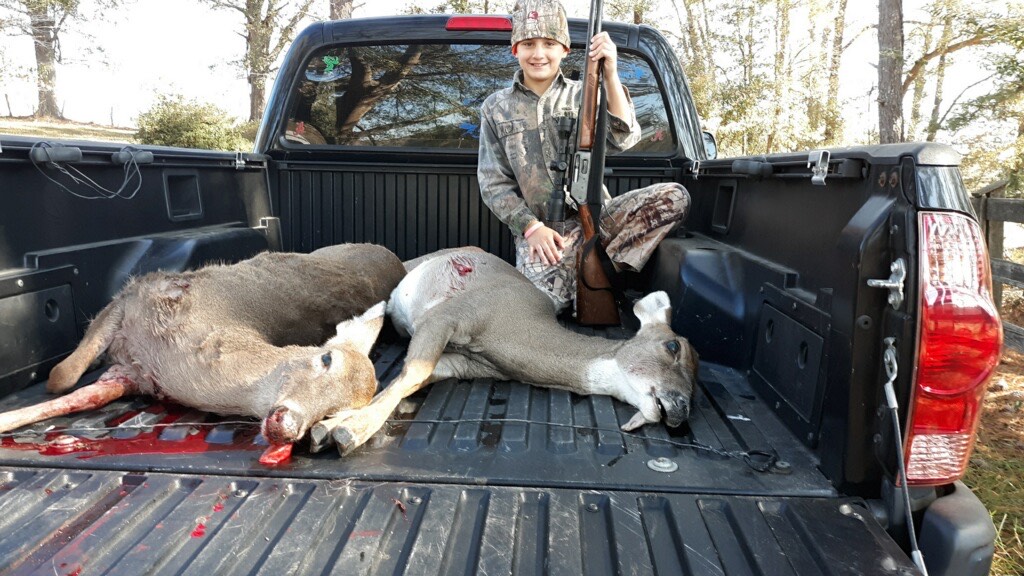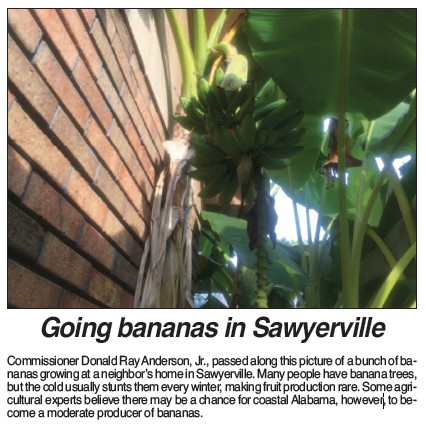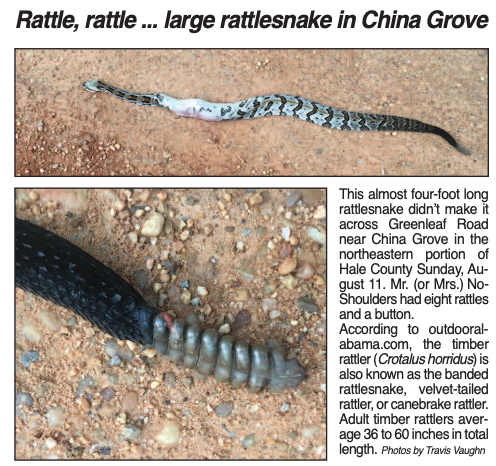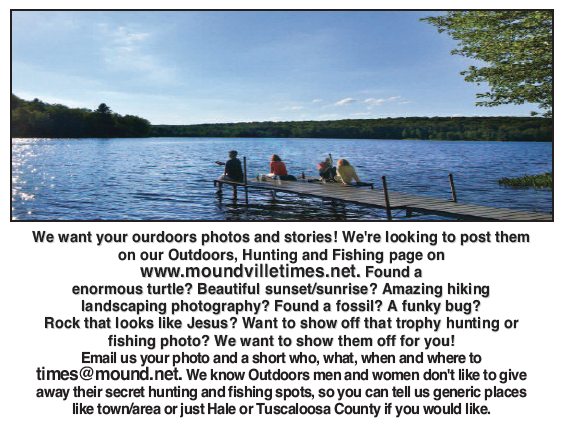
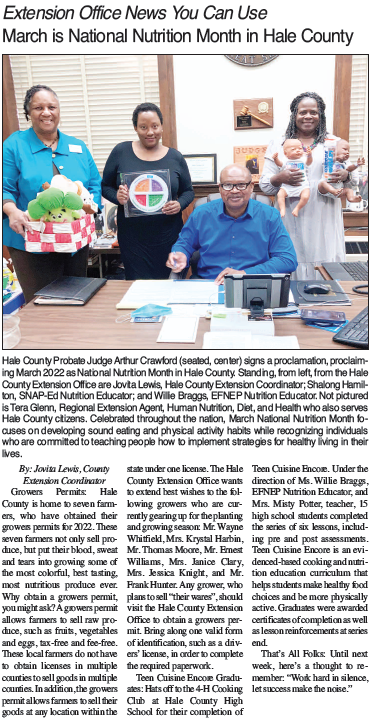
Heartland Virus: What Alabama Needs to Know
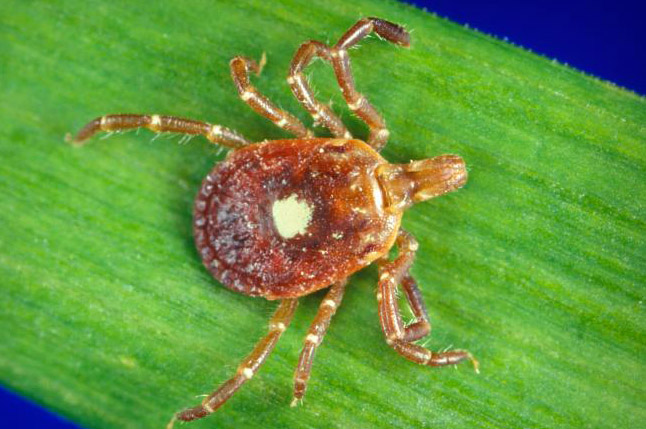
By Cole Sikes
AUBURN UNIVERSITY, Ala. – A rare illness has been traced back to a species of tick commonly found in Alabama. Heartland virus has come into the spotlight as a potential threat to the health of outdoor enthusiasts. However, there is not an immediate cause for alarm.
Heartland virus was first discovered in Missouri in 2009 and has been detected consistently in Lone Star ticks. This insect is native to the southeastern United States and serves as a vector for the virus.
The disease has been diagnosed in 11 states including Arkansas, Georgia, Illinois, Indiana, Iowa, Kansas, Kentucky, Missouri, North Carolina, Oklahoma and Tennessee. It is unknown if Heartland virus has spread to other areas of the United States. As of this publication, there are no confirmed human infections in Alabama.
The Centers for Disease Control and Prevention (CDC) confirmed 50 cases nationwide of the tick-borne virus as of last year. Symptoms of the disease include fever, decreased appetite, fatigue, headache, nausea, diarrhea and muscle/joint pain.
According to the CDC, it can take up to two weeks for these symptoms to appear after a tick bite. In some cases, hospitalizations can occur because of severe symptoms in some individuals.
Adult Lone Star ticks are easily identifiable by a white or sometimes cream-colored mark on their dorsal surface. Like most ticks, they feed on the blood of a host.
“It is the most abundant tick species in Alabama,” said Alabama Cooperative Extension System Entomologist Xing Ping Hu. “Lone Star ticks carry and transmit various diseases, however it does not transfer Lyme disease”
Illnesses transmitted by Lone Star ticks may include the following:
- Ehrlichiosis – an uncommon, flu-like illness that affects humans of all ages as well as deer, etc.
- Tularemia – a disease that mainly affects rabbits and rodents by affecting skin, lymph nodes, eyes and lungs.
- Southern tick-associated rash illness (STARI) – an infection of the skin in humans. Symptoms may include the presence of a rash that appears like the “bullseye” rash seen in some Lyme disease cases.
- Rickettsiosis – A bacteria similar to Rocky Mountain Spotted Fever (RMSF), but the bacteria Lone Star ticks carry is not the one causing RMSF. Rickettsiosis causes many of the same symptoms, and it presents the appearance of an inoculation eschar (a dark scab). Eschars are not common in RMSF.
Spreading public awareness rather than panic is the primary message that people should adhere to in 2022. Widespread transmission of any of these diseases is not likely, and you are your own best defense.
“Be aware that just because ticks carry pathogens for viruses, it does not mean it will transmit it,” Hu said. “It requires research to approve or disapprove of an infection.”
A preventative bug spray is crucial for repelling ticks as well as other unwanted insects. So, make sure to spray clothes and shoes while limiting direct contact with skin.
The most common thoroughfare for ticks is pets. A tick can easily embed themselves under fur or hair, making it difficult to see them. Therefore, check yourself as well as others and furry friends for ticks after spending time in the forest and other outdoor settings. A tick requires removal from the skin in less than 24 hours to prevent disease transmission.
Be mindful of the presence of pesky ticks this spring as seasonal projects and recreational activities increase. Routine checks for these insects are the best defense to such a small enemy. For more information on ticks and tick-borne illnesses, please visit the Alabama Extension website at www.aces.edu.
Springing into Hummingbird Season
By Wes Ellard
AUBURN UNIVERSITY, Ala. – Spring is in the air. Temperatures are beginning to rise and flowers will soon begin to bloom. The fair weather and abundant supply of nectar will spring bee and butterfly populations upward. Homeowners may also find a hummingbird that has taken up residence in the back yard.
Hummingbird Migration
The Ruby-throated Hummingbird is the state’s most common hummingbird.
“They will arrive from mid-March to mid-April and stay through late summer and early fall,” said Wesley Anderson, an Alabama Cooperative Extension System forestry and wildlife specialist. “These colorful birds then fly south to Central America.”
As with most species, hummingbirds migrate to areas as resources become available. Abundant nectar, insects and spiders are paramount for hummingbird survival. Interested homeowners and gardeners can find hummingbird migration maps by visiting websites such as hummingbirds.net.
Alabama also hosts the Rufous Hummingbird around the Gulf Coast. It differs from the Ruby-throated species in color, plumage and geographic preference. Anderson said hummingbird migration patterns appear to be changing.
“This is largely due to the climate warming in certain areas, causing milder winters,” he said. “Milder winters allow the birds to arrive earlier and potentially stay longer.”
Attracting Hummingbirds
There are several ways to attract hummingbirds to homes. First, Anderson said, is putting out hummingbird feeders. Hummingbirds are attracted to red, so having a red feeder–but not red dye in it–will help. Anderson also suggests planting red flowers and hanging red ribbons to attract the birds, which weigh only a few grams on average. If using multiple feeders, be sure to space them apart from each other.
“Hummingbirds can be territorial, and this (spacing them apart from each other) will allow them to establish their own territories and expend less energy chasing each other,” Anderson said.
Planting trees and shrubs to be used as perches will also make an area more appealing to hummingbirds.
Red Dye: Making Sense of Mixed Reviews
Anderson said red dye in food has been a controversy since the 1970s. It also raised concerns relate to hummingbird health. Red dye No.2, a known carcinogen, has been banned in the United States since 1976. The current red dye used is Red 40, which is FDA approved for humans. However, hummingbirds’ small size and differing anatomy means that the dye may be dangerous for them. Until there is further research, Anderson said it is best to steer clear of red dye in hummingbird food altogether.
More Information
More information on hummingbirds in Alabama, check out the Alabama Extension publication Hummingbirds in Alabama.
Second Case of CWD Confirmed in Northwest Alabama
The Alabama Department of Conservation and Natural Resources (ADCNR) announced today the results from additional Chronic Wasting Disease (CWD) prevalence testing of white-tailed deer in northwest Alabama. A second case of CWD in a hunter harvested, white-tailed deer has been confirmed in Lauderdale County. The first case of CWD in Alabama’s deer herd was detected in Lauderdale County in January 2022.
After the initial CWD-positive deer was detected, all of Lauderdale and Colbert counties were designated as a CWD Management Zone (CMZ). The area west of U.S. Highway 43 in Lauderdale County to the Mississippi and Tennessee state lines and south to the Tennessee River is designated as a High-Risk Zone. The remainder of Lauderdale County and all of Colbert County is designated as a Buffer Zone.
Samples were collected from 966 white-tailed deer harvested within the CMZ during the 2021-2022 hunting season. All samples collected within the CMZ have been tested by the Alabama Department of Agriculture and Industries and the results have been received by ADCNR. Only one additional positive was detected.
After analyzing the results from the prevalence detection testing for CWD in Lauderdale and Colbert counties, ADCNR is suspending the use of supplemental wildlife feeding and baiting privileges within the CMZ. The suspension of supplemental feeding will not apply to bird feeders within 100 feet of a building or occupied dwelling or feed inside an active feral hog trap. Supplemental feeding and baiting privileges will still be allowed outside of the CMZ.
“The suspension of supplemental feeding and baiting privileges in Lauderdale and Colbert counties is an attempt to slow the spread of CWD in the affected area,” said Chris Blankenship, ADCNR Commissioner. “We take the presence of this disease very seriously and are utilizing our CWD Strategic Surveillance and Response Plan to manage it. Our staff is prepared, and the Department will do whatever is prudent and reasonable to protect the state’s deer resources and our hunting culture.”
CWD was first detected in Tennessee and Mississippi in 2018 and has been moving slowly toward Alabama. CWD is a member of the group of diseases called transmissible spongiform encephalopathies (TSEs). Among cervids, CWD is a progressive, fatal disease that commonly results in altered behavior due to microscopic changes made to the brain of affected animals. An animal may carry the disease for years without outward indication. In latter stages of the disease, signs may include listlessness, lowering of the head, weight loss, repetitive walking in set patterns and a lack of responsiveness.
“I would like to thank hunters for their overwhelming support by providing a robust number of samples submitted for CWD testing after the first positive case was made public in January,” Commissioner Blankenship said. “As we move forward with future deer seasons, hunters will be our most important partners in the management of this disease.”
For more information about CWD in Alabama, please visit outdooralabama.com/cwd-info.
ADCNR promotes wise stewardship, management and enjoyment of Alabama’s natural resources through four divisions: Marine Resources, State Lands, State Parks, and Wildlife and Freshwater Fisheries. Learn more at outdooralabama.com.
Get a Permit Before You Burn
Spring is here and so is outdoor burning season in Alabama. State law requires that you obtain a permit from the Alabama Forestry Commission (AFC) before you burn any woodland, grassland, field, or new ground that is over one-quarter acre in size or lies within 25 feet of natural fuels, such as woods or grass. Obtaining a burn permit allows the AFC to know which fires are controlled and which are wildfires. If your proposed burn is less than one-quarter acre you do not need a burn permit.
Permits are free of charge and can be obtained in just a few minutes over the telephone. You can get a permit by calling the Alabama Forestry Commission dispatch center at (800) 392-5679. You’ll be asked a few questions about your burn such as, the location of the burn by giving the Lat/Long. (You can determine this information by using the AFC ‘Lat + Long Locator Map’ at https://forestry.alabama.gov/Pages/Maps/Locator.aspx.) Other information you will need to provide is the size of the burn, what you are burning (grassland/fields/forests), and the purpose of the burn.
In addition, you must have adequate tools, equipment, and manpower to stay with and control the fire the entire period that it is active to ensure that it doesn’t escape. Even though the burner has a permit, he/she is still responsible for any damage to others that may be caused if the fire escapes or smoke from the fire.
In addition, you must have adequate tools, equipment, and manpower to stay with and control the fire the entire period that it is active to ensure that it doesn’t escape. Even though the burner has a permit, he/she is still responsible for any damage to others that may be caused if the fire escapes or smoke from the fire.
The permit may be canceled by the AFC for failure to comply with the terms of the permit, weather condition changes which cause erratic and dangerous fire behavior, or if the burn produces smoke which becomes a hazard to others or contributes to a degradation of air quality.
Some local municipalities issue their own burn permits. You will need to check with your local fire department for any county and city laws that may restrict outdoor burning. It is also a good idea to notify your local fire department that you will be burning.
Hayes Takes Top Officer Award at NWTF Convention
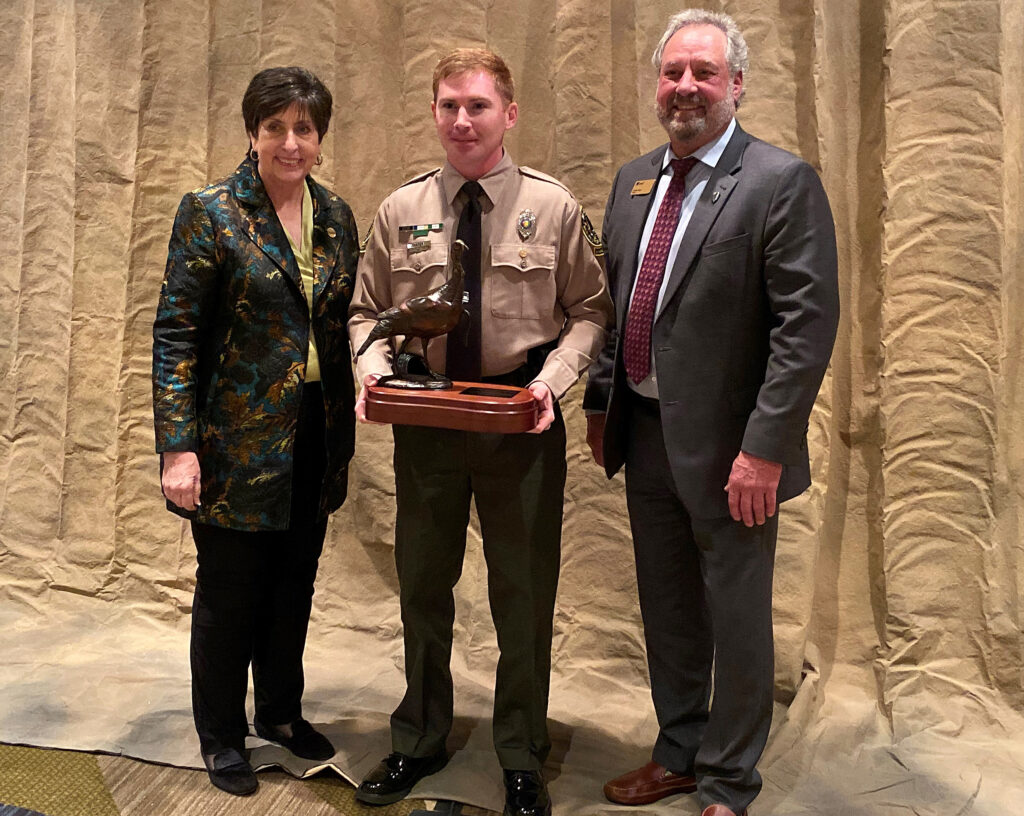
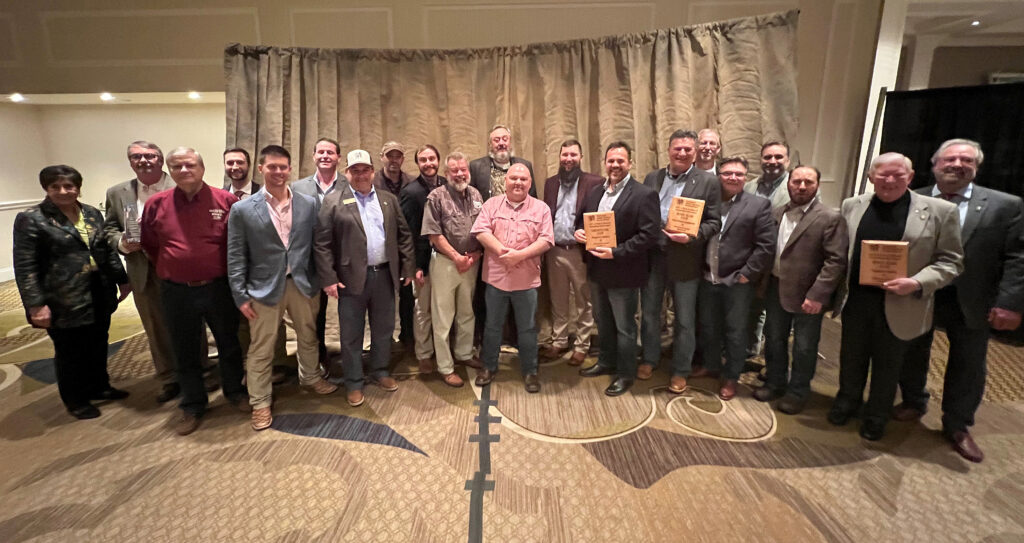
By David Rainer, Alabama Department of Conservation and Natural Resources
Alabama’s chapters racked up numerous awards at the recent National Wild Turkey Federation (NWTF) Convention in Nashville, and one of the state’s game wardens was selected for a prestigious honor.
Conservation Enforcement Officer Drake Hayes of the Alabama Department of Conservation and Natural Resources’ (ADCNR) Wildlife and Freshwater Fisheries (WFF) Division was named the NWTF’s Wildlife Officer of the Year at the awards banquet.
The NWTF states the Wildlife Officer of the Year Award is given to individuals who have excelled and demonstrated exceptional performance in the following areas: teamwork and innovation, attitude and leadership, and achievements and accomplishments.
One of those accomplishments involved Hayes’ work during Alabama’s 2021 turkey season, especially on opening day. Hayes had not only scouted areas prior to the season to search for possible illegal baiting; he was also training one of the Law Enforcement Section’s new officers.
“I had located bait on multiple properties in Shelby County on opening weekend of turkey season,” Hayes said. “I was in the middle of our field training officer program. I was training Officer (Trent) Robison, our officer for Bibb County at the time.”
Hayes and Robison went to the first property well before daylight to be in position to listen for hunters who might be illegally hunting over bait.
“Where I found the bait, we had to cross a log over a very large creek that was over our heads,” Hayes said. “You could cross the log and stay dry. But we had a significant amount of rain between the time I had located the bait and opening day. We heard the turkey hunters calling. We saw lights and activity and knew they were there at the bait. We get to the log, and it’s completely submerged. You couldn’t see the log; I just knew where it was. We had already put in so much work that we just had to go for it.
“The water is moving. It’s looking like whitewater rapids. I used a 6-foot stick to find the log, and we just had to feel with our feet where the log was. At this point, the water is up to our knees and cold. Opening day last year was pretty chilly, especially when you’re walking through a creek.”
Hayes and Robison managed to cross the log with wet pants and boots full of water to locate the hunters.
“We issued multiple citations, including hunting over bait,” Hayes said. “Then we have to traverse the exact same log coming back. It was that or swim. We got to the next property and cited three individuals for hunting over bait. The next day, we worked a hunting over bait case in Bibb County.
“It was a very successful opening weekend. During the course of the season, we issued citations in nine hunting over bait cases, using an electronic call, several harvest record violations and other violations, like loaded guns in vehicles and multiple license violations. I think it was 25 turkey-related violations for the season. It was a very productive season for me, and I was able to have our new officer with me for the majority of those cases. He got to experience a unique and productive season.”
Hayes had already been selected as the Alabama NWTF Chapter Wildlife Officer of the Year when he went to Nashville and was surprised when his name was announced as the national winner.
At the ceremony, Hayes said, “I would just like to thank God first and foremost. And thank Him again for all the blessings in my life, and thanks to the NWTF for this wonderful opportunity and for my family for putting up with my career choice – all the early mornings and late nights and everything in between. I would also like to ask for a round of applause for all the other officers and their families that are here as well tonight. Each and every one of them is just as deserving if not more than me.”
That night is something Hayes said he will never forget and is honored just to be selected for the nomination and to be able to attend the NWTF Convention.
“It took my breath away when they called my name,” he said. “It was very unexpected and such an honor to receive that award. Like I said, every officer was deserving of the award. I was blessed I was chosen.”
WFF Enforcement Chief Michael Weathers applauded Hayes’ honor and the recognition NWTF provides for his officers.
“We’re happy to have a longstanding partnership with NWTF,” Weathers said. “It’s beneficial to us in that it gives us a platform to recognize our officers who routinely go above and beyond in the detection and prosecution of egregious turkey hunting violations in the state of Alabama. The ability to recognize those officers has a positive morale effect for the entire staff, which further encourages our officers to get out and protect an already fragile species that is so much a part of Alabama’s hunting heritage.”
The 2021 turkey season was also special to Hayes for a reason not related to his work in uniform. He swapped into camouflage to take his dad, Johnnie Hayes, turkey hunting.
“We had tried several years to connect with turkey for him,” Hayes said. “We got close on several occasions but were never able to get him his first turkey. We finally got on a gobbling bird, and the stars aligned. There were no hens that I had to compete with. He was gobbling good on the roost. We were able to set up. I did a fly-down call, and we actually watched the bird fly off the roost and come straight to us.
“My dad was able to kill his first turkey in his late 50s. It was a very special moment to be able to call his first turkey.”
As for the other awards Alabama NWTF chapters received at the recent convention, State NWTF President Craig Harris said the Alabama State Chapter received the L.A. Dixon Award for Outstanding Chapter with 7,500-9,999 members.
Local chapters in Tuscaloosa, West Mobile, East Alabama, Morgan County, Monroe County and Henry County were also recognized at the convention.
“We didn’t get an award for it, but the Alabama State Chapter was financially, by far, the most successful last year,” Harris said. “We raised way more than anybody else. Through our banquets and fund-raising, the Alabama State Chapter was the top state in the nation for net dollars with more than $1 million raised. We were very proud of that. These funds are used at the local, state and national level for research and habitat projects and the preservation of Alabama’s hunting heritage.
“We have a lot of projects, research and habitat improvements going right now in Alabama.”
Harris also praised NWTF’s partnership with WFF on most of those projects.
“We’ve been good partners for many years,” Harris said. “Most everything we give Wildlife and Freshwater Fisheries, they’re able to get Pittman-Robertson Act funds, so it works out great.”
Chuck Sykes, an avid turkey hunter, said when he became WFF Director in 2012, he saw an opportunity to tap into the federal funding derived from an excise tax on firearms and ammunition that can be used for projects that involve wildlife management, wildlife research and hunter education.
“One of the first things I noticed after I got here was the (NWTF) state chapter had a program where biologists could apply for assistance for buying equipment and things such as that,” Sykes said. “I met with Phil Savage, who was then state president, and said we needed to be smarter with the money. I said set aside the money you want to spend. We’ll go through the process and select the projects y’all want to fund. Then write Wildlife and Freshwater Fisheries a check. Then we can use it as state match, and we can quadruple the money, and we can do more things for turkeys and turkey habitat.
“That went really well, and I have had great relationships with all the presidents from Phil to Craig Scruggs and Craig Harris now. NWTF puts their money where their mouth is. Not only are they talking about helping turkeys and turkey habitat, they’re putting their money behind it. The NWTF is one of the best NGO (non-governmental organizations) partners the State of Alabama has. We’re extremely grateful for their participation and support.”
Wild Duck Tests Positive for Avian Influenza in North Alabama
The U.S. Department of Agriculture’s (USDA) Animal and Plant Health Inspection Service (APHIS) has confirmed Eurasian H5 Highly Pathogenic Avian Influenza (HPAI) in a wild, hunter-harvested American wigeon in Limestone County, Alabama.
In January 2022, Eurasian H5 HPAI was detected in South Carolina and has since been detected in 14 additional states. HPAI H5 viruses infect the respiratory and gastrointestinal tracts of birds, can spread rapidly, and cause high mortality in infected poultry. According to the Centers for Disease Control and Prevention, the risk to humans from Eurasian H5 HPAI is low. No case of Eurasian H5 HPAI in humans has been identified in the U.S. For more information about the risk of avian influenza to humans, visit www.cdc.gov/flu/avianflu/h5n1-virus.htm.
The USDA monitors for the disease in commercial poultry operations, live bird markets and in migratory wild bird populations. Samples were collected for testing from the hunter-harvested American wigeon in Limestone County during routine monitoring for the disease. Preliminary tests were positive for Eurasian H5 HPAI. Additional testing by the APHIS National Veterinary Services Laboratories in Ames, Iowa, confirmed the positive results.
Wild birds can be infected with avian influenza without appearing sick. Hunters should minimize direct contact with wild birds by using gloves. If contact occurs, wash your hands with soap and water and change clothing before having any contact with healthy domestic poultry and birds.
The public is encouraged to report dead or dying bird sightings to the Alabama Department of Conservation and Natural Resources (ADCNR) for collection and testing. To report a sighting, call ADCNR’s Wildlife and Freshwater Fisheries Division at (334) 242-3469. It is important to avoid contact with any dead or dying bird.
For information regarding HPAI and domestic poultry, please contact the Alabama Department of Agriculture and Industries. Contact information is available at agi.alabama.gov.
ADCNR promotes wise stewardship, management and enjoyment of Alabama’s natural resources through four divisions: Marine Resources, State Lands, State Parks, and Wildlife and Freshwater Fisheries. Learn more at outdooralabama.com.
Alabama Aquatic Nuisance Species Management Plan approved
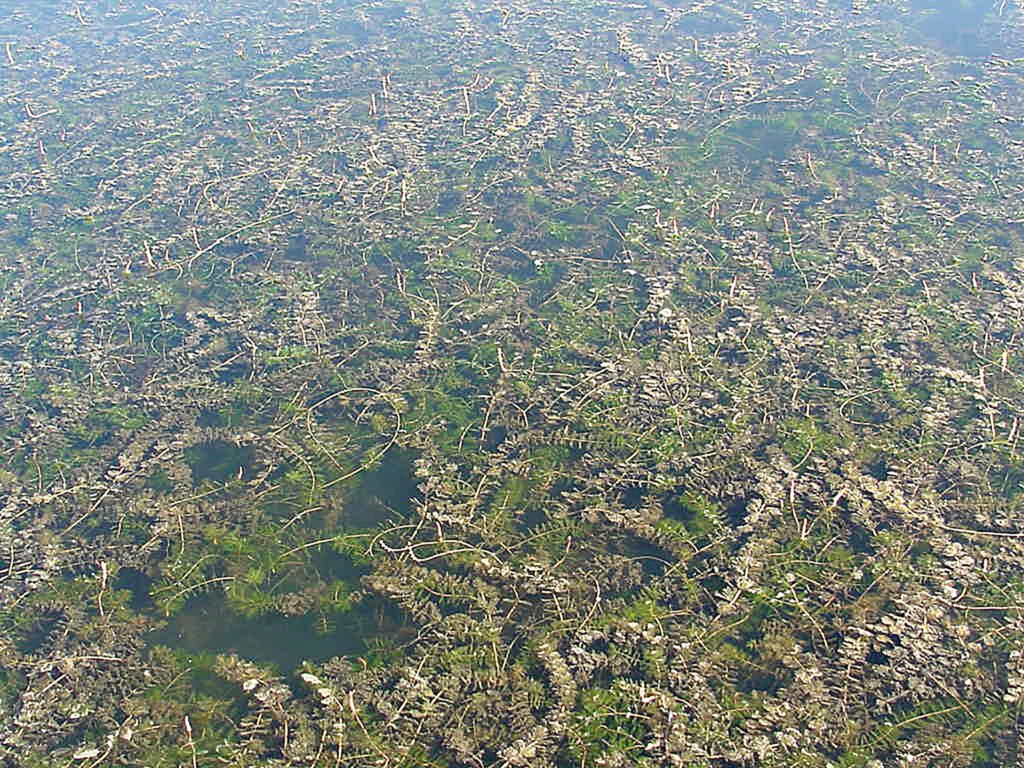
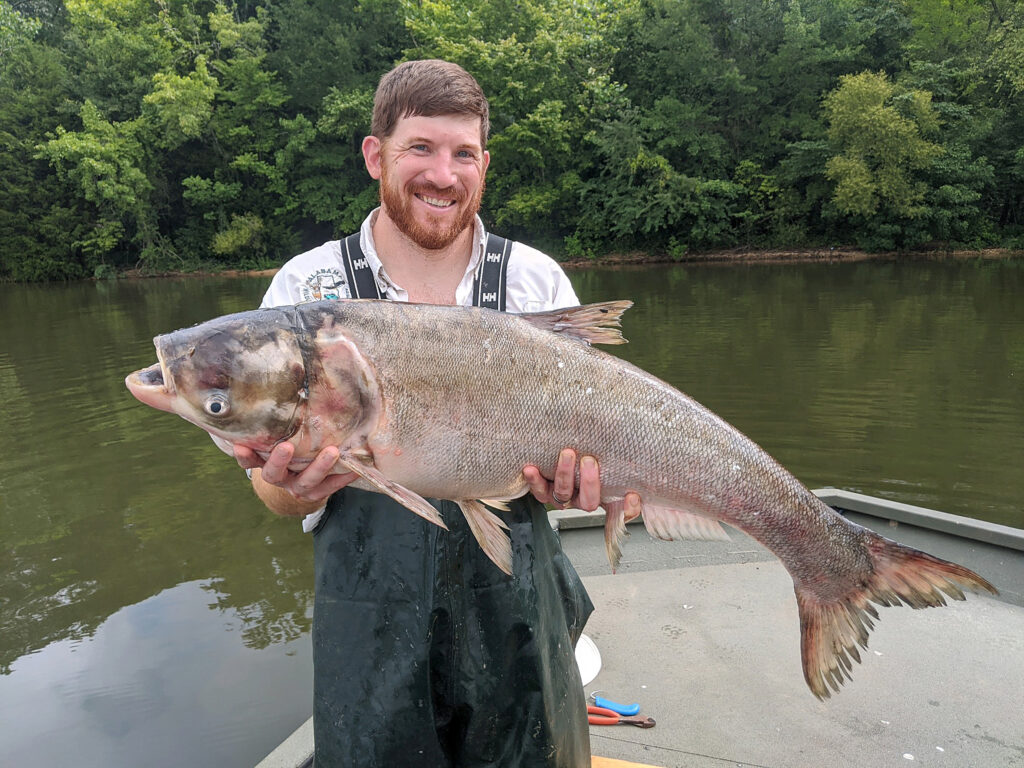
By David Rainer, Alabama Department of Conservation and Natural Resources
Recent approval of the Alabama Aquatic Nuisance Species Management Plan opens avenues of federal funding for the Alabama Department of Conservation and Natural Resources (ADCNR), Wildlife and Freshwater Fisheries (WFF) Division and Marine Resources Division to deal with aquatic invasive species in Alabama’s abundant waterways.
Alabama Governor Kay Ivey submitted the aquatic invasive species plan to the Aquatic Nuisance Species (ANS) Task Force, an entity of the U.S. Fish and Wildlife Service, and the recent approval means Alabama will be eligible for up to $100,000 annually to combat aquatic invasive species.
In the approval letter, the ANS Task Force applauded Alabama’s efforts of Steve Rider, WFF’s River and Stream Fisheries Program Supervisor, and the rest of the Alabama Aquatic Nuisance Species Task Force in developing the plan.
“This is quite an extensive plan that covers quite a few taxa and species that are found or may be found in the freshwaters of Alabama,” Rider said. “The impetus to get the plan completed and approved was the presence of invasive carp in the Tennessee River. It was a long process, but with the help of the Fish and Wildlife Service and the folks in the (WFF) Fisheries Section, we got it done. Now we have access to more money.”
“That will go a long way to deal with the invasive carp or anything else that comes up that is a priority to try to eradicate, monitor or manage any of the aquatic invasive species. Our concern is that these aquatic invasive species will outcompete our native aquatic species.”
Rider said the prime example of the impact of an aquatic invasive species is the silver carp that have been found in the Tennessee River chain of lakes in Alabama, particularly Pickwick in west Alabama.
“We have great bass fisheries up there, and we are concerned these silver carp may impact our bass population,” he said. “This additional money will help us combat any impact to those fisheries.”
Dave Armstrong, WFF’s Supervisor of Aquatic Nuisance Species, has been coordinating the collection and monitoring of silver carp in the Tennessee River and said the majority of silver carp are coming from the Tennessee River downstream of Pickwick Dam.
“Most of the carp we collect in our samples are closer to the Pickwick dam, but we have picked up some all the way up the lake to around Seven-Mile Island at Florence,” Armstrong said. “Outside of Pickwick, we had two reputable sightings last year in Wilson, one by a TVA (Tennessee Valley Authority) representative at Shoal Creek and one by an angler at McKernan Creek.”
Armstrong said a silver carp was taken by a bowfisherman in the Raccoon Creek area of Lake Guntersville last year, the first hard evidence the carp species had made it to the renowned bass fishery.
“We’ve had some people say they’ve seen them in Guntersville, but they haven’t been confirmed,” he said. “We have been to Guntersville several times to try to collect samples, and all we’re getting are common carp and suckers.
“The commercial fishermen are not seeing them. We’ve asked them to let us know if they catch any.”
Downstream from Pickwick, Kentucky and Barkley lakes in Kentucky have significant populations of silver carp. Armstrong said commercial fishermen in the Kentucky lakes harvested more than 7.6 million pounds of carp in 2020, and the final number for 2021 is likely to be higher.
Armstrong said the silver carp collected in Alabama during 2020-2021 averaged between 16 and 17 pounds per fish. He said five fish collected recently in Pickwick’s Panther Creek weighed from 19 to 23 pounds.
“The idea is to keep most of them below Wilson,” Armstrong said. “If they don’t spawn, hopefully we can eliminate them over time.”
TVA is slated to install Bio-Acoustic Fish Fence (BAFF) systems on several Tennessee River lakes with Wilson Dam to get the first installation in Alabama. The BAFF is a system of fish deterrent technologies that act as a barrier to invasive carp. This system consists of customized sound signals, directional strobe lighting, and a bubble curtain to produce an underwater linear deterrent to fish movement through the lock.
Conservation Commissioner Chris Blankenship has been instrumental in working with Senator Richard Shelby and his staff to provide funding for the BAFF Systems and other invasive carp mitigation and protection efforts.
Armstrong said other carp species – bighead, white amur (grass carp) and black carp – are also on the aquatic invasive species list, but silver carp is the main concern.
Rider said another concern is the invasive plant species that are found in Alabama.
“We’ve seen some new stuff come along, like Cuban bulrush on the Tombigbee River, a plant that takes over and clogs up the waterway. It’s like a mat across the entire waterway. At one time, one of our biologists told us he had seen deer walking on top of the bulrush. It was so thick that you couldn’t get into the backwaters because of the aquatic invasive plants.”
Rider said the plan helps ADCNR deal with other aquatic invasive species like non-native crayfish, blueback herring, apple snails and many other invasive species that are aquatic related.
“It deals with anything that could impact sport fisheries or could impact waterway navigation,” Rider said. “We also want to educate people on how these aquatic invasive species impact our aquatic resources. We want to have a place where people can go to see what species could have a potential negative impact. If they are non-native species, you don’t know when you introduce them if they will be detrimental to the native ecosystem.”
Now that the Alabama Aquatic Nuisance Species Management Plan is in place, Rider said requests will be made for the 2022 funding cycle, and it could lead to other appropriations.
“If more money becomes available, like in Kentucky and Tennessee, Congress appropriated millions of dollars to fight invasive carp in those states, but they had to have an approved plan,” Rider said. “Now that we have an approved plan in place, we may have access to more funds. It puts us in a better position for federal funding to help combat silver carp.”
Visit www.outdooralabama.com/research/aquatic-nuisance-species-management-plan for more information on the Alabama Aquatic Nuisance Species Management Plan.
Financial Relief for Landowners to Fight Cogongrass
Financial relief will soon be available to assist Alabama landowners adversely affected by the non-native, invasive noxious weed, cogongrass. Administered by the Alabama Forestry Commission, the Cogongrass Mitigation Program is made possible through a grant from the USDA Animal & Plant Health Inspection Service (APHIS), Plant Protection & Quarantine (PPQ). The goals of this program are to reduce the number of infested acres, eliminate cogongrass’s damaging effects on existing ecosystems, and improve the productivity of impacted sites. Additional objectives include slowing the spread of current establishments of cogongrass and preventing introductions into new areas of the state.
The program application period will launch on February 14, 2022, and the portal will remain open until further notice, depending on the number of applications. Eligibility for the funding requires that applicants be private, non-industrial landowners. Property with cogongrass infestations must be located in any of the 67 counties of Alabama, although the landowner is not required to reside on the property or within the state. There is no minimum or maximum acreage ownership requirement to enroll. It is a cost-free program.
“Cogongrass is a harmful invasive species that has been spreading across Alabama’s native vegetation. I am pleased that this program seeks to assist landowners in mitigating the damaging effects that cogongrass has inflicted on public and private land in Alabama. I encourage all interested and eligible Alabamians to participate in this initiative,” said U.S. Senator Richard Shelby (R-Ala.).
“We’re very thankful to be able to provide this monetary relief to Alabama landowners in the battle against cogongrass,” stated State Forester Rick Oates. “We certainly appreciate the dedication of Senator Richard Shelby and his staff in bringing this program to fruition.”
To apply for this funding or for further information regarding additional eligibility requirements, please visit the Cogongrass Mitigation Program section of the Alabama Forestry Commission’s website at www.forestry.alabama.gov, email Owen Andrews at [email protected], or contact your local AFC office.
The mission of the Alabama Forestry Commission is to protect and sustain Alabama’s forest resources using professionally applied stewardship principles and education, ensuring that the state’s forests contribute to abundant timber and wildlife, clean air and water, and a healthy economy. For more information about the Alabama Forestry Commission, visit the AFC website at www.forestry.alabama.gov.
Special Youth, Veteran and Active Military Personnel Waterfowl Hunting Day

Youth hunters Ethan Patterson and Cole McGinnis had a successful hunt at the Swan Creek Wildlife Management Area in Limestone County on one of two special waterfowl hunting days during the 2019-2020 season.
The Alabama Division of Wildlife and Freshwater Fisheries (WFF) has designated Saturday, February 5, 2022, as the second of the 2021-2022 hunting season’s Special Youth, Veteran and Active Military Personnel Waterfowl Hunting Days. The first of the two special waterfowl hunting days took place November 20, 2021.
On February 5, youth under age 16 who are accompanied by a licensed adult hunter, military personnel on active duty and veterans (as defined in section 101 of U.S. Code: Title 38) may hunt for waterfowl statewide. Regular waterfowl season shooting hours, bag limits, legal arms and ammunitions apply to the special days. Hunting area rules and regulations also apply.
To participate in the hunt, youth must be accompanied by a licensed adult supervisor. Only one firearm will be allowed per youth and only the youth hunters will be permitted to utilize the firearm for hunting unless the adult meets the requirements of a veteran or active duty military personnel. The adult supervisor must remain within arm’s length of the youth at all times and may accompany up to two youth participants during the hunt. The adult is also expected to review the rules of firearm safety and hunter ethics with each youth and ensure they are followed.
Youth is defined as an individual age 15 years and younger. Adult is defined as an individual age 21 years and older, or as the parent of the youth. The adult must have a state hunting license, state and federal waterfowl stamps and a free Harvest Information Program registration. Veterans and active duty military personnel must be in possession of a valid proof of service such as a military ID, Veterans Administration ID, veteran ID, veteran validation on their driver’s license or a copy of their DD Form 214. Possession of the mandatory hunting licenses and stamps is also required.
For more information about the Special Youth, Veteran and Active Military Personnel Waterfowl Hunting Days, contact WFF Migratory Gamebird Coordinator Seth Maddox at [email protected] or (334) 353-2057, or visit www.outdooralabama.com/waterfowl.
The Alabama Department of Conservation and Natural Resources promotes wise stewardship, management and enjoyment of Alabama’s natural resources through four divisions: Marine Resources, State Lands, State Parks, and Wildlife and Freshwater Fisheries. To learn more about ADCNR, visit www.outdooralabama.com.
Early Bird: America’s beloved Purple Martins return to Alabama
In a sure sign that spring is not far behind, the first Purple Martins of the year have been spotted in Alabama.
The birds were seen on January 12 in the city of Enterprise, Alabama by a Purple Martin enthusiast – one of many throughout the eastern and central United States who track and report on the birds’ annual migration on behalf of the Purple Martin Conservation Association. The migration of these unique birds can be reported and tracked through a community science project called the Scout-Arrival Study.
“The first Purple Martin arrivals of the season are always an exciting event,” said Joe Siegrist, President of the Purple Martin Conservation Association. “Tracking the migration is not only fun, it also provides us with valuable information that helps inform our research and strengthen our efforts to make sure we’re doing everything possible to sustain the population of these amazing birds.”
North America’s largest species of swallow, Purple Martins winter in the rainforests of Brazil before making up to a 7000-mile migration north into the eastern United States and Canada.
The annual migration is a testament to the martins’ resilience as well as the unwavering dedication of thousands of ‘martin landlords’ who maintain multi-compartment nest ‘condos’ that are essential for the birds’ survival. Once widespread in rural America, this species, that eats billions of flying insects annually, has been disappearing at an alarming rate, experiencing a loss of one-third of its population over the last 50 years.
“The decline seems to be the combination of a few factors: nesting habitat loss, competing invasive species, decreasing prey availability, and climate change,” said Siegrist. “Over the majority of the Purple Martins’ range, they are unable to nest naturally any longer. Human-provided nest boxes are the only thing keeping the species alive east of the Rocky Mountains.”
Siegrist says the very survival of the species is due in large part to scores of dedicated conservationists who invest their time, money and hearts into maintaining housing for the martins.
“The landlords provide critical shelter for the martins,” Siegrist said. “In return, they are rewarded with a family-like bond with the birds who return to the same colony year after year like clockwork.”
To follow along with the Purple Martins’ migration and learn more about how you can help ensure the future of Purple Martins, visit www.purplemartin.org. In addition, people interested in learning more about how to attract and care for Purple Martins can receive a free booklet by contacting the Purple Martin Conservation Association by emailing [email protected] or calling 814-833-7656.
Avian Influenza is Back
Highly pathogenic avian influenza (HPAI) has been confirmed in wild ducks in North Carolina and South Carolina. While professionals have not detected the bird disease in Alabama, migratory birds can bring the threat here in natural flyways.
Ken Macklin, a poultry specialist with the Alabama Cooperative Extension System, said even though the wild ducks were part of the Atlantic Flyway, and only part of Alabama is in that flyway, there is still substantial risk to poultry producers in the state.
“These birds may be flying overhead as you read this, meaning the disease may already be here,” said Macklin, who is also a professor of poultry science at Auburn University. “Following good biosecurity is the most effective way to prevent the disease from spreading into your poultry.”
Commercial poultry producers in Alabama, and throughout the Southeast, have already increased their level of biosecurity. This increased security includes being extra cautious with visitors, wearing extra shoe covers and increasing sanitizing of shoes, just to name a few things.
“Backyard poultry producers must also increase their biosecurity diligence because, unlike commercial poultry, most backyard poultry are housed outside where the chance of being exposed to this virus is high,” Macklin said.
This increased biosecurity provides a measure of protection to not only the poultry producer, but also to neighbors that have poultry by not spreading the disease. The following is some basic advice to protect poultry flocks:
- Isolate birds from potential disease carriers by making the coop and its surrounding area unappealing to wild birds.
- Minimize visitor traffic near the chicken coop, as they may have stepped in something carrying the virus.
- Sanitize anything and everything entering the coop.
- Recognize when the birds are acting sick. In the case of avian influenza, the birds will be extremely sick.
Whether raising 5, 50, 500 or 50,000+ chickens, preparing and following a good biosecurity program is important for maintaining the health and well-being of a poultry flock. If properly implemented, there is a good chance that a disease outbreak will not affect the flocks that have a good biosecurity program.
Infected waterfowl can shed the virus in secretions from the mouth, nostrils and eyes. They can also excrete the virus in their droppings. Contact with contaminated droppings is the most common means of bird-to-bird transmission. However, airborne secretions are another important means of transmission, especially within poultry houses.
People can often trace the spread of avian influenza between poultry facilities to the movement of infected birds or contaminated people and equipment, including clothing, boots and vehicles. If a grower suspects that their chickens are sick, they should contact their veterinarian, state diagnostic lab or a qualified expert, and get a diagnosis if possible.
Yes, poultry is safe to eat. Infected flocks do not enter the human food chain. When a person identifies avian influenza in a flock, they euthanize the chickens and dispose of their remains, usually on the farm.
Alabama Extension offers more details about backyard poultry biosecurity in the publication Biosecurity for Backyard Poultry Flocks. Also, more information about avian influenza is available in the publica
Extension Office News You Can Use
By Jovita Lewis, County Extension Coordinator
Private Applicator Permit Training and Testing: The Hale County Extension Office will be hosting a private applicator training and testing on Thursday, January 27, 2022 at 1:00 pm in our Extension Auditorium. This training covers the appropriate use and application of restricted use pesticides. Permits are granted to individuals obtaining a passing grade of 70 percent or higher on the test. The cost for the training is $20.00. Bring a check or money order made payable to ACES. Our Regional Extension Agent, Rudy Yates, is providing leadership to this meeting. Due to COVID 19, space is limited and pre-registration is required. Register by calling the office at 334-624-8710 or by emailing [email protected]. Those in attendance are asked to wear a face covering and social distance. This training is especially helpful to farmers, nursery owners, pond owners, and forested land owners.
Agricultural Outlook Meeting: Your Hale County Extension Office will host the 2022 Agricultural Outlook Meeting for west Alabama on Friday, January 28, 2022. This year’s meeting will be held at the Alabama Fish Farm Center, located at 529 Centreville Street, Greensboro, AL. Hale and neighboring counties are invited to hear state and regional Extension experts discuss an array of agricultural activities relevant to Alabama, while examining the current agricultural economic situation and the outlook for the year ahead. Besides commodity discussions, topics will include policy, land, and agricultural finances. The meeting will include several opportunities for questions and answers also. Our Regional Extension Agent, Ken Kelly, is providing leadership to this meeting. Lunch will be provided. Due to COVID 19, space is limited and pre-registration is required. Register to attend by calling the office at 334-624-8710 or by emailing [email protected]. Also, let us know of any dietary restrictions you have. Those in attendance are asked to wear a face covering and social distance.
That’s All Folks: Until next week, here’s a thought to remember: “In winter’s chill or summer’s heat, a farmer works so the world can eat”.
WFF’s Sykes Urges Hunters to Not Overreact to CWD
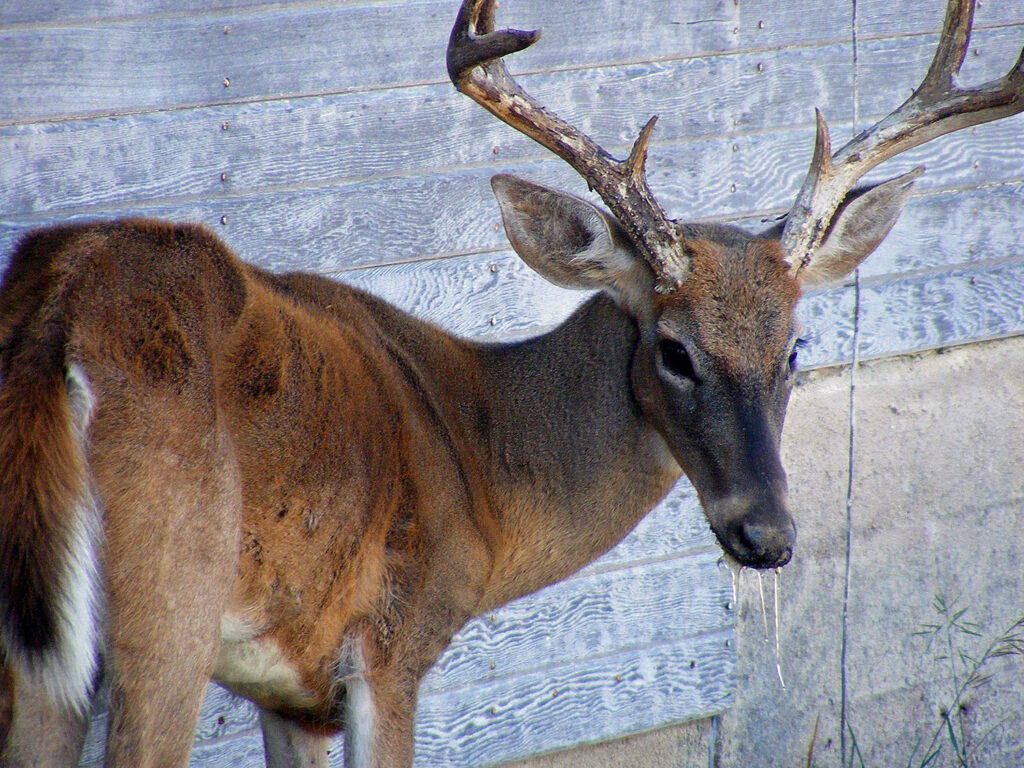
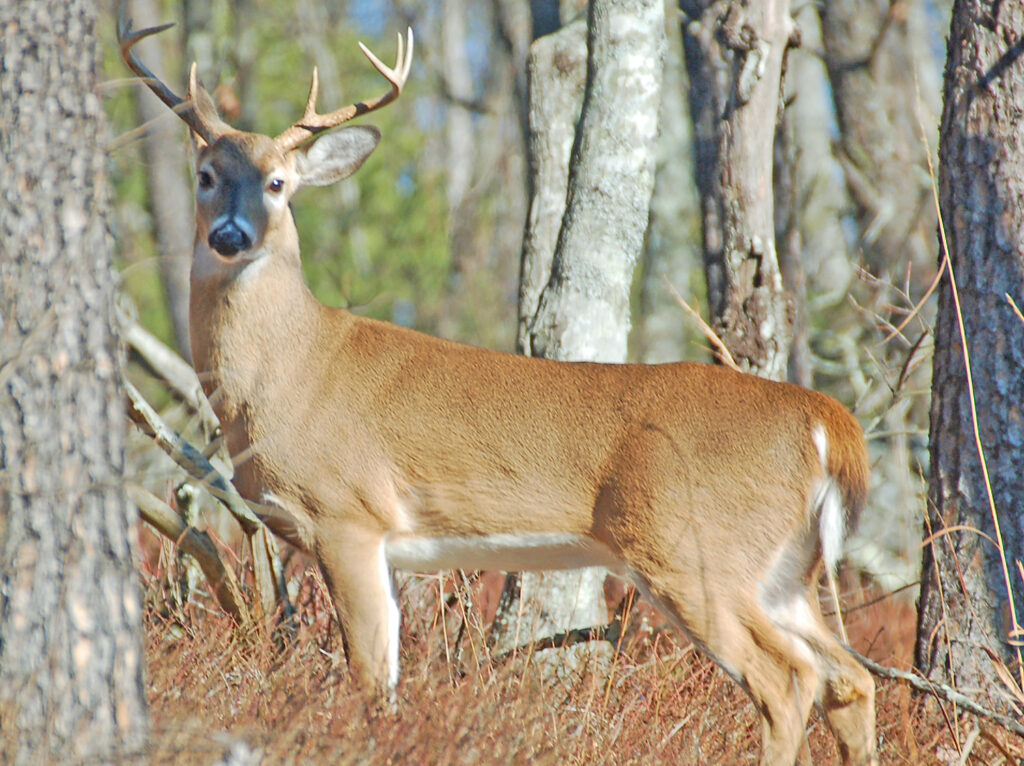
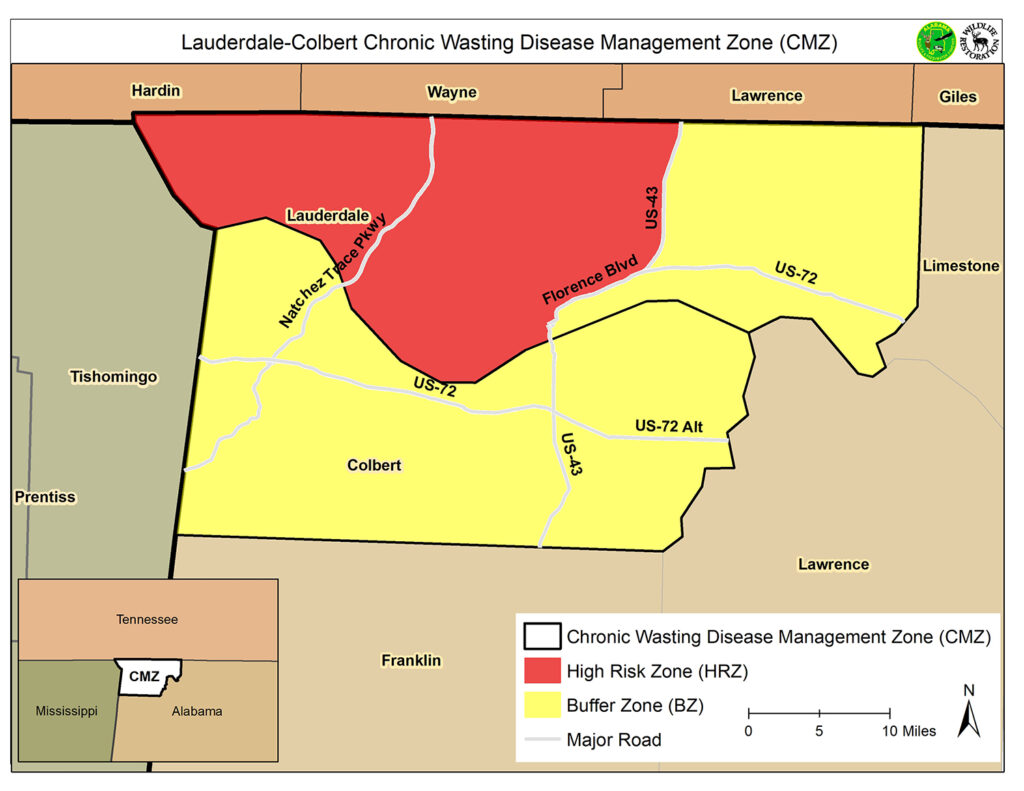
By David Rainer, Alabama Department of Conservation and Natural Resources
Alabama’s first case of chronic wasting disease (CWD) was confirmed last week in northwest Alabama, and Chuck Sykes, Director of the Alabama Wildlife and Freshwater Fisheries (WFF) Division, urges all hunters and concerned citizens not to overreact.
“The main message I want to relay to people is that this is not the end of the world,” Sykes said. “We’re not going to kill all the deer. We just need to understand the distribution and prevalence of it in this area so we can adapt.”
After CWD was confirmed in a hunter-harvested deer in Lauderdale County, ADCNR enacted a new regulation for Lauderdale and Colbert counties, as outlined in Alabama’s CWD Surveillance and Response Plan. All of Lauderdale and Colbert counties are designated as a CWD Management Zone (CMZ). The area west of U.S. Highway 43 in Lauderdale County to the Mississippi and Tennessee state lines and south to the Tennessee River is designated as a High Risk Zone (HRZ). The remainder of Lauderdale County and all of Colbert County is designated as a Buffer Zone.
The regulation also removed harvest restrictions within the CMZ. Hunters will have no seasonal or daily bag limit restrictions and no antler restrictions (antlered and unantlered) for deer harvested on privately owned or open-permit public lands in Lauderdale or Colbert counties through the remainder of the 2021-2022 deer season. Also included are the following Wildlife Management Areas (WMA) and Community Hunting Areas (CHA): Lauderdale WMA, Freedom Hills WMA, Riverton CHA, and Seven-Mile Island WMA. On those WMAs, hunters will be allowed unlimited harvest of deer of either sex daily through February 10, 2022. These changes do not apply to any other county, WMA or CHA in the state.
Hunting license and Game Check requirements remain in effect for all white-tailed deer harvests. For WMA Hunters, daily WMA and CHA check-in and check-out will continue to be required by either physical permit or through the Outdoor AL app.
Hunters who harvest any deer within the HRZ in Lauderdale County are required to submit heads for CWD testing at drop-off freezer locations or at scheduled ADCNR mobile sampling stations. Hunters who harvest deer within the Buffer Zone are highly encouraged to submit heads for sampling at drop-off freezer locations within the CMZ.
Sykes said the more samples that are collected in the affected areas, the better WFF officials will understand the extent of the impact on the deer herd. He said the sampling and testing could reveal different scenarios. He said in Issaquena County, Mississippi, the first positive CWD test occurred in February 2018. The next time a deer tested positive for CWD in that Mississippi county was in December 2021.
“Or are we dealing with a Hardeman County, Tennessee, that found one, then found 10, then found 50,” Sykes said. “At that point in time, we will decide what is the best way to proceed. We’ve had a CWD plan in place since 2012. We’ve been CWD testing since 2002.”
Visit www.outdooralabama.com/CWD-In-Alabama and go to the bottom of the page to download a copy of the 35-page Alabama Chronic Wasting Disease Strategic Surveillance and Response Plan.
“This has not caught us off guard,” Sykes said. “This is not a surprise. We’ve been telling people this was coming. It came from right where we expected. Natural progression held true.”
CWD is a member of the group of diseases called transmissible spongiform encephalopathies (TSEs). CWD among cervids is a progressive, fatal disease that alters behavior due to microscopic changes in the brain of affected animals. An infected animal may not exhibit symptoms of the disease for years. In latter stages of the disease, effects may include listlessness, lowering of the head, weight loss, repetitive walking in set patterns and a lack of responsiveness.
“People don’t need to panic,” Sykes said. “We’ve been preparing for this. We’re taking the good, bad and ugly on how other states have handled CWD, and we’re doing what we feel is best for the resources of Alabama.
“There has been some misinformation shared on social media. We’re not trying to starve people by killing all the deer. We’re not trying to eradicate the deer. We need to know if it’s one deer with CWD there or 10 or 100. The best way we can do that is for hunters to bring us samples.”
Sykes said if there is a silver lining in the positive CWD case in Lauderdale County, it’s because it was discovered in January.
“Unlike Mississippi, where they found their first case of CWD in February, we found it during deer season from a hunter-harvested deer,” he said. “The hunters did what we needed them to do by bringing us samples this past weekend.
“Now we need to utilize these next 30 days to get as many samples as we can to determine how widespread it is.”
Like other states that have been dealing with CWD for decades, Wisconsin and Colorado for example, Sykes said Alabama is going to have to adjust to the new reality.
“We’re just going to have to learn to deal with this,” he said. “It’s not going away. We have been extremely transparent about everything we have done.
“We’re working cooperatively with several other states that have CWD. The more we learn about this, the more we can handle things properly. That’s what we’re doing right now. It’s part of the process.”
WFF has provided self-service freezer locations throughout the state for the past three years where hunters can drop off their deer heads to be tested. Sykes hopes this awareness will prompt more hunters to drop off samples. Go to www.outdooralabama.com/cwd-sampling for a map of freezer locations.
“Again, I don’t want people to panic, but we need to know,” Sykes said. “The counties that border Lauderdale and Colbert just need to be aware that if natural progression continues, those counties are going to be next. We need those hunters to be aware and get their deer tested. These counties are the closest points of entry from positives in Tennessee and Mississippi.”
The new regulations also control the transportation of harvested deer. Carcasses and other deer parts harvested within the HRZ must remain within the HRZ. Carcasses and other deer parts harvested within the Buffer Zone must remain within the CMZ. Carcasses or other deer parts cannot be moved outside the HRZ or CMZ. Deboned meat, cleaned skull plates and raw hides with no visible brain or spinal cord tissue may be taken outside of these zones. Transporting deer carcasses out of the management zone can potentially spread CWD to currently unaffected areas
“If people continue to do what we’ve asked them to do, like not moving whole carcasses or high-risk body parts, as long as they don’t artificially move it, natural progression is extremely slow,” Sykes said.
Sykes said the WFF urges hunters to follow guidelines from the Centers for Disease Control and Prevention (CDC) regarding the consumption of venison from a deer harvested in a CWD-positive area.
“The CDC recommends that before consuming a deer from a CWD hot zone, hunters should have the deer tested,” he said. “You harvest a deer, have it processed, have it tested and react accordingly.”
Visit www.outdooralabama.com/CWD-FAQs for information on preventative measures for hunters, proper disposal of carcasses and other common questions.
Sykes said WFF staff reported positive interaction with hunters over the weekend about the CWD-positive deer in Lauderdale County.
“All the hunters my staff talked with at check stations this weekend were extremely appreciative of our efforts,” he said. “They were very inquisitive and willing to help.
“This is not going to destroy deer hunting in Alabama, we just have to adapt.”
Conservation Commissioner Chris Blankenship added, “We want to thank all of our hunters who are joining in our efforts to maximize samples. We greatly appreciate their supportive, helpful participation as we seek to better understand the prevalence of CWD in the area.”
First case of chronic wasting disease discovered in Alabama deer
By Justin Miller
Chronic wasting disease (CWD) has been increasingly affecting deer in parts of the Southeastern United States over the last several years. While previously undetected in Alabama, the first case of this neurodegenerative disease was recently discovered in the state.
According to the Alabama Department of Conservation and Natural Resources (ADCNR), the positive case was detected in a white-tailed deer in west-central Lauderdale County.
“CWD was first detected in Tennessee and Mississippi in 2018 and has been moving slowly toward Alabama,” said Chris Blankenship, ADCNR commissioner. “The Department has implemented multiple proactive regulations to combat the spread into Alabama. Compliance from the public on those measures helped delay the spread into the state for several years.”
CWD affects cervids such as white-tailed deer, mule deer, elk, moose and caribou. Mark Smith, an Alabama Cooperative Extension System wildlife specialist, said the disease causes degeneration of brain cells that continually gets worse over time.
“It is similar to bovine spongiform encephalopathy (mad cow disease) found in cattle,” Smith said. “There is currently no treatment for CWD and all cases are fatal.”
Smith said there are several symptoms of CWD that people can look for. Overall, look for deer that are acting abnormally.
“Some signs of CWD in deer include significant weight loss, difficulty moving/standing and tremors,” Smith said. “Keep in mind there could be other reasons, such as injuries or other diseases, that may cause these same symptoms.”
The disease most commonly found in adult deer, but be aware that all ages are susceptible. Symptoms of CWD include the following: weight loss over time and the animal appearing thin and weak; lack of wariness (caution about possible dangers); difficulty moving or standing; lowering of the head; tremors; listlessness; excessive salivation and urination.
Because of the detection in the state, several new regulations will help assist state officials in the monitoring and prevention of the disease. According to the press release, Chuck Sykes, the director of ADCNR’s Wildlife and Freshwater Fisheries Division, said the primary objective is to determine the prevalence of the disease in the area affected.
“The new regulation is intended to increase the opportunities for hunters to supply samples for CWD testing,” Sykes said. “We need hunters to continue to hunt and submit deer heads for testing. These additional samples will help us better determine the extent of the disease in this area.”
To view the most current regulations, visit www.outdooralabama.com/CWD-Info on the Alabama Department of Conservation and Natural Resources website. There, people will find information on the best management practices for transportation, disposal and testing.
There have been no known cases of humans contracting this disease. However, the Centers for Disease Control and Prevention recommends that humans not consume meat from a deer with CWD.
Smith said the detection of CWD in the state alters the way people should address venison for consumption, especially if they harvest the deer in the CWD management zone.
“People should submit the head for testing and wait the couple of weeks for the results before consuming the meat,” he said. “In the meantime, go ahead and process the deer and get it in the freezer. If the test comes back positive, then discard the meat.”
If people receive venison from someone else, they should ask where the person harvested the deer before consuming.
Deer that people harvest in the designated High Risk Zone in Lauderdale County must be submitted for CWD testing. People can do this at drop-off freezer locations or at scheduled ADCNR mobile sampling stations.
For hunters who harvest deer within the Buffer Zone, state officials highly encourage them to submit heads for sampling at drop-off freezer locations anywhere within the CWD management zone.
In other areas of the state, Smith said testing is currently not mandatory.
“Hunters should use their judgement as to whether or not they should get their deer tested,” he said. “However, hunters should keep in mind that state officials are collecting samples from harvested deer statewide to assist in the monitoring of the disease. By submitting their deer for testing, hunters can help tremendously in monitoring the spread of CWD in Alabama.”
For the latest information regarding chronic wasting disease in Alabama, visit the CWD Information page on the Outdoor Alabama website. Continue to monitor this website, as regulations may change as more samples come in and state officials develop a greater understanding of the prevalence of CWD. For other related topics, visit www.aces.edu or contact the forestry, wildlife and natural resources professional serving your county.
Extension Office News You Can Use
Happy new year to all!
By: Jovita Lewis, County Extension Coordinator
Extension in your community: Happy New Year to all! The staff of the Hale County Extension Office are eager to forge ahead in 2022. At the beginning of this semester, the 4-H Cooking Club, began at Hale County High School. Mrs. Misty Potter, a local teacher and former 4-H’er is working closely with Laura Miller, 4-H Foundational Regional Extension Agent to insure this new 4-H club is a success. Willie Braggs, EFNEP Nutrition Educator will also be working closely with Mrs. Potter to offer Teen Cuisine Encore classes to the members of the 4-H Cooking Club as well. This is going to be a fun-filled educational opportunity! 4-H Rabbit Club Update: Mark your calendars now for Jan. 18 at 5:30 p.m. This is the date that members of the 4-H Rabbit club will meet and receive their Crossbred Rex Rabbit. We have five courageous young people who are committed to learning to take care of a rabbit. The five 4-H’ers, supported by their parents, who will raise and grow a rabbit are Antavion Benison, Charles Burns, Jr., Abby Catherine James, Cornell S. Richardson, and Anna Smith. These young people have committed themselves to learning about rabbit behaviors, feed and nutrition, how to keep records, build rapport with other rabbit enthusiasts, and participate in the 4-H Rabbit Show in June. The 4-H Rabbit Club will hold its meeting in the auditorium of the Hale County Extension Office. Private Applicator Permit Training and Testing: The Hale County Extension Office will be hosting a private applicator training and testing on Thurs., Jan. 27 at 1 p.m. in our Extension Auditorium. This training covers the appropriate use and application of restricted use pesticides. Permits are granted to individuals obtaining a passing grade of 70 percent or higher on the test. The cost for the training is $20. Bring a check or money order made payable to ACES. Our Regional Extension Agent, Rudy Yates, is providing leadership to this meeting. Due to COVID-19, space is limited and pre-registration is required. Register by calling the office at 334-624-8710 or by emailing [email protected]. Those in attendance are asked to wear a face covering and social distance. This training is especially helpful to farmers, nursery owners, pond owners, and forested land owners. Agricultural Outlook Meeting: Your Hale County Extension Office will host the 2022 Agricultural Outlook Meeting for west Alabama on Fri., Jan. 28. This year’s meeting will be held at the Alabama Fish Farm Center, 529 Centreville St., Greensboro. Hale and neighboring counties are invited to hear state and regional Extension experts discuss an array of agricultural activities relevant to Alabama, while examining the current agricultural economic situation and the outlook for the year ahead. Besides commodity discussions, topics will include policy, land, and agricultural finances. The meeting will include several opportunities for questions and answers also. Our Regional Extension Agent, Ken Kelly, is providing leadership to this meeting. Lunch will be provided. Due to COVID-19, space is limited and pre-registration is required. Register to attend by calling the office at 334-624-8710 or by emailing [email protected]. Also, let us know of any dietary restrictions you have. Those in attendance are asked to wear a face covering and social distance. That’s All Folks: Until next week, here’s a thought to remember: “A farmer is a magician who produces money from the mud.”
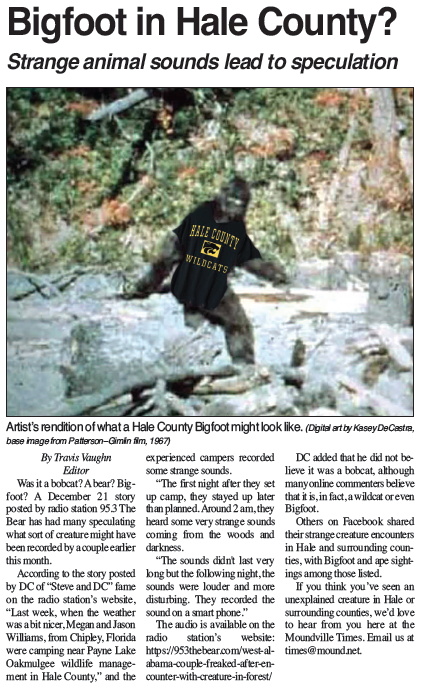
Grow More, Give More
The Alabama Cooperative Extension System’s Grow More, Give More project lends a helping hand. Both experienced and novice gardeners will find the information and resources needed to have a successful garden via Grow More, Give More. The project also encourages gardeners to grow an extra row and give back to their communities.
How It Works
To help you Grow More, check out Alabama Extension’s abundant resources to boost your growing potential, whether growing in containers, raised beds, or a traditional in-ground garden. As for Give More, some gardeners may want to share with neighbors, while others might deliver their harvests to a food pantry or a regional food bank.
How to Donate Extra Fruits and Vegetables
Consider dropping off extra vegetables to neighbors shut in by age or illness, or affected by job loss and would appreciate fresh produce. Schools, community centers, and places of worship are addressing food insecurity in ways you may not realize. Reach out and see if there is a need you can help fill. Statewide charities such as Society of St. Andrew, a crop gleaning charity, and regional food banks across Alabama will coordinate donations, particularly in larger quantities. The power of grass roots efforts like Grow More, Give More is often underestimated. Alabama Extension wants to capture the strength and generosity of Alabama gardeners participating in Grow More, Give More. Participants can document the number of pounds they donate by completing a very brief online survey. Submit photos of donations to the Alabama Smart Yards Facebook page and also use the hashtag #growmoregivemore. Visit https://www.aces.edu/blog/topics/products-programs-lawn-garden/give-more/ to document your donation and https://www.aces.edu/blog/topics/products-programs-lawn-garden/grow-more-give-more for supply lists and gardening resources links and videos.
Hunters, anglers take extra care on cold-water excursions
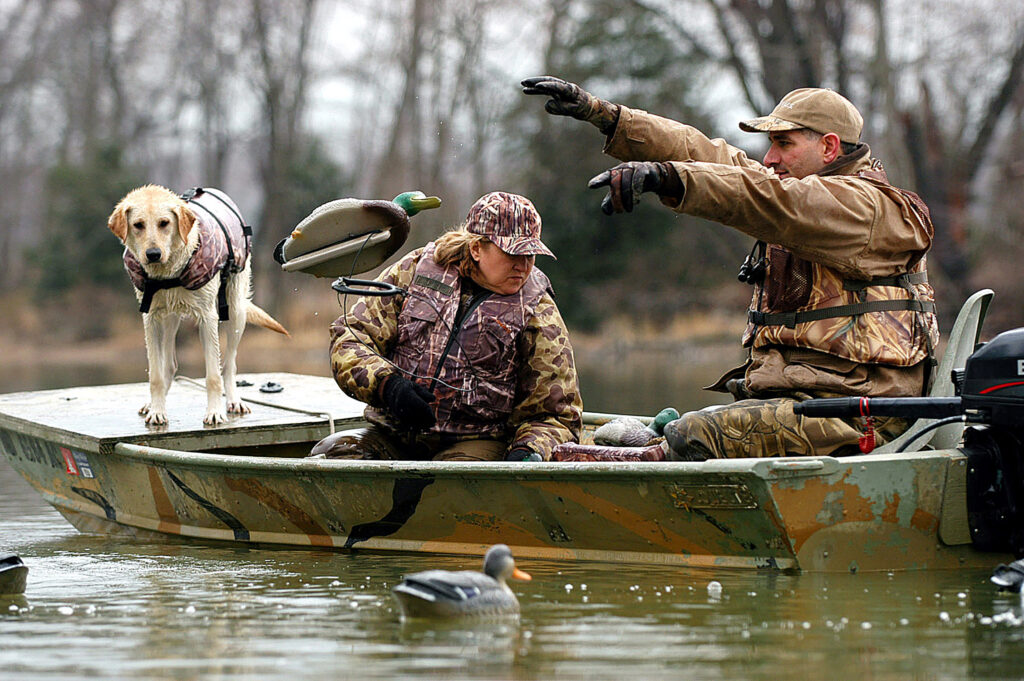
Photos by USCG, Vance Wood)
By David Rainer, Alabama Department of Conservation and Natural Resources
With Alabama’s abundant waterways, hunters sometimes can only access their hunting land via some type of boat or vessel. That goes not only for waterfowl hunters but for deer and small game as well.
When the weather is cold and the water temperature is low, using personal flotation devices (PFDs) is crucial for safety should an accident occur and hunters end up in the water. Drowning is not the only risk. Hypothermia sets in in only minutes in frigid water.
Paul Barnard is a 35-year veteran in the U.S. Coast Guard (USCG) with 20 years of active duty, including stints at Dauphin Island and Brookley Field. Currently as the Recreational Boating Safety Specialist stationed in the New Orleans district, which covers 26 states, Barnard is urging all hunters and boaters who take to the water this time of year to exercise caution and wear PFDs. Barnard heads the USCG’s Operation Artemus Borios, which is aimed at keeping hunters and boaters safe during the winter.
“Artemus was the Greek goddess of the hunt, and Borios is the god of the cold and winter winds,” Barnard said. “The objective of the program is to reach out to hunters and all boaters who operate in cold weather to discuss the dangers to those activities. It is an outreach and enforcement operation. The enforcement is not a ticket-writing operation. We actually engage people at the dock before they launch. Enforcement focuses on the preventative aspect.”
Last year two young duck hunters went missing during a hunt on the Mississippi River. The two hunters have never been found after extensive search efforts. In 2009, two hunters used a canoe to access areas in the Mobile-Tensaw Delta to go squirrel hunting. Their canoe was found half submerged. The body of one of the hunters was recovered in January of 2010 in the Gulf of Mexico. In 2013, a 16-year-old duck hunter drowned on Lake Martin after his canoe capsized. In February 2014, two brothers died while fishing on the Coosa River after their canoe overturned. In January 2021, three duck hunters went into the water when their boat capsized on the Tennessee River. One of the hunters drowned. Barnard said boats used for hunting are usually smaller with little freeboard and are frequently loaded with hunting gear from climbing stands to blind material and dozens of duck decoys. Also, hunters often wear heavy coats and waders to deal with the cold. Barnard said the combination of those factors presents an elevated risk of capsizing and drowning.
“Ducks often fly when the winds are howling,” Barnard said. “Cold fronts may pass during hunting trips and bring treacherous conditions with them. Combine this with heavily loaded small boats, and it’s a recipe for disaster. Watch the weather closely. Avoid big water when the winds are high or are forecast to be high.”
Barnard said donning a PFD before you leave the dock is the best practice. It may be too late to try to put on a life jacket when the boat is taking on water or has already capsized.
“Wear a life jacket,” he said. “Just do it. Modern PFDs are comfortable, non-confining and affordable. Some of the inflatable PFDs are available in camo. They are camo when worn, but the bladder is bright yellow when inflated for visibility. They can easily be adjusted to fit over bulky hunting clothing. There are many other approved camo life jackets and flotation coats on the market. For boaters who won’t wear a PFD, their PFDs must be kept readily available. They can’t be buried beneath a mound of blind material and a bunch of decoy bags. I personally always wear an inflatable on my belt. Others wear the vests. It’s about finding that sweet spot between comfort and protection.
“Cold kills. Cold water and cold air kill. Cold-water shock can set in when water temperatures are 70 degrees and below. People naturally and uncontrollably gasp when immersed in cold water. If you are under water without a PFD when you take that reflexive breath, you are in deep trouble.”
Barnard said the 1-10-1 rule applies to most people when they end up in cold water. It takes one minute to get your breathing under control. Those in the water have about 10 minutes of useful motor control. After they are out of the water, expect one hour of diminished physical capacity.
“The danger of hypothermia persists when we are out of the cold water,” he said. “Having a change of clothes in a waterproof bag can be a lifesaver. The 1-10-1 rule is a general rule. The colder the water temperature, the higher the effect of cold-water shock and the onset of hypothermia.” Vance Wood, a Conservation Enforcement Officer with the Alabama Wildlife and Freshwater Fisheries Division, said the majority of hunters he and his fellow officers see without PFDs are younger. “They haven’t had the mentorship from older, experienced hunters,” Wood said. “They’re new to the game, and sometimes they feel invincible. But they’re not. Wearing waders in deep water is a prime example. They’re made for shallow water. Transiting to and from your hunting area, you may be crossing bodies of water that are 30 or 40 feet deep or deeper. Don’t wear your waders. Wait until you get to your spot to put on your waders. A PFD may not be enough to keep you afloat if you have your waders on. When you factor in the hypothermia effect, you need every ounce of buoyancy you can get.”
Hunters often travel to their duck blinds or hunting areas in low-light conditions. Getting to those areas may involve winding through narrow waterways. Barnard advises to maintain boat speeds that allow the driver to stop in time to avoid an accident.
“Boaters have to expect other boaters around those blind bends and waterway intersections and throttle back,” he said. “GPS is not radar. It may show you where you need to go, but it won’t show other boats. Budget enough time to travel at a safe speed. And always wear the kill switch that will kill the motor if you lose control of the boat.”
A method of communication with the Coast Guard or friends and relatives is also crucial should something go wrong during the excursions.
“Most hunting skiffs aren’t equipped with an installed VHF radio,” Barnard said. “In most of the coastal regions along the Gulf of Mexico, a handheld VHF radio will have the power to reach Coast Guard antennas. In the more interior regions, you won’t have that VHF coverage. You’ll have to rely on other reliable means of communications.
“A PLB (personal location beacon) can provide emergency communications in areas without VHF coverage. Commercial satellite subscription-based communication devices are on the market at a reasonable price as well. Too many hunters rely exclusively on a cell phone. Prime hunting areas are often beyond cell phone range. The kind of accidents that find hunters needing to call for help may also find their cell phone wet. It’s always a good idea to keep cell phones in a waterproof enclosure. I keep a VHF radio, PLB and my cell phone in a waterproof case when I’m on the water.” Barnard also recommends carrying an emergency kit that includes items that will be visible to search and rescue units. The kit should include flares, fire starter, flashlights, glow sticks, orange bandannas and signal mirrors as well as bug spray, sunscreen, a multi-tool, some basic first-aid supplies, cordage, communication devices, emergency blankets, and anything else that might help hunters stay warm and dry or help draw attention.
“As hunters we dress so that we won’t be seen, so having something that helps us be seen can be vital,” he said. “The silver survival blankets help keep you warm and are high visibility. And file a detailed float plan. Every year reports of overdue boaters come in with very little information about the voyage or the boat. There are a lot of float plans available on the internet. Hunters need to fill one out and leave it with a responsible person who can call authorities in the event they don’t return on schedule.”
Most waterfowl hunters have a canine hunting companion, and it’s important to take care of your dog as well with a neoprene vest that provides a little flotation and added warmth.
“Our dogs are pretty tough,” Barnard said, “but they are subject to the same environmental hazards as we are.”
Dry Fall Should Have Negligible Effect on Deer Herd

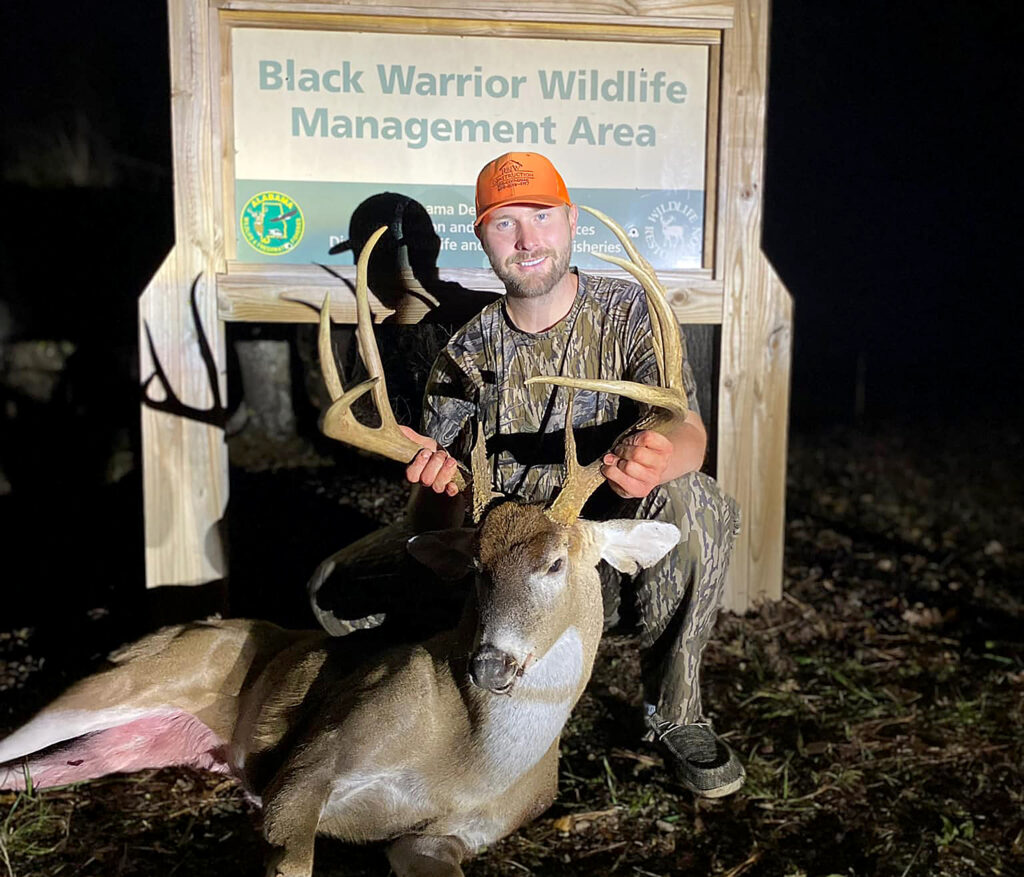
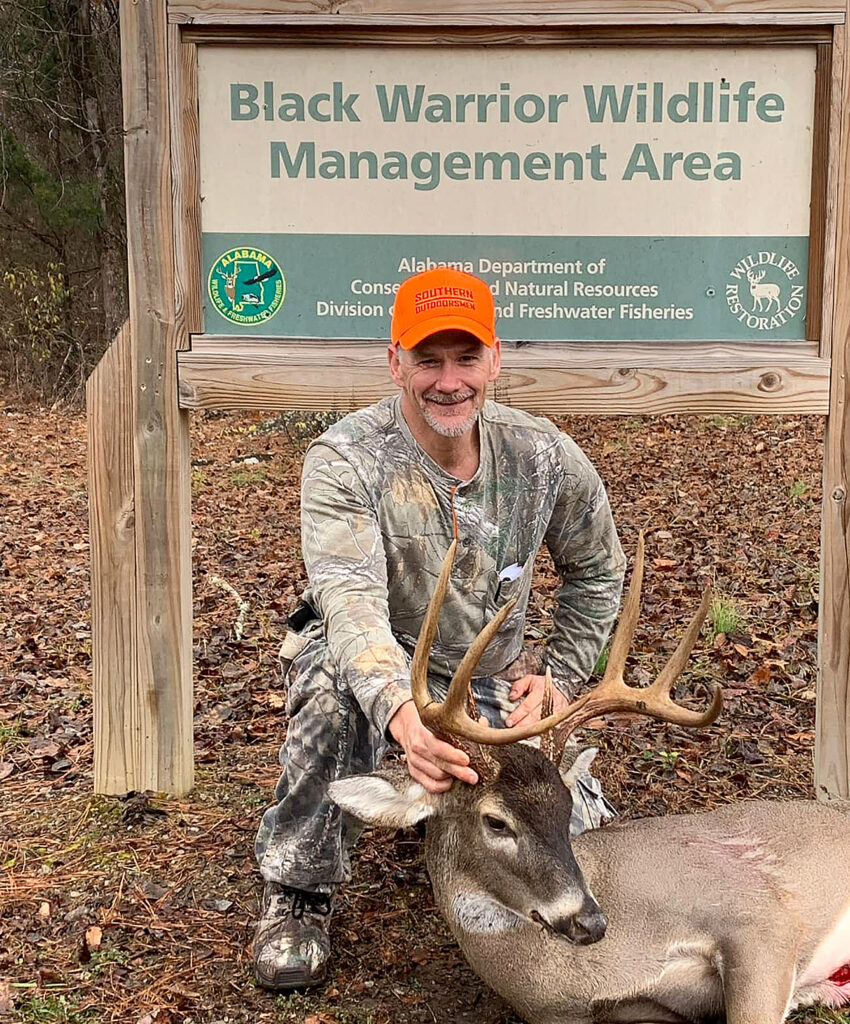
By David Rainer, Alabama Department of Conservation and Natural Resources
A dry fall may be a bane for waterfowl hunters in the South, but the impact on Alabama’s deer herd is negligible, according to Alabama Wildlife and Freshwater Fisheries (WFF) Division Deer Program Coordinator Chris Cook.
Cook said Alabama received abundant rain when it was most important to the state’s deer herd.
“With deer, as long as it’s wet during the time when they’re putting on antlers and when fawns are dropping, nursing and developing, it really doesn’t have much of an effect on deer,” he said. “This time of year, the deer are focusing on acorns. If it was wet when the acorns were forming, it doesn’t really affect them. I know in west Alabama, we had great habitat conditions when the fawns were growing and antlers were developing.
“It certainly hasn’t affected the harvest, based on what Game Check is showing so far. What’s been reported so far this year is about 5,000 more deer taken than at this time last year.”
Game Check is the WFF system that requires hunters in Alabama to report their deer and turkey harvests.
Any person in possession of a deer or turkey that is not their own must have written documentation with the name of the hunter, the hunter’s Conservation ID number (CID#), the date of the harvest and Game Check confirmation number. The information can be documented on a piece of paper, or a transfer of possession certificate is available in the Alabama Hunting & Fishing Digest or online at outdooralabama.com.
The documentation must be kept as long as that person is in possession of the deer or turkey. The hunter who harvests the deer or turkey is required to enter that animal into the Game Check system and maintain in his or her possession a valid confirmation number for that animal.
If you are exempt from having a license due to age or landowner status, go to https://www.outdooralabama.com/hunter-resources/GetYourCID to obtain the CID# that allows you to report your deer via Game Check.
The Outdoor AL app is the easiest way to report a harvest through Game Check, and you don’t need a paper harvest record when you use the app. Hunters can also comply online at outdooralabama.com or use the toll-free Game Check phone number, 1-800-888-7690. The phone line goes to a live person at a call center that is open 24 hours a day seven days a week.
Cook said the dry weather has definitely helped hunters spend more time in the woods, which translates to higher hunter success.
“Rain can keep people from hunting a lot of times,” he said. “Hypothetically, they should kill more deer because they have more days they can go hunting.”
Cook said when the acorn supply is finally exhausted, if the dry weather continues, it could affect the quality of the browse available to the deer and increase the use of supplemental feeding opportunities like food plots if they were planted when sufficient moisture was in the ground.
“Deer are more susceptible when there are fewer options for food,” Cook said. “But when the rut rolls around, the last thing on a buck’s mind is eating.”
If you’ve been keeping track of hunter success through social media, it’s apparent the number of quality bucks being taken in Alabama continues to be excellent.
“For the past three or four years in a row, we’ve had plenty of rain in the spring and summer in most areas, so the deer enter the wintertime in really good shape,” Cook said. “Winters have been relatively mild. Growing conditions have been great with no big swings in food availability. For the bucks, they’ve been able to recuperate from the winter and put more resources into antler growth.
“If you look at the ages of the deer that have been taken at Black Warrior WMA (Wildlife Management Area), those are 6- and 7-year-old bucks. If you’re looking for the biggest antlers, those are the ones you’re looking for. Those bucks 5 to 7 years old are in their prime for antler growth. I haven’t looked at the numbers of how many people are using Black Warrior, but it will probably go up after those pictures were posted. Most of our WMAs are underutilized, so the bucks have the opportunity to reach that age.”
Cook said Black Warrior WMA is one of the areas in Alabama with an early rut. The deer’s rutting activity is based mainly on genetics. Restocking efforts in the mid-20th century included trapping and relocating deer from southwest Alabama, mainly from the Clarke County area, as well as bringing in deer from other parts of the United States. Deer were transported from Arkansas, Georgia, Michigan, North Carolina, Ohio, Texas and Wisconsin.
For the most part, the transplanted deer maintained their native rutting activity, which means Alabama hunters can hunt the rut in one part of the state or another for most of deer season. Visit www.outdooralabama.com/what-hunt/deer-hunting-alabama to view the Alabama Deer Rut Map.
“The bucks at Black Warrior are rutting right now; they’re looking for does,” Cook said. “Choccolocco (WMA) is another one where rut is going on right now. We have several areas where the rut happens in mid to late December.”
Cook said Alabama has been fortunate chronic wasting disease (CWD) has not been reported, and monitoring and enforcement of the ban on importation of deer carcasses continue to be priorities.
Regulations do allow for the importation of certain parts of the deer but not whole carcasses. Permitted parts include:
- Meat from the family Cervidae (white-tailed deer, mule deer, elk, moose, fallow deer, red deer, sika deer, caribou, etc.) that has been completely deboned
- Cleaned skull plates with attached antlers if no visible brain or spinal cord tissue is present
- Unattached antlers or sheds
- Raw capes if no visible brain or spinal cord tissue is present
- Teeth if no root structure or other soft tissue is present
- Finished taxidermy products or tanned hides
“Most of the positive cases in Tennessee have been farther north and west of us,” he said. “It’s not any closer to Alabama than it has been. In Mississippi, the new cases are in areas where it had already been found. We’re still conducting our surveillance and focusing on adjoining counties to the CWD-positive states.
“We still sample other counties with various risks to CWD. We have a quota on how many we want to sample in each county. Our folks are working hard to get those samples. Hopefully we can make it another year without finding it.”
Hunters can also contribute to the monitoring effort by dropping off their deer heads at numerous self-help freezer drop-off sites. Go to www.outdooralabama.com/cwd-sampling for a map of freezer locations as well as other sampling options.
“In the surveillance phase, we focus on 2-plus-year-old bucks,” Cook said. “Those are our highest priorities. It’s been shown that when CWD shows up in a new area, it comes from the bucks that tend to roam from one area to another.
“Get in touch if you want to get deer sampled. And be sure to report your harvest on Game Check. That gives us the important data that we use to set seasons that benefit hunters and the resource.”
NWTF donates $122,000 for wildlife management
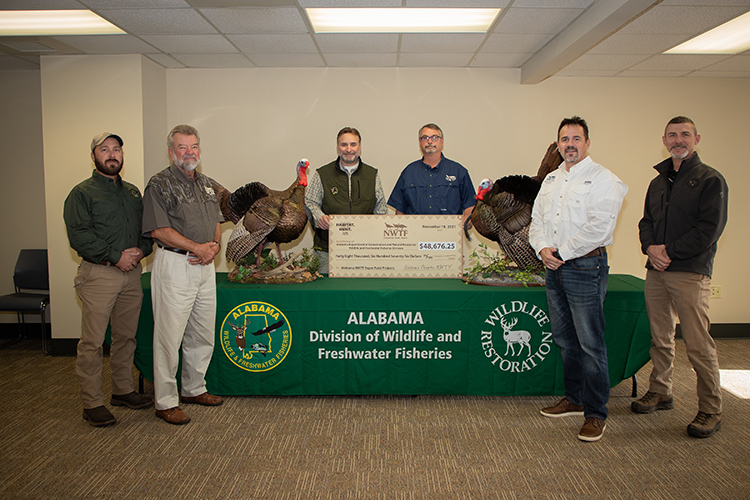
The Alabama Chapter of the National Wild Turkey Federation (NWTF) recently allocated $122,000 in Hunting Heritage Super Funds for wild turkey projects in Alabama. Of that total, $60,676 was donated to the Wildlife and Freshwater Fisheries Division (WFF) of the Alabama Department of Conservation and Natural Resources (ADCNR) to fund projects including wildlife habitat management and the publication of the annual wild turkey report, Full Fans & Sharp Spurs.
Approximately $61,000 was approved for other projects statewide, including funding to improve wild turkey habitat on public lands as well as to help launch outdoor education programs in schools. This funding supports the enhancement of turkey habitat, increases hunting access opportunities, funds educational programs and is an excellent fit for the NWTF “Save the Habitat, Save the Hunt” initiative.
Most of the WFF dollars will be used on Wildlife Management Areas throughout the state to support habitat management and other wild turkey programs. Some of the grant money will also be used to purchase much-needed wildlife habitat management equipment.
“About $48,000 of this generous donation offers us access to federal matching dollars, which makes the donation go even further,” said Chuck Sykes, WFF Director. “Since federal matching dollars play such a major role in how our division is funded, contributions like this are extremely important.”
WFF is primarily funded by money generated through the sale of hunting and fishing licenses. That money is then matched on a three to one ratio by the U.S. Fish and Wildlife Service through funds allocated to Alabama from the Pittman-Robertson Act. WFF does not receive an appropriation from the state’s General Fund.
“We thank NWTF and the Alabama Chapter Board of Directors for helping to support the conservation of wild turkey in Alabama,” said Chris Blankenship, ADCNR Commissioner. “With their assistance we will continue working to ensure the future of this resource for generations to come.”
In addition to the monetary donation, the Alabama NWTF chapter provides financial support for prescribed burning projects that help manage for quality habitat on public hunting areas, costs associated with public hunting land acquisitions, the Adult Mentored Hunting Program, the Archery in the Schools State Championship and the Becoming an Outdoors-Woman program.
The Alabama Department of Conservation and Natural Resources promotes wise stewardship, management and enjoyment of Alabama’s natural resources through four divisions: Marine Resources, State Lands, State Parks, and Wildlife and Freshwater Fisheries. To learn more about ADCNR, visit www.outdooralabama.com.
Alabama Extension’s ForestHER program celebrates five years
There will be no wool pulled over the eyes of ForestHER program participants throughout Alabama and the United States. Armed with a working knowledge of the forestry industry and a will to succeed, the graduates of the Alabama Cooperative Extension Systems’s ForestHER program are a force to be reckoned with.
Becky Barlow, the interim assistant director for Alabama Extension’s agriculture, forestry and natural resources programs, said the program was born out of a desire to equip women for success in a male-dominated field. While brainstorming ideas for the plan of work in 2016, Barlow said she wanted to help forestry agents think outside the box.
“Our goal is always to reach traditional audiences who need more information or continuing education,” Barlow said. “But I wanted us to reach outside of the box to an underserved demographic in our area of work—women landowners.”
With her grandmother, Nell Hill, and a past personal experience in mind, Barlow suggested developing a program that gave women an opportunity to ask questions and learn about land management in the classroom, then head to the woods for some hands-on experience.
“Grandmother was not a shrinking violet,” Barlow said. “But 30 years ago she was taken advantage of by a friend of a friend who brought her dinner and befriended her. Then he convinced her to let him harvest her trees to bring in some extra money.”
At that time, Barlow did a forest inventory for her grandmother. She determined that the friend had not given her grandmother a good price. In the end, the swindler left the land in a mess and made himself scarce. Her personal experience has fueled the education of nearly 1,500 landowning ladies from around the world in refined, elegant settings.
Barlow said there were 45 people at the first workshop in 2016. That number had grown to 150 attendees before the pandemic halted in-person events. However, COVID-19 didn’t prevent the forestry team from equipping landowning ladies.
Bence Carter, an Alabama Extension forestry, wildlife and natural resources regional agent, had already started an online lunch and learn opportunity before the pandemic hit. This existing online presence made the ForestHER transition to virtual programming a smooth one.
“The lunch and learn webinar series began as a way to fill a need for ladies who couldn’t participate in a day-long event for whatever reason,” Carter said. “We had a dedicated base through in-person events, but there were still those who wanted educational opportunities on their lunch break.”
When COVID-19 prevented in-person gatherings, ForestHER continued full-steam-ahead online.
An unanticipated positive outcome of online programming was the expanded reach. Through the online platform, Barlow and Carter have documented participants from 20 states and five different countries. Carter said some of these participants are potentially Alabama landowners who live out-of-state. However, there are still others who want the opportunity to gather and learn with like-minded people in similar situations.
“One of the most unique things about our program is the connections people make with others,” Carter said. “Yes, education is important, but the ability to reach out to others in similar situations is really an invaluable resource.”
Even before the programming went online, Barlow said they had participants travel from Michigan, Texas and Tennessee to attend workshops.
“We are proud to offer a program that continues to provide relevant educational information in an environment where women can freely ask questions, dig deeper and get hands-on experience,” Barlow said.
Carter said planning is underway for 2022 programming, with hopes to meet in person again soon. The team is currently working on topics of interest for the workshops. Barlow and Carter said they are always looking for participant input and topic suggestions. “No topic is too basic and no topic is too difficult,” Carter said. “We would love to hear requests and suggestions for topics that can be helpful to our participants.” To share a suggestion for a topic, contact Barlow or Carter by email. More information about ForestHER programming and upcoming workshop dates is available on www.aces.edu. Landowners can also tune in to the ForestHER podcast series.

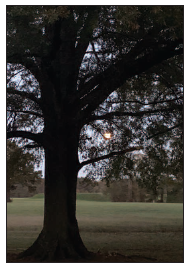
Mounds: Robert Tigert sent us this view, above, of the full moon rising over the Mounds on Nov. 18. Email us your local outdoors photos to [email protected].
Waterfowl Populations Predicted to be Good for Upcoming Season
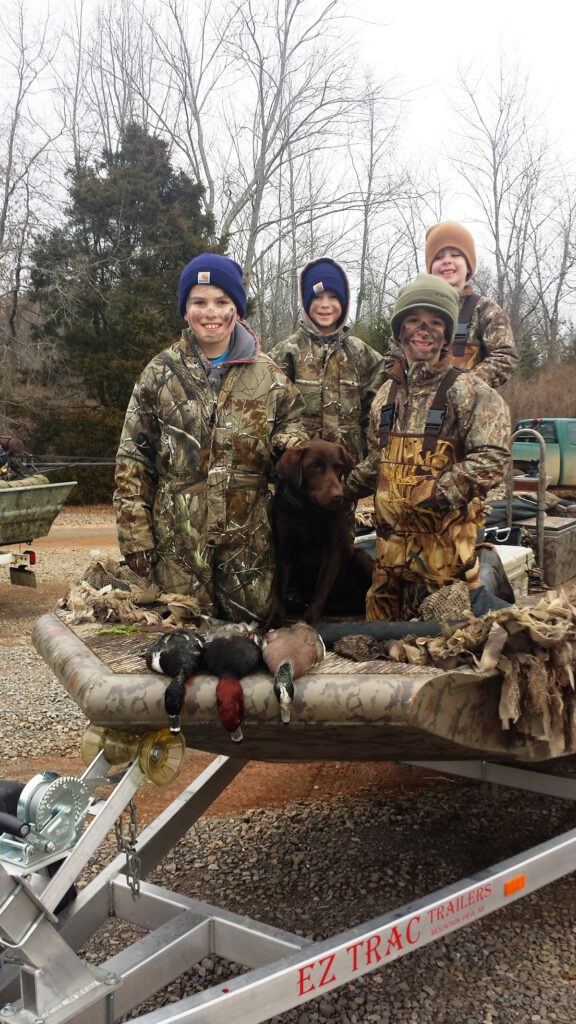
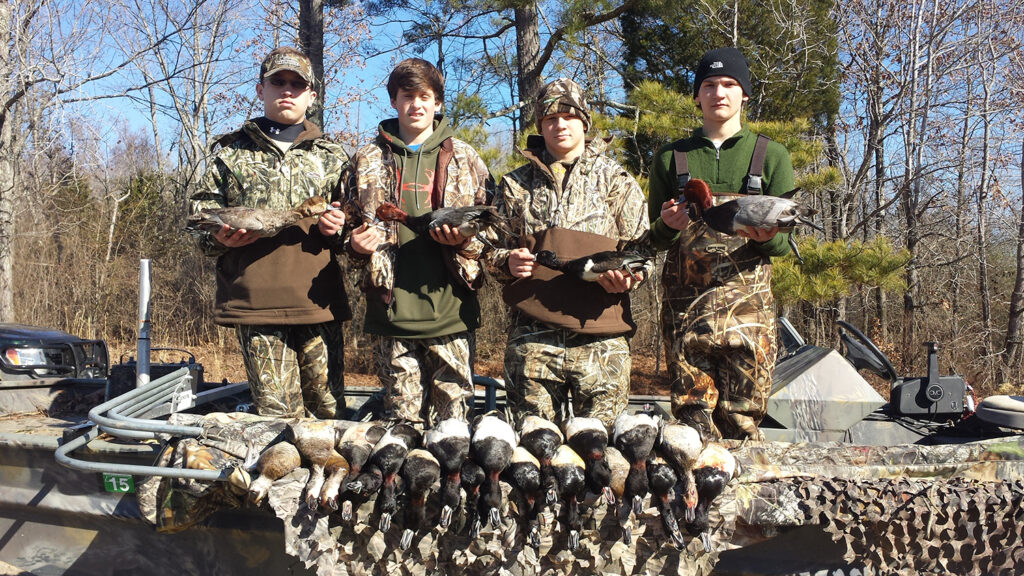
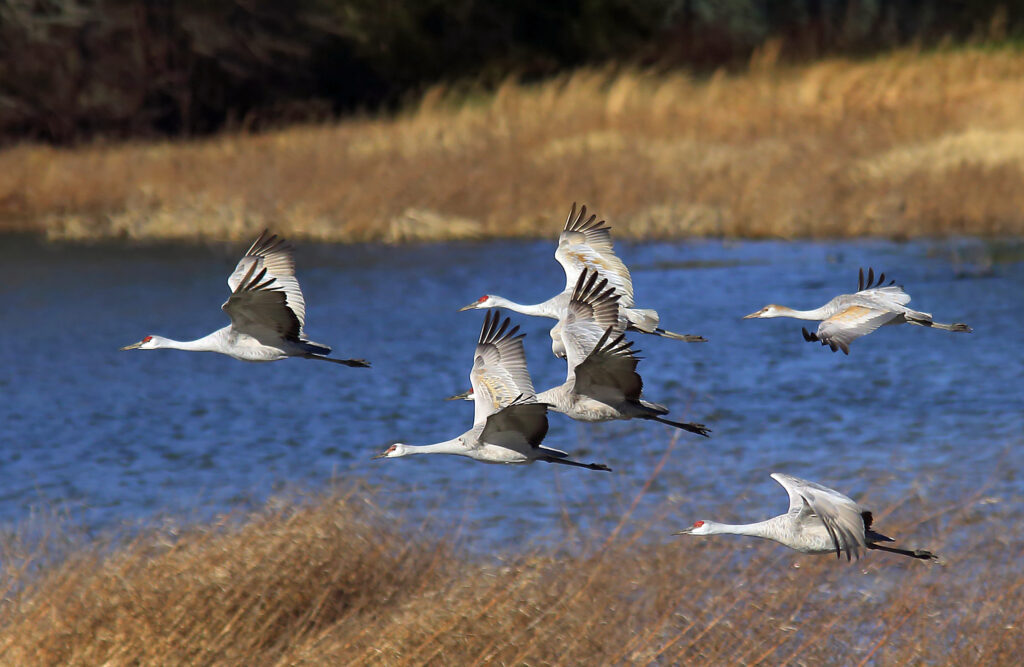
By DAVID RAINER
Alabama Department of Conservation and Natural Resources
Waterfowl season forecasters estimate good populations of ducks and geese for the Mississippi Flyway, which includes Alabama, but those waterfowl may not be easy to fool this season.
Seth Maddox, the Alabama Wildlife and Freshwater Fisheries (WFF) Division’s Migratory Bird Coordinator, said the U.S. Fish and Wildlife Service (USFWS) was unable to do its annual surveys again because of COVID-19 restrictions. What Maddox predicts, however, is that the fall and winter flights will contain more mature birds, which are wise to hunters’ tactics.
“The border with Canada was still closed back in May when they do the counts,” Maddox said. “That’s the second year in a row with no breeding survey. Last year’s harvest doesn’t tell us what the population looks like. Some states were not able to do a midwinter survey, so we don’t have a good picture of what the population looked like in the winter either.”
Without the surveys, Maddox said waterfowl managers are having to use other methods to estimate populations.
“We’re working on some predictive data, based on historical data,” he said. “We’re looking at weather patterns across areas where data can be collected remotely. We can collect rain gauge and other weather data and environmental patterns, which helps.”
Although the Southeast has had plenty of rain this year, some areas that affect duck populations have not.
“It was a really dry winter in the prairie pothole region, a core region for waterfowl,” Maddox said. “Then they had a dry summer. Basically, they went through a drought. So, production overall for the species that need those prairie pothole regions was probably pretty poor for this coming year.
“Luckily the populations were really good going into it. The long-term averages for most populations are real high right now.”
The problem for hunters is that the number of young-of-the-year birds, which are easier to call and decoy, will likely be down.
“The number of young birds will probably be poor,” Maddox said. “There were likely a lot of failed nesting attempts because there just wasn’t any water on the landscape to raise those ducklings.
“The fall flight is looking like it’s going to include a lot of adults, a lot of birds that have been there and done that. They’re going to be smarter, harder to kill, and they’re not going to take pressure very well. You’re going to have to reduce the pressure on these birds. If you’re used to hunting three or four days a week, you’re probably going to have to cut that back to a couple of days a week because those birds are going to get pretty smart.”
Of course, the success of Alabama’s waterfowl hunters is very weather dependent. A cold winter to the north with ice and snow covering the food source is needed to push the birds as far south as Alabama.
One plus for Alabama is it is located on the eastern side of the Mississippi Flyway and the western side of the Atlantic Flyway.
“The good thing about Alabama is we are on the edges of two flyways, so we get a good percentage of birds that breed in the east,” Maddox said. “They had favorable breeding conditions in the east in areas like Ontario and Quebec. They should have had better production because they had a lot more water on the landscape, and we could see some first-year birds from that flyway.
“We may not be in as big a struggle as some of the states to our west, like Arkansas, Louisiana, Texas and Mississippi.”
Maddox said computer models predict a good population of waterfowl for the 2021-2022 season, which means regulations will basically stay the same as last year’s.
The 60-day waterfowl season opens for two days on November 26-27 and then returns December 4 and runs through January 30, 2022. The special youth, active military and military veterans waterfowl hunting days are set for November 20 and February 5, 2022.
Duck hunters will again enjoy a liberal bag limit of six ducks per day that can be any combination of four mallards (no more than two of which may be female), three wood ducks, one mottle duck, two black ducks, two redheads, one pintail, two canvasbacks and one scaup.
Goose hunters for the 2021-2022 season will also enjoy a liberal season with a daily bag limit of five dark geese (Canada, white-fronted or Brant).
Maddox said one change for the goose seasons is the bag limit of five can include all Canadas or Brants. The light goose (snow, blue and Ross’s) bag limit is also five birds per day.
“The resident goose populations are high across the flyway, well above acceptable limits in many states,” he said. “In order to provide more opportunity for those birds, we bumped up the limit to five for the entire season for dark geese.
“Overall, the populations of Canada geese and white-fronted geese are doing good. We don’t kill a lot of white-fronted (specklebellies) or snow geese here in Alabama. You’ll see some white-fronted geese along the Tenn-Tom and see some at Wheeler National Wildlife Refuge in that north central part of the state. The rest of the state doesn’t see many of them. They really like that rice agriculture landscape, and the majority of that is in Texas, Louisiana and Arkansas. The rice agriculture has declined in Texas, and Louisiana has had to deal with the hurricanes. Most of the rice is being grown in Arkansas, and the white-fronted geese have followed.”
For those fortunate enough to be drawn for one of the 400 permits for Alabama’s third sandhill crane season, Maddox said crane numbers are up this year.
“We had a record number of people register for the sandhill crane permits,” he said. “We had 703 people apply, which is up from 620 last year. When you’re drawing for 400 permits, you still have very good odds of getting drawn.
“Last year was a really good season. There’s a record number of cranes in the state. We saw a little more than 23,000 birds on our survey, so there are a lot more cranes available. That’s almost double the amount in recent years.”
The sandhill crane hunting zone will be that area north of Interstate 20 from the Georgia state line to the interchange with Interstate 65, then east of Interstate 65 to the interchange with Interstate 22, then north of Interstate 22 to the Mississippi state line. Season dates are December 3 through January 9, 2022, and January 17-31, 2022. The crane limit is three per person per permit.
Alabama hunters harvested 391 cranes last season, up from 291 the previous season.
“I think that was due to a couple of factors,” Maddox said. “People started learning what it takes to hunt cranes as far as hides, blinds and decoys. And obviously the number of birds played a factor.”
The sandhill crane population continues an upward trend with an estimated 100,000 cranes in the Eastern population.
“With cranes and waterfowl, our seasons depend on the weather factor, what those winter temperatures look like to push the birds all the way into Alabama,” Maddox said. “With the population doing well, I think we’ll have a good number of cranes for the lucky hunters to chase this year.”
CWD sampling effort continues as deer seasons open
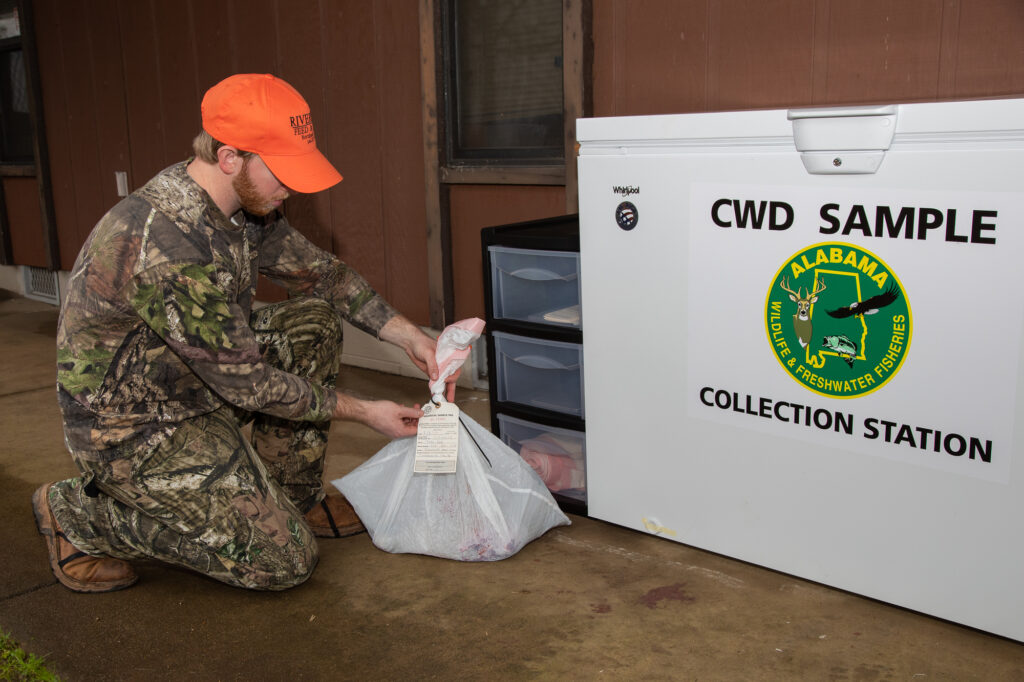
The Alabama Department of Conservation and Natural Resources’ (ADCNR) Division of Wildlife and Freshwater Fisheries (WFF) is encouraging hunters to utilize the self-service Chronic Wasting Disease (CWD) sampling stations located throughout the state as part of its annual CWD surveillance effort. Alabama’s archery deer season opened statewide on October 15. For complete seasons and bag limits visit, www.outdooralabama.com/seasons-and-bag-limits/deer-season.
CWD is a contagious and fatal neurological disease that affects members of the deer family. The disease was discovered in deer in parts of Mississippi and Tennessee in 2018, causing Alabama to intensify its CWD surveillance effort. To date, no cases of CWD have been found in Alabama.
For an up-to-date map with directions to the CWD sampling stations, visit www.outdooralabama.com/cwd-sampling.
To prepare the sample to be dropped off at one of the sampling locations, hunters must first remove the deer’s head leaving 4-6 inches of neck attached. Once it’s removed, place the head in the provided plastic bag and tie it closed. For bucks, antlers can be removed at the base of each antler or by removing the skull plate before bagging the head. Next, complete all sections of the Biological Sample Tag and attach it to the bag with a zip tie. Remove and retain the bottom receipt portion of the Biological Sample Tag before placing the bagged head in the freezer. Plastic sample bags, tags and zip ties are provided at each freezer location.
Additionally, hunters can have deer sampled at any WFF District Office or at the WFF office in Demopolis, Alabama. When providing samples at WFF offices, hunters can bring a whole deer, field-dressed deer or just the head from a harvested animal. WFF offices are open Monday through Friday from 9 a.m. to 4 p.m. Hunters should call ahead so a biologist is available to collect the sample. District office contact information is available at www.outdooralabama.com/wildlife-section.
Test results will be available online at www.outdooralabama.com/cwd-sampling-results within three to four weeks of dropping off the samples.
The Alabama Department of Conservation and Natural Resources promotes wise stewardship, management and enjoyment of Alabama’s natural resources through four divisions: Marine Resources, State Lands, State Parks, and Wildlife and Freshwater Fisheries. To learn more about ADCNR, visitwww.outdooralabama.com.

Hosts will be Buzzy Barnette and Jamie Colson. The Club has invited Ms. Meg Ford, Blackbelt Coordinator for The Alabama Audubon Society as guest speaker.
Ms. Ford will give an overview of Alabama Audubon history as a birding organization, an update on what the office in Greensboro has been doing and will share information about some local birding trips upcoming next year.
The public is invited to attend this talk. The site chosen for this meeting is a well known landmark in Greensboro.The Noel Ramsey House is the oldest home in Greensboro.Constructed between 1819 and 1821 by Thomas and Anne Hurtel Noel, it is the only surviving residence built by French settlers who came to Alabama to establish a Vine and Olive Colony.
It is also listed on the National Register of Historic Places and is now owned by the Historic Hale County Preservation Society.
Submitted by Georgia Rhodes
For Safe Hunting, Remember the Obvious
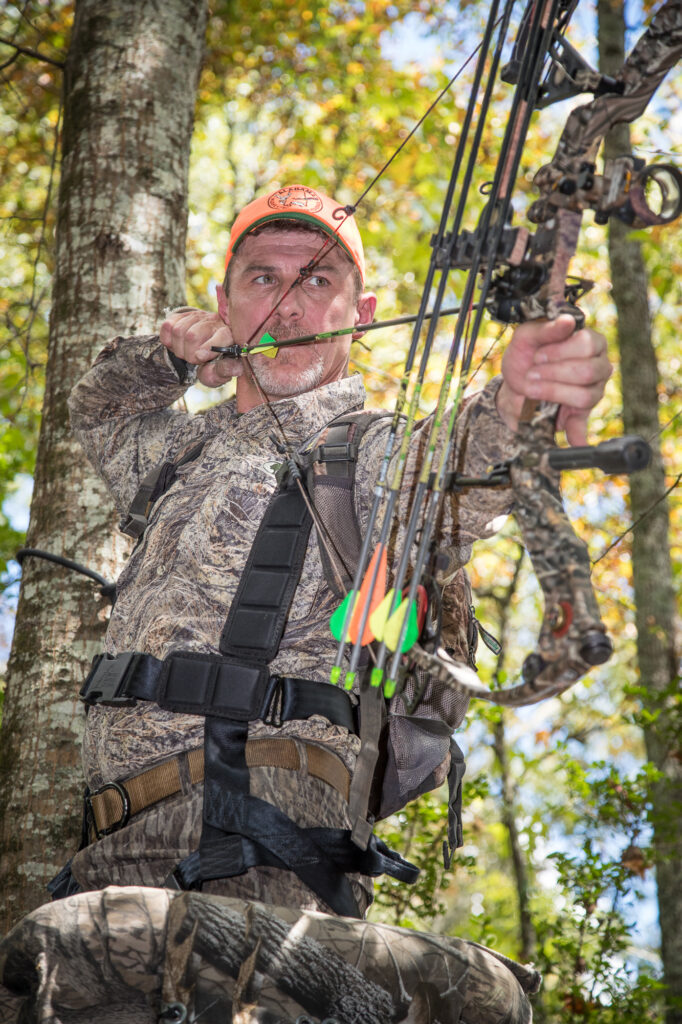
Now that hunters have taken to the woods for archery deer season, Alabama Department of Conservation and Natural Resources (ADCNR) Hunter Education Coordinator Marisa Futral hopes those using tree stands will remember to wear and use a vital piece of equipment, the full-body harness.
“It sounds obvious, but wearing your harness and not attaching it to the tree will not save you if you fall,” said Futral. “Most falls occur while ascending and descending, or stepping into and out of the tree stand, so it is extremely important to be attached to the tree at all times.”
Hunters should attach their full-body harness to the tree the moment they leave the ground, and it should stay attached until they are safely back on the ground. “Many hunters are diligent about wearing a harness, but they don’t attach it to the tree until they have already climbed up and are seated,” Futral said. “You are more likely to fall when you are moving, so attaching the harness before you start climbing is vital.”
Once at the desired height, hunters should keep a short tether between them and the tree with no slack when sitting. The tether should be fastened to the tree at eye level or above. This will allow an easier recovery if a fall happens. Never allow the tether strap to get under your chin or around your neck. Hunting bows should be pulled up and lowered with a strong cord or rope. When hunting with a gun, it should be unloaded prior to pulling it up or lowering it.
Hunting is one of the safest outdoor recreational activities. However, each hunting season Futral receives reports on hunting accidents that could have been avoided. Last hunting season in Alabama, there were 10 nonfatal tree stand incidents. In all of those situations, the hunter was not wearing a safety harness.
“While there were no tree stand related fatalities last year, hunters should remain focused on safety this season,” Futral said. “Never use a damaged or expired harness. And, most importantly, keep it attached to the tree at all times.”
Follow these tree stand safety guidelines for a safe hunting season
- Always wear a safety harness, also known as a fall-arrest system, when you are in a tree stand, as well as when climbing into or out of a tree stand.
- A safety strap should be attached to the tree to prevent you from falling more than 12 inches.
- Always inspect the safety harness for signs of wear or damage before each use.
- Follow all of the manufacturer’s instructions for use of a safety harness and tree stand.
- Follow the three-point rule of tree stand safety. Always have three points of contact to the steps or ladder before moving. This could be two arms and one leg holding and stepping on the ladder or one arm and two legs in contact with the ladder before moving. Be cautious that rain, frost, ice or snow can cause steps to become extremely slippery. Check the security of the step before placing your weight on it.
- Always hunt with a plan and, if possible, a friend. Before you leave home, let others know your exact hunting location, when you plan to return and who is with you.
- Carry emergency signal devices such as a cell phone, walkie-talkie, whistle, signal flare, PLD (personal locator device) and flashlight at all times. Keep them within reach even while you are suspended in your fall-arrest system.
- Always select a live, straight tree that fits within the size limits recommended in your tree stand’s instructions.
- Never leave a tree stand installed for more than two weeks since damage could result from changing weather conditions and/or from other factors not obvious with a visual inspection.
- Always use a haul line to pull up your gear and unloaded firearm or bow to your tree stand once you have reached your desired hunting height. Never climb with anything in your hands or on your back. Prior to descending, lower your equipment on the opposite side of the tree.
- Always know your physical limitations. Don’t take chances. Do not climb when impaired by drugs, alcohol or if you’re sick or fatigued. If you start thinking about how high you are, stop climbing.
For more hunting safety tips, visit www.outdooralabama.com/hunter-education-alabama/safe-hunting-tips.
The Alabama Department of Conservation and Natural Resources promotes wise stewardship, management and enjoyment of Alabama’s natural resources through four divisions: Marine Resources, State Lands, State Parks, and Wildlife and Freshwater Fisheries. To learn more about ADCNR, visit www.outdooralabama.com.
Gates at Weaver Cave Protect Habitat of At-Risk Bats
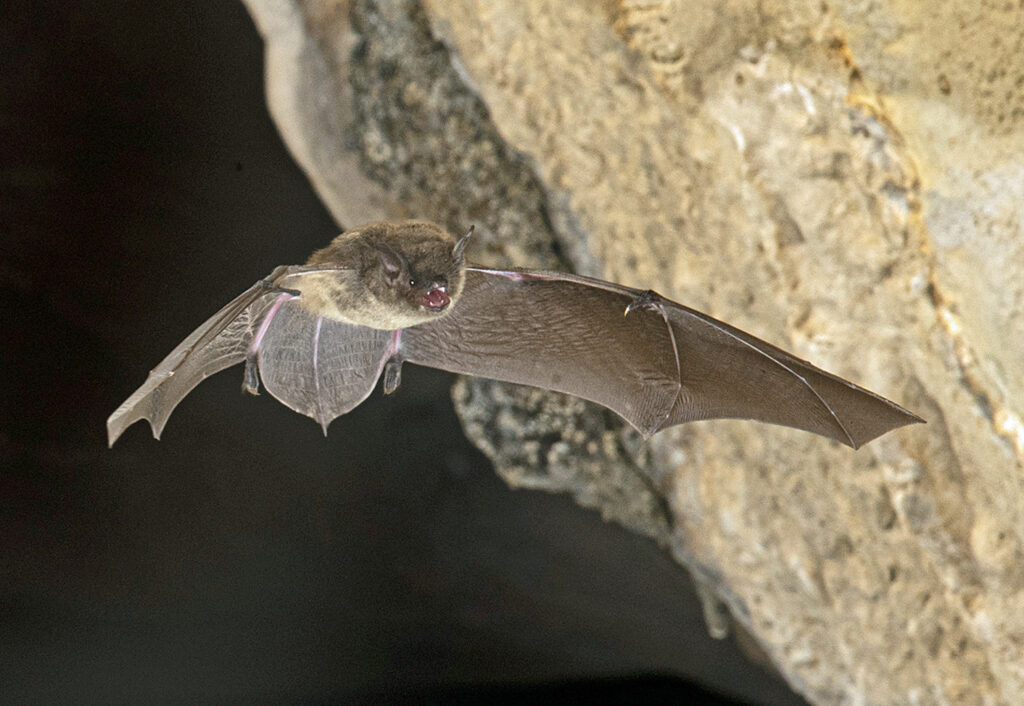
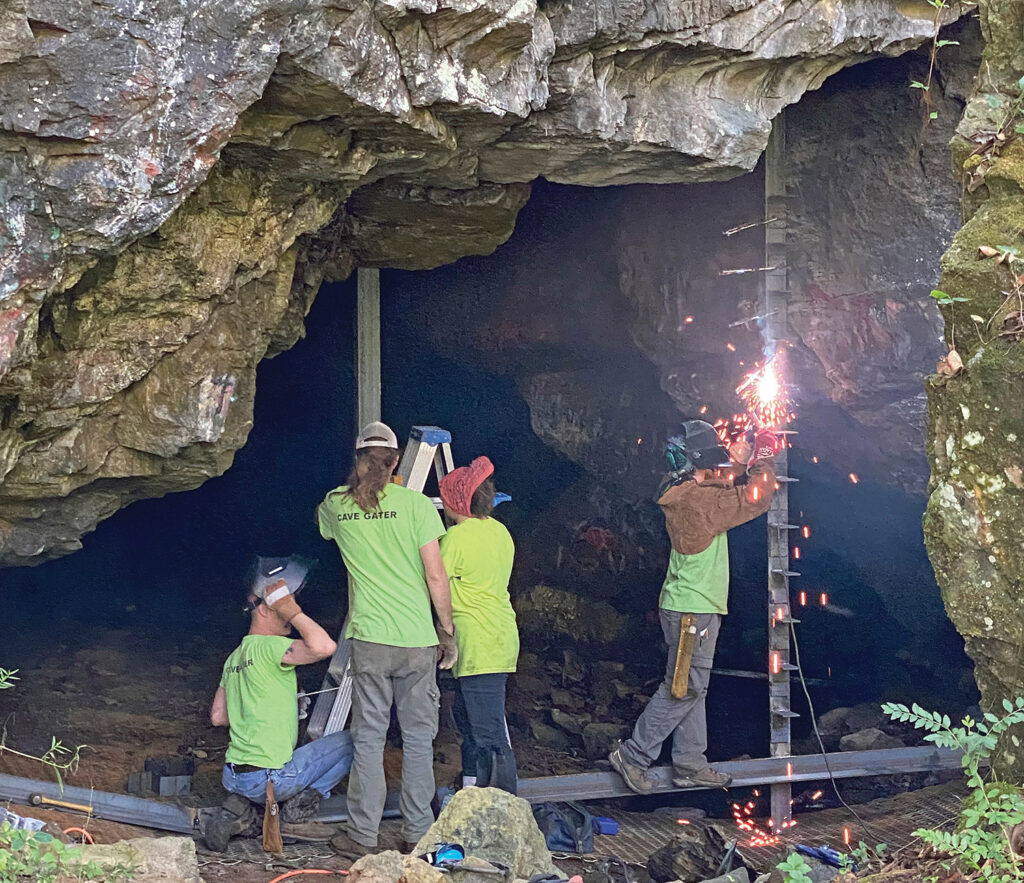
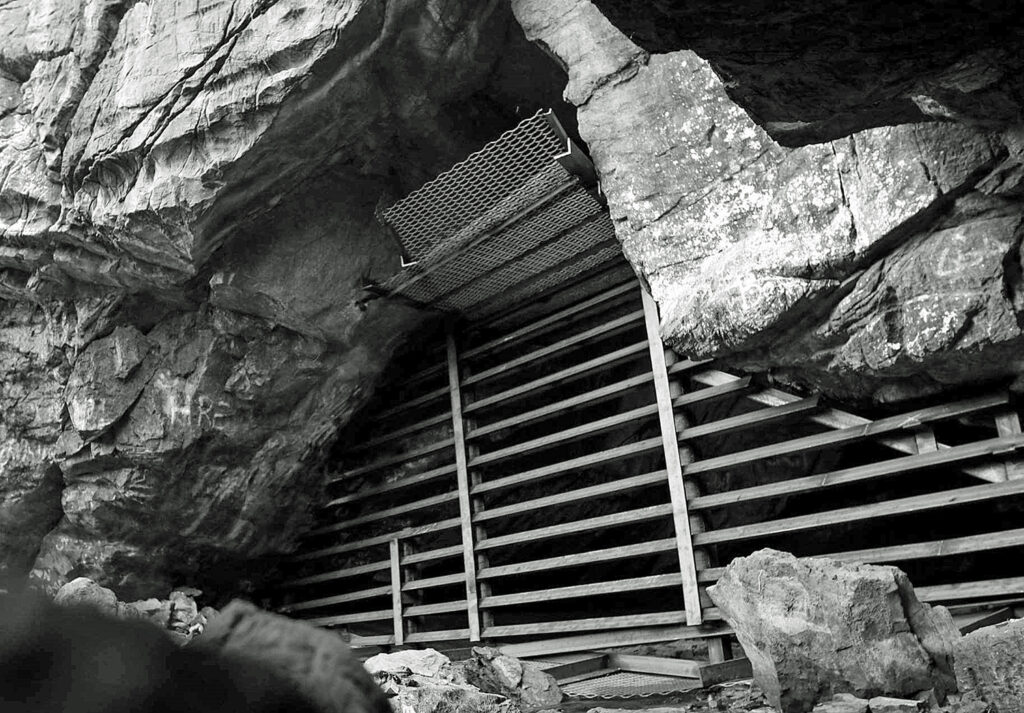
By David Rainer, Alabama Department of Conservation and Natural Resources
Important bat habitat in north Alabama has recently been protected in what Nick Sharp of the Alabama Wildlife and Freshwater Fisheries (WFF) Division considers possibly the highlight of his career as the Division’s bat expert.
Steel gates have been installed on Weaver Cave in Anniston to protect the extensive underground caverns as important bat habitat.
“Someone brought my attention to a YouTube video of bats coming out of the cave that was shot about six years ago by a local caver,” Sharp said. “When I saw it, I thought they must be gray bats. I started doing some investigating – catching bats coming out and counting bats coming out. We did some inside the cave surveys. It became apparent pretty quickly it was an important gray bat cave. Subsequently, we recognized it’s important for the tricolored bats as well.”
Gray bats are on the Endangered Species List and tricolored bats are under review to determine if listing as endangered or threatened is justified. Another endangered species, the Indiana bat, may also use the cave at times although more research is needed to verify its presence.
Sharp said Weaver Cave has a long history of human use. It was mined by the Confederacy for saltpeter during the Civil War. The mineral used to make gunpowder was loaded on the Selma, Dalton, and Rome Railroad less than a quarter mile from the cave and shipped to the furnaces in Oxford and Rome, Georgia. That railroad line is now the Chief Ladiga Trail.
Before and after the war, the cave was reportedly used for different social activities, like dances and parties. After lighting was installed in the cave in the early 1900s, it became a popular destination for picnicking, school field trips, and Sunday school outings.
Sharp said gray bats, northern long-eared bats, and tricolored bats were documented in the cave as early as 1959. Because gray bats are extremely sensitive to human disturbance in their caves, the bat populations crashed through the early to mid-1900s. The species was listed as Endangered in 1976. The cave is now home to about 10,000 gray bats in summer. About 600 tricolored bats use the cave in winter, making it an important hibernaculum for this at-risk species.
When the Georgia-Alabama Land Trust acquired the cave in 2020, WFF contacted the Trust about protecting the bat habitat with the use of steel gates to prevent people from entering.
With funding provided by the U.S. Fish and Wildlife Service and the Natural Resources Conservation Service, the gates were constructed and installed by Kennedy Above-Underground.
“These are called bat-friendly gates,” Sharp said. “A lot of investigation and thought was put into the design of these gates. They don’t restrict air flow at all. The main entrance to Weaver is the one where almost all of the bats come in and out. The bats always come out near the top so that was left open to give them enough room so they could flow out and the bats do not get backed up behind it.
“We’re grateful to all the partners that made this rare conservation success possible,” Sharp said.
Although the caverns were once thought to be two different caves – Weaver (6,100 feet long) and Lady (6,400 feet long) – exploration by cavers determined the two were connected. They’re now commonly known as Weaver Cave.
“The cave system is quite extensive,” Sharp said. “It has multiple passages and chambers. I understand that Lady Cave was once used as a bomb shelter because it has a large cathedral size chamber. We found some gray bats roosting in that chamber in the spring. Part of the cave has a creek running through it, and a lot of bats roost in that area.
“Gray bats are real particular what caves they will use. For whatever reason, they like this cave. I think some of it has to do with air circulation. In the summer, they like high domes because it traps heat.”
One area with a high ceiling is called the Chicken Room because the owner at the time attempted to raise chickens in the cave under artificial lighting.
Sharp said 15 species of bats have been documented in Alabama. The animals with a spooky reputation make a very valuable contribution to agriculture in the U.S.
“The point I always make about the bats in Alabama is they are all insectivores,” he said. “They all provide that ecological service of pest control. A recent research paper came out looking at the bats in south Alabama and what crop pests they were eating.
“Another study that is often cited indicates that bats provide a minimum of $4 billion in pest control for agriculture in the U.S. With all the species we have, bats are eating billions of insects each summer night in Alabama.”
Sharp said the distribution of bats in Alabama varies a great deal. Gray bats are common in north Alabama along the Tennessee River
“The red bat is probably the most common species we have in Alabama,” he said. “They roost in trees and not caves. They look like dead leaves when they roost. In the evening, if you’re looking in the night sky and see a bat flying, it’s likely a red bat or a big brown bat, which is another common species we have.”
Sharp said the populations of the northern long-eared bat and the tricolored bat suffered serious declines because of white-nose syndrome, a disease caused by a fungus introduced from Europe.
“White-nose syndrome is still raging on, unfortunately,” he said. “It continues to spread west. It made it to the West Coast and is slowly covering the western U.S. We have spent a lot of money on ways to prevent it but have not been successful. Some species are near extinction.
“Northern long-eared bats used to be common in Alabama. Now they’re very rare. We never catch them anymore.”
Sharp said the protection of Weaver Cave should be celebrated.
“This is a big win for conservation,” he said. “It’s rare in conservation in general to see a big win like this. Bats, specifically, because they’re getting hammered so hard by white-nose syndrome and suffer a bad reputation. Putting restrictions on a cave of this importance is a big deal. The cave is right beside a road and has been so heavily vandalized in the past. People had been going in it all the time. Now that the gates are up and it’s protected, it’s going to be interesting to see if the numbers increase. There are roughly 10,000 gray bats in there in the summertime. Just protecting them alone is a big win for conservation.”
Having been in this position for almost 8 years, Sharp said, “This has to be a candidate for most the important thing I’ve been a part of in this job since I’ve been with Wildlife and Freshwater Fisheries.”
Bats: Dangerous Blind Blood-Suckers or Helpful, Biological Pest Control?

TUSCALOOSA, Ala. – Night falls. A thick, black, curtain of darkness envelops the sky. The air is still and silent.
Suddenly, a creature with long, disproportionate claws with flaps of veiny skin between its fingers, appears in the air flapping its dark-colored skin-wings swiftly.
A shimmer of light gleams off the glistening, prominent, curved fangs in its agape maw.
Blood.
Blood is what it’s after, right?
No, human blood is not what bats feed on, said Dr. John Abbott, chief curator and director of the Department of Museum Research and Collections at The University of Alabama.
Bats are found all over the world, but only two types that range in the tropics are blood-feeders. Abbott said this rumor has unfortunately caused bats to gain a bad reputation when they’re really one of the most helpful mammals in existence.
“There are only four groups of organisms that have ever taken flight in our history,” Abbott said. “Pterodactyls, which are extinct, birds, insects and bats, which are the only flying mammal.
“Bats are of an incredible benefit to us. Bats often feed on insects like moths and beetles, many of which are pests that eat crops.”
Abbott said there are 16 species of bats in Alabama, three of which (gray myotisare, Indiana myotis and Northern long-eared myotis) are listed on U.S. Fish and Wildlife Service’s Endangered Species list.
For the most part, these nocturnal mammals stay out of people’s way, so encounters with them are rare. The occasional bat in the attic does occur, however.
Bats harbor many diseases, Abbott said, but they’re unusual in that they rarely become sick themselves. Some species are being affected by white-nose syndrome, which is a fungus that’s afflicting and killing bat populations in Alabama and the Eastern U.S., particularly cave species that hibernate in large numbers together.
White-nose syndrome doesn’t affect humans, but it does have an impact on people because it devastates bat populations, which in turn affects insect populations.
Rabies can also be a concern. Most bats don’t have it, but some do.
“If you see a bat during the day on the ground, don’t touch it because it could have rabies,” he said. “That’s rare though. They’re harmless to us other than rare scenarios like that.”
Another misnomer about bats is that they’re blind. Abbott said they can see, but sight isn’t the main way they hunt their prey.
Like dolphins, bats use echolocation through chirps issued from their nose or mouth that bounce off the environment to help them determine the speed and density of objects so they can figure out what are viable prey items.
“What’s neat is that some moths have developed a way to detect bats’ echolocation so they can avoid getting eaten by them,” Abbott said. “So, they’re in an evolutionary race to out-compete one another.”
Abbott said since bats fly with their elongated fingers and not their arms, they fly differently than birds do.
“They’re very acrobatic flyers,” he said. “Bats swim through the air.”
Abbott said one of the unique bat species in Alabama is Rafinesque’s big-eared bat. The reason is in its name. It has giant ears, almost like rabbit ears. They roost in abandoned houses and similar places.
The University of Alabama, part of The University of Alabama System, is the state’s flagship university. UA shapes a better world through its teaching, research and service. With a global reputation for excellence, UA provides an inclusive, forward-thinking environment and nearly 200 degree programs on a beautiful, student-centered campus. A leader in cutting-edge research, UA advances discovery, creative inquiry and knowledge through more than 30 research centers. As the state’s largest higher education institution, UA drives economic growth in Alabama and beyond.
Extension Office News You Can Use
Trunk or treat at Hale Extension office Thursday
By: Jovita Lewis, County Extension Coordinator
Extension in Your Community: Staff of the Hale County Extension Office will reach out to local families during a “Trunk or Treat” on Thurs., Oct. 21 from 3:00 pm to 5:00 pm in the parking lot of the Hale County Extension Office located at 701 Hall Street, Greensboro, Alabama. The theme for this year’s event is “A Day at the Farm”. Come see our decorated trunks and harvest some unique treats. We invite adults and children alike to dress in a farm-related costume. Judging for the theme-related costume contest will take place at 4:00 pm in the parking lot. Through this agency outreach effort, we will bring adults and children in the community together to stress key educational messages. Face coverings and social distancing are required. During this free family affair, we also ask that children be accompanied by an adult. Don’t be tricked into thinking the Hale County Extension Office is not a treat. We have something in store for the community!
Agricultural Producer Sign Up for Financial Assistance: My colleague, Sutton Gibbs, USDA NRCS District Conservationist, has announced a cost assistance program available through the local Natural Resources Conservation Service Office here in Greensboro. Through the first application batching date of November 12, 2021, eligible landowners and agricultural producers can receive financial and technical assistance to help manage natural resources in a sustainable manner. Financial assistance is available to help plan and implement conservation practices that address natural resource concerns or opportunities to help save energy, improve soil, water, plant, air, animal, and related resources on agricultural lands and non-industrial private forest land. Special emphasis participants such as the socially disadvantaged, limited-resource, new and beginning, and eligible military veteran farmers and ranchers are eligible for a higher payment rate. Also, those historically underserved farmers and ranchers are eligible for a 50 percent advanced payment for purchasing materials or contracting to help with practice implementation in one of the programs. For more information, contact the USDA Service Center in Greensboro at 334-624-3265 or visit online at www.al.nrcs.usda.gov
Pink Out Day: To celebrate Breast Cancer Awareness Month, the Hale County Extension Office will observe “Pink Out Day” on Friday, October 29, 2021. We invite the public to stop by our office and receive a free educational packet on breast health. The “come and go” event will feature opportunities for learning, sharing and celebrating during the course of the day during our regular business hours.
4-H Sweet Potato Fundraiser: You asked for it and its back! The Hale County 4-H Sweet Potato Fundraiser is currently in progress. You can purchase 40 pounds of home grown, Mississippi sweet potatoes for $25.00. Drop your check or money order off at the Extension Office. Checks should be made payable to ACES. Deadline to order is November 1 and the pick-up date is either November 18 or 19. This is a great way to support Hale County 4-H and Extension programming.
That’s All Folks: Until next week, here’s a thought to remember: “To most people, it’s dirt, to the farmer, it’s potential”.
WFF Officer’s Tracking Skills Key to Finding Lost Child
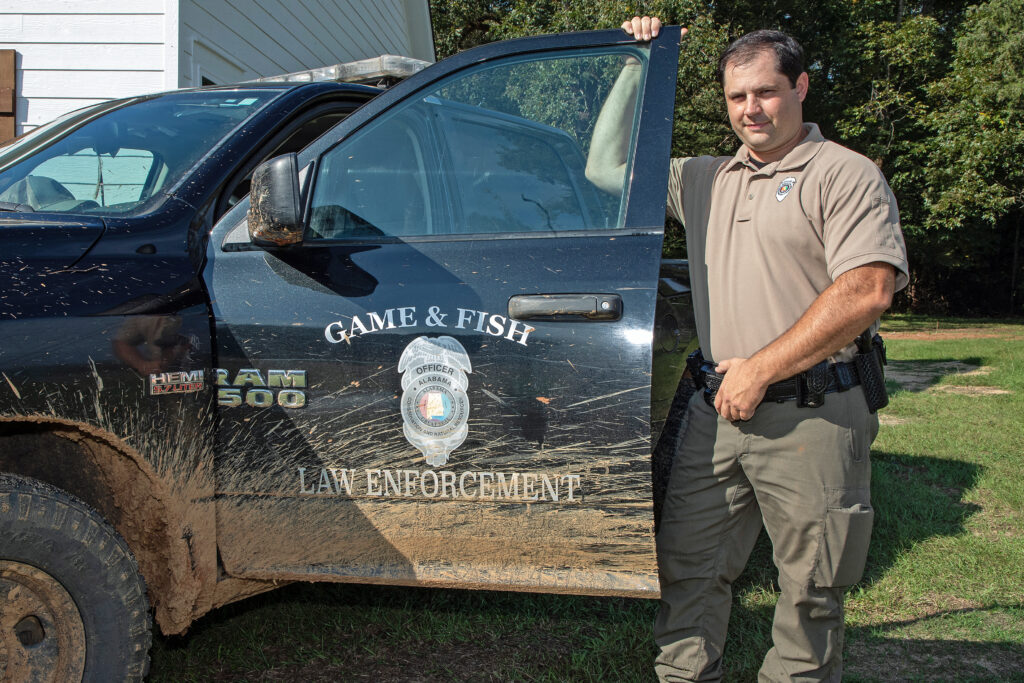
By David Rainer, Alabama Department of Conservation and Natural Resources
A missing child may be the most frightening situation a community can imagine, and sometimes it takes a seasoned tracker to yield a successful outcome.
Alabama Wildlife and Freshwater Fisheries (WFF) Conservation Enforcement Officer (CEO) Chris Hill found himself in just that scenario recently when a 3-year-old child was reported missing in Autauga County.
Hill was called by a local farmer who asked if Hill had heard about a missing child. He hadn’t.
“I called the sheriff, and they were looking for a child in the woods,” he said. “I said if he’s in the woods I’m coming to help.”
The WFF maintains a K-9 unit for tracking fugitives and missing persons, but none of the dogs were available at the time. When Hill arrived at the site, the first rule of tracking – don’t compromise the search site with human scent – was already out the window. Human nature in a situation like that is to venture into the area where the child was last seen and walk around looking for him. People do this out of the best of intentions with a genuine desire to help. Often, however, this makes the search much harder for those who come later.
“When I got there, I guess it had been put on social media because there were already 100 people there,” he said. “I found the sheriff when I got there and got an update. The daddy was cutting grass and the little kid was in the backyard, playing like he always does with his dog. The dad went to cut grass in the front yard.”
When he came back around to the backyard, his son had disappeared. When the youngster wasn’t found inside the house, the father called for help. When Hill arrived, a rescue squad was starting a grid search.
“There were two hunting roads, basically fire breaks, that lead in directions behind the house,” Hill said. “Before I got there, the rescue squad had a bloodhound that tracked something to a food plot about 350-400 yards behind the house, but the dog lost the scent at the food plot.”
Hill said between 40 and 50 people performed the grid search with flashlights behind the house and found no sign of the child.
The ALEA (Alabama Law Enforcement Agency) Aviation helicopter was also flying overhead searching with its FLIR (forward-looking infrared) thermal imaging camera and also found no trace of the missing youngster.
“After the grid search, we were coming back,” Hill said. “I wasn’t aware they had used a bloodhound before I got there, and somebody said the bloodhound had tracked the kid to a green field. I told the sheriff I was going back to the green field and look around.
“I had two deputies with me, (Ryan) Holena and (Devin) Lincoln, who I had worked with before I became a Game Warden. When we got down there, I looked around and told them, ‘This is a 3-year-old boy. He’s not going to walk through these briars,’ because it was thick.”
They looked around the food plot in the young pines, searching for any trails the youngster may have followed. When they got to the bottom of the food plot, they realized several ATVs had driven through the field looking for the boy.
“We found a four-wheeler trail at the bottom of the field that looked like it hadn’t been used since last hunting season,” Hill said. “We went down that trail, and it was pretty steep. It was mostly pine straw, but I could tell something had walked through there. The pine straw was turned. We kept going and all of a sudden there were a couple of briars across the path and drug downhill. I told them something had definitely been down this trail.
“Then it turned to a hardwood bottom, and I thought we would be able to pick up any footprints. That’s when I found something. I told them it was small, but it was definitely a human footprint. We had to find out if the search party had been down here. If not, the child had come that way.”
Despite calling Eli’s name often, the men didn’t hear a response. They decided to go back to the house and charge their flashlights. Hill found out nobody had been to the area in the hardwood bottom, and he asked about getting a dog to search that area.
A team from the Red Mountain Search Dog Association had just arrived at the scene and was tracking in an area that had undergone the grid search but with no positive results.
Hill then told the team about tracking somebody down the hill to the hardwood bottom, where he found a footprint. They went to that point and released the dogs.
“The dogs walked all over the hardwood bottom while we yelled, ‘Hey, Eli,’” he said. “I guess it was a good 30 minutes later, and they came back and said they just didn’t have anything.”
Hill said a little after 2 a.m., the ALEA helicopter had to go to Montgomery to refuel. He suggested making a horseshoe search around the bottom perimeter of the green field.
Instead of giving up, Hill and the deputies took advantage of the absence of helicopter noise to continue shouting Eli’s name.
“All of a sudden, about 50 yards ahead of us, I said ‘Eli’ and, to my surprise, Eli responded back, ‘Hey,’” Hill said. “I jogged over to him. He’s lying on a fallen stump and his puppy is lying right between his legs. I picked him up and said, ‘Hey, Eli, how are you doing?’ All he wanted to do was show me his puppy. I told him, ‘Yeah, baby, I see your puppy. That’s a good puppy.’ He was in good spirits. His legs were cut up from walking through the briars all night. Then he wanted to tell me about the stars he had been watching. He wanted to find the moon. I told him we’d go find it.
“He was not scared at all, like I figured he would be after sitting out in the woods all night. It was about 2:45 when I scooped him up. I was just glad to get him out of the woods.”
Hill lamented that one of the WFF K-9 dogs wasn’t available.
“If my partner, Jason McHenry, and his dog had been there and I’d have put him on that track, I promise you we’d have gone straight to that boy,” Hill said. “Jason’s dog went 2 or 3 miles looking for a turkey poacher last year and caught him. I know for a fact that if our beagle had been there, he would have found that boy.
“We found him about 350 yards from that green field. I sure am glad I recognized those tracks.”
“Sight tracking, or the act of reading those visual signs left behind as a person or animal passes through an environment like a wooded area, is a fundamental skill that every Alabama Game Warden learns early,” said WFF Law Enforcement Section Chief Michael Weathers. “They will continue to use and hone that skill every day of their career. They are the subject-matter experts when it comes to detecting and tracking people in the woods. In the greater law enforcement community, each agency has its own special resource to offer. Like the air assets that ALEA brings to events like this, or the tracking dog teams that the Alabama Department of Corrections offer, we are always happy to volunteer the ‘off pavement’ tracking skills that our officers possess. When the opportunity to put tracking skills to work saving lives arises, you can expect an officer like Chris Hill to be the first to arrive and last to leave. He has the talent and work ethic to make a difference.”
Extension Office News You Can Use
National 4-H week and sweet potato fund raiser
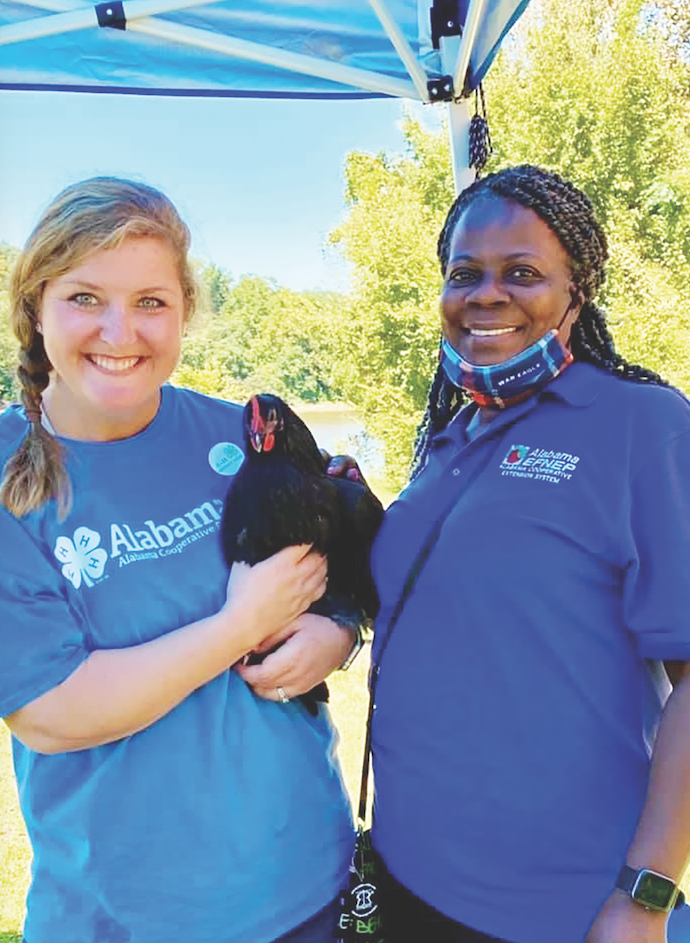
By: Jovita Lewis, County Extension Coordinator
Extension in Your Community: Staff of the Hale County Extension Office reached out to the Sawyerville Community during 8th Annual Sawyerville RiverFest on Saturday, September 25, 2021. Laura Miller, 4-H Foundational Regional Extension Agent had the opportunity to exhibit about 4-H while Willie Braggs, EFNEP Nutrition Educator showcased ways to have a safe picnic. We were honored to have Olevia Rice, our State 4-H Ambassador also participate in activities during this year’s Sawyerville RiverFest. Tera Glenn, Regional Extension Agent, Human Nutrition, Diet and Health will be presenting the “Escape Vapes” and “Rite Bite” program to 6th graders at Hale County Middle School during the month of October. In addition, I am looking forward to presenting a unique program on different programming that the Hale County Extension Office has available to the Magnolia Home and Community Leaders during this month as well.
National 4-H Week: National 4-H Week was observed October 3-9, 2021. This is an important week at the Hale County Extension Office because we have a chance to highlight the remarkable 4-H youth in our communities while showcasing the incredible experiences that 4-H offers our young people. The theme for National 4-H Week was “Find Your Spark”. Whether it’s learning, perseverance, healthy habits, life skills, confidence, intellect, or creativity, 4-H can provide the outlet for youth to find their passion and explore learning through hands-on learning experiences. The positive environment provided by Laura Miller, our 4-H Foundational Regional Extension Agent and our 4-H volunteers ensures that youth throughout Hale County will take on leadership roles and become empowered with citizenship skills that lead to a successful life and career. We are currently enrolling youth in 4-H. If your child missed the opportunity to enroll in 4-H at school, please let us know. In addition, all interested youth are invited to participate in our first 4-H Youth Council Meeting to be held on Thursday, October 28, 2021 at 5:30 pm at the Hale County Extension Office, 701 Hall Street, Greensboro, AL. Call us at 334-624-8710 for more information on enrolling in 4-H or attending the Youth Council Meeting.
4-H Sweet Potato Fundraiser: You asked for it and its back! The Hale County 4-H Sweet Potato Fundraiser is currently in progress. You can purchase 40 pounds of home grown, Mississippi sweet potatoes for $25. Drop your check or money order off at the Extension Office. Checks should be made payable to ACES. Deadline to order is November 1 and the pick-up date is either November 18 or 19. This is a great way to support Hale County 4-H and Extension programming.
That’s All Folks: Until next week, here’s a thought to remember: “Once in your life you need a doctor, a lawyer, a policeman, and a preacher, but every day, three times a day, you need a farmer.”
Greensboro Garden Club September Meeting

The Greensboro Garden Club met Tuesday, September 28 at the home of Aaron Head and Tim Wiggins. Members made plans for the District Garden Club meeting that will be hosted by this club at the Greensboro Presbyterian Church on Mon., Oct. 11. At that time, Garden Club members had a plant and tree sale outside the Parish Hall entrance.

Begin Deer Season with Food Safety in Mind
By Maggie Lawrence
Deer season opens Oct. 15. Mark Smith, a wildlife scientist with the Alabama Cooperative Extension System, says hunters need a game plan to get venison from the field to the table safely.
“Hunters need a plan for managing heat, moisture and bacterial contamination,” said Smith. “Those are the big three factors that can cause meat to spoil.”
He said while there is no “right” way to field dress a deer, the bottom line is to choose a quick and efficient method that minimizes the exposure of meat to bacteria.
“Potential contamination sources include the animal’s rumen or other stomach material, feces, urine and foreign debris such as dirt,” Smith said. “Remember bacteria naturally occurs just about everywhere.”
Best Practices
Smith offers specific tips for ensuring harvested meat is safe for the dinner table.
Cool the carcass quickly and keep it cool. Meat must be kept cool from the time that the animal dies until it is cut, packaged and placed in the freezer, or until it is consumed. Cooling game to less than 40oF as quickly as possible will slow the growth of bacteria and keep the meat from spoiling.
Remove the hide to ensure proper cooling if the carcass will hang outside to cool. A general rule of thumb for deer-sized animals is to remove the hide if temperatures exceed 40o F.
Avoid the use of plastic bags or tarps for transporting the carcass or parts such as hind quarters or backstraps. Plastics seal in moisture and heat. Use breathable cotton game bags or heavy-duty cheesecloth bags made specifically for game meat.
Keep the knife as clean as possible during field dressing and butchering. Use anti-bacterial hand wipes to clean the blade and hands when needed.
If the hunting weather is warm, consider purchasing an insulted cooler bag to help keep the carcass cool. These full-sized insulated bags will hold an entire carcass along with ice to keep temperatures safe.
A slurry of ice, water and salt can be used to cool meat quickly. Add coarse salt and water to a cooler full of ice and stir.
As soon as possible, hoist the carcass to allow better air circulation and speed the cooling process.
Never tie a deer carcass on over the hood of a vehicle. Engine heat can ruin meat in a hurry.
If the cavity needs rinsing due to leakage of intestinal fluids, feces or urine, do so sparingly. Then, wipe dry immediately using paper towels. Moisture causes bacteria to multiply—potentially causing meat spoilage.
More Information
Smith said having plans on how to handle a harvested animal before leaving for a hunt will help ensure hunters bring home healthy and safe meat for their families to enjoy. For more information, visit the Alabama Extension website.
Alabama Extension’s video series on deer processing may be of particular interest to deer hunters.
Stop the Stink Bug Stench
By Mary Leigh Oliver
There are many wonderful characteristics of fall, but stink bugs are not one of them. As temperatures drop, stink bugs and other cold-blooded bugs begin to find their way indoors. While they are harmless to people and pets, their stench and constant presence is enough for homeowners to want to keep them out.
Alabama Extension Specialist Xing Ping Hu has the inside scoop to avoid the stink bug invasion this fall.
Stink bugs will enter homes by any means necessary when temperatures begin to drop.
“They can be found in large numbers on the outsides of buildings or inside near doors, windowsills and other entry points,” Hu said. “They do so to search for wintering sites.”
If any crack or crevice is present, they will find it. For example, around windows and doors, under or behind baseboards, trim, attics and underneath beds and sofas are the perfect spot for stink bugs. They will quickly begin to congregate in these areas.
“The problem is that once they get inside walls or in attics, they slowly find their way into the living space,” Hu said. “There is not much to do at that point beside killing and vacuuming them up.”
However, when stink bugs are threatened, crushed, disturbed or killed, they truly live up to their name. They will then release an odor that can last up to an hour.
Preventing the invasion before it becomes uncontrollable is always the best option.
Hu recommends these simple steps for preventing a stink bug invasion in the home.
Caulk and seal all windows, inside and outside.
Install weather strips on entry doors. Also, install door sweeps if daylight is visible around the perimeter of the door.
Seal all cracks, crevices and openings in the foundation and walls to remove entry points.
Foam-seal small gaps and openings around plumbing and vent pipes. For larger openings, fill them with steel wool.
Secure crawlspace entries.
Keep all mulch or pine straw away from the foundation of the home.
Clean out gutters and remove debris around the home.
As a last resort, use pesticides to treat vegetation surrounding the foundation. Vegetation can harbor and attract stink bugs. Contact a pest control specialist before using a pesticide.
Be one step ahead of the stink bug invasion by taking preventative measures.
For more information about stink bugs, visit the Alabama Extension website, www.aces.edu.
Extension Office News You Can Use
National Catfish Month
By: Jovita Lewis, Hale County Extension Coordinator
Extension in Your Community: Staff of the Hale County Extension Office will be at Hale County Middle School for the next six weeks. Ms. Willie Braggs, EFNEP Nutrition Educator, is teaching Teen Cuisine Encore to nearly 150 seventh and eighth grade students in Ms. Gellington’s and Mr. West’s classes. Through the series of lessons, youth will learn important life skills to promote optimal health. Ms. Braggs will teach key concepts about nutrition, food preparation, food safety, and physical activity using hands-on approaches for behavior change.
Pasture Control of Fall Armyworms: Alabama is still experiencing a widespread outbreak of fall armyworms with an exceptionally high numbers of caterpillars. It is expected that this forage pest will continue to hang around until the first frost. While fall armyworms can defoliate a field quickly, they rarely kill healthy stands of grass. Alabama Extension professionals are still getting a lot of questions about what products can control fall armyworms in pastures, especially given the lack of availability in some areas. Contact our office if you would like a print-out of recommended insecticides for pasture control of fall armyworms.
National Catfish Month: The staff of the Hale County Extension Office celebrated National Catfish Month in August. From “31 Days of Catfish Trivia” to “A Colorama for Hale County’s Boys and Girls” and from the “Fish Tales Special-interest Program” to a delicious “Sheet Pan Catfish with Asparagus” recipe, August was a month to remember. We were honored to salute our catfish farmers as well as the catfish industry here in Hale County. Sheet Pan Catfish with Asparagus was the featured recipe at our Fish Tales Special-Interest Program. This recipe is provided from Extension’s Live Well Alabama Program and Shalong Hamilton, SNAP-Ed Nutrition Educator. This recipe is nutritious, colorful, and easy. As a matter of fact, an entire meal is conveniently prepared on one sheet pan. Gather these ingredients: cooking spray, 1 bunch asparagu, salt and pepper to taste, 1 cup bread crumbs, 2 teaspoons seafood seasoning, 2 teaspoons garlic powder, 2 eggs, 4 catfish fillets. Follow these directions: Preheat oven to 425 degrees. Spray baking sheet with cooking spray. Snap asparagus spears to remove ends. Place asparagus on one-half of the baking sheet and lightly spray with cooking spray. Season with salt and pepper. Mix breadcrumbs, seafood seasoning, and garlic powder together in a shallow dish. Mix eggs in a separate shallow dish. Dip each fillet in egg, then in breadcrumb mixture, and place on the other half of the baking sheet. Bake for 20 minutes, turning fillets after 10 minutes until golden brown on both sides. Enjoy! That’s All Folks: Until next week, here’s a thought to remember: “Don’t judge each day by the harvest you reap but my the seeds that you plant.”
WFF Adult Mentored Hunts Can Change Lives
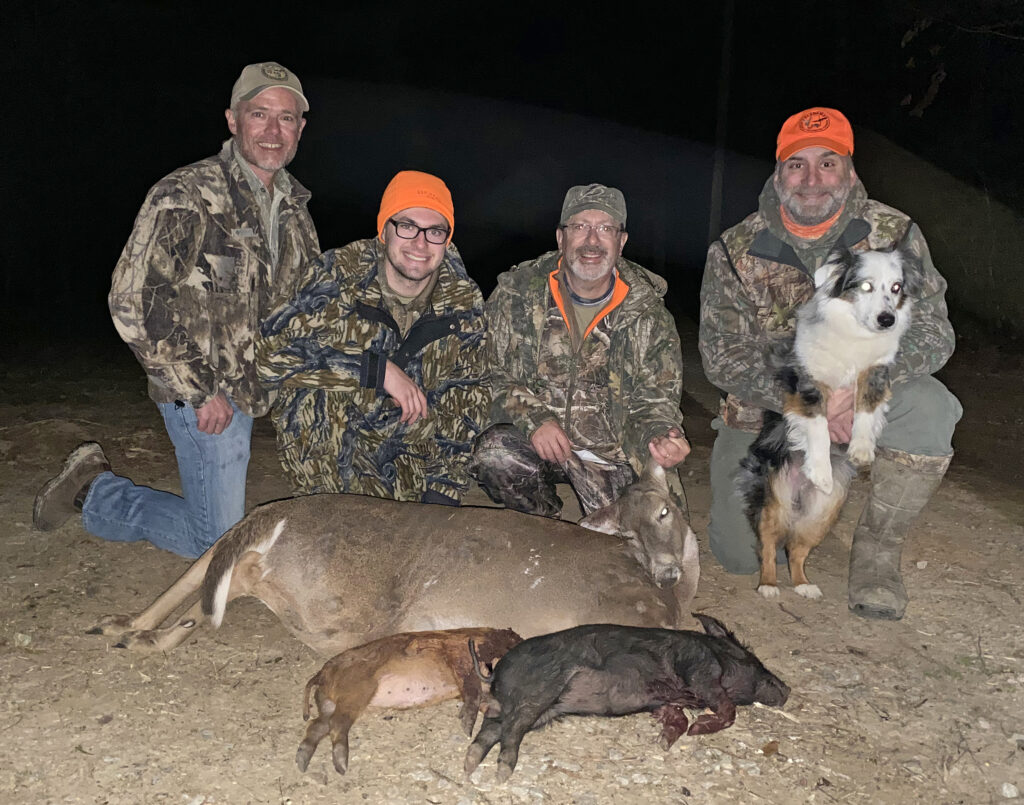
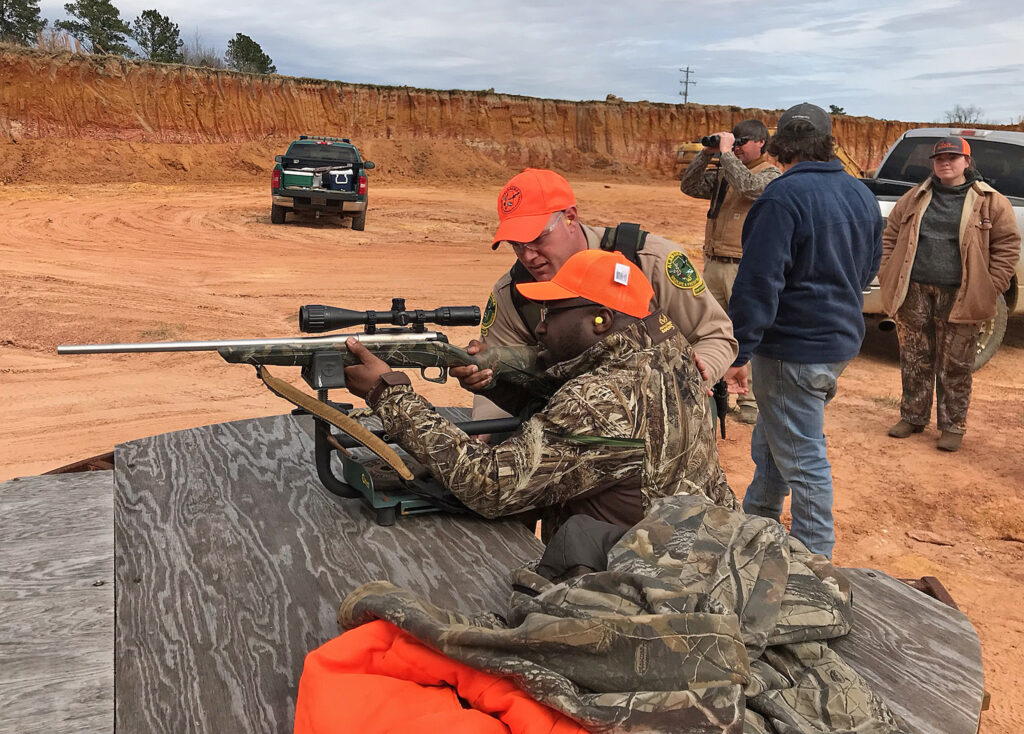
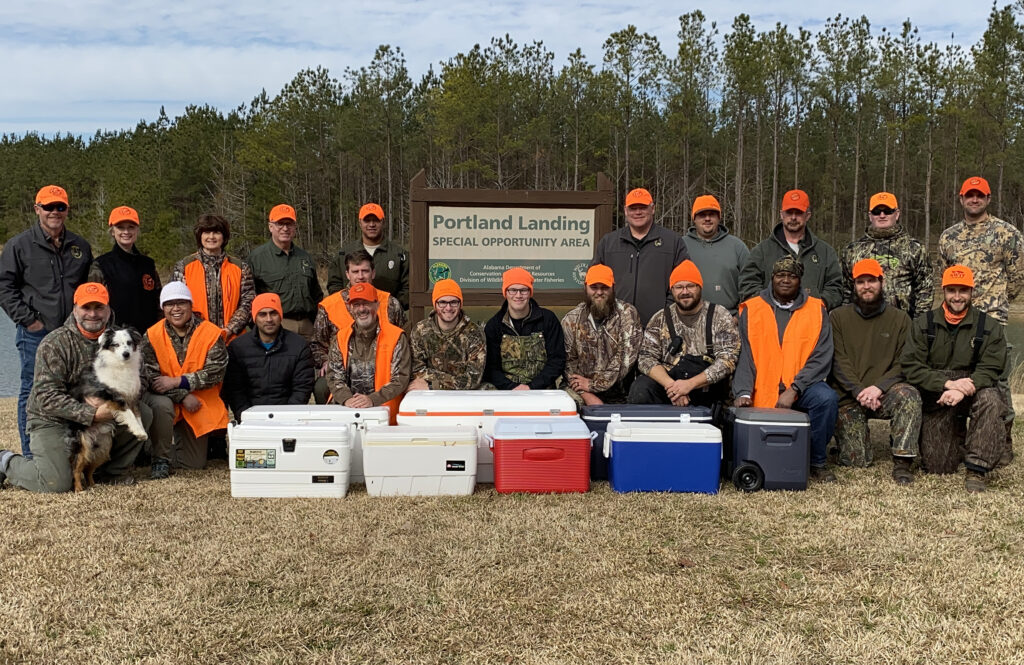
By David Rainer, Alabama Department of Conservation and Natural Resources
The Alabama Wildlife and Freshwater Fisheries (WFF) Division’s Adult Mentored Hunting (AMH) Program has two main goals – to provide those with little or no hunting experience with a safe, enjoyable weekend in the woods and to kindle an interest in hunting that will last a lifetime.
Judging from the feedback from the mentored hunts, the first goal has been a great success. For some of the newcomers – Terrance Marshall and Kevin Kurtz – those AMH outings have changed their lives.
Marshall of Clayton, Alabama, has been connected to the outdoors most of his life but never as a hunter.
“I was always big on fishing,” said Marshall, who has been an officer at the Ventress Correctional Facility for the past 20 years. “I love fishing.”
Marshall and WFF Conservation Enforcement Officer (CEO) Bill Freeman have been buddies for many years, a friendship that started with the Alabama Department of Corrections (DOC). Freeman moved to Conservation and Marshall stayed with the DOC.
“Bill got into all the (outreach) programs, and he found out that I was interested in going hunting,” Marshall said. “Bill called me, and I told him I’d never been hunting. I’ve got a passion for fishing. I told him if hunting was like fishing, I was going to love it.”
Marshall teamed up with Freeman and retired CEO Johnny Johnson, who sat in the stand with Marshall, for a late-season deer hunt.
“I enjoyed it,” Marshall said. “I didn’t get the opportunity to shoot anything, but it was relaxing. I loved it. The next day I bought a rifle. Johnny had a Remington .270. I fired it before our hunt when we went over firearms safety. I liked the way that rifle fired, so the next day I went and purchased one.”
A new rifle wasn’t the only purchase Marshall made to enjoy Alabama’s great outdoors.
“I just purchased a tract of land, 114 acres with two ponds and all kinds of wildlife,” he said. “In fact, I’ve been over there bushhogging and cleaning things up to get prepared for the season that’s coming in.
“I love the outdoors and I love the cold. I don’t regret a minute of it. I give credit to Bill for reaching out and telling me about the programs. Not only was I going, I brought my son along when they had something for the youth. I also took my daughters to the youth fishing events.”
Meanwhile, Kurtz, an Auburn graduate, is in the process of making a more dramatic commitment to his new hunting activity.
After traveling the world in the U.S. Navy for 20 years, much of that time as a Service Warfare Officer (what Kurtz calls a ship driver in simple terms), he went into the geographical information systems (GIS) business in Tampa, Florida.
“I hadn’t been back to Alabama in a long time because there aren’t too many Navy bases,” he said. “But when my son (Nathan) applied to and was accepted into Auburn, I got my interest back in Alabama.”
Nathan entered the School of Forestry and Wildlife Sciences to study Geospatial and Environmental Informatics, which includes digital mapping.
“The School of Forestry was just getting ready to graduate their first class in that program, and Professor Scott Enebak found out what I was doing after my retirement from the Navy,” said the elder Kurtz, whose Navy career included guiding the aircraft carrier Harry S. Truman through the Suez Canal. “He asked me to be on an advisory board. Obviously, I said yes.”
Before the COVID-19 pandemic hit full-force, Kurtz heard a presentation from WFF Director Chuck Sykes about the AMH opportunities.
“My son’s birthday was that September, and I decided to take him to a weekend class on deer hunting,” Kurtz said. “I’ve always owned handguns and shotguns but had never been hunting. I put our names in for a mentored hunt, and we got to go in January.
“They taught us everything from soup to nuts – what to look for, how to dress, everything. It’s so professional and so well done. Every meal we had had some kind of venison in it. It was just awesome.”
Both son and father harvested their first deer. Nathan bagged a 175-pound buck, and Kevin took a 120-pound doe at Portland Landing Special Opportunity Area (SOA).
“What a fantastic time,” Kevin said. “Chuck was my mentor. As we were walking up to the area we were going to hunt, Chuck stopped. He’s got the eye. I can see a ship on the horizon, but Chuck can see a deer in the woods on the horizon. I think it was a six-point. Chuck looked at him and said, ‘He’s a little too young. We’re going to pass on that one.’ I ended up shooting the doe at sunset.
“It was such a thrill. He told me that I would be nervous and excited and, after it was over, if I didn’t feel something for the animal there was something wrong. I get it. At that point, I realized this is serious business. We’re practicing wildlife management, and it’s not a bad thing.”
After attending a turkey hunting workshop, Kurtz had a serious conversation with his wife about relocating.
“We decided to buy some land in Alabama,” he said. “We looked and looked. An incredible opportunity came up near Ramer, Alabama. We bought 120 acres in southern Montgomery County. It’s gorgeous. Chuck came over and said we had a gem; it is turkey heaven. So, I guess we’re getting into turkey hunting.
“The land has a house and barn. My wife and I are planning to move there next summer. It’s not only the hunting culture, but just the culture in that area. It’s a unique bunch of people. They’re responsible. They love their Second Amendment rights and love America. We’re blessed. It was a domino effect that started with my son going back to my alma mater.”
Kurtz has obviously become a big supporter of the AMH outreach programs and the WFF personnel and volunteers who make it happen.
“What they do is phenomenal,” he said. “It was such a diverse group of people at the hunts – people from all walks of life. There were people there like my son and I who had never been hunting before.
“I told Chuck and everybody else, it was life changing. It really was. I have such an appreciation now for what responsible hunting is about.”
Consuming what you harvest is a steadfast mantra of the hunting community, and the Kurtz family is definitely on board.
“We’re still eating the deer we got in January,” he said. “If I don’t ever buy any more ground red meat, I’ll be fine. I’m making venison burgers, chili and stew.”
The Kurtz family has a big week planned around the opening of gun deer season in Alabama on November 20. They get to hunt deer the week of Thanksgiving before they head to Auburn the Saturday after the holiday for the Iron Bowl.
Kurtz said he has a lot of work to do before the season opener, but he admits the end result brings him great satisfaction.
“The best advice Chuck gave on my property is that you can easily get overwhelmed,” Kurtz said. “Just take it a day at a time. Every time I go up, I’ve got a list of 20 things. If I get five done, I’m happy. We’re fortunate the previous owners were hunters. We’ve got two nice deer plots. There’s a shooting house on the power line. I’ve got plots to plant in October, and I’ll be on the tractor bushhogging.
“But it’s just fun. I never thought 10 years ago I would say the best season in the world is hunting season. Not fall or winter; the best season is hunting season. I can see now why people get so excited about it.”
Visit www.outdooralabama.com/hunting/adult-mentored-hunting-program for information and how to register.
Extension Office News You Can Use
Extension in your community
By: Jovita Lewis, Hale County Extension Coordinator
Extension in Your Community: Staff of the Hale County Extension Office will be at Hale County Middle School for the next six weeks. Willie Braggs, EFNEP Nutrition Educator, is teaching Teen Cuisine Encore to 7th and 8th grade students. Through the series of lessons, youth will learn important life skills to promote optimal health. Ms. Braggs will teach key concepts about nutrition, food preparation, food safety, and physical activity using hands-on approaches to enhance learning and behavior change.
Hemp Grower Feedback Requested: Alabama’s third growing season for hemp is underway. With this “new” crop, the Extension crops team is looking to identify best management practices to ensure hemp’s sustainability. This includes identifying the types and distribution of major insects and diseases across the United States and Canada. A group of hemp research and extension faculty are looking for hemp grower feedback to direct research priorities. The group is asking hemp growers in Alabama, and throughout the United States and Canada, to fill out an anonymous survey to help our efforts. Please click on https://www.aces.edu/blog/topics/crop-production/hemp-grower-feedback-requested/ for the survey link. We appreciate your feedback!
National Catfish Month: The staff of the Hale County Extension Office recently celebrated National Catfish Month during August. From “31 Days of Catfish Trivia” to “A Colorama for Hale County’s Boys and Girls” and from the “Fish Tales Special-interest Program” to a delicious “Sheet Pan Catfish Recipe” August was a month to remember. It was an honor to salute the catfish industry in Hale County.participated in the Town of Newbern’s Summer Reading Festival. Three wholesome snacks, Energy Bites, Cheese Kabobs, and Yogurt Parfaits, were showcased. The Energy Bites proved to be a festival favorite. Gather these ingredients:
½ cup creamy peanut butter
½ cup honey
2 cups nonfat instant dry milk
1 cup quick oatmeal
½ cup crispy rice cereal
Follow these directions: Collect and measure all ingredients before starting to prepare the recipe. Combine all ingredients in a medium bowl. Mix ingredients with a spoon until combined. Using clean hands, shape the mixture into 16 balls that are approximately one inch in diameter. Store at room temperature in a sealed container. Eat within three to five days. Enjoy!
That’s All Folks: Until next week, here’s a thought to remember: “Give a man a fish and you feed him for a day; teach a man to fish and you feed him for a lifetime.”
Physically disabled hunt dates announced for Field Trial Area
The M. Barnett Lawley Forever Wild Field Trial Area (FWFTA) in Hale County, Alabama, will host a series of deer hunts for hunters with physical disabilities from late November 2021 through January 2022. To register for the hunts, call (334) 289-8030 starting October 1, 2021.
“Access to outdoor activities such as hunting should be available to everyone who has an interest,” said Chris Blankenship, Commissioner of the Alabama Department of Conservation and Natural Resources (ADCNR) and Chairman of the Forever Wild Board of Trustees. “We are honored to provide hunting opportunities for all Alabamians including those with physical disabilities.”
Hunt availability is limited and will be assigned on a first come, first served basis. Hunters are limited to registering for only one hunt for the season and may bring an assistant to help with the hunt. Hunters will need a hunting license and Conservation ID number prior to registering.
FWFTA physically disabled hunt dates
November 24, 27
December 1, 4, 29
January 5, 8, 12, 15, 26, 29
Hunters with physical disabilities are required to fill out a Disabled Hunter Permit Application prior to the hunt dates. The permit can be downloaded from the “Physically Disabled Hunting Areas” section of www.outdooralabama.com/hunting/where-hunt-alabama. All deer harvested during the FWFTA physically disabled hunts must be reported via Alabama’s Game Check system. Hunters will have 48 hours to Game Check their harvest through the Outdoor AL mobile app or online at outdooralabama.com.
If you have questions about the FWFTA physically disabled hunts, call Zachary Heard with the ADCNR State Lands Division at (334) 353-1357, or email [email protected].
The M. Barnett Lawley Forever Wild Field Trial Area consists of 4,300 acres in Hale County and is managed as a nature preserve and recreation area. In addition to developing a sporting dog test ground and a youth hunting program, the ADCNR State Lands Division is currently restoring the tract’s native prairie grasslands and managing its numerous ponds for public fishing events.
Sweet, Sweet Honey Month: Alabama Honey, History and Uses
By Mary Leigh Oliver
AUBURN UNIVERSITY, Ala. – September is National Honey Month! In honor of this sweet, sweet month, Jack Rowe, an Alabama Cooperative Extension System regional agent, provides some facts and information on the many benefits of honey.
Alabama Honey
According to Rowe, who is the Alabama Extension beekeeping team leader, the number of Alabama beekeepers is in the thousands. 2018 estimates from the United States Department of Agriculture indicate that there were more than 6,000 hives in Alabama that year. Those hives produced more than 270,000 pounds of honey, valued at more than $260,000.
Instead of large commercial beekeeping, like pollination services and package bee makers, Alabama has more hobbyist and small commercial keepers. In addition to honey, keepers produce allied products–including wax, baked goods, cosmetics, balms and candles, just to name a few. Rowe adds that some beekeepers may offer small-scale pollination services.
“Beekeeping is an amazing business with a lot of ways to profit from our colonies,” Rowe said.
Alabama even has a few meaderies, or breweries where they make mead.
“Mead is an ancient beverage made from honey, and there are several varietals,” Rowe said. “All are worth trying.”
Anything related to bees and honey—Alabama’s got it.
Shop Local
Not only does local honey support beekeepers and their families, but it also reflects its own region.
“Local honey is always unique and will smell and taste of the local bloom fragrances,” Rowe said. “It typically has a lighter color than commercial honey as well.”
Compared to commercial processed honey, local honey is also more likely to be raw honey. Unlike commercial honey, raw honey does not undergo filtration or pasteurization. That means local honey really is just that–local.
Honey History and Uses
Thankfully, the method of extracting honey has advanced over the years. The new Langstroth hive system makes honey extraction easier on the beekeeper and the bees.
“Before the Langstroth hive system with removable frames, extracting honey could destroy entire colonies of bees,” Rowe said.
With a safer method for honey extraction, honey uses are endless. While honey is a lovely addition to tea, biscuits and other tasty dishes, it has a long history of alternate uses. In the past, honey was used as a topical wound treatment.
“An ancient medicine called ‘mellified man’ was made by soaking human cadavers in honey until the cadaver was saturated and crystalized in it,” Rowe said. “The remains were then powdered and used as a medicine.”
More Information
While honey has had many uses over the years, most people today enjoy it best as a sweet snack. For more information on honey, visit the Alabama Extension website, www.aces.edu.
Cultivating Communities: Alabama Master Gardeners Celebrate 40 Years of Service
AUBURN UNIVERSITY, Ala.— “To plant a garden is to believe in tomorrow.” -Audrey Hepburn
The Alabama Cooperative Extension System Master Gardeners (MGs) are celebrating 40 years of a belief in tomorrow. Through community gardens, tours, workshops and community outreach projects, MGs are making a difference in their communities across Alabama.
Alabama Extension MG Program Coordinator Kerry Smith said the MG program has touched thousands of lives throughout its 40-year history in Alabama.
“The MG program reaches much further than many people realize,” Smith said. “Volunteers in some counties help feed food-insecure families with produce from community gardens. Others host community events or garden tours. There are even some counties where the MG volunteers are the backbone of the county fair.”
Joint Resolution Recognizes Contributions
Alabama Senator Clay Scofield introduced a joint resolution to the Alabama legislature recognizing the Master Gardeners for their service during the past 40 years.
The Alabama legislature jointly “commends the Alabama Extension Master Gardener Program for its contributions to the State of Alabama and hereby recognizes its impact toward making our state more beautiful and its citizens more capable of environmentally safe and sound decisions for their home landscapes.”
Humble Beginnings and Humble Service
Since its beginning in 1981, the Alabama MG program has become an impactful and expansive statewide program. In 2020, 1,565 members reported volunteer hours—even in the midst of a global pandemic.
Forty years of sweat, energy, time and talent contributed to communities all over Alabama equals thousands of hours of community service. The work of MGs has an estimated $112 million worth of volunteer efforts that has made Alabama more beautiful.
Gary Murray, an Extension agent assistant in Madison County in 1981, worked as part of the team who developed the first Alabama MG curriculum and volunteer training. He was encouraged to implement the program by Huntsville resident, Mary Lou McNabb, who participated in the MG program at Cornell University.
He said behind every successful program is a good team who makes it happen.
“The MG program is a quality program that has been led by many quality people over the years,” Murray said. “While this is vitally important to program success, it comes down to the quality of people who choose to become MGs. These individuals are extraordinary.”
Murray said the MG volunteers are a community-minded group.
“I am a first-hand witness to the difference a MG group can make in communities,” Murray said. “These are individuals who want to improve their own knowledge base, then use what they learn to help others.”
Advanced Master Gardeners Take Next Step
Mallory Kelley, an Alabama Extension regional home grounds agent, said after becoming a certified MG, members can choose to work on an advanced MG training.
This training includes 40 hours of topic-specific study and presentations to peers and other groups, as well as a mentoring program. Kelley said the impact MG’s have on their communities is incredible and inspiring.
“The MG program is about gardening, but the thing that really ties people together is the unique and lasting relationships you cultivate,” Kelley said. “I applaud these volunteers because they give a lot of time, energy and love to their projects. The Prattvillage garden is just one example that makes a difference in an Alabama town.”
Cultivating Community
Billie Crawford, a Montgomery County MG, comes from a family of Alabama MG volunteers. She said gardening is in their blood. Crawford’s sister and brother-in-law are Tuscaloosa County MGs, but her initial introduction to the MG program was through her mother, Helen Bretz. Bretz was an Alabama MG member in Tuscaloosa County in 1991.
“My mother was involved with Master Gardeners in the early years,” Crawford said. “She already loved the MG program and encouraged me to participate in the outreach programs and get involved with community service projects.”
Crawford’s mother, Helen Bretz, said the MG organization has been dear to her since her time as an active MG.
“The MG program has given me so many wonderful friends,” Bretz said. “Many of them I am still in contact with today.”
The association that brought lasting friendships is the same one she said breathed life into her again after she fought colon cancer.
“After 24 cancer treatments, I was weak and tired,” Bretz said. “I was offered the opportunity to have two mentors help me with a garden in my back yard through the Harvest for Health program and it really brought me back to life.”
Harvest for Health and Grow More, Give MoreChange Lives
In addition to community beautification projects, there are individuals and families reaping the reward of sewn seeds of kindness and the continued belief that MGs are planting today, believing for tomorrow.
Smith said MG volunteers donated 13 tons of fresh produce to area food banks for local families experiencing food insecurity in 2020 through the Grow More, Give More(GMGM) campaign. This topped 2019’s donations by 2,000 pounds. GMGM encourages a produce-sharing partnership where gardeners share extra produce with neighbors in need or local food banks.
Harvest for Health pairs cancer survivors with MG volunteers who mentor them while growing a four-season backyard garden. The program has impacted more than 400 cancer survivors throughout Alabama who partnered with nearly 500 MG volunteer mentors.
Harvest for Health is a partnership between Alabama Extension’s home grounds team and the University of Alabama at Birmingham’s Comprehensive Cancer Center.
Smith said this research would not be possible without Alabama MG volunteers and their contributions of time, talent and heart.
40 Years of Service
From humble beginnings came a program that humbly and consistently serves in many communities throughout Alabama. Smith said she has had the privilege of watching the program grow during her tenure.
“The Master Gardener program is about so much more than gardening and soil, although these are the initial ties that bind,” Smith said. “MG volunteers are enthusiastic and service-minded. Their efforts have helped others learn more and truly made Alabama a better place to live.”
She said the volunteers are the heart of the program.
“This outstanding Extension program owes gratitude to the Alabama MG program pioneers for their energy and determination, especially Mary Lou McNabb for launching the idea in Madison County,” Smith said. “Thank you to her and to all of the Alabama Master Gardeners who volunteer in their communities. Way to grow!”
More Information
Alabama Master Gardeners also manage a helpline. MGs help gardeners and homeowners throughout the state diagnose and treat common issues in the lawn and garden. Call 1-877-ALA-GROW to let a certified MG assist you.
For more information about the Alabama Master Gardener program, Harvest for Health or Grow More Give More, visit www.aces.edu.
WFF K-9 Unit Enhances Search Efforts with New Technology
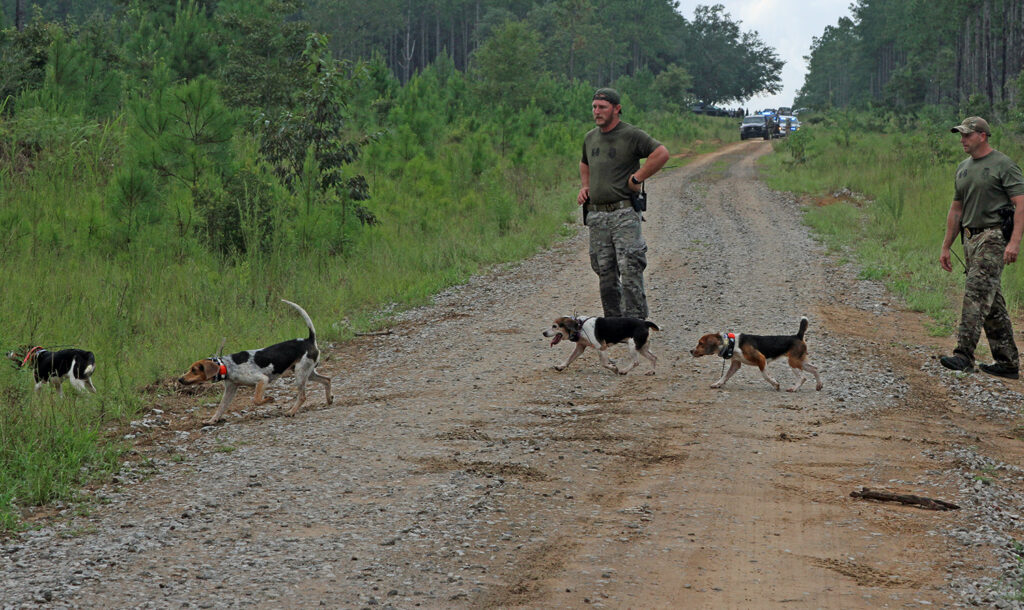
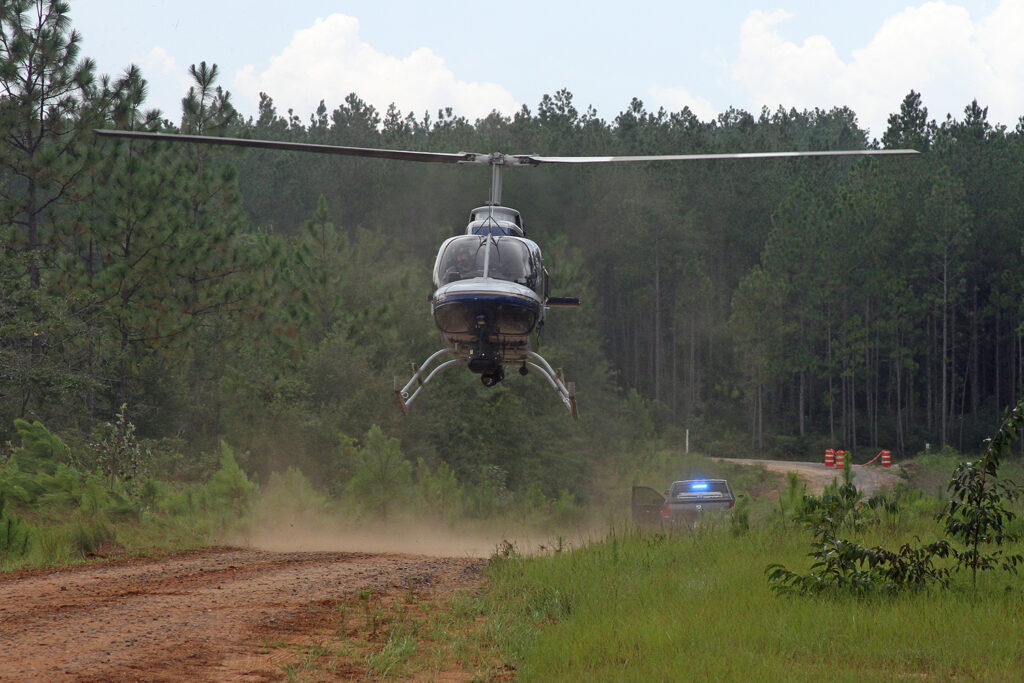

By David Rainer, Alabama Department of Conservation and Natural Resources
The Alabama Wildlife and Freshwater Fisheries (WFF) Division’s Law Enforcement Section K-9 Unit has integrated the latest technology in its quest to track down poachers and those attempting to flee from law enforcement as well as missing persons.
In a training session held recently in Baldwin County, the WFF K-9 unit and other WFF Conservation Enforcement Officers (CEOs) demonstrated the use of a tracking system to the Baldwin County Sheriff’s Department and law enforcement officers from several municipalities in the county.
The technology involves GPS tracking collars for the beagles used by the K9 Unit as well as a tracking unit that is on board the Alabama Law Enforcement Agency (ALEA) helicopter. When a search is in progress, each tracking unit, worn by K-9s in the form of a collar, is displayed on a screen in the portable command center, CEO vehicles and the helicopter to maximize search efficiency.
The WFF K-9 Unit was created in 2019 after CEO Brad Gavins became interested in the Alabama Department of Corrections’ (DOC) use of tracking dogs to find escaped prisoners. Corrections gave WFF one of their dogs to try and soon the K-9 unit came into existence. WFF now has eight tracking beagles deployed with Conservation Enforcement Officers around the state.
CEOs Jason McHenry of Autauga County and Ben Kiser of Calhoun County are among the officers with tracking beagles, and they were among the WFF staff at the recent training session.
McHenry explained the practical rural canine training that occurred at Perdido River Wildlife Management Area.
“We have a mock scenario set up where an individual, the suspect, is in the woods,” McHenry said. “The initial officer on the scene has made a traffic stop. That individual has fled into the woods. That officer has contacted his supervisor and asked for backup, which includes DOC, ALEA Aviation and Wildlife and Freshwater Fisheries to assist in establishing a perimeter and tracking.”
McHenry said when the supervisor arrives at the scene, that individual sets up the incident command, which is the hub of communications. Responding officers check in at incident command to keep track of the officers in the field and issue assignments at the scene.
Hitching a ride with McHenry and Kiser, we loaded into McHenry’s vehicle equipped with the Garmin DriveTrack tracking receiver and rode the perimeter as the WFF K-9 Unit unloaded their tracking dogs to pick up the scent at the site where the suspect entered the woods.
During the exercise, McHenry and Kiser were able to watch the screen and see the positions of the dogs and the ALEA helicopter as they performed the search for the suspect. This allowed the WFF CEOs to move their vehicle and personnel into a position to best intercept the suspect.
Gavins, the CEO in Crenshaw County, is the team leader for the WFF K-9 unit, which procures all the beagles, man-tracking dogs from DOC already trained. The beagles are trained not to bark so the suspect won’t be alerted to the tracking team’s approach.
Gavins said the WFF K-9 Unit assists local law enforcement agencies on manhunts, and the recent training was the result of discussions on how to best coordinate their efforts and increase the chances of apprehending suspects or finding the missing persons as quickly as possible.
“We’ve had discussions on what goes right and what goes wrong during a manhunt,” Gavins said. “We talked about what we can do to get the information out to the agencies that will be on scene, setting up the search and communicating more efficiently so that we have a safer, more effective search.
“When the Garmin DriveTrack became available to our agency about a year ago, it worked out so well that our Wildlife and Freshwater Fisheries officers became perimeter security for many searches across the state. Since we can see where the canines are in real time on a satellite image map, it becomes possible to direct officers to the area that a suspect may be fleeing through or to an area where a lost child or person suffering from dementia or Alzheimer’s disease may be located. We can see all the roads, food plots and terrain features. If the canines start to get close to a road, our officers can shut down the road for the safety of the dogs or prepare for a fleeing fugitive.”
The WFF officers can gather information from the ALEA helicopter and DOC and relay that information to the incident command center or whatever agency is in control of the scene.
Gavins said WFF works closely with the DOC and can assist in any search effort.
“We train with them and we already have the DOC tracking collar codes programmed into our computers,” he said. “If they call and ask us to come to a certain county to assist them, we turn our computers on and we can see where their dogs are on the ground. We can immediately start assisting without having to find out where the dogs are.”
Gavins said ALEA Aviation and several county aviation units tested the system and agreed to install a tracking unit in their aircraft.
“It’s a game changer for a manhunt or a search for a missing person,” Gavins said. “Sometimes the suspect can be miles ahead of the dogs. The helicopter knows where we are and can tell us if it’s a hot track or a cold track. It actually helps them get in the area where the person is running, and it keeps them in the area where the person is. With this tactic, the suspect’s focus remains on the aviation assets. It helps suppress the suspect’s movement as long as the aircraft is there.
“Through interviews with suspects after they have been apprehended, it became evident that if the helicopter makes a loop or is gone to refuel, that’s when a fugitive will try to cross a road or make a move. In the suspect’s mind, if the aviation is in the area, they know where they are, which keeps their attention on the aviation instead of the other efforts with the tracking dogs and pursuing officers.”
Gavins said once word spread of how successful the new technology was for performing searches, other law enforcement agencies became interested. The WFF K-9 Unit started working to develop a training course that would bring the outside enforcement agencies into the group. The training that was developed includes a morning of classroom discussion, followed by an afternoon of demonstrating the tracking system with WFF K-9s, WFF officers and the ALEA helicopter.
Gavins said the classroom discussion includes communications, incident command preparation and tracking site contamination mitigation techniques.
“When we developed the classroom portion and practical portion, one thing that was important was to clearly establish the call-out protocol for ALEA Aviation, DOC and Wildlife and Freshwater Fisheries,” he said. “What ALEA Aviation stressed was that any enforcement agency that needed their help for a manhunt or finding a missing person should call right away instead of waiting eight or nine hours. ALEA’s concern was found to be the same concern that all agencies involved in this training expressed.
“We talk about protocols that need to be followed for a missing person or suspect – things that need to be done before calling aviation or the K-9 unit. This falls into the hands of the first responding law enforcement officer on scene. The key is to set that up right away and not contaminate the area for the canines.”
Youth Hunt Dates Announced for Forever Wild Field Trial Area
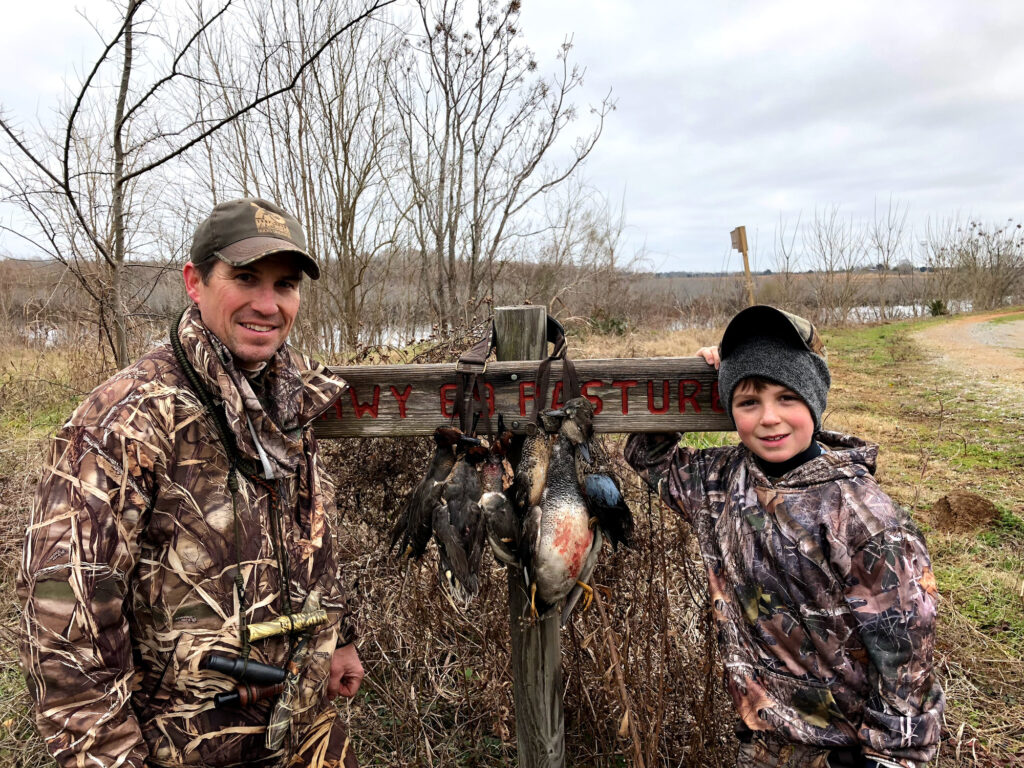
By Kenny Johnson, Alabama Department of Conservation and Natural Resources
The Alabama Department of Conservation and Natural Resources’ (ADCNR) State Lands Division announces the youth deer and duck hunt schedules for the M. Barnett Lawley Forever Wild Field Trial Area (FWFTA) in Hale County. The hunts will take place late November 2021 through January 2022. Registration will open September 14 and run until November 1. Hunters will be selected via a computerized, random drawing after registration closes.
“I am thrilled that we will have an opportunity again this year to introduce youth to the great deer and duck hunting on this Forever Wild property,” said Chris Blankenship, ADCNR Commissioner and Chairman of the Forever Wild
Board of Trustees.
Youth Deer Hunt Dates
November 24, 27
December 1, 4, 29
January 5, 8, 12, 15, 26, 29
Youth Duck Hunt Dates
November 27
December 4, 29
January 5, 8, 12, 15, 26, 29
Phil Cowley from Seale, Alabama, took his son, John, on a FWFTA youth duck hunt in January of 2018.
John was 9 years old at the time of his hunt. He was already interested in the outdoors, but this was his first experience hunting waterfowl with his dad.
The day of their hunt was very cold and perfect for duck hunting. After checking in at the station, Phil and John were taken to their hunting spot – a corner of an impoundment with plenty of cover on the leeward side of a high levee. Phil used an aerial photo on his phone to help the pair orient themselves.
“The location was perfect,” Phil said. “We were out of the howling wind and in an inviting spot for ducks.”
The first ducks started dropping in before legal shooting hours, verifying they’d been placed in a prime location.
“When legal shooting hours began, the birds were still flying,” Phil said. “After the initial shots I was no longer a shooter but an ammo loader for my son. The birds flew for about 45 minutes and we ended up with close to our limit.”
The father and son duo harvested blue-winged teal, green-winged teal and gadwall that they took home and pan fried in a wine reduction.
“The field trial area youth hunt is the best waterfowl hunt John has been on so far and he is hooked,” Phil said. “It was a wonderful experience that deepened his passion for hunting.”
To register for a hunt, visit https://publichunts.dcnr.alabama.gov/Public/AvailableHunts during the registration period listed above.
Registration for the FWFTA youth hunts is only available to parents or adults who are at least 21 years old and have a Conservation ID number. A hunting license is not required at the time of registration. However, if selected during the random draw, you must have a valid hunting license to accept the hunt permit. If selected for a hunt, you will receive an email requesting that you validate/accept the permit. Once the permit is accepted, you will receive an email with the hunt details.
To participate in the youth hunts, youth hunters must be age 15 or younger and accompanied by an adult at least 21 years old (or a parent). Adults must have a valid state hunting license and applicable duck stamp, if duck hunting. Hunters must obtain their license and duck stamp (if duck hunting) before the hunt since they will not be available on-site. Licenses are available for purchase at various retailers throughout the state or online at www.outdooralabama.com.
All deer harvested during the FWFTA youth hunts must be reported via Alabama’s Game Check system. Hunters have 48 hours to Game Check their harvest through the Outdoor AL mobile app or online at www.outdooralabama.com.
In addition to being required when registering for the FWFTA youth hunts, a Conservation ID number is the fastest and easiest way to report a deer or turkey harvest. This number is unique to each hunter and can also be used to purchase future licenses, obtain Harvest Information Program (HIP) permits, register for Special Opportunity Area hunts and more. For information about how to obtain a Conservation ID number, visit www.outdooralabama.com/hunting.
For more information about the hunt details or registration process, call Zachary Heard with the ADCNR State Lands Division at (334) 721-9796, or email [email protected].
The M. Barnett Lawley Forever Wild Field Trial Area consists of 4,300 acres in Hale County and is managed as a nature preserve and recreation area. In addition to developing a sporting dog test ground and a youth hunting program, the ADCNR State Lands Division is currently restoring the tract’s native prairie grasslands and managing its numerous ponds for public fishing events.
The Alabama Department of Conservation and Natural Resources promotes wise stewardship, management and enjoyment of Alabama’s natural resources through four divisions: Marine Resources, State Lands, State Parks, and Wildlife and Freshwater Fisheries. To learn more about ADCNR, visit www.outdooralabama.com.
Healthy Game Day Snacks For Your Family
AUBURN UNIVERSITY, Ala. — Whether “War Eagle” or “Roll Tide” is your battle cry on Saturdays, most of us can agree that healthy game day snacks are a must-have for family football gatherings this fall.
“A movie theater-sized tub of popcorn is approximately 1,090 calories, 49g fat and 2,650mg of sodium, and that’s without any butter,” said Sofia Sanchez, Alabama Extension specialist and registered dietitian. “It’s a great idea to include snacks that provide a range of beneficial nutrients, as well as fiber to help with satiety.”
Now that kickoff is here, that doesn’t mean the family has to “punt” on making good food choices. Pass on those heavy appetizers that’ll bring on the first-half nap, and let Live Well Alabama help to create a menu filled with energizing treats.
Dips
What is a football snack without a dip? Guacamole is always an easy option that’ll give the family tons of energy to keep cheering throughout the game. Combine avocados, onions, garlic and tomatoes — add some lime juice with salt and pepper, and serve up tasty guacamole that takes just minutes to prepare.
If guacamole isn’t high on the dip list, consider Live Well Alabama’s Sassy Strawberry Salsa. This sweet and spicy side dish combines strawberries and cilantro for a great addition to the game day spread.
Want more? Live Well Alabama has more. Check out LiveWellAlabama.com for dip recipes, including the Creamy Cucumber Dill or the Dip It! Bean Dip — both are options that are sure to satisfy. Don’t forget the crunchy veggies like bell peppers, carrots or celery for dipping.
Snacks
A football snack staple is a delicious plate of nachos while watching the action on television. Live Well Alabama has nacho lovers covered with a different take on the flavorful snack. Check out Live Well’s Good-For-You Nachos. Combine sweet potatoes with tons of vegetables, tomatoes and beans and bake for 20 to 30 minutes. Open the oven and have a crispy and mouthwatering snack to enjoy.
Speaking of sweet potatoes, another simple game-day snack is sweet potato fries. Preheat the oven to 425 degrees F, slice sweet potatoes into one-fourth inch strips, season with salt, pepper, paprika, cayenne pepper and dried thyme. Then spread the fries out on a baking sheet and cook for approximately 25 to 30 minutes. The result is scrumptious finger food, which is an excellent addition to any viewing experience.
Other Sides
If the weather is still too warm to turn on the oven, there’s nothing like a mixed-fruit salad to cool down.
The Fruit Paradise recipe combines pineapples, oranges, banana, grapes and yogurt for a cool treat during the early parts of the season.
Another cold but tasty treat is Live Well’s Frozen Yogurt Covered Blueberries. This one is really simple. Just dip blueberries in Greek yogurt until the berries are completely coated, place on a baking sheet and then freeze. Once frozen, enjoy a sweet, cold and nutritious snack.
For more dips, snacks and other healthy game day recipes, visit LiveWellAlabama.com. Also, visit them on Facebook, Instagram, Twitter and Pinterest for more nutrition tips.
Alabama Extension and Auburn health experts: Ivermectin for animals NOT safe for people
Farm supply and feed stores cannot keep a livestock deworming medication on the shelves because social media posts are calling it a cure for COVID-19. A veterinarian with the Alabama Cooperative Extension System warns that people should not buy animal ivermectin products to self-medicate.
“Animal formulations of ivermectin are NOT safe for human use,” said Soren Rodning, who is also an Auburn University associate professor of animal sciences. “Bottom line—do not self-medicate with animal ivermectin products. I cannot emphasize this enough.”
The Alabama Poison Information Center at Children’s of Alabama has fielded more than two dozen ivermectin exposure calls so far. The majority of these calls were related to COVID-19.
The Food and Drug Administration requires labels on animal ivermectin products warning people not to ingest it. Veterinarians use it as a dewormer in cattle, horses and pets.
“The concentration of ivermectin in these products or some of the inactive ingredients used in animal formulations may not be safe for human use,” he said. “Specifically, these have not been proven safe for use by people through clinical drug trials.”
Marilyn Bulloch, an Auburn University associate clinical professor of pharmacy practice, adds that while a human formulation of ivermectin exists, safety is key.
“It would be wonderful to have a cheap oral medicine to treat COVID,” said Bulloch. “But the blood concentrations needed for the active ingredient are substantially higher than ever studied and is not safe in humans. Research shows that it does not work in normal human doses.”
Bulloch’s colleague, Spencer Durham, agrees.
“To achieve adequate blood concentrations would require a lethal dose of the human formulation,” said Durham, who is also an associate clinical professor of pharmacy practice at Auburn.
Bulloch and Durham also point out that hundreds of drugs have shown promise in a lab setting against COVID-19 but failed to be effective against the disease in people. “Currently, there is a well-designed, large-scale study in people underway in the United Kingdom to investigate if ivermectin could be effective in more normal human doses,” said Bulloch. “But we do not know how long that study will run and when the data will be available.”
Durham said that long-term studies into dose sizes, dosing schedules and potential side effects in people are what is needed.
“These types of studies are what we need to make well-researched and safe recommendations,” he said.
Additionally, Durham is concerned that vaccine-hesitant people are embracing the social media hype around ivermectin.
“I understand that people want to feel that any medications and vaccines are well-researched and safe,” he said. “But there is no evidence to support that normal doses of human formulations of ivermectin are effective and significant evidence that animal formulations are not safe for people and possibly lethal.”
Durham said in contrast, strong evidence exists that the vaccines currently available are safe and significantly reduce the potential for contracting COVID-19 and requiring hospital treatment if a person does get the disease.
How to fight COVID-19
Rodning, Bulloch and Durham also agree that following a few key steps provide the strongest defense against COVID: vaccinate, wear a mask, practice good social distancing, wash hands frequently, keep hands away from the face, especially nose and mouth, eat a healthy diet, and get adequate rest,
Forage Basics: From the Pasture to Your Phone
AUBURN UNIVERSITY, Ala.— From the minds that brought you Beef Basics comes another ground-breaking online learning opportunity. Forage Basics, the newest online course from the Alabama Cooperative Extension System, serves as a valuable new tool for livestock and forage producers.
The First of Its Kind
Forage Basics stands as the first course to provide targeted information about forage production and management in the Southeast.
Leanne Dillard, the project leader and an Alabama Extension forage specialist, said that more than 750,000 acres were harvested for hay in Alabama alone in 2020.
“Increased interest and demand from non-traditional farmers over the last 10 years led us to create Forage Basics,” Dillard said. “However, experienced producers will benefit from this course just as much as new producers will.”
Dillard said there course is free to ensure easy access for everyone.
About the Course
Made possible in part by a grant from the Southern Extension Risk Management Education Group, Forage Basics puts everything from grazing management to pest control into producers’ hands.
Alabama Extension professionals from multiple disciplines within the Auburn University College of Agriculture created the 20-chapter course. Each chapter includes short videos as well as lists of important resources. Short quizzes reinforce key content from each chapter. The topics covered in the course include the following:
- budgets
- forage grasses
- forage legumes and forbs
- grazing management
- hay production, storage and feeding
- quality and nutritive value
- silage and baleage production, storage and feeding
- weed and insect management
After finishing the course, participants will receive a certificate of completion.
“Forage use and management techniques are closely tied to location,” Dillard said. “An online course focused on improving forages in the Southeast will enable producers to improve not just their forage and hay production, but their farm’s bottom line as well.”
Continuing to Focus on Innovation
Alabama Extension DirectorMike Phillipssaid the course is a key element of Extension’s future livestock and forage education efforts.
“Our grassroots surveys over the years have shown that many of our livestock producers really want to access research-based information electronically,” Phillips said. “Forage Basics and our other online courses make it possible for livestock producers to learn from us on their own schedule and at their own pace.”
Learn More
To learn more about the course or to enroll, visit www.aces.edu/go/foragebasics/. More information on Forage Basics’ companion course, Beef Basics, is also available at www.aces.edu.
Termites: prepare for the invasion
By Justin Miller
Munch munch. Crunch crunch. Termites are invading Alabama homes.
Xing Ping Hu, an Alabama Cooperative Extension System entomologist, said 2021 has been an active year for termites.
“Alabamians are seeing an increasing number of property infestations caused by subterranean termites,” Hu said. “While people are seeing both Formosan termite and native termite species invasions, the Formosan subterranean termites are the most dreaded species.”
Unfortunately for homeowners, Alabama has the perfect climate for termites to thrive. Because of this, they are active in most parts of the state all year.
The Formosan termite species is usually most active in the coastal counties of Alabama, where it is hot and humid. However, Hu said these termites have expanded their normal zone this year.
“We are seeing more and more reports of serious infestations in the central parts of the state,” she said. “With this increase, it is even more important that homeowners be proactive in looking for infestations and catching them early.”
There are some options to help reduce the risk of a termite infestation. One extremely important step is to remove any conditions that might aid termites in their quest to invade the home.
“Termites love two things: water and cellulose,” Hu said. “Property owners need to make an extra effort in eliminating conditions that are conducive to current and future termite activity.”
Homeowners can take the following steps to reduce the risk of termites:
Keep the home and surrounding areas dry and clean.
Remove tree stumps, fallen logs and any other wood debris away from the house.
Make timely repairs to leaking roofs and pipes.
It is also advantageous to set up a contracted pest service to provide an annual inspection for termites.
“These seemingly invincible wood-devouring insects are silent invaders,” she said. “Homeowners probably won’t even notice them before it is too late. That is why it is important to stay vigilant about inspecting the home and property on a regular basis.”
Once an infestation has been found, the next step is to eliminate the problem. Treatments for termites will differ from one situation to another. In general, there are both bait and liquid control applications available.
“The two most common treatments for subterranean termites are baits and liquids,” Hu said. “They each have different methodologies, and there are different times in which homeowners may want to deploy them.”
People should work with a licensed termite control service to decide what is the best method for treating their specific situation. More information about the uses of these applications is available in Termite Territory is Expanding in Alabama – The Basics of Termite Control.
Alabama Extension has several termite resources available at www.aces.edu, such as the publication Subterranean Termite Control Products for Alabamians. For further information, contact an Extension entomologist or the local Extension office.
Hog Wild License Package Available Monday
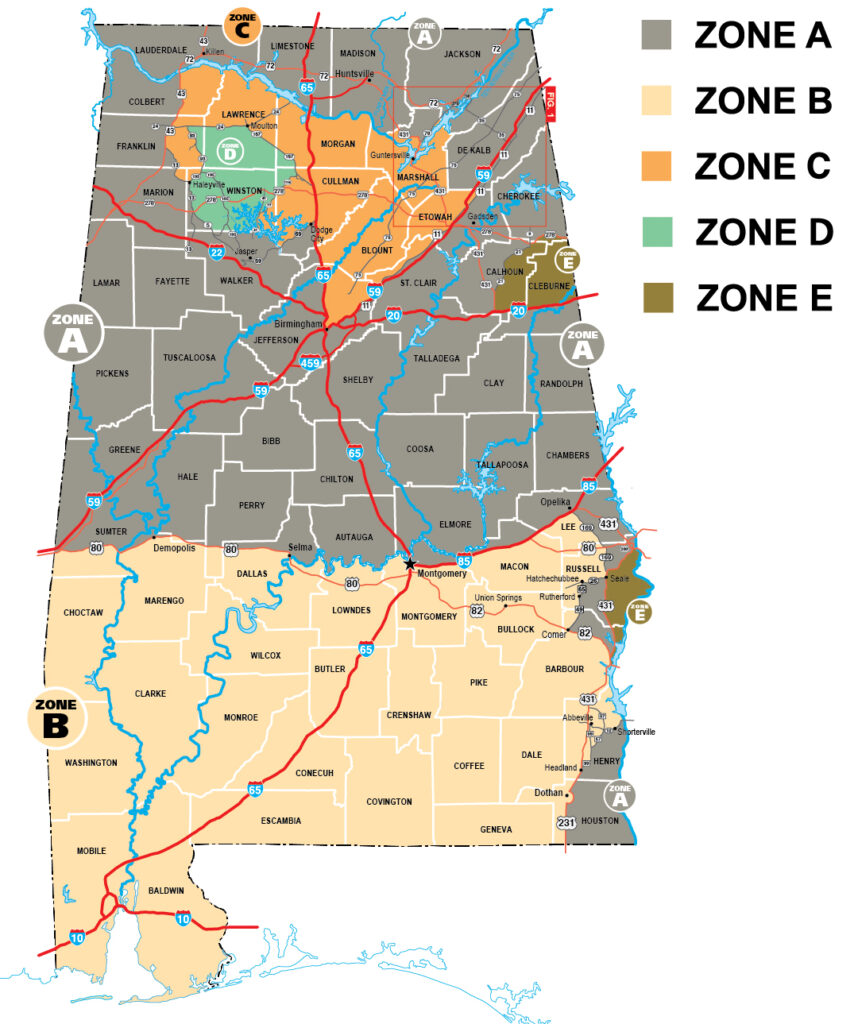
By DAVID RAINER
Alabama Department of Conservation and Natural Resources
Beginning on Monday, August 30, the Alabama Wildlife and Freshwater Fisheries (WFF) Division will offer a one-click solution for those who want to hunt feral swine at night.
The new law that allows nighttime hunting of feral swine and coyotes went into effect on July 1, 2021. When the 2021-2022 licenses become available Monday, hunters can choose from a variety of all-access packages, including the “Hog Wild” package that gives hunters all the license privileges needed to take advantage of the new nighttime hunting opportunities.
“When the nighttime feral swine and coyote hunting license was passed, it seemed like a good idea to create a new license package,” said WFF Assistant Director Fred Harders. “In that package, residents and non-residents will be able to click one button and purchase a small-game license, a bait privilege license, which would allow folks to use bait while hunting feral swine at night, and the nighttime license. We felt that those three licenses would be what most people would like to purchase.
“Of course, the price will vary depending on whether you are a resident or non-resident. This will allow that individual to just click that package instead of going in and figuring out what they need. It’s a convenience for people who would like to hunt feral swine at night over bait and not the regular all-game hunter.”
Harders said hunters who wish to purchase the all-game hunting license will need to go through the regular procedure of buying separate licenses to be able to hunt feral swine and coyotes at night.
Harders also reminds hunters that all of the current year’s licenses expire on Tuesday, August 31. Licenses for the 2021-2022 seasons will be available on Monday, August 30.
“We pre-sell these licenses for the coming year for several reasons,” he said. “Several seasons open early in September. We don’t want to make it difficult for hunters to participate in those seasons. Also, with all the licenses expiring the same day, the volume at the beginning of the year is very heavy, so we want to spread out the demand to ensure the license system performs as designed.”
Harders said since the nighttime licenses became available this summer, about 700 hunters have taken advantage of the new opportunity.
“We expect pretty good interest in the nighttime license for the upcoming year,” he said. “It’ll be interesting to see how many we sell the opening month. Whether it will be as popular as the bait privilege license, time will tell.”
During the current license year, WFF sold about 160,000 resident bait privilege licenses and more than 17,000 to non-residents. A bait privilege license is required for anyone who wishes to hunt deer or feral swine over bait, which includes corn and other food, protein supplements, mineral blocks, juices and sprays. Unlike other licenses, the bait privilege license and the nighttime hunting license do not allow for exemptions for age or landowner status.
When purchasing the licenses for the upcoming seasons, don’t forget about the collectible hard-card licenses that are available for an additional fee of $5. Seven new hard-card license designs will be available next week.
As the fall hunting seasons approach, WFF Director Chuck Sykes said the news about chronic wasting disease (CWD) is encouraging, but WFF will remain vigilant in trying to prevent its spread into Alabama. Positive cases have been reported in Mississippi and Tennessee.
“So far it’s moving slowly, like we told people it would if it wasn’t artificially transported,” Sykes said. “It’s inched a mile or two closer to us, but we’ve got several miles to go, and we have a major river system as a barrier. I think we’re as fortunate as we can be right now on the CWD front.”
Freezers that allow hunters to drop off their deer heads at self-service sample stations are located throughout the state and are available to receive samples for CWD testing 24 hours a day, seven days a week. Visit www.outdooralabama.com/cwd-sampling for a map of sampling locations.
At the self-service locations, hunters must first remove the deer’s head with 4-6 inches of neck attached. For bucks, antlers can be removed at the base of each antler or by removing the skull plate before bagging the head. Hunters will then place the head in the provided plastic bag and tie it closed. They will need to complete all sections of the Biological Sample Tag and attach the tag to the bag with a zip tie. Hunters will take the bottom receipt portion of the Biological Sample Tag before placing the bagged head in the freezer. All materials needed to drop off a sample are provided at each freezer location.
“We wish the hunters would participate more with their volunteer drop-offs at our freezer locations,” Sykes said. “Our biologists are still sampling deer, and our enforcement officers are still patrolling the roads to keep people from bringing deer carcasses into the state.”
A ban on the importation of live deer into Alabama has been in effect for many years. The regulations were amended several years ago to prohibit the importation of deer carcasses from all states and countries.
Regulations do allow for the importation of certain parts of the deer but not whole carcasses. Permitted parts include:
- Meat from the family Cervidae (white-tailed deer, mule deer, elk, moose, fallow deer, red deer, sika deer, caribou, etc.) that has been completely deboned
- Cleaned skull plates with attached antlers if no visible brain or spinal cord tissue is present
- Unattached antlers or sheds
- Raw capes if no visible brain or spinal cord tissue is present
- Teeth if no root structure or other soft tissue is present
- Finished taxidermy products or tanned hides
“We’re doing everything we can to keep the state as safe as we can and to be prepared if it does get here,” Sykes said.
Alabama’s deer hunting opportunities are divided into five zones to allow WFF to manage the deer harvest on a more local level. For the 2021-2022 season, Zone C in north Alabama has been adjusted according to the latest data on deer populations.
“Every year we tweak the zones a little,” Sykes said. “The more data we get coming in through Game Check, our staff and hunters, we can fine-tune those zones. We made a small tweak in the north central part of the state. Some of the areas with a reduced antlerless harvest limit fell in areas with a higher deer population, so we took them out of Zone C. The more we work with the hunters and staff in these areas and the better information we get from Game Check, the more we can refine these zones.
“Our deer populations are in a good place right now. We’re going to continue to monitor and make tweaks where we need to.”
Speaking of Game Check, Sykes is happy with the increased participation from hunters to report all their deer and turkey harvests. A change in the possession regulation last year significantly increased participation in Game Check. The possession regulation requires that hunters who harvest deer and turkeys must maintain proper paperwork when transferring possession of that animal to a processor, taxidermist or any other individual.
The person in possession of all or part of a deer or turkey that is not their own must retain written documentation with the name of the hunter, the hunter’s Conservation ID number, the date of the harvest and Game Check confirmation number. The information can be documented on any piece of paper, or a transfer of possession certificate is available in the Alabama Hunting & Fishing Digest or online at www.outdooralabama.com.
“Game Check participation went through the roof last year,” Sykes said. “We tweaked the regulation, and it made all the difference in the world. Our participation went from 40 percentile into the 90s. We’re now getting more of the valuable data we need to make quality management decisions.”
Fall Armyworms Part Three – Garden Vegetables Are on The Menu
Fall armyworms continue to plague many areas of the state. While usually known as a pest in lawns, pastures and hay fields, fall armyworms can also be a nuisance in vegetable gardens. With high populations this year, more and more gardeners are looking for ways to keep their vegetables off of the menu.
Scouting
Fall armyworms have a few distinct characteristics that make them easy to identify. Their head has markings that look like an upside-down Y. At the end of their body, the caterpillars have four black dots that form a square.
Ayanava Majumdar, an Alabama Cooperative Extension System entomologist, said when scouting for these pests, there are several things to look for.
“Gardeners should check for fall armyworm caterpillars underneath the leaves, and check for egg masses on soft leaves and stem terminals,” Majumdar said.
When scouting for the caterpillars, it is best to look during the cooler parts of the day. This is when they will be actively feeding.
Damage
Gardeners can also watch for infestations by looking for the damage that armyworms cause. While they prefer grassy crops, once those are gone, armyworms will move on to all kinds of horticultural crops.
As caterpillars, they are especially threatening to small, weak plants that are outdoors.
“Caterpillars will first go after the leaves or foliage on a plant,” he said. “After that, they will also cause damage to both unripe and ripe fruits.”
The damage on the fruit will appear as round holes, often on the top of the fruit. After making these holes, the caterpillars may enter the fruit and feed inside.
Egg-laying moths are a big threat on larger plants that are in an enclosed environment, such as a high tunnel or greenhouse.
Control
If an infestation is discovered, there are several chemical control options for home gardeners. Majumdar recommends that gardeners consider using an organic insecticide for control.
“The majority of organic insecticides are easily available through online vendors and the farm supply stores scattered around the state, making them a great choice for home gardeners and small farmers,” he said.
When applying any chemical product, always make a fresh solution for each application and follow all insecticide labels. A list of home garden insecticides for controlling fall armyworms in vegetables (both organic and conventional products) are listed in the Home Garden Vegetable: Insect Control IPM Guide.
Control Items to Remember
There are a few items that gardeners should consider when controlling fall armyworms.
The overall persistence and effectiveness of insecticides are greatly impacted by the weather. A second application may be necessary if a rain event occurs after the first application. If the first application fails to control the pests, do not use a product with the same mode of actionfor the second application.
Majumdar encourages home gardeners to be selective and timely with applications. Once the fall armyworms are under control, stop applying the insecticide.
“Overuse of an insecticide may increase the chance of resistance, pest resurgence (a secondary pest, such as spider mites, becoming a major issue) and loss of natural enemies,” he said.
For Future Reference
While controlling a current infestation is important, it is also important to plan for next year’s garden pests. Majumdar said making plans to implement a pest exclusion system in a garden will help with pest control next year.
“Pest exclusion systems, both permanent and temporary types, are extremely effective at blocking moths and reducing the overall number of armyworm caterpillars early in the growing season,” Majumdar said.
The Alabama Extension content piece Temporary and Permanent Pest Exclusion Systems for Vegetable Productionprovides an excellent discussion of the benefits of each type of system.
More Information
Gardeners and producers can download the Farming Basics mobile app for help with caterpillar identification. Through the app, people can contact a regional agent for identification and management recommendations suitable for their area. Updates on various pest activities are also available by subscribing to the Alabama IPM Communicator Newsletter.
For more information on fall armyworms, visit www.aces.edu.
Alabama WFF Adding Dove-Hunting Opportunities
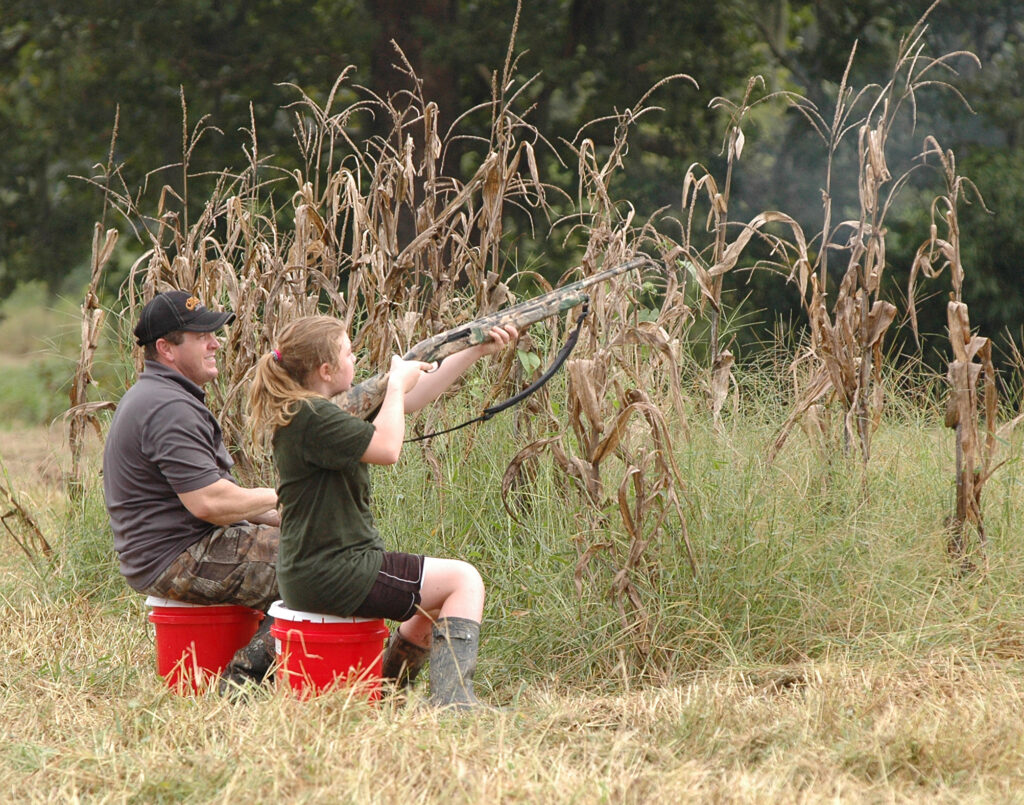
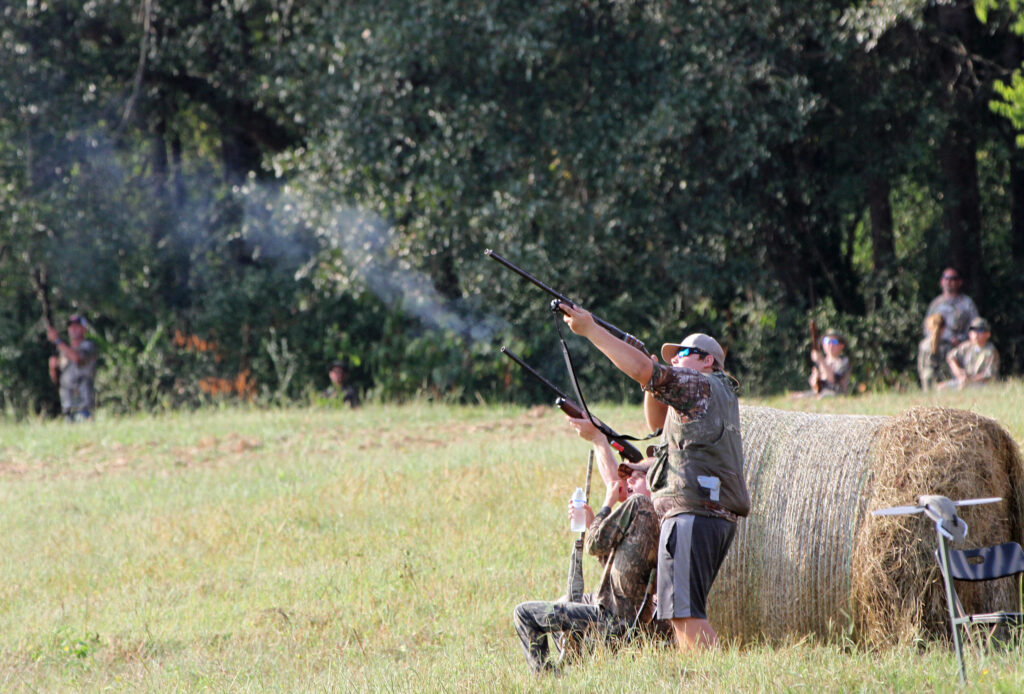
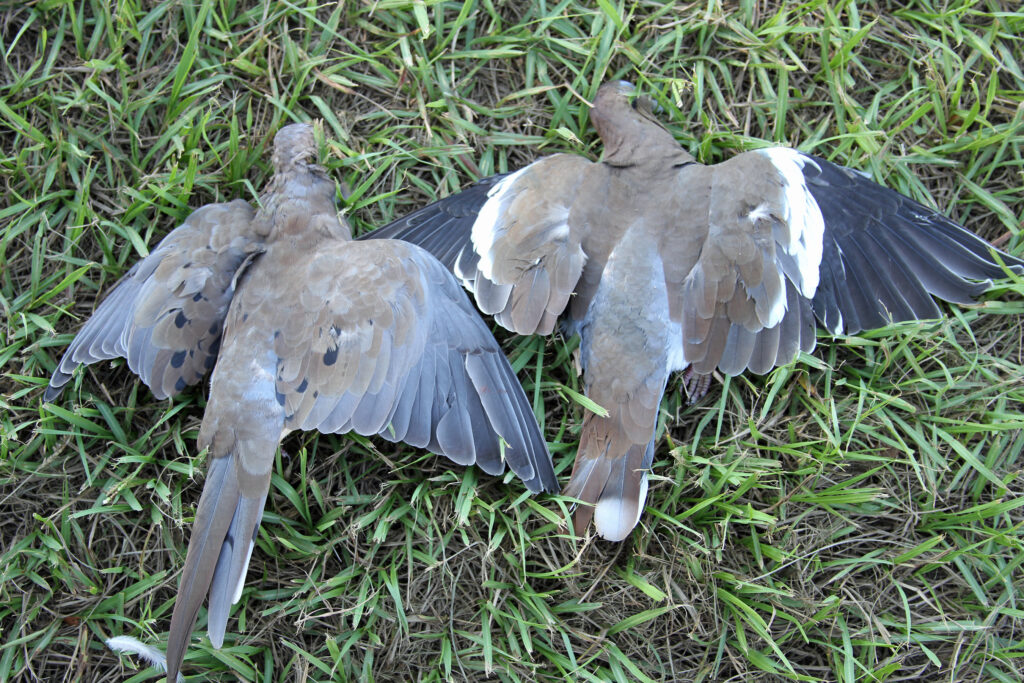
By David Rainer, Alabama Department of Conservation and Natural Resources
A place to enjoy a quality dove hunt is a valuable commodity in Alabama. Finding a place to hunt doves is becoming increasingly more difficult, but the Alabama Wildlife and Freshwater Fisheries (WFF) Division is working to increase access, especially near population centers.
WFF looked at the opportunities it provides for dove hunting on public land around the state and the demands hunters put on those areas. The staff decided to try to expand those areas, especially near metropolitan areas.
“We determined that we don’t have enough opportunity for hunting doves on opening day, not enough opportunity spread around the state,” said Seth Maddox, WFF’s Migratory Gamebird Coordinator. “There is a study done by the Georgia DNR (Department of Natural Resources) that looked at this. It found that most hunters are willing to drive within an hour from their house to participate in a good quality dove hunt.”
Maddox took maps of the 10 largest metro areas around the state and overlaid a 60-mile radius ring to find areas that would provide opportunities for hunting doves.
“We started looking for properties that would provide those opportunities,” he said. “We started with small, stand-alone properties, not necessarily associated with a WMA (wildlife management area).”
WFF found the first of what they hope to be several areas that fit that bill. The first purchase was the 165-acre Prairie Glades Special Opportunity Area (SOA) in 2021.
“The Prairie Glades SOA is in the Black Belt Region with that fertile clay component in the soil,” Maddox said. “It should be really good. There is lots of food out there for the birds. Closer to the season, we’ll do some bushhogging and disking. It’s a good place to have some dove hunters. It’s easy to get to from Montgomery and even Birmingham. I think we’ll have some keen interest this fall.”
Registration for the limited quota dove hunts at Prairie Glades and Portland Landing SOAs will open on September 1. Visit www.outdooralabama.com/hunting/special-opportunity-areas to find the link to register for the dove hunts, four at Prairie Glades and one at Portland Landing, and other hunting opportunities.
Maddox said WFF will also be looking for suitable property in southwest Alabama to expand the public’s access to dove hunting.
“We’re trying to find something in District 5 that is within an hour’s drive of Mobile,” he said. “That’s the area where we’re lacking most in public opportunity.”
Maddox said dove hunting is still a huge tradition in Alabama even though the number of dove hunters has been slowly declining since the ’70s.
“We still have between 40,000 and 50,000 hunters participate in dove season in Alabama,” he said. “We’re one of the top 10 states in harvest each year. People get out and take advantage of this season, one of our first seasons to open. Being in the South, we don’t have a lot of hunting early in the year like they do in northern states. Dove season is not as big a tradition in the northern states because they have other seasons opening up about the same time.
“Our seasons for deer and waterfowl open later in the year, so our hunters are chomping at the bit to do something out in the field, and dove hunting is the perfect opportunity for that.”
WFF conducted a hunter participation survey in 2018 and found that a majority of dove hunters in both zones wanted to open the seasons as early as possible.
For the 2021-2022 season, dove season in Alabama will open on September 4, the Saturday before Labor Day, in the North Zone. The South Zone opening day is September 11.
Under the federal guidelines, dove season can open as early as September 1, but that would fall on a Wednesday this year.
“Nobody wants to open in the middle of the week,” Maddox said. “We want to provide the maximum opportunity to get out in the field and the maximum opportunity for harvest.
“We traditionally opened the second or third Saturday in September, but that was back when we had a 60-day season. We have 90 days now. The longer season and our different zones allow us to take advantage of the different crop harvests. Peanuts are harvested later in the south part of the state compared to corn in the north.”
In terms of dove season zones, one big change is that Barbour County in southeast Alabama will be moving from the South Zone to the North Zone. Maddox said Barbour County had been in the South Zone during the 60-day season, which allowed those hunters to hunt the peanut harvest. With the 90-day season in the North Zone, Barbour County hunters can take advantage of early harvests and planting as well as the peanut harvest.
The South Zone now consists of Baldwin, Coffee, Covington, Dale, Escambia, Geneva, Henry, Houston and Mobile counties. The other 58 counties are in the North Zone.
Once again, WFF will hold its traditional youth dove hunts. Registration is underway for the 26 hunts across the state. Visit www.outdooralabama.com/youth-hunting/youth-dove-hunts for a link to register and a schedule for the upcoming hunts. Youth hunters can register for only one dove hunt at a time. After that hunt concludes, the youth hunters can register for another hunt.
In other migratory bird news, goose regulations have changed for the 2021-2022 season with a change in the bag limit. Hunters will now be allowed to have five Canada in the aggregate dark goose (Canada, white-fronted, Brant) daily limit for the entire goose season. The first two segments of goose season are September 4-October 3 and October 16-30.
“This frees us up from having to have a special early goose season,” Maddox said. “Instead of opening on September 1, we’re going to open September 4. We’re taking advantage of the resident Canada geese we have. We’re also allowing more weekend opportunities during the season.”
This year’s special early teal season is scheduled from September 11-26 with a daily bag limit of six birds.
Maddox said during this early season, the teal that show up in Alabama are almost exclusively blue-winged teal. He also said hunters will have a hard time determining whether the birds are hens or drakes.
“The males won’t be in their breeding plumage, so they won’t have that blue-gray head with that crescent moon white patch,” he said. “They are going to look like the females. You have to look at the wings to tell. Under the blue patch, there is a lot more white on the males. The females are speckled versus a full white patch. But they fly so fast that it’s going to be difficult to tell.
“Some people ask why they’re seeing all females. Well, they’re not all females. Once you harvest the birds, you will be able to tell that you are shooting males and females.”
Maddox is encouraged about the early-season prospects for Alabama hunters.
“I think it should be a good year,” he said. “We’ve had lots of rain, so everything is green. There will be plenty of food on the landscape.”
Sandhill Crane Season Returns for 2021-2022
By Kenny Johnson, Alabama Department of Conservation and Natural Resources
Alabama’s sandhill crane season returns for 2021-2022 with 400 permit holders having the opportunity to hunt sandhill cranes in north Alabama. Registration for the permits opens on September 8, 2021. The 2021-2022 season is split in two segments. The first segment runs from December 3 to January 9. The second segment runs from January 17-31.
Seth Maddox, Migratory Game Bird Coordinator for the Alabama Department of Conservation and Natural Resources’ (ADCNR) Division of Wildlife and Freshwater Fisheries (WFF), said a pair of factors made last year’s sandhill crane season successful for a majority of the 400 permit holders.
“It was a record year for wintering sandhill crane numbers in Alabama,” he said. “During the annual mid-winter survey, 23,354 sandhill cranes were counted across north Alabama. That is a 91% increase in birds over the 2020 survey. That’s also a 76% increase in sandhill cranes as compared to the long-term average of 13,242.”
A warmer, drier winter also contributed to the success of the season.
“Although the temperatures were above average during the hunting season, it was drier compared to the previous season,” Maddox said. “The water on the landscape was closer to average causing birds to concentrate more in traditional roost sites versus being more spread across the landscape as in the previous season.”
More sandhills and milder weather led to more birds being harvested compared to the 2019-2020 inaugural season.
“The overall harvest increased by 100 birds from 291 in 2019-2020 to 391 in 2020-21,” Maddox said. “Hunters were generally more successful last season as they figured out how to hunt these wary birds.”
James Michael Moyer from Irondale, Alabama, was one of those successful hunters. While Moyer had never hunted sandhills before the 2020-2021 season, he began researching the birds in early 2019 when he learned Alabama would be opening its first sandhill season in more than 100 years.
“I’d observed sandhills in other states but never really studied them because we didn’t have a season,” he said. “I called people all over the U.S. for tips on how to be successful. Some worked, some didn’t. Many of my all-day hunts were unsuccessful, but I always learned something new to try for the next one.”
Moyer met his three bird limit during the season and can attest to the sandhill’s reputation as the “ribeye of the sky.” However, it’s the conservation success story associated with the bird that he’s most proud of as a hunter.
Prior to the 2019-2020 season, the last sandhill crane hunting season in Alabama was in 1916. Since then, conservation efforts focused on improving habitat have helped sandhill crane numbers rebound enough to support a limited quota season in the state.
“Thanks to the hard work of biologists and waterfowl organizations, with the support of hunters through license and duck stamp funding, we are now seeing more sandhill cranes and have this new hunting opportunity,” Moyer said. “I strongly believe this is one of the greatest conservation success stories of my lifetime.”
The WFF’s Wildlife Section is primarily funded through a portion of hunting license sales that is matched on a three-to-one basis by the U.S. Fish and Wildlife Service through the federal Pittman-Robertson Act. Alabama State Duck Stamp sales are also matched through the same process, but earmarked by state law to be utilized for wetlands and waterfowl conservation. Funding from these two revenue sources directly benefits sandhill cranes by providing habitat protection, management and restoration work in the areas of Alabama that cranes utilize as migration routes and wintering habitat.
Registration for the 2021-2022 permits is limited to Alabama residents ages 16 or older or Alabama lifetime hunting license holders. Applicants must have their regular hunting license and a state waterfowl stamp to register. A $10 registration fee applies.
In addition to a hunting license and state duck stamp, hunters must also acquire a federal duck stamp and Harvest Information Program certification, and, if hunting on a Wildlife Management Area (WMA), a WMA license. Both state and federal wildlife refuges are closed to sandhill crane and waterfowl hunting.
For more information about the 2021-2022 sandhill crane hunting season, including the hunting zone location, how to register and how the permit holders are selected, visit www.outdooralabama.com/what-hunt/sandhill-crane-hunting-alabama.
The Alabama Department of Conservation and Natural Resources promotes wise stewardship, management and enjoyment of Alabama’s natural resources through four divisions: Marine Resources, State Lands, State Parks, and Wildlife and Freshwater Fisheries. To learn more about ADCNR, visitwww.outdooralabama.com.
Alabama’s Unparalleled Artificial Reef Zones Expanded
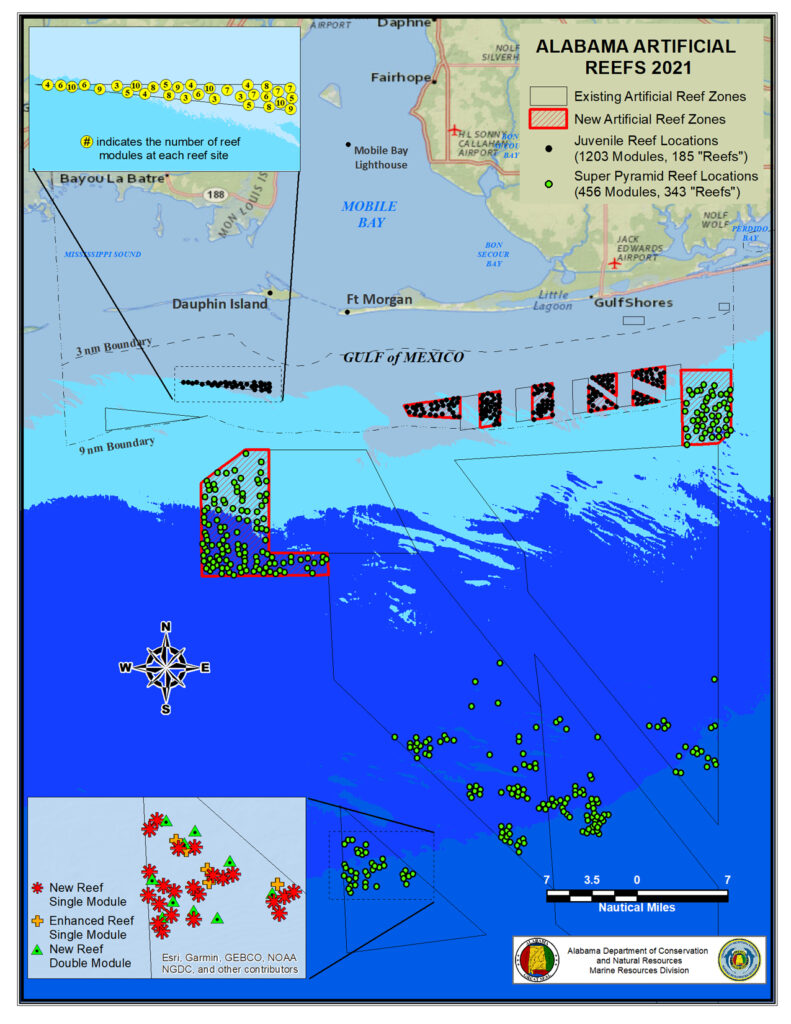
p.p1 {margin: 0.0px 0.0px 13.0px 0.0px; line-height: 15.0px; font: 13.0px ‘Helvetica Neue’; color: #161a1e; background-color: #ffffff}
A 25-foot-tall super pyramid is being deployed in one of the new offshore reef zones.

(Stewart Walter) Juvenile fish reefs are being deployed in pairs in the new nearshore reef zones off Alabama.

By David Rainer, Alabama Department of Conservation and Natural Resources
Already the largest in the nation if not the world, Alabama’s artificial reef zones recently got even larger with the addition of 110 square miles of Gulf of Mexico bottom.
As part of an overall $8.135 million expansion of the Alabama Artificial Reef Program, the Alabama Department of Conservation and Natural Resources, Marine Resources Division (MRD) recently received authorization of two additional permit areas from the U.S. Army Corps of Engineers.
Craig Newton, MRD’s Artificial Reef Coordinator, said the grants from the National Fish and Wildlife Foundation’s Gulf Environmental Benefit Fund, established with criminal fines after the Deepwater Horizon Oil Spill, will also allow MRD to deploy artificial reefs in both nearshore and offshore reef zones.
“We have expanded the 6- to 9-mile reef zone,” Newton said. “Originally, we had about 30 square miles in that reef zone. We’re expanding by 23 square miles near Gulf Shores and Fort Morgan and another 24-square-mile area offshore of Orange Beach that is between 8 and 15 miles offshore.”
The largest of the new reef zones is between 13 and 25 miles south of Dauphin Island and adds 63 square miles for the 110-square-mile total of new water bottom for constructing artificial reefs.
The approval of the new zones was a lengthy, comprehensive process to ensure historical resources and artifacts were not impacted by the new reef zones. The cost associated with the permitting process was $742,000.
“We had to do bottom surveys that were required by the National Historical Preservation Act to ensure that cultural resources are not compromised,” Newton said. “These cultural resources could be shipwrecks, Civil War artifacts and areas that early inhabitants used as campsites or mounds thousands of years ago.
“During eras of sea level transgressions, water bottoms near the Alabama coast would have been exposed. The sub-bottom profiler (scanning equipment) data actually identifies natural levees of bayous, rivers and creek banks where early inhabitants would have made campsites and used for hunting grounds thousands of years ago.
“The surveys identified a handful of areas we have to avoid, but generally didn’t find anything of cultural significance. Ultimately, it resulted in 110 square miles of water bottom being authorized by the Corps of Engineers.”
With permits in hand and contracts executed, MRD started deploying artificial reefs in the new reef zones on July 30, 2021.
Newton said in the 6- to 9-mile reef zones a total of 1,203 juvenile reef fish shelters will be deployed at numerous locations with 3 to 10 shelters per reef site as part of a $2.4 million contract. The modules are 4.5-foot-diameter concrete discs placed on a pedestal and embedded in a concrete slab. Each module will have four discs.
“Our monitoring and research have shown that these type modules are extremely effective for providing habitat for juvenile reef fish, particularly gray triggerfish,” he said. “Young red snapper, gray snapper and lane snapper will also use these structures. Since we have been deploying a significant amount of adult-size reef structures, we felt that adding these juvenile structures will help facilitate the recruitment of juveniles to the larger reefs farther offshore. It increases the juvenile reef fish habitat that we have offshore of Alabama.”
Speaking of the larger offshore reefs, Alabama Department of Conservation and Natural Resources Commissioner Chris Blankenship executed a $4.9 million contract to deploy 456 pyramid-shaped modules, each 25 feet tall and made of concrete and limestone. At the new reef zone south of Dauphin Island, 164 modules will be used to create 123 reefs. Some of the reef sites will have two modules and others a single module.
In the 24-square-mile zone off Orange Beach, 64 of the pyramids will be used to create 48 reef sites.
Farther offshore, 35 miles and beyond, 228 pyramid modules will be used to create 172 new reef sites. At those offshore sites, the 25-foot-tall pyramids will be deployed in single and double models as well as providing additional structure to existing small pyramids that were deployed in 2004 and 2005.
GPS coordinates for the new reef sites will be published this fall after all the reefs have been deployed.
“Generally, a wide variety of reef fish will be utilizing the larger pyramids,” Newton said. “Farther offshore, these structures will provide quality habitat for not only red snapper but also amberjack, vermillion snapper and groupers too.
“The juvenile reefs will help provide a connective link between the fish utilizing the inshore habitat and the fish moving to the offshore habitat. One example is flounder that migrate to the Gulf each year for spawning purposes. These nearshore reefs will provide habitat during their spawning season. They will also provide a type of stepping-stone habitat for gray snapper as they move offshore. Juvenile gray snapper use inshore habitat like docks and inshore reefs in the estuaries, and then they move into the Gulf of Mexico for their adult life. These nearshore reefs will provide refuge to help them more effectively recruit to larger reefs offshore.”
Marine Resources Director Scott Bannon said, “I am very proud of the work that Craig and his staff have done to enhance fish habitat and angling opportunities off the coast of Alabama. They have put in a tremendous amount of time and effort to develop a balanced plan that addresses habitat from fish spawning through adulthood, from inshore to offshore, that will benefit the resources and fishermen for years to come.”
Commissioner Blankenship said he constantly brags about Alabama’s Artificial Reef Program and the new project is just going to make it better.
“I am glad to see the reef areas expanded and the deployment of several hundred new offshore and nearshore artificial reefs,” Commissioner Blankenship said. “We already have the best artificial reef program in the country, but we are not resting on our laurels. With the expansion of the reef zones and the new reefs we are building, we will ensure continued great fishing off the coast of Alabama for decades to come. I appreciate the partnership with the National Fish and Wildlife Foundation to assist in funding the multimillion-dollar construction of these reefs.
“The fishing this year has been great when the weather has allowed for boats to get out and enjoy it. Red snapper fishing is always great, but the last two years have really seen the resurgence of gray triggerfish. Since the triggerfish season reopened August 1, I have seen some great ‘trash can’ size triggerfish photos on Facebook of fish harvested in the Alabama Artificial Reef Zones. Triggerfish is right up there with cobia as the best-tasting fish in the Gulf, in my opinion. I hope to get down to Dauphin Island and catch some this weekend. With greater amberjack, red snapper and triggerfish seasons all open right now, it is a great time to wet a hook on some of the productive reefs off the coast of Alabama.”
With the additional 110 square miles, the Alabama Artificial Reef Program now encompasses more than 1,136 square miles of water bottom in the Gulf. More information about the Alabama Artificial Reef Program and coordinates for the reefs can be found by clicking here: Artificial Reefs | Outdoor Alabama
Soft, Cute, Colorful Nightmares: Venomous Caterpillars of Alabama
Caterpillars can be cute, are generally soft to the touch, and sometimes even beautiful to behold with intricate, colorful designs.
Plus, they transform into butterflies and moths — insects that even people who find most bugs creepy still tend to appreciate.
Such a delicate critter couldn’t possibly be dangerous, right? Not necessarily. In Alabama, some caterpillars, if touched, can cause people so much pain that they may end up hospitalized.
“The vast majority of caterpillars are totally harmless, but about a dozen or so in Alabama have some sort of stinging capability,” said Dr. John Abbott, an entomologist and chief curator and director of the Department of Museum Research and Collections.
Abbott said these venomous caterpillars are most active in late spring through summer and early fall.
They’re not aggressive, but because they’re generally “fleshy little snacks for all sorts of predators,” some are equipped with urticating hairs, which are hollowed, barbed hairs filled with venom as a defense mechanism.
“If you touch one of these caterpillars, these barbed hairs will stick into you, break off and envenomate you,” he said. “It’s not like a wasp that actively continues to sting you. It’s passive, but it certainly packs a punch.”
All of the caterpillars that sting in Alabama turn into moths.
Amongst the most common stinging caterpillars in the state is the saddleback caterpillar, which is 1 inch long with a green “shirt” on its generally brown bodies and a saddle-looking pattern on its back. Its venomous hairs are gathered in bunches at the end of its body. The pain of its sting is comparable to a honeybee’s.
“Then there are io moths and buck moths caterpillars that are in the giant silk moth family,” Abbott said. “Those are the largest of the ones that sting. They’re covered in very pronounced spines and ornamentations and color patterns that suggest you should be careful.”
The buck moth caterpillar is about 2.5 inches long, and its sting causes immediate, radiating pain, followed by itching, redness and swelling that can last up to a week.
The most dangerous of the stinging caterpillars in Alabama is the asp or puss caterpillar. It doesn’t move much and its colors and design are very bland — it looks like a small blonde, brown or gray wig — but its venom is excruciating.
“They’re called asp caterpillars because the pain of their venom is very painful, conjuring a comparison to that of an asp snake,” Abbott said. “They are often found on the side of trees and bark getting ready to pupate. They often find firewood stacks to pupate and that’s where people encounter them.
“Their sting is very painful and certainly can send you to the hospital.”
Like with any insect sting, reactions can differ from person to person. Some people can go into anaphylaxis and others will just have pain. Abbott advises that if stung by a venomous caterpillar, a person should put duct tape over the area so the barbed hairs can be pulled out. Next, put some ice on the area to reduce swelling. If breathing issues or extreme swelling occur, go to urgent care or the ER.
“As with anything if you don’t know what it is you should stay away from it,” he said. “I don’t want people to be fearful of going outside, but some caterpillar stings can definitely be painful, though the vast majority are not, even the harrier ones.”
Why Are There Seasons and Catch Limits for Alabama Fish?
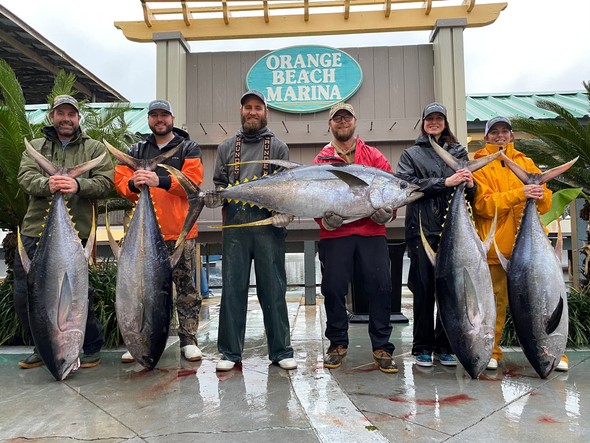
By Chris Blankenship
Commissioner, Alabama Department of Conservation and Natural Resources
The waters of Alabama and the Gulf of Mexico are teeming with fish of all shapes and sizes. The amazing colors in God’s palette lend themselves to adorn the beautiful fish we all love to reel in and admire — and eat!
There’s a catch when it comes to your catches though: If it’s not in season or within the size limit, you’ll have to throw it back.
It can be tempting to keep a tasty red snapper in the spring or stock up on big momma speckled trout, but Alabama’s fishing rules and regulations are more than just arbitrary restrictions. Every time you throw back a fish that is not in season or not the right size, you’re helping Alabama’s natural populations sustain and replenish themselves.
This may seem like an obvious responsibility — to do our part to help our diverse ecosystems flourish — but without strict oversight of our local fisheries, we’d be at risk of overfishing. In fact, overfishing isn’t as uncommon as you might think. Both in our nation and worldwide, many examples come to mind of fisheries that, unchecked, become imperiled very quickly. The reef fisheries around Puerto Rico were in almost total collapse a few years ago but are rebuilding now, thanks to new limits, and you can ask Maryland and Virginia why Alabama processors ship lots of our blue crab up their way.
Thankfully for us and our neighbors, the good work of Alabama Department of Conservation and Natural Resources (ADCNR) biologists and enforcement officers is keeping the fish and seafood stocks in our waters trending in the right direction.
Sustainable harvest of fish, crabs, oyster, shrimp and other aquatic sea life is part of what makes living on and visiting Alabama’s coast so special and memorable. Simply put, our fisheries must limit harvesting to allow populations to replenish themselves and enforce fishing methods that won’t have a damaging environmental impact, all while complying with state, national and international regulations.
Most minimum size limits of fish are set just above the length where most of the fish of that species reach sexual maturity. This just makes good common sense. For stocks to replenish themselves, we need the fish to spawn at least once before they are harvested. When you catch an 11-inch flounder, throw it back and let it find a female friend and do its thing so they can make a bunch of baby flounder that we can harvest in future years.
While it is important for the fish to spawn at least once before harvest, some fish species have egg production that is exponentially larger as they get bigger. That is why we have some fish with slot sizes where you can only keep one fish over a certain size. This has been the case for red drum for a long time. We added a slot limit for spotted sea trout (speckled trout) a couple of years ago. Speckled trout females over 22 inches produce millions more eggs than fish in the 15- to 16-inch range. We want those big momma fish out there spawning away to produce the amount of fish needed to sustain the fishing pressure increase we have seen over the last decade on speckled trout. And it is working. We have seen populations of flounder and spotted sea trout trending in the right direction just two years after we modified our regulation to provide those two species with more protections.
Some fish don’t have populations that can sustain a year-round season and, therefore, have quotas or overfishing limits that are used to set seasons that keep those stocks healthy or rebuilding. We have specific seasons for red snapper, grouper, triggerfish and amberjack and other species that were at one time each severely overfished and in peril. We can all debate if the current federally set quotas are reasonable or if those seasons are too short, but one thing is for sure: If we had not made changes to limit the harvest to some level when we did in the early 2000s, those stocks would be almost nonexistent today.
Limits for both commercial and recreational harvests are critical to the sustainability of our resources. They are designed to maintain current stock levels or to increase abundance of a stock. Some species just need to have a population sufficient to reproduce annually, but other species need several years to reach maturity. Those that need more time are generally the ones that have experienced overharvesting. We at ADCNR are working to grow all of our stocks.
While it’s our human responsibility to protect and maintain our aquatic ecosystems, sustainability isn’t just an environmental issue. It’s an effort that’s intrinsically tied to our seafood industry as well.
For example, if Alabama anglers and commercial fishermen were to overfish a particular species, our seafood processors eventually would have to limit the amount of that product they could distribute, which would limit that product on restaurant menus. And if this trend were to continue, it could cause that species to disappear from Gulf waters altogether.
Seasons and quotas are not the burden you might think they are on Alabama chefs though.
When a Gulf seafood product is limited to certain seasons or amounts, our Southern chefs get creative. Our waters are home to much, much more than the typical snapper, grouper and flounder you may be used to seeing on the menu. Sustainability allows our restaurants and markets to feature these popular favorites, but chefs also make great entrees of other species previously thought to be “trash fish” that are just as tasty even though they’re less widely known. Sheepshead, drum and Spanish mackerel are a few good examples.
Catch limits may seem like a pain when you’re out fishing, but it is important to remember that those limits are in place to maintain healthy, sustainable stocks so we can all catch and cook those species for many years to come. So while it may be a bummer to throw back some would-be prize fish on your next fishing trip, remember that you’re directly contributing to the sustainability of Alabama’s fisheries.
Take a Friend Fishing and Enter the Black Belt Best Fish Photo Contest
Take a Friend Fishing and Enter the Black Belt Best Fish Photo Contest
Set the hook and snap a pic to enter the Alabama Black Belt Adventure Association’s (ALBBAA) 2021 Best Fish Photo Contest. New this year, participants in the contest must take a first-timer or beginner angler along for their adventure. Participants are encouraged to help mentor these new anglers and share their experiences of including these young people or adults during their outing. The contest, which opens Wednesday, July 28 and runs to Thursday, September 30, is eligible for any type of fish caught in the Black Belt during 2021 only. Participants should visit https://alabamablackbeltadventures.org/bestblackbeltfishcontest/ to enter their catch and to vote for their favorite entry. Visitors to the contest webpage may vote once per day, per entry, per IP address.
“Over the last year we’ve seen many first timers hit the woods and water in search of adventure,” said ALBBAA Director Pam Swanner. “Our fishing photo contest this year is designed to continue that trend by encouraging folks to take along someone new to experience the thrill of reeling in the big catch or simply enjoy the beauty of being in the great outdoors. There are great public access points to fantastic fisheries all across our region from Lake Eufaula to Miller’s Ferry and to our region’s west, the Tombigbee. Many of the lodges across the Black Belt offer trophy bass fishing with full amenities as well.” The prize package includes 1-day of fishing for two people on one of the five trophy-managed lakes at Triple D Ranch near Emelle, AL in Sumter County. One-night’s lodging is also included. Please note that Triple D is a bring your own boat destination, and the winner and their guest must fish in the same boat. ALBBAA promotes and encourages ethical hunting and fishing practices. Photos contests were created to further educate the public on the abundance of natural resources found across Alabama’s Black Belt region. The Black Belt includes the following counties: Barbour, Bullock, Butler, Choctaw, Clarke, Conecuh, Crenshaw, Dallas, Greene, Hale, Lee, Lowndes, Macon, Marengo, Monroe, Montgomery, Perry, Pickens, Pike, Russell, Sumter, Tuscaloosa and Wilcox.
Mimosa Trees: Looks Can Be Deceiving
By Mary Leigh Oliver
Don’t let their perfect pink, puff-like blooms deceive you. While beautiful, mimosa trees are a threat to the Southern landscape. Native to the Middle East and Asia, these trees came to the United States in 1785 as an ornamental tree. First planted in South Carolina, they continue to invade the Southeast.
Mimosa Tree Takeover
According to Lynn Dickinson, an Alabama Cooperative Extension System forestry, wildlife and natural resources regional agent, while mimosa trees may be beautiful, they are considered an invasive species.
“An invasive species is an aggressive, non-native plant capable of outcompeting most vegetation,” Dickinson said.
Invasive species can cause environmental damage by displacing native plants and animals. Animals that are dependent on the resources from native trees will struggle because of the mimosa trees.
“Many insects depend on our native species for food and many bird species depend on those insects,” she said. “Without native tree species, we run the risk of losing the insects and the food source for native birds.”
Mimosa trees grow in a variety of different soil types, moisture conditions and natural areas. As they grow and spread, they compete with native species for light, water and nutrients.
“Although pretty, non-native species such as mimosa can do a great deal of harm to our environment,” Dickinson said.
Slow the Spread
Mimosas are on roadsides, streams, forest edges, grasslands, vacant lots and clearings, so slowing the spread is essential. If not controlled now, there is a possibility that these trees may begin to invade northern landscapes if temperatures continue to rise and provide favorable growing conditions.
Since the mimosa tree is so aggressive, it is important to take the needed steps to slow their spread. To begin the process, rid landscapes of mimosa trees by cutting them at ground level. Then, use a herbicide—such as glyphosate—on the stump to prevent new growth. If the tree is still a seedling, landowners can pull those seedlings by hand. However, make sure all of the roots come out of the soil. Lastly, while removing invasive species, planting native species into the area will help restore the environment.
“Managing invasive species while also planting back native alternatives provides us with an opportunity to protect our forested land,” Dickinson said.
More Information
For more information on mimosa trees and management of invasive species, visit the Alabama Extension website, www.aces.edu.
Wedgworth named World Champion at rodeo finals in Oklahoma

Just two years after entering his first sanctioned rodeo, local cowboy Louis Wedgworth of Livingston has clinched the title of World Champion. This comes just after celebrating multiple state titles won at the Alabama Little Britches Rodeo Association state finals in May.
Wedgworth, nine years old, now holds titles as 2021 National Little Britches Rodeo Association (NLBRA) Little Wrangler (LW) All Around World Champion, 2021 NLBRA LW Flag Racing World Champion, and 2021 NLBRA LW Finals Champion. Competition wrapped Sunday, July, 11, at the NLBRA Finals Rodeo in Guthrie, Oklahoma. Prizes associated with his victories include cash earnings, scholarships, saddles, buckles and other tack.
Wedgworth competes with two horses. Fastback, his bay gelding, competes in flag racing, and Cowboy, his bay pony, competes in pole bending, barrel racing, and goat tail untying. These equine athletes are champions that work hard for Wedgworth every day.
Wedgworth also borrows a grey gelding named Jake from his cowboy friend, Slick Robison, to improve his discipline in the practice pen. Jake has been instrumental in helping Wedgworth prepare for flag racing finals. In the practice pen, Wedgworth also benefits from the expertise of his goat tail untying coach, Heather McLaughlin, a member of the University of West Alabama Tiger Wranglers who finished fifth in the nation in goat tying at the 2021 College National Finals Rodeo in June.
All-around titles are awarded to the rodeo competitor who is most successful in two or more events, and Wedgworth was successful in earning points in all four events. Wedgworth really shined in flag racing while competing in the NLBRA Finals in Guthrie the week of July 5.
Competing in the Little Wranglers class, Wedgworth won the world title in flag racing, a timed event in which Wedgworth and his horse, Fastback, race to place flags in and out of buckets placed on barrels at the far end of the arena. Wedgworth’s first run was 8.385 seconds in the first round, and he only got faster over the course of the week. His final run in the short round was the fastest recorded time at finals of his age class of 7.737 seconds. Wedgworth finished the event with 1,092 points, an impressive 72 more than his nearest competitor, who was named reserve champion. In the all-around, Wedgworth finished the season with 2,848 points.
Wedgworth is the son of Evan and J.J. Wedgworth of Livingston, and the grandson of Bruce and Cindy Cook of Livingston, and Donnie and Karen Wedgworth of Greensboro. Outside of rodeo, he loves to fish, play baseball, and spend time with his family, friends and his three dogs, Haze, Shine and Spur.
Outdoor Alabama Photo Contest Opens August 2
Outdoor Alabama Photo Contest Opens August 2
The 2022 Outdoor Alabama Photo Contest will begin accepting entries on Monday, August 2, 2021. This year’s contest is a joint project between the Alabama Department of Conservation and Natural Resources (ADCNR) and the Alabama Tourism Department. The deadline to enter is October 31, 2021.
The 2022 photo contest will focus on traditional photography techniques and the use of hand-held cameras. No cellphone, smartphone, game camera, or drone photography will be chosen as winning photos for nine of the 10 categories. Smartphone and tablet photos will be accepted in the Young Photographers category.
The photo contest is open to state residents and visitors alike, but qualifying photos must have been taken in Alabama in the past two years. Any amateur photographer not employed by ADCNR is encouraged to enter.
A total of eight photos per person may be entered in the following categories. You may enter all eight in one category or among several categories.
2022 Outdoor Alabama Photo Contest Categories
• Alabama State Parks
• Birds
• Bugs and Butterflies
• Cold-blooded Critters
• Nature-Based Recreation
• Scenic
• Shoots and Roots
• Sweet Home Alabama
• Wildlife
• Young Photographers (ages 17 and under)
First, second, third and one honorable mention will be awarded in each category. Winning images will be featured online and in an exhibit traveling to various venues across the state during 2022.
Art teachers are encouraged to incorporate participation in the Young Photographers category into their art instruction this fall.
An exhibit of the 2021 winning photos will be on display at the Johnson Center for the Arts, 300 E. Walnut St., in Troy, Alabama, from August 11, 2021 – September 11, 2021. To view the winning photos online, visit https://www.flickr.com/photos/outdooralabama/albums/72157718137637166.
For complete 2022 category descriptions and contest rules, visit www.outdooralabama.com/outdoor-alabama-photo-contest.
The Alabama Department of Conservation and Natural Resources promotes wise stewardship, management and enjoyment of Alabama’s natural resources through four divisions: Marine Resources, State Lands, State Parks, and Wildlife and Freshwater Fisheries.
From the Live Well Alabama Kitchen – fruit water recipes
By Katie S. Etheridge
Most people do not drink enough water, and one can dehydrate fast in the hot Alabama sun. That is why this Food Friday, Live Well Alabama is serving up seven delicious Fruit Flavored Water recipes to turn water from drab to fab.
“Water is a key player in keeping your body working well at every level. Adult men should aim to drink approximately 12.5 cups per day, and adult women should try for 9 cups a day. Our fruit infused waters are great for adding subtle sweetness without excess sugar. Eat the fruit afterwards to get the most out of this tasty treat!” -Katie Funderburk, Alabama Extension nutrition specialist and registered dietitian
Ingredients
Blackberry Mint Recipe
40 blackberries, smashed
40 mint leaves, torn in half
Blueberry Orange Basil Recipe
Three oranges, quartered
30 to 45 blueberries, squeezed
Nine basil leaves, torn in half
Citrus Recipe
Oranges, sliced
Grapefruit, sliced
Lemons, sliced
Pineapple Orange Recipe
¼ pineapple, sliced
½ orange, with peel
Raspberry Lime Recipe
Four limes, without rind
40 raspberries, smashed
Strawberry Kiwi Recipe
Two kiwi, sliced
Five strawberries, sliced
Watermelon Rosemary Recipe
¼ seedless watermelon
Two sprigs rosemary
Pro Tips
Freeze mixture in ice trays for homemade popsicles. Mix with sparkling water instead for that added pizazz. Use a reusable bottle to support sustainable living.
For each recipe, mix the ingredients with a gallon of water and stir. Serve over ice.
Want to learn more? Step by step instructions for the Fruit Flavored Water recipes, as well as an instructional video, are available at LiveWellAlabama.com.
Live Well Alabama is a Supplemental Nutrition Assistance Program-Education (SNAP-Ed) initiative developed by the Alabama Cooperative Extension System at Auburn University. This initiative reaches residents across the state with research-based education. “Live Well Alabama recipes are all about trying fruits and veggies in tasty, easy and budget-friendly ways.” Funderburk said. “Our recipes are easy to prepare, and they don’t require any fancy kitchen equipment.” Eating healthy doesn’t have to be difficult or expensive. Live Well Alabama provides numerous recipes that are simple and budget friendly.
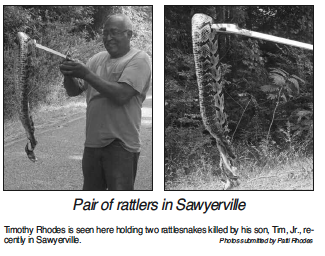
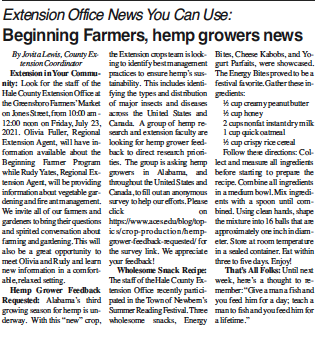
Happy Hummers: Feeding Hummingbirds in Alabama
By Katie Nichols
Hummingbirds are a beautiful and exciting part of Alabama summers. Hummingbird feeder etiquette is not widely known, but it is an important part of caring for the hummingbirds in and around the back yard.
White Granulated Sugar
Alabama Cooperative Extension System Forestry and Wildlife Specialist, Wesley Anderson, said it is important to use white granulated sugar when making sugar water.
“Only use white granulated sugar to make sugar water,” Anderson said. “Honey is not easily digestible for hummingbirds, and they will die from lack of nutrition. It could also encourage fungal growth that could harm the birds.”
He said powdered sugar, although white, contains cornstarch to prevent caking and clumping. The additive isn’t good for the birds and can encourage fermentation of the sugar water, so it should be avoided.
“White sugar has been purified to remove all of the molasses, whereas brown sugar has not,” Anderson said. “Molasses contains iron. Even though the amounts of iron in brown sugar and other foods are not harmful—and may even be helpful—to people, hummingbirds would consume enough iron from a brown sugar solution that it would be harmful.”
Red Dye
Anderson said it is best to avoid red dye altogether.
“The advice to remove red dye from solutions came out when Red Dye No. 2 was in use in the 1970s. It was a known carcinogen,” he said. “At that time there was concern it was having detrimental effects on hummingbirds, but no scientific studies were conducted. Red Dye No. 2 has since been pulled from the market.”
Today, many gardeners and homeowners use Red Dye No. 40 in many foods, drugs, tattoo ink and cosmetics. Anderson said while it is labeled safe by the United States Food and Drug Administration (FDA) for human use and consumption, it is important to consider the size of a hummingbird.
“Common hummingbird species, like the ruby-throated, only weigh about three grams—or the combined weight of three paper clips,” he said. “They are incredibly tiny in comparison to humans, so the amount of dye they would consume would far exceed any levels humans would consume.”
Since there isn’t a clear picture of the negative side effects that could cause, it is best to avoid the dye. Anderson recommends using colorful feeders and planting red flowers near the feeders to increase the number of hummingbirds that visit the feeder.
Rescuing Hummingbirds
Many individuals encounter hummingbirds seemingly tangled in spiderwebs. Anderson said hummingbirds will actually use spider silk while constructing their nests. Larger spiders may even feed on hummingbirds.
“If you come across a hummingbird stuck in a spider web and it’s still alive, you can remove it,” he said. “Remove all of the spider silk and allow it to rest. The rescuer may also offer sugar water—white granulated only—in a small cap or lid.”
If the bird appears injured or doesn’t fly away, Wesley suggests finding a licensed wildlife rehabber. It is against federal law to rehabilitate an injured hummingbird without a license.
Anderson cautions individuals to be mindful of the spider that wove the web. He said in Alabama, black and brown widows are the only medically significant species in Alabama that may entangle a hummingbird. For that reason, always exercise caution when removing a bird.
More Information
For more information about hummingbirds, read the Extension publication Hummingbirds in Alabama available at www.aces.edu.
WFF Law Enforcement Section Teaches Ladies Who Hike Firearms Basics
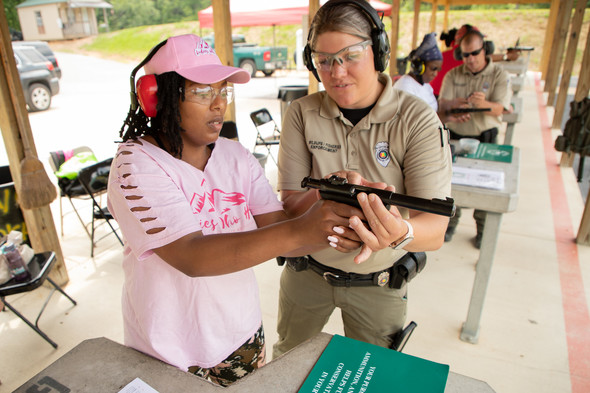
By Kenny Johnson, Alabama Department of Conservation and Natural Resources
Two of the main barriers facing folks interested in outdoors recreation is a lack of access and not knowing others who already participate in those activities. Birmingham’s Brittney Davis is working to reduce those barriers for members of an organization she founded in 2017, Ladies Who Hike.
The group treats its members to 12 local and regional hikes each year as well as an annual trip and other outdoors-related experiences. Since their first hike with 19 members at the Forever Wild Ruffner Mountain Nature Preserve in Birmingham, the group has grown to 125 members and has traveled extensively throughout the Southeast.
Davis created the hiking group to provide a community for women in the Birmingham area in which they could share a variety of adventures.
“Ladies Who Hike was started when I went on a solo hike,” Davis said. “I had the idea to invite other women along and make a day out of it. The group grew organically from there. My motivation is to have a community and sisterhood where like-minded, positive women can come together and enjoy nature.”
As a Girl Scout growing up in Mobile, Alabama, Davis enjoyed camping and all things nature related. In addition to hiking trips, Davis takes inspiration from her time as a Scout to help introduce other women to new outdoors experiences.
This spring, 18 Ladies Who Hike members attended an Introduction to Handguns course offered by the Law Enforcement Section of the Alabama Wildlife and Freshwater Fisheries Division (WFF). The class provides basic tips on firearms safety and storage as well as shooting range experience. Most of the members who attended the class had never had the opportunity to fire a gun.
The 4-hour course is taught at various WFF public shooting ranges throughout the state and is perfect for anyone with an interest in learning how to fire a handgun in a safe, family friendly environment. All firearms, ammunition and eye and ear protection are provided, but you will need a Wildlife Heritage License to participate.
“I believe gun safety is very important, and I wanted to provide my ladies an opportunity to learn how to use a firearm properly and get comfortable using a gun,” Davis said. “Many of our women said it gave them the confidence to go and purchase their own gun.”
The Firearms 101 class was Tiffany Morris’ first adventure with Ladies Who Hike. The Grayson Valley resident grew up in Ensley, Alabama, and had never fired a gun prior to attending the class. Hiking and shooting sports were not a part of her childhood.
Morris joined the group for the sense of community it offers women looking to explore the outdoors.
“I enjoy hiking,” she said. “But I don’t always want to go by myself.”
Morris said her experience taking the Firearms 101 class sparked an interest in target shooting. She plans to practice her new skills at one of the WFF public shooting ranges in the future.
“The instructors taught us how to stand and how to hold a firearm while using it,” she said. “We also learned about the correct type of ear protection and safety glasses you need and the best clothes to wear when target shooting. Learning how important it is to focus on the target and your breath was also a surprise.”
Sgt. Scott Kellenberger, WFF’s Hunter Education Coordinator for District 2 in northeast Alabama, was the lead firearms instructor during the Ladies Who Hike visit to the Cahaba River Wildlife Management Area (WMA) Shooting Range near Helena, Alabama, earlier this year.
Kellenberger learned to shoot a .22 rifle under his dad’s supervision when he was about six years old. Later he would learn how to fire a shotgun while hunting with his dad and grandfather. Today, he holds certifications from the FBI in firearms and patrol rifle instruction and is a Peace Officer Standard Training (POST) Master Instructor.
Like Kellenberger, many people once learned how to use a firearm from a family member. That’s not always the case today. One of the first things he tells new students is that even the most experienced gun owner had at one time never fired a shot.
“I never really shot pistols until I got into law enforcement,” he said. “For anyone taking the Firearms 101 class, we can teach everything they need to know about how to be a safe and responsible gun owner.”
Topics covered in the class include the safe handling and storage of firearms, range safety and etiquette, the correct stance, grip, sight alignment and trigger press and reset when firing. The instructors also teach the students about how the purchase of a hunting, fishing or Wildlife Heritage license helps support conservation efforts in the state.
“We spend about two of the four hours shooting and each shooter has their own instructor,” Kellenberger said. “That one-on-one instruction isn’t something you’ll experience in most firearms classes. To prevent fatigue during the shooting portion of the class, we frequently take breaks to answer any questions the participants may have.”
Ladies Who Hike’s Davis said the class was perfectly structured for her first-timers.
“We arrived at the training facility where all the instructors greeted us and everyone was very friendly,” she said. “They started by going over a very informative handout that made everything easy to understand. Then we transitioned into dry firing where we were able to get comfortable shooting an empty gun. Finally we were given the opportunity to shoot a loaded gun as well as load the gun ourselves. Everything was very well organized.”
While the class is aimed at new gun owners, Kellenberger also recommends it for those who might need a refresher course.
“Even if you are a longtime, well-trained gun owner, there is always something new to learn,” he said. “The course teaches lifelong firearms safety habits to new shooters and is a great way for experienced shooters to sharpen their skills. It’s also an excellent way to make new friends who share an interest in shooting and supporting conservation efforts within our state.”
The next Firearms 101 classes will take place at the Cahaba River WMA Shooting Range on Saturday, July 10, 2021. Participants must be 16 years old or older and registration is required. To view the class schedule or to register, visit www.outdooralabama.com/programs/firearms-101-introduction-handguns.
To learn more about Ladies Who Hike, visit ladieswhohike.org.
Why are Slugs Eating Everything?
| by Mary Leigh Oliver FOR IMMEDIATE RELEASE AUBURN UNIVERSITY, Ala. – There may be a slimy little critter devouring garden plants during the night. According to Alabama Extension agent Lucy Edwards, slugs can quickly consume certain plants in gardens or window boxes. It can be frustrating to find an effective solution.To find the best method for each garden and plant type, it is important to understand the slimy slugs.Get to Know Your SlugsSlugs feed on young seedlings and succulent plants. These may include young vegetable transplants, hosta and tender herbs.Edwards said moist, humid environments are ideal for slug development. Slugs deposit their eggs in moist environments. Ideal locations include gardens, compost piles and landscape beds.“Often we mulch around our plants to suppress weeds, increase moisture retention and add aesthetic value,” Edwards said. “However, mulch may increase the numbers of slugs that feed on young, succulent plants.”Tips to DeterSince slugs tend to come out at night, it can be difficult to find a solution. Edwards has a few methods to choose from to find the best one.Cultivate: Edwards’ first tip to deter slugs is to lightly cultivate the garden area. Cultivation should take place prior to planting in the fall and late spring.Hand Removal: This method may send a shiver up a few gardener’s spines. Late at night, around 10 p.m., grab a flashlight to locate the slugs. Simply pick the slugs off of the plants and place them in a container of salt. Edwards recommends repeating this process for three or four nights to greatly reduce damage.Drink Up: For those of age, after an evening beer, share some with your slug friends.“Stale beer in small cups or pans sunken in the soil will attract slugs,” Edwards said. “The slugs fall into the container and drown.”They key is to set containers out early in the spring. Replace the stale beer every three days.Create a Barrier: For a less interactive method, use diatomaceous earth, lime or sawdust to create a barrier. Use this around the most prized plants and garden beds.Pesticide: The final option is a pesticide bait. Edwards said this is the least effective method.“Look for baits containing iron phosphate,” Edwards said. “These will stop the feeding of slugs, are less harmful to pets and add nutrients back to the soil.”For maximum effectiveness, apply late in the afternoon. In the fall, use baits just after a rain to target slugs prior to pesticide use. Always consult the pesticide label before use.More InformationTo ensure successful slug removal, it is important to find the method that works best for the slugs in each situation. For more information on slug and insect prevention, visit the Alabama Extension website, www.aces.edu. |
Agriculture Secretary Tom Vilsack issues USDA Proclamation recognizing National Pollinator Week
WASHINGTON, June 21, 2021 – Today, Agriculture Secretary Tom Vilsack issued a United States Department of Agriculture (USDA) proclamation to recognize the designation of the week of June 21 – 27, 2021 as National Pollinator Week.
Pollinator species, such as birds, bats, bees, and other insects, play an important role in producing more than 100 crops grown in the United States. Honey bee pollination alone adds more than $18 billion in value to agricultural crops annually and are critical to ensuring our diets are plentiful with fruits, nuts, and vegetables.
“The health of these agricultural contributors is critical to the vitality and sustainability of U.S. agriculture, food security, and our nation’s overall economy. Pollinators are also essential for healthy, biodiverse ecosystems across public and private lands, including our agricultural lands and our National Forests and grasslands,” said Agriculture Secretary Tom Vilsack. “I applaud pollinator conservation efforts happening across our nation. I recognize we have a lot more work to do to protect these important agricultural contributors and creating awareness about the importance of pollinators is a continued step to ensuring pollinators thrive.”
USDA recognizes the critical role pollinators play in agriculture and supports pollinator health through research, data collections, diagnostic services, monitoring, pollinator habitat enhancement programs, and pollinator health grants. Learn more about USDA pollinator work at www.usda.gov/pollinators.
UNITED STATES
DEPARTMENT OF AGRICULTURE
Office of the Secretary
Washington, D.C. 20250
NATIONAL POLLINATOR WEEK
June 21–27, 2021
By the Secretary of Agriculture of the United States of America
A PROCLAMATION
This week we celebrate pollinators, essential partners to our Nation’s food system. Pollinator species, such as birds, bats, bees, and other insects play a vital role in producing more than 100 crops grown in the United States, ensuring Americans have a variety of fruits, vegetables, and nuts to support a healthy diet. These species are critical to the continued economic wellbeing of agricultural producers.
Pollinators are also essential for healthy, biodiverse ecosystems across public and private lands, including agricultural lands and National Forests and grasslands. These lands provide forage, fish and wildlife, timber, water, mineral resources, and recreational and economic development opportunities for communities across America. The United States Department of Agriculture assists producers in promoting wise conservation stewardship, including protecting and maintaining pollinators and their habitats on working lands and wildlands.
As USDA increases its focus on climate-smart agricultural solutions, a variety of practices to protect pollinators can often be incorporated, such as growing pollinator-attractive flowering trees and plants that also sequester carbon. Pollinator habitats can also be installed on lands alongside renewable energy installations, such as solar panel farms.
In recognition of pollinator species’ importance to American food, agriculture, and critical ecosystems, I, Tom Vilsack, Secretary of Agriculture, do hereby recognize June 21–27, 2021, as National Pollinator Week. I call upon the people of the United States to join me in celebrating
the vital significance of pollinators and all they do to help feed our Nation and the world.
IN WITNESS WHEREOF, I have hereunto set my hand this 21st day of June 2021, and the two-hundred forty-fifth year of the Independence of the United States of America.
TOM VILSACK
Secretary
Recent drop in lumber prices doesn’t tell full story
AUBURN UNIVERSITY, Ala. – After a year of record-high lumber prices, headlines across the country are reporting a 40 percent plunge in prices since May. However, what would seem to be a staggering statistic doesn’t tell the full story. The bottom line? Lumber prices are still immensely higher than before the pandemic.
Adam Maggard, a forestry and wildlife sciences specialist with the Alabama Cooperative Extension System, said this recent decrease in prices should be taken with a grain of salt.
“I wouldn’t just assume that prices will continue to fall for good as seen in the recent drop in price,” he said. “There is no way to know what exactly what will happen, but prices could remain volatile and fluctuate in the months ahead. However, we have seen some homeowners deciding to postpone their renovation or new home activities as lumber prices are currently too high.” Lumber prices are still approximately $1,000 per 1,000 board feet (MBF). This is significantly higher than the prices before the pandemic. Prices were between $400 and $475 per MBF during the first couple of months of 2020. The lumber market saw similar trends of decreasing prices in fall of 2020, but the prices increased again.
“Currently, demand is still strong, fueled largely by the housing market and low mortgage rates,” Maggard said.
Understanding the cause behind lumber prices rising exponentially is not as simple as naming one culprit. There were many factors that lead to the instability of the market and continue to play a role in relation to the staggering prices.
One of the most obvious short-term factors is the near halt in lumber production and capacity brought on by COVID-19. With lumber mills having to follow the necessary COVID-19 operating safety guidelines, production of lumber dropped drastically.
Other short-term factors that caused the current market include an increase in demand for lumber for home renovations and a persistent housing market brought on by low mortgage interest rates. Additionally, limits on the amount of imported softwood lumber coming to the United States has also played a role.
As if these short-term factors weren’t enough, according to Maggard, they were also met with one long-term factor.
“After the 2008 housing market collapse and recession, lumber prices went down,” he said. “One factor that has played a part in the current market is that sawmills did not expand and in some cases even reduced their production capacity after the events in 2008. All of these factors combined paved the way to a shortage in lumber and an increase in price.” Professionals know what is driving the current market. However, many are wondering what it will take to get it back on the right track. Maggard said a return to normal will hinge on the mills’ abilities to operate at full capacity and demand weakening.
“It is not an issue of a timber shortage but rather how much lumber the mills are producing,” he said. “Lumber prices will come down when sawmills catch up and are operating at full capacity.” Overall, a decreased demand for lumber, coupled with an increase in mill production, would eventually bring prices back down. A more in-depth look into the current market is detailed in the content piece Why Stumpage Prices are Low Despite Historic High Lumber Prices available on the Alabama Extension website, www.aces.edu.
THIS SUMMER, ALABAMIANS CAN HELP SLOW THE SPREAD OF… INVASIVE MUSSELS – An invasive species of freshwater mussel has a beachhead in Alabama, according to a recent announcement by the U.S. Army Corps of Engineers, Mobile District. The USACE advises that Zebra Mussels are established in Holt Lake near Tuscaloosa, imperiling Alabama’s freshwater resources. Boaters on all lakes can help slow the spread of this invasive species, said Dr. Jennifer Howeth, Associate Professor of Biological Sciences at The University of Alabama who has studied this invasive species and worked with Texas and Florida to predict its spread and impacts. “If you’re interested in an abundance of freshwater fish like bream and bass, then you need to take steps to minimize the spread of Zebra Mussels,” Howeth said. “They can dramatically alter the food web, limiting resource availability for native species.” To schedule an interview, contact Adam Jones, UA communications, [email protected] or 205-348-4328.
Go Fish, Alabama! Teaches Basics of Fishing
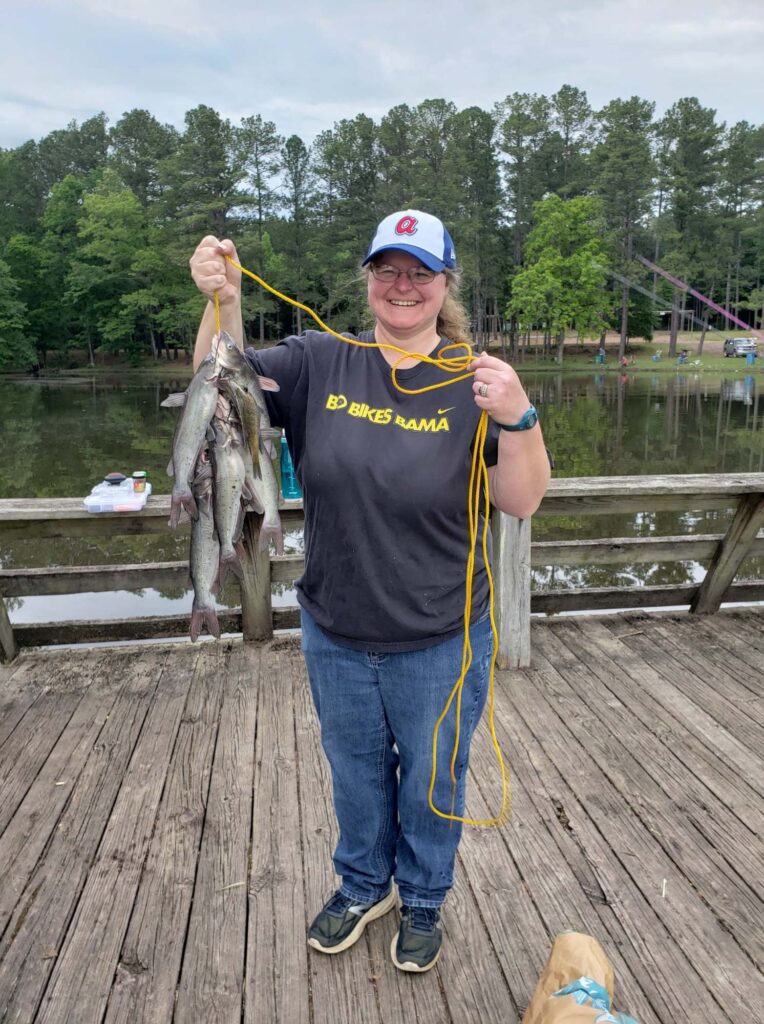
Have you ever wanted to learn the basics of fishing but didn’t know where to begin? The Alabama Department of Conservation and Natural Resources’ (ADCNR) Wildlife and Freshwater Fisheries Division (WFF) has developed a beginner fishing course just for you.
WFF’s “Go Fish, Alabama!” Program provides adults and families with little-to-no fishing experience an opportunity to fish under the guidance of a skilled fishing mentor. The program is for anyone interested in learning how to fish, socializing outdoors, putting fish on the dinner table, or simply enjoying the thrill of the catch. Each event is conducted in a safe, welcoming and constructive environment.
“The goal of the program is to highlight the benefits of spending time outdoors while learning about conservation, including the importance of purchasing a fishing license,” said Justin Grider, WFF’s R3 Coordinator (Recruitment, Retention and Reactivation). “When you purchase a hunting, fishing or Wildlife Heritage license, all of those funds are reinvested in conservation efforts throughout the state. Fisheries and wildlife management, habitat restoration, land conservation, public access to outdoor recreation, and state Conservation Enforcement Officers are just some of the ways your license dollars make Alabama one of the best places in the country to fish or hunt.”
During the events, all the necessary bait, equipment and tackle are provided. However, you will need to bring a cooler to take home your catch. The events take place at State Public Fishing Lakes, State Parks lakes, city lakes and other fishing destinations throughout the state. For select events, a $10 registration fee may apply. Online registration is required to attend.
Jennifer Cohron from Cordova, Alabama, took part in a recent Go Fish, Alabama! event at Walker County Public Fishing Lake. She recommends the program for anyone who has been around fishing for years and wants to move from being an observer to being a participant.
“The program is ideal for someone who is interested in the idea of fishing but wants to get more comfortable with it by having an instructor there to help,” Cohron said. “I’d especially recommend it to women. I have to believe there are others like myself who have an interest in fishing, but no one took the time to teach them, and now they feel a little embarrassed to admit that they don’t know how.”
In addition to learning the basics of fishing, including how to clean and prepare her catch for the dinner table, the program helped Cohron deepen her connection with a family tradition.
“My husband Zac and I have spent a lot of time fishing this year in memory of my dad, Rocky Williams, who passed away in July 2020,” Cohron said. “Usually, Zac is the one doing the fishing and I’m reading or enjoying the scenery. When I fish, he takes care of everything, just as my dad took care of everything when I was a kid. All I had to do was cast. I’ve really enjoyed being on the water this past year, but I wanted to know how to do things like tie on a hook or pick out a lure. If I had wanted to go fishing by myself, I wouldn’t have been able to before the class.”
Since attending the Go Fish, Alabama! event, Cohron and her family have kept up that tradition.
“My husband and I went out for an hour or so the afternoon I took the class, and we’ve taken our son out to Walker County Public Fishing Lake once since then,” she said. “It’s something we’ve been doing on a regular basis anyway, but we will continue for sure.”
To view the current Go Fish, Alabama! schedule or to register for an event, visit www.outdooralabama.com/GoFishAlabama.
The Alabama Department of Conservation and Natural Resources (ADCNR) promotes wise stewardship, management and enjoyment of Alabama’s natural resources through four divisions: Marine Resources, State Parks, State Lands, and Wildlife and Freshwater Fisheries. To learn more about ADCNR, visit www.outdooralabama.com.
Conservation Advisory Board Limits Rods at Sipsey Fork
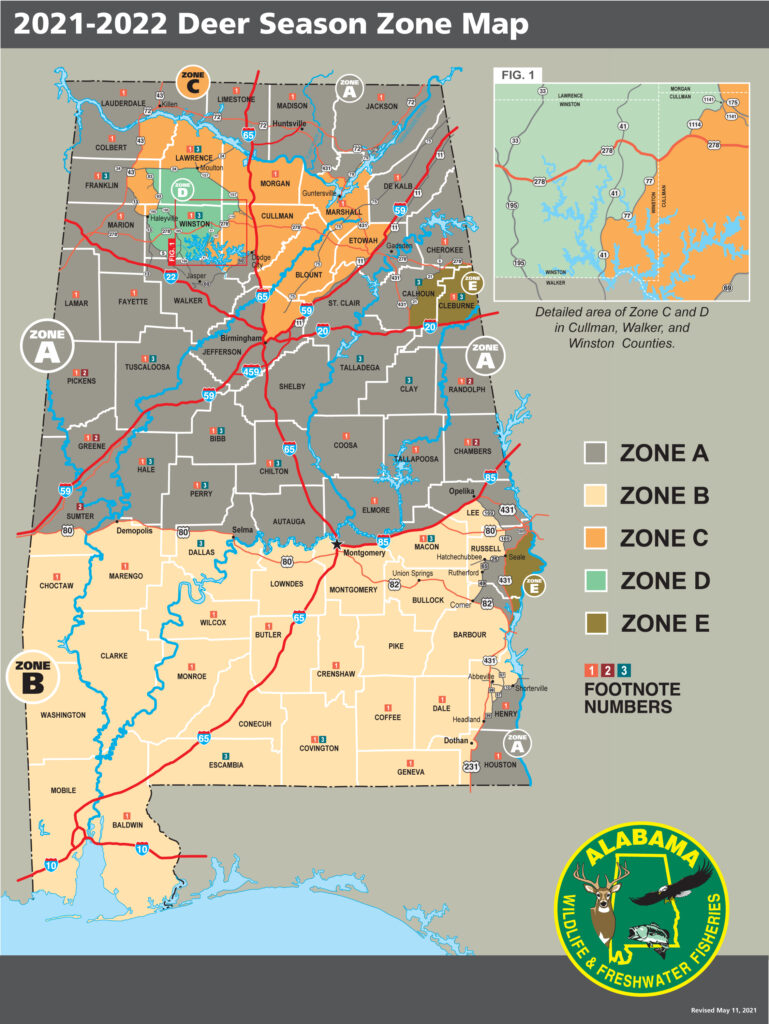
By David Rainer, Alabama Department of Conservation and Natural Resources
The Alabama Conservation Advisory Board voted to limit rainbow trout anglers to two rods per person on the Sipsey Fork of the Black Warrior River below Lewis Smith Dam and placed a portion of Colbert County on the dog deer hunting permit system at its recent meeting in Jasper.
The Sipsey Fork from Lewis Smith Dam to the confluence of the Mulberry Fork provides anglers with the state’s only year-round trout fishery. The Board voted to limit the number of rods per person to reduce any potential conflicts between anglers.
The importance of the Sipsey Fork trout fishery to the economy in the Walker County area was highlighted by Paul Kennedy, one of the people who spoke to the Board during public testimony.
“I ask (the Board) to join with us to plan for the Sipsey Fork of the Black Warrior River to become a world-class fishing destination,” said Kennedy, President of the Walker Area Community Foundation. “Two years ago, we petitioned the U.S. EPA (Environmental Protection Agency) to be one of the communities it would adopt to help us develop a recreational-based economy. We were one of only 10 such sites selected in the United States.
“We have created a 31-mile blueway. We are working on a mountain-bike trail that surrounds this school (Jasper High School). One of the key opportunities identified in the planning process was that trout fishery. We have the opportunity to turn the Sipsey Fork fishery into the crown jewel of our local outdoor economy. I’m a registered Alabama forester, and I am very aware of the potential this fishery has for us and the state of Alabama. I’m asking (the Board) to work with us to make this a better fishery and a magnet for wildlife tourism, not just for Walker County but for all of Alabama.”
The Board also voted to place the area west of Highway 43 in Colbert County on the dog deer hunting permit system. In the system, the use of dogs for hunting deer in certain regions is prohibited except for those properties with a special permit from the Alabama Department of Conservation and Natural Resources (ADCNR). Those hunting clubs on the permit system must abide by the applicable regulations or the permit will be revoked.
After the Board recommended changes to the wild turkey season at its March meeting, adjustments to the 2021-2022 turkey season were approved. The turkey season in Zone 1, which covers the bulk of the state, will be from March 25 through May 8. Zone 2, which covers northwest Alabama, will be open April 1 through May 8. The dates for Zone 3, which includes Talladega, Clay, Randolph, Clarke, Monroe and Covington counties, are November 20-28, December 11 through January 1, 2022, and March 25 through May 8, 2022.
The daily turkey bag limit is one gobbler per person per day with a season limit of four, including fall and spring seasons. Decoys are prohibited for the first 10 days of the spring season and for all of the fall seasons.
Also approved at the Jasper meeting were WFF recommendations to close bobwhite quail and fox squirrel hunting on Bankhead National Forest and to establish a special nighttime season for feral swine and coyotes.
The Alabama Legislature passed a law to allow the nighttime hunting of feral hogs and coyotes with a new license that costs $15 for residents and $51 for non-residents. The 2021 season will be from July 1 through November 1. The 2022 season will be from February 11 through November 1. A new law also allows disabled veterans to buy lifetime hunting licenses at reduced prices to make it more convenient instead of renewing yearly.
ADCNR Commissioner Chris Blankenship agreed with Jasper Mayor David O’Mary’s praise of the facilities at the Walker County Public Fishing Lake, which was annexed into the City of Jasper.
“I echo what Mayor O’Mary said about the Walker County Lake,” Commissioner Blankenship said. “It is a good example of great outdoor recreational opportunities at the same location. We have a great fishing lake with a boat ramp, an archery park and hiking trails. And there are plans to do other things to provide outdoor recreational opportunities for the citizens of Jasper and Walker County.”
Commissioner Blankenship also provided the Board with an update on ADCNR facilities and activities.
He said a tornado on March 25 went through a portion of Oak Mountain State Park but fortunately missed the campground.
“Speaking of Oak Mountain, the state park will be the venue for three events in the upcoming World Games in 2022,” Commissioner Blankenship said. “I don’t think that I knew initially how big of a deal that is that Alabama will host the World Games. I do fully appreciate they are going to hold three events at our state park. One of the areas hit by the tornado was where one of those events is to take place, so we have a real incentive to get that back to first-class before it is open to the people of the world.”
Commissioner Blankenship mentioned the setting of the red snapper season, which will start on May 28 with four-day weekends (Friday through Monday) until the quota of about 1 million pounds is met.
“Instead of projecting an ending date as we have done in the past, this year we’re using the Snapper Check system to monitor that quota every weekend and provide an update to the public on where we stand,” he said.
The Commissioner said boating and tournament fishing access will be improved with new projects at Roland Cooper State Park and Lewis Smith Lake Dam. ADCNR is partnering with the Alabama Department of Environmental Management to construct a new overnight mooring and tournament pier at Roland Cooper. The Department also partnered with Alabama Power, Union Sportsmen’s Alliance, and Bass Anglers Sportsmen’s Society to expand boat launching and parking capacity and construct a tournament weigh-in pavilion at the Smith Lake Dam boating access area.
“Public boat ramps are very important for economic impact to the communities and getting people out on the water,” Commissioner Blankenship said.
The Commissioner reported that the Alabama Legislature approved a constitutional amendment for an $80 million bond issue for Alabama State Parks that will be on the ballot in 2022.
“This will provide the funds to State Parks to do renovations, build campgrounds, build cabins and really turn our parks into first-class facilities and bring us into the 21st century,” Commissioner Blankenship said. “When a lot of those campgrounds were built, camping was a tent or a pop-up camper. Now camping is done in half-million-dollar motorhomes with three air conditioners that pull 50 or 70 amps of electricity. In order for us to accommodate those campers, we need to upgrade those facilities to keep up with the times. That bond issue will allow us to do that.”
The Alabama Legislature also approved the Alabama Reservoir Management bill that would add $5 to boat registration fees to provide funding to deal with aquatic invasive species or invasive aquatic vegetation and public water debris removal. ADCNR will manage this program for the state.
“Marine debris is a problem in coastal areas with boats that sink or debris left after hurricanes,” Commissioner Blankenship said. “There had been no funds to take care of that. This bill will provide the means to better take care of our waterways in the state. Even though it wasn’t a Department bill, I’m excited about our role in keeping our waterways safe and clean.”
Commissioner Blankenship, who sits on the federal RESTORE Council, also highlighted the funding the state has utilized from the RESTORE Act and GOMESA (Gulf of Mexico Energy Security Act) after the Deepwater Horizon oil spill in 2010. An additional $81 million in funds have recently been approved for work in Alabama.
“That brings our total to over $900 million in projects that have been funded by either Deepwater Horizon funds or by GOMESA funds that are being managed by the Department of Conservation and Natural Resources,” he said. “That $900 million is a huge investment in coastal Alabama and is really going to make a generational difference in the resiliency of our coast. I think that’s a high point for our staff.”
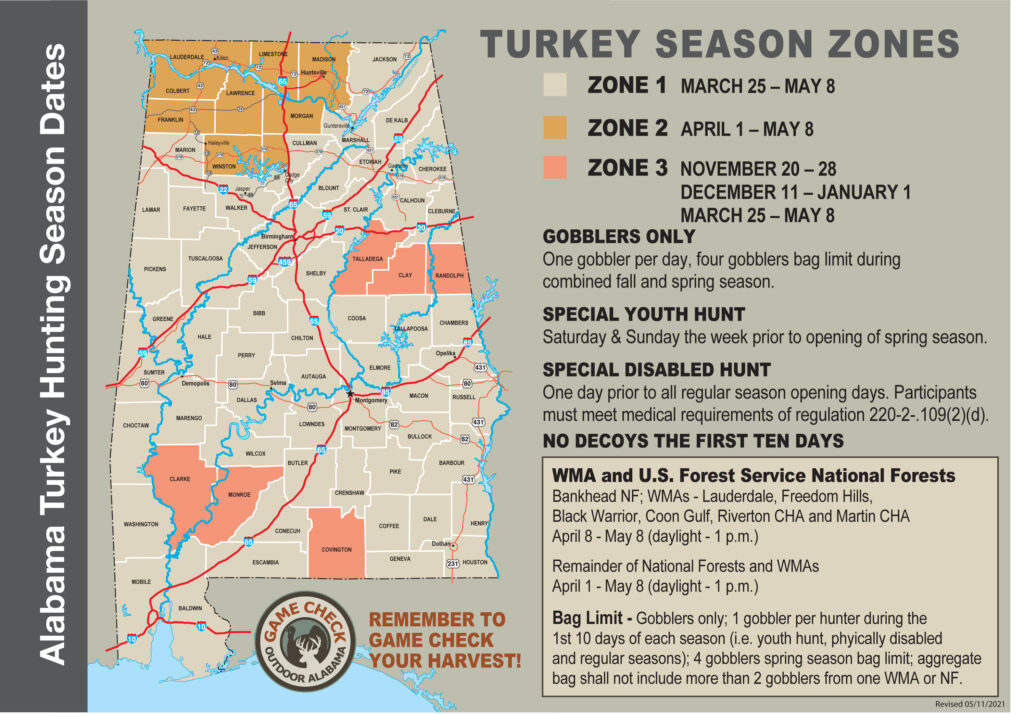
Avoiding Invasive Species in the Garden
Beauty can be deceiving, especially in the garden. Invasive species of plants are often pretty or ornamental. Whether homeowners purchase a plant or it shows up like a weed, an invasive species can quickly become a problem. Protect the garden and avoid allowing invasives to take root.
What Are Invasive Species?
According to Alabama Extension Specialist Nancy Loewenstein, invasive species are non-native plants that have escaped cultivation and become weedy problems.
While it can be hard to predict which species will become invasive, some frequently seen invasive plant characteristics include:
competitive (rapid) growth
strong reproductive pressure (produce a lot of seeds quickly)
easily spread seeds (wind, water, birds and other animals)
easily establish
To access a list of invasive plants in Alabama, read the Alabama Invasive Plant Council’s publication.
More than 50 percent of the species on the Alabama Invasive Plant Council’s invasive plant list are escaped ornamentals.
“If focusing on woody species, nearly all invasive woody species are escaped ornamentals,” Loewenstein said.
If these species end up in the garden or landscape, the plants act as weeds and can become an extensive problem.
Danger of Invasive Species
Invasives displace native species. This means the species replaces native plants, therefore displacing native animals, insects and soil microbes that depend on the native species.
“As an example, non-native plants support far fewer caterpillars and other insects that songbirds depend on to rear their young,” Loewenstein said.
They can also impact water, nutrients, fire cycles, wildlife habitats, outdoor recreation, aesthetics, natural resource management and productivity.
Removal and Control
Once an invasive plant establishes, control is time consuming and may be expensive.
The best way to stop the spread of aggressive invaders is to remove the plant entirely. For smaller species, deadheading to remove the flowers before the seeds drop is an option. Gardeners and homeowners can also pull seedlings or small plants for effective control.
Cut down larger woody species. However, the stump will likely re-sprout. Homeowners can prevent growth by treating the stump with a herbicide. Learn more about stump treatment on the Alabama Extension website.
“Herbicides can control many species, but care must be taken to avoid damaging desirable species,” Loewenstein said. “Make sure to read the herbicide labels to ensure proper use. In all cases, it’s easier to control invasive plants when there are only a few of them rather than after the infestation becomes large and daunting.”
Increase the health of ornamental plants by avoiding and removing invasive species in the garden.
More Information
For more information on how to remove invasives in the garden, visit the Alabama Extension website, www.aces.edu.
Implementing Silvopasture Systems
Landowners of all kinds share a similar goal in wanting to keep their land in the best shape possible for future generations. Agroforestry practices may help landowners meet this goal. One of the most recognized forms of agroforestry is the practice of establishing silvopasture systems. Becky Barlow, an Alabama Extension forestry and wildlife sciences specialist, explains silvopasture systems and their benefits to landowners.
What are Silvopasture Systems?
Silvopasture is an agroforestry system in which landowners manage for timber, livestock and forage on the same acre. According to Barlow, there are three goals associated with this practice:
Optimizing timber, livestock and forage components
Improving cashflow through annual income from livestock and forage
Securing long-term income from timber
“Silvopasture systems in the southeastern United States are often composed of pine trees in the overstory planted on a double or triple row set with a wide alley between them in which forage grows,” Barlow said.
Uses and Benefits
A few situations may lead landowners to implement a silvopasture system. One of these is the necessity to reduce heat stress on livestock. Planting trees in existing pasture settings can improve livestock health and reduce heat stress.
“Landowners may also have forestland on which they decide to thin trees to a silvopasture configuration,” Barlow said. “They can then manage the area for forage and eventually introduce livestock.”
Establishing silvopasture systems provides multiple benefits to landowners and the land itself. Rotational gazing improves forage production while also limiting compaction to the soil as livestock tend to spread across sites. It can serve as a way to restore ecosystems and filter runoff for improved water quality.
Reducing heat stress is the main benefit of this system to livestock. For landowners, it provides the opportunity to diversify revenue and improve cash-flow.
Livestock
According to Barlow, the choice of livestock in a silvopasture system should be based on objectives. While some people prefer cattle, others have successful systems with sheep or goats.
“Consider the timing of livestock introduction carefully,” Barlow said. “Be sure that trees are at least six feet tall so that they are not trampled.”
Ensuring that fencing and watering systems are in place is crucial to the introduction of livestock. Configure these in a way that allows for the easy rotational grazing of livestock.
More Information
For more information on the configuration and benefits of silvopasture systems, visit www.aces.edu.
New License Allows Hunting of Feral Swine, Coyotes at Night
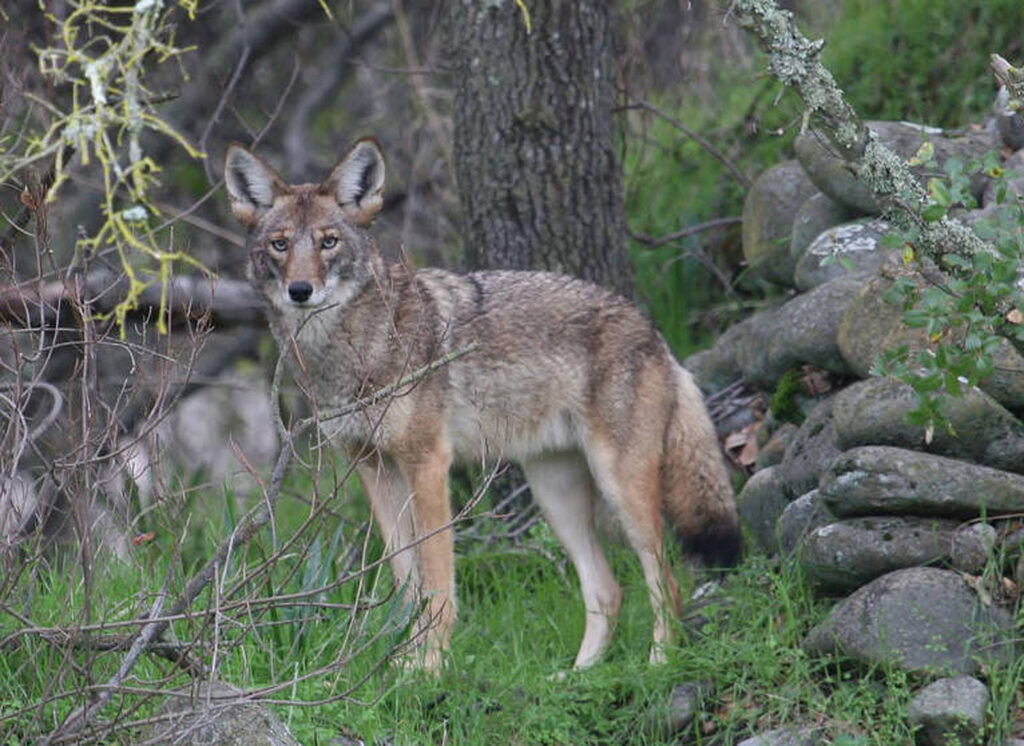
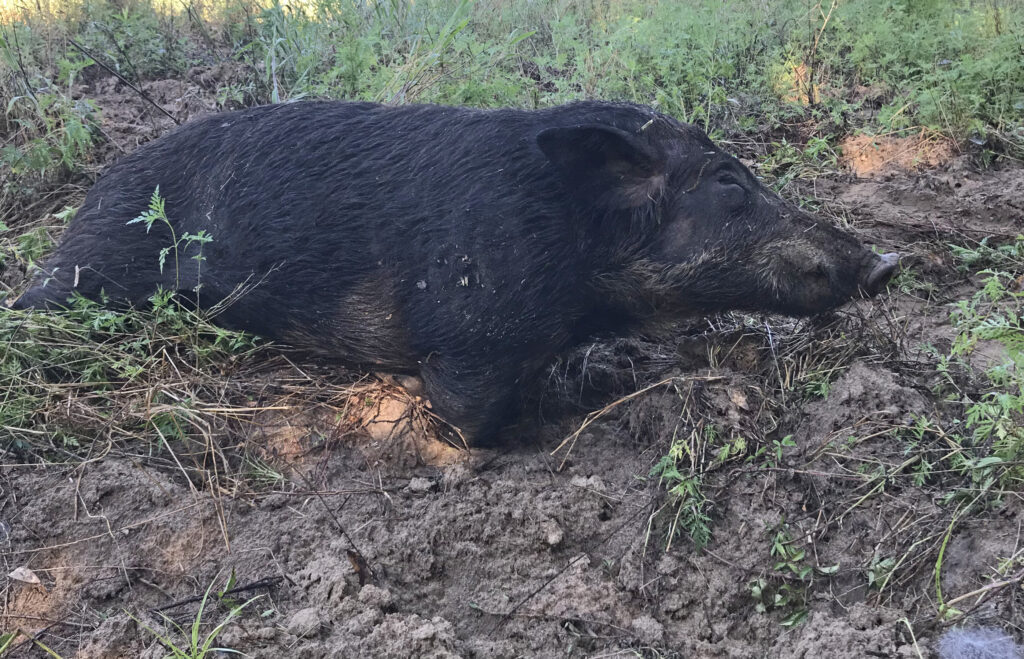
By David Rainer, Alabama Department of Conservation and Natural Resources
With Alabama Governor Kay Ivey’s signature this week, new legislation will provide hunters in Alabama with another opportunity to harvest two specific animals. The legislation allows Conservation Commissioner Chris Blankenship to establish a season for hunting feral hogs and coyotes at night without the need for a depredation permit.
When the season is finalized, Alabama residents will be able to purchase a $15 license ($51 for non-residents) to hunt feral hogs and coyotes at night.
Matt Weathers, Chief of Enforcement with the Alabama Wildlife and Freshwater Fisheries (WFF) Division, said the new permit will make it much easier on hunters and the WFF staff.
“To this point in our state, those who wish to hunt feral swine or coyotes during nighttime hours have to get a permit that is only issued to landowners,” Weathers said. “Those landowners can list friends, family or delegates on the permit to take those animals at night for crop damage, property damage or livestock damage. This is done through special permitting through the local WFF District Office.
“The new law provides for a license that allows anyone in the state to hunt feral swine and coyotes at night by buying a license to hunt on any private or leased property where they have permission to hunt. So, if you lease a hunting club, if the person or corporation you lease that property from allows you to hunt at night, you can purchase the license to hunt those animals at night on your hunting club. And you can do that without the landowner coming to us to get a permit.
“It represents a new hunting activity for the state, and it will enlist as many as 200,000 hunters in this fight against two insidious predators. So, a new hunting activity; that’s a good thing. You have more feral swine and coyotes being removed from the state; that’s a good thing, too. It’s a win-win.”
Weathers said the depredation permits will continue to be available to landowners who prefer not to buy the new license.
“However, as long as the landowner gives permission, you can buy that new license to hunt at night,” he said. “This streamlines the process and provides the ability to hunt on very short notice.”
The damage wreaked by feral hogs on agriculture and wildlife habitat is substantial throughout the South. Estimates are that feral swine cause $50 million in private property damage in Alabama annually. The damage to wildlife habitat is difficult to quantify, but feral hogs compete with the native wildlife, like white-tailed deer and wild turkeys, for food and also damage the native habitat.
Coyotes are known to be quite effective predators of whitetail fawns and can have significant impacts on populations of white-tailed deer.
Weathers said the new license is specific to these two species.
“This license does not allow you to take any other game animal at night,” he said. “It’s a good way to control predators on your hunting club or property. And this gives you the opportunity to utilize that property or hunting club during the months when it’s a little too hot to hunt during the daytime. It gives you a little more value in your hunting lease.
“All parties involved, except for the feral swine and coyotes, are going to benefit from it.”
Weathers said several regulations will be amended to allow for equipment used for hunting at night.
“Those who buy the license will be able to use equipment that has heretofore been prohibited,” he said. “During the established season, you will be able to use night vision or thermal optics. You can have lights attached to your firearms. Those technologies are emerging and make the taking of these animals a lot more efficient.”
As with any new activity, Weathers said the Division wants to emphasize safety during the nighttime pursuit of these animals.
“We want everybody who hunts feral swine and coyotes at night to think about safety,” he said. “Know where your property lines are. Know where your fellow club members are when you are hunting. Always properly identify the target before you shoot. All the commonsense practices we follow during daylight hours will need to be adhered to during nighttime hours. We need everybody to be very mindful of their actions because it is a new hunting activity in this state. With any new activity, you’ve got to think safety.”
Weathers said other states have capitalized on the appeal of hunting these animals at night.
“In a lot of states, nighttime predator hunting is very popular,” he said. “It’s big business in some areas. In Alabama, it has only been done by special permit. By doing this, it relaxes those restrictions and lets that style of hunting grow in this state. That’s a good thing. Hunting has been in decline for decades across the nation, but some of these specialty styles of hunting, nighttime predator hunting specifically, has just exploded. People are really getting into it.
“As the prices have come down on equipment like suppressors, AR-15-style hunting rifles, night vision and thermal optics, these things are becoming more common and are becoming more accepted in hunting. This is just an example of us trying to adjust regulation and law to account for the evolving manner in which Alabamians hunt. The feral swine population and the coyote population are certainly increasing in Alabama. These are animals whose populations can stand more hunters out there pursuing them.”
Chuck Sykes, WFF Director, said the 2021 season for hunting feral swine and coyotes at night will likely start on July 1 and run until November 1. In 2022 and beyond, Sykes said the nighttime season will likely start on February 11 and run until November 1.
“The way the bill was drafted, it gives the Commissioner the ability to set the season so we can evaluate and make sure this goes well,” Sykes said. “We can amend the dates down the road if it makes it better. This time frame is when most of the depredation permits are issued.”
Sykes is not sure how the hunting public will respond to the new license, but he wouldn’t be surprised to see it become very popular, like the depredation permits.
“We see this as an opportunity to streamline the process and make it easier to manage for us and the landowner,” he said. “This also opens the possibilities for others. Say you lease 1,000 acres from a timber company. You had to get the timber company to apply for the depredation permit and then put you on it. Now, if you have the hunting lease and the timber company is okay with it, you don’t have to bother them. You just go online and get a license.
“If you have college kids who come home for the weekend. That’s one thing we ran into. Farmers had kids come home from Auburn and wanted to take their buddies hog hunting. They had to call our office and amend their permit. Now all they have to do is get online, get the license and say, ‘Y’all have at it.’”
Sykes has no expectations the new license will have a significant impact on the feral swine population.
“We don’t think this is the silver bullet,” he said. “We’re not saying going hunting at night is going to eliminate the hog problem, because it’s not. What we are doing is giving people more opportunity to remove more pigs and coyotes if they choose to do so. It is another tool to reduce the number of predators.
“Predator control is a big buzzword right now. We’re giving you the opportunity to do what you think is best to manage your property.”
Two Rare Plant Species Discovered at Oak Mountain State Park
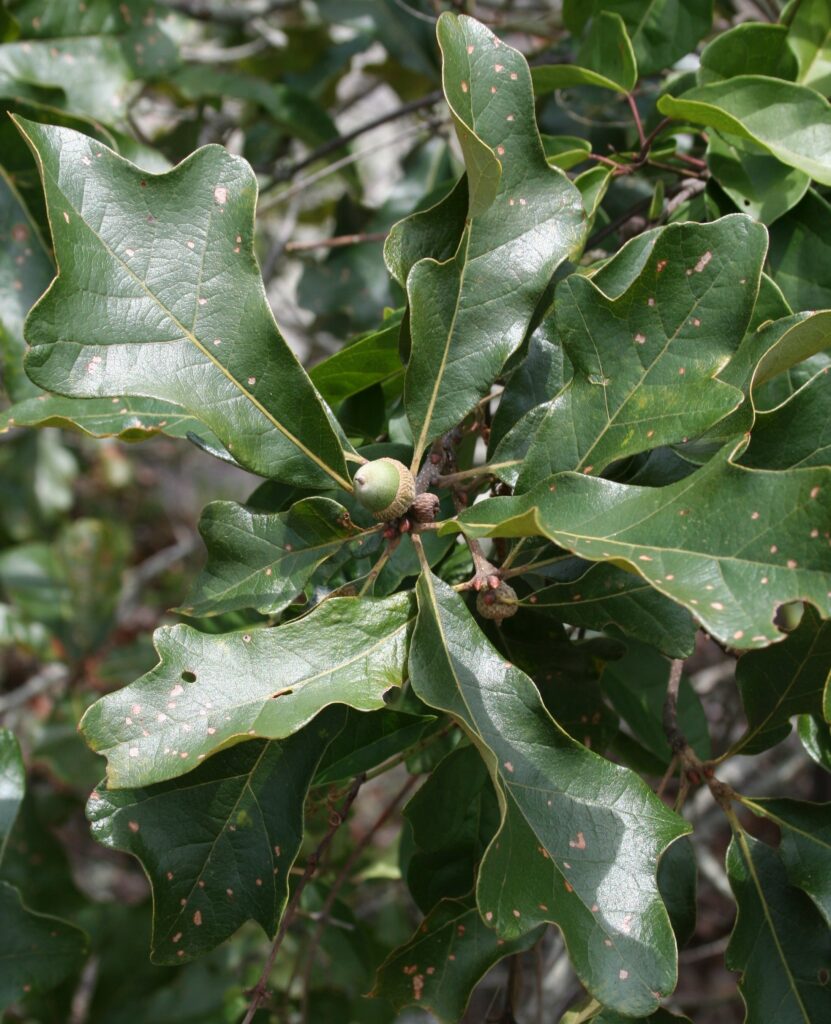
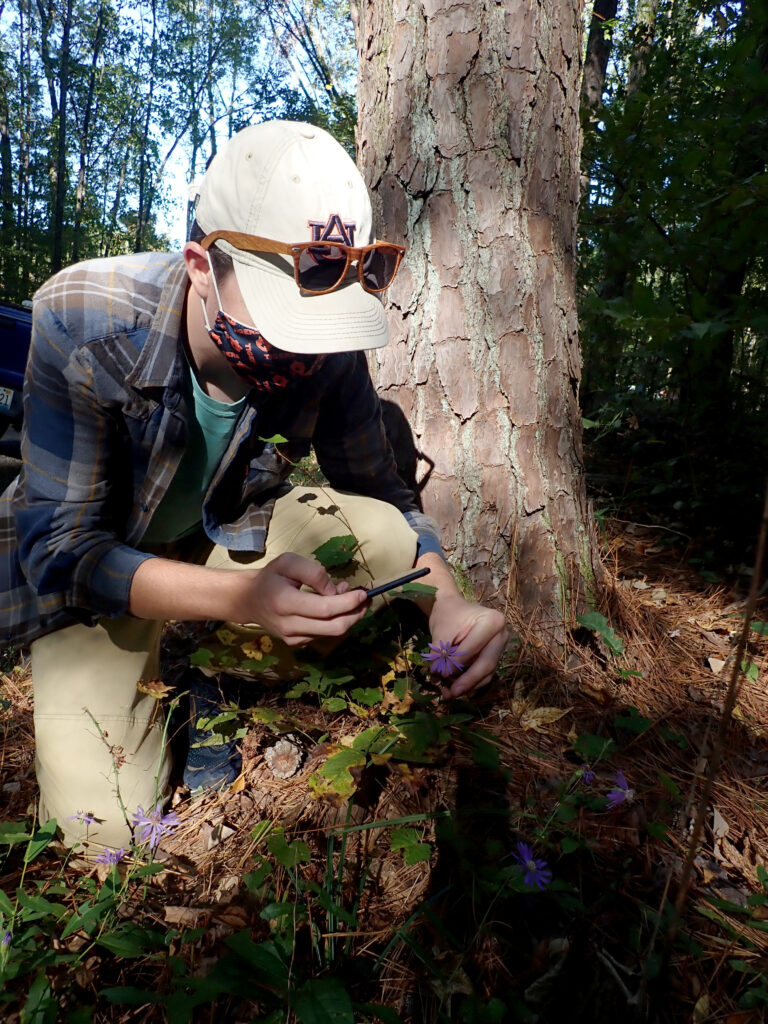
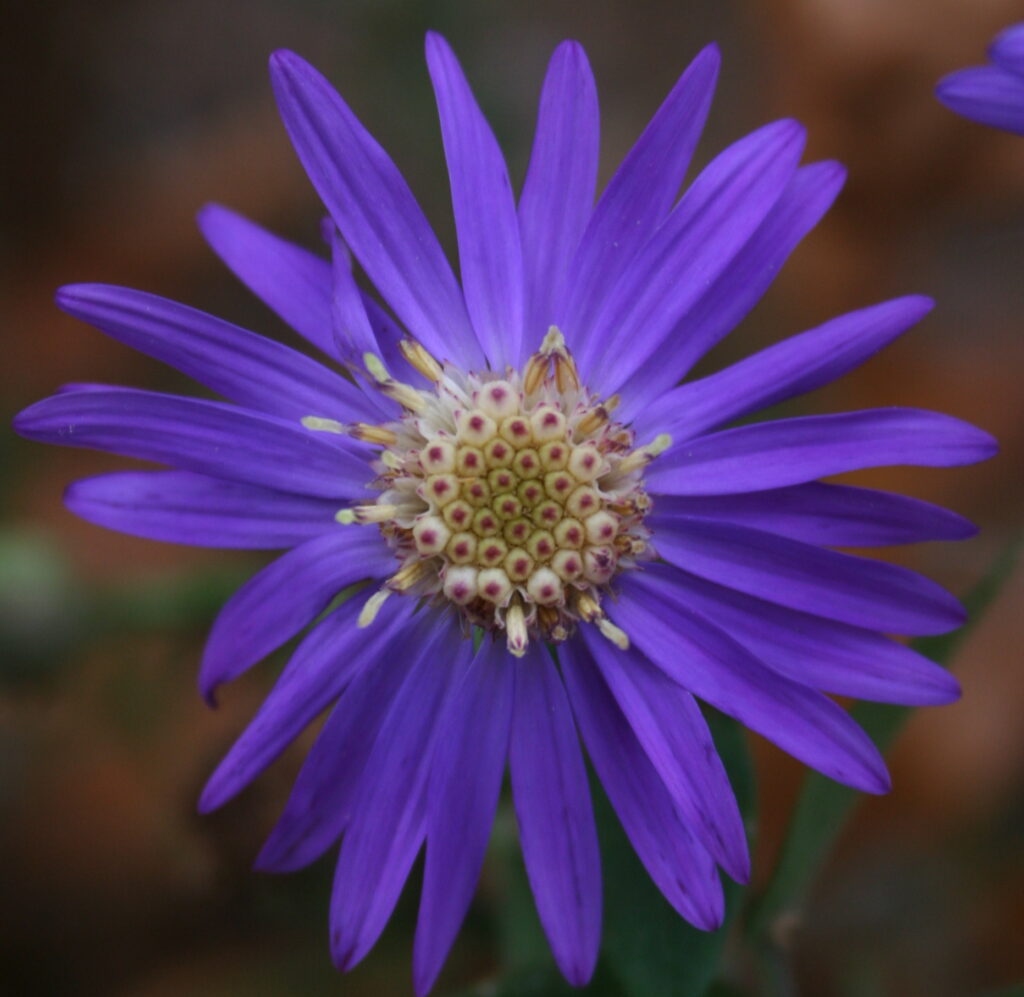
By Kenny Johnson
Alabama Department of Conservation and Natural Resources
When Noah Yawn headed out for Oak Mountain State Park in October 2020, he was planning to take part in a survey for a tree found only in Alabama. What he didn’t expect was to also stumble upon a sizable population of another rare plant species – the Georgia Aster.
The survey was part of an ongoing effort of the Alabama Plant Conservation Alliance (APCA) to better understand the range and natural history of the Alabama Sandstone Oak, a tree only found in six north-central Alabama counties.
Yawn, an undergraduate student assistant in conservation and botany studies at Auburn University, was looking for the rare oak when he first spotted the asters through what he calls “drive-by botany.”
“Driving through the park at 25 miles per hour with my windows down is how I unintentionally discovered the park’s roadside populations of the aster,” Yawn said. “I estimate there are approximately 500-1,000 individual flowering stems at the documented roadside sites. These sites are scattered over 1 to 2 miles along Terrace Drive.”
Often considered the Southeast’s largest, prettiest and most purple aster species, this distinctive plant can grow to more than 3 feet tall and features a large flower head encircled with deep purple to lavender petals. Once found in woodlands and Piedmont prairies throughout the Southeast, the Georgia Aster is currently only found in a few counties in Alabama, Georgia, South Carolina and North Carolina.
In recent years, a multi-state/multi-organization agreement was developed to provide a framework for the conservation and management of Georgia Aster throughout its range. The goal of the agreement is to conserve and improve current populations and keep the aster from being federally listed as an endangered species.
“Even the smallest preserved natural areas, including roadsides, can protect extremely valuable and imperiled species,” Yawn said. “The Georgia Aster at Oak Mountain State Park represents some of the only populations in Alabama that are protected on state lands, making this all the more exciting.”
Located just south of Birmingham, Oak Mountain is Alabama’s largest state park at 9,940 acres. The park’s size and the varied nature of its Ridge and Valley habitat is partly responsible for the high level of biodiversity found at Oak Mountain.
Chris Blankenship, Commissioner of the Alabama Department of Conservation and Natural Resources (ADCNR), said these discoveries highlight the importance of public lands, including our State Parks, to the conservation of rare plant and animal species.
“Alabama’s State Parks, Forever Wild tracts, Wildlife Management Areas and other state lands play a vital role in conserving important habitat for some plants and animals found nowhere else in the world,” Commissioner Blankenship said. “These locations ensure the public can continue to enjoy the rich diversity of Alabama’s landscape for generations to come.”
While finding the Georgia Aster at Oak Mountain was a pleasant surprise, the main focus of the survey was to document the Alabama Sandstone Oak within the park. Like the Georgia Aster, this oak is very vulnerable because of its small population numbers and its narrow habitat preference.
The Alabama Sandstone Oak is a very long-lived and slow-growing plant. The trees discovered at Oak Mountain State Park could be older than the nearby city of Birmingham itself.
Core samples taken from Alabama Sandstone Oaks found at the Forever Wild Hinds Road Outcrop in Etowah County indicated an average age of less than 100 years for the aboveground tree stems. As the tree grows, its below-ground stems creep along, spreading under the surface of the soil, creating clones of its aboveground stems. Since the root system is the oldest part of the tree, age estimates of the aboveground stems may not accurately reflect the actual age of the individual trees.
In addition to documenting the existence of the rare oaks in the state park, the survey team also found a 90-foot by 60-foot collection of stems that appears to be a single clonal individual tree. Clonal growth usually occurs at a rate of about an inch or two per year for this species. If this collection of trees is a single individual, it could have taken centuries for it to grow to this enormous size in a low-nutrient environment like the rocky ridges of Oak Mountain.
Patrick Thompson, Curator of the Auburn University Davis Arboretum and APCA Coordinator, was first made aware of the trees at Oak Mountain by David Frings, former director of the Oak Mountain Interpretive Center.
“The survey project was an effort to document the extent of the Alabama Sandstone Oak population at the park and to collect acorns,” Thompson said. “It was led by Tracy Cook from the Huntsville Botanical Garden and funded by the U.S. Forest Service and the Association of the Public Gardens of America. This survey is part of an ongoing effort to increase knowledge of the species range and natural history, and to secure the species in the wild and in safeguarding collections nationwide.”
The acorns collected at Oak Mountain State Park were sent to the Huntsville Botanical Garden, Auburn University’s Davis Arboretum, the National Arboretum, the Morton Arboretum in Illinois, the Chicago Botanic Garden and the Atlanta Botanical Garden. They will be stored in those locations and potentially used to grow more trees in an effort to conserve the species.
For those hoping to catch a glimpse of the Georgia Asters at Oak Mountain State Park, flowering occurs October through mid-November. Look for the relatively tall green stems topped with deep purple and lavender petals along Terrace Drive.
For directions to Oak Mountain State Park, visit www.alapark.com/parks/oak-mountain-state-park.
For more information about the Alabama Sandstone Oak or Georgia Aster, contact Patrick Thompson at the Auburn University Davis Arboretum by calling (334) 332-0283.
The Alabama Department of Conservation and Natural Resources promotes wise stewardship, management and enjoyment of Alabama’s natural resources through four divisions: Marine Resources, State Parks, State Lands, and Wildlife and Freshwater Fisheries. To learn more about ADCNR visit www.outdooralabama.com.
Purchasing Seeds from Online “Yard Sale” Platforms
By Mary Leigh Oliver
AUBURN UNIVERSITY, Ala. – When purchasing seeds in the store, there is a general trust that what is on the packet is what will grow. However, does that same trust remain when purchasing seeds online? Various sellers offer almost any seed the heart desires on online “yard sale” websites. The question remains: can buyers trust these online “yard sale” seed purchases?
According to Alabama Extension horticulture crops specialist Joe Kemble and regional agent Olivia Fuller, purchasing from these online “yard sale” platforms is a buyer beware situation.
“Unless stated, there is likely no guarantee of seed quality, germination, purity, etc.,” Kemble said.
With federal and state seed laws, there is little guarantee that online “yard sale” seed sales are regulated.
According to Fuller, although seed purchases from these platforms should be made with caution, many buyers have great experiences buying from these platforms.
Why Sellers Choose Online Platforms
If there are risks in relation to purchasing seeds online, why do sellers continue to choose these “yard sale” platforms?
According to Fuller, other online seed sellers often form a type of monopoly. This further encourages seed distributors to sell using online “yard sales.”
“I feel that purchasing from online ‘yard sale’ platforms pose the same risks as buying from any seed distributor,” Fuller said. “Most of the sellers have large scale farms and use online yard sales simply as a platform to sell.”
Finding a Reputable Seller
When purchasing seed from one of these online platforms, it is essential to find a reputable seller. One of the first steps is to assess their ratings and reviews.
“Pay close attention to ratings and reviews,” Fuller said. “Most sellers have a few hundred or one thousand five-star ratings.”
Next, try to find a seller that follows American Seed Trade Association (ASTA) guidelines. According to Kemble, the ASTA is the leading seed trade association in the United States.
“If you are looking for a reputable seed company, look for those that are members of the ASTA,” Kemble said.
Also, in the United States, every state has its own seed label law. These laws state what needs to be on a seed packet. This is another way to ensure that purchases from the seller are legitimate. To view the label laws, visit the ASTA website.
Lastly, if the seller is in Alabama, check for an Agriculture Compliance permit. The Agriculture Compliance division in Alabama conducts seed inspections and issues permits to dealers. Find more about the permits from the Agriculture Compliance.
Sending Back Seed
In the case that the seed comes and does not meet expectations, it is often returnable.
“Most shops will offer a return policy that includes returning for any reason,” Fuller said.
Make sure to shop smart when it comes to garden seed.
More Information
For more information on purchasing seeds for gardening, visit the Alabama Extension website, www.aces.edu.
USDA Forest Service opens recreation sites in Alabama: Go outdoors and take Eva Longleaf with you!

The USDA Forest Service announces the opening of the 2021 recreation season for Alabama’s four national forests – Bankhead, Conecuh, Talladega, and Tuskegee. There’s a wide range of outdoor activities on public lands, and a new virtual tour guide named Eva Longleaf is available for download to help visitors get ready for the outdoors.
Forest Service officials encourage visitors to download the free mobile app “Alabama Great Escapes” that features a virtual tour guide, Avenza maps, road and site closure alerts, and other information to plan trips. The app introduces visitors to Eva Longleaf, a conversational tour guide providing recreation information, national forest history, and what is happening in the natural world.
“We are excited to provide a new, digital tool to assist visitors with planning trips to Alabama’s national forests,” said Forest Supervisor Cherie Hamilton. U.S. Forest Service managers anticipate a busy season as recreation sites receive more visitors. “After a long, wet winter, people like to get out and enjoy the outdoors again,” said Hamilton. “We’ve been working hard to get our roads, trails, and campgrounds ready for the upcoming season. While we understand there may be some excitement from the public to return to beloved national forests, please continue to follow local, state, and federal guidelines on staying safe.”
In addition to the “Alabama Great Escapes” mobile app, Forest Service recreation specialists are available to answer questions. Maps, passes, discount fees, safety tips, know before you go alerts, and recreation information are available at www.fs.usda.gov/alabama. Contact the following Forest Service offices: Bankhead District (205) 471-7724; Conecuh District (334) 708-0595; Shoal Creek District (256) 463-2272; Talladega District (256) 369-5882; Oakmulgee District (205) 926-9765; Tuskegee District (334) 439-0244 and the Supervisor’s Office at (334) 832-4470.
USDA Forest Service, National Forests in Alabama: National Forests are working forests where you can expect to see controlled burns, tree thinning, tree planting and other management activities throughout the year. The projects are focused on maintaining the health and resilience of national forests while at the same time providing products and services to the public. www.fs.usda.gov/alabama
WFF Enforcement Section Teaches Handgun Basics Classes
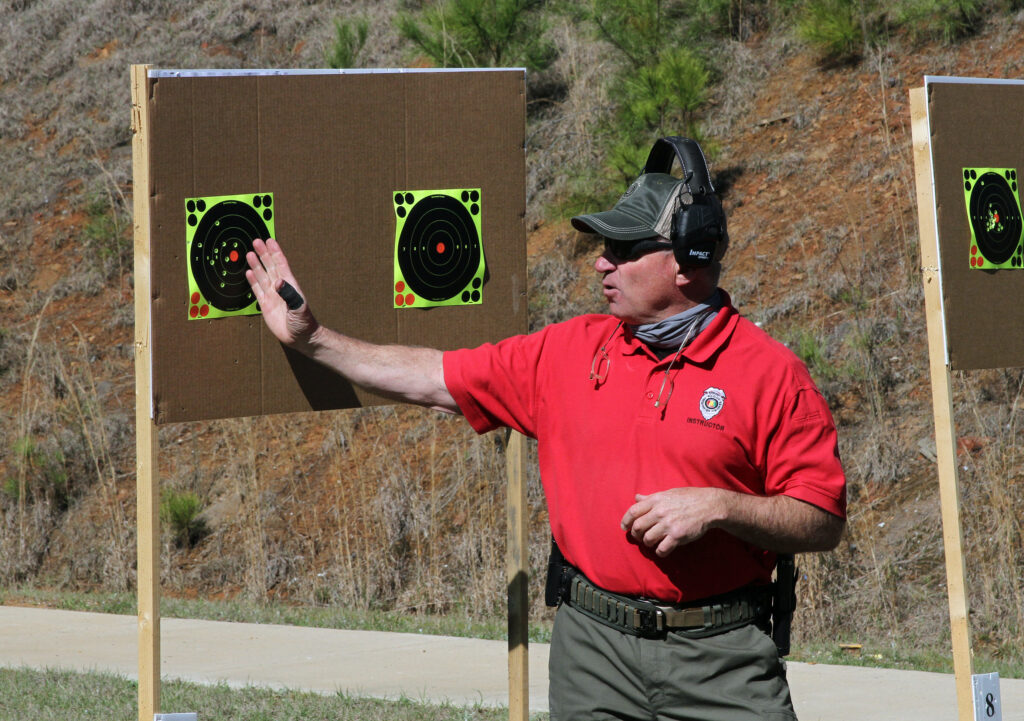
y DAVID RAINER
Alabama Department of Conservation and Natural Resources
As firearms sales continue to set records, the Alabama Wildlife and Freshwater Fisheries (WFF) Division’s Law Enforcement Section recognized a demand in basic training for handgun safety and use. Eight million new gun owners were created in 2020 alone. The COVID-19 pandemic forced many to abandon their usual indoor recreations and take up new ones outdoors. For many that was shooting.
This past weekend, officers of the Law Enforcement Section and its Hunter Education Unit held the first of five “Introduction to Handguns” courses scheduled this spring.
Two sessions were held at the Cahaba River Wildlife Management Area (WMA) Shooting Range in Shelby County with 10 students at each session. The WFF staff covered the basics of firearms safety and marksmanship with new shooters from the area.
“It’s no secret that there has been a surge in firearms sales in the past year,” said Marisa Futral, WFF’s Hunter Education Coordinator, who was joined by Stuart Goldsby, Regional Hunter Education Coordinator in north Alabama. “My office has been getting a lot of phone calls from people who want to know if there are any classes available for new shooters. There’s a huge demand from people who want firearms instruction. We are trying to fill that need by starting with handgun classes and possibly adding long gun classes in the future.
“The classes are open to anybody who would like to come, but we are kind of targeting the new users. This could be people who are thinking about purchasing a firearm, or they have already purchased one and need to learn how to use it. They might be timid about going to a shooting range by themselves.”
The next “Introduction to Handguns” classes will be held at the Swan Creek WMA Shooting Range in Limestone County on April 2 and April 17, 2021. The next class at the Cahaba range on April 10 is already booked up, but don’t hesitate to get on the waiting list as future classes at this location are in the works. The last currently scheduled class is at the Etowah WMA Shooting Range near Gadsden on April 24. Contact Futral by phone at 334-242-3620 or email [email protected] for more information.
Lead firearms instructor Scott Kellenberger, one of only a handful of Alabama Peace Officers Standards and Training Commission certified master firearms instructors in Alabama, explained to the students the basics of firearms safety – always treat all firearms as if they are loaded; never allow the muzzle of the firearms to cover anything you are not willing to destroy; always keep your trigger finger off the trigger until your sights are on the target and you have made the conscious decision to fire; and always be sure of your target and what is beyond.
After Kellenberger’s safety instructions, the students were each provided with a personal instructor to learn handgun basics with a Ruger .22 caliber semi-automatic handgun. All necessary firearms, ammunition and safety equipment were provided by WFF for the new shooters.
The students learned how to load a magazine and insert it the magazine into the handgun and how to manipulate the safety and slide release. Instructors ensured that the students followed all safety procedures and offered tips on the proper grip for best control of the firearm and accuracy. Students also learned how to clear their firearms after a misfire or a failure-to-eject occurred.
“We try to introduce novice shooters to our (WFF) ranges,” Kellenberger said. “If they are interested, we get them involved in shooting sports. Obviously, we start with firearms safety. Then we talk about range safety. We discuss at length what range etiquette means. A lot of people have never shot on a public range before. They learn how to call the range ‘hot’ or ‘cold’ and how to keep everything safe on the range. For many new shooters, the simple fear of not knowing what is appropriate on one of our ranges can be a barrier to them. After this class, they all completely understand how to use our ranges and what they need to have in reference to a license.
“Then we move on to stance, grip and trigger control. We go over ammunition selection, dry-firing as a practice technique and then live fire.”
A set of paper targets was set up at 6 yards for students to shoot during the first session. After instruction and practice, the students were able to “ping” metal targets at 25 yards.
Kellenberger said .22-caliber handguns, either semi-automatic or revolver, are excellent firearms for the newcomers to learn the basics. Many of the students get a great deal of knowledge simply from getting the chance to shoot different styles of handguns. Often they go home after a class and purchase the exact handgun that they enjoyed shooting on the range.
“The .22s are great starter guns,” he said. “They can learn all the basics and do it inexpensively. For people who are a little bit afraid of firearms, there is not a lot of recoil and not a loud report. They’re easy to shoot, and the ammo is less expensive. That means a lot right now with ammo being sold in never before seen amounts.
“A progression a lot of people take is to start with a .22 and then move up to the firearm they are comfortable shooting or carrying if they decide to.”
Kellenberger said he can see changes in the students’ confidence from the start of the class to the end.
“With the volume of shooting and close instruction, they are a lot more comfortable with firearms and shooting than when they got here,” he said. “They were all smiling when they left, which is a good thing.”
To use WFF Public Shooting Ranges, Alabama residents are required to have a valid hunting, wildlife heritage, fishing, or WMA license for all range users between the ages of 16-64. For nonresidents, a valid WMA license or non-resident hunting license is required for all range users age 16 or older.
“All of our shooters today purchased the Wildlife Heritage License before participating,” Kellenberger said. “I explained that this $11 license allows them to use our public shooting ranges and our public archery parks for a year. It allows us (WFF) to provide these services to the citizens of Alabama. WFF does not receive any money from the state’s General Fund, and a large portion of the funding that pays for programs like this comes directly from license sales and matching federal funds.”
As Kellenberger said before, it was all smiles when the class ended, and the participants were happy with their firearms education for the day.
“I think it was an excellent experience,” said Jacqueline Brooks of Montgomery, who was accompanied by her daughter, Jayla. “It gives them a chance to teach you one-on-one and make corrections. They show you the proper stance and how to hold your gun, so it was very exciting. I enjoyed learning how to clear a misfire. Sometimes people’s guns do misfire, and they don’t know what to do. I really enjoyed learning that.”
Jamie Ligon of Hoover said she decided to take the class for two reasons, the COVID-19 restrictions that caused her to seek solace on hikes through the woods and the fact her dog probably would not protect her if a situation occurred.
“Since the virus came around, about the only exercise opportunities are outside,” Ligon said. “I’ve gotten very interested in hiking with my dog. I decided if I encountered a snake I might want to have a way to protect myself. My friend asked me if I was afraid walking around. She knows my dog and said, ‘I know Boris is not going to do anything but kiss them to death.’
“I was afraid of handguns and after the class not nearly as much. The instructors were all very knowledgeable. I’m glad I did this. I’m going to recommend this to a friend of mine.”
Patti Grace of Vestavia Hills said she loves camping and decided she needed to learn about firearms for her protection.
“I solo-camp,” Grace said. “Sometimes I boondock, which means I camp out in the boonies without electricity and maybe not much safety. I thought it would be good to know how to use a firearm safely. I’ve never shot anything other than a BB gun when I was 8 years old. This was amazing. My instructor, Stuart, was awesome.
“I’m kind of addicted to it now. I’m going to have to get all kinds of guns. I think this is so good for the public to have a place to come. The experience was awesome.”
Get Moving: 100 Alabama Miles Challenge Kick off 2021 Season
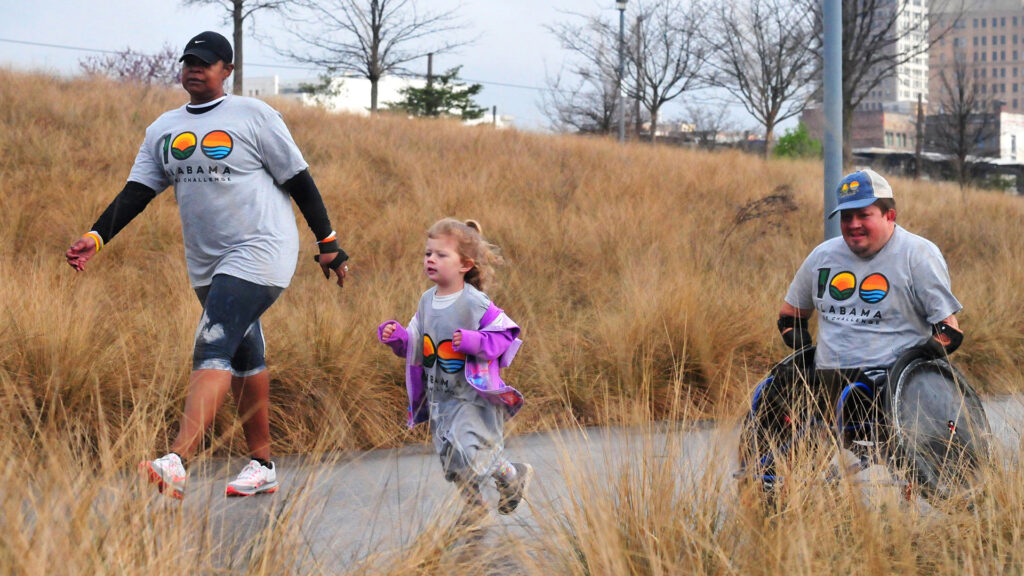
The University of Alabama Center for Economic Development and its partners will kick off the 2021 season of the 100 Alabama Miles Challenge on April 24.
The 100 Alabama Miles Challenge is a statewide public program designed to inspire all Alabamians to be active, explore, and connect with others by getting 100 miles of physical activity each year. While participants can walk, run, hike, bike, swim, paddle, ride, or roll to their 100-mile goal anywhere, the program encourages residents to visit Alabama state parks, nature preserves and rivers with friends and family.
The kickoff coincides with the Rails-to-Trails Conservancy’s Celebrate Trails Day, an annual spring celebration of the nation’s trails and trail systems.
“Partnering with Celebrate Trails Day is a natural fit for the 100 Alabama Miles Challenge because both programs seek to heighten public awareness and use of our trail resources,” said Brian Rushing, coordinator for the 100 Alabama Miles Challenge and director of economic development initiatives at UA. “Whether it’s in our state parks, national forests, local parks and greenways, or our beautiful blueways, anyone looking for a trail can find one to suit their needs and interests at 100alabamamiles.org.”
Participants have logged a total of more than 146,000 miles since the program’s inception in 2018.
While the pandemic prevents the usual gatherings to celebrate the annual season kickoff, organizers encourage people to register at 100alabamamiles.org, visit a trail on their own and share their experiences via social media using the hashtag #100ALMiles. As participants log their miles on the website, they earn electronic badges for milestones they reach and places they visit. They can even create teams and compete with others.
Organizers encourage participants to also register for Celebrate Trails Day at www.railstotrails.org/experience-trails/celebrate-trails/, where the first 150 to RSVP will earn great prizes from program sponsors.
Partners in developing and sustaining the program include the Alabama Trails Commission, Alabama Trails Foundation, Blue Cross and Blue Shield of Alabama, Lakeshore Foundation, Governor’s Commission on Physical Fitness and Sports, Jefferson County Department of Health, AARP, Alabama Department of Public Health and the Alabama Obesity Task Force.
The University of Alabama Center for Economic Development was founded in 1987. It serves as a gateway to technical assistance resources at the University. Through the utilization of professional staff and customized project teams, UACED assists communities, agencies and organizations to take an asset-based planning approach to economic development opportunities. One of UACED’s goals is to address the economic development needs of rural and urban communities throughout Alabama.
Hawley Wants to Leave Turkey Hunting Legacy
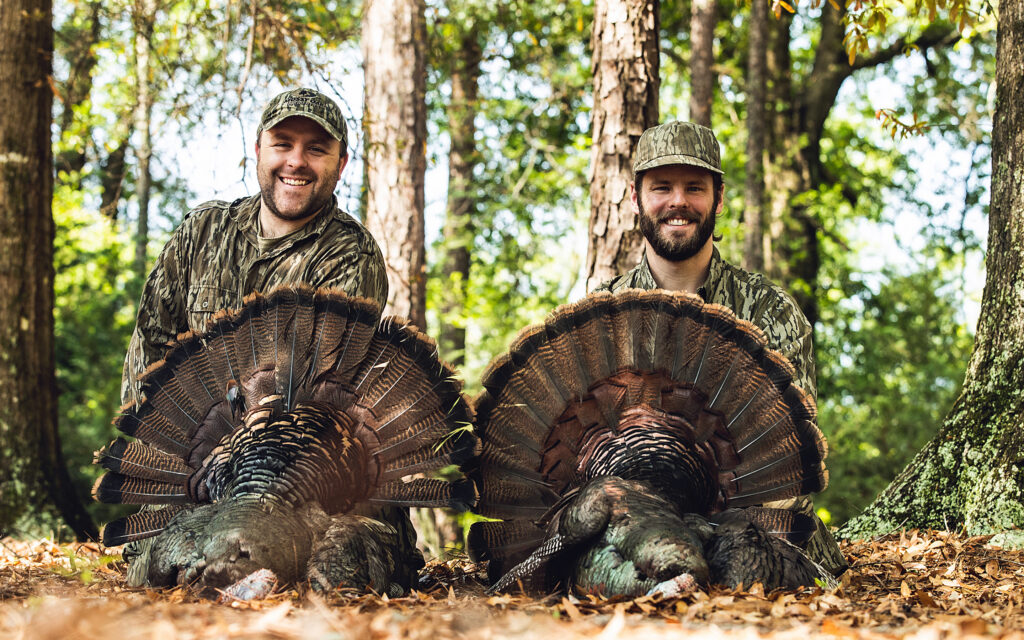
By David Rainer, Alabama Department of Conservation and Natural Resources
At the recent Alabama Conservation Advisory Board meeting in Montgomery, one of the people who took advantage of the opportunity to address the Board was David Hawley of Livingston, Alabama. At that March 6 meeting, the Board approved a motion to open the 2022 turkey season on March 25 with a four-bird season bag limit. Decoys would be prohibited the first 10 days of the season. The season length will remain 45 days in most of the state.
Hawley decided to speak at the meeting because of all the feedback he has received from the turkey hunting community as well as what he has witnessed in west Alabama. Hawley works for Mossy Oak Properties and produces the Wild Turkey Report (www.wildturkeyreport.com).
Hawley’s talk was about his love for turkey hunting and his willingness to do whatever it takes to ensure the Eastern wild turkey continues to thrive in our state.
“I wanted to express my concerns with turkey populations,” he said. “I felt we, as a state, needed to make some changes that will benefit the long-term health of the turkey population. Time will tell whether the changes have an impact, but I do believe the later start date will give hens more time to breed. I believe the regulation regarding the decoys will protect some of the dominant turkeys during that first 10 days of the season.
“Reducing the bag limit may have some effect, but my main sentiment is that, in addition to the regulations, we as turkey hunters, landowners and conservationists need to understand our role of doing a better job of managing our habitat through prescribed fires, managing our predator populations and also being cognizant of our harvest decisions.”
Hawley killed his first turkey when he was 9, hunting with dad (Chris) in the Tombigbee River swamp. “That was the year I got hooked,” Hawley said of turkey hunting and turkey calling.
He became so proficient with a turkey call that he started entering contests and doing especially well, so well that he ended up in New York City on the David Letterman Show twice. Hawley had finished in the top five at the National Wild Turkey Federation (NWTF) Grand Nationals in the junior division both years and was invited on the show. He did a fly-down cackle one show and a fighting purr on the other.
His desire for competition calling waned later in his teenage years, but his passion for turkey hunting did not.
With the 2021 spring turkey season opening on March 20, Hawley is definitely in tune with what is happening in the turkey woods in west Alabama.
“As of today (March 10), turkeys are right on track in their breeding cycle,” he said. “I’ve heard some turkeys. They appear to be grouped up, as they should be. I think it’s right on schedule. Due to the habitat work and predator control efforts we have implemented on our farm, we had a decent hatch a couple of years ago. While our properties’ turkey numbers are off long-term, we should have a relatively stable amount of turkeys compared to the past several years, especially a few more 2-year-old gobblers. I saw a fair amount of jakes last year. But my concern is the inconsistencies I hear from throughout the state and when looking back at my hunting experiences the past five years.”
Of course, weather plays a significant role in turkey hunting and turkey production. A cold, wet spring reduces the chances of nesting success and poult survival, and the gobblers tend to be less vocal. Hopefully, the weather forecast for this spring is spot on.
“Based on the long-range forecast, it should be fairly warm and fairly dry, which is a great thing from a turkey standpoint,” Hawley said. “We need a dry spring. It will help with poult recruitment.”
Hawley considers patience a virtue all through the season but especially early in the season.
“I’m looking for the opportunity to strike at the right time,” he said. “If I feel like a turkey is really henned up, I’m willing to wait a few days before I go back in and try him. Early season can have some tough hunting. We are stepping into the woods and assuming the role of a hen in the midst of dozens of real and receptive hens. This I why I don’t press the dominant gobbler and his harem as much as some do. I think my chances are greater in finding a subordinate gobbler or having one leave the flock.
“Several years ago, I roosted a big group of turkeys in a large agricultural field. The flock pitched down 200 yards away, and two gobblers strutted around the dozen or so hens. But one did not. Every time I yelped the non-strutter would look up from his feeding. He finally broke away from the flock and came in.”
Hawley looks at the season as a whole as a marathon not a sprint, and he tries to allow the turkeys to go through their natural progression through the season, adjusting his hunting techniques to the prevailing conditions.
“Now I’m going to be in the same vicinity and calling to them in case a sub-dominant gobbler decides to break off from the flock,” he said. “But I’m not going to put a lot of pressure on them early when I know they’re in these big groups.
“The woods are wide open early in the season. It’s really easy to bump turkeys. I try to lay back a little bit. But if you’re hunting a lease or public land, especially on just weekends, you may have to do it a lot differently than I am.”
Early in the season, Hawley’s calling tactics are also different. His focus is on the dominant hen.
“I try to get a boss hen fired up,” he said. “I’m going to try to mimic her the best I can with some excited calling, some flock talk and maybe some kee-kees (lost calls). I’m trying to play off the hen’s dominant nature to control that flock.
“If I hear jakes in there, I’m going to try to start calking (yelping) like a jake. It’s good to have jakes in the flock because of the gobblers’ competitive nature.”
As the season progresses more hens are bred and start to nest. The groups will split up. When that happens, the likelihood of encountering a lone gobbler is much better.
“That’s when I get really aggressive and try to cover a lot of ground,” Hawley said. “Basically, I’m trying to find the hottest turkey that I can. If it’s bad weather, I’m not going to push it unless he’s gobbling good.
“If it’s that window with good weather, I’m going to be aggressive. That last week in March is what I call kamikaze week, especially if you have a lot of 2-year-olds running together. They are not in the main group and have already bred a good many hens. That’s when you can get aggressive and strike turkeys up in the day.”
The 2021 turkey season runs March 20 through May 2 in Zone 1, which covers most of the state, with a five-bird season bag limit. Visit www.outdooralabama.com/seasons-and-bag-limits/turkey-season for details on the 2021 turkey season.
Leaving the next generation with a vibrant wild turkey population is more important to Hawley than walking out of the woods with a turkey on his shoulder.
“I enjoy hunting turkeys as much as anyone, but I have to realize that my pull of the trigger has to be met with a ten-fold response of giving back,” he said. “What really drives me is that my son and nephews get to experience the same things I did growing up. If I have to sacrifice a little in the short term, I’m more than willing to do that.
“We need to support the efforts of the state agencies, the biologists they work with for guidance, and conservation organizations financially and mirror their missions with boots on the ground and be a positive light for turkey hunting and conservation. It’s all about fair chase, respecting the birds and respecting our fellow hunters.”
Advisory Board Approves Changes to 2022 Turkey Season
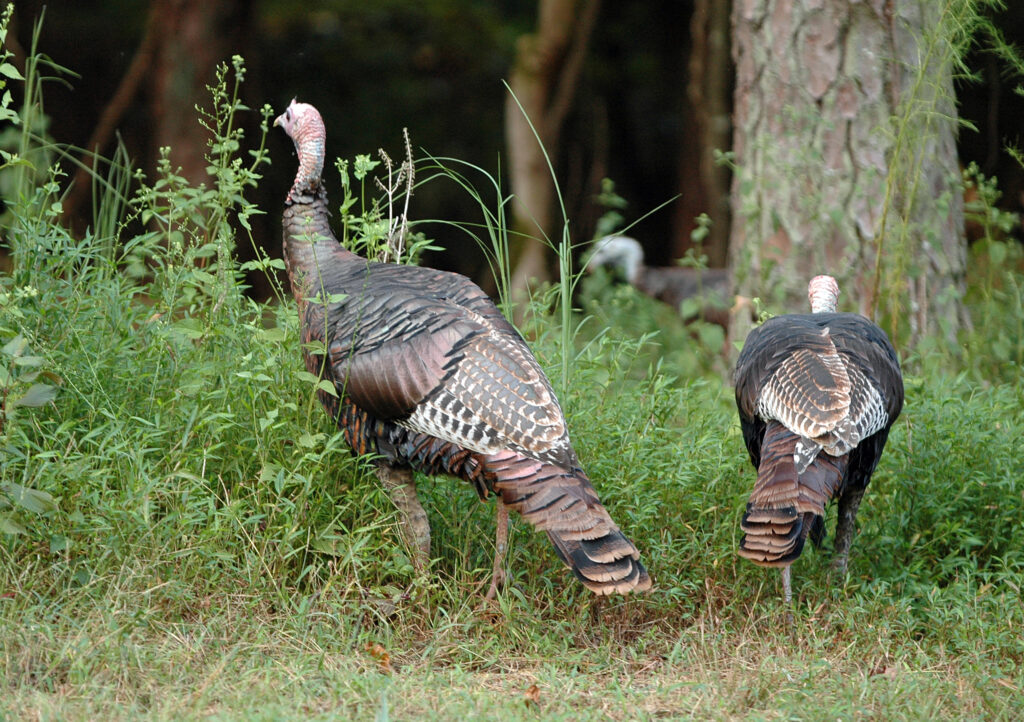
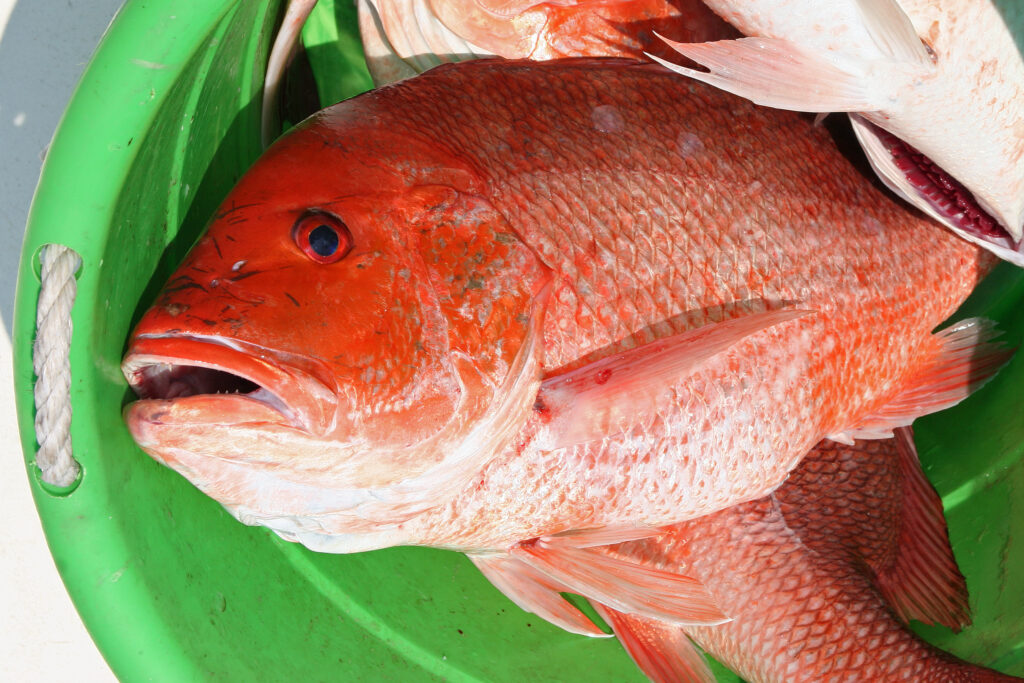
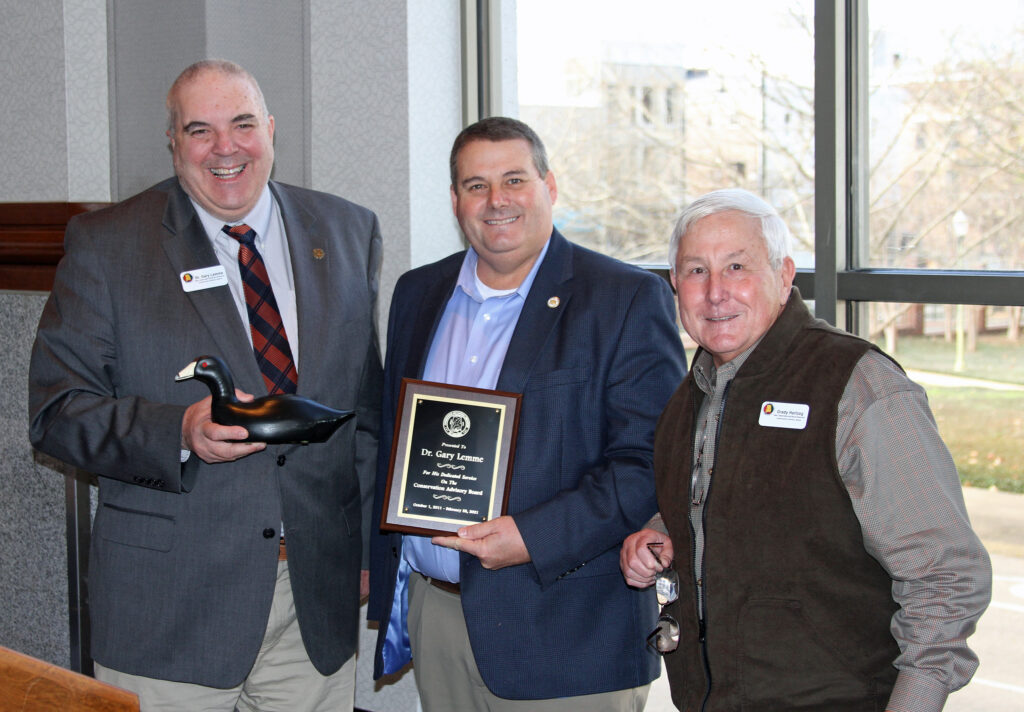
By DAVID RAINER, Alabama Department of Conservation and Natural Resources
In a 6-2 vote with two abstentions, the Alabama Conservation Advisory Board (CAB) recommended a starting date of March 25 for the 2022 spring turkey season with a four-bird season bag limit at its recent meeting in Montgomery. They also recommended that hunters be prohibited from using decoys for the first 10 days of the 45-day season for most of the state.
The Alabama Wildlife and Freshwater Fisheries (WFF) Division had proposed a starting date of April 1 with a one-bird bag limit the first 10 days of the season, and a five-bird bag limit that included both the fall and spring seasons.
The Board heard Dr. Barry Grand, Supervisor of the U.S. Geological Survey’s Cooperative Research Unit at Auburn University, summarize the final report of a five-year wild turkey research project conducted by Auburn University and initiated by WFF.
Grand’s report indicated several actions could positively impact the health of the wild turkey population in Alabama, including a reduced bag limit, opening the season at a later date, shortening the season or a combination of those and other actions.
“We (WFF) compromised and didn’t recommend to shorten the season and didn’t reduce the bag limit in our proposal,” said WFF Director Chuck Sykes. “Those two factors showed the least amount of positive influences on the turkey population.
“What made the most impact for turkey season is opening later, because 26 percent of the gobblers are harvested the first week of the season, and by the end of the second week almost 50 percent of the birds had been harvested.”
“After reviewing the turkey research data and hearing the presentations from Dr. Grand and Director Sykes, as well as considering input from hunters and constituents in their districts, the members of the Conservation Advisory Board modified the proposal from WFF,” said Conservation Commissioner Chris Blankenship. “The CAB recommendations will be integrated into the season and bag limits beginning in the fall 2021-2022 season. Nothing will change for the turkey season that opens on March 20, 2021.”
During his WFF update at the meeting, Sykes had very good news on several fronts – hunter safety, Game Check compliance and participation in hunting and fishing.
For the 2020-2021 hunting seasons so far, only one fatality and 15 total accidents have occurred.
“This year we are on pace to have the lowest reported amount of hunting accidents and fatalities that we’ve had since we began keeping records in 1973,” Sykes said. “That’s a big deal. Hunters are listening. We’re doing our best to educate them. I certainly hope we can keep that going. That’s a monumental improvement over last year.”
As for Game Check, compliance more than doubled during deer season with the implementation of the transfer of possession rules. Hunters were required to have a Conservation ID number and Game Check compliance number before a deer or part of a carcass could be transferred to another individual, including processors and taxidermists. During the 2019-2020 deer season, 95,033 harvested animals were reported. During the 2020-2021 season, the total reported harvest was 195,119.
“It worked, no ifs, ands or buts,” Sykes said of the impact of the transfer rules. “We are estimating our compliance rate right now will go from less than 50 percent to approximately 90 percent. That’s a huge deal for us to be able to utilize the data to make positive management decisions.
“We were able to take Game Check data and take Jackson County completely out of Zone C. We use this county-by-county data to make better decisions to give hunters more access and do what’s best for the resource.”
Sykes pointed out the effect COVID-19 restrictions had on the number of people who enjoy the outdoors in Alabama.
“Nothing could have brought us back to the forefront like COVID-19 did,” he said. “Most of our recreational licenses increased from 2019 to 2020. Freshwater fishing licenses increased by almost 15 percent. Hunting licenses were up by eight percent. Even this year, we’ve got a 5.3-percent increase in hunting licenses. Even though it’s really early in the freshwater fishing season, we’re up 8.8-percent. People are definitely getting outside to enjoy what Alabama has to offer.
“The same goes for our Community Archery Parks and Public Shooting Ranges. They have experienced a record number of visitors this year. We operated 12 shooting ranges and 18 archery parks. Anyone can utilize those ranges and archery parks as long as they have a license issued by the ADCNR (Alabama Department of Conservation and Natural Resources). For some perspective, the Swan Creek Range in Limestone County averaged selling 150 new licenses a week last year. So, there were a lot of first-time people coming and taking advantage of what this Department has to offer.”
Sykes said the same increase in usage was also seen at the WFF Public Fishing Lakes throughout the state. WFF manages 23 lakes with 1,912 surface acres in 20 counties.
“Our lakes had a 44-percent increase in usage from FY19 to FY20,” he said. “That translates to more than 50,000 more fishing trips than a normal year and the most fishing trips in the last 17 years.
“Everything we have, from WMAs (wildlife management areas) to our lakes to shooting ranges to state parks to Forever Wild property – everything experienced tremendous use last year.”
Sykes also provided the Board with an update on CWD (chronic wasting disease), which affects white-tailed deer and other members of the cervid family. Sykes showed maps of the CWD positives closest to Alabama in Mississippi and Tennessee.
“As of today, we still do not have CWD in Alabama,” he said. “We are currently testing. We tried to educate people from day one that CWD progression is about like our (feral) hog progression. It doesn’t move real fast naturally. It only moves real fast if it’s in the back of a truck. Thankfully our hunters have listened. In Mississippi and Tennessee, it has moved only 10 miles toward Alabama in the past two years through natural progression.
“I want to thank our hunters for doing their job and not artificially expanding the CWD zones.”
On the saltwater front, Alabama Marine Resources Division Director Scott Bannon said the season for the state’s most popular reef fish – red snapper – has not been set. Although the five Gulf states were granted state management for red snapper through the Gulf of Mexico Fishery Management Council (Gulf Council) process, the National Marine Fisheries Service has indicated it wants to implement a “calibration” process between Snapper Check and federal survey harvest numbers.
“The calibration process could reduce our quota by half,” Bannon said.
The Gulf Council will meet in April and will receive a report on the Great Red Snapper Count that was conducted by multiple research entities through grants provided by legislation sponsored by Alabama Senator Richard Shelby.
“The Great Red Snapper Count will show that, conservatively, there are three times the number of red snapper in the Gulf of Mexico than previously thought,” Bannon said. “The federal government has to provide us with an interim analysis. There will be a lot of information to come out, and there’s a lot of networking between states on how to move forward. Our goal is to avoid reductions.”
Commissioner Blankenship said all aspects of the ADCNR were affected by COVID-19 with an upswing in the public use in all four divisions – Wildlife and Freshwater Fisheries, Marine Resources, State Parks and State Lands.
“Fishing, boating, hunting, shooting, hiking, WMAs and Forever Wild property usage were all up in 2020 due to COVID,” Commissioner Blankenship said. “I personally want to thank Governor (Kay) Ivey for her support of outdoor recreation. She understood that people needed the outlet for physical and mental health through the outdoors, which could be safely accessed during this time. We appreciate her keeping this as essential services all throughout COVID. All of us benefitted from that.”
Commissioner Blankenship said the increase in license sales has allowed the ADCNR to add 15 Conservation Enforcement Officers to the staff.
“This is the largest class we’ve had in 25 years,” he said. “We’re very proud to increase our enforcement presence to protect our natural resources.”
Commissioner Blankenship also announced that all 21 State Parks now have fiber optic internet service, and expanding the Wi-Fi network at each park is underway. The Commissioner said a variety of updating and upgrading projects have started or are planned at State Parks throughout the state.
Spring Pond and Bass Fishing Management
By Mary Leigh Oliver
AUBURN UNIVERSITY, Ala. – Spring cleaning means pond cleaning, too. With bass fishing season on the horizon, maintaining productive pond conditions for bass and other fish is important for successful fishing now and in the future.
When it comes to maintaining productive fishing ponds, Alabama Extension Specialist Rusty Wright recommends a plethora of simple, yet easily overlooked steps. Like spring cleaning, many of these steps are time sensitive for late winter and early spring.
Weed Control
First and foremost, if there are weeds present in the pond, gain control of the weeds.
“Do not allow weeds to get out of control in the spring,” Wright said. “Control them before they take over.”
Once the weeds are removed from the pond, it will be easier to fish in the pond and conduct other maintenance.
Fertilization
If the pond owner choses to fertilize the pond, it is essential to begin fertilizing at the proper time during the spring. Fertilization should begin when the water reaches 60°F. Waiting too late to fertilize will allow weeds to grow back. Fertilize about every 10 to 14 days until the water is green enough that an object lowered into the water disappears between 18 and 24 inches. After the 14 day mark, only fertilize when the water clarity is more than 24 inches. To avoid unnecessary additional maintenance, ponds must be fertilized at the proper time and temperature.
Fish Kill
A term that may be unfamiliar to some, fish kill refers to the die-off of fish due to poor water conditions, like low dissolved oxygen or disease. One of the ways that dissolved oxygen can become depleted in the spring is due to algal bloom die-offs.
“Algae produce most of the oxygen in the pond so when they die-off the oxygen drops and the fish can die,” he said.
Unfortunately, there is no direct way to prevent algal bloom die-off. However, by liming, or applying acid-neutralizing agricultural limestone to the pond, the alkalinity and hardness can be kept above 20 parts per million (ppm). Ponds with an alkalinity lower than 20 ppm are not as productive and suffer more frequently from algal bloom die-off.
Also, there are often outbreaks of various fish diseases as the water begins to warm. When there are fish disease outbreaks, remove as many of the dead fish as possible.
“If the pond owner is feeding fish, they should reduce the amount of food or stop feeding entirely until the fish stop dying,” Wright said.
Bass Maintenance
Lastly, if the pond is a bass pond, it is time to start fishing and harvest the bass. Bass fishing season is at its best in late March through early May. Therefore, now is the time to take out a big chunk of the bass for harvest. For unfertilized ponds, harvest about 10 pounds per acre per year. In fertilized ponds, harvest about 25 pounds per acre per year. When choosing bass for harvesting, target bass that are 14 inches or shorter in length. However, taking out a few bigger fish is not a problem.
More Information
When household spring cleaning begins, don’t forget to tend to the pond. For more information on spring pond maintenance and bass harvesting, visit the Alabama Extension website, www.aces.edu.

Controlled Burns Top Tool for Wildlife, Land Managers
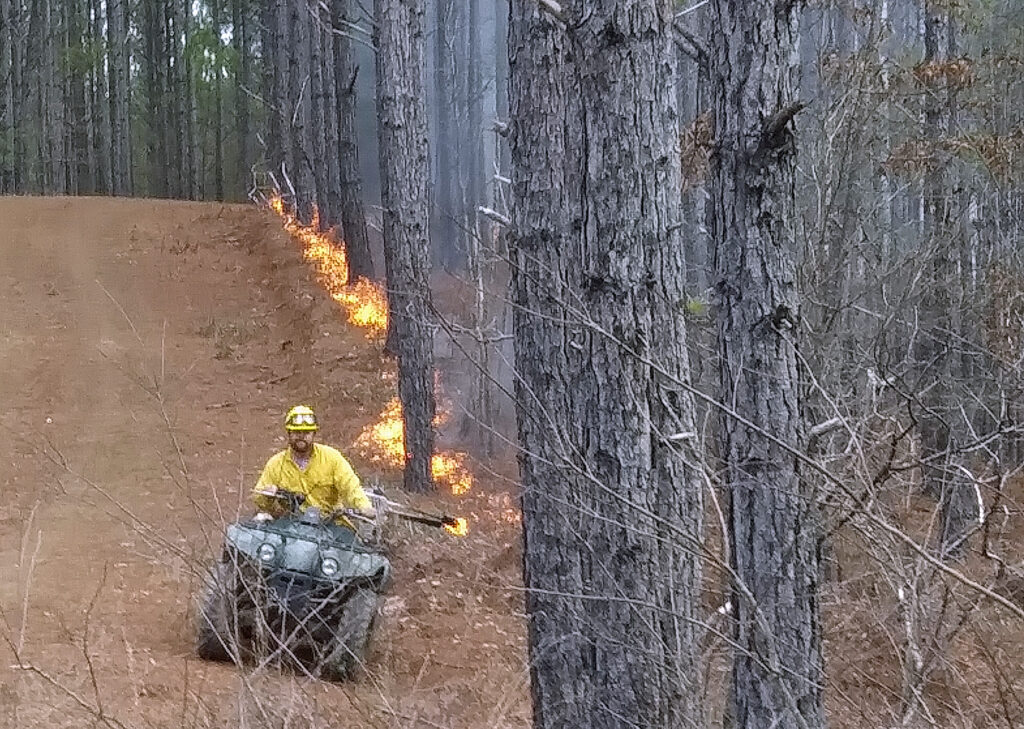
By DAVID RAINER
Alabama Department of Conservation and Natural Resources
Social media has been filled with smoke and fire lately as many land managers, like the Alabama Department of Conservation and Natural Resources (ADCNR), conduct controlled burns to enhance the flora and fauna throughout the state.
Steven Mitchell, the ADCNR’s Wildlife and Freshwater Fisheries (WFF) Division Upland Bird Coordinator, said the Department, along with other land managers, often takes advantage of the downtime and prime weather conditions between the end of the white-tailed deer season and the opening of turkey season to conduct controlled (prescribed) burns throughout the state.
Mitchell said the WFF’s wildlife management areas (WMAs) are given a great deal of flexibility in their burn programs.
“For those WMAs that have the ability to apply prescribed fire, our staff has an established burn regime and is actively applying fire to the landscape for managing habitats,” Mitchell said. “When the weather conditions fit the burn prescription, our biologists and wildlife technicians work to conduct the fires within those parameters for a safe and effective burn. Our cooperative partners, the U.S. Forest Service and U.S. Fish and Wildlife Service, work diligently as well on the National Forests and National Wildlife Refuges, respectively, to plan, implement and manage the prescribed burning efforts on those lands, some of which host WMAs. While we would like to only burn in the non-hunting months to not hamper hunters, limited weather conditions often require our staff, as well as other land managers, to take advantage of optimal conditions to burn when conditions are available. We do our best to communicate these efforts with our hunters and advertise on www.outdooralabama.com and our Facebook page when we’re conducting controlled burns.”
Mitchell said burns are conducted mainly during the time when plants are dormant, but, to achieve certain habitat objectives, many of our burns occur when plants are actively growing, termed a growing-season burn.
“Dormant season, winter and early spring, is when most of our burning occurs, but, at times where control of woody plants is desired, a growing-season fire is utilized as you get a different effect than in the dormant season,” he said. “You get a lot more control of woody vegetation with a growing-season fire, and it has the effect of opening the structure of the stand to more light and more beneficial growth of early successional plants.
“Burns can be conducted during the dormant season or growing season accordingly and, when used in proper scale and frequency, can attain a wide collection of land management objectives. Another added benefit of controlled burning is the reduction of fire hazards and fuel loads, lowering the chance of wildfires.”
Land managers who are burning for quail have additional factors to consider.
“If you’re focusing on quail management, distribution of burn units is even more important as they have a smaller home range,” Mitchell said. “Burning, while practically mandatory for bobwhite management, also removes cover and exposes the quail to avian predation. The primary raptor migration extends through March in many areas and can impact quail significantly if considerations for sufficient cover aren’t addressed.”
Mitchell said those burning in longleaf pine habitat need to have certain considerations of the new growth on the trees.
“You want to burn longleafs before they candle out and start putting on new growth,” he said. “The buds, sometimes termed candles, are more susceptible to fire damage during this candling period. Although the longleaf is a very fire-tolerant tree, it can be damaged during this time. After a year of growth, longleafs can typically tolerate properly applied fire. However, if specific burn parameters aren’t present to burn, significant damage can occur to the saplings, so these burns need to be conducted carefully.
“But it’s critical to get a fire in longleaf stands to suppress the competition from vegetation and other trees, including loblolly pine, especially if you’re managing for wildlife. You want to maintain that open understory. There’s not much better habitat than that provided by young longleaf stands for bobwhite quail. You can have nesting and brooding habitat in the same patch of trees.”
Mitchell said just about all wildlife benefit from controlled burns in one way or another, even including deer.
“Most people don’t think about deer benefitting from burns, but they do,” he said. “Of course, turkeys and quail benefit, as well as most game birds.
“Burning is the most economical and effective way to manage early successional habitat. After a burn, a lot of the plants that come back are the forbs and legumes and grasses, which are beneficial for most of our wildlife. There’s a lot of protein in native plants that grow back after a prescribed fire.”
Mitchell said studies have shown that turkeys and quail prefer areas with a burn management program, from freshly burned to areas that have burned within 3 years. After 3 years without a burn, the habitat becomes less preferred by turkeys and quail.
“If the area has a fire history that has been established and maintained, most of the turkey nests will not be in the areas that haven’t been burned within the past three years,” he said. “The nests are going to be in cover that was burned last year or the year before. The plant structure in those units that have been burned is their preferred habitat.
“You may have seen it with turkeys; the smoke hasn’t even cleared and they’re already out there scratching around.”
Mitchell said when areas that have burned get rainfall, the new growth could be popping up within a couple of weeks, and within a month enough cover is available to hide the animals. He said most wildlife habitat is on a one- to three-year burn rotation with the shorter frequency yielding more forbs and grass and less of a woody component and vertical structure. He said burn frequency is site specific.
“On poor soils, you might need to wait three years between burns,” he said. “In rich, heavy soils, ground cover may get too dense too quickly. You may need to tighten that interval or stay on that two-year burn cycle.
“When conducted properly, burning improves plant species composition and structure for ground-nesting birds. It reduces that litter layer. It increases the bare-ground component for wildlife movement and foraging. It promotes a lot of flowering and seed production, which increases insect abundance. For your young quail chicks and turkey poults, insects are crucial for their survival in the first couple of weeks to a month after they hatch out.”
Another aspect of fires that Mitchell said is often overlooked is that the activity may reduce nest predation.
“On upland areas with a good fire rotation, you’re going to reduce the woody or hardwood component and dense vegetation conditions that the predators like to hunt and keep them in hardwood bottom,” he said. “It reduces time the predators are in upland areas where turkeys and quail are nesting.”
Mitchell said the scale of the area to be burned is also important, with 50 acres considered about the ideal size. If the fire is too large, the turkeys and quail will use the area less.
“You want to burn in a checkerboard pattern to maintain an interspersion of burned and unburned habitat,” he said. “It’s been shown that turkeys don’t use burned areas over 250 meters from the edge of an unburned area until later when cover grows back to a certain level. If you can’t burn in a checkerboard pattern, burn in a linear shape so the wildlife will have access to adjacent unburned cover.”
Mitchell said land managers must give a lot of consideration to neighbors, roadways and whether the land has proper fire breaks and other safety aspects before trying to conduct a controlled burn. Humidity also plays a big factor on whether to burn. If the humidity falls below 30 percent, Mitchell said burning can become a little more dangerous. Many other parameters are also considered to safely and effectively conduct a controlled burn, and it is crucial to have the proper training.
“You need to know what you’re doing,” he said. “There are classes you can take. The Alabama Forestry Commission offers a four-day course for burn manager certification where people get a higher level of fire education and become much more comfortable with applying fire to their property.”
Mitchell considers a proper burn regime one of the most beneficial practices wildlife managers can utilize.
“For wildlife management, prescribed fire is the most effective and cost-efficient tool in the toolbox,” he said.
R3 Campaign Encourages Alabamians to Get Outdoors
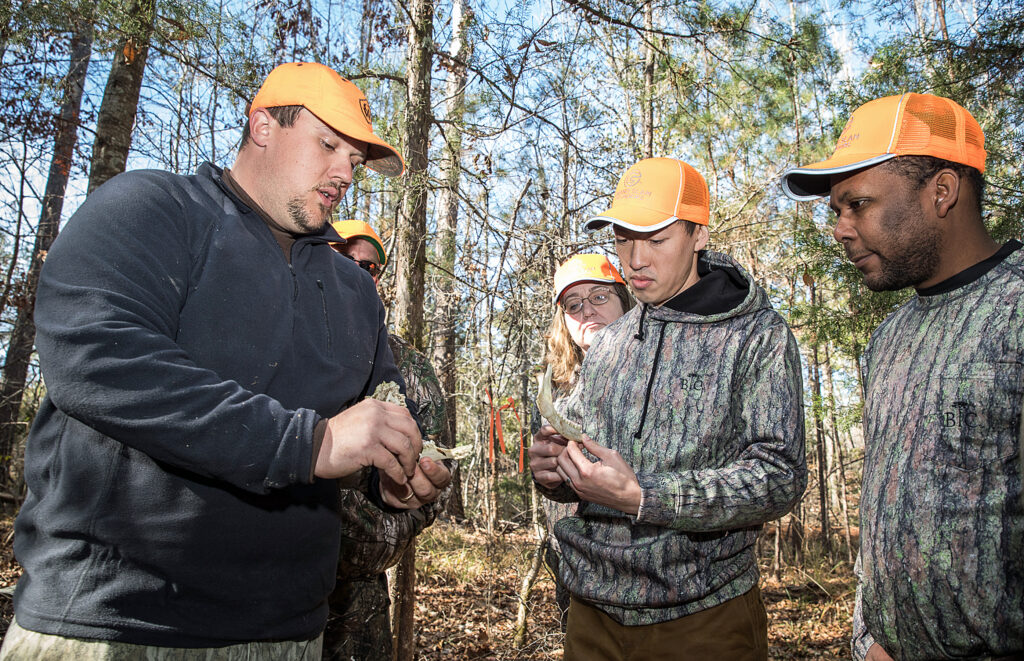
By DAVID RAINER
Alabama Department of Conservation and Natural Resources
With the social distancing requirements from COVID-19, many people have turned to the outdoors to escape the impact of the lockdowns.
The number of people fishing and hunting for a variety of game species has seen a boost, and Justin Grider wants to see that trend continue. Grider was recently named the Alabama Wildlife and Freshwater Fisheries (WFF) Division’s R3 Coordinator.
R3 is a national program that addresses ways to boost hunting and fishing participation – Recruit, Retain, Reactivate.
“The overarching view of R3 is that we want to reverse the decline in hunting and fishing license sales that’s been happening for several decades,” Grider said. “The average age of a license buyer in the state of Alabama is the late 50s, and once they turn 65 they don’t have to buy a license.
“We have to do something to change that trend. We not only want to revamp what we’re doing, we want to get everybody on the same page Division-wide. We want to streamline existing programs and then create new, innovative programs that will allow us to reach more people and give us a bigger footprint. We also want to reach new audiences, not only the ones we’re already in contact with.”
Grider, WFF staff and the Communications and Marketing Section of the Alabama Department of Conservation and Natural Resources (ADCNR) are working on an R3 training video (I Am R3) to educate Department personnel.
“We want everybody in the Department to know what R3 is,” Grider said. “We want them to know the problems we are facing as an agency in that our funding model is tied to license sales. We need people to understand the importance of reversing downward sales trajectories.”
Grider said the campaign will include having more outdoors-oriented events led by WFF staff as well as training volunteers so the volunteers will be able to host the events by themselves.
“We want to increase opportunities for people to learn and get involved,” he said.
Outreach is a significant aspect of the R3 effort. A little over a year ago, Conservation Commissioner Chris Blankenship revamped the makeup and mission of the old Information and Education Section into the new Marketing and Communications Section and tasked Section Chief Billy Pope to find ways to expose the public to the benefits of outdoor recreation, including hunting and fishing.
“It’s exciting that we are in a position to expand our marketing efforts with Billy Pope and his staff,” Grider said. “My hat’s off to Commissioner Blankenship and Billy Pope for their willingness to try innovative ideas and new approaches in how we are promoting our programs, promoting our license sales and encouraging people to utilize public lands and water bodies. We’re encouraging people to get outside to hunt, fish and get to the shooting ranges.
“That’s not something we have done in the past as a Department. But this is a national trend in the last couple of years and especially during the pandemic; state agencies are starting to realize the role marketing can play in helping reverse downward trends in participation.”
Although the white-tailed deer season has closed for now, Grider said the outreach will highlight the upcoming turkey season, which opens on March 20, and the abundant fishing opportunities in the spring. The campaign will continue into the summer and fall with dove season, archery season and the rifle deer season.
During the COVID pandemic, Alabama has seen a significant increase in all outdoors activities. Hiking, biking, wildlife viewing and other activities have increased as well as hunting and fishing, which can be tracked through license sales.
“We have been very fortunate to see a surge in fishing, especially, but also in resident hunting licenses,” Grider said. “The goal is to retain those new license buyers. These outreach efforts we’re putting in place are so we can retain those folks who got outdoors because of the pandemic. Because of the restrictions, people had more time on their hands and were able to get outside. We want to do whatever we can to retain that new audience.”
Grider understands that when some of the COVID-19 restrictions are lifted, the forces that caused the decline in outdoors activities will again be in play.
“We’ll be competing for time again as things get back to normal, as normal as it can be,” he said. “As we get back to where folks are working more and kids are involved in extracurricular activities, we will be dealing with what we faced before the pandemic.
“I feel like if we can get out in front before their plates get full again and they see the benefits of getting outside, they see the benefits of hunting and fishing, then those outdoors activities, like hunting, fishing and target shooting, will maintain relevancy and continue to be a priority.”
Grider said the new efforts will focus on spring and summer as well as continuing the outreach that occurs during hunting seasons with the Adult Mentored Hunting Program (AMH), the Special Opportunity Area (SOA) hunts and opportunities on our Wildlife Management Areas.
“We want to keep people engaged throughout the year, not just during hunting season,” he said. “That’s where fishing events come into play. That’s where shooting events come into play. This will help us stay relevant throughout the year.
“As for recruitment, we’re looking for new audiences. There is a lot of interest in learning how to fish and hunt in major metropolitan areas. In our marketing efforts, we will encourage those people to participate, whether it is the Adult Mentored Hunting Program, the new ‘Go Fish Alabama!’ program or getting to one of our events at one of our shooting ranges.”
The retainment aspect of the R3 program will encourage existing hunters, anglers and target shooters to take advantage of the outreach events and to volunteer to teach the newcomers the skills needed to enjoy outdoors activities.
“There are really good hunters, really good anglers and shooters who want to get involved by teaching,” Grider said. “We’ll use those folks as mentors. We’re seeing that already within the Adult Mentored Hunting Program. Folks in that program three or four years ago are coming back to serve as mentors.”
Reactivation efforts will reach out to those who have hunted or fished in the past but those activities have lapsed for whatever reason.
“Some of the folks who got back out during the pandemic were some of those people who had lapsed or had not purchased a license for several years,” Grider said. “They may have grown up in the outdoors or dabbled in it as an adult and just got busy with other priorities in life. When the pandemic offered them spare time, they were able to get back involved in the outdoors.
“Some of the reactivation efforts are tied to recruiting as well. We think there are people in metropolitan areas who haven’t participated in R3-type activities in five, 10 or 15 years. They may have moved from rural areas where they grew up to metropolitan areas where they can’t go hunting, fishing or target shooting as easily. We want to educate the public about the great hunting, fishing and shooting opportunities in or near the major metropolitan areas all over the state.”
Grider said WFF Director Chuck Sykes has made the R3 program and the marketing efforts a priority.
“We’re going to try innovative ways to reach these people,” Grider said. “And I think this will allow our efforts to come to fruition. If we aren’t selling licenses, we aren’t able to continue conservation and our wildlife and fisheries management programs. The majority of people care about conservation. We just need to get that message in front of them.”
Grider said the “Go Fish Alabama!” program will hold fishing events in areas like Public Fishing Lakes, state parks and local lakes in or near metropolitan areas. The program will be geared toward adults and families.
“We want to teach people how to fish so they have the knowledge to do it themselves,” he said. “We’ll have mentors on-site teaching participants how to use the equipment, how to target specific species and how to clean and cook the fish.”
Grider said the “Go Fish Alabama!” program will start as soon as COVID-19 restrictions allow. Visit www.outdooralabama.com/fishing/freshwater-fishing for the latest details.
Winners of the Outdoor Alabama Photo Contest announced
Whitacker wins second place for Senic
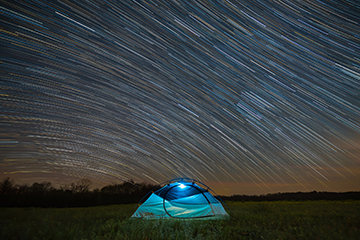
The winners of the 2021 Outdoor Alabama Photo Contest are listed below. As usual, the judges had a very difficult time selecting the winning photos from among the thousands entered. The 2022 contest will be announced later this year.
“The abundant diversity in Alabama’s landscape and native wildlife make it a photographers paradise,” said Chris Blankenship, Commissioner of the Alabama Department of Conservation and Natural Resources (ADCNR). “From the north Alabama mountains to the state’s Gulf Coast beaches, the winning images in this year’s Outdoor Alabama Photo Contest highlight the natural beauty of our state.”
Sponsors of the 2021 photo contest include the Alabama Conservation Enforcement Officers Association (ACEOA), Alabama State Parks, and the Alabama Tourism Department. Each winner will receive a prize pack and be featured in a traveling exhibit throughout 2021. First place winners in each category will also receive a $50 gift card from Academy Sports + Outdoors (provided by ACEOA). Second place winners in each category will receive a $25 Alabama State Parks gift card. When the 2021 traveling exhibit schedule is finalized, it will be posted on outdooralabama.com.
Alabama State Parks: First Place, Keith Bozeman, Rock Garden Trail at Cheaha State Park; Second Place, Arthur James Davis, Sunset at Meaher State Park;Third Place, Christopher Baker, View of Comet NEOWISE at Lake Guntersville State Park; Honorable Mention, John Marvin Hillsman, III, Gulf State Park Beach Pavilion
Birds: First Place, Matthew Dees, Brown Pelican on the Mobile Causeway; Second Place, Brent Eanes, Ruby-throated Hummingbird; Third Place, Debra Lucas, Northern Harrier; Honorable Mention, Jim Flynn, Bluebirds in Albertville
Wildlife: First Place, Christopher Baker, North American Beaver in Madison; Second Place, Terry D. Brandebourg, Rutting Buck; Third Place, Maranda Mink, Groundhog on Monte Sano Mountain in Huntsville;Honorable Mention, Laurie L. Schaerer, Fox Kits on Dauphin Island
Cold-blooded Critters: First Place, Sean C. Grizzle, Barracuda; Second Place, Christopher Baker, Tree Frog in Madison; Third Place, Gwen Ainsworth, Green Anole in Mobile; Honorable Mention, Rick Dowling, Northern Pine Snake in Autauga County
Bugs and Butterflies: First Place, Jim Flynn, Robber Fly in Albertville; Second Place, Jim Flynn, Jumping Spider in Albertville; Third Place, Thomas W. Peterson, Green Lynx Spider and Bee on Zinnia in Daphne; Honorable Mention, Jim Flynn, Dragonflies in Guntersville
Sweet Home Alabama: First Place, Gwen Ainsworth, USS Alabama Battleship and Skyline in Mobile; Second Place, Glenn Wills, Starry Night in Sumter County; Third Place, Beth Cowan Drake, Shrimp Boats in Bayou La Batre; Honorable Mention, Linda P. McCullough, Diner in Gulf Shores
Nature-Based Recreation: First Place, Christopher Baker, Full Moon Fishing at Lake Guntersville; Second Place, Arthur James Davis, Fishermen at Dauphin Island; Third Place, Amata Hinkle, Caving in Paint Rock; Honorable Mention, Glicerio Ralleca, Jr., Hot Air Balloon Festival in Decatur; Shoots and Roots: First Place, Arthur James Davis, Fern with Dew Drops on Dauphin Island; Second Place, Bob Moore, Frost on Blackberry Bush; Third Place, Benjamin Rollings, Live Oak at Bon Secour National Wildlife Refuge
Honorable Mention, Arthur James Davis, Spiderwort on Dauphin Island
Scenic: First Place, Keith Bozeman, Canyon Cascade in Bankhead National Forest; Second Place, Jon Whitaker, Star Trails Over Tent in Tuscaloosa; Third Place, Audra Spears, Lightning Over Lake Martin; Honorable Mention, Barry Lee Miller, Sunset on Fort Morgan
Young Photographers: First Place, Sophia Charlotte Haines (age 13), Snowy Plover Chick in Fort Morgan; Second Place, Sophia Charlotte Haines (age 13), Longleaf Pine at Splinter Hill Bog; Third Place, Hannah Beth Long (age 16), Hay in Limestone County; Honorable Mention, Jessica Olivia Fain (age 16), Tate Farms in Meridianville
For more information about the Outdoor Alabama Photo Contest, visit outdooralabama.com/outdoor-alabama-photo-contest or see the photo gallery at flickr.com/photos/outdooralabama/albums/72157718137637166. The Alabama Department of Conservation and Natural Resources promotes wise stewardship, management and enjoyment of Alabama’s natural resources through four divisions: Marine Resources, State Lands, State Parks, and Wildlife and Freshwater Fisheries. To learn more about ADCNR, visit www.outdooralabama.com.
Alabama Hunters Bagging Big Bucks This Season
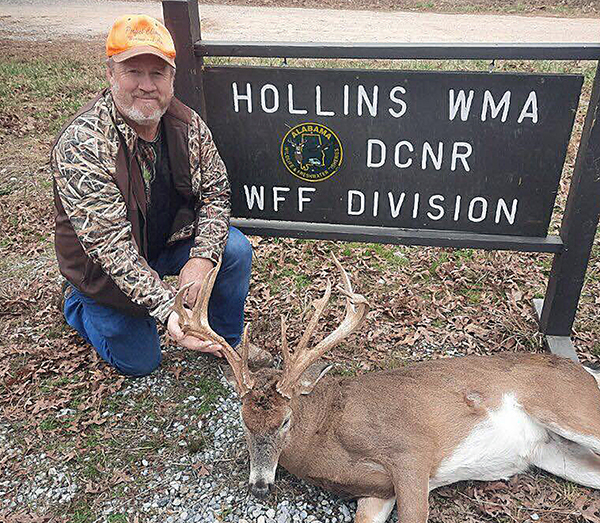
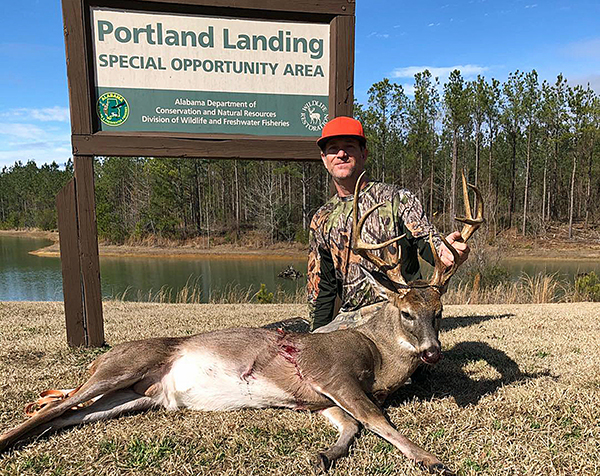
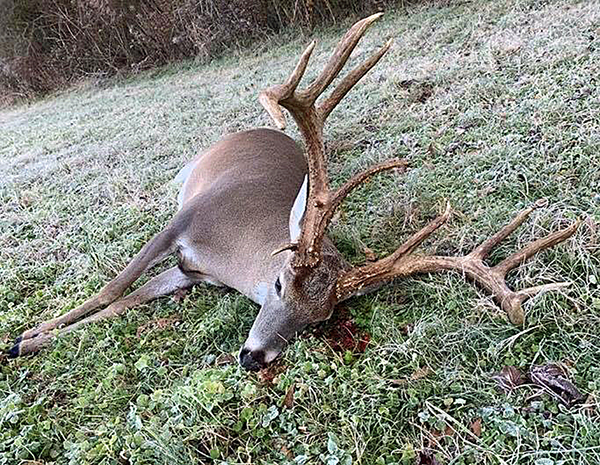
By David Rainer, Alabama Department of Conservation and Natural Resources
Judging from the number of deer reported through the Alabama Wildlife and Freshwater Fisheries (WFF) Division’s Game Check system and the number of trophy bucks posted on social media, Chris Cook thinks this is the best deer season our state has had in quite a while.
Cook, the WFF’s Deer Program Coordinator, said numerous factors are likely involved in the increase in harvest numbers as well as the quality of the bucks harvested.
Alabama’s three-buck limit has been in place for more than a decade, which could be one of the reasons for the big bucks, but Cook said that is difficult to quantify. Hunters are allowed to take one male deer (bare antlers visible above natural hairline) per day and three per hunter during all combined seasons. One of the three must have at least four antler points 1 inch or longer on one antler (except for Barbour County). A point is defined as an antler projection of at least 1 inch in length from base to tip. Main beam tip shall be counted as a point regardless of length. Barbour County requires all bucks to have at least three points on one side to be legal except during the statewide special youth season, when any antlered buck can be harvested.
“It’s hard to track and determine what you can attribute exactly to the three-buck limit because of the way data was collected before that,” Cook said. “We used the mail survey, and before the three-buck limit one of the questions was how many bucks you killed. If they killed 20, that’s what they put down. After the three-buck limit, nobody was going to put down they killed more than the limit.
“But I also think people started to be a little more selective. So we can’t attribute it to the three-buck limit or just a change in hunter attitude. It does appear hunters were willing to pass on yearling and 2-year-old bucks. A lot of clubs put in rules on buck harvest, so some of it was self-imposed.”
The number of trophy bucks taken in Alabama this year has been impressive. Huge bucks pop up on social media daily. Cook thinks the ease of posting photos on social media could possibly be skewing the impression of a banner season.
“With increased use of social media, everybody wants to post a picture of what they’ve killed, so everybody else sees what they’ve done,” he said. “In the past, somebody had to take a picture, get the film developed and send the picture to you.
“But it definitely seems that a lot more really good bucks were taken this year. Our Game Check numbers show that people are reporting way more deer than they ever have. They’re killing more deer, and a percentage of bucks reported have been really good deer.”
Cook said the change in the possession regulations has likely increased the Game Check compliance. After a deer is harvested, it must be reported by the hunter through Game Check before it can be transferred to an individual, processor or taxidermist. Whoever is in possession of all or part of a deer or turkey that is not their own must retain written documentation with the name of the hunter, the hunter’s Conservation ID number, the date of the harvest and Game Check confirmation number. The information can be documented on a piece of paper, or on a transfer of possession certificate available in the Alabama Hunting & Fishing Digest or online at outdooralabama.com. WFF also reactivated its toll free Game Check phone number, 1-800-888-7690, to make it easier for those without smartphones or internet access.
“You look at this season’s significant increase in Game Check numbers, and you have to wonder what our phone survey is going to tell us,” he said of the survey that had previously been done by mail. “If the survey numbers track along with the Game Check numbers like they have in previous years, I suspect we’ll see a pretty good increase in numbers from the phone survey.”
Cook said the COVID-19 restrictions have played a role in the increased harvest of all deer. Many people have discovered or rediscovered many outdoors activities, including hunting.
“We saw that during last year’s turkey season,” he said. “More people were hunting because of work schedules. Some people were working remotely and were able to schedule more time in the woods to kill more deer.”
Environmental conditions that improved deer habitat also likely contributed to an increase in deer harvest, Cook said.
“We had two good years of above average rainfall,” he said. “In some areas, we had a lot of flooding, which makes it hard to hunt during deer season. Some deer that would have normally been harvested didn’t get killed. The other benefit of all that rain is food production. So tough hunting conditions for a couple of years and great growing conditions probably allowed the deer to be a little older and in better condition. Early in the season, people were saying they couldn’t remember seeing body weights this good.
“Another factor that may be playing into this is the supplemental feeding. When feeding became legal last year, we had a 14-percent increase in harvest. But I wouldn’t attribute corn to the increased quality of the deer.”
Cook said WFF biologists and Law Enforcement personnel continue surveillance throughout the state for evidence of CWD (chronic wasting disease) with a special emphasis on northwest Alabama.
“We’ve increased our sampling efforts because of what’s going on in Mississippi and Tennessee,” he said. “We’re doing what we can to try to detect it early if it shows up in Alabama to give us more options on how to manage it. We haven’t detected anything.
“Mississippi added a couple of counties this year. Alcorn County (Mississippi) is the one closest to us. It really didn’t change our response protocol because it was still far enough away. Lauderdale County (Alabama) is the county within 25 miles of that positive case, and we had already stepped up surveillance in that area. We’re still working on meeting our target for testing. We’ve sampled a little more than 1,700 deer this year, more than we have before, and we’ll continue to sample more throughout the year.”
The Alabama deer herd is estimated at between 1.25 million and 1.5 million animals. As the Game Check numbers and phone survey data are analyzed for harvest on the county level as well as age and sex ratios, Cook said WFF will be able to update its population estimates after deer season ends February 10.
“We’ve got some areas where the deer population is down and other areas with more deer than they’ve ever had,” Cook said. “Places with good habitat will have good deer populations. It sure appears our deer herd is healthy. It’s going to be interesting to see what the phone survey numbers are, but it sure appears the harvest took a pretty good jump up this year, which I think will be an indicator of two things – we have more deer, but I think it also shows that people spent more time hunting.
“This deer season appears to be one of the best we’ve had in a long time. I hope people are able to take advantage of the last few days of the season. It will be prime time to be in the woods, especially in south Alabama.”
Special Youth, Veteran and Active Military Personnel Waterfowl Hunting Day
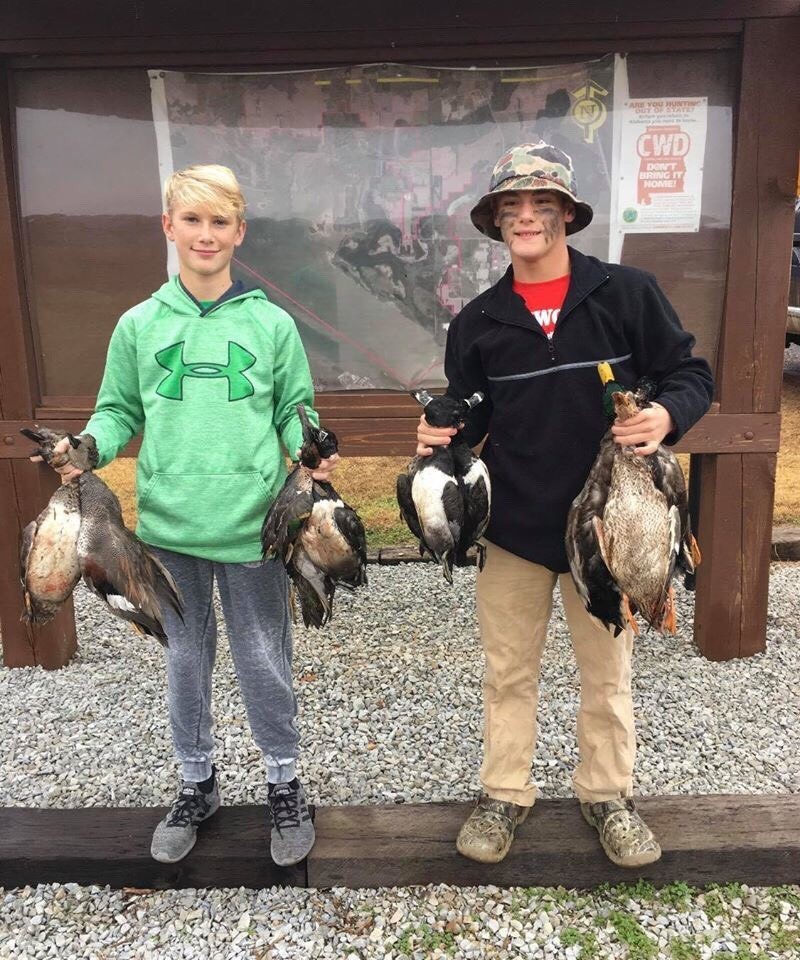
The Alabama Division of Wildlife and Freshwater Fisheries (WFF) has designated Saturday, February 6, 2021, as the second of the 2020-2021 hunting season’s Special Youth, Veteran and Active Military Personnel Waterfowl Hunting Days. The first of the two special waterfowl hunting days took place November 21, 2020.
On February 6, youth under age 16 who are accompanied by a licensed adult hunter, military personnel on active duty and veterans (as defined in section 101 of U.S. Code: Title 38) may hunt for waterfowl statewide. Regular waterfowl season shooting hours, bag limits, legal arms and ammunitions apply to the special days. Hunting area rules and regulations also apply.
To participate in the hunt, youth must be accompanied by a licensed adult supervisor. Only one firearm will be allowed per youth and only the youth hunters will be permitted to utilize the firearm for hunting unless the adult meets the requirements of a veteran or active duty military personnel. The adult supervisor must remain within arm’s length of the youth at all times and may accompany up to two youth participants during the hunt. The adult is also expected to review the rules of firearm safety and hunter ethics with each youth and ensure they are followed.
Youth is defined as an individual age 15 years and younger. Adult is defined as an individual age 21 years and older, or as the parent of the youth. The adult must have a state hunting license, state and federal waterfowl stamps and a free Harvest Information Program registration. Veterans and active duty military personnel must be in possession of a valid proof of service such as a military ID, Veterans Administration ID, veteran ID, veteran validation on their driver’s license or a copy of their DD Form 214. Possession of the mandatory hunting licenses and stamps is also required.
For more information about the Special Youth, Veteran and Active Military Personnel Waterfowl Hunting Days, contact WFF Migratory Gamebird Coordinator Seth Maddox at [email protected] or (334) 353-2057, or visit www.outdooralabama.com/waterfowl.
The Alabama Department of Conservation and Natural Resources promotes wise stewardship, management and enjoyment of Alabama’s natural resources through four divisions: Marine Resources, State Lands, State Parks, and Wildlife and Freshwater Fisheries. To learn more about ADCNR, visit www.outdooralabama.com.
Woodcock Monitoring Program Tracks Migration Routes
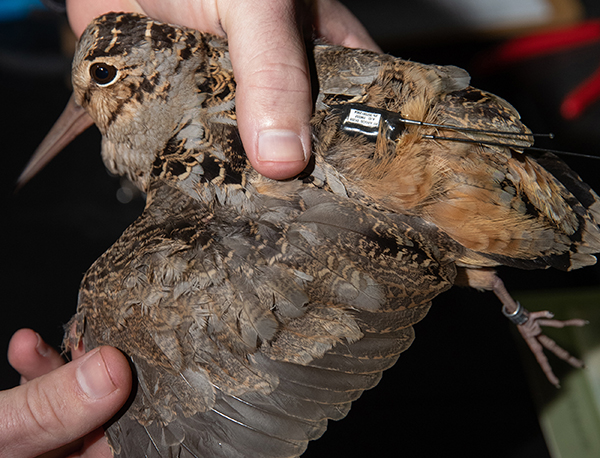
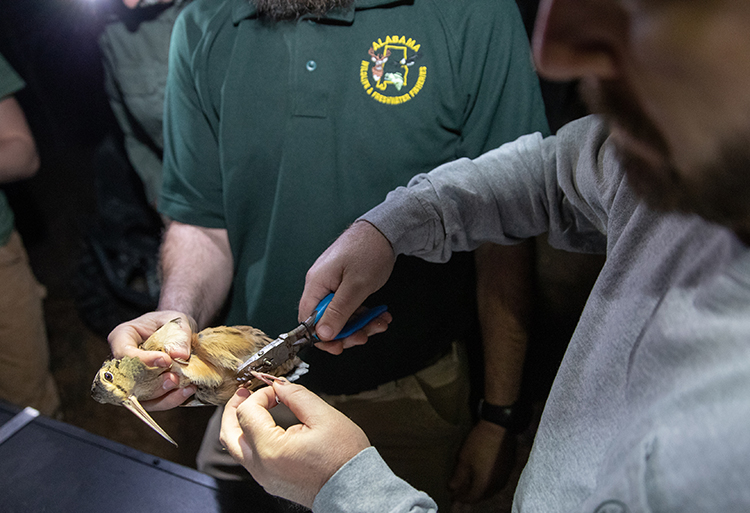
By David Rainer, Alabama Department of Conservation and Natural Resources
Seth Maddox will head out in February with other Division biologists to do some woodcock hunting. Yes, that is after the woodcock hunting season closes on January 31, but Maddox will not be using a conventional harvest tool. He will be wielding a long-handled dipnet.
Maddox, the Alabama Wildlife and Freshwater Fisheries (WFF) Division’s Migratory Gamebird Coordinator, will be on a mission to continue a woodcock tagging program to determine migration routes as well as conduct genetic studies on the birds also known as timberdoodles.
The woodcock is a migratory bird similar in size to the bobwhite quail but with a long, slim bill. The birds winter in the Southeast, which means Alabama will have a population of woodcock during the winter hunting seasons. As soon as it starts to warm, woodcock head north to their breeding grounds.
Maddox and WFF are working with the Eastern Woodcock Migration Research Cooperative to trap birds and attach transmitters that will track movement. For the first time since 1985, woodcock were trapped in 2020 in Alabama to become part of the study, which is spearheaded by the University of Maine.
“The project started about four years ago,” Maddox said. “The Cooperative was interested in migration patterns. They began putting transmitters on birds in the fall for their migration to the South. Here, we started putting transmitters on birds in the winter, following their spring migration to the North.
“These studies will narrow down key factors, like stopovers on the migration routes. It will determine if they have to travel farther because the habitat has been degraded or lost over the years.”
In February 2020, Maddox and crew went afield with spotlights, a thermal camera and the long dipnet.
“Once we locate the woodcock, we use the spotlight to try to disorient it for a minute,” he said. “We move forward, shaking the light to get close enough to catch the bird with the net.
“It’s not quite like a snipe hunt, where you have a cloth bag or burlap sack,” he said, referring to the prank where some unsuspecting individual is left in the middle of the woods holding the bag.
Maddox said last year they saw hundreds of woodcock, but they proved very difficult to capture.
“We ended up catching 13 birds,” he said. “We had seven transmitters to deploy, and we deployed all seven. We put four transmitters on females and three on males. The transmitters (less than the size of a quarter) on the females will give us information on nest success on the breeding grounds.
“We also took feather samples to do isotope analysis to determine geographic origin. You can look at the carbon in the feather and see where the bird was hatched. We also took blood samples for genetic analysis to determine population connectivity.”
The woodcock population is confined to the Eastern U.S., bordered by the Mississippi River to the West, the Canadian Provinces of Manitoba, Quebec and Novia Scotia to the north and Florida to the south. Maddox said where the prairie starts to the West is where the woodcock population ends. One of the birds tagged in Alabama last year traveled 2,100 miles into Manitoba. The woodcock are managed in two management regions, the central and eastern. Alabama is in the central management region.
“Woodcock are prevalent in the eastern U.S.,” Maddox said. “Alabama, being in the center of the Southeast, is kind of like a funnel for the birds that come from Minnesota, Michigan, Maine, Quebec, New York and Pennsylvania during their winter migration. We have a lot of habitat for woodcock with our woods and timber harvest operations.”
Maddox said ideal habitat for woodcock is forests that have been manipulated.
“Logging operations really help,” he said. “Every time you clear-cut a patch of land, when it starts coming back up, that first five or 10 years provides the ideal cover for woodcock. When the trees get tall, the woodcock don’t use it as much because there is less underbrush.”
Alabama has a 45-day woodcock season with a three-bird daily bag limit. A few hunters specifically target woodcock, but most are incidental harvests by quail hunters. Woodcock is a federally managed migratory species.
“Typically, woodcock hunting involves a pointing dog, kind of like quail hunting,” Maddox said. “But woodcock prefer thicker habitat along streamside management zones. You really have to get into the habitat because the birds hold very tight. It’s hard to hunt them without a dog.
“Their main source of food is earthworms. They use that long bill to probe into the soil and pull those worms out. They need really loose, moist-soil habitat that is found in bottomland areas. They’ll be along the water edges in thick cover. They won’t be in standing water, just a moist-soil environment where there is thick cover.”
Other hunters may encounter woodcock when pursuing other game.
“This time of the year, hunters see them from their deer stands or when they are walking to and from their stands,” Maddox said. “You’ll see woodcock feeding in the mornings or at night and after rains in harvested agricultural fields.
“You might also see the males doing a mating display, known as the sky dance, where they jump and fly 50 feet off the ground. As they fly in an arching pattern, the wind passing over their wing feathers will make a distinctive musical twitter sound. Their call is a peenting sound, which is sort of like a buzz. It sounds a little bit like an insect, like a cicada. While the birds are down here, they are pair bonding. The male is trying to attract a female with the displays. Then the pair will migrate north and establish a nest.”
According to the WFF hunter survey, about 300 hunters take advantage of the woodcock season with an average annual harvest of about 2,000 birds.
“The big harvest states for woodcock are Michigan, Wisconsin and Minnesota,” Maddox said. “I think most of our woodcock are taken by hunters who are probably not targeting woodcock. They are likely targeting quail.
“With the quail population at low levels, hunting woodcock could be a good way to get your bird dogs out and get some exercise. We have woodcock on lots of our WMAs (wildlife management areas), and you probably won’t run into many woodcock hunters. You’ll likely have it to yourself.”
Early Bird: America’s beloved Purple Martins return to Alabama
In a sure sign that spring is not far behind, the first Purple Martins of the year have been spotted in Alabama.
The birds were seen on January 15 in the city of Headland by a Purple Martin enthusiast – one of many people throughout the eastern and central United States who track and report on the birds’ annual migration on behalf of the Purple Martin Conservation Association.
“The first Purple Martin arrivals of the season are always an exciting event,” said Joe Siegrist, President of the Purple Martin Conservation Association. “Tracking the migration is not only fun, it also provides us with valuable information that helps inform our research and strengthen our efforts to make sure we’re doing everything possible to sustain the population of these amazing birds.”
North America’s largest species of swallow, Purple Martins winter in the rainforests of Brazil before making up to a 7000-mile migration north into the eastern United States and Canada.
The annual migration is a testament to the martins’ resilience as well as the unwavering dedication of thousands of ‘martin landlords’ who maintain multi-compartment nest ‘condos’ that are essential for the birds’ survival. Once widespread in rural America, this species, that eats billions of flying insects annually, has been disappearing at an alarming rate, experiencing a loss of one-third of its population over the last 50 years.
“The decline seems to be the combination of a few factors: nesting habitat loss, competing invasive species, decreasing prey availability, and climate change,” said Siegrist. “Over the majority of the Purple Martins’ range, they are unable to nest naturally any longer. Human-provided nest boxes are the only thing keeping the species alive east of the Rocky Mountains.”
Siegrist says the very survival of the species is due in large part to scores of dedicated conservationists who invest their time, money and hearts into maintaining housing for the martins.
“The landlords provide critical shelter for the martins,” Siegrist said. “In return, they are rewarded with a family-like bond with the birds who return to the same colony year after year like clockwork.”
To follow along with the Purple Martins’ migration and learn more about how you can help conserve this treasured bird, visit www.purplemartin.org. In addition, people interested in learning more about how to attract and care for Purple Martins can receive a free booklet by contacting the Purple Martin Conservation Association by emailing [email protected] or calling 814-833-7656.
Black Belt Adventures Urges Hunters to Donate Venison
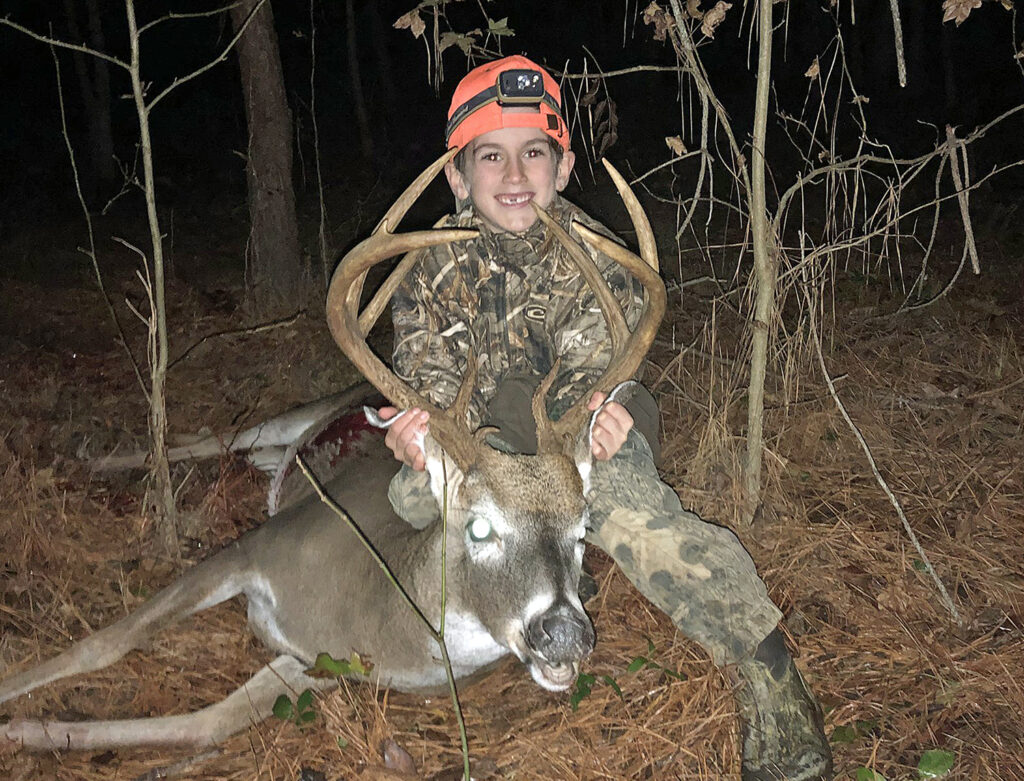
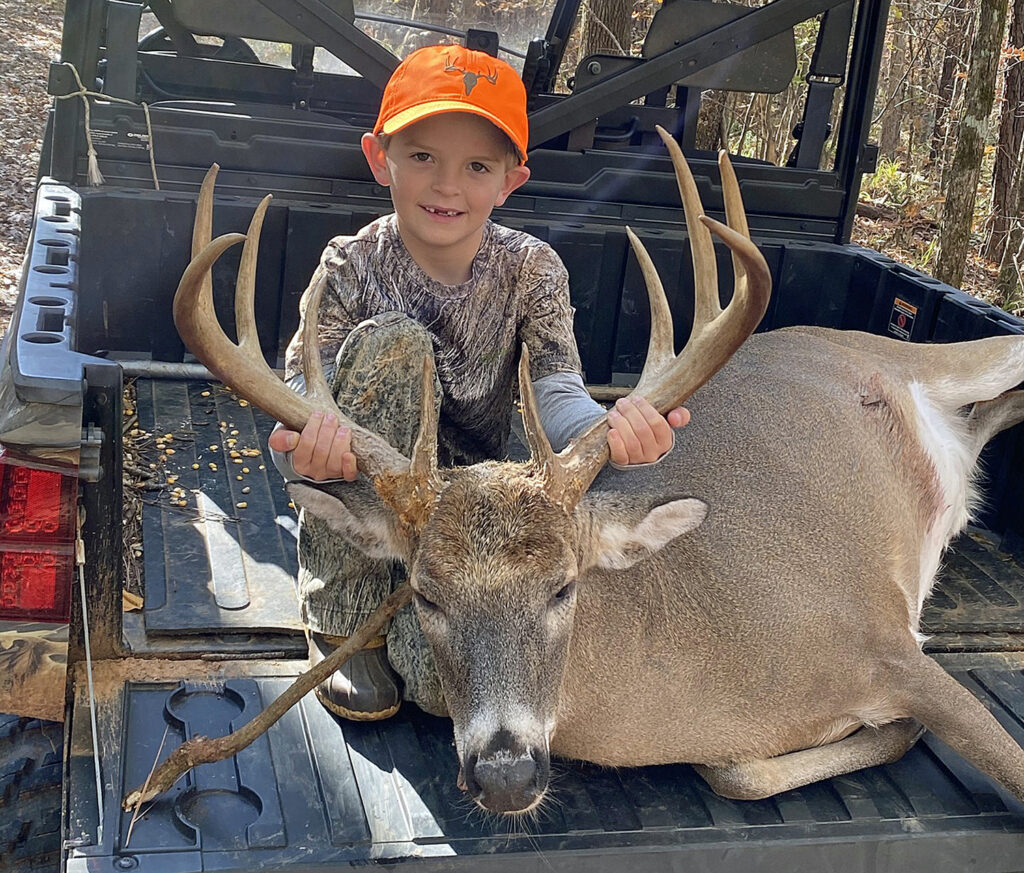
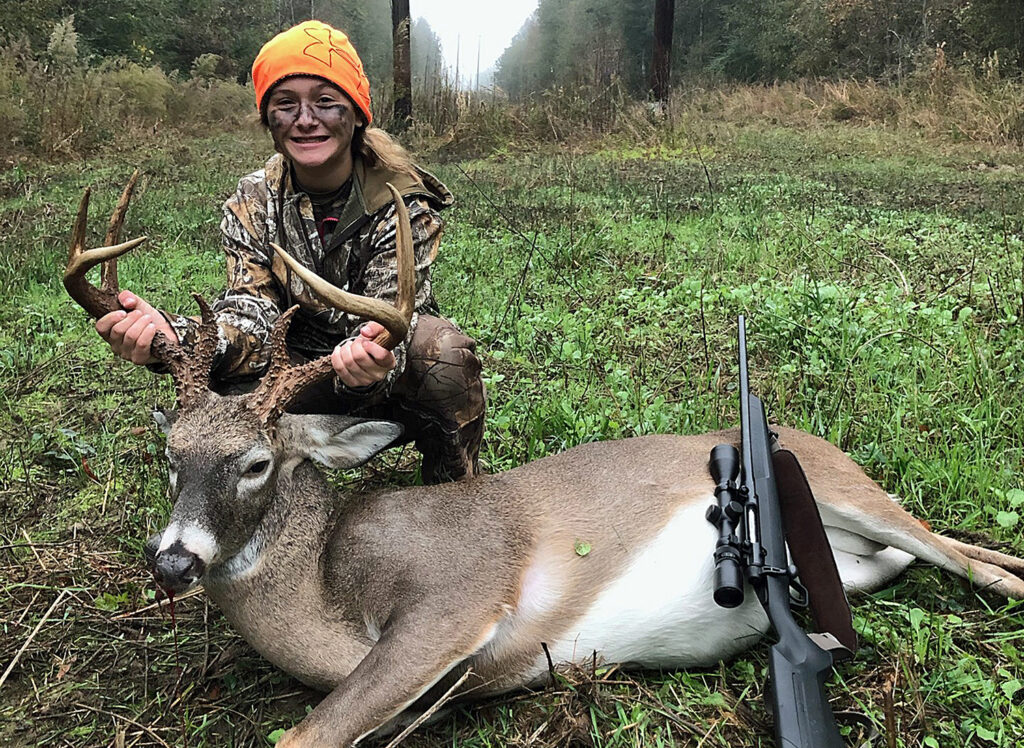
By David Rainer, Alabama Department of Conservation and Natural Resources
Hunters Helping the Hungry has provided more than a half-million pounds of ground venison to those in need in Alabama, and the Alabama Black Belt Adventures Association (ALBBAA) is encouraging hunters to make a special effort to donate harvested deer to the program during the Martin Luther King Jr. holiday weekend of January 15-18.
Hunters Helping the Hungry (HHH) started in Alabama in 1999 through funding derived from the Alabama Conservation and Natural Resources Foundation, which is chaired by Chris Blankenship, Commissioner of the Alabama Department of Conservation and Natural Resources (ADCNR). The Foundation pays processors in Alabama $1 per pound for the ground venison, which is then donated to food banks and charities in Alabama.
Commissioner Blankenship and Pam Swanner, ALBBAA Director, said the impact of the global pandemic has greatly increased the need for donations of protein-rich venison for those impacted by the virus.
“We know this past year has been difficult for many, and we hope this targeted weekend will assist in providing healthy, organic ground venison to families in need all across the Black Belt region,” Swanner said. “During this time of year, and especially with the impact of COVID-19, we couldn’t think of a better way to encourage sportsmen and women to utilize this free program to support the areas in which they go afield.”
Commissioner Blankenship said Alabama’s deer herd provides a bountiful resource that can be shared in this time of need.
“I think Hunters Helping the Hungry is a great program,” Commissioner Blankenship said. “We have such a healthy population of deer in our state. A lot of landowners need to harvest more does off their property to keep the deer herd in balance. When the freezer is full, this a great opportunity to manage your deer and donate the harvested animals to Hunters Helping the Hungry, which then donates the venison to the food banks to help those in need. We want to make sure there is no waste in the harvest of these deer.
“With the COVID situation and food banks being relied on by a lot of people to provide their protein and sustenance, it’s a great opportunity for deer hunters in the state to make sure those food banks are stocked with good meat to help the people in those communities.”
Because the processing fee is paid by the ACNRF, there is no cost to the hunters.
“All they have to do is drop the deer off at one of the participating processors with a Game Check confirmation number, and the processor takes care of the deer and sends it to the food bank,” Commissioner Blankenship said. “It’s a win-win for everybody.”
Currently, eight processors are participating in the HHH program within the Black Belt with 15 food banks participating within the region. The participating processors are Buckster’s Deer Processing in Montgomery County, Green’s Deer Processing in Clarke County, M & S Wildlife Services in Choctaw County, Nichols Deer Processing in Dallas County, Richey’s Deer Processing in Hale County, John’s Deer Processing in Lee County, Milliron’s Deer Processing in Russell County, and Venison LLC in Wilcox County. For a full list of participating processors and food banks statewide, please visit https://www.outdooralabama.com/programs/hunters-helping-hungry.
Paying the processing fee for HHH donations is only one of many benefits ACNRF provides.
“The Foundation does a lot of good work to help promote hunting, fishing and wildlife management in the state,” Commissioner Blankenship said. “Scholarships are provided at the University of Alabama and Auburn University in different disciplines. We provide seed and other materials for youth dove hunts around the state. We help support the Adult Mentored Hunting Program. A lot of things that come through the Foundation really support the work of the Alabama Department of Conservation and Natural Resources, especially those things that encourage people to become hunters and fishermen and get out and enjoy the outdoors.”
The Foundation has also been impacted by COVID-19, limiting the methods it can use for fundraising.
“The Foundation receives contributions from interested people throughout the state, but the biggest fundraiser is the Governor’s One-Shot Turkey Hunt,” Commissioner Blankenship said. “Due to COVID, we were not able to have the hunt last year, and we won’t be able to have it in 2021. But we’re counting on 2022 to be the best Alabama Governor’s One-Shot Turkey Hunt ever.”
Commissioner Blankenship said individuals, companies or groups that want to donate to the Foundation can contact the ADCNR Commissioner’s office at 334-242-3486.
Commissioner Blankenship also serves on the ALBBAA board, which he said is a very natural partnership between the Black Belt group and the Foundation.
“The ALBBAA accentuates the great hunting we have in the Black Belt region and tries to help people in that area through the natural resources, which are so abundant in the Black Belt,” he said. “I really enjoy the work of the ALBBAA to promote those counties in the Alabama Black Belt. Most of those areas have smaller cities and small communities where hunting, fishing and outdoor recreation are a big part of the way of life there and a big part of the economy. The more people we bring to that region of the state, the more it will help with economic development and economic resources for those counties. I really appreciate the work ALBBAA does in the less populated but very important areas of our state.”
The Black Belt includes the following counties: Barbour, Bullock, Butler, Choctaw, Clarke, Conecuh, Crenshaw, Dallas, Greene, Hale, Lee, Lowndes, Macon, Marengo, Monroe, Montgomery, Perry, Pickens, Pike, Russell, Sumter, Tuscaloosa and Wilcox.
The ALBBAA’s mission is to promote and enhance outdoor recreation and tourism opportunities in the Black Belt in a manner that provides economic and ecological benefits to the region and its citizens. Visit www.alabamablackbeltadventures.org for more information on the outdoors opportunities and cultural heritage in the Black Belt.
Those who donate a deer to the HHH program during the designated food drive and tag Alabama Black Belt Adventures on Facebook or Instagram will be entered into a random drawing for an antler mount from Foster’s Taxidermy Supply in Montgomery.
Black Belt Hunters food drive set for this weekend
The Alabama Black Belt Adventures Association (ALBBAA) is encouraging hunters across the region to donate a harvested deer during the inaugural Black Belt Hunters Food Drive to the Hunters Helping the Hungry program over the Martin Luther King, Jr. weekend, from Fri., Jan. 15 to Mon., Jan. 18.
“We know this past year has been difficult for many and we hope this targeted weekend will assist in providing healthy, organic and ground venison to families in need all across the Black Belt region,” said Pam Swanner, Director of the ALBBAA. “During this time of year, and especially with the impact of COVID-19, we couldn’t think of a better way to encourage sportsmen and women to utilize this free program to support the areas in which they go afield.”
A formal program of the Alabama Conservation and Natural Resources (ACNR) Foundation, the Hunters Helping the Hungry (HHH) program began in 1999 and has donated nearly half a million pounds of venison to food banks across the state since that time.
Alabama Department of Conservation and Natural Resources Commissioner Chris Blankenship chairs the ACNR Foundation and noted the importance of the HHH program. “This established program has been a staple for wildlife managers over the past 20 years and helps fill a critical need in communities across the state as well as allows for quality deer management. We are proud to offer this program and are grateful to the participating processors. This is a fantastic way for hunters to take advantage of our abundant deer population, months-long season and liberal bag limits to provide meat for the freezer for their own families as well as those in need.”
There is no charge to the hunter for processing the deer. Currently, there are seven processors participating in the HHH program within the Black Belt along with 15 food banks participating within the region. The participating processors are Buckster’s Deer Processing in Montgomery County, M & S Wildlife Services in Choctaw County, Nichols Deer Processing in Dallas County, Richey’s Deer Processing in Hale County, Johns Deer Processing in Lee County, Milliron’s Deer Processing in Russell County, and Venison LLC in Wilcox County. For a full list of participating processors and food banks, please visit: https://www.outdooralabama.com/programs/hunters-helping-hungry.
Those who donate a deer to the Hunters Helping the Hungry program during the designated food drive and tag Alabama Black Belt Adventures on Facebook or Instagram will be entered into a random drawing for a donated antler mount from Foster’s Taxidermy Supply in Montgomery.
The Black Belt includes the following counties: Barbour, Bullock, Butler, Choctaw, Clarke, Conecuh, Crenshaw, Dallas, Greene, Hale, Lee, Lowndes, Macon, Marengo, Monroe, Montgomery, Perry, Pickens, Pike, Russell, Sumter, Tuscaloosa and Wilcox.
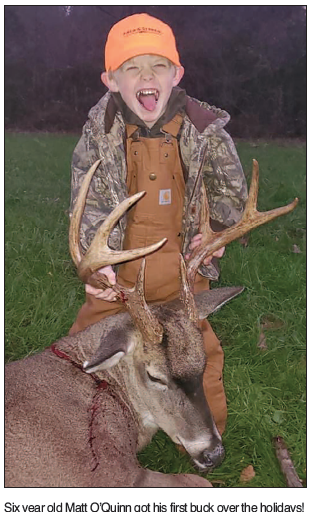
CWD detected in two additional northeast Mississippi counties
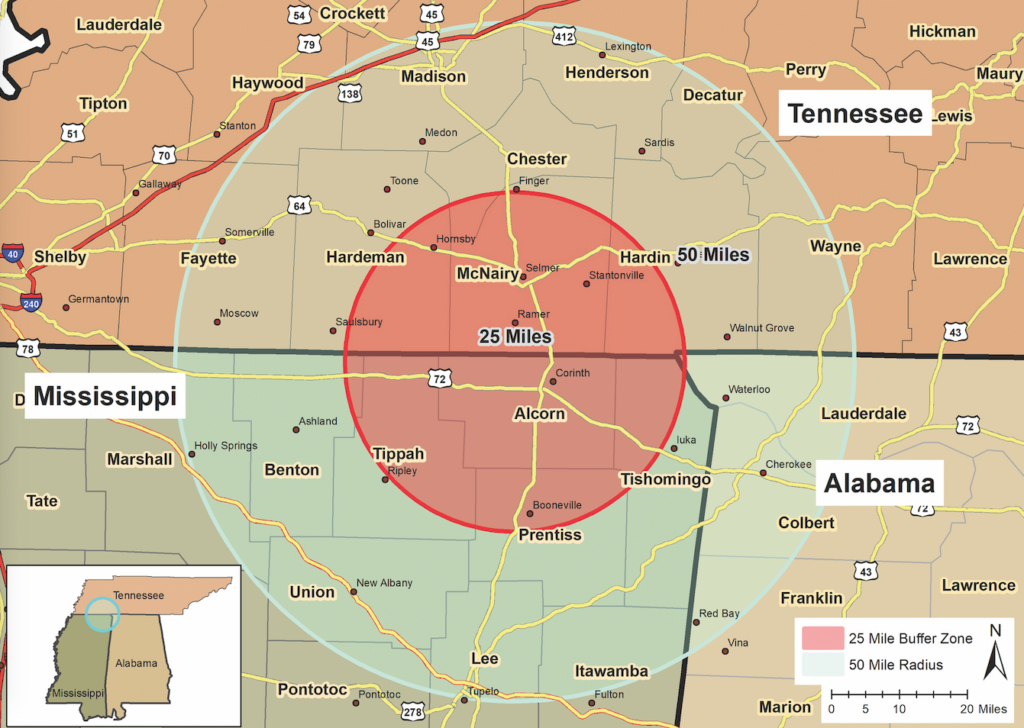
The Mississippi Department of Wildlife, Fisheries, and Parks (MDWFP) recently received “suspect positive” Chronic Wasting Disease (CWD) test results for two hunter-harvested bucks from Tippah and Alcorn counties in northeast Mississippi. These are the first CWD-positive detections for those counties. According to a press release from MDWFP, the samples will be sent to the National Veterinary Services Laboratory in Ames, Iowa, for final confirmation.
These are the first suspected CWD-positive cases in white-tailed deer within 25 miles of the Alabama state line. The Alabama Division of Wildlife and Freshwater Fisheries (WFF) has tested more than 11,000 deer since 2002. To date, CWD has not been detected in Alabama.
As part of WFF’s CWD Strategic Surveillance and Response Plan, CWD surveillance efforts were increased in Alabama after deer in Mississippi and Tennessee tested positive for the disease in 2018. That increased surveillance effort continues, including the collection of samples from hunter-harvested deer, road kill deer, and sick deer reported to WFF by the public.
Hunters are encouraged to utilize the self-service CWD sampling stations located throughout the state as part of WFF’s CWD surveillance effort. For an up-to-date map with directions to the CWD sampling stations and instructions on how to submit a sample, visit www.outdooralabama.com/cwd-sampling.
CWD is a neurodegenerative disease found in most deer species, including moose, elk, mule deer and white-tailed deer. It is infectious and always fatal. It is part of a group of diseases known as transmissible spongiform encephalopathies and is similar to mad cow disease in cattle and scrapie in sheep. These diseases cause irreversible damage to brain tissue that leads to salivation, neurological symptoms, emaciation and death of the animal.
Deer infected with CWD can spread the disease to other deer even before symptoms develop. It can take one to two years for infected animals to become symptomatic. When symptoms appear, they can include emaciation, lethargy and abnormal behavior. Other signs include excessive salivation, loss of appetite, progressive weight loss, excessive thirst and urination, and drooping head/ears.
More information on CWD can be found at www.outdooralabama.com/CWD-Info.
The Alabama Department of Conservation and Natural Resources (ADCNR) promotes wise stewardship, management and enjoyment of Alabama’s natural resources through four divisions: Marine Resources, State Lands, State Parks, and Wildlife and Freshwater Fisheries. To learn more about ADCNR, visit www.outdooralabama.com.
UWA’s Keener describes and names a new plant species after discoverer
Finzel’s Wild Ginger is only known from two populations in Alabama
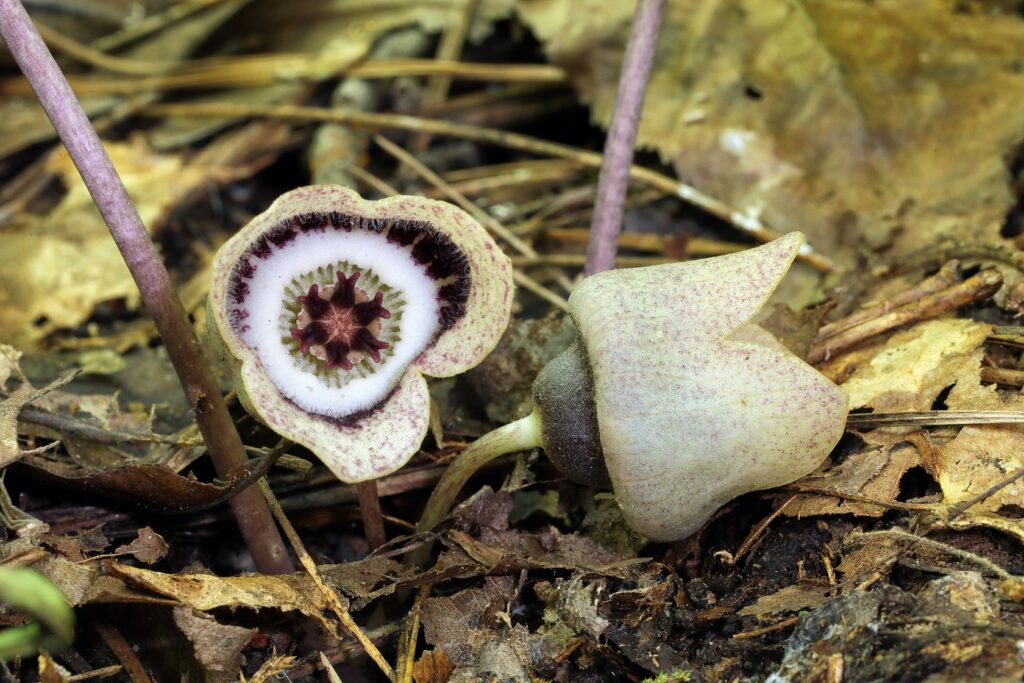
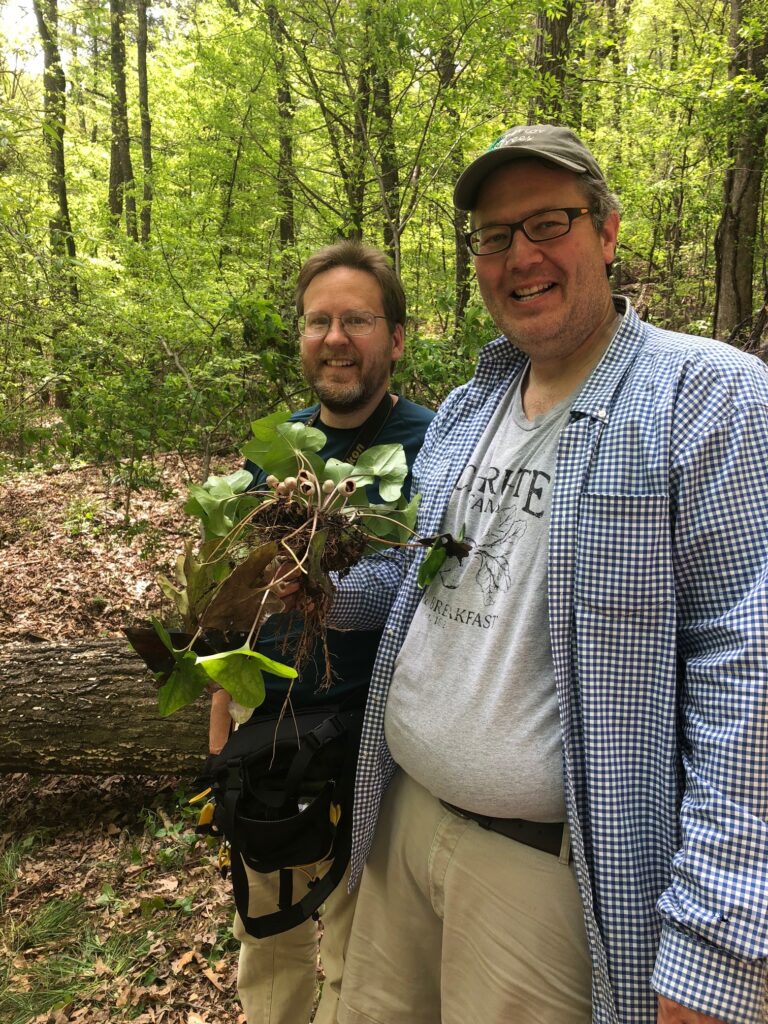
One of Alabama’s rarest vascular plant species has recently been named and described by University of West Alabama botanist Dr. Brian Keener. The new species was first discovered in 2019 by Huntsville resident Brian Finzel, a science teacher at St. John Paul II Catholic High School in Huntsville.
The new species of Hexastylis—H. finzelii—is known only from a single mountain in Marshall County, Alabama. In 2020, a second population was found just a couple of kilometers from the initial discovery. The findings were published in the December issue of the Journal of the Botanical Research Institute of Texas.
The species name pays tribute to Finzel, who made the discovery and contacted Keener for assistance in collecting and documenting the specimen. Outside the classroom, Finzel is a native plant enthusiast and nature photographer.
Finzel, discovered the species on a routine photography hike along the Tennessee River. He recognized something was odd which prompted him to contact Keener. “When he sent a text photo of the flower, I knew instantly I was looking an unnamed species,” Keener said.
“Finzel’s discovery of the first population of the new entity and dedication to systematic plant photography of the southeastern U.S. flora deserve commemoration,” Keener said. “The common name ‘Finzel’s Wild Ginger’ is a literal translation combined with laymen’s traditional vernacular of related species.”
Alabama is well-documented for high levels of biodiversity, with many species at risk. A different ginger, Alabama Ginger (Hexastylis speciosa) is currently under review by the U.S. Fish and Wildlife Service to be listed as a threatened or endangered species. According to Keener, H. finzelii is at risk, too.
“Ironically, H. finzelii is in much greater need of conservation efforts as the extremely narrow distribution makes it considerably more vulnerable than H. speciosa,” Keener said.
Keener is curator of the UWA Herbarium and director of the Alabama Plant Atlas. The original type specimen of H. finzelii will be housed within the herbarium made available digitally to future researchers through the Plant Atlas.
Learn more about H. finzelii https://journals.brit.org/jbrit/article/view/999/977
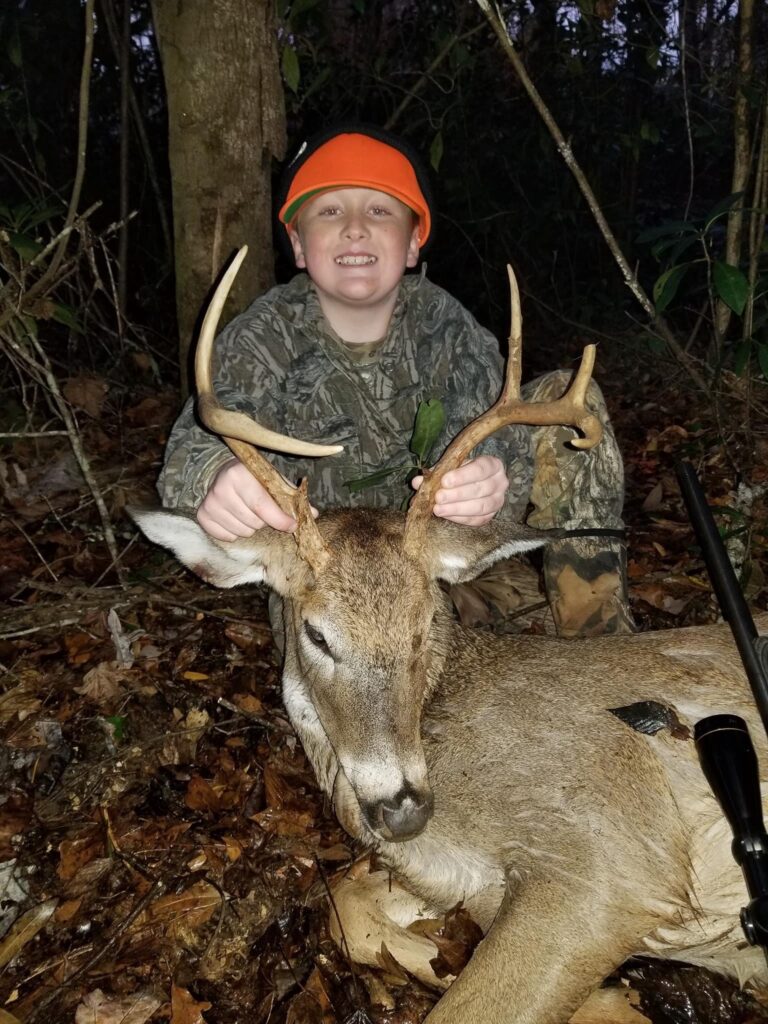
Big Buck Photo Contest kicks off in Black Belt
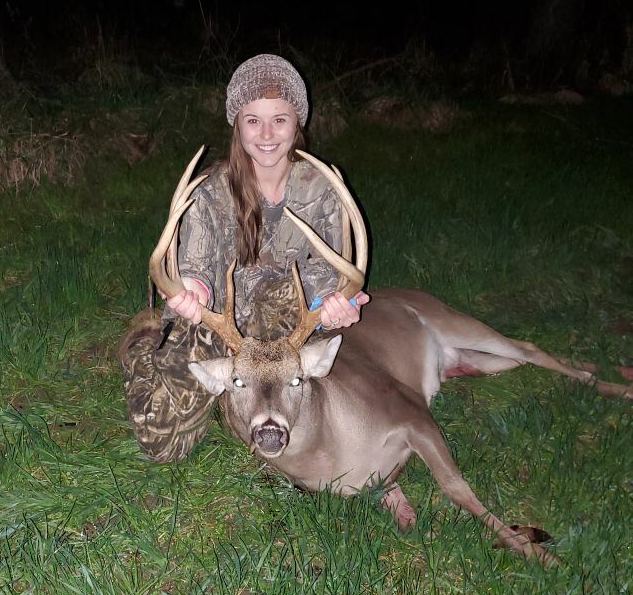
The annual Alabama Black Belt Adventures Association (ALBBAA) Big Buck Photo Contest, now in its ninth year, is officially under way.
“Deer hunting in Alabama, and especially in Alabama’s Black Belt, is a time-honored tradition that we are proud to promote through this annual competition,” said Pam Swanner director of the ALBBAA. “The real trophy is the time spent with family and friends making lifelong memories, so we want to encourage time afield in our bountiful and scenic region of the state.”
The photo contest winner will receive an original 16×20 whitetail deer photo mounted on canvas by award-winning and nationally credited wildlife photographer Tes Jolly along with a $100 gift card to Bass Pro Shops. Tes, owner of Jolly’s Outdoor Visions located near Tuskegee, Alabama is a freelance wildlife photographer and writer specializing in whitetail deer and wild turkey.
To enter, contestants must upload a photo of a buck harvested within the 23-county Black Belt region during the 2020-2021 whitetail deer season to AlabamaBlackBeltAdventures.org/bigbuckphotocontest. The entry that receives the greatest number of votes will be announced as the winner once the season closes on February 10, 2021. Photo contest winners from the previous two years are not eligible for entry. Votes are allowed once a day, per entry, per IP address.
Alabama features one of the longest whitetail deer seasons in the country that begins with bow season starting in mid-October followed by the opening of gun season on Saturday, November 21st in the majority of the state. The season closes on February 10th in the Black Belt.
Before heading to the woods, ALBBAA reminds all sportsmen and women to refer to the rules and regulations, and purchase a hunting license, through the Alabama Department of Conservation and Natural Resources (ADCNR) to support the important conservation work being done across the state. Hunters are also reminded to report their harvested deer via ADCNR’s Game Check.
The Black Belt includes the following counties: Barbour, Bullock, Butler, Choctaw, Clarke, Conecuh, Crenshaw, Dallas, Greene, Hale, Lee, Lowndes, Macon, Marengo, Monroe, Montgomery, Perry, Pickens, Pike, Russell, Sumter, Tuscaloosa and Wilcox.
WFF Reports No CWD Positives; Testing Continues
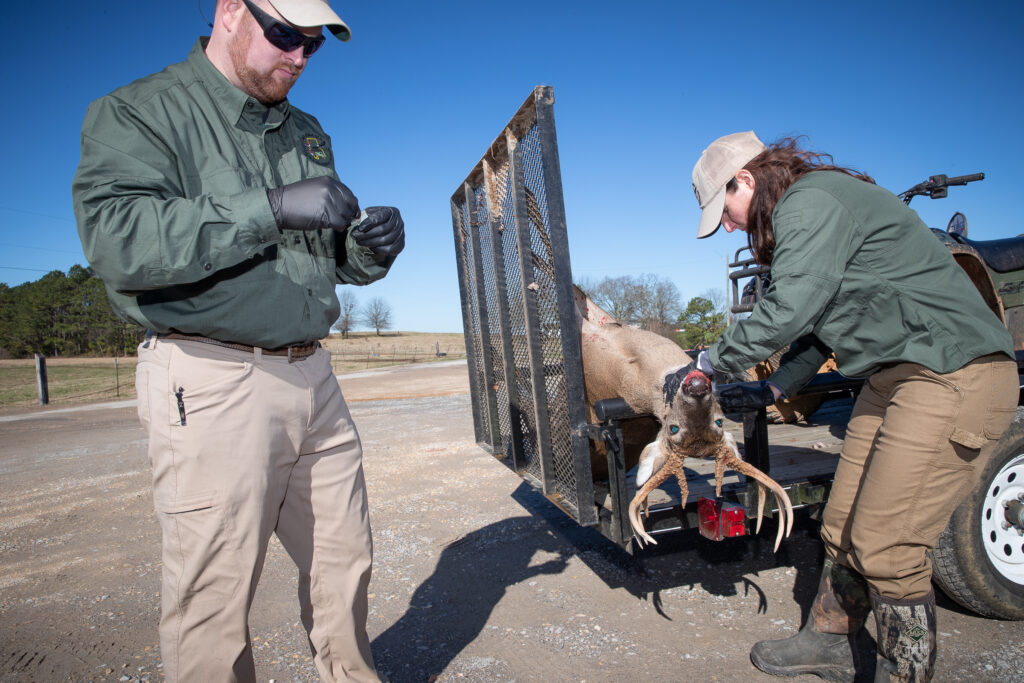
By David Rainer, Alabama Department of Conservation and Natural Resources
With the nation focused on the coronavirus, very little has been heard about the status of chronic wasting disease (CWD) in Alabama.
Chuck Sykes, Director of the Alabama Wildlife and Freshwater Fisheries (WFF) Division, has some cautious good news about the spread of CWD in the South.
“Despite what you read on Facebook, just because COVID-19 hit, CWD didn’t go away,” Sykes said. “We just haven’t been talking about it as much. We’re still taking samples. We had a target of about 1,630 samples last year, and I think we took nearly 1,700, covering all counties, with no positives.”
Last year, Mississippi and Tennessee reported new positive CWD tests. That cautious good news is the infections are not spreading toward Alabama.
“Right now, we’re staying basically status quo from last year,” Sykes said. “It looks like the cases in Tennessee and Mississippi are moving northwest. We have no new zones, nothing any closer than what we had last year. And nothing has tested positive in Alabama, so we’re on the same protocol as we were on last year.”
Visit www.outdooralabama.com/CWD-Info and scroll down the page to view the Alabama CWD Strategic Surveillance and Response Plan, which establishes a CWD Management Zone around the location of a CWD positive deer and implements specific response protocols dependent on the distance from the CWD positive. Positive deer in Pontotoc County, Mississippi, and Hardeman County, Tennessee, have prompted a response affecting Alabama’s surveillance activities. Portions of five counties in Alabama – Colbert, Franklin, Lamar, Lauderdale and Marion – are within 50 miles of those positives. Sampling and testing for CWD have been increased substantially in those counties.
CWD has only been shown to affect members of the deer family, including whitetails, mule deer, elk, moose and caribou. CWD is a fatal neurological disease, a form of transmissible spongiform encephalopathy (TSE), which causes lesions on the brain. As the disease progresses, the affected animal will develop holes in the brain and eventually die. Infected animals may be infected for 5 years or longer before they exhibit symptoms.
The first case of CWD was discovered in Colorado in 1967. The disease spread very slowly, only taking in a 15- to 20-county region on the Colorado, Nebraska and Wyoming borders in the next 30 years. In the late 90s, CWD was detected in Saskatchewan. That incident was traced to captive elk from South Dakota that were transported to Canada. CWD continues to spread and now has been found in 26 states and three Canadian provinces. South Korea, Finland, Norway and Sweden also have detected CWD. South Korea’s CWD-positive animals can be traced back to the live transport of captive deer from infected facilities in Saskatchewan. Over the past 20-plus years, the movement of live cervids or infected carcasses by humans has contributed significantly to the increased spread of the disease.
Regulations that banned the importation of live deer into Alabama have been in effect for many years. The regulations were amended a couple of years ago to prohibit the importation of deer carcasses from all states and countries. Visit www.outdooralabama.com/cwd for regulations about importing deer parts from out-of-state.
Regulations allow for the importation of certain parts of the deer but not whole carcasses. Permitted parts include:
- Meat from the family Cervidae (white-tailed deer, mule deer, elk, moose, fallow deer, red deer, sika deer, caribou, reindeer, etc.) that has been completely deboned
- Cleaned skull plates with bare attached antlers, if no visible brain or spinal cord tissue is present
- Unattached bare antlers or sheds
- Raw capes, if no visible brain or spinal cord tissue is present
- Upper canine teeth, if no root structure or other soft tissue is present
- Finished taxidermy products or tanned hides
The WFF Enforcement Section has also implemented procedures to intercept the potential illegal importation of deer carcasses into the state with surveillance along state borders in an effort to keep CWD out of the state. The “Don’t Bring It Home” campaign highlights the ban on the importation of deer carcasses.
The disease is primarily spread by body fluids such as saliva, urine and feces. The infectious agent, called a prion, can even survive outside the animal’s body.
No evidence exists at this time that CWD can be transmitted to humans. However, caution is recommended when consuming deer. The prion that causes CWD cannot be eradicated by cooking.
The CDC recommends that hunters who harvest deer in areas with CWD should have the deer tested for the disease before consuming the meat. If the test comes back as CWD detected, the CDC recommends the proper disposal of the venison. That venison should not be thrown out by the individual; rather, contact a WFF official or enforcement officer who will ensure its proper disposal.
Last year, WFF set up self-service stations with freezers for hunters to drop off deer heads for sampling and testing. At the self-service locations, hunters must first remove the deer’s head with 4-6 inches of neck attached. For bucks, antlers can be removed at the base of each antler or by removing the skull plate before bagging the head. Hunters will then place the head in the provided plastic bag and tie it closed. They will need to complete all sections of the Biological Sample Tag and attach the tag to the bag with a zip tie. Hunters should remove and keep the Biological Sample Receipt located at the bottom of the Biological Sample Tag before placing the bagged head in the freezer. All materials needed to drop off a sample are provided at each freezer location. Hunters can check the results of their test by visiting www.outdooralabama.com/cwd-sampling-results and entering the six-digit number found on the Biological Sample Receipt.
Visit www.outdooralabama.com/cwd-sampling for an interactive map of self-service locations throughout the state.
“We were a little disappointed about the number of samples dropped off at the self-service freezers last year,” Sykes said. “Hopefully this year it will be better. We’ve got good relationships with a lot of hunting clubs, processors and taxidermists that are helping us. A lot of our DMAP (Deer Management Assistance Program) participants are helping us. But it would be nice to get more random samples from the public.”
In 2018, WFF provided funds for the Alabama Department of Agriculture and Industries (ADAI) to purchase equipment to perform CWD testing. The equipment is housed at ADAI’s Thompson Bishop Sparks Diagnostic Laboratory in Auburn. The equipment and technician have been certified to test for CWD by the U.S. Department of Agriculture and can test up to 90 samples per day.
To assist with these efforts, WFF recently created the Sick Deer Report. The public can report deer acting abnormally or a deer that has died for no apparent reason at www.outdooralabama.com/wildlife-related-diseases/report-sick-deer or by calling one of WFF’s district offices. Reports should include contact information for the person making the report, location of the deer and the symptoms observed. A member of the WFF staff will follow up to determine what may have caused the illness or strange behavior and see if the deer should be tested for CWD. Visit www.outdooralabama.com/hunter-resources/law-enforcement-contacts for information on the five WFF district offices.
Research into CWD received a significant boost recently when the U.S. Congress passed America’s Conservation Enhancement Act. Included in that legislation is the creation of the National Chronic Wasting Disease Task Force within the U.S. Fish and Wildlife Service.
Feral Hog Population in Alabama Shows No Decline
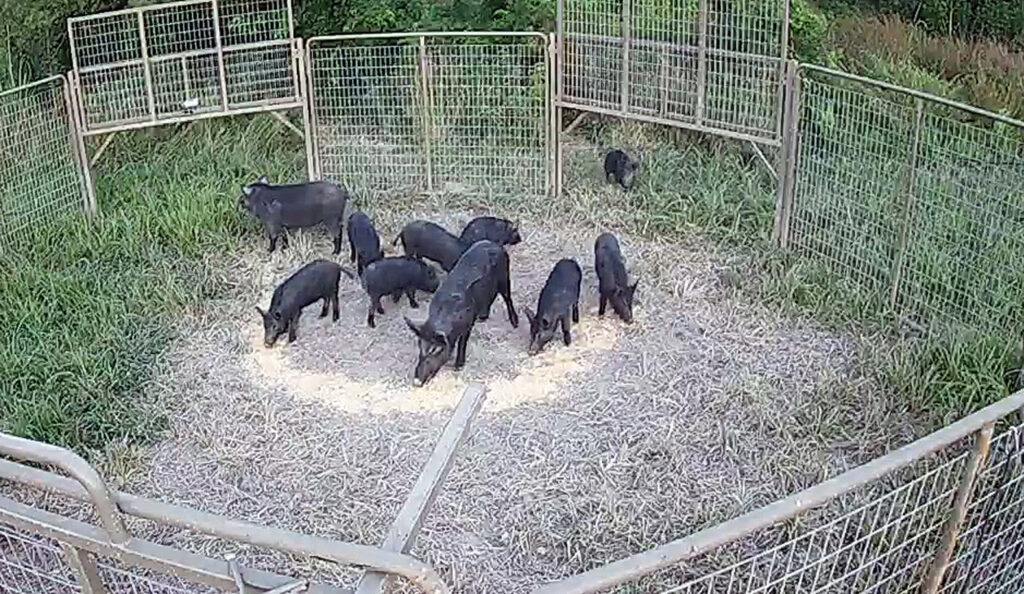
By David Rainer, Alabama Department of Conservation and Natural Resources
Despite an increased effort to mitigate the impact of feral hogs in Alabama, the hog population shows no indication of decline.
“Unfortunately, it appears their numbers are continuing to increase,” said Matt Brock, Technical Assistance Wildlife Biologist with the Alabama Wildlife and Freshwater Fisheries (WFF) Division. “I’m basing that on talking to people and on reports from areas that haven’t had hogs before.”
Brock is also basing that theory on the number of feral hogs harvested by hunters during the 2019-2020 season. Disturbingly, that total exceeded the number of white-tailed deer taken during the same period. According to the WFF’s annual hunter survey, it was estimated that about 218,000 deer were harvested. The number of feral hogs taken was estimated at about 255,000.
According to the U.S. Department of Agriculture (USDA), feral hogs cause more than $1.5 billion in damages to property, agricultural interests (crops and livestock), native wildlife and ecosystems as well as cultural and historic resources.
Brock said as part of the Farm Bill passed by Congress, a large, comprehensive program is underway in Alabama to try to stop the spread of feral hogs, particularly in areas of heavy agriculture. The USDA’s Natural Resources Conservation Service (NRCS) is conducting pilot projects in the Alabama Black Belt, the Wiregrass and on the Alabama Gulf Coast.
The Black Belt Project focuses on four watersheds covering almost 85,000 acres in Sumter County. The Wiregrass Project consists of 17 watersheds in Geneva, Houston and Henry counties. The Gulf Coast Project encompasses eight watersheds totaling almost 182,000 acres in Escambia and Baldwin counties.
The projects include purchasing feral hog traps with the latest technology, which allows the traps to be triggered remotely.
“They are trapping on the properties of private landowners with a long history of hog problems around agricultural areas,” Brock said. “They are offering this service to those private landowners in the designated watersheds and have hired several technicians to operate the traps.
“The end goal is not just to remove those hogs but to leave those landowners with the resources and knowledge to continue those trapping efforts once the pilot project ends. That’s a pretty big deal, getting that education out to the landowners to understand how to use the latest technology. I’m very glad to see that.”
One of the problems with feral hogs is the invasive species’ ability to rapidly reproduce. Brock said a typical litter is four to eight piglets, but he has heard of litters as large as 14. Some feral hogs can reach sexual maturity at six months. The gestation period is about 112 to 115 days.
“The sows will generally be close to weaning their litter before being bred again,” he said. “In theory, sows can have three litters every 14 months. Most of the time, they have one or two litters a year. Another thing is the piglets have a very high survival rate. They have very few predators because momma can be pretty aggressive toward anything that messes with her little ones.”
Brock said the bulk of today’s feral swine population in Alabama originated from hogs brought to America in the Mobile area by the Spanish in the early 1500s. He said he has seen some indication that some areas have hybrid stock that includes Eurasian wild boar characteristics.
“That area around Mobile is one of the first places in the United States to have hogs,” he said.
“It’s ironic to me that those hogs pretty well stayed in that drainage for about 400 years until we had gas-powered vehicles,” Brock noted, referencing the fact that the spread of feral hogs was very limited until humans started to transport the swine to other areas. Currently, feral hogs have been reported in all of Alabama’s 67 counties.
“A lot of their movement in the past 30 to 50 years has been in the back of a livestock trailer and then released,” Brock said of a practice that has been outlawed in the state.
“Now, once a hog becomes a person’s possession by either capturing or hunting, it cannot be released alive,” he said. “It must be killed on-site.”
Brock said before the COVID-19 restrictions, WFF partnered with other agencies to actively educate the public on the feral swine problem.
“We had landowner workshops planned that we had to cancel,” he said. “We are going to try to get those rolling again as soon as possible. I think the workshops go a long way in providing knowledge and resources landowners need to take care of some of these hog problems.”
Brock said the Alabama Department of Conservation and Natural Resources (ADCNR) has purchased several remote-activated traps that have been deployed on public lands – wildlife management areas (WMAs) and special opportunity areas (SOAs) with feral hog populations.
“Part of the management on those WMAs and SOAs with hog problems is to try to efficiently remove as many of those animals as quickly as possible,” he said. “This trap design can be extremely effective in accomplishing this.”
For the private landowners with hog problems, Brock said the NRSC also has a program that will help reimburse the cost of equipment and resources to deal with the hogs under certain conditions.
“If three landowners in close proximity sign up, the NRSC has some cost-share programs for those landowners to collectively purchase a trap,” he said. “The landowners have to document the hog damage before implementation of the program. Then after the trapping efforts, the landowners are reimbursed for a significant portion of the equipment.”
For more information regarding this program, contact your local NRCS office.
As shown by the harvest numbers, hunters obviously remove quite a few hogs annually from the landscape, but hunting has proven to be ineffective at reducing total numbers of hogs.
“The most efficient method at reducing the population in a certain area is to remove entire sounders (family group),” Brock said. “People who are using this remote-activated design trap are seeing effective population control as a result of whole sounder removal. That is the best method available.”
It’s also important when trapping to make sure the entire sounder is inside the enclosure when the trap is triggered.
“Hogs are highly territorial,” Brock said. “Older sows develop home ranges where they forage and take their young. If you can remove a group from one area and start going along the landscape, removing groups as you come to them, you are creating a void that no other hogs are in currently. Some people trap in a shotgun approach, but if you move along the landscape in a strategic fashion, you can do real well in removing sounders entirely. That is what we teach at the workshops.”
Brock said modern technology allows trappers to be much more efficient at removing sounders.
“Monitoring with cameras and live-stream video has completely changed the game,” he said. “I can’t stress enough the importance of monitoring to know what you’ve got. If you’ve got 100 hogs on the landscape and you catch 35 of them, you think you’ve done a really good job. But if you’re not monitoring them with cameras, you wouldn’t know you left 65 out there. Not only that, you also educated them.
“Cameras, especially with live-streaming, have really changed the game. When hogs come to the feed, they’re constantly moving, with some running others in and out of the trap. It’s a social hierarchy thing. With just still shots, some hogs may be outside the trap when you trigger it. With live-stream, you only have a one- to two-second delay when you drop the trap. You actually get to see what’s going on at the time you drop.”
For those who prefer to leave the hog removal to someone else, WFF has a list of nuisance trappers at www.outdooralabama.com.
For those who just need information on trapping hogs, WFF has a technical assistance biologist in each district who can provide assistance by assessing the hog damage to the property and recommending a trapping program.
Brock said landowners who provide the panels to build an enclosure can purchase a remotely activated gate for about $2,000. For a complete trapping unit, expect an outlay of between $5,000 and $10,000.
Hiring a professional feral swine trapper will run between $25,000 and $40,000 annually. That may seem like a lot, but Brock says you must keep costs in perspective.
“I had a farmer tell me, he estimated the hog damage in 2019 at $140,000,” Brock said. “He looked at what it was going to cost to hire someone to trap. It was $25,000 to $28,000. To him, that was a minor expense compared to that $140,000 loss.”
Focus on harvest safety this fall
Farmers in the Southeast are in the thick of harvest season, making safety more important than ever. Round-the-clock work and pressing time commitments are characteristic of harvest. The stress of these can wear down a person’s mental alertness of safety measures. One must think of safety at all times during harvest season.
“The first step is identifying where the danger points are,” said William Birdsong, an Alabama Extension agronomic crops regional agent. “Consider these points as any moving parts, though some are more dangerous than others.”
Birdsong considers power take off (PTO) shafts to be one of the most dangerous of these points. PTO systems operate many different pieces of harvest equipment, emphasizing the importance of safety awareness when around these. The best way to keep safe when using equipment with a PTO shaft is to keep protective guards in place over them.
Machinery is one of the more daunting aspects of harvest safety and by far one of the most important. By knowing how to stay safe around machinery, the likelihood of accidents during harvest goes down greatly.
Birdsong said turning off machinery while working on it is crucial. When working on an implement raised by the lift arms of a tractor, it is important to note that it is being raised by means of hydraulics. Birdsong emphasized to always be mindful of the possibility that hydraulic pumps and cylinders could fail. Therefore, when getting underneath an implement, avoid getting in a tight spot, where it is possible to get trapped underneath the implement.
Another machinery safety tip to remember is not to start the tractor from the ground but from the seat of the tractor itself. This can prevent accidents from occurring in which farmers find themselves in front of a running tractor.
One of the most important aspects of grain bin safety is the rule that no one should be allowed in a grain bin or on top of grain without a safety harness and someone spotting with a rope.
When working in grain bins, avoid getting near augers that are in operation moving grain. Protective guards should be in place on grain augers to prevent injury. Turn off all augers before trying to clear on or around them.
Pressure from deadlines and progress goals are often characterizing this time of year. Because of this, the worst thing that a farmer can do is get in a hurry. For more information on harvest safety, visit www.aces.edu or contact your county Extension office.
Wood Duck Mates Determine Migration Routes
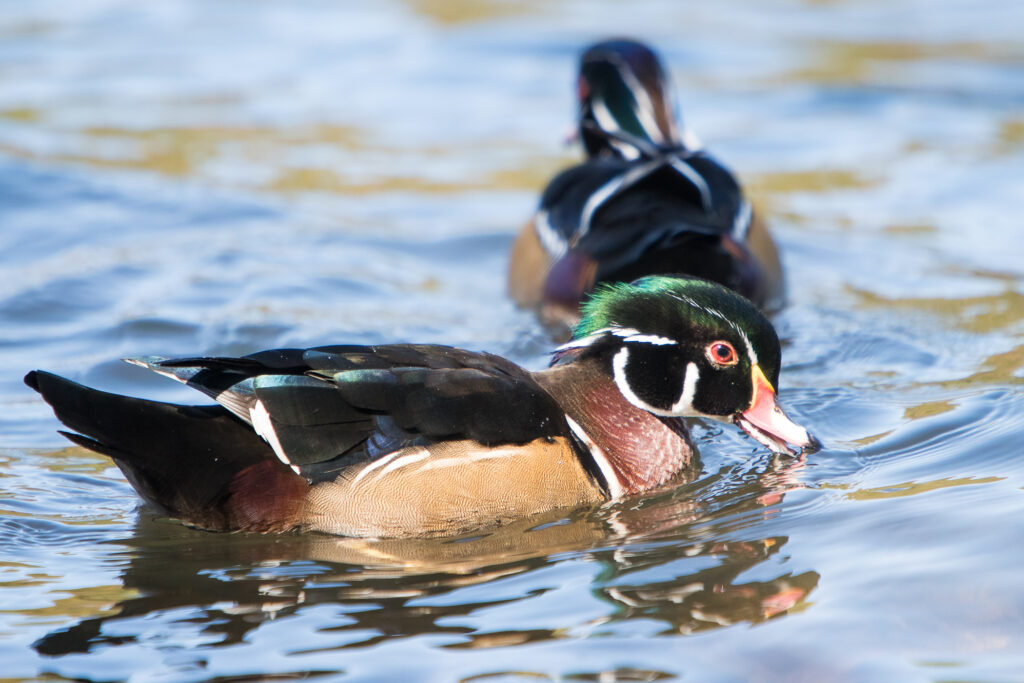
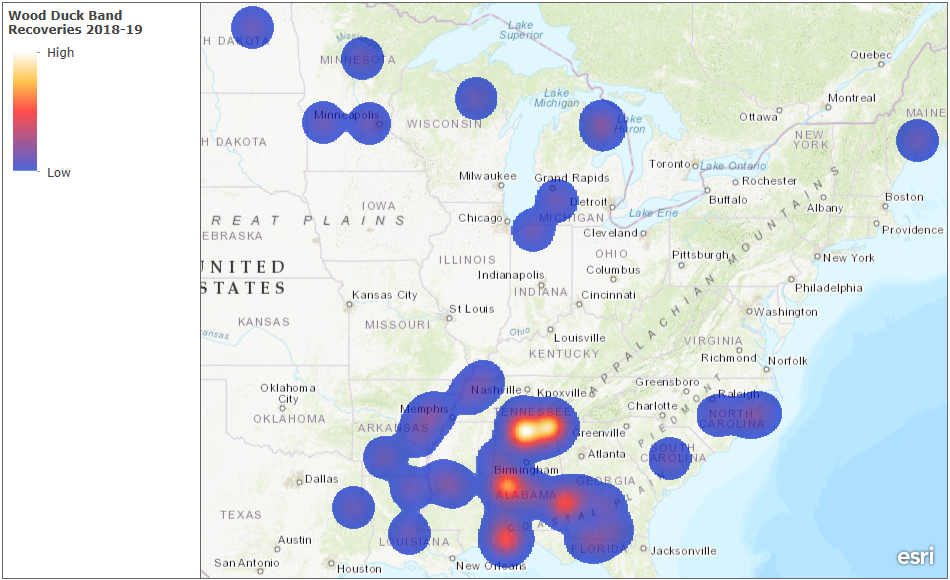
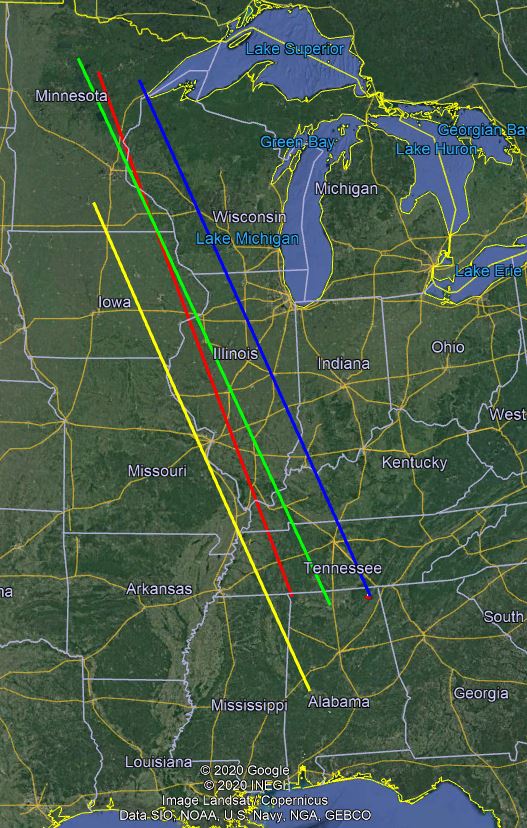
By David Rainer, Alabama Department of Conservation and Natural Resources
In the waterfowl world, Alabama’s most abundant species, the wood duck, is not known for migrating long distances.
It turns out, the wood duck migration patterns follow a “boy meets girl” scenario. Boy meets girl; girl flies home; boy follows.
When the Minnesota waterfowl season opened, four wood ducks that were banded in Alabama were harvested more than 1,000 miles from home.
Seth Maddox, the Alabama Wildlife and Freshwater Fisheries (WFF) Division’s Migratory Bird Coordinator, said one of the birds harvested in Minnesota was 6 years old, banded in 2014 as a hatch-year male. The other three were banded in recent years.
“What is interesting in our data is that our males, especially juvenile males, will pair up with migrant females and follow them back to their natal nesting ground,” Maddox said. “Our females tend to hang around where they were hatched. Whatever female a male pairs up with, he follows her.”
Alabama has been banding wood ducks since 1956. During that time, WFF has banded about 28,000 wood ducks. The band recovery rate is about 7.7 percent, which may seem low, but Maddox said that is about the national average for all banded waterfowl.
“We have recovered a little more than 2,100 bands,” Maddox said. “If you look at waterfowl overall, the band recovery is between four and five percent. Some birds are smarter than others, and others die before they are harvested. Recovery rate is pretty low for most species. About 50 percent of the wood duck bands are recovered in Alabama.”
Although the aforementioned birds traveled as far as Minnesota, Maddox said most wood ducks don’t make such a long journey.
“The states next to or near us harvest more than any other states,” he said. “We do get a good bit of band recovery in Georgia, South Carolina, Tennessee, Louisiana and Mississippi.”
While it’s fairly rare to have bands recovered as far away as Minnesota, Maddox said bands have been recovered in 30 different states since the program’s inception.
“We’ve had bands recovered from Maine to Florida, in Texas, North Dakota and three Canadian provinces – Manitoba, Ontario and Quebec,” he said. “More males are harvested out of state, which goes back to our males pairing up with migrant females. The males likely get killed near where the female is from or on the way back south during the next winter.”
Getting a firm count on the wood duck population is difficult for waterfowl managers because of the bird’s habitat preferences.
“We can’t count wood ducks from a plane like we do with other species,” Maddox said. “Wood ducks live in beaver swamps and wetlands. That’s why we have a banding program, so we can track harvest rates and survival and look at age ratios. With this data, we can assess what the population is doing so we can set seasons and bag limits because we can’t count them from the air.”
WFF’s banding work is conducted during the heat of the summer. Maddox said biologists look for a suitable clear spot on the edge of a pond or river. The ducks are baited with grain, and game cameras are erected to monitor the activity at the bait site over a two-week period.
A 30-foot by 60-foot rocket net is then set up and fired when the ducks congregate at the bait site. WFF officials remove the ducks as quickly as possible from the net and put them in crates before they start banding the birds.
“Our banding runs from July until the end of September each year,” Maddox said. “It’s a hot job, but it provides significant data. We age and sex the birds before we band them. We’re getting different ages because wood ducks in Alabama will nest up to three times a year. We’re getting adult males, adult females and three different ages of hatch-year birds.”
Maddox said mature wood duck hens will nest in February or March. The clutch of eggs will hatch in about 30 days.
“It takes about 45 days for those juveniles to fledge out and reach flight stage,” he said. “Then the hen will let that first clutch go, and she’s back on the nest.”
After WFF is finished with the banding efforts each September, the data is sent to the U.S. Geological Survey’s (USGS) Bird Banding Laboratory.
When hunters harvest a banded bird, the information should be reported to www.reportband.gov and it will enter the USGS’s band repository. The hunter will then receive a certificate of appreciation and information on where the bird was banded. WFF will receive a report from the USGS about where the bird was harvested.
“Overall, mallards are the most banded waterfowl species,” Maddox said. “You’re most likely to kill a banded mallard. Second most likely would be a banded wood duck.”
Alabama hunters will again have a daily bag limit of 6 ducks for the 2020-2021 season. That daily bag limit may include no more than 3 wood ducks, 4 mallards (no more than 2 of which may be females), 1 mottled duck, 2 black ducks, 1 pintail, 2 canvasbacks, 1 scaup, and 2 redheads. The daily bag limit for coots is 15 per day. The daily bag limit for mergansers is 5, only 2 of which can be hooded mergansers. The aggregate bag limit of 5 dark geese (Canada, White-Fronted and Brant) shall not include more than 3 Canada geese or 1 Brant. For light geese (Snow, Blue, Ross’s) the aggregate bag limit is 5. Possession limit is three times the daily bag limit.
Regular season dates for ducks, coots, mergansers and geese are November 27-28, 2020, and December 5-January 31, 2021. The Youth, Veterans and Active Duty Military Special Waterfowl Days are set for November 21, 2020, and February 6, 2021.
“Habitat conditions are looking good,” Maddox said. “It’s been a fairly wet spring and summer for us. There should be lots of water on the landscape and lots of food available. The hatch should have been good this year, so I think we’ll see plenty of wood ducks on Black Friday when the season opens this year.”
With the help of Ducks Unlimited (DU), Maddox said WFF is in the middle of a huge waterfowl habitat enhancement effort.
“This is the biggest undertaking of waterfowl projects the state’s ever done,” he said. “We started in 2019 and put together a list of 15 projects across the state. We’re going to put a little more than $1 million into habitat and restoration work on the wetland landscape in Alabama, from the Tennessee Valley all the way to the Mobile-Tensaw Delta.
“A lot of the projects involve replacing or restoring the water control infrastructure on some of our WMAs (wildlife management areas). We will restore some habitats that have been degraded over the years and putting that back in higher productivity for waterfowl. We will create a couple of new SOAs (Special Opportunity Areas) that will be available for limited-quota hunts for waterfowl in the future in Jackson County and Dallas County.”
Maddox said new pumps and water control gates are being installed at the Jackson County waterfowl area. New water control structures and levees are also under construction at the David K. Nelson WMA near Demopolis.
Survey work will be conducted for the projects that will begin next year at Swan Creek, Swan Creek Greentree Reservoir and in the Mobile-Tensaw Delta. The work includes replacing dilapidated water control structures as well as aerial spraying of herbicides in the Delta to control non-native invasive species like Chinese tallow (popcorn) trees and giant cut grass to restore historical open wetlands.
“DU has assisted us with previous projects and is a long-term cooperative partner in conservation,” Maddox said. “In addition, a lot of this would not be possible if hunters weren’t purchasing state duck stamps over the years. We don’t get any General Fund tax dollars, so all of this work is paid for through license sales, duck stamps, Pittman-Robertson Wildlife Restoration funds and partners like DU.”
“It’s good to see work being put on the ground through the use of these funds for the future of waterfowl in Alabama and waterfowl hunters across the state.”
Harvesting and Storing Pecans This Fall
By Victoria Dee
As leaves begin to darken and pumpkins decorate every doorstep, pecans are ripe and ready for harvest as fall settles in in the Southeast. These nutritious nuts are members of the hickory family and grow on towering shade trees commonly found in yards, orchards and pastures throughout Alabama. Though pecan harvest typically occurs from October to December, enjoying the bounty year-round is possible with proper harvesting and storing methods.
Harvesting Pecans
“Pecans are mature and ready to harvest any time after the shuck begins to open,” said Angela Treadaway, an Alabama Extension regional food safety and quality agent.
When these shucks are open, shaking or thrashing branches becomes an easy way to harvest nuts directly from the tree. Doug Chapman, an Alabama Extension regional commercial horticulture agent, offers another option for removal of pecans from tree limbs.
“While commercial growers use tree shakers, homeowners mostly can and do rely on natural drop from the tree,” Chapman said.
Beware of leaving nuts on the tree too long, however, as predators often want to harvest them for themselves.
If harvesting occurs early in the season, nuts will have a high moisture content, which would require drying before storage.
“Dry them in the shell in thin layers on elevated screens, or hang them in small mesh bags in a well-ventilated area at room temperature out of direct sunlight,” Treadaway said.
After approximately two weeks of drying, shell one or two and if the nuts are dry enough they should snap when bent. This indicates that they are ready for immediate use or for storage.
Storage
Because of their high oil content, pecans are perishable nuts. Proper storage is the best way to ensure good quality year-round.
“At home, unshelled pecans can be stored in a cool, dry place,” Treadaway said. “Shelled pecans should either be refrigerated or frozen.”
Storing pecans away from air and light is crucial. Vacuum sealed bags or jars allow for the best storage. After properly storing nuts frozen, thawing and refreezing can occur repeatedly for a period of two years without loss of texture or flavor.
Test stored nuts before using them in recipes. Rancid pecans have a bitter and oily taste. A dark color may also be a characterizing factor of rancid pecans. Make sure to discard any rancid nuts, as rancidity is not reversible.
More Information
For more information on harvesting and storing pecans, visit www.aces.edu or contact your local Extension Agent.
Don’t Get Complacent about Hunter Safety
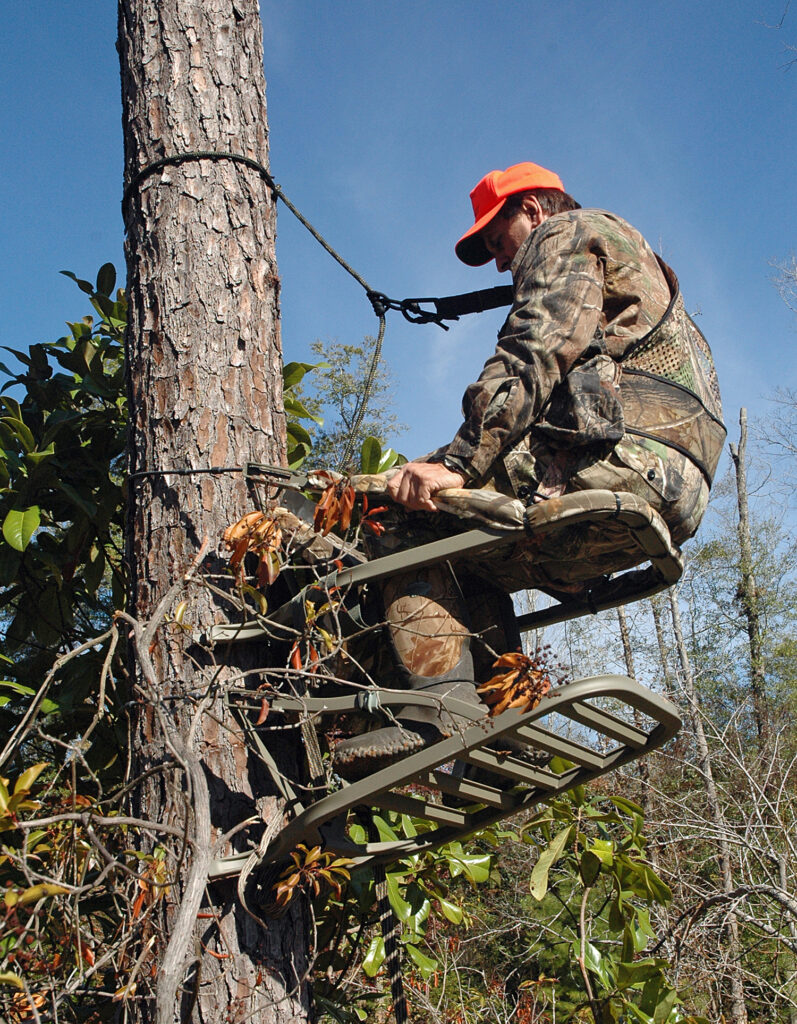

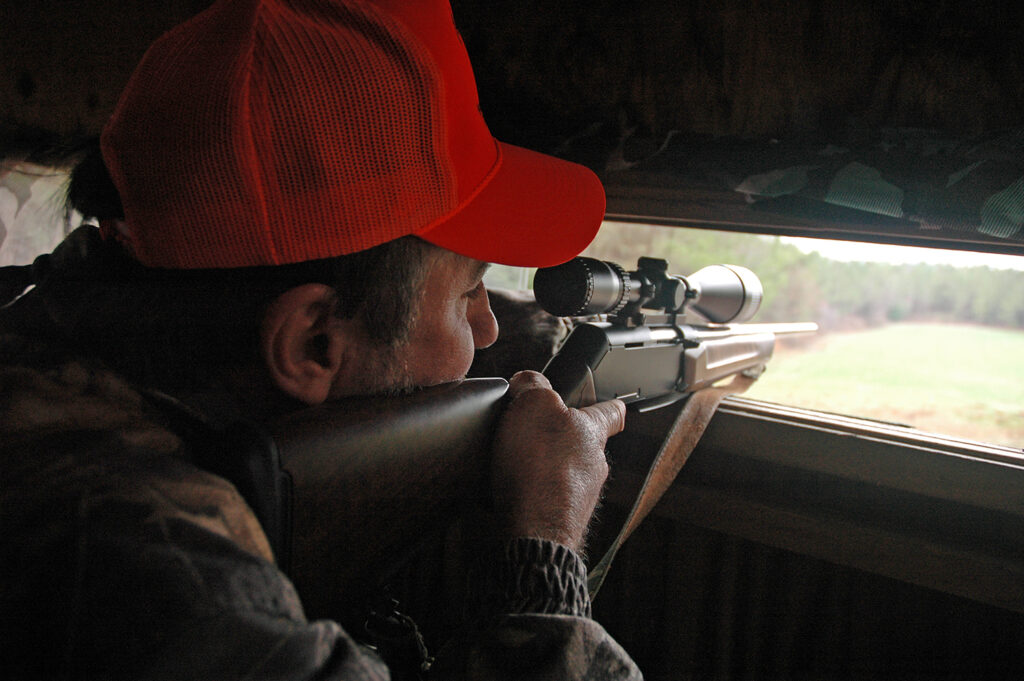
By David Rainer, Alabama Department of Conservation and Natural Resources
Although the number of hunting accidents has held steady for the last several years, Captain Marisa Futral doesn’t want Alabama’s hunters to take anything for granted during the state’s lengthy hunting seasons.
Futral, the Alabama Wildlife and Freshwater Fisheries (WFF) Division’s Hunter Education Coordinator, said accidents for the past five years have averaged about 20 per hunting season, which she considers encouraging but not the ultimate goal.
Of the 22 accidents during the 2019-2020 season, WFF staff had reports of eight non-fatal firearms accidents, one fatal firearms accident, 10 non-fatal treestand accidents and three fatal treestand accidents.
“Of our non-fatal firearms accidents, half of them were self-inflicted,” Futral said. “The other half was failure to properly identify the target. The one fatality was failure to identify the target during turkey season. We really need to emphasize properly identifying the target before you put your finger on the trigger.
“And don’t get complacent. One of the non-fatal firearms accidents occurred when the hunter tripped and shot himself in the foot. Hunters need to be constantly aware of the muzzle direction of their firearm. Of the 13 treestand accidents, the victims either weren’t wearing safety harnesses or they weren’t attached to the tree. You need to be attached to the tree the entire time you’re off the ground.”
Futral said she can’t stress that last statement enough about being attached to the tree with a safety line from the time your feet leave the ground climbing until your feet touch the ground descending.
“A wide variety of accessories is available to ensure you are attached to the tree at all times,” she said. “Harnesses are much more comfortable than they were 10 years ago. They are easy to put on and are lightweight.”
Of the three treestand fatalities, Futral said the cause of one accident in Jackson County could not be determined. One fatal accident occurred in Fayette County when the victim fell out of his stand, and the other fatality occurred as the hunter was climbing down out of the stand.
Several non-fatal treestand accidents involved failures of straps or other parts of the treestand.
“Always check the condition of your treestands before you attempt to climb,” Futral said. “Treestands left out in the weather can deteriorate quickly.”
WFF Hunter Education urges all hunters to follow 11 guidelines for using a treestand safely:
Always wear a safety harness, also known as a fall-arrest system, when you are in a treestand, as well as when climbing into or out of a treestand. Statistics show that the majority of treestand incidents occur while climbing in and out of a stand.
A safety strap should be attached to the tree to prevent you from falling more than 12 inches.
Always inspect the safety harness for signs of wear or damage before each use.
Follow all manufacturer’s instructions for use of a safety harness and stand.
Follow the three-point rule of treestand safety. Always have three points of contact to the steps or ladder before moving. This could be two arms and one leg holding and stepping on the ladder or one arm and two legs in contact with the ladder before moving. Be cautious that rain, frost, ice or snow can cause steps to become extremely slippery. Check the security of the step before placing your weight on it.
Always hunt with a plan and, if possible, a buddy. Before you leave home, let others know your exact hunting location, when you plan to return and who is with you.
Always carry emergency signal devices such as a cell phone, walkie-talkie, whistle, signal flare, PLD (personal locator device) and flashlight at all times and within reach even while you are suspended in your fall-arrest system. Watch for changing weather conditions. In the event of an incident, remain calm and seek help immediately.
Always select the proper tree for use with your treestand. Select a live, straight tree that fits within the size limits recommended in your treestand’s instructions. Do not climb or place a treestand against a leaning tree.
Never leave a treestand installed for more than two weeks since damage could result from changing weather conditions and/or from other factors not obvious with a visual inspection.
Always use a haul line to pull up your gear and (unloaded) firearm or bow to your treestand once you have reached your desired hunting height. Never climb with anything in your hands or on your back. Prior to descending, lower your equipment on the opposite side of the tree.
Always know your physical limitations. Don’t take chances. Do not climb when impaired by drugs, alcohol or if you’re sick or fatigued. If you start thinking about how high you are, stop climbing.
“It’s so easy to get complacent,” Futral said. “Your family wants you to come home from the hunt safely. Even if you’ve been doing this your whole life, take that extra minute to be safe. Make sure you’re hooked to the tree. Unload your firearm when you cross the fence. If you think it’ll be okay, ‘just this once.’ Don’t do it.”
The one firearm fatality occurred in Jefferson County when the hunter failed to properly identify the target during turkey season and shot a member of the hunting party.
Futral stresses the 10 commandments of firearms safety:
Treat every firearm as if it is loaded.
Control the muzzle of your firearm. Keep the barrel pointed in a safe direction. Never point a firearm at anything that you do not wish to shoot, and insist that your shooting and hunting companions do the same.
Be sure of your target and beyond. Positively identify your target before you fire, and make sure no people, livestock, roads or buildings are beyond the target.
Never shoot at water or a hard, flat surface. A ricocheting bullet cannot be controlled.
Don’t use a scope for target identification; use binoculars.
Never climb a tree, cross a fence or jump a ditch with a loaded firearm.
Store guns and ammunition separately. Store firearms under lock and key, and use a gun case to transport firearms.
Make sure your barrel and action are clear of all obstructions.
Unload firearms when not in use. Never take someone else’s word that a firearm is unloaded. Check yourself.
Avoid drugs and alcohol when hunting or shooting. Even some over-the-counter medicines can cause impairment.
Despite the accidents, hunting remains one of the safest recreational activities available. According to American Sports Data and the National Shooting Sports Foundation, hunting ranks lower than basketball, football, tennis, cheerleading, bicycling, golf, and even bowling in the total number of injuries per 100 participants.
Responsible hunters who mentor others in the aspects of safety, as well as the many volunteer hunter safety instructors around the state, have contributed to the high safety record for those who enjoy the great outdoors during the hunting seasons in Alabama.

New Indiana Bat Hibernaculum Discovered in Alabama

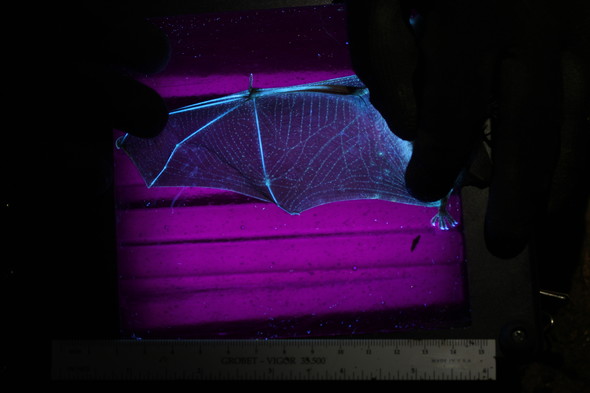
Biologists have recently discovered a new Indiana bat hibernaculum (a shelter occupied by hibernating bats) in Alabama, bringing the known number of active Indiana bat caves in the state to four. The location is the southernmost known hibernaculum for the species across its range that extends north to Canada.
“The Indiana bat is exceedingly rare in Alabama, and this new discovery continues to improve our understanding of this endangered species in the state,” said Nick Sharp, Nongame Wildlife Biologist with the Alabama Department of Conservation and Natural Resources’ (ADCNR) Division of Wildlife and Freshwater Fisheries (WFF). “In 2017, researchers also discovered the southernmost known Indiana bat summer maternity colonies in the forests of the Oakmulgee Ranger District (Talladega National Forest) near Tuscaloosa.”
The newly identified hibernaculum is located in Shelby County, Alabama, and is closed to the public.
This is the same site where biologists identified a Southeastern bat infected by White-Nose Syndrome (WNS) in 2017. A specimen was collected at that time, and the infection was confirmed by the U.S. Geological Survey’s (USGS) National Wildlife Health Center. An ADCNR press release later that year announced the first Southeastern bat confirmed with WNS in the U.S., adding the species to the list of 13 other bat species known to be susceptible to the disease.
A separate bat research project conducted by the USGS National Wildlife Health Center has discovered that the WNS infected bat from Shelby County was misidentified in 2017. It is now believed the WNS infected bat was an Indiana bat. Additional research also suggests the Southeastern bat may be resistant to WNS.
Dr. Jeff Lorch with the USGS National Wildlife Health Center has developed methods to identify North American bats based on their DNA. Many bat species, including the group to which the Indiana bat and Southeastern bat belong, are challenging to identify based on their outward appearance. The use of DNA sequencing helps distinguish between bat species that outwardly look very similar.
When Dr. Lorch examined the DNA of the bat identified as the first Southeastern bat infected with WNS, he discovered its DNA matched that of Indiana bats and not Southeastern bats. He consulted with the biologists who collected the bat, but a re-evaluation of the bat’s external characteristics could not confirm the identity of the species.
In March 2020, biologists returned to the Shelby County location to conduct a new survey of its bat population. To assist in identifying Indiana bats, Darwin Brack, a field biologist with Environmental Solutions and Innovations in Ohio, also took part in the survey due to his extensive experience with the species.
The new survey identified 70 Indiana bats in the cave, the largest concentration of Indiana bats now known in Alabama. The Indiana bats were found in the same location where the WNS infected specimen was taken, in a cold-air sink within the cave. Southeastern bats were also present in the cave, but only found in an upper, warmer part of the cave. Gray bats were also hibernating in the cave.
“We now believe the bat confirmed with WNS was an Indiana bat and not a Southeastern bat,” said WFF’s Nick Sharp. “At this time, there is little evidence to suggest Southeastern bats are susceptible to WNS.”
Since the Southeastern bat was misidentified in 2017, WFF biologists have collaborated with Dr. Joe Johnson of Ohio University and Dr. Andrew Edelman of the University of West Georgia to investigate the susceptibility of Southeastern bats to WNS. Some bats can carry Pseudogymnoascus destructans (Pd), the fungus that causes WNS, but not become infected with the disease.
In 2018, 62 bats from the Shelby County location and one other cave in the region were examined for the presence of Pd and WNS infection. The bats’ wings were photographed under a UV light, which causes tissue infected with Pd to fluoresce. The wings were then swabbed to collect DNA evidence of the fungal pathogen. Lab results from the swabs showed 56 of the bats tested positive for the presence of Pd. However, no bats exhibited fluorescence indicating WNS infection when photographed under the UV light, suggesting Southeastern bats may be resilient to WNS.
WNS has killed more than 6 million bats in North America. Before WNS was discovered in Alabama, more than 300 Indiana bats were known to hibernate within the Sauta Cave National Wildlife Refuge in Jackson County. In 2019, only 19 Indiana bats were counted at Sauta Cave.
The continuing effort to monitor WNS in Alabama is conducted through a collaboration between WFF and its partners including the USGS, U.S. Fish and Wildlife Service, Environmental Solutions and Innovations, Southeastern Cave Conservancy, Copperhead Environmental Consulting, Ohio University and the University of West Georgia.
The Alabama Department of Conservation and Natural Resources promotes wise stewardship, management and enjoyment of Alabama’s natural resources through four divisions: Marine Resources, State Lands, State Parks, and Wildlife and Freshwater Fisheries. To learn more about ADCNR, visit www.outdooralabama.com.
Physically disabled hunt dates announced for field trial area
The M. Barnett Lawley Forever Wild Field Trial Area (FWFTA) in Hale County, Alabama, will host a series of deer hunts for hunters with physical disabilities from late November 2020 through January 2021. To register for the hunts, call (334) 289-8030 starting October 1, 2020.
“Access to outdoor activities such as hunting should be available to everyone who has an interest,” said Chris Blankenship, Commissioner of the Alabama Department of Conservation and Natural Resources (ADCNR) and Chairman of the Forever Wild Board of Trustees. “We are honored to provide hunting opportunities for all Alabamians including those with physical disabilities.”
Hunt availability is limited and will be assigned on a first come, first served basis. Hunters are limited to registering for only one hunt for the season and must bring an assistant to help with the hunt. Hunters will need a hunting license and Conservation ID number prior to registering.
FWFTA physically disabled hunt dates
November 25, 28
December 23, 30
January 2, 6, 9, 13, 16, 20, 27, 30
Hunters with physical disabilities are required to fill out a Disabled Hunter Permit Application prior to the hunt dates. The permit can be downloaded from the “Physically Disabled Hunting Areas” section of www.outdooralabama.com/hunting/where-hunt-alabama.
All deer harvested during the FWFTA physically disabled hunts must be reported via Alabama’s Game Check system. Hunters will have 48 hours to Game Check their harvest through the Outdoor AL mobile app or online at www.outdooralabama.com.
If you have questions about the FWFTA physically disabled hunts, please call or email Evan Lawrence with the ADCNR State Lands Division at (334) 353-7909 or [email protected].
The M. Barnett Lawley Forever Wild Field Trial Area consists of 4,300 acres in Hale County and is managed as a nature preserve and recreation area. In addition to developing a sporting dog test ground and a youth hunting program, the ADCNR State Lands Division is currently restoring the tract’s native prairie grasslands and managing its numerous ponds for public fishing events.
The Alabama Department of Conservation and Natural Resources promotes wise stewardship, management and enjoyment of Alabama’s natural resources through four divisions: Marine Resources, State Lands, State Parks, and Wildlife and Freshwater Fisheries. To learn more about ADCNR, visit www.outdooralabama.com.
 WFF Cautiously Optimistic About Spread of Silver Carp
WFF Cautiously Optimistic About Spread of Silver Carp- By DAVID RAINER, Alabama Department of Conservation and Natural Resources (ADCNR)
- Chris Greene is cautiously optimistic that an invasive fish species that can wreak havoc on reservoir ecosystems has not expanded its range in Alabama’s waterways.The silver carp, which has done noticeable damage in Kentucky and Tennessee waterways, has been found in Alabama’s Pickwick and Wheeler reservoirs.Thankfully, the feared spread of the fish, highlighted in numerous YouTube videos for jumping when startled by boaters, has not materialized, said Greene, Chief of Fisheries for ADCNR’s Wildlife and Freshwater Fisheries (WFF) Division. Only Pickwick has a moderately abundant population of silver carp, and Greene hopes that population stays contained to that reservoir.“We’re relatively new to this situation,” said Greene. “Silver carp haven’t been in Alabama for very long. We’ve only had federal funding specific to Asian carp work since October of 2019, so we’re still in our first year of funding. So far, work has involved the acquisition of field gear, sampling equipment and staff training. We’re still awaiting our primary sampling boat, which we hope to get this fall and do more intense field sampling.”When the new boat arrives, Greene said it will allow WFF personnel to target the collection of silver carp to determine population dynamics.“We’ve been sampling with our standard shock boats,” he said. “The new boat will be more specialized with a rectangular frame and net attached to the front of the boat where you can actually trawl through the water. It will still have electrodes hanging down like a standard electrofishing boat. So, you’re moving through the water collecting carp in areas where they tend to congregate.“It’s a learning experience. We’re learning from other states like Kentucky and Tennessee. They have been doing this a whole lot longer than us. Hopefully what we learn from them will make our sampling more effective.”Because of the abundance of silver carp in their rivers and reservoirs, Kentucky and Tennessee rely heavily on commercial anglers to remove silver carp from their systems. Greene said those states even subsidize commercial anglers to remove silver carp to make it economically feasible.The good news for Alabama is silver carp have had a limited range since the first one was detected in state waters about five years ago.“Our limited field sampling has not yielded any silver carp outside of Pickwick Reservoir in Alabama,” Greene said. “From what we have been able to determine from angler catches, the farthest upstream location where silver carp have been confirmed by a commercial fisherman in Alabama is Wheeler Reservoir.“Angler reports have been infrequent in Alabama. Most of those have come from Pickwick Reservoir. So, we believe the leading edge of where we have a moderately abundant population is Pickwick.”Greene said WFF Fisheries encourages anglers to report any silver carp catches or sightings.“We ask any anglers who are out on the water to let us know if they see a silver carp,” he said. “They are our eyes out there. We can’t always be on the water, so we ask anglers who see any silver carp or bighead carp, please report those to [email protected].”Greene asks that reports, locations and photos of silver and bighead carp be sent to that email address.In an effort to deter the spread of the invasive fish, the Alabama Department of Conservation and Natural Resources (ADCNR) issued a new Wild Baitfish Regulation that deals with the capture of live bait in Alabama waters and restricts the movement of that bait to other water bodies.“We enacted a regulation in Alabama to reduce the spread of Asian carp,” Greene said. “Young Asian carp closely resemble other live baitfish that are commonly used by anglers – skipjack herring, gizzard shad and threadfin shad. If we have anglers going out throwing cast nets and catching several species and taking these to other water bodies, it could increase the spread of Asian carp.”The regulation states that if anglers catch bait on a specific body of water, that bait cannot be transported live to another body of water. It also restricts the import of live, wild-caught baitfish from other states.The Tennessee Valley Authority (TVA) is considering several methods to control the spread of Asian carp, including fish barriers at 10 locks controlled by the TVA. One type of fish barrier under consideration is a Bioacoustics Fish Fence (BAFF), which utilizes a combination of sound, light and air bubbles. This type of barrier is installed at Barkley Lock and Dam in Kentucky and is currently being studied for its effectiveness in deterring Asian carp. Other types of barriers used for Asian carp include the use of carbon dioxide or electricity. TVA is conducting environmental impacts on the deterrents to minimize the impact on native species.TVA is also considering adjusting river flow rates during potential Asian carp spawning periods, which are usually during high-water events. Studies have shown that Asian carp eggs are only semi-buoyant and will sink to the bottom and die with low river flow.“For those eggs to mature, there must be long stretches of flowing water from larger tributaries,” Greene said. “You have this series of dams on the Tennessee River, so it really doesn’t provide the habitat requirements for the eggs to mature and develop. But some of the major tributaries on the Tennessee River have long flowing stretches. The concern is if carp get up into these tributaries and we have a weather year with a good amount of rain, the potential does exist in certain places.”Silver carp have been compared to feral hogs in the damage done to an ecosystem. Feral hogs outcompete native wildlife for food and habitat resources. When silver carp become established in an area, they interrupt the natural food chain and native species end up negatively impacted.“Silver carp are filter feeders,” Greene said. “They are planktivores. They filter out plankton throughout the water column. This puts them in direct competition with baitfish and young game fish as species like bass and crappie are planktivores in their early life stages. There’s more competition at the base of the food chain. It also affects baitfish species as adults. You’ve only got so much biomass that particular water body can support. The more taken up by Asian carp, the less will be taken up by the native species.“The problem with silver carp is once they come into a water body, it becomes a management issue. You never really get rid of them. It’s like feral hogs. You just have to manage them. You can never fully eradicate them.”As the boaters and anglers saw in the aforementioned videos, silver carp also pose a safety issue for recreational activities on the waterways.“Once silver carp get scared, they jump out of the water, which can be hazardous for someone in a bass boat or on a jet ski,” Greene said. “It’s definitely a safety concern.”Alabama continues to work with the Tennessee Wildlife Resources Agency and the Mississippi Department of Wildlife, Fisheries and Parks to collectively manage the spread of silver carp. Joining the fight on a larger scale is a multistate group called the Mississippi Interstate Cooperative Resources Association (MICRA), which includes the 28 states in the Mississippi River basin. The U.S. Fish and Wildlife Service, U.S. Geological Service, TVA, U.S. Bureau of Reclamation and two Native American tribes are also members of the coalition.Several years ago, Tennessee Tech received federal funding to monitor numerous lakes, including Pickwick, for silver carp. One of the goals has been to catch silver carp and insert sonic tags to allow tracking of the fish’s movements.“Tennessee Tech is still doing the tagging studies, and they’ve even got detectors set up on some of the TVA locks in Alabama,” Greene said. “From my understanding, none of the silver carp they’ve tagged in Pickwick and other places have gone through any of the locks in Alabama. At least that was the case just a few weeks ago.“To date, we have not had any confirmed reports of silver carp in Guntersville Reservoir or Wilson Reservoir. We certainly hope it stays that way.”Greene said concerned anglers and those interested in mitigating the damage done by invasive species can help by purchasing the Alabama freshwater fishing distinctive license plates, which recently received a new design.“Proceeds from the sales of this license plate are earmarked for specific purposes, and one of those is the control of aquatic invasive species, including Asian carp,” he said. “We’re excited about this.”
Youth Hunt Dates Announced for Forever Wild Field Trial Area
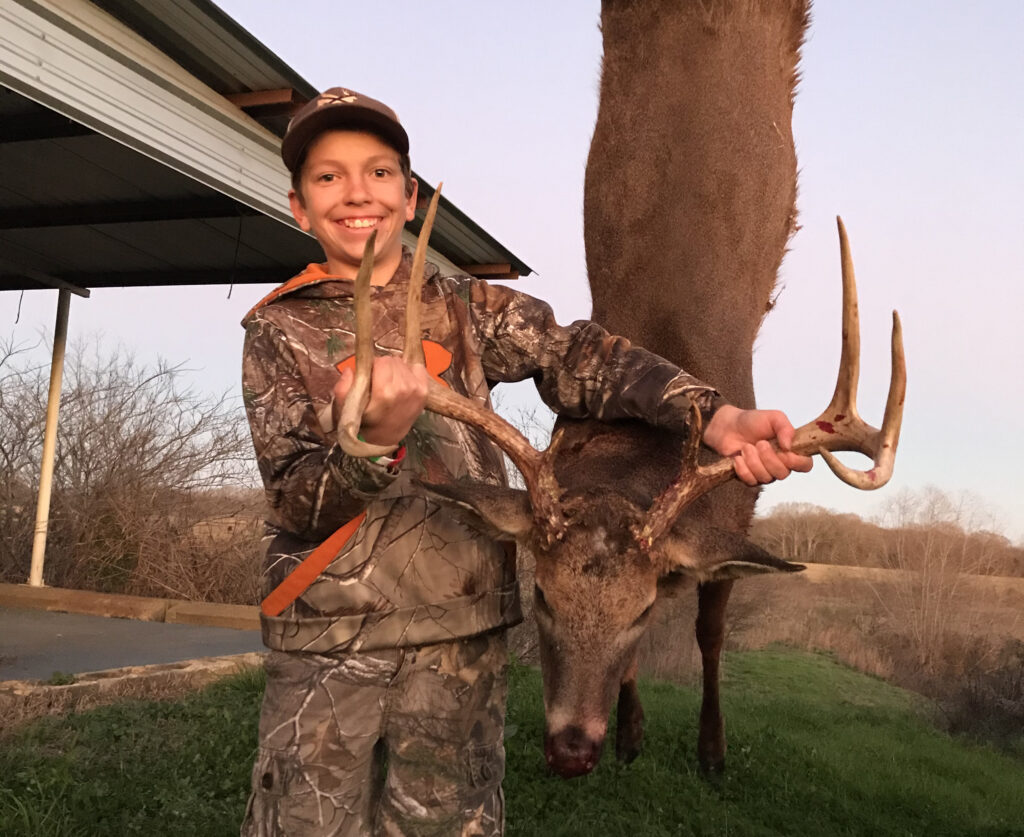
The Alabama Department of Conservation and Natural Resources’ (ADCNR) State Lands Division announces the youth deer and duck hunt schedules for the M. Barnett Lawley Forever Wild Field Trial Area (FWFTA) in Hale County. The hunts will take place late November 2020 through January 2021. Registration will open September 14 through November 1, 2020. Hunters will be selected via a computerized, random drawing after registration closes.
“I am thrilled that we will have an opportunity again this year to introduce youth to the great deer and duck hunting on this Forever Wild property,” said Chris Blankenship, ADCNR Commissioner and Chairman of the Forever Wild Board of Trustees.
Brandon Smith from Jemison, Alabama, took his 12-year-old son, Cade, on a FWFTA youth deer hunt in January 2020. The time spent in the outdoors with family was a highlight of their experience.
“Cade loves the outdoors, hunting and fishing,” Smith said. “He was chosen for a youth deer hunt at the Field Trial Area and was able to take an 8-point buck. Spending time outdoors with my kids is all about making memories. This hunt was definitely a memory maker.”
Smith said they plan on hitting the woods again this fall.
Youth Deer Hunt Dates
• November 25, 28
• December 23, 30
• January 2, 6, 9, 13, 16, 20, 27, 30
Youth Duck Hunt Dates
• November 28
• December 23, 30
• January 2, 6, 9, 13, 16, 20, 27, 30
To register for a hunt, visit https://publichunts.dcnr.alabama.gov/Public/AvailableHunts during the registration period listed above.
Registration for the FWFTA youth hunts is only available to parents or adults who are at least 21 years old and have a Conservation ID number. A hunting license is not required at the time of registration. However, if selected during the random draw, you must have a valid hunting license to accept the hunt permit. If selected for a hunt, you will receive an email requesting that you validate/accept the permit. Once the permit is accepted, you will receive an email with the hunt details.
To participate in the youth hunts, youth hunters must be age 15 or younger and accompanied by an adult at least 21 years old (or a parent). Adults must have a valid state hunting license and applicable duck stamp, if duck hunting. Hunters must obtain their license and duck stamp (if duck hunting) before the hunt since they will not be available on-site. Licenses are available for purchase at various retailers throughout the state or online at www.outdooralabama.com.
All deer harvested during the FWFTA youth hunts must be reported via Alabama’s Game Check system. Hunters have 48 hours to Game Check their harvest through the Outdoor AL mobile app or online at www.outdooralabama.com.
In addition to being required when registering for the FWFTA youth hunts, a Conservation ID number is the fastest and easiest way to report a deer or turkey harvest. This number is unique to each hunter and can also be used to purchase future licenses, obtain Harvest Information Program (HIP) permits, register for Special Opportunity Area hunts and more. For information about how to obtain a Conservation ID number, visit www.outdooralabama.com/hunting.
For more information about the hunt details or registration process, call Evan Lawrence with the ADCNR State Lands Division at (334) 353-7909, or email [email protected].
The M. Barnett Lawley Forever Wild Field Trial Area consists of 4,300 acres in Hale County and is managed as a nature preserve and recreation area. In addition to developing a sporting dog test ground and a youth hunting program, the ADCNR State Lands Division is currently restoring the tract’s native prairie grasslands and managing its numerous ponds for public fishing events.
The Alabama Department of Conservation and Natural Resources promotes wise stewardship, management and enjoyment of Alabama’s natural resources through four divisions: Marine Resources, State Lands, State Parks, and Wildlife and Freshwater Fisheries. To learn more about ADCNR, visit www.outdooralabama.com.
Registration for Sandhill Crane Season Opens on September 8
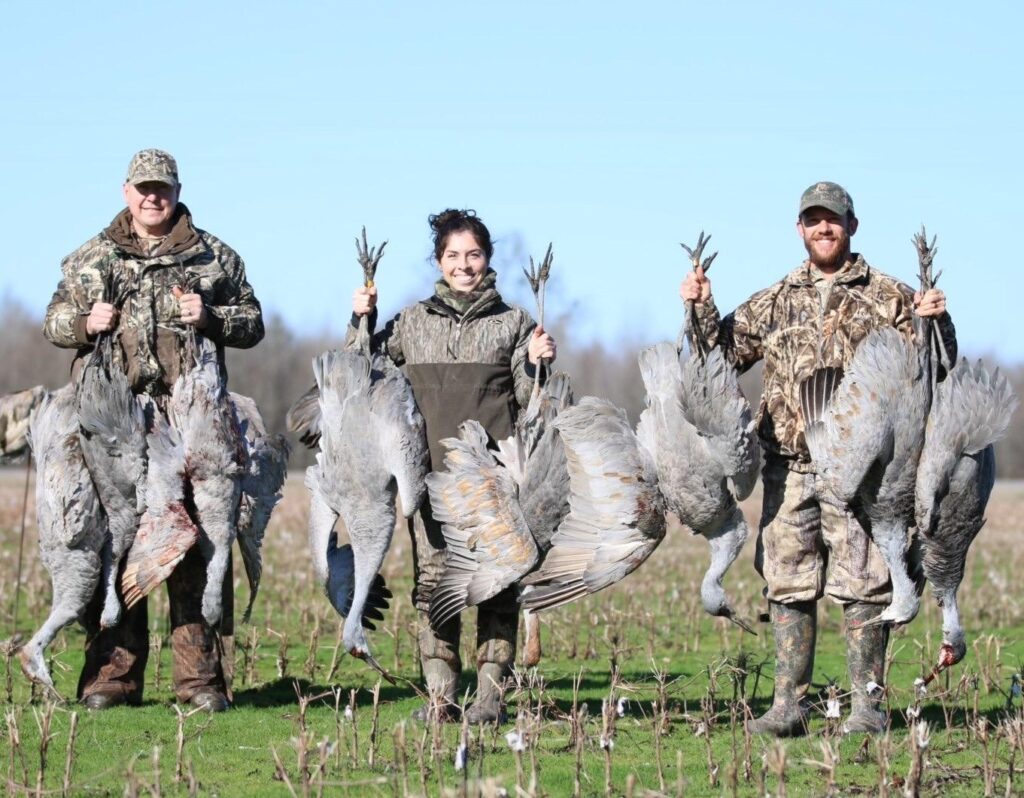
Jud Easterwood, Courtenay Conring, and Norman Haley
Last year, Alabama saw its first sandhill crane hunting season in more than 100 years. The season returns for 2020-2021 with 400 permit holders having the opportunity to hunt sandhill cranes in north Alabama. Registration for the permits opens on September 8.
Norman Haley from Scottsboro, Alabama, has hunted sandhill cranes twice in Tennessee and was excited to have the opportunity to do so in his home state during the 2019-2020 season.
“Sandhill crane hunting is very unique,” Haley said. “The anticipation of seeing the birds approach from a distance is exciting. The slow and graceful circling as they land in a field is a sight to see.”
Today, that sight is more common in north Alabama thanks to the state’s conservation efforts and hunters who purchase their hunting licenses.
In the early 2000s, sandhill crane seasons in the Mississippi and Atlantic flyways were under consideration by the U.S. Fish and Wildlife Service (USFWS). By 2010, USFWS approved a sandhill crane management plan that included a hunt plan for the Mississippi Flyway, which includes Kentucky, Tennessee and Alabama. Kentucky opened its season in 2011. Tennessee’s season soon followed in 2013. Alabama’s season opened in 2019.
“I’ve now been able to take part in the first modern day sandhill crane seasons in Tennessee and Alabama,” Haley said. “It’s nice to know that hunter dollars and conservation efforts have brought sandhill cranes to sustainable and harvestable levels in the state. Alabama’s sandhill crane season is just another example that conservation works.”
The Alabama Department of Conservation and Natural Resources’ (ADCNR) Division of Wildlife and Freshwater Fisheries (WFF) receives no funding from the state’s general fund. The WFF’s Wildlife Section is primarily funded through a portion of hunting license sales that is matched on a three-to-one basis by the USFWS through the federal Pittman-Robertson Act. Alabama State Duck Stamp sales are also matched through the same process, but earmarked by state law to be utilized for wetlands and waterfowl conservation.
“Monies from these two revenue sources directly benefit sandhill cranes by providing habitat protection, management and restoration work in the areas of Alabama that cranes utilize as migration routes and wintering habitat,” said Seth Maddox, WFF Migratory Game Bird Coordinator. “Over the long term, conservation of habitat has played an integral part in the population growth of sandhill cranes.”
Those conservation efforts have benefited both sandhill cranes and hunters in Alabama like Haley.
“There was a time I thought the only way I would be able to hunt sandhills was by taking a trip to Texas or Oklahoma,” Haley said. “Now that I can hunt them in my home state, I don’t ever see myself passing up the opportunity as long as it’s available.”
Registration for Alabama’s 2020-2021 sandhill crane hunting season will open at 8 a.m. on September 8 and run until 8 a.m. on September 29, 2020. The WFF will conduct a computer-controlled random draw of 400 sandhill crane hunting permits on Tuesday, September 29, 2020, at noon Central Time. To register, visit www.outdooralabama.com/what-hunt/sandhill-crane-hunting-alabama during the dates listed above. A $10 registration fee applies.
Registration is limited to Alabama residents 16 or older or Alabama lifetime hunting license holders. Applicants must have their regular hunting license and a state waterfowl stamp to register.
If drawn, hunters must complete an online test that includes species identification and regulations. After passing the test, WFF will issue the permit and tags to the hunter. In addition to a hunting license and state duck stamp, hunters must also acquire a federal duck stamp and Harvest Information Program certification, and, if hunting on a Wildlife Management Area (WMA), a WMA license.
The season is restricted to north Alabama and consists of two segments. The first segment runs from December 4, 2020, to January 3, 2021. The second segment will be January 11-31, 2021. The daily, season and possession limit will be three birds per permit. Hunters can harvest all three birds in one day if they choose. Both state and federal wildlife refuges are closed to sandhill crane hunting.
For more information about Alabama’s 2020-2021 sandhill crane hunting season, visit www.outdooralabama.com/seasons-and-bag-limits/sandhill-crane-season.
The Alabama Department of Conservation and Natural Resources promotes wise stewardship, management and enjoyment of Alabama’s natural resources through four divisions: Marine Resources, State Lands, State Parks, and Wildlife and Freshwater Fisheries. To learn more about ADCNR, visitwww.outdooralabama.com.
Unofficial 2020 West Central Alabama River Zone Gator Hunt results
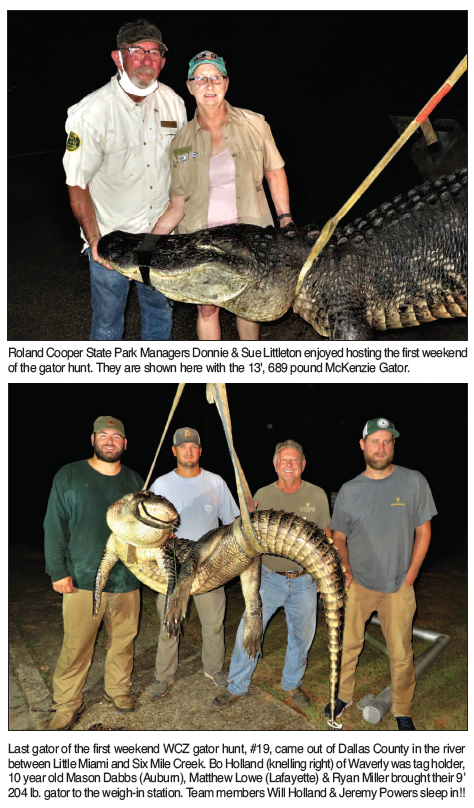
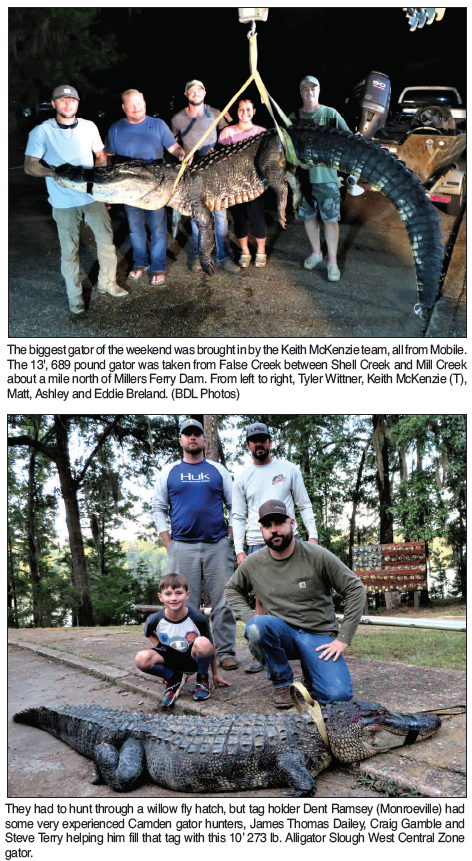
“19 0f the 50 tags were filled on the first weekend,” stated Big Daddy Lawler. Follow BDL at [email protected], www.gettinoutdoorsradio.com and www.facebook.com/gettinoutdoors/
Night 1 – 08/13/14/2020
01 – Jamie Tyree, Range Al. – PBC – 12’ 1”, 531 lbs. Male
02 – Dewitt Carter – Claiborne – 11’ 1”, 362 lbs. Male
03 – John Goff, Clanton – PBC – 8’ 10”, 176 lbs. Male
04 – J.C. Peeples, Wilsonville – Liddell’s Slough – 7’ 6”, 95 lbs. Male
05 – James Glasgow, Haleyville – Bogue Chitto – 10’ 3”, 270 lbs. Male
06 – David Perry, Lincoln – Bells Landing – 6’ 11”, 75 lbs. Male
Night 2 – 08/14/15/2020
07 – Bo Pierce, Camden – River – 9’ 1”, 201 lbs. Male
08 – Kevin Jenkins, Linden – Liddell’s Slough – 7’ 9”, 88 lbs. Female
09 – Mark Beatty – River – 7’ 1”, 85 lbs. Female
10 – James Phillips – Mill Creek – 7’ 9”, 108 lbs. Male
Night 3 – 08/15/16/2020
11 – Keith McKenzie, Mobile – False Creek – 13’, 689 lbs. Male
12 – Dent Ramsey, Monroeville – Gator Slough – 10’ 4”, 273 lbs. Male
13 – Douglas Taylor – Holly Creek – 8’ 4”, 141 lbs. Male
14 – Brent Baker – River – 7’ 3”, 87 lbs. Male
15 – Jerald Burnette – Gold Mine – 7’ 8”, 109 lbs. Female
16 – Ryan Summerford – Paradise Point – 8’ 5”, 132 lbs. Male
17 – Travis Bennett, Wetumpka – RCSP Slough – 7’ 2”, 81 lbs. Male
18 – Casi Vaughn, McCalla – Gold Mine – 5’ 8”, 38 lbs. Female
19 – Bo Holland, Waverly – 6 Mile Creek – 9’, 204 lbs. Male
Advisory Board Approves Snapper Extension, Tables Turkey Changes
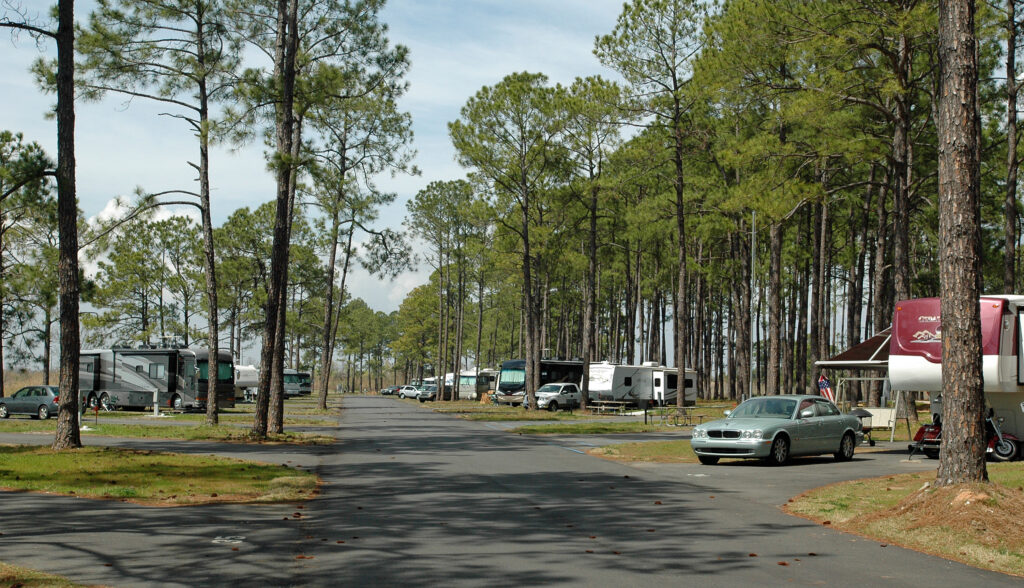
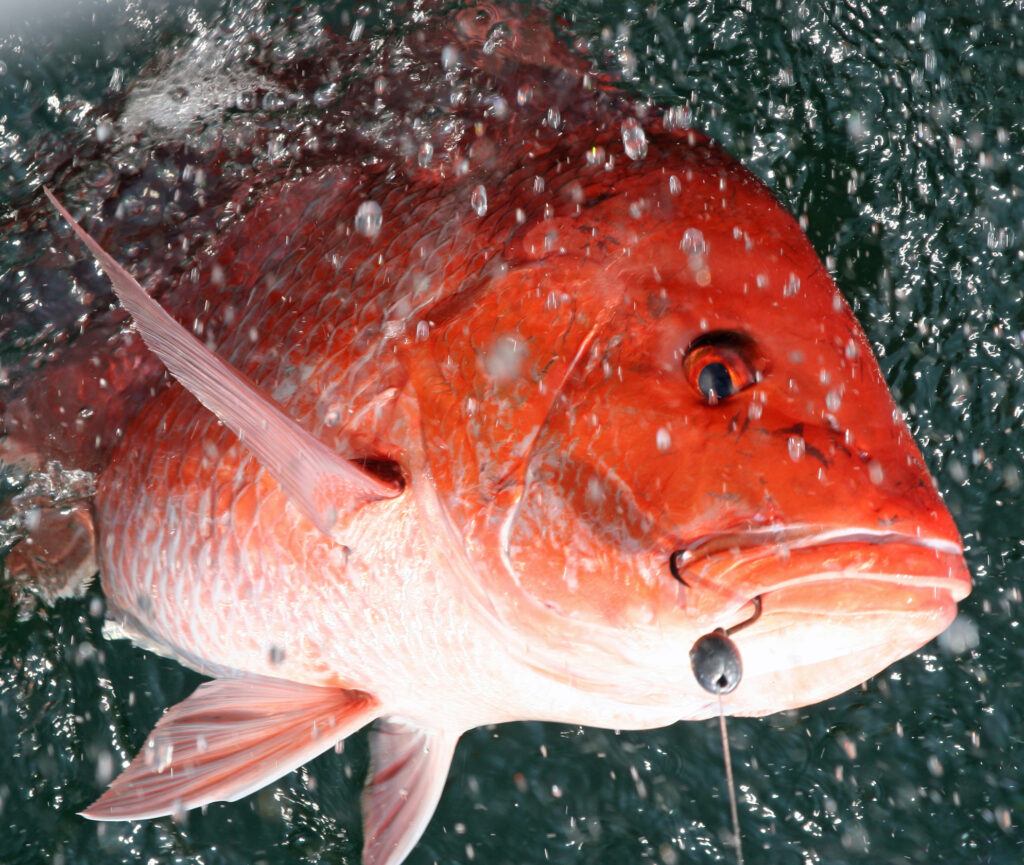
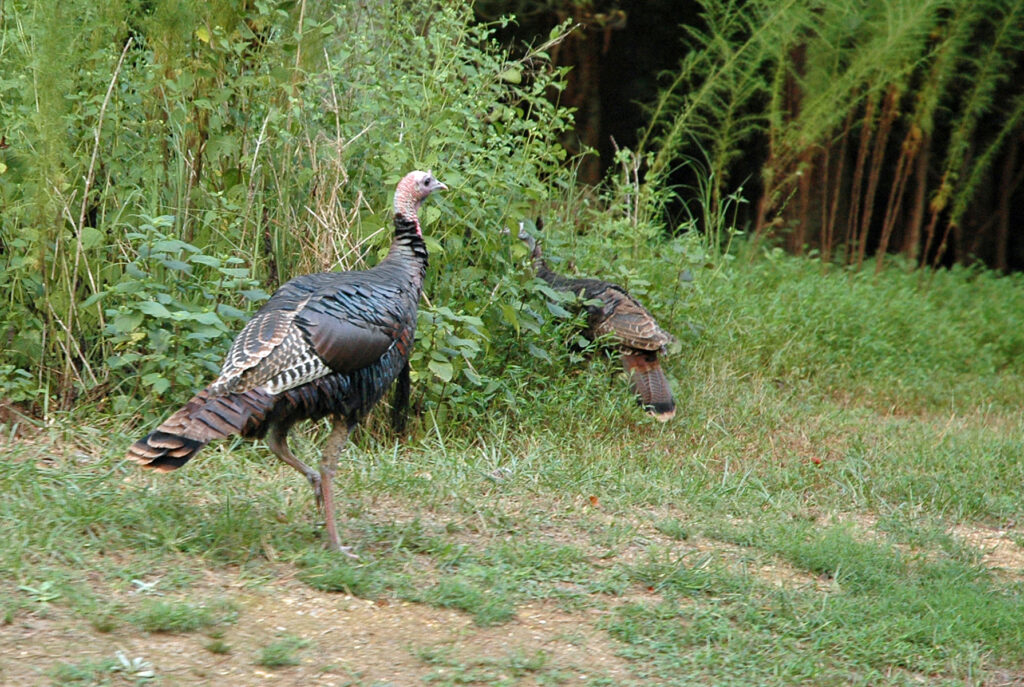
By David Rainer, Alabama Department of Conservation and Natural Resources
The Alabama Conservation Advisory Board approved a three-day extension of the red snapper season and tabled a motion to change the season dates and bag limit for wild turkeys at its recent meeting in Mobile.
Chris Blankenship, Commissioner of the Alabama Department of Conservation and Natural Resources (ADCNR), recommended a three-day extension of the red snapper season, which the Board approved unanimously. The extra red snapper days are set for October 10-12. The Board also voted to give the Commissioner leeway to adjust those dates should inclement weather interfere with the planned extension.
“We saw an increased participation in red snapper season,” Commissioner Blankenship said. “People couldn’t play travel ball. They weren’t going to Disney World or going on family vacations. Consequently, we saw increased participation on all weekends of the red snapper season. Because of that, we closed the season on July 3 as we were approaching the quota on red snapper. After checking the data and seeing the final landings, we have about 128,000 pounds of red snapper quota left.”
The Commissioner said the approved extension is the Saturday, Sunday and Monday of Columbus Day weekend.
The Board heard a presentation from Mike Chamberlain, the Terrell Professor of Wildlife Ecology and Management at the University of Georgia, about the decline of wild turkey populations in the South. Chamberlain’s presentation was the same one given to Arkansas Game and Fish Commission, which wanted to see data on how harvest impacts the population dynamics.
“Arkansas’ turkey population has been declining for a number of years,” Chamberlain said. “The trajectory of the population in Arkansas is almost identical to the trajectory of the population in Alabama, except that Alabama is about seven or eight years behind.”
Chamberlain, who is studying wild turkeys in numerous states from Arizona to North Carolina, said gobbling activity begins about 45 days before the peak of nesting.
“Gobblers become receptive well before the hens do,” he said. “We know two things drive gobbling activity. One is hen availability. As hens become less available, gobbling increases. The other is competition amongst themselves. If your buddy is gobbling, you gobble.
“What we see is that a lot of gobbling in March corresponds to no breeding activity. We also see that gobbling really picks up when hens start to nest.”
Chamberlain said what we’re dealing with in the South is an increased harvest of gobblers and a survival rate of hatchlings that is not high enough to sustain the population.
“What we see is a slow, gradual decline across all the states in the Southeast,” he said. “The survival rate of a clutch is 1 to 1½ poults per hen. That is not sustainable. So, it makes sense that the populations have slowly declined.”
Chamberlain also said his studies indicate that about 80 percent of the harvest occurs before the peak of incubation.
“If you remove four toms from 2,400 acres, gobbling decreases four-fold,” he said.
Chamberlain pointed out that the reported harvest on the opening weekend of Alabama’s 2020 season was 43 percent higher than the harvest from 2019, a trend that held true throughout the Southeast.
“We know that early in the season, the dominant birds are the ones being shot,” he said. “So that 43 percent disproportionately affects the older, dominant birds.”
Chamberlain said the result of taking the dominant birds out of the population is an increase in the length of nesting activity. Instead of most of the egg-laying occurring within a few weeks, he said the hatching of the eggs is now stretched out over as much as 100 days.
“If all of these hens drop their clutches within a couple of weeks, they will hatch about the same time,” he said. “By scattering them across the landscape across 100 days, you give predators the advantage. With all the eggs hatching at one time, predators can’t possibly find all of them. If you stretch it across three months – rat snakes, raccoons, horned owls – you’re giving them an advantage.
“The science suggests the activity we’re doing is contributing to this prolonged nesting effort.”
Board Chairman Joey Dobbs asked Chamberlain if he had suggestions on how to stop the decline of the turkey population in Alabama and the Southeast.
“There are some things we can control and some things we can’t,” Chamberlain said. “This bird, uniformly across the Southeast, is dealing with habitat issues – declining quality, fragmentation, urbanization. We have diseases that are popping up that are affecting the birds. We have predator communities that are much more diverse than they were. We can’t control any of that because most turkeys live on private land.
“What we can control is what we know impacts this bird. That is harvest. We’ve known this since the mid-’90s.”
After Chamberlain’s presentation, a motion was made to change the dates and bag limit for Alabama’s turkey season with a starting date of April 1 through the first Saturday in May with a season bag limit of three birds. The current regulations open the spring turkey season in most of the state on the third Saturday in March with a season bag limit of five birds.
Before the vote, Board Member Patrick Cagle offered an amendment to table that motion until the February 2021 Board meeting to ensure hunters in Alabama would not run afoul of a new regulation with the current regulation already printed in the Alabama Hunting & Fishing Digest. The Board unanimously approved the amendment to table the motion.
When asked for a recommendation on turkey season by Chairman Dobbs, Wildlife and Freshwater Fisheries Director Chuck Sykes said the decline in Arkansas’ turkey numbers is an ominous indication of where Alabama is headed without change.
“I would ask the Board to move the season starting date to as late as possible with a three-bird bag limit,” Sykes said. “I think Dr. Chamberlain showed that Arkansas is in a bad way right now. We’re headed in that direction. The sooner we can take proactive solutions, the better. I don’t want to kick this can down the road any farther. Thank y’all for saying you will take this up at the first meeting of 2021 and make a decision. It’s time.”
During the meeting, Commissioner Blankenship provided an update on the effects of COVID-19 on the ADCNR’s operations.
“I think our people are doing their best at social distancing and maintaining the safety guidelines,” Commissioner Blankenship said. “Our State Parks stayed open the entire time, dealing with the public every day, as well as our officers and staff in the field. I really appreciate their work during this time. It’s been a testament to our employees and their passion for what we do. Governor (Kay) Ivey and State Health Officer Dr. Scott Harris felt like outdoors recreation was essential. I think it has been essential for people being able to get out and enjoy the outdoors when so many other things were closed. We’ve seen increased occupancy at our State Parks campgrounds and day-use facilities, our waterways and fishing lakes, our Forever Wild trails, and our WMAs (wildlife management areas). They were highly used.
“I think it shows the beautiful resources we have in our state, the wildlife and the diversity of the areas. I think people realized how fortunate we are and what a great state this is to live in. I think people got out and went to places they’ve never gone before. I think that has been good for not only physical health but mental health as well.”
Commissioner Blankenship also reported an increase in license sales, which is the main source of income for the ADCNR.
“Our hunting, fishing and Wildlife Heritage licenses were up a good bit,” he said. “Our non-resident licenses were down, as you can imagine with the travel restrictions.”
Commissioner Blankenship said a marketing campaign was initiated to target those individuals who may not hunt or fish but appreciate the diversity of wildlife and natural wonders Alabama offers.
“We are trying to increase participation in license sales for people who utilize areas of the state that don’t require a license,” he said. “They don’t hunt or fish, but they birdwatch or hike or take advantage of the recreational opportunities on the property managed by the ADCNR. We marketed our Wildlife Heritage License to the birdwatching community. We increased that license’s sales by more than 33 percent last year.
“Our new licenses are on sale now. One of the things we added this year was packages. If you want to hunt deer, you can select a hunt package. If you want to fish freshwater, you can select that package. If you want to fish saltwater, you can select that package. We wanted to make it easier for the public to go online and purchase licenses.”
Visit www.outdooralabama.com/license-packages for the license packages available.
Scaup Limit Reduced to One; Sandhill Registration Opens Soon
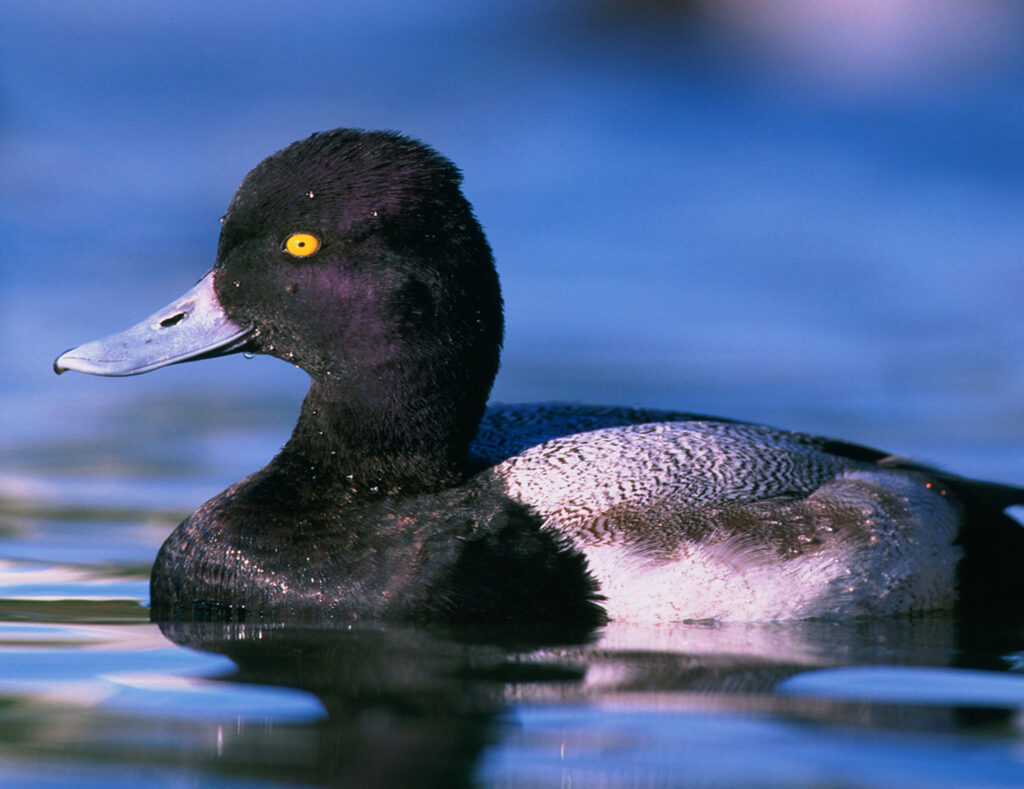
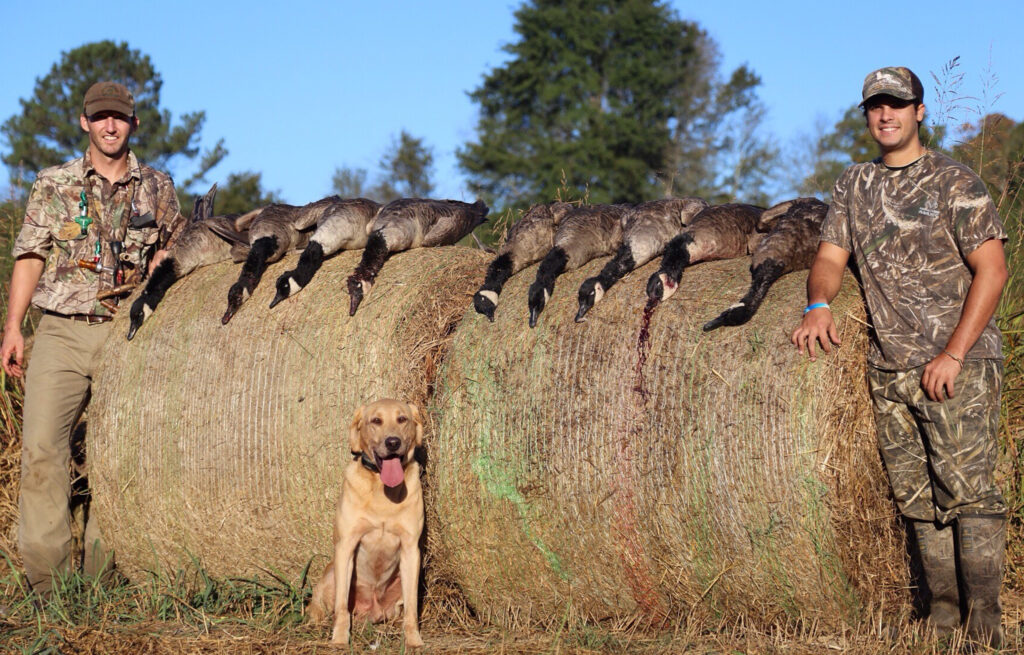
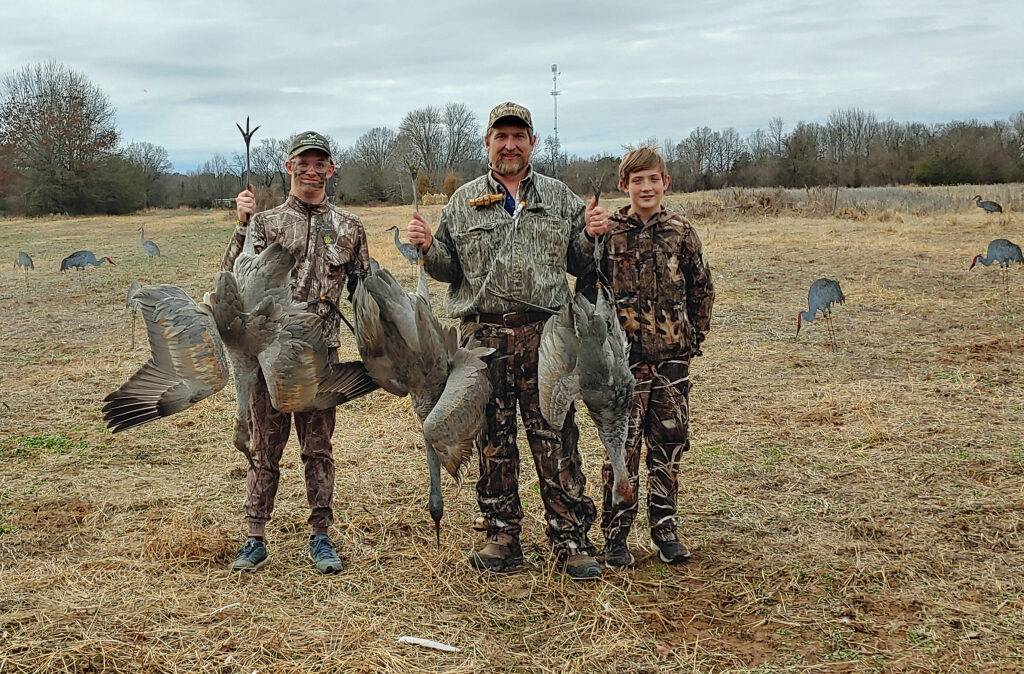
By David Rainer, Alabama Department of Conservation and Natural Resources
North America’s waterfowl breeding population annual survey is another aspect of the outdoors that has been impacted by COVID-19 restrictions.
Seth Maddox, the Alabama Wildlife and Freshwater Fisheries’ Migratory Bird Coordinator, said virus-related travel restrictions would not allow the U.S. Fish and Wildlife Service (USFWS) to conduct the aerial survey of the prairie potholes regions of Canada and the Midwest U.S.
“It’s going to be an interesting season,” Maddox said. “With COVID ongoing, they didn’t fly the breeding population survey in Canada and the northern U.S. The border was closed, so we don’t have a good estimate of what the waterfowl population looks like.”
Maddox said waterfowl specialists will have to depend on weather conditions and long-term datasets to take an educated guess on waterfowl populations.
“It’s been a fairly wet spring and summer across the U.S. prairies, which makes for really good breeding habitat,” he said. “But it has been fairly dry in the Canadian prairies, which will impact the breeding habitat there.
“We’ll see what the fall flight looks like. It may be a little below what we’ve seen in the past few years as far as population numbers. So, it will be an interesting year. I think the numbers will be fine. They may just be a little lower than the previous few years.”
Maddox said the waterfowl seasons in the flyways are set a year in advance. While this season’s bag limits and dates have minimal changes, he said the 2021-2022 season framework may be affected.
“This season, the only significant change is a reduction in the bag limit for scaup (bluebills),” he said. “Based on the 2019 population, scaup dropped into the restrictive package, which allows for a 45-day season with a two-bird daily bag limit and then a 15-day season with a one-bird daily bag limit.
“In Alabama, we decided to go a little more restrictive and go 60 days with a one-bird daily bag limit. That makes our regulations a little easier for our hunters to interpret. And it makes it easier for our Enforcement Officers as well. We didn’t want to put any hunters in a situation where they might be over the limit. We’re working on the harvest strategy at the Flyway level to get that changed so we won’t have season-within-a-season limits.”
For the 2020-2021 season, Alabama hunters will again have a daily bag limit of 6 ducks, which may include no more than 4 mallards (no more than 2 of which may be females), 1 mottled duck, 2 black ducks, 1 pintail, 3 wood ducks, 2 canvasbacks, 1 scaup, and 2 redheads. The daily bag limit for coots is 15 per day. The daily bag limit for mergansers is 5, only 2 of which can be hooded mergansers. The aggregate bag limit of 5 dark geese (Canada, White-Fronted and Brant) shall not include more than 3 Canada geese or 1 Brant. For light geese (Snow, Blue, Ross’s) the aggregate bag limit is 5. Possession limit is three times the daily bag limit.
Regular season dates for ducks, coots, mergansers and geese are November 27-28 and December 5-January 31, 2021. The Youth, Veterans and Active Duty Military Special Waterfowl Days are set for November 21 and February 6, 2021.
After a successful season last year, Alabama again will offer a limited sandhill crane hunt in north Alabama. The limited quota sandhill hunts will have 400 permits with 1,200 tags. The daily bag limit is 3. The season possession limit is 3. Sandhill season dates are December 4-January 3, 2021, and January 11-31, 2021.
“We had a good opening season for sandhill cranes,” Maddox said. “We harvested 291 birds, which is about 24 percent of the allocated tags. We’ll be doing the same thing this year.”
Registration for a sandhill crane permit will open September 8 and the random drawing for permits will be held after registration closes at 8 a.m. on September 29.
Visit www.outdooralabama.com/what-hunt/sandhill-crane-hunting-alabama for the link to apply for a sandhill permit. A $10 registration fee applies.
“Last year’s sandhill season was very positive, overwhelmingly positive,” Maddox said. “Everybody seemed to have a good time. Several hunters managed to fill their bag limits. People are excited to have the opportunity to chase this bird in the field again this year in Alabama.”
Maddox said the sandhill crane population in the U.S. has been steadily increasing over the past few years. However, the number of sandhills that end up in Alabama is directly related to the weather, just like ducks.
“The colder it is, the more birds show up in Alabama,” he said. “We had a good number of sandhills show up last year, but with colder weather, we’ll have more birds show up.”
Maddox said the bulk of the sandhill population spends summers in the northern U.S. states and the Canadian provinces of Ontario, Manitoba and Quebec.
“Like ducks, sandhills only want to move as far as they have to, so the more snow cover up north, the better it is for Alabama,” he said. “Sandhills are feeding in dry or slightly wet agricultural fields. Snow cover pushes them farther south.
“We have really good habitat in Alabama for sandhills. Most of our sandhills winter on Wheeler National Wildlife Refuge and along the Tennessee River. But there is a decent population on Weiss Lake on the Coosa River.”
Maddox just hopes the weather conditions change for the 2020-2021 seasons after two years of less-than-average waterfowl hunting success.
“Last season looked a lot like the previous season,” Maddox said. “It was a pretty warm, mild winter here in Alabama. And, it was pretty mild in most of the country. We never saw that late good push of ducks that we are used to when we have cold weather. So, it made duck hunting fairly tough.
“It was a fairly wet winter across the Midwest and southern United States. There was a lot of water available on the landscape that provided a lot of available habitat for birds to spread out. It was almost a mirror image of the previous season.”
Maddox said the most recent quality duck season in Alabama occurred during the 2017-2018 season.
“That was a really good season,” he said. “We had a lot of cold weather that pushed down. We had a stretch of below freezing temperatures in Alabama. We really need that in the North and Midwest to put ice on the landscape to minimize the open water. And we need snow on the landscape to cover the available food and push the birds further south into open water and good habitat.
“Overall, it’s looking pretty good for this season. As long as we stay with average rainfall, we’ll have good habitat for migratory birds that make it here this fall and winter.”
For some early waterfowl action, don’t forget about the Special Teal Season, which runs September 12-27, 2020, with a daily bag limit of six birds.
Also, the early season for geese runs September 1-30 and then October 12-24. During the September season, hunters can take five dark geese per day, but only one Brant is allowed in that bag limit. The bag limit for light geese is five per day for the entire season.
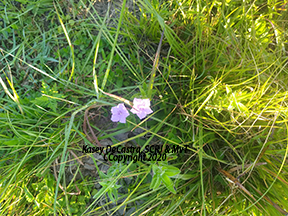
This wild petunia was found in Coatopa by Connie and Marianne Boutwell. Ruellia humilis, the wild petunia, is a larval food plant for the buckeye and several other butterfly species, according to wildflower.org. It grows in several states as far south as Florida, and all the way north to Wisconsin. It’s found all the way east from United States eastern coast to as far west as Texas. The purple blooms blossom from May to September.
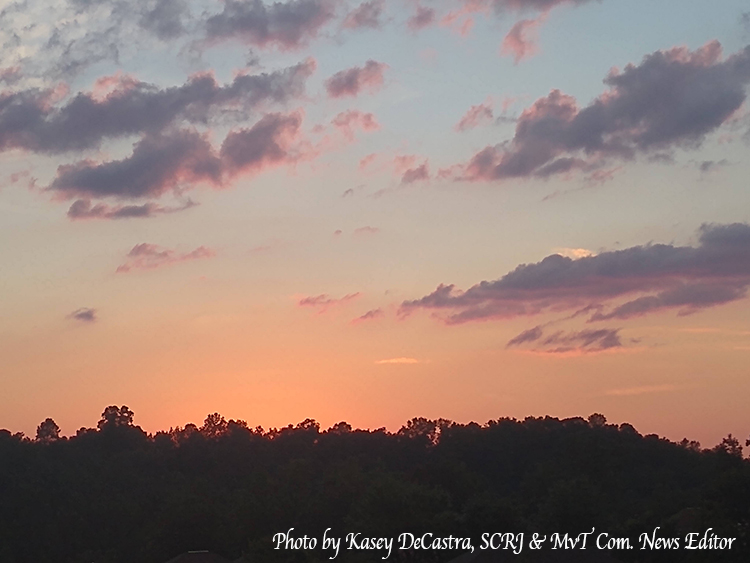
Got a deer, fish, critter, or huge or unusual vegetable photo? Lovely sunset/sunrise or hiking shot? Snap a picture and email us. It’s free to submit and we’ll not only feature it in the paper, but also on our awards winning outdoors page on www.moundvilletimes.net.
Email us at [email protected]
Registration Now Open for Alabama’s Adult Mentored Hunting Program
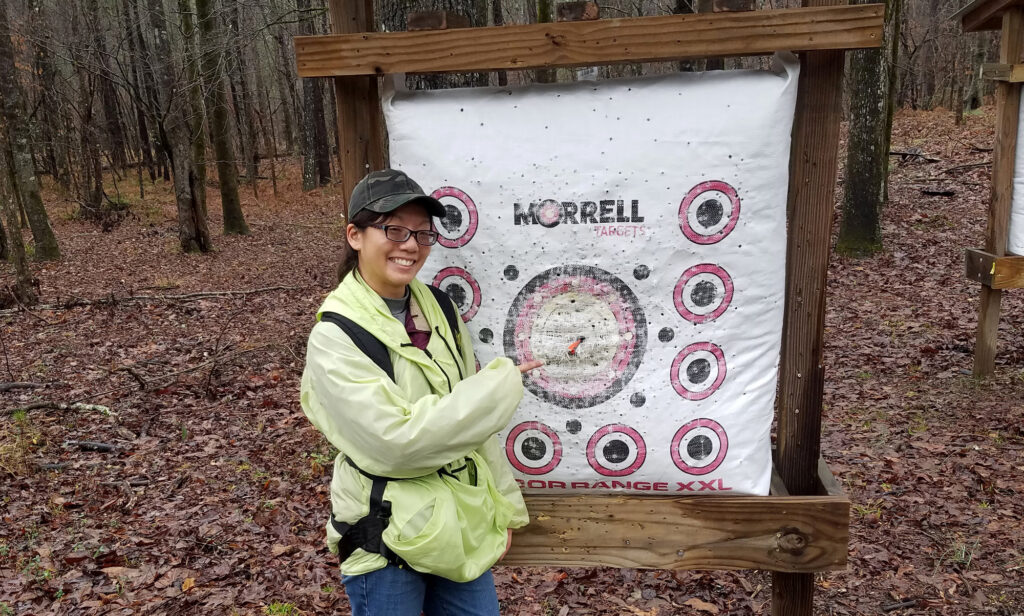
Learning to hunt may seem out of reach for those who didn’t grow up with hunting as part of their family tradition. For those individuals, the Alabama Department of Conservation and Natural Resources’ (ADCNR) Division of Wildlife and Freshwater Fisheries (WFF) created an Adult Mentored Hunting Program (AMH) to teach about consumptive outdoor recreation, put wild game on the dinner table and potentially revive or initiate that family tradition.
A variety of interests can spark a non-hunter’s desire to hunt. For Connie Chow of Madison, Alabama, it was her experience attending last year’s Becoming an Outdoors-Woman (BOW) event that lead to her first hunt through the AMH program.
“While at BOW, I witnessed the excitement of a squirrel hunt,” Chow said. “The experience seemed so exciting and rewarding for the hunters that I wanted to take part in a hunt at some point. The self-sufficiency that comes with hunting was very appealing.”
Like others who take part in Alabama’s AMH program, outdoors recreation was not a regular part of Chow’s childhood. She had been fishing and camping a few times, but never hunting.
“The Adult Mentored Hunting program was an excellent introduction to hunting in an encouraging atmosphere,” she said. “You not only learn about hunting but also about conservation, nature and wildlife. My family was also able to join me for some of the activities. It was a chance to introduce them to some of the experiences as well.”
Chow put the hunting skills she learned at an AMH workshop to good use on the first day of her mentored hunt when she harvested a buck using a crossbow.
“The different components of the program give someone who is completely new to hunting the chance to learn new skills then apply them immediately,” she said. “The experience has definitely made me interested in exploring more outdoor activities like fishing, camping and clay target shooting.”
Chow will utilize her new hunting skills again this fall during a dove hunt on WFF’s Portland Landing Special Opportunity Hunting Area in Dallas County, Alabama.
To be eligible to attend a three-day Adult Mentored Hunt for deer or turkey, participants must be at least 19 years of age, possess a valid driver’s license and be new to hunting or have limited hunting experience. Participants must also attend at least one daylong AMH workshop to be eligible for a three-day hunt. After attending a workshop, participants will be notified by email if they have been randomly selected to participate in an AMH hunt.
The daylong AMH workshops will take place throughout the state this fall. The workshops provide participants with an opportunity to learn hunting basics, firearm safety and handling, where to hunt, and the equipment and gear needed. The workshops will conclude with a small game hunt. The necessary equipment and gear will be made available at no cost to the participants.
The first workshop of 2020 will take place at the Autauga Wildlife Management Area near Prattville, Alabama, on October 3. This workshop will focus on how to hunt deer with archery equipment.
As a precaution to prevent the spread of COVID-19, workshop participants and WFF staff are required to wear a facial covering and maintain a distance of 6 feet from others when possible. Participants are not required to wear a facial covering while hunting.
There is a $20 registration fee for the AMH workshops. Online registration for the workshops is currently open. To register, visit www.outdooralabama.com/hunting/adult-mentored-hunting-program.
The Alabama Department of Conservation and Natural Resources promotes wise stewardship, management and enjoyment of Alabama’s natural resources through four divisions: Marine Resources, State Lands, State Parks, and Wildlife and Freshwater Fisheries. To learn more about ADCNR, visit www.outdooralabama.com.
Extension offices serving as drop off points for mystery seed packages
The Alabama Cooperative Extension System is partnering with the Alabama Department of Agriculture and Industries (ADAI) to assist in collecting unsolicited seed packages being sent to Alabama residents from China. The packages often indicate that they contain jewelry rather than seeds. ADAI field inspectors are currently collecting these seed packages to test their contents for unknown compounds, noxious weed seed and invasive species.
Gary Lemme, Alabama Extension director, said each county Extension office will serve as a drop off point for residents who may have received these mystery packages containing seeds.
“This partnership will allow inspectors at ADAI to process the seed samples more quickly,” Lemme said. “Alabama Extension is proud to take part in this process to continue serving Alabama residents.”
Commissioner of Agriculture and Industries Rick Pate said, “We appreciate Extension’s offer to assist our department by providing a designated drop off point in each county. We will continue to collect packages as along as we receive reports that they are being delivered to Alabama citizens.”
Those who have received unsolicited seed packages should not open the package containing the seeds or plant the seeds. Deliver these packages to the county Extension office nearest you. Find the address and contact information to county offices in the Alabama Extension directory at www.aces.edu/directory. When you deliver the package, professionals at that office will assist in filling out the ADAI Unsolicited Seed Package Report. (www.agi.alabama.gov/reportseeds).
Youth Dove Hunts Provide a Gateway to the Outdoors
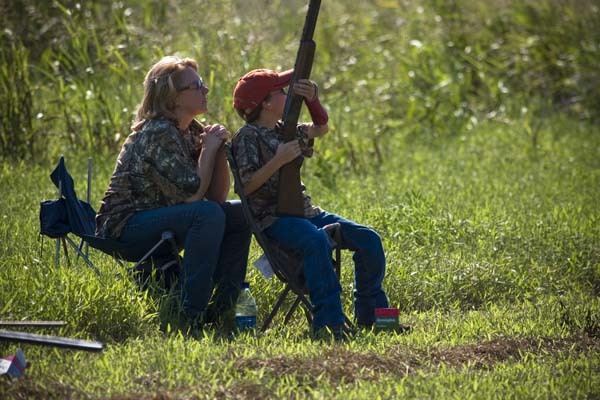
The Alabama Department of Conservation and Natural Resources’ (ADCNR) Division of Wildlife and Freshwater Fisheries (WFF) provides several youth dove hunt opportunities throughout the state each fall. A simple hunting setup combined with a fun, family-friendly atmosphere makes WFF’s youth dove hunts an ideal way to introduce young people to the outdoors.
Registration for this year’s hunts will open at 8 a.m. on August 10, 2020. Although the hunts are free, online registration is required. Locations and hunting slots will be filled on a first come, first served basis. For most of the state, the hunts begin on September 5. For more information including a complete hunt schedule, visit www.outdooralabama.com/youth-hunting/youth-dove-hunts.
“The pandemic has shown us that access to outdoor recreation is more important than ever,” said Chris Blankenship, ADCNR Commissioner. “We are happy to be able to provide that access this fall through a variety of hunting opportunities across the state including our Youth Dove Hunts.”
To participate in the hunts, youth hunters must be age 15 or younger and accompanied by an adult at least 21 years old (or a parent) who has a valid state hunting license, a Harvest Information Program (HIP) validation and a Conservation ID number.
Alabama’s youth dove hunt events are held in open fields and staffed by WFF personnel, which encourages a safe, secure environment for both parents and participants. Before each hunt, a short welcome session with reminders on hunting safety will be conducted. All hunters are encouraged to wear eye protection and earplugs when hunting.
“As a precaution to prevent the spread of COVID-19, we are asking that all participants and our staff wear a facial covering during the registration and safety briefing when they are within 6 feet of a person who is not a member of the same household,” said Seth Maddox, WFF Migratory Game Bird Coordinator. “Participants are not required to wear a facial covering when in their hunting location or while hunting.”
Doves are migratory and covered by the Migratory Bird Treaty Act. The U.S. Fish and Wildlife Service has special rules and regulations that apply to dove hunting which all hunters must follow. To review the Alabama Cooperative Extension System recommendations for plantings related to dove management, visit www.outdooralabama.com/what-hunt/mourning-dove-hunting-alabama.
The Alabama Department of Conservation and Natural Resources promotes wise stewardship, management and enjoyment of Alabama’s natural resources through four divisions: Marine Resources, State Parks, State Lands, and Wildlife and Freshwater Fisheries. To learn more about ADCNR, visit www.outdooralabama.com.
Private Anglers To Get One More Opportunity at Red Snapper

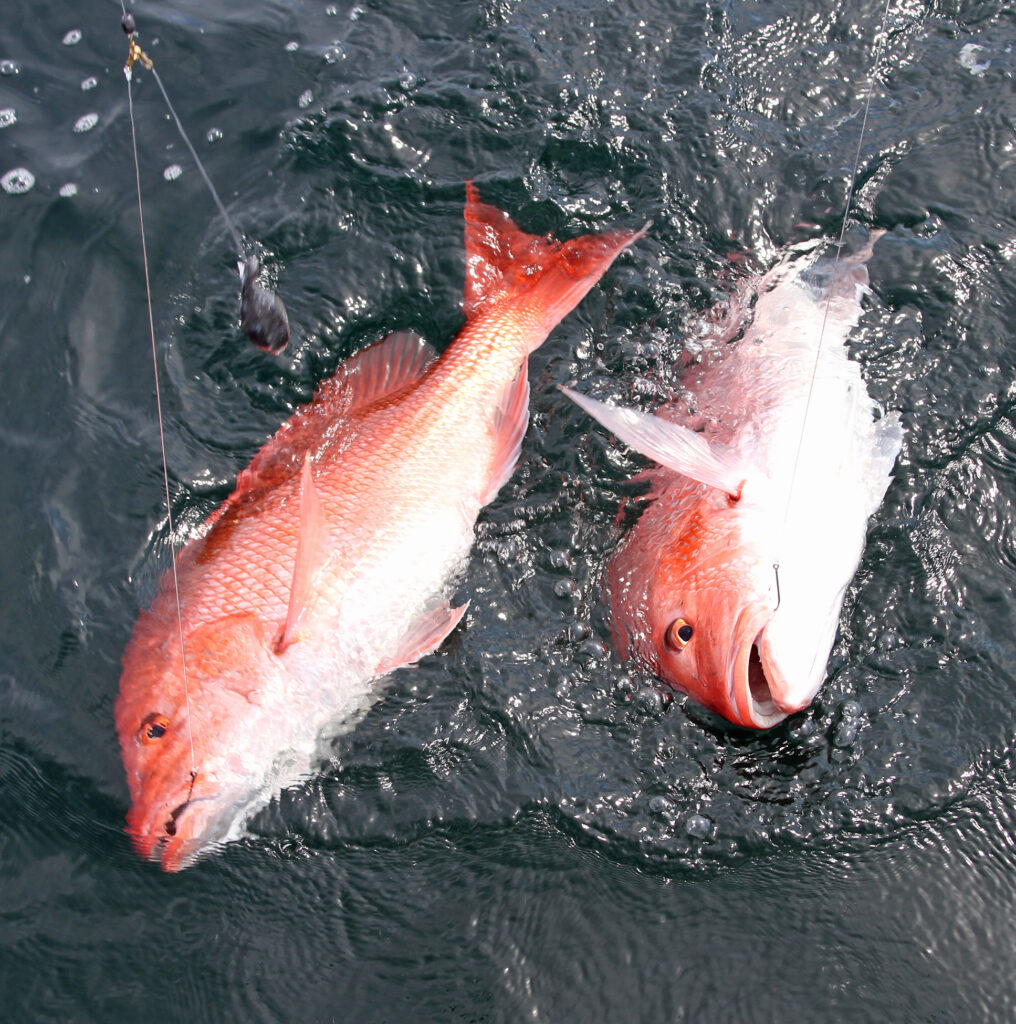
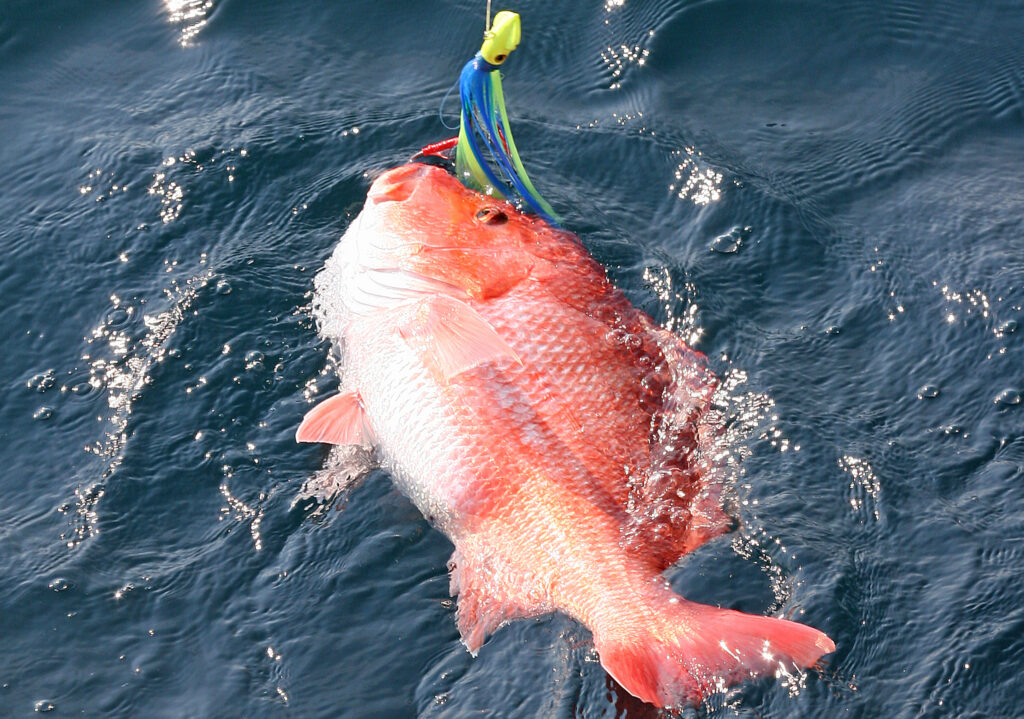
By David Rainer, Alabama Department of Conservation and Natural Resources
Just when it appeared that the 2020 red snapper season was a wrap, private recreational anglers are likely to get one more opportunity to fish this year.
Scott Bannon, Director of the Alabama Marine Resources Division (MRD), said the preliminary harvest numbers for the private recreational sector indicate about 100,000 pounds remain in the quota of 1,122,622 pounds.
The red snapper season for private recreational anglers (which includes state charter vessels) was originally set to last 35 days, beginning the Friday of Memorial Day weekend. However, the season had to be shortened to 25 days to ensure the quota was not exceeded.
Bannon said he and Chris Blankenship, Commissioner of the Alabama Department of Conservation and Natural Resources, are discussing options that would provide the best opportunity for private anglers to catch Alabama’s premier reef fish species.
“The private recreational angler season went really well even though we closed a little earlier than we anticipated,” Bannon said. “The data showed a tremendous number of people took advantage of the season, especially with the opening earlier on May 22.”
When the data from the season was analyzed, Bannon said a significant uptick in participation was quickly evident.
“The average vessel trips for the season were 713 trips per day,” he said. “That means a lot of people went fishing compared to the last two years, which had an average of about 530 vessel trips per day.
“I think people took advantage to go snapper fishing when they could not participate in other activities. They could not get on cruise ships. They couldn’t go to Disney. People were not playing travel sports. Boating was considered a safe outdoor activity, so I do think the COVID-19 pandemic affected the snapper season. I think it prompted more people to go snapper fishing than we had in the past.”
Bannon said the snapper season might have ended even a little earlier had it not been for Tropical Storm Cristobal, which significantly limited fishing on the third weekend of snapper season.
“Even after the second weekend, I had people tell me about the high number of boats they were seeing offshore,” he said. “They said there’s no way we’re going to make it to July 19. My thoughts were that as the season progresses the fervor dies down in July, and fishing gets a little tougher. Again, with not having other activities available, the weather outside that Cristobal weekend was really good and people went fishing.”
Bannon said anyone interested can visit www.outdooralabama.com/2020-red-snapper-landings-summary and view the catch data as well as the chart that shows the angler participation rate compared to the average wave height. The catch data in the chart has been updated to include additional reports.
“You can see in the chart that the wave height and catch effort are directly related,” he said. “The Cristobal weekend slowed down the catch effort. You can also see the weekend days had much higher catch effort.”
For the first time since the five Gulf states were granted control of red snapper management in 2018, Alabama added Mondays to the weekend to try to spread out the effort and provide more opportunities to fish.
“I think adding Mondays was a success,” Bannon said. “Some people felt that had a negative impact and reduced season length because of the Monday fishing. But if you add up all of the Monday effort, it is barely more than our peak Saturday. Mondays did exactly what we hoped it would do. It provided opportunities to avoid the Saturday chaos, allow people who work weekends an opportunity to go, and allow people who were on vacation who had to travel on Saturday to have an extra opportunity.
“And, if you were local, the feedback I got was they took advantage of Mondays instead of trying to fish on Saturdays when the effort was so high. They didn’t fish any more because it was open on Mondays; they just fished a different day.”
With the snapper season closing after July 3, red snapper had to be replaced with lane snapper for the 87th Alabama Deep Sea Fishing Rodeo at Dauphin Island later in July.
“I know there was disappointment that we didn’t have red snapper for the Alabama Deep Sea Rodeo, being the nation’s largest fishing tournament,” Bannon said. “With all of the other challenges the rodeo had with the COVID-19 issues and all the events that were cancelled, I think they had the best event they could under the circumstances.”
With three years of state management data and the 2020 data on Monday fishing, Bannon said the MRD staff will analyze those numbers to determine season dates for 2021.
“Our goal is to make accurate season predictions,” Bannon said. “Again, the pandemic did have an impact, and we don’t know where we will be next year with COVID. We will work with the Commissioner to see what kind of season we will have moving forward.”
The other sector that takes advantage of the state’s great red snapper fishing is the Alabama charter boat fleet, which still operates under federal management through NOAA Fisheries. The charter season opened on June 1 and ran straight through August 1.
“I think the charter season went really well, especially considering that, when the coronavirus first hit, a lot of people were canceling trips early in the year,” Bannon said. “As boating was considered a safe activity, many of the boats adjusted their capacity so people felt comfortable and safe. They lost the Cristobal weekend just like everyone else, but they got to fish pretty consistently for the 62 days they were open. From my discussions with the captains, they considered it a very good season considering the COVID circumstances.
“And I think they’ll have a good fall season as people still have limited outdoor activities. The charters will target other fish, like amberjack, which is scheduled to be open until October 31. They can also catch vermilion snapper (beeliners) and other reef fish species as well as king mackerel.”
Bannon was encouraged by the variety of sizes of red snapper that inhabit Alabama’s unparalleled artificial reef zones.
“We saw in our preseason data that we had a large number of smaller fish, which we attribute to a strong year-class of fish,” he said. “Those younger fish will crowd those reefs. What you should see in the next year or two, those fish will be growing up around those reefs and then dispersing. We should be able to follow the year-class and see how it works out over the next few years.
“We are comfortable with the amount of fish harvested in our reef zones from all sectors. Our surveys help ensure we are making appropriate management decisions to make sure our fishery is sustainable.”
One of the ways MRD conducts those surveys and other management practices is through a variety of funding sources, one of which is the Gulf Reef Fish Endorsement that was implemented for the 2020 season. Bannon said 22,755 endorsements were obtained. The funds will be used for reef fish management.
“I feel like we had really good compliance on the Gulf Reef Fish Endorsement,” he said. “This year, our Enforcement Officers were just making people aware they needed the endorsement, which helps us identify just how many people are participating in the fishery in addition to providing funding for all aspects of reef fish management. Next year, a person may receive a citation for not having it.
“Also, for the fishing seasons after January 1, 2021, we’re adding greater amberjack and gray triggerfish as mandatory species for recording in Snapper Check. They are two valuable species to Alabama anglers, and we want to develop better landings data.”
CDC investigating outbreak of salmonella from backyard poultry
By Justin Miller
The Centers for Disease Control and Prevention (CDC) recently announced they are currently investigating outbreaks of Salmonella infections linked to backyard poultry flocks. As of July 28, the CDC reports 938 cases across 48 states—including Alabama. Of the cases reported, 28 percent of them are children under the age of five.
It is critical for backyard poultry producers to follow biosecurity procedures. These procedures protect both the growers and the birds from illness.
“Having a good biosecurity program provides a measure of protection to both the grower and anyone they come in contact with because they are not spreading disease,” said Kristin Woods, an Alabama Extension poultry science regional agent.
Read Alabama Extension’s recommendations on a good biosecurity program in full in the publication Biosecurity for Backyard Poultry Flocks.
Woods said when it comes to people that do not own poultry, there are still ways they can come in contact with birds.
“Even if you do not raise your own birds, you may still come in contact with backyard poultry in some way,” Woods said. “Chicks and ducklings at farm supply stores as well as a friend’s backyard operation are great examples of this contact.”
According to Woods, if people do happen to come in contact with live poultry, there are some simple steps they should follow to protect themselves.
After touching poultry or their environment, wash hands thoroughly with soap and water. Using hand sanitizer is a secondary option. Adults should help young children properly wash their hands. Wash or sanitize shoes that come in contact with the poultry environment so the feces is not tracked into a car or home. Do not eat or drink where you keep the poultry. Do not kiss the birds or snuggle them up against your face.
For the most current information on this outbreak, visit the CDC’s website. For more information on backyard poultry, visit www.aces.edu.
Commissioner Rick Pate shared test results of unsolicited seed packages delivered to Alabamians from China
Commissioner of Agriculture and Industries Rick Pate shared test results of unsolicited seed packages delivered to Alabama residents from China today. Last week, the Alabama Department of Agriculture and Industries (ADAI) received hundreds of reports from citizens who received packages of seeds from China they did not order.
ADAI has received 385 reports of unsolicited seed packages delivered in Alabama so far. ADAI field inspectors have collected 252 samples with over half of the recipients reporting they ordered seeds online in the past year. Packages have been marked “China Post” and “untracked.” Several packages indicate contents are “jewelry”.
Samples were analyzed for identification and tested for unknown compounds, noxious weed seed, and invasive species. Seeds identified so far have been 50% flower seeds, 41% vegetable seeds and 9% herbs. Of the 17 samples tested for dangerous compounds, none have been detected.
Packages have been reported in 56 counties. Top counties include: Baldwin, Jefferson, Mobile, Montgomery, Madison, Shelby, Tuscaloosa, Houston, Lee, Cullman.
Please follow these instructions if you receive unsolicited seed packages: Report at www.agi.alabama.gov/reportseeds or call 334-240-7304. DO NOT open the seed packets. DO NOT plant the seeds. DO NOT discard them. Keep packaging, including the mailing label.
WFF Reminds Alligator Hunters of No-Cull Regulation
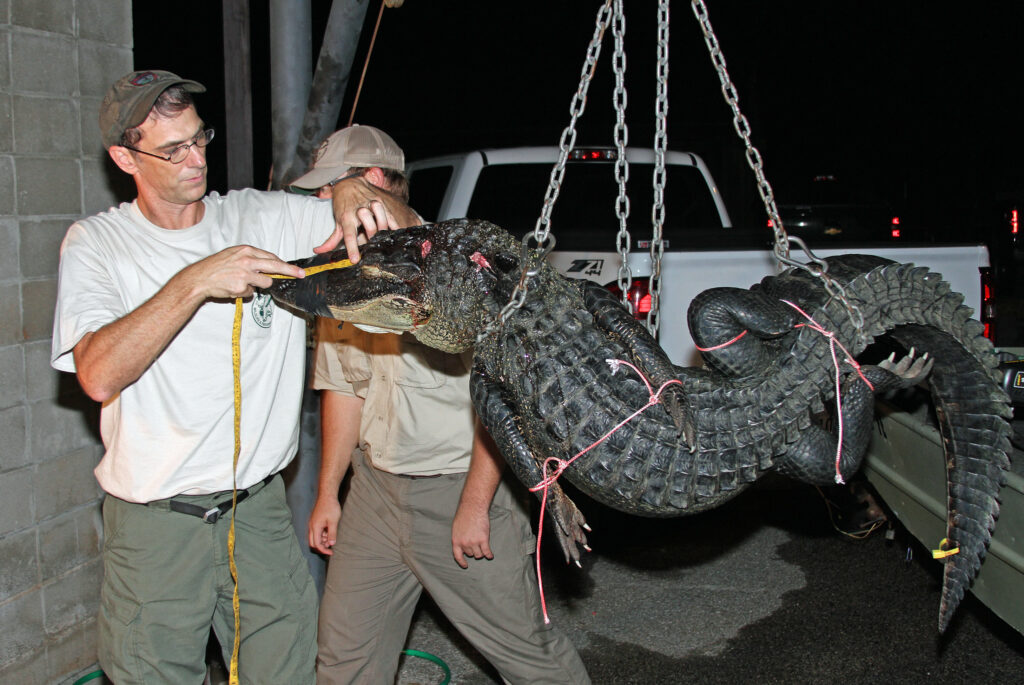
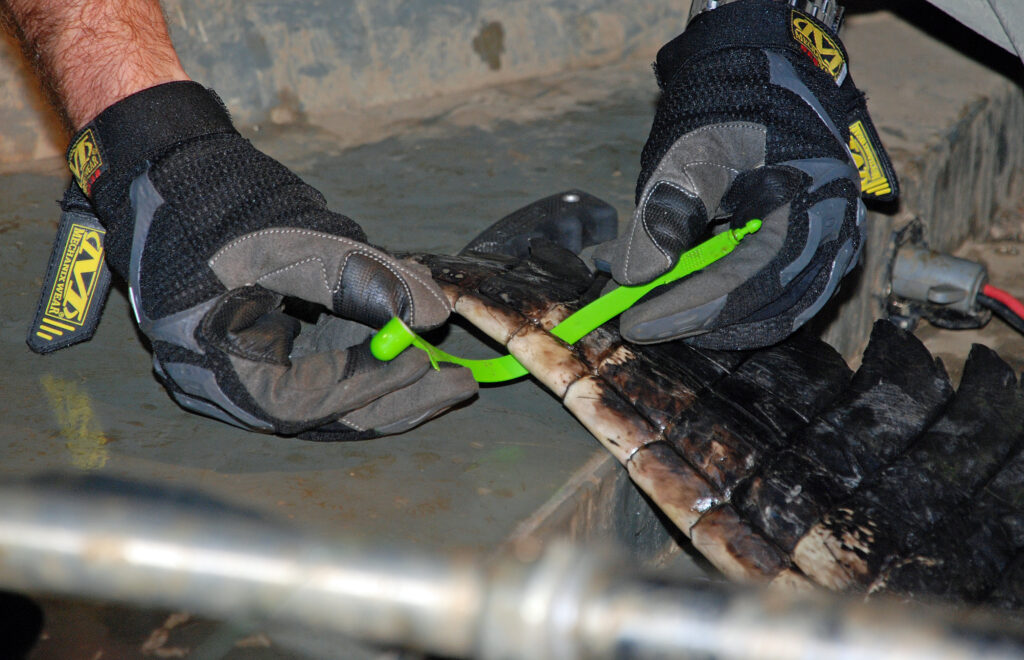
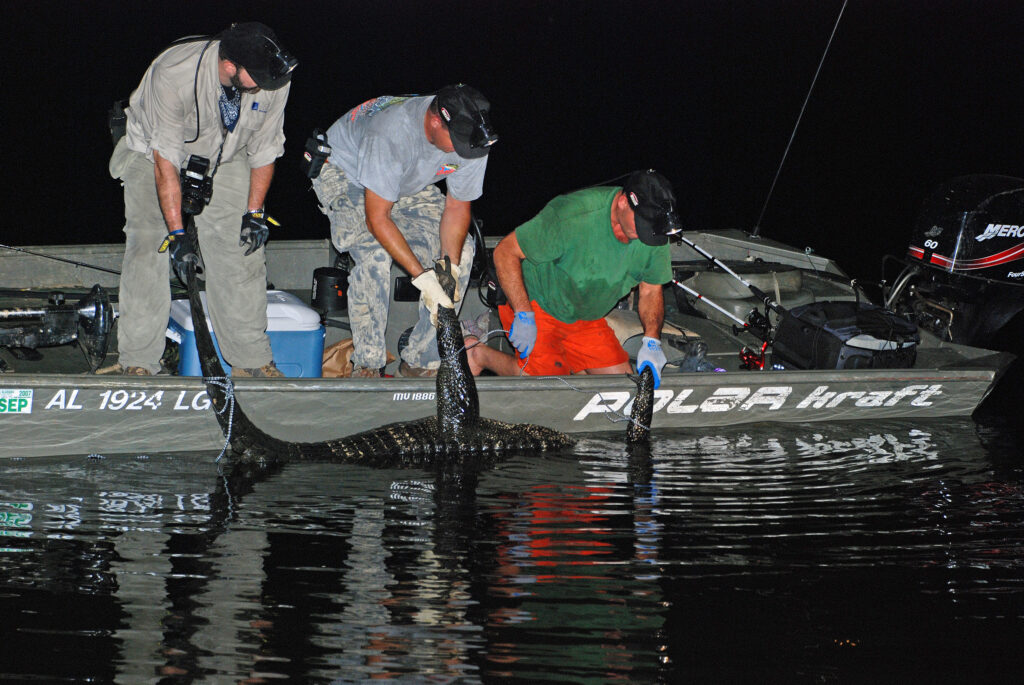
By David Rainer, Alabama Department of Conservation and Natural Resources
With Alabama’s 2020 alligator season only a couple of weeks away, the Alabama Wildlife and Freshwater Fisheries (WFF) Division wants to remind those lucky tag holders about the no-cull rule in effect.
With the exception of the Lake Eufaula Zone, tag holders are not allowed to release an alligator after it has been captured. The exception for the Lake Eufaula Zone is because it is the only zone that has a minimum size length, which is 8 feet total length. In this zone, only alligators that are under 8 feet in length may be released after capture. In all other zones, culling is completely prohibited.
“Many folks who have been going to classes for years and are now getting the training online understand about culling,” said WFF Director Chuck Sykes. “However, I think some hunters have abused our leniency in enforcing the regulation. We just want to make sure that everybody is aware that culling is not a legal practice. This is not a fishing trip where you practice catch-and-release. This is a cold-blooded animal that expends a great deal of energy during the fight and that could end up as an unexpected mortality.
“When you have 5,000 or so people apply for one of these coveted tags, we don’t want people abusing the process and making it look like a catch-and-release fishing tournament. We just wanted to clarify that culling is not allowed.”
Wildlife Section Chief Keith Gauldin said this regulation has been in effect since Alabama’s 2018 alligator season.
“Just as you don’t capture and release any other game animal, hunters are not allowed to practice releasing alligators unless they are hunting in the Lake Eufaula Zone, where there is a minimum harvest length of 8 feet,” Gauldin said. “A captured gator is your gator, so be sure to review the training videos on the website. The videos give you helpful tips on how to judge the size of an alligator.”
Gauldin said there is a direct correlation between the distance from the gator’s nostrils to its eyes and the total length of the animal. If the distance from the nostrils to the eyes is 10 inches, the estimated total length of the alligator would be 10 feet. Visit www.outdooralabama.com/alligator-hunt-tag-training-videos for the six training videos and one that explains the no-cull regulation.
Tag holders must abide by the rule that applies when an alligator is “captured.”
“In the past, we have seen individuals on social media posting alligators that they have captured, taken pictures of and then released,” Gauldin said “We don’t want hunters to cause any undue stress on these animals.
“By regulation, an alligator is considered captured once it is secured with a snare around a leg or the head and is secured boat-side and in control. It must be immediately dispatched and the temporary tag applied. We want to stress that before hunters pursue an alligator and throw a hook at it or any of the legal means of catching an alligator, they should view that gator and estimate its size closely. They need to make sure that’s the one they want to harvest.”
Gauldin said another rule that will be closely enforced has to do with boats providing assistance during the pursuit of an alligator.
“When hunting parties have multiple vessels involved, only the boat with the tag holder can have the capture equipment in it,” he said. “The other vessels that are assisting can only have spotlights but no capture equipment.”
Capture methods are restricted to hand-held snares, snatch hooks (hand-held or rod/reel), harpoons (with attached line), and bowfishing equipment (with line attached from arrow to bow or crossbow). The use of bait is not allowed.
Gauldin said the WFF’s Enforcement Section will be out in full force during the alligator season to ensure the regulations are followed.
“There is a high likelihood hunters will be checked by a Conservation Enforcement Officer at least on one of the nights of the season,” he said. “It’s a good idea to put all of your identification, hunting license and alligator tag in a Ziploc bag for easy access instead of having to dig it out of your wallet at one o’clock in the morning. Have that ready for presentation when you get checked. It will make it easier for our officers and make for a more timely check for the hunters.”
Gauldin also wants hunters to refrain from consuming alcohol during the hunts.
“We want hunters to have a good time but a safe time,” he said. “Combining alcohol and alligator hunting is not a good idea.
“And make sure everyone has a PFD (personal flotation device). It’s a good idea to have that PFD on if the boat is under throttle, especially at night. Obstructions are much harder to see at night. We just want them to have a safe hunt.”
The Alabama alligator season is broken into five zones throughout south Alabama, the traditional range of alligators in the state.
The zone where Alabama’s first season originated is the Southwest Zone, which has the most tags (100). The Southwest Zone includes all of Mobile and Baldwin counties north of I-10 and private and public waters in Washington, Clarke and Monroe counties that lie east of U.S. Highway 43 and south of U.S. Highway 84. The 2020 season dates are sunset on August 13 until sunrise on August 16 and sunset on August 20 to sunrise on August 23.
The Coastal Zone (50 tags) was created last year to address the rising interaction between alligators and the human population along the Coast, where WFF receives most of its nuisance alligator complaints. The Coastal Zone includes the private and public waters in Baldwin and Mobile counties that lie south of I-10. The 2020 season dates are the same as the Southwest Zone.
The Southeast Zone (40 tags) covers the private and public waters in Barbour, Coffee, Covington, Dale, Geneva, Henry, Houston, and Russell counties, excluding Alabama state public waters in Walter F. George Reservoir (Lake Eufaula) and its navigable tributaries. The 2020 season dates are sunset on August 8 until sunrise on September 7.
The West Central Zone (50 tags) includes private and public waters in Monroe (north of U.S. Highway 84), Wilcox, and Dallas counties. The 2020 season dates are sunset on August 13 to sunrise on August 16 and sunset on August 20 to sunrise on August 23.
The Lake Eufaula Zone (20 tags) includes Alabama state public waters in Walter F. George Reservoir (Lake Eufaula) and its navigable tributaries, south of Highway 208, Omaha Bridge (excluding Eufaula National Wildlife Refuge). The 2020 season dates are sunset on August 14 until sunrise on October 5. The Lake Eufaula Zone is the only zone that allows daytime hunting.
Alabama’s alligator harvest numbers have been consistent at between 65 and 70 percent of the available tags since the program’s inception.
And one never knows when another monster gator will be hauled in that rivals the current world record of 15 feet, 9 inches and 1,011.5 pounds that was harvested in 2014 by Mandy Stokes of Camden.
Alabama Department of Public Health issues 2020 fish consumption advisories
The Alabama Department of Public Health (ADPH) annually updates fish consumption advisories based on data collected the preceding fall by the Alabama Department of Environmental Management (ADEM).
ADEM, the Tennessee Valley Authority, and the Alabama Department of Conservation and Natural Resources collected samples of specific fish species for analysis from various waterbodies throughout the state during the fall of 2019 (522 samples; 46 collection stations). ADPH assessed the analytical results to determine whether any of the tested contaminants in the fish may give rise to potential human health effects.
Fish consumption advisories are issued for specific waterbodies and specific species taken from those areas. In reservoirs, advisories apply to waters as far as a boat can be taken upstream in a tributary, that is, to full pool elevations.
Newly issued advisories will be represented as the safe number of meals of that species of fish that can be eaten in a given period of time, such as meals per week, meals per month or do not eat any. A meal portion consists of 6 ounces of cooked fish or 8 ounces of raw fish.
New and updated consumption advisories issued for the 46 bodies of water tested can be found on the ADPH website at https://www.alabamapublichealth.gov/tox/assets/al-fish-advisory-2020.pdf
The advice contained in this release and complete listings of the posted fish consumption advisories are offered as guidance to individuals who wish to eat fish they catch from various waterbodies throughout the state. No regulations ban the consumption of any of the fish caught within the state, nor is there a risk of an acute toxic episode that could result from consuming any of the fish containing the contaminants for which the state has conducted analyses.
A fish consumption advisory can be issued for one or more specific species of fish within a waterbody or an advisory can be extended to include all fish species within that waterbody. When excess levels of a contaminant are found in a specific species of fish, an advisory is issued for that specific species. For example, if an advisory had been issued for largemouth bass and not for channel catfish, it would be advised that individuals should not eat largemouth bass, but consumption of channel catfish is permissible without endangering health. When excess levels of a contaminant are found in multiple fish species sampled from a specific waterbody, a Do Not Eat Any advisory is issued. Consumption of any fish from a specific waterbody under a Do Not Eat Any advisory may place the consumer at risk for harm from the contaminant.
If a species is listed in the advisory, it is prudent to assume that similar species with similar feeding habits should be consumed with caution. For example, if black crappie is listed and white crappie is not, because they are in the same family, all crappie would fall under the listed advisory.
New On-Line System Available for Consumers to Report Unsolicited Seed Packages from China
The Alabama Department of Agriculture and Industries (ADAI) continues to collect reports from citizens who received unsolicited packages from China containing seeds. ADAI has established an on-line reporting system for Alabama residents who received suspicious seeds they did not order. Please visit www.agi.alabama.gov/reportseeds and provide the requested information. At the end of the on-line form, consumers will be given directions on how to store the seeds properly until contacted by ADAI.
Currently there is not any evidence indicating this is something other than a “brushing scam” where people receive unsolicited items from a seller who then posts false customer reviews to boost sales.
ADAI is currently collecting seed packages from recipients and is testing their contents for unknown compounds, noxious weed seed, and invasive species. This testing will determine if they contain anything that could negatively impact U.S. agriculture or the environment.
Please remember to hold onto the seeds and packaging, including the mailing label, until someone from ADAI contacts you with further instructions. DO NOT open the packaging or plant the seeds.
For more information, contact ADAI’s Ag Compliance section at 334-240-7304.
Unsolicited Seed Packages from China Delivered to Alabama Residents
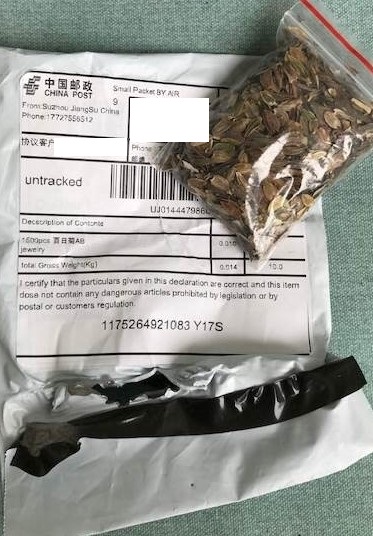
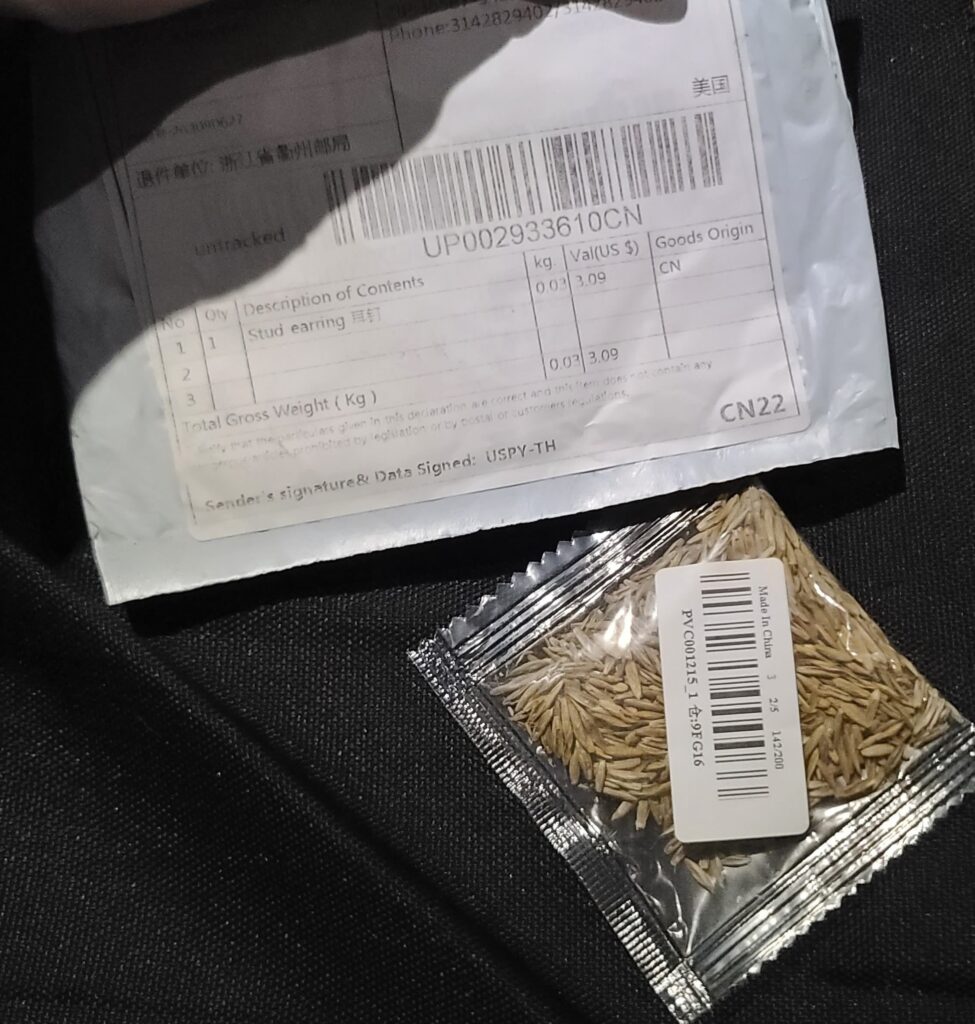
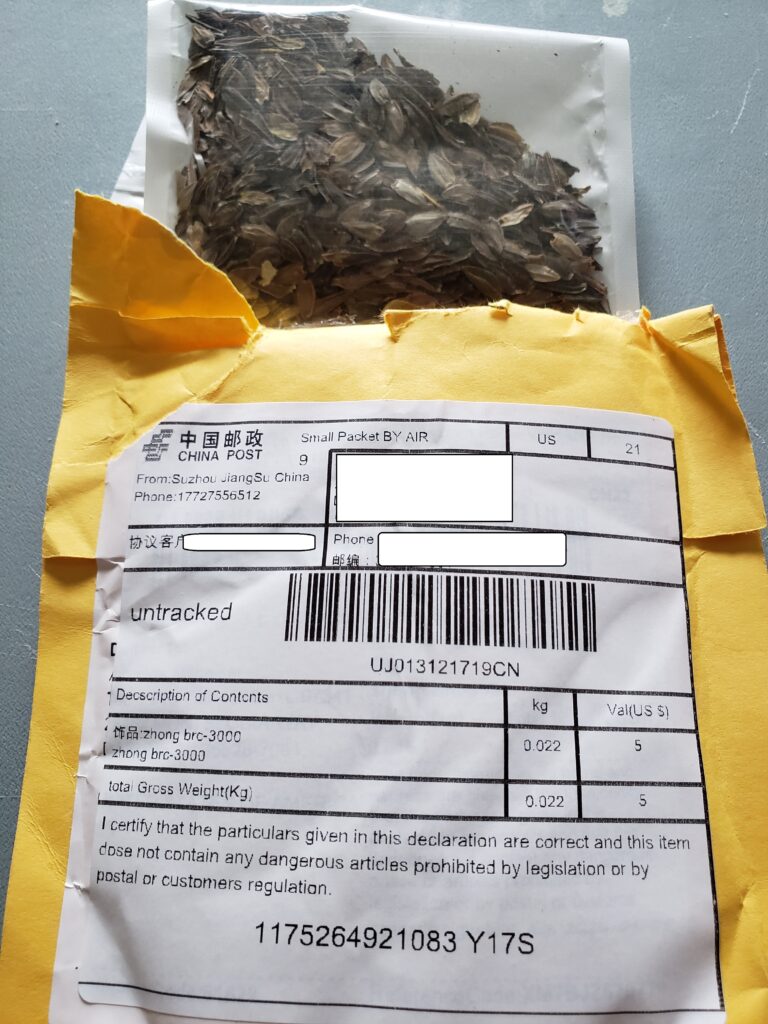
The Alabama Department of Agriculture and Industries (ADAI) has received multiple reports of “unsolicited” China origin seeds being delivered to residents across the state through the United States Postal Service (USPS). The packing is often mislabeled as “jewelry.”
So far, residents from several other states including, Arizona, Delaware, Kansas, Kentucky, Louisiana, Ohio, Tennessee, Utah, Virginia, and Washington State have reported receiving suspicious packages of seeds. This practice is known as agricultural smuggling.
“We urge all residents to be on the lookout for similar packages. These seeds could be invasive or be harmful to livestock,” said Commissioner of Agriculture and Industries Rick Pate.
Currently, we are asking recipients of “unsolicited seed” to follow the instructions below:
1). DO NOT plant the seeds and if they are in a sealed package, do not open the sealed package. Also, DO NOT dispose of the seeds.
2). Report suspicious seed deliveries to USDA Animal and Plant Health Inspection Service (APHIS) and maintain the seeds and packaging until USDA provides further instructions. This may be used for evidence.
Call 1-800-877-3835 or email to [email protected]. For more details visit https://www.aphis.usda.gov/aphis/ourfocus/planthealth/import-information/sa_sitc/ct_antismuggling.
USDA will be releasing official guidance (including additional instructions for reporting unsolicited seeds). These instructions will be shared as soon as possible.
Alabama Agriculture Feeling Effects of COVID-19
By Justin Miller
Practically every industry has been affected by COVID-19 in some fashion. Professionals from the Alabama Cooperative Extension System and Auburn University’s College of Agriculture recently performed a survey to evaluate the impact of the disease on the Alabama agricultural industry.
Adam Rabinowitz, an Alabama Extension farm and agribusiness specialist, said the online survey recorded a total of 181 responses, with responses being recorded from all agricultural related sectors in Alabama.
“A total of 72 percent of the respondents classified their business as production agriculture,” Rabinowitz said. “The second largest category were those classified as other. Many of these specified themselves as involved in the landscaping and turf industry, as well as farmers markets.”
Survey Showed Mixed Results
The results from the survey show some mixed effects from Alabama producers. While many of the producers reported no change for their business operations, 41 percent reported that they have experienced an altered customer base. Additionally, 26 percent of those surveyed said they had to alter products or services.
“Some of the businesses reported that they have had even more substantial impacts,” said Rabinowitz, who is also an Auburn University assistant professor of agricultural economics and rural sociology. “From a long-term perspective, almost 30 percent of them indicated they have experienced long-term cash flow disruptions.”
The survey asked participants to compare their total sales revenue since the coronavirus began impacting them with that same period in 2019. The results were as followed:
producers of field crops reported a 26 percent decline in sales revenue
forestry and timber (including pine straw) reported a 15 percent decline
beef cattle producers saw a 25 percent decline
aquaculture producers (primarily food fish producers) reported a 27 percent decline
poultry producers reported an 8 percent decline
“People must remember that while these broad categories show significant decreases in revenue for many sectors, the impact is not uniform across all commodities,” Rabinowitz said.
Participation in Government Assistance
The survey also assessed the participation of Alabama producers in government-related relief programs. The Coronavirus Food Assistance Program (CFAP) was the most popular program recorded with 43 percent saying they are participating. As of July 6, the USDA Farm Service Agency received a total of 8,971 applications from Alabama producers. A total of $56.4 million in payments were approved.
Participants reported that they have utilized other programs. These include the Paycheck Protection Program and the Economic Injury Disaster Loan, with 42 and 12 percent participation rate respectively.
“The survey also asked those who were not participating in any programs what their reasons were for not participating,” Rabinowitz said. “People reported a combination of insufficient benefit levels, a need for additional information and business ineligibility as reasons for non-participation.”
Participants who reported that their business is not eligible for CFAP, also reported a 39 percent decline in sales revenue.
More Information
A full report of the findings from this survey is available in Assessment of COVID-19 Impacts on Alabama Agriculture. For more information on the impacts of COVID-19 on the agricultural industry, visit www.aces.edu or contact a member of the farm and agribusiness management team.
Outdoor Alabama photo contest opens August 3

The 2021 Outdoor Alabama Photo Contest will begin accepting entries on Monday, August 3, 2020. This year’s contest is a joint project between the Alabama Department of Conservation and Natural Resources (ADCNR) and the Alabama Tourism Department. The deadline to enter is October 31, 2020.
A major change to the 2021 photo contest is a focus on traditional photography techniques and the use of hand-held cameras. No cellphone, smartphone, game camera, or drone photography will be chosen as winning photos for nine of the 10 categories. Smartphone and tablet photos will be accepted in the Young Photographers category.
The photo contest is open to state residents and visitors alike, but qualifying photos must have been taken in Alabama in the past two years. Any amateur photographer not employed by ADCNR is encouraged to enter.
A total of eight photos per person may be entered in the following categories. You may enter all eight in one category or among several categories.
2021 Outdoor Alabama Photo Contest Categories: Alabama state parks; birds; bugs and butterflies; cold-blooded critters; nature-based recreation; scenic; shoots and roots; sweet home alabama; wildlife; young photographers (ages 17 and under.) First, second, third and one honorable mention will be awarded in each category. Winning images will be featured online and in an exhibit traveling to various venues across the state during 2021. Art teachers are encouraged to incorporate participation in the Young Photographers category into their art instruction this fall. An exhibit of the 2020 winning photos will be on display at the 5 Rivers Delta Resource Center in Spanish Fort, Alabama, in early August 2020. To view the winning photos online, visit www.flickr.com/photos/outdooralabama/albums/72157712962216382. For complete 2021 category descriptions and contest rules, visit www.outdooralabama.com/outdoor-alabama-photo-contest.
The Alabama Department of Conservation and Natural Resources promotes wise stewardship, management and enjoyment of Alabama’s natural resources through four divisions: Marine Resources, State Lands, State Parks, and Wildlife and Freshwater Fisheries.
Luke Smelly of Greensboro is Alabama Catfish Farmer of the Year for 2020

After graduating high school, Luke Smelley went on to study cattle management and later combined that knowledge with his extensive catfish farming experience from his childhood. Luke was able to build a cattle and catfish farming operation close to his home in Greensboro. Over the course of 10 years, he and his family have grown from 120 cows and 250 acres of water to 425 brood cows, 500 stockers and 600 acres of water for catfish. Luke received the prestigious Alabama 2019 Outstanding Young Farm Family award. Luke and his wife, Lana, were married in 2008. They now have five children, ranging from ages 2 through 11, and they all actively work together on the family farm. When they’re not working, they stay active in their church, enjoy the outdoors, take family trips and give back to their community.
Read Luke’s recipe and more about Terry and Will at https://www.uscatfish.com/catfish-farmers-of-the-year-2020
Attracting Garden Pollinators During Late Summer
By Katie Nichols
Pollination is one of the most common concerns when planting spring and early summer gardens. Oftentimes people forget about pollinators as the season heats up and the garden withers. So, just how can gardeners take better care of pollinators through the summer months?
Dani Carroll, an Alabama Extension home grounds, gardens and home pests regional agent, said there are several ways to ensure pollinators are active in a growing space. By simply observing a garden or flowerbed for a short period of time, one can determine whether pollinators are—or are not—present.
Carroll said pollinators are like humans. These insects need three major things – food, water and shelter. Gardeners often forget pollinators prefer an assortment of foods and do not feed on the same thing repetitively. Incorporating a variety of flowers and herbs can help provide pollinators with options to keep them coming back to the garden for more.
“Everyone is familiar with honeybees as pollinators,” Carroll said. “But, if you don’t live next door to a beekeeper, there are other native pollinators gardens can attract.”
There are thousands of pollinators regularly contributing to garden pollination. Squash bees, sweat bees, leaf cutter bees, bats and butterflies all play a small role in the fruitfulness of productive gardens. Many native bees, aside from honeybees and bumble bees, can pollinate the plants that are not self-pollinating and require assistance to bear fruit.
While there are plants that are totally dependent on pollinators, such as cucumbers of the cucurbate family, there are also self-pollinated plants, such as tomatoes. Each of these benefit from pollinator activity. The buzzing vibration helps shake pollen loose for tomatoes, while the cucurbate family relies fully on the services of a pollinator to carry pollen and bear fruit.
One of the larger aspects to carefully consider is pesticide use. Carroll said there are times when pesticide use can be helpful, but as most gardeners know, it can also be harmful. Monitoring the crop is an easy way to determine a good time for application. When flowers are open and pollinators are out, refrain from using pesticides. Pollinators are generally inactive at night making it a good time to apply chemicals.
There are also several easy ways to get rid of pests without using pesticides.
“Monitoring is a very effective way to determine whether to use a pesticide,” Carroll said. “If there are only two aphids, it is very likely that native beneficial insects will take care of the problem. With pests like the tomato horn worm, simply picking the worm off of the plant is an easy and effective way to protect the crop.”
When caring for garden pollinators during the summer, Carroll said it all comes back to the necessities—food, water and shelter.
“Alabama has been known to face drier than usual weather pattern during the hot, summer months,” she said. “It is important to remember that bees need water too.”
Providing a water source is a good way to care for garden pollinators during the hot summer months. Caroll said a birth bath or shallow pan filled with water will work well.
“Add a few rocks to provide a landing pad for the bees to perch on,” she said. “Just remember to change the water a couple of times per week to prevent mosquitoes from breeding.”
Find more information on gardens and garden pollinators by visiting the Alabama Extension website www.aces.edu.
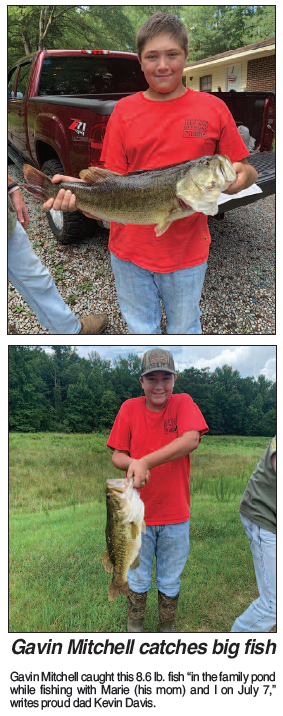
Residential Wildlife Sightings Up During COVID-19
COVID-19 has altered nearly every aspect of day-to-day activity. Many changes to human habits were expected. However, many communities have experienced a surge in wildlife sightings as animals venture out in search of alternative food sources.
Rodent Sightings Surge
Urban areas, especially, have seen an increase in rodent sightings since the outbreak of COVID-19.
“Less human presence due to lockdowns and social distancing has allowed rodents to move more freely,” according to Norm Haley, a forestry, wildlife and natural resources regional agent with the Alabama Cooperative Extension System.
Quarantining, in addition to the closures of many restaurants and businesses have triggered a dip in the rodents’ normal food supply. These two factors led to an increase in rodent sightings, as well as aggressive behavior.
Preventative Measures
In order to take preventative measures, it is important to consider location and which wildlife species may be a cause for concern. Groups of raccoons, opossums or striped skunks that have become dependent on human food waste may turn to a yard or home due to restaurant closures.
“To help ensure these animals don’t become a problem, keep trash tightly sealed or only put out on the morning of pick-up,” Haley said. “Keep all pet food and bowls inside, as even the oils and grease left behind on an empty bowl will attract wildlife. Homeowners should also monitor the outside of their home for signs of wildlife presence or damage.”
Increase in Wildlife Sightings?
While reported rodent sightings have increased during the COVID-19 pandemic, Haley said many wildlife sightings are the result of humans having more time. The shift to working from home has allowed humans to see the coyotes, fox, deer and birds that typically appear after the work day begins.
“Many animals acclimate to human patterns and pressures,” Haley said.
So, as human patterns return to normal—wildlife patterns should, too.
More Information
For more information, visit Alabama Extension at www.aces.edu to learn more about protecting your home and yard against wildlife.
Additionally, check out the Centers for Disease Control and Prevention warning about aggressive rats due to COVID-19.
Hiking with Hailey’ Explores Alabama’s Great Outdoors
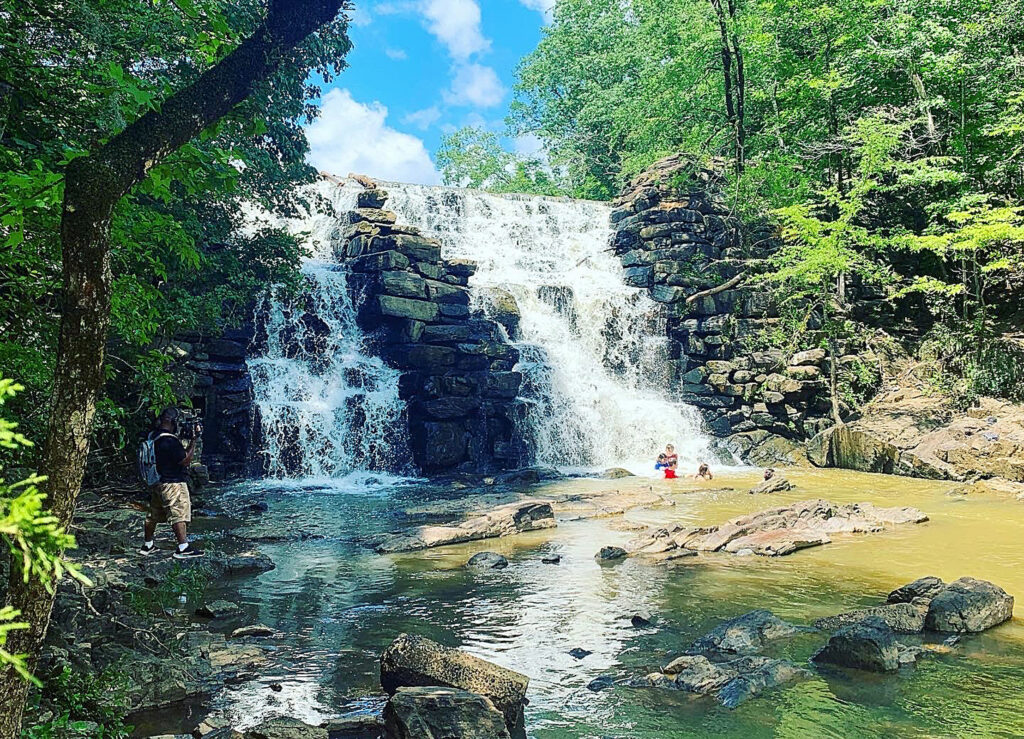
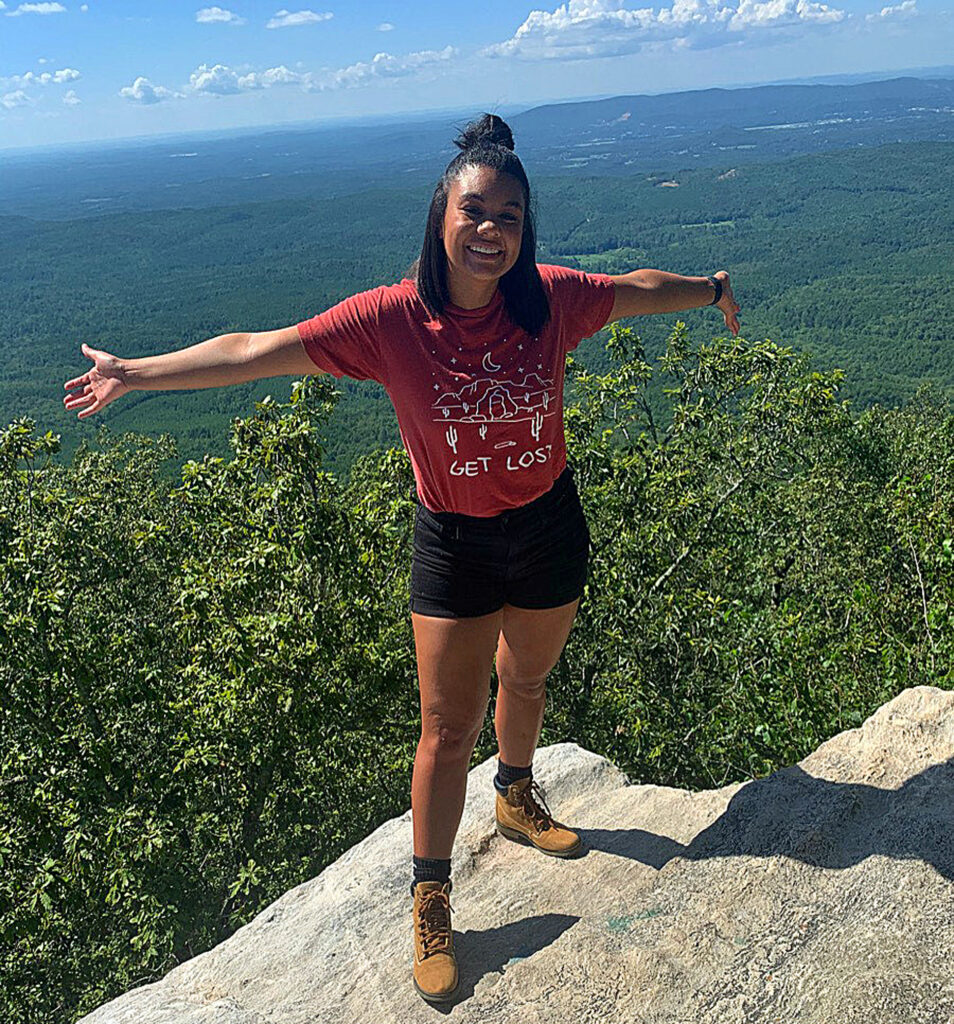
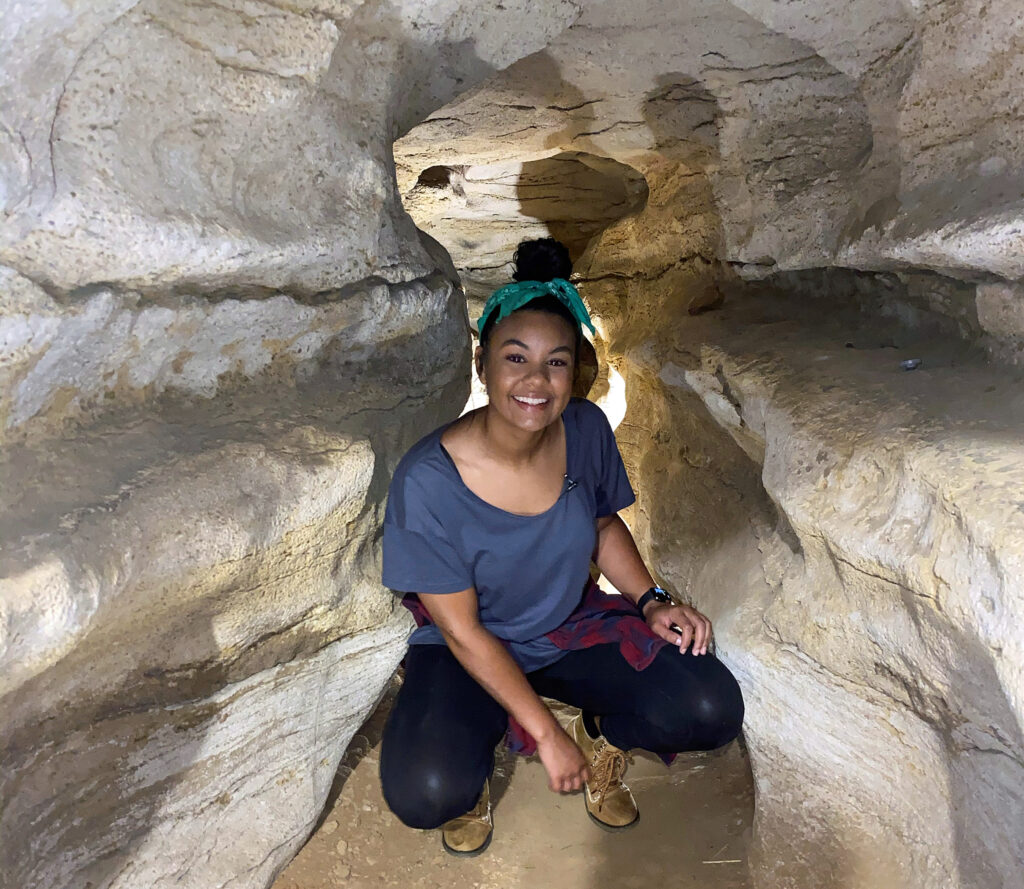
By David Rainer, Alabama Department of Conservation and Natural Resources
For someone who really doesn’t care for insects, Hailey Sutton has put her fears behind her to share Alabama’s great outdoors via her increasingly popular “Hiking with Hailey” segments on Montgomery’s WSFA-TV.
Sutton, who hails from Red Oak, Texas, has been in Alabama for less than a year after her first TV gig in Montana.
The weekend sports anchor at WSFA, Sutton has a background in soccer rather than the outdoors. Despite her lack of outdoors experience, she pursued an idea of hiking through numerous Alabama State Parks and other natural wonders. That concept blossomed into weekly episodes that may turn out to be more than the summertime feature she originally envisioned.
“This whole series is kind of funny,” Sutton said. “I don’t really like to be dirty, and I’m terrified of bugs. Living in Alabama, this has been challenging. My first job was in Montana, and their bible up there is the outdoors. I had wanted to do a similar series in Montana, but I just didn’t have the resources.
“When I moved here, I saw all these different parks. I was able to pitch the idea to my boss, and then the coronavirus happened. That kind of gave me a chance to step away from sports since they haven’t had as many sports going on.”
Sutton admits the series has caused her to expand her horizons to provide her viewers with snapshots of the beauty of Alabama.
“It was a refreshing way to push myself out of my comfort zone,” she said. “In this past weekend’s episode at Cheaha State Park, our guide had us eat a leaf. If you had told me three years ago that I would be on TV eating plants for my job, I would have LOLed. But it’s been really fun to do something different and push myself.”
The Cheaha State Park episode, where Park Naturalist Mandy Pearson got Sutton to sample a leaf from the sourwood tree, was the sixth in the series that started at Oak Mountain State Park.
“Cheaha was awesome,” Sutton said of the park that sits atop the highest mountain in the state. “I’d seen pictures and videos of Cheaha, but pictures and videos can’t do justice to how cool it is to get up there and be able to see all the way to Birmingham, which seems crazy to me.
“I’ve just been blown away by how diverse Alabama is. What we have focused on each week is trying to show something every week. We started out at Oak Mountain, which is the largest state park (9,940 acres) in Alabama. So, if you’re looking to get a little bit of everything, that’s a great place to start.”
Sutton decided to downsize the next week with a visit to the Alabama Wildlife Federation’s Alabama Nature Center at Millbrook.
“Obviously, the Alabama Nature Center is smaller, but they do a lot of programs to educate kids about nature,” she said. “I thought that was really neat, especially during the summer, highlighting that this is still something available to do with your kids.”
Sutton and crew then visited Wind Creek State Park, the 1,445-acre park on the banks of scenic Lake Martin in east central Alabama.
“Wind Creek was really neat because you’ve got the forest and the lake atmosphere,” she said. “That was really cool.”
Next up was a visit to 696-acre Chewacla State Park and its iconic waterfalls that were formed when Moore’s Mill Creek was dammed to create Lake Chewacla.
“I had been to Chewacla once before,” Sutton said. “It’s just so funny. You hop off I-85 and you’re right there at the park. That’s one of the things our guide, Joshua Funderburk, said was one of the things that make this park so interesting is you’re in the middle of Auburn, but you feel like you’re in the middle of nowhere when you’re there.”
Sutton found her trip to Rickwood Caverns State Park, just north of Birmingham, to be one of the most enjoyable for a variety of reasons.
“Rickwood was awesome,” she said. “That may have been my favorite place. One, it was cool in the caverns. It was 60 degrees, so it was nice to not be sweating. The other thing is it was so ‘otherworldly.’ It was just so different from anything I had ever seen.”
Sutton highlighted all of the amazing features of the caverns with their numerous formations estimated at 260 million years old. She also discussed the exit from the caverns and the number of steps involved.
“It was crazy,” she said. “Going into the cave, it’s not 110 steps down to get to the features. It was a gradual descent. Then our guide told us, ‘Oh, by the way, to get out you have to go up 110 steps. We had to sit for a couple of seconds after we got done with the steps.”
Designed to give a glimpse of the great outdoors before her busy season started, the series surprised Sutton with how quickly it gained a widespread following. She said the impact of the coronavirus will likely dictate what happens next.
“I guess it just kind of depends on what happens to football season,” she said. “It was originally a summer project. But, if there’s no football, it will depend on how busy my schedule gets. I don’t know if we have a timeline on it. To be 100 percent honest, I didn’t know it was going to be as popular as it has become. I guess as long as people are watching…”
Sutton said she is amazed at how quickly word has spread about the “Hiking with Hailey” series.
“We have people reaching out to us on a regular basis asking us to come to their park,” she said. “We had to make a list of all the places we would like to go. If we have to stop, then there’s always next summer or later in the year. It’s been good.
“There are so many parks and forests to explore. I’m really excited that we’re going to Bankhead National Forest in a couple of weeks.”
Visit www.wsfa.com/authors/hailey-sutton/ and scroll to find each episode of “Hiking with Hailey.” The episodes are also on the “Hiking with Hailey” Facebook page.
New Deer Zones, Early Dove Season and the Return of Sandhill Crane Hunting for 2020-2021
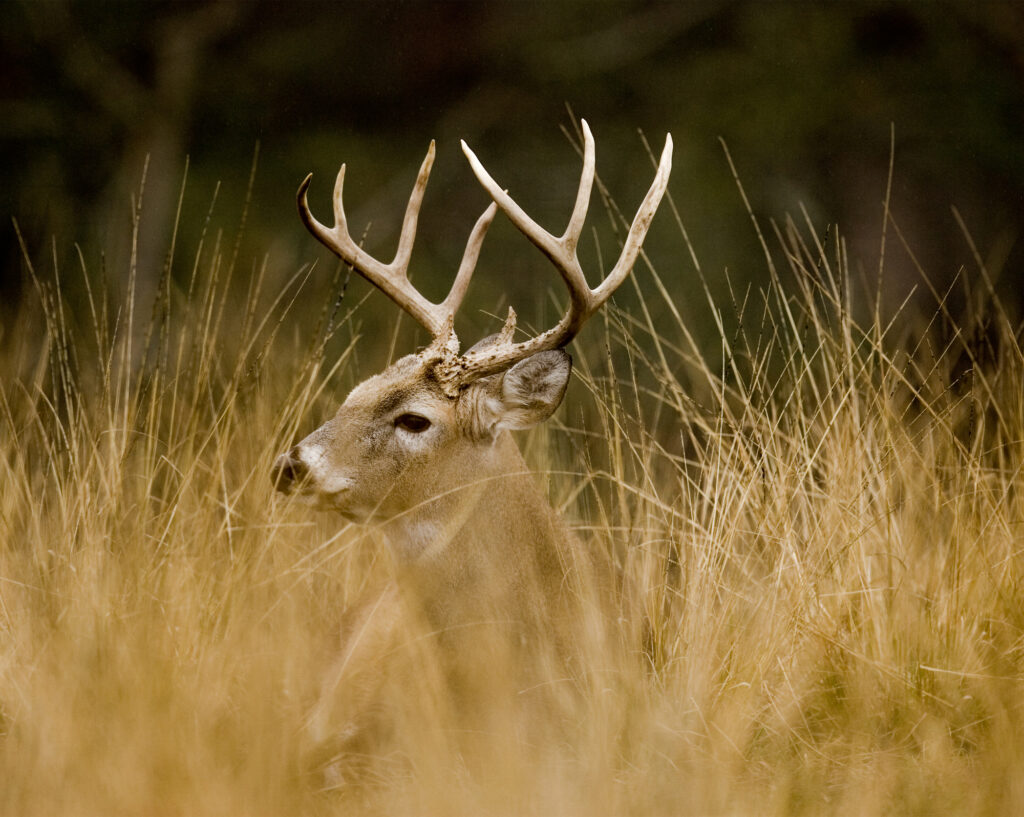
he 2020-2021 hunting season will bring big changes for white-tailed deer hunters in a few parts of Alabama with the creation of two new deer zones. The newly created zones D and E will allow hunters to gun hunt before and during the peak of the rut (deer breeding season) in those locations.
Zone D includes areas in Cullman, Franklin, Lawrence and Winston counties. Zone E includes areas in Barbour, Calhoun, Cleburne and Russell counties. Archery season for zones D and E will open on October 1, 2020. Gun deer season for antlered bucks will open in both zones on November 7, 2020. Antlered bucks can be taken in zones D and E through January 27, 2021. The unantlered deer harvest dates differ between zones D and E, and both zones close to unantlered deer harvest earlier in January.
Archery deer season opens in zones A, B and C on October 15, 2020. For complete deer season dates and zone information, visit www.outdooralabama.com/seasons-and-bag-limits/deer-season.
In Alabama, the peak of the rut varies throughout the state. This is due, in part, to deer restocking efforts that occurred decades ago. Deer population data collected over the last 25 years by Alabama Division of Wildlife and Freshwater Fisheries (WFF) biologists is leading to a better understanding of the state’s deer population. That data is also providing improved hunting opportunities, including the fine-tuning of the state’s deer hunting zones to allow hunters to hunt the peak of the rut statewide.
“The creation of these new deer zones highlights the hard work of our wildlife managers and the importance of harvest data provided by Alabama’s hunters,” said Chris Blankenship, Commissioner of the Alabama Department of Conservation and Natural Resources (ADCNR). “The Department strives to offer the best hunting opportunities available, and I’m happy to announce the new deer zones.”
Hunters are reminded to record their deer harvest before moving the animal using a paper harvest record or through Game Check in the Outdoor AL smartphone app. If using the paper harvest record in the field, hunters must still report their harvest within 48 hours through Game Check using the Outdoor AL app or online at outdooralabama.com.
DOVE SEASON COMES EARLY THIS YEAR
Dove season for the North Zone will open on Labor Day weekend this year, a week earlier than in previous years. Both the north and south zones feature split seasons.
This year’s North Zone dove season will open on September 5 and run through October 25 for the first segment. Hunters on opening day can hunt from noon until sunset. After opening day, hunting is allowed from one-half hour before sunrise until sunset. The second segment runs November 21-29, and the final segment is set for December 12 through January 10, 2021.
The South Zone season opens on September 12 and runs through November 1. The final two segments mirror the North Zone dates. The daily bag limit is 15 birds of either mourning doves or white-winged doves or a combination of the two.
Registration for the state’s youth dove hunts will open in August 2020. For complete dove season dates and zone information, visit www.outdooralabama.com/seasons-and-bag-limits/mourning-and-white-winged-dove-season.
SANDHILL CRANE SEASON RETURNS
Sandhill crane hunting returns for the 2020-2021 season. Last year saw the first sandhill crane season in Alabama in more than 100 years.
The season is by limited quota permit only – prospective hunters must apply online. Registration is currently closed but will open this fall with an associated registration fee. The permits will be chosen by a computer-controlled random draw in October 2020. A total of 400 permits will be issued.
The season dates are split into two segments with the first running from December 4 to January 3, 2021. The second segment will be January 11-31, 2021. The daily, season and possession limit is three birds per permit. Hunters can harvest all three birds in one day if they choose.
For complete sandhill crane season dates and zone information, visit www.outdooralabama.com/seasons-and-bag-limits/sandhill-crane-season.
TURKEY SEASON OVERVIEW
For most of the state, the 2020-2021 turkey season will run March 20 through May 2, 2021. Zone 4 (Clarke, Clay, Covington, Monroe, Randolph and Talladega counties) has both a fall and spring season. The fall season in Zone 4 runs November 21-29, and December 12 through January 1, 2021.
Spring turkey season will be delayed for research purposes on the following Wildlife Management Areas: Barbour, J.D. Martin-Skyline, Hollins, Oakmulgee, Lowndes, Choccolocco and Perdido River. The delayed season will run March 27 to May 2, 2021.
Hunters are reminded to record their turkey harvest before moving the animal using a paper harvest record or through Game Check in the Outdoor AL smartphone app. If using the paper harvest record in the field, hunters must still report their harvest within 48 hours through Game Check using the Outdoor AL app or online at outdooralabama.com.
Special youth hunts will take place on the Saturday and Sunday the week prior to all opening days of the spring season. For complete turkey season dates and zone information, visit www.outdooralabama.com/seasons-and-bag-limits/turkey-season.
ADDITIONAL SEASON INFORMATION
All other hunting seasons including waterfowl, feral pig, bobwhite quail, squirrel, rabbit, trapping information and more can be found on the seasons and bag limits page of outdooralabama.com or in the 2020-2021 Alabama Hunting & Fishing Digest (now available).
Alabama’s recreational hunting and fishing licenses expire annually on August 31. The presale for 2020-2021 licenses will open on August 24, 2020. Licenses can be purchased from various vendors throughout the state or online at outdooralabama.com.
ADCNR is once again offering hard card licenses for the 2020-2021 season. For an additional $5 fee, purchasers can select from six new designs including white-tailed deer, wild turkey, wood duck, crappie, redfish and a “We the People…” design featuring the Second Amendment.
HUNTER RESOURCES
WFF’s Adult Mentored Hunting (AMH) program was designed for those new to hunting or interested in learning how to hunt. The program provides new hunters with a one-on-one hunt under the guidance of a veteran mentor. To apply for an AMH hunt, you must be at least 19 years old, have a valid driver’s license and be new to hunting or have limited hunting experience. More information about the AMH program can be found at www.outdooralabama.com/mentored-hunting-program.
Alabama is rich in natural diversity with more than 1.3 million acres of public hunting land and some of the most liberal seasons and bag limits in the nation. Public land hunting opportunities in the state include Wildlife Management Areas, Special Opportunity Areas, Physically Disabled Hunting Areas, Forever Wild land, U.S. Forest Service land, U.S. Army Corps of Engineers land, Tennessee Valley Authority land and several National Wildlife Refuges.
While hunting is one of the safest outdoor recreational activities, each year unnecessary hunting accidents happen and some are fatal. ADCNR reminds hunters to practice hunter safety including routine treestand maintenance and safety checks, always using a full-body safety harness when hunting from a treestand, wearing hunter orange and practicing firearm safety. For additional hunter safety tips, visit the hunter education section of outdooralabama.com.
The Alabama Department of Conservation and Natural Resources promotes wise stewardship, management and enjoyment of Alabama’s natural resources through four divisions: Marine Resources, State Lands, State Parks, and Wildlife and Freshwater Fisheries
No Live Auction for 2020 State Lands Hunting Leases
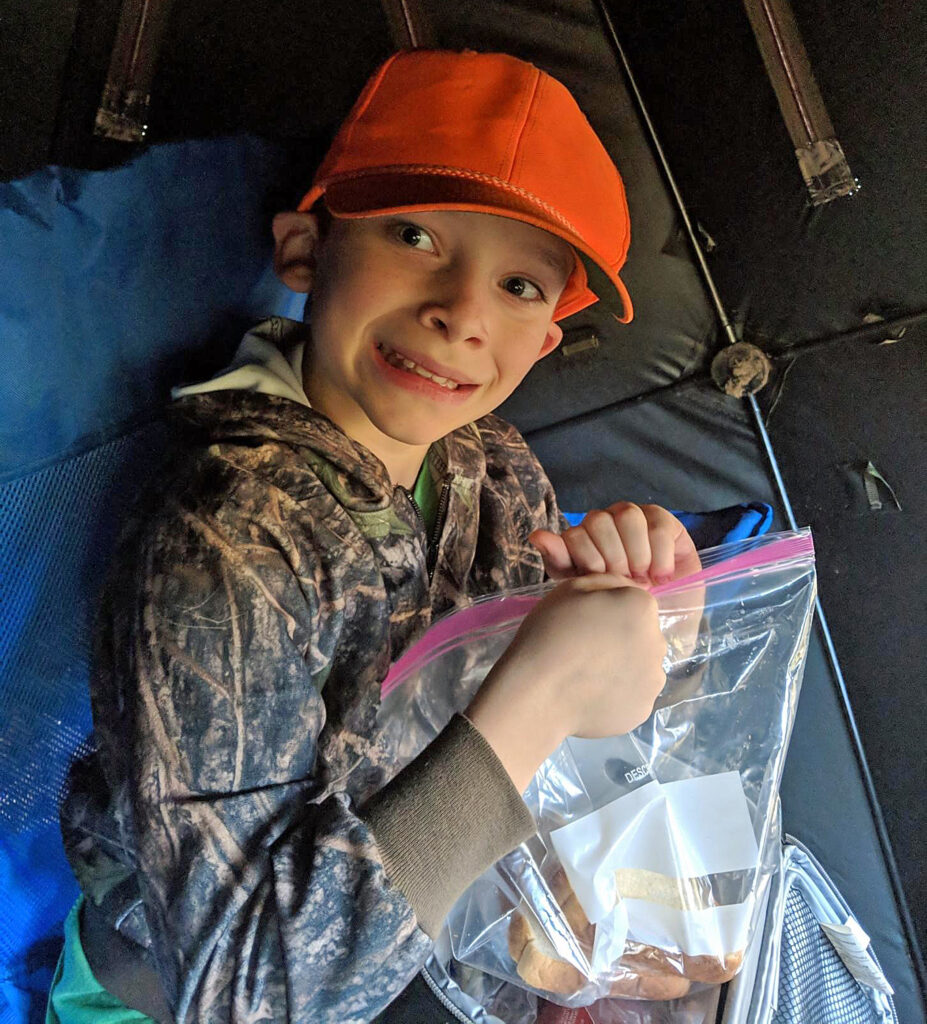
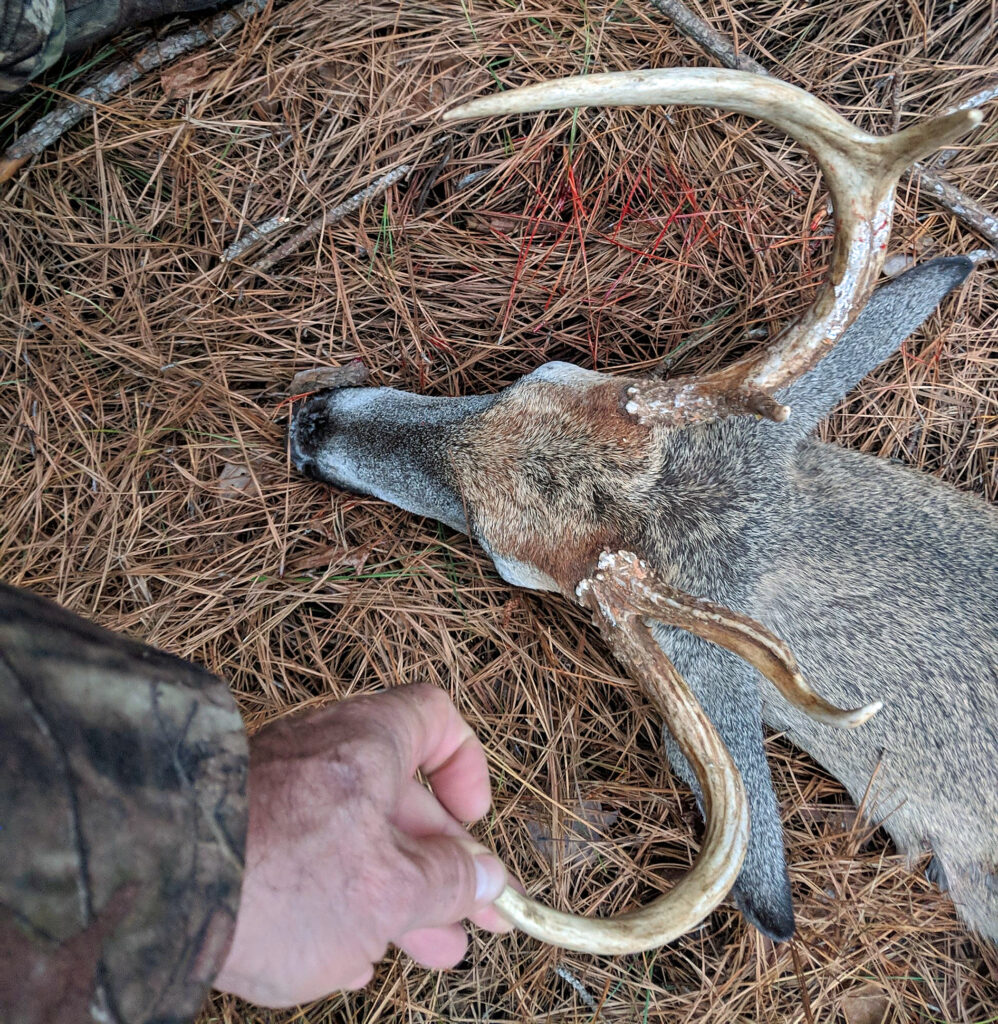
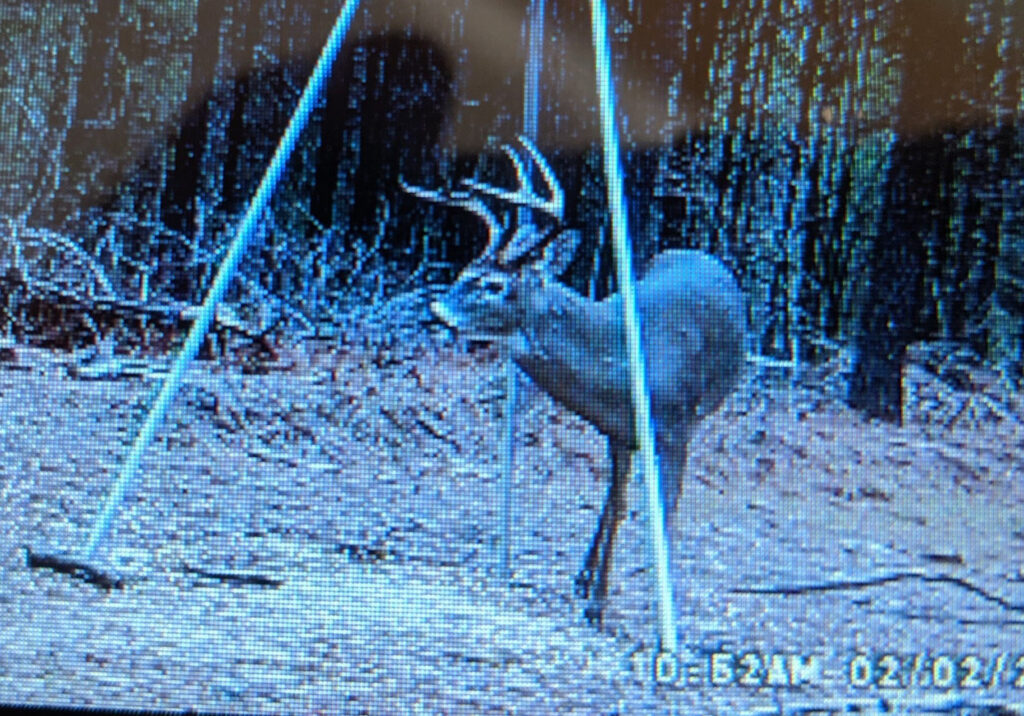
By David Rainer, Alabama Department of Conservation and Natural Resources
Due to COVID-19 restrictions, the State Lands Division of the Alabama Department of Conservation and Natural Resources (ADCNR) will conduct its hunting lease program without a live auction for 2020.
Patti Powell McCurdy, State Lands Director, implemented a program in 2010 that aligned all leases under State Lands’ control to operate on a five-year public bidding cycle. State Lands would kick-off a new cycle by advertising an Invitation for Bids listing all the tracts available for leasing.
Until this year, potential lessees could submit sealed written bids, but they also had the opportunity to continue bidding at a live auction.
“We had an auctioneer conducting the bidding,” McCurdy said. “If we received written bids on a tract, the highest written bid then became the new minimum at the live auction. Like any other auction, people would be raising their hands and yelling out bids. It was fun to watch.”
McCurdy said when it came time to send out the 2020 Invitation for Bids, the uncertainties related to COVID-19 presented hurdles that made it unrealistic to try to hold a live auction.
“We held off a bit in hopes that we could find a way to successfully include a live auction component,” she said. “We never really got there. The last thing I wanted was for a hunter to drive several hours and then be unable to bid at the live auction because of capacity limitations or other restrictions. I ultimately decided to move forward the best way we could. So, for the 2020 cycle, State Lands will only be accepting written, sealed bids.”
However, with the 2020 cycle providing avid hunters an opportunity to submit bids for 145 tracts across 30 counties, there is still plenty to get excited about this year.
McCurdy said the hunting lease program expands the many excellent public hunting opportunities currently offered by the Department of Conservation and Natural Resources on the state’s wildlife management areas (WMAs), Special Opportunity Areas (SOAs) and various Forever Wild Land Trust tracts.
“The leasing program gives individuals the opportunity for a totally different hunting experience – a very personal one,” she said. “Not everybody has access to family land or a hunting club. This gives the public an opportunity to lease a tract and enjoy it with family and friends. Our bidders range from hunting clubs to grandparents looking for a place to take their grandkids hunting. I suspect we might also have a few bidders who just want a place to get away and enjoy all by themselves. It’s just a different experience we can offer the public.”
One happy lessee is Marty Pasley, who leases a tract in central Alabama. Pasley said the lease allows him to take his 9-year-old grandson hunting anytime he is available.
“This has been great for me and my grandson,” Pasley said. “It’s been a godsend for me because it’s close to home. It’s been the greatest experience in the world with the way State Lands did everything they said they would do.
“It’s been a great setup to take kids. Almost every time we go, we see deer. I’ve really been blessed to be able to lease this property.”
While Pasley leases for his family, hunting clubs also participate in the program.
“It’s been fantastic for us,” said Brian Fulkerson, who leases land in south Alabama. “If I need any support, they (State Lands) are fantastic. We’re on the QDMA (Quality Deer Management Association) program, so we take care of our deer.
“I know they didn’t have a choice on the bidding process. Sealed bid is okay with me.”
Interested bidders can go to www.outdooralabama.com/hunting-lease-bid-2020 to see the 2020 Invitation for Bids, a “Complete Listing of 145 Hunting Lease Tracts” (ranging from 43 acres to 1,400 acres), maps for each hunting lease tract, and a sample hunting lease.
“I encourage everyone to first read the Invitation for Bids very carefully,” McCurdy said. “It is the official document detailing all requirements related to submitting a bid that must be followed so that the bid can be accepted by State Lands.”
Perhaps most importantly, the opportunity to submit a bid will close on July 30 at 3 p.m., the deadline for all sealed bids to be physically received at the State Lands Division office in Montgomery.
“It’s the responsibility of each bidder to make sure it reaches our office on time,” McCurdy said. “We cannot accept any bids for any reason after the deadline in the Invitation for Bids. Bidding starts at the tract-specific minimum bid amount noted in the Complete Listing.”
Each bid submitted must also include a certified or cashier’s check (no cash or personal checks) for the required bid deposit for that tract. McCurdy said the required bid deposit amount can also be found on the Complete Listing.
“We can’t consider any bid that is not accompanied by the bid deposit,” she said. “Again, it is just so critical to read and follow all the instructions in the Invitation for Bids. Successful bidders will have the bid deposit applied to the first year’s rent. Bid deposits submitted by unsuccessful bidders will be returned.”
“After the bid opening on the following day, hopefully by close of business, the highest bids for each tract will be posted at the same website link (see above),” McCurdy said.
In the event of a tie, State Lands will contact the tied bidders regarding the process for those bidders to continue the competition and arrive at the highest bid.
“If a successful bidder fails to execute the lease within the required 30-day period, we can contact the next highest bidder,” McCurdy said. “So, even if you are not the highest bidder initially, you could still have a chance to lease the tract you want.”
Interested bidders should also take the time to review the sample lease. McCurdy said it is important to be sure you are willing to comply with the lease provisions throughout the five-year lease period, before submitting a bid.
“One requirement is to maintain general liability insurance,” she said. “A successful bidder must also submit a list of the proposed hunters who will be on the tract. We do check those hunters for a record of game violations. Lessees are also required to provide some landowner assistance and generally return the tract to State Lands in as good or better condition than they found it.”
The hunting lease program is just one example of how State Lands fulfills its responsibility to manage a variety of state-owned land for the purpose of generating revenue.
“Like any business that manages real estate as an asset, State Lands is charged with trying to find ways to make these tracts a revenue-generating asset for certain state agency beneficiaries,” McCurdy said. “To some, this might sound like an unexpected role for the Department of Conservation and Natural Resources, but really it’s not. Employing proven conservation principles and implementing best management practices has always been directly linked to the resulting productivity of land. While you might see a one-time generation of revenue, you will never achieve the goal of perpetually generating revenue unless you take proper care of the land over the long term.
“So, these leases are truly a win-win for the state and hunters. They generate revenue for various state agencies, like the Department of Education and the Department of Mental Health, and at the same time allow State Lands to offer a unique hunting opportunity to anybody willing to participate in the bid process.”
Auburn University wildfire expert discusses wildfire season and how landowners can better prepare
As most of the United States enters the wildfire season, Auburn University wildfire expert John Kush comments on what can be expected and how landowners and managers can help reduce occurrences and damage.
What is the best way to prepare land to help prevent forest fires in the future?
The best way to prepare land to help prevent forest fires is to reduce the fuel load that is present. Fire needs three things: oxygen, heat and fuel. There is very little we can done about those first two factors, but we can work on the fuel. Good portions of the South see fire every year through people conducting prescribed fires. Often the goal is to improve wildlife habitat, recreation and aesthetics, making forest management easier. Fires make this happen, but they also reduce the fuels available to burn. The smaller amount of fuel available to burn, the less intense the fire. If fire is not an option, there are mechanical means to reduce/remove the fuel, but these can be very expensive. The situation in California is one where fuels have accumulated over the past several decades due to a lack of prescribed fire management and people building homes/communities within forested habitat. Once a fire starts where the fuels are heavy and draped in trees and shrubs, they are very difficult to contain and dangerous to fight.
There are ways homeowners can work toward reducing the wildfire risks their homes face by making them “Firewise.” The National Fire Protection Association has some excellent information on its website to assist homeowners.
How does this forest fire season look when considering the current amount rainfall across the U.S.?
The fire season is very dynamic and can change in a matter of a few days. Just five to seven weeks ago, the Gulf Coast was experiencing drought conditions, while in Auburn we had nearly 10 inches of rain in April alone. Several fires were occurring from east of New Orleans, along the Gulf to central Florida. The rains arrived and right now there is little threat of wildfires in the Southeast. When you talk about the western U.S., their fire season typically runs from June to October. It can start earlier and go later depending on the weather conditions that year. Currently, Alaska is experiencing as many wildfires as is happening in the western states of New Mexico, Arizona and California. As the summer goes on, the threat of wildfires will move north, into the Rocky Mountains and then the Pacific Northwest. The problem in the western U.S. is the low humidity, sometimes in the single digits. Once the relative humidity drops below 20 percent, fires can easily ignite and spread, driven by winds that can be fairly common.
A good source to review is the National Interagency Fire Center’s website which has wildfire predictions. An excellent source of information about fire weather for Alabama can be found on the Alabama Forestry Commission site.
If you are interested in current drought conditions and the potential wildfire risk, check the
Keetch-Byram Drought Index and the Fire Danger Rating, both on the Wildland Fire Assessment System site.
Predictions for drought this summer are also available on the National Weather Service’s Climate Prediction Center’s site. If you are interested in seeing where wildfires are currently happening in the U.S., visit the USDA Forest Service’s Active Fire Mapping Program site.
What is the annual economic damage caused by forest fires?
The annual economic damage caused by wildfires will depend on the length of the wildfire season and the proximity of the fires to homes/communities. The annual losses have been estimated to range from $63 billion to nearly $300 billion. In general, economic losses from wildfires will increase each year with expected changes in climate, becoming warmer and drier, leading to extended wildfire seasons. In addition, people will continue to move out into the wildland-urban interface making it more difficult to fight wildfires when they start.
What are the most common causes of the fires?
The most common causes of wildfires are human-related. Estimates have this as high as 85 percent. Many of them are unintentional, the result of burning debris, unattended campfires, careless disposal of cigarettes, malfunctioning machinery and more. And then you have the intentional act of arson. The major source of a natural cause for a wildfire is lightning strikes.
What is something that would amaze us about forest fires?
In addition to fire being beneficial to many ecosystems and species, fires move faster when traveling uphill. A fire tornado can form when winds around a fire begin to spin. A large enough fire can produce its own weather system. Some species of pine trees need forest fires. The heat allows them to release seeds from their otherwise tightly sealed cones. Another benefit is that areas managed with fire have fewer ticks and chiggers than would otherwise.
About John Kush:
John Kush (retired) served as a research fellow in the School of Forestry and Wildlife Sciences at Auburn University. He earned his bachelor’s degree in forest science at the University of Illinois, Urbana-Champaign, and his master’s and doctorate, both in forest ecology, at Auburn. He conducted research for over 39 years with a focus on stand dynamics, fire effects and restoration and he taught several classes related to forest ecology. He currently teaches a forest fire management class and several classes in the restoration ecology graduate certificate program at Auburn.
North Zone Dove Season Opens on Labor Day Weekend
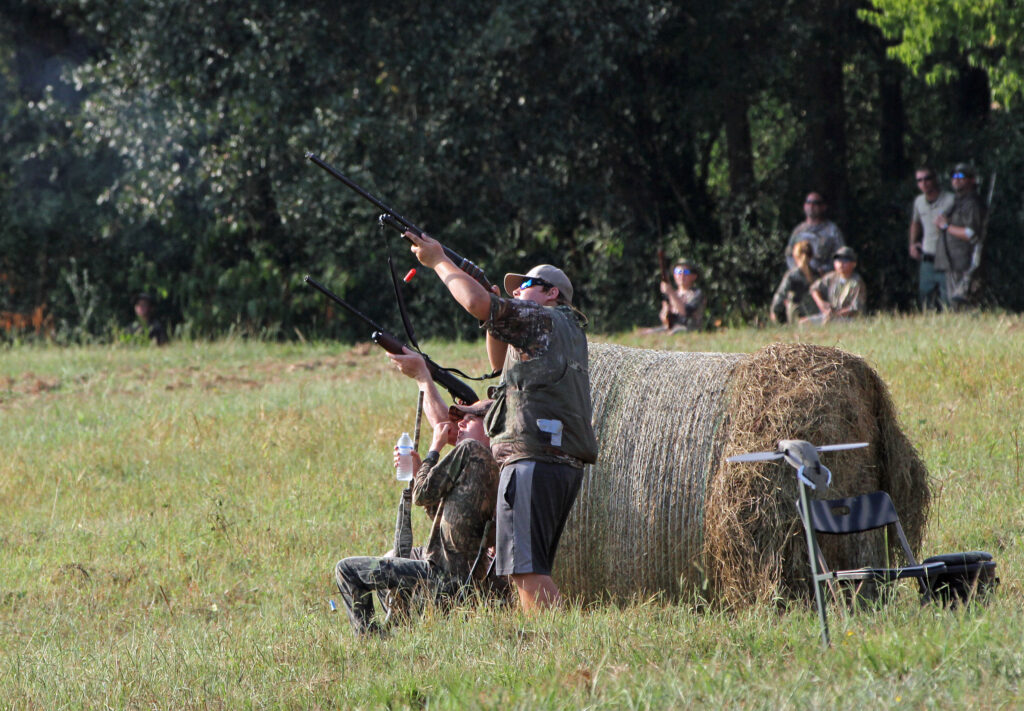
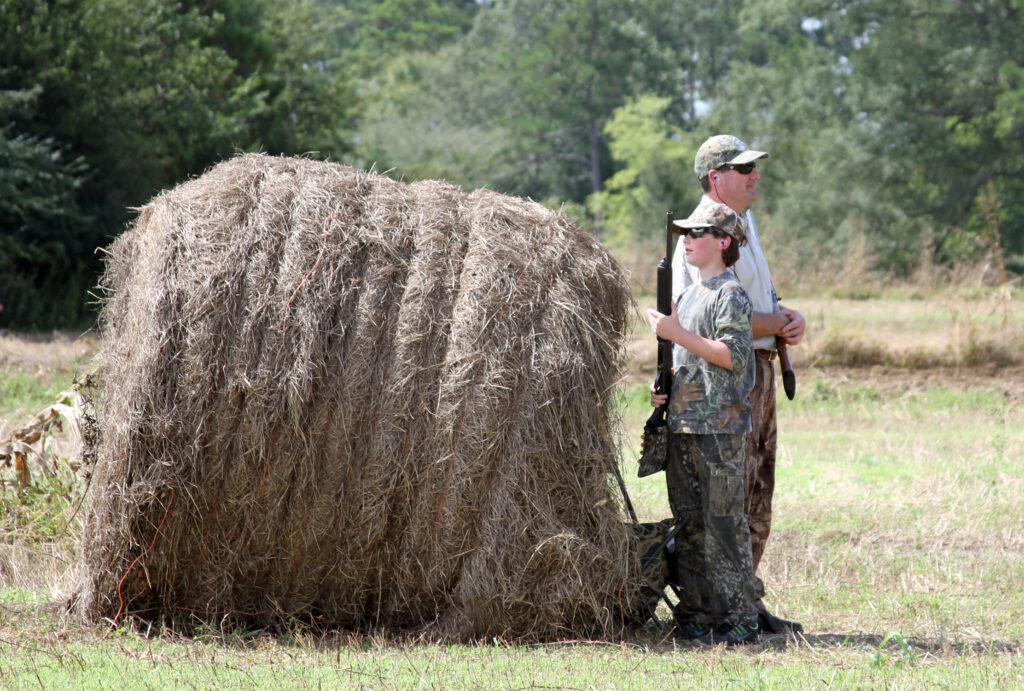
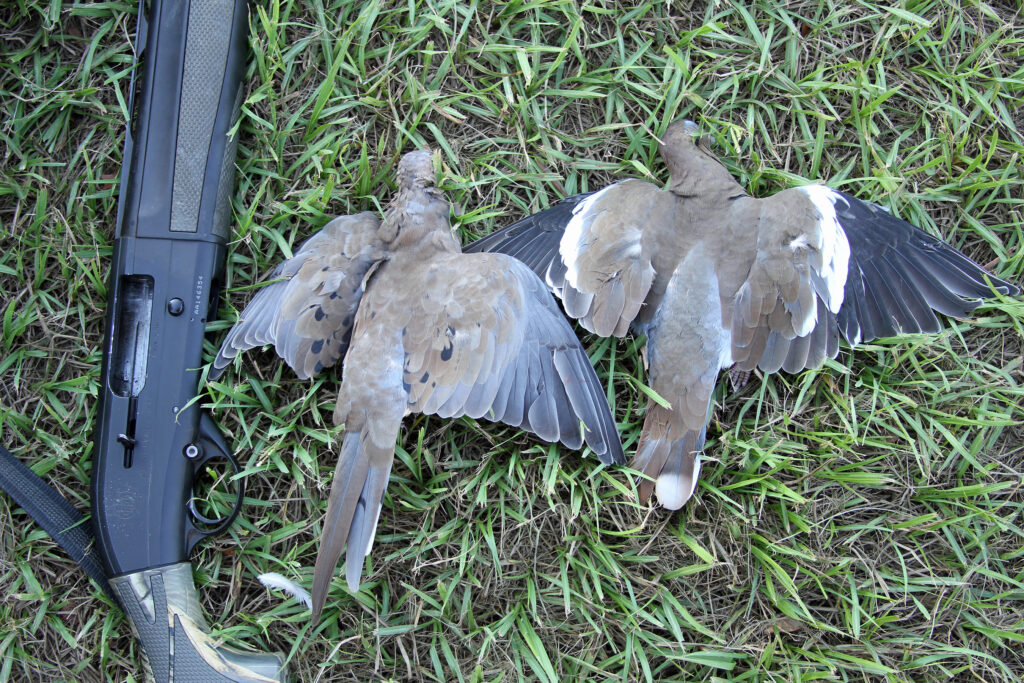
By David Rainer, Alabama Department of Conservation and Natural Resources
Alabama Wildlife and Freshwater Fisheries (WFF) Director Chuck Sykes wants to make sure dove hunters are not caught flat-footed this September when the season opens earlier than usual.
The North Zone dove season will open on Labor Day weekend this year, a week earlier than most people are accustomed to. Sykes wants to get the word out well ahead of the season.
“Most people, me included, typically think dove season opens in the North Zone the first Saturday after Labor Day,” Sykes said. “That’s the way it’s been most years. There have been a few times since 2000 that the season has come in the Saturday of Labor Day weekend.”
Because of a variety of opinions about when Alabama’s dove seasons, North and South zones, should be set, WFF officials decided that a survey inviting public input would be the best way to accommodate the majority of dove hunters.
“With anything we do, you’ve got some people who want the season to start early,” Sykes said. “You’ve got some who want to start late. Some want to hunt in October. Everybody has their own idea about what they want dove season to be, or any season for that matter. What that survey showed was that the majority of people wanted it to come in as early as it could in September. They wanted as many weekends and holidays as possible included where they would have opportunities to go.
“With Labor Day falling later this year, we had to decide if we wanted to push the season to September 12 in the North Zone or if we wanted to have it Labor Day weekend. There’s pros and cons to both sides, but we looked at what that survey said. The majority said they wanted it early, so we gave them the earliest date possible. We were also giving them an extra weekend and giving them a holiday. Those were all three things that ranked extremely high on our survey.”
The North Zone 2020-2021 season is set to start on September 5 and run through October 25 for the first segment. Hunters on opening day can hunt from noon until sunset. After opening day, hunting is allowed from one-half hour before sunrise until sunset. The daily bag limit is 15 birds of either mourning doves or white-winged doves or a combination of the two. The second segment is November 21-29, and the final segment is set for December 12 through January 10, 2021.
In the South Zone of Baldwin, Barbour, Coffee, Covington, Dale, Escambia, Geneva, Henry, Houston and Mobile counties, the 2020-2021 season opens on September 12 and runs through November 1. The final two segments are the same as the North Zone.
“We know we can’t make everybody happy,” Sykes said. “This isn’t something we took lightly. This isn’t something we didn’t deliberate. And it definitely wasn’t something where we didn’t listen to the hunters’ opinions. Basically, this is what the majority of the people who took the survey said they wanted.
“My biggest concern is that I didn’t want people to be caught off-guard. I wanted them to have plenty of time to make their plans for Labor Day weekend or vacation.”
Sykes also pointed out that hunters don’t necessarily have to plan a hunt on opening day, but it is available if wanted. Some may choose to wait until the following weekend.
Sykes and WFF Migratory Bird Coordinator Seth Maddox said the window for planting crops like corn, grain sorghum or sunflowers for doves has passed, but there is a short window for browntop millet remaining.
“You might be able to get some browntop millet in the ground in the next couple of weeks, but the time for other crops has passed,” Maddox said. “If you don’t have anything planted, the best thing to do is to bush-hog or burn off a field and prepare it by disking so that you have a well-prepared seed bed, and then top-sow some winter wheat. You can begin that as early as August, and you are allowed to plant up to 200 pounds of wheat per acre on a well-prepared seed bed.”
Anyone with questions can visit the ACES (Alabama Cooperative Extension System) website at https://www.aces.edu/blog/topics/forestry-wildlife/mourning-dove-biology-management-in-alabama/ to learn more about allowed agricultural practices for dove hunting are listed.
“We see it every year,” Sykes said. “Yes, you can plant for erosion control. You can plant for winter grazing. There are agricultural practices that are legal, but simply going into a pasture and top-sowing wheat is not an accepted agricultural practice. Disking a field and spreading cracked corn is not an accepted agricultural practice.
“The ACES website explains in great detail what agricultural practices are allowed so that you will be legal and have a successful dove hunt.”
Landowners and dedicated dove hunters sometimes make the extra effort by adding fake power lines to attract the birds. Maddox recommends giving the birds as many places to roost and loaf as possible.
“Don’t cut down dead trees near a field,” Maddox said. “They like to have those loafing trees to sit in and check out the field before and after they eat. If you can provide a water source for them, that can make a big difference. And make sure your seedbed is disked well. Doves don’t have strong legs to scratch at the ground like turkeys do to uncover seeds. Doves are also attracted to freshly turned soil. It exposes seeds that didn’t sprout and bugs they eat as well. They pick up bits of grit for their crops to help grind the seeds. Doves are definitely attracted to a freshly plowed field.”
Dove hunting is one of the most popular outdoor activities in Alabama and the nation.
“Most people wouldn’t know that doves are the most hunted and harvested game in the United States,” Maddox said. “In our most recent survey, we had about 36,000 hunters with 200,000 days in the field and a harvest of more than 1 million birds. Most hunters don’t hunt but five or so days a year, so that’s a lot of birds harvested in the first couple of weeks of the season.”
Maddox said the annual harvest has no impact on the overall U.S. dove population of about 250 million birds.
“Doves nest seven or eight times a year here in Alabama,” he said. “They are a short-lived bird with a high rate of reproduction, so we’re not hurting the population at all. This renewable and sustainable resource continues to offer abundant opportunities to Alabama hunters.”
Prediction Low for Pine Beetles in 2020
Good news for forest landowners – Alabama is predicted to have a low number of southern pine beetle (SPB) infestations in 2020, according to the Alabama Forestry Commission (AFC). More specifically, high risk counties are expected to have no more than six to nine SPB spots. The overall prediction for the state is that Alabama has a 16 percent chance of having any SPB spots this active season.
“Southern pine beetle is one of the most destructive forest pests in the southern and eastern United States,” said Dana Stone, AFC Forest Health Specialist. “They will attack most species of pines, but the most vulnerable are dense, mature stands of loblolly, shortleaf, and/or Virginia pines,” Stone continued. “The location and intensity of SPB outbreaks varies from year to year, and infestations are based on many factors. Condition of the pine stand is one factor. Other contributing factors are extended adverse environmental conditions and SPB population levels.”
Since 2018, an updated analytical model has been used to predict infestation trends more accurately. Each year, a spring SPB pheromone survey is conducted to monitor population levels. Several southeastern states participate in the annual survey, including Alabama. Traps are deployed in several counties throughout each state, generally from late February to early March, and remain in place from four to six weeks. Baited with a lure – SPB pheromone (frontalin and endo-brevicomin) and a polyethylene blue sleeve (primarily alpha-pinene) – the traps are checked once a week by retrieving the insects from the traps’ collection cups and counting the number of adult southern pine beetles as well as their predators, clerid beetles. After the survey period, the traps are removed from the site. The results of the number of SPBs and clerid beetles caught each week are used to obtain population levels and predict infestation trends for each state.
The 2020 survey data was collected and submitted by AFC and other agency employees in Alabama and analyzed by researchers from Bates College, Dartmouth College, and the USDA Forest Service. This analysis does not include data from the National Forests in Alabama, so the final report is not complete. While a preliminary summary was determined for the region, this information is by no means absolute confirmation of what will occur across the state.
Identifying Potential Tree Hazards in Your Backyard
Trees are a coveted asset in the yard—that is until the trees present a hazard. Recognizing these potential tree hazards in the early stages could save a tree, as well as your wallet.
One of the first major signs of a hazard is a tree with a recent lean. Trees can lean naturally; they might be growing towards the light or away from other trees and structures.
Beau Brodbeck, Alabama Extension community forestry and arboriculture specialist, said, “You should be very worried about a tree if a storm has come through in recent weeks or months and the tree has a new lean.”
On the opposite side of the lean, mounding will begin to appear where the roots are pulling up out of the ground. On the same side of the lean, the homeowner may see slight indentation where the roots are being pushed further into the ground. This will indicate a hazardous lean which can be very dangerous, especially if it’s recent.
Trees with cracks indicate a potential hazard as well. A past storm or tornado could have twisted the tree, causing a spiraling crack going up the tree.
“Use a coat hanger or something to probe inside the crack to discover how deep it goes,” Brodbeck said. “If it is deeper than bark level, it is a hazard.”
Sometimes when there is a forked tree, cracks may appear at the union of the fork. At that point, the tree is pulling apart under its own weight.
“Anytime you see a crack, whether it’s between two branches on a forked tree or on the trunk, immediately seek further evaluation,” he said.
Cut roots will present a hazard and require further evaluation.
“Any roots within 5 to 10 feet of the tree that are about 2 inches or larger in diameter are cut, the tree might be a hazard,” he said.
Cuts typically occur on trees next to new construction like a sidewalk, building or a new home.
Another visible indicator of hazardous trees is broken or hanging limbs. Big dead snags will eventually come out and present a hazard to people and property under the tree.
The not-so-subtle signs of decay are the fruiting bodies of fungi like mushrooms sprouting from the roots, base or trunk of a tree. Some of these fruiting bodies, referred to as conchs, don’t look like traditional mushrooms. Instead, they might look like half of a flying saucer that can be tough and woody.
Like anything that fruits on the tree, the mushrooms may be there for a while then decompose and fall off. This makes it harder to identify rot in the tree. It is sometimes helpful to look for old mushrooms and conks that have fallen away from the tree.
Other signs of rot include any type of oozing from the trunk or large branches in the tree. If the tree has a small opening with what appears to be a dark stain where liquid has leaked out of the tree, that oozing will often indicate some type of rot inside the tree. The oozing liquid will often have a foul, yeasty smell.
Any large openings, or cavities, in the tree indicate decay as well. If limbs have broken off that leave a large wound, this will require further evaluation of the tree. Anytime open cavities have nesting critters in them, like squirrels, it is large and extensive enough to raise concerns.
Lastly, abnormal swelling in the trunk of the tree is a subtle sign of potential decay. Trees generally taper from thick at their base and slimmer further up. If abnormal swelling counter to the taper is visible, that is an indicator that there is some type of defect inside the tree.
“Just because a tree has decay, it does not mean it is unsafe and needs to be removed,” Brodbeck said. “It simply means you need to have someone take a closer look.”
Some of these decay pathogens are very aggressive and will kill a tree within a year or so. Some of them can be in the tree for decades and will cause slowly deterioration, but it is not something that requires immediate action.
For a tree to be hazardous, there should be a target. Whether the target is a home, vehicle or residents—make sure to identify these targets before evaluating the tree hazards.
The solution to a potential tree hazard is not always to immediately cut it down. Often simple pruning can benefit the tree. Therefore, it is important to contact a specialist.
Once potential tree hazards are identified, look into getting a second opinion. Regional Alabama Extension agents can help to evaluate hazardous trees and give educated guidance on the proper next steps.
Also, the International Society of Arboriculture has a tree risk assessment qualification. Homeowners can also contact a certified arborist about further evaluation.
Bama Bug Fest Goes on the Web

The second Bama Bug Fest will live stream on Facebook and YouTube starting July 7.
Bama Bug Fest: On the Web, a collaboration by University of Alabama Museums, UA Libraries and the Tuscaloosa Public Library, will provide interactive videos, interviews with experts and storytelling for all ages every Tuesday, Thursday and Saturday through July 25.
“I hope that everyone who gets to view the online content for our virtual Bama Bug Fest will learn something new about bugs that they didn’t know previously, and as a result, will develop a greater appreciation for the biodiversity, beauty and importance of bugs in our world,” said Dr. John Friel, director of the Alabama Museum of Natural History.
Content will include a family-friendly bug-related stand-up comedy, insect fashion with UA’s Fashion Archive, baking chocolate chirp cookies with Arthropod Apothecary and world-renowned science educator Dr. Sebastian A. Echeverri.
Segments will air at 10 a.m., 2 p.m., 4 p.m. and 7 p.m. each day. A Q&A session with the public will be held at the conclusion of each day.
Bama Bug Fest will crawl on the web via UA Museums’ YouTube channel; the Tuscaloosa Public Library’s YouTube channel and Facebook page; Alabama Museum of Natural History’s Facebook page; and Mildred Westervelt Warner Transportation Museum’s Facebook page.
For more information, visit www.bamabugfest.org.
Unusual Weather, Unusual Year for Cotton Insects
Mild winter weather, cool spring days and a handful of heat-filled scorchers combined to create an interesting situation with cotton insects this spring and summer. Alabama Cooperative Extension System crop entomologists are keeping a close eye on the evolving situation.
Alabama Extension’s Ron Smith and Scott Graham have been working with busy cotton producers all spring. Now they have focused their attention on summer cotton insects.
Cotton Insects to Watch
Grasshoppers
A warmer than normal, dry winter allowed grasshoppers to overwinter in large numbers.
“We’ve had more calls about grasshoppers than thrips,” Smith said. “This is the worst year of grasshopper issues that I can remember. Grasshopper issues are worse on the Coastal Plain and the Southeast because they survive better in sandier soils.”
The warm weather in March triggered early emergence. In turn, producers battled an influx of grasshoppers to their seedling cotton.
Threecornered Alfalfa Hopper
“We have observed a fair amount of threecornered alfalfa hopper (TCAH) damage in several fields of later planted cotton in north Alabama,” Graham said. “TCAH damage plants by girdling stems leaving a characteristic ‘knot’ around the stem, typically below the cotyledons. Plants will be stunted, and leaves and leaf veins will turn reddish.”
Treatment decisions for TCAH can be difficult because no damage thresholds are established. However, producers rarely observe yield losses from TCAH damage as injury happens early in the season. Unaffected neighboring plants can compensate for the yield lost from damaged plants.
Thrips, Snails, Slugs and Spidermites
Cool, wet April weather in north and south Alabama forced producers to plant later. Graham and Smith said the thrips moved right in with heavy pressure.
“Snails are an emerging issue,” Smith said. “They don’t eat the plants, but so many snails get on a plant that it pulls the plant over.”
While it is not a huge problem, Smith said there is not a pesticide control option or another control option available for producers.
In an unusual situation in Talladega County, slugs destroyed five fields of seedling cotton on one farm.
“These producers planted their cotton into heavy residue, and slugs thrive in heavy residue,” Smith said.
The damage was so bad the producers decided to disk up the field, destroy the old crop residue and replant.
Spider mites were observed and reported on cotton in several locations in central Alabama in mid-June. Mites are always present in small numbers in cotton fields, but can quickly increase in number during a hot, dry period.
Fall Armyworms and Tarnished Plant Bugs
Early in June, fall armyworms were present in conventional corn in Baldwin County. There are not large numbers of producers who have conventional corn so this may be an isolated issue. However, it is unusual for producers to see this pest present in early June.
Graham said producers are experiencing issues with tarnished plant bugs (TPB). Daisy fleabane is a primary host for TPB. It bloomed early and is drying down so TPB are now moving into cotton.
“Tarnished plant bugs typically develop into adults in roughly 21 days,” Graham said. “We expect that generation is moving into cotton now. This is something to look out for because TPB can really damage cotton in the pinhead square stage. We found TPB populations above threshold on June 19 in cotton planted in April. Tarnished plant bugs will be the prominent pest of cotton through the third week of July.”
Stink Bug Complex
Each year, Alabama farmers deal with several stink bug species, known collectively as the stink bug complex. The brown stink bug, the southern green stink bug and the brown marmorated stink bug cause significant issues in corn and cotton. While the brown marmorated stink bug is a new pest, it can cause extensive damage to corn and cotton. Thanks to mild winter weather, stink bugs overwintered in high numbers.
Both entomologists said the necessary control will be different based on geographical location in the state.
Corn and cotton in south Alabama will likely need multiple insecticide applications to control stink bugs, while cotton in the central part of the state may need two to three applications. Cotton in north Alabama may need one spray to control.
“Brown marmorated stink bugs are now part of the stink bug complex in central and north Alabama.” Smith said. “The most injury from BMSB will occur around field borders and in the first 50 feet of cotton fields.”
Corn, which serves as a trap crop, can be treated which may reduce their numbers in cotton.
Redbanded Stink Bug
In addition to the stink bug complex, soybean producers should keep a watchful eye on fields for the redbanded stink bug, which have already been treated in Louisiana.
“This is a major pest of soybeans,” Smith said. “These stink bugs are natives of South America and came to Alabama through Louisiana. These stink bugs don’t have an inactive state. Growers need to be aware as the crop beings to develop pods.”
While the redbanded stink bug can overwinter as far north as Prattville, Alabama, they are pushed back to the Gulf Coast in colder weather. Because the winter was mild in Alabama, these stink bugs are already present in Alabama soybeans.
More Information
For more information about cotton insects from Alabama Extension professionals like Ron Smith and Scott Graham, visit the Alabama Crops website via www.aces.edu. Interested producers and industry personnel can also subscribe to the Alabama Cotton Shorts newsletter and the Alabama Crops Report weekly newsletter.
Read archived issues of Alabama Cotton Shorts online.
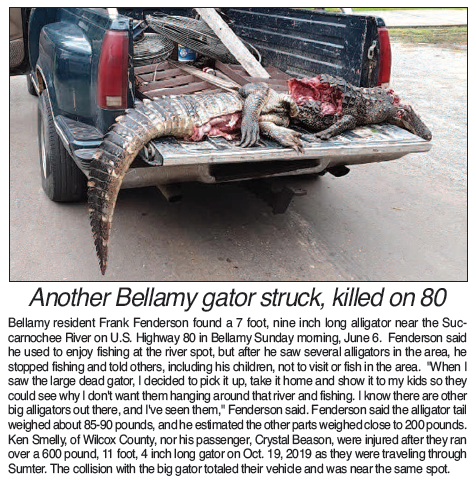
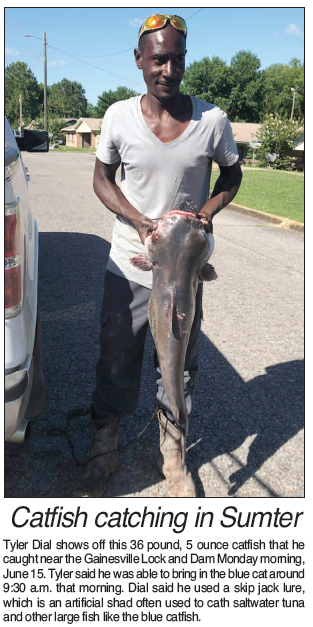
Getting the most from Hay Testing
By David Daniel, Jr., Regional Extension Agent – Animal Science & Forages, Alabama Cooperative Extension System
Having the results of a hay analysis offers the producer several benefits for livestock management. Knowing the nutritional value of hay prior to the feeding period allows producers to have a better understanding of the resources they have at hand when working to meet the needs of their livestock. Meeting the livestock’s nutritional needs is one of the most critical pieces of the puzzle when it comes to providing care and optimizing their performance. Accurate test results prior to the beginning of the feeding period allow producers the opportunity to plan for meeting possible nutritional deficiencies in a cutting of hay. Below are a few sampling concepts to keep in mind to help ensure each sample offers an accurate representation of the hay being fed and provides information that will be useful to your operation.
Collection method and technique are critical to getting the most accurate information you can on your hay. Don’t get me wrong, in theory, test results generated from a grab sample of the hay being fed are better than no information at all. But the best hay sample a producer can collect is the one that most accurately represents their entire “lot” of hay. A lot is defined as hay cut from the same field, at the same time under the same conditions. Randomly collecting individual core samples from 25% of the bales produced within a lot will help ensure the sample submitted is an accurate representation. These core samples from individual bales are then mixed together and used to fill a quart to gallon sized plastic bag to finish the overall sample.
Another consideration to keep in mind when collecting samples with the use of a hay probe is how to get the most information from each bale. Each bale represents forage collected from a portion of the field. If attention isn’t paid to how each bale is sampled, we can reduce the accuracy of the overall sample quickly. The probe should be inserted into the bale on one of the rounded edges for round bales. For square bales, the probe should be inserted through a square end. By using these sample sites, the probe can collect hay from a greater number of locations within the field.
The final consideration before submitting your sample will be selecting what tests should be run. The Auburn Soil, Forage, & Water Testing Lab has a variety of different testing options. In many instances the results provided from the “F2” test should answer enough questions about the hay to aid producers when making management decisions. This test provides Relative Forage Quality (RFQ), crude protein and nitrate values for the lot of hay. These values will help identify if using the hay alone as a feed source will meet the needs of the animals you intend to feed it to or if an additional supplement will need to be provided. This test will also alert the producer to any potential nitrate poisoning issues that can be a problem for cattle, sheep and goats if the hay sampled has high nitrate levels. Test selection is made on the “Hay and Forage Testing Application Form” that will need to be sent to the lab along with your hay sample and payment. This form can be found and printed at the following link: https://ssl.acesag.auburn.edu/anr/soillab/forms/documents/ANR-2236.pdf , and contains additional details about how and where your samples should be shipped. If you would like an application printed or have questions about the testing process, please contact me at 334-407-9374 or your Alabama Cooperative Extension System County office. The Alabama Cooperative Extension System (Alabama A&M University and Auburn University) is an equal opportunity educator and employer. Everyone is welcome!
Pandemic Public Nights Allows for Digital Stargazing on Four Continents
After more than 30 years of sponsoring public telescoping, The University of Alabama Observatory closed to the public because of the coronavirus.
But where there’s a will there’s a way, as the old saying goes.
The UA Department of Physics and Astronomy returned access to its powerful reflecting telescope in the observatory atop Gallalee Hall through what’s been dubbed Pandemic Public Nights, a digital viewing through the telescope.
The first Pandemic Public Nights is available on the department’s Vimeo channel, and the department will share links to future digital viewings, which are captioned, through its social media channels.
“It’s a good opportunity for people to get their space fix,” said Dr. William Keel, professor of astronomy and physics.
The telescope is controlled by a computer, and can be operated remotely, so Keel said faculty in the department thought recording or livestreaming what is seen through the telescope would be a good way to avoid crowding the observatory.
“In the past few months, cramming people together into the observatory dome, which is 30 feet in diameter, seemed like a really bad idea due to COVID-19,” Keel said.
The department has a webcam have a webcam and a moon map, so different faculty members can discuss what people see on the video.
“We’ll do things like look at the moon and view where moon bases were, where Apollo 11 landed, where a lava flow overwhelmed a side of a crater, where a media shower damaged it and more,” Keel said. “The other good thing is by doing it digitally we don’t have to worry about Tuscaloosa’s wild weather, which has canceled a lot of our viewings.”
Another benefit of digital stargazing is it won’t just be UA’s campus telescope used for Pandemic Public Nights. Since UA is part of a group of universities that remotely operates telescopes on three continents, which, along with Tuscaloosa in North America, includes Arizona, Chile in South America and the Canary Islands off the African coast, Keel said for public access to all of the telescopes.
Two big upcoming astronomical events to look forward to this year include the solar eclipse on June 21 that can be seen over central Africa, Asia, the Pacific and southeastern Europe, and the once-in-a-generation “Great Conjunction” on Dec. 21 in which Jupiter and Saturn align in the sky.
Though Keel said the solar eclipse won’t be something UA’s telescopes will be able to capture – the visibility of it is just out of range – the Great Conjunction will be.
“Right before Christmas, Jupiter and Saturn will be lined up from our view point so close that it will look like they’re side-by-side,” Keel said. “This is very rare. Jupiter has lapped Saturn before only once in my lifetime.”
The University of Alabama, the state’s oldest and largest public institution of higher education, is a student-centered research university that draws the best and brightest to an academic community committed to providing a premier undergraduate and graduate education. UA is dedicated to achieving excellence in scholarship, collaboration and intellectual engagement; providing public outreach and service to the state of Alabama and the nation; and nurturing a campus environment that fosters collegiality, respect and inclusivity.
Additional news about The University of Alabama can be found at: https://www.ua.edu/news/news-media/
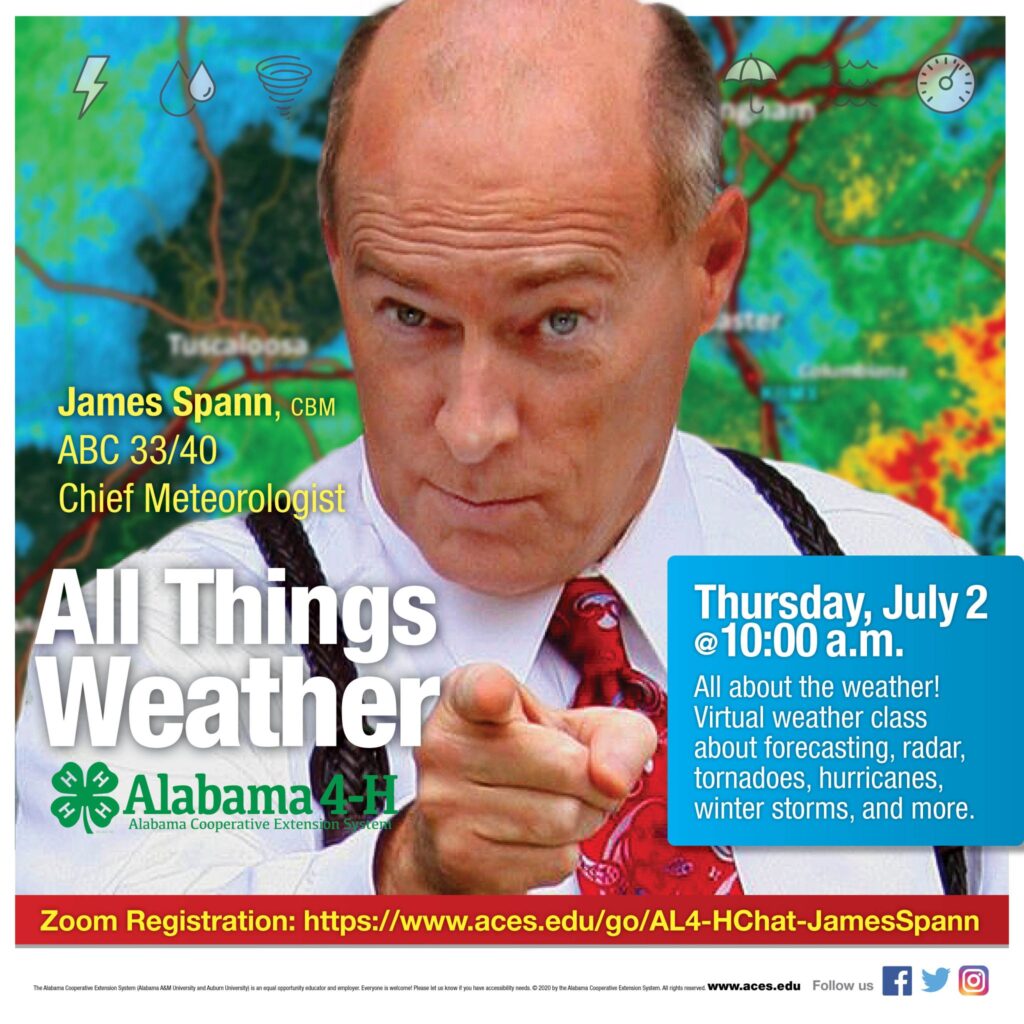
“I will get into forecasting, radar, tornadoes, hurricanes, winter storms and more,” Spann said. “It will be lots of fun.”
Spann is the chief meteorologist for ABC 33/40 in Birmingham and has been forecasting the weather for more than 40 years. He is a certified broadcast meteorologist and has earned titles such as “Broadcaster of the Year” by the National Weather Association in 2012. He has received numerous awards including an Emmy for best television weather anchor in the Southeast United States in 2014.
Class Registration
In the midst of the coronavirus, Alabama 4-H is offering virtual activities to keep young people engaged while at home. Molly Gregg, assistant director of Alabama 4-H, says the team has put in a lot of effort to make virtual activities happen.
“As it became clear we were not going to meet face-to-face for longer than we had hoped, we decided we wanted to offer fun virtual 4-H activities to all Alabama youth,” Gregg said.
Gregg also said with hurricane season underway, the information that Spann will cover is good for youth and families to learn.
“I would love to have as many as possible on the Zoom call,” Spann said. “The bigger the better!”
To attend the Zoom meeting, people must register ahead of time. To register, follow the instructions at https://www.aces.edu/go/AL4-HChat-JamesSpann.
About Alabama 4-H
Alabama 4-H is the youth development organization of the Alabama Cooperative Extension System. For more than 100 years, Alabama 4-H has been helping young people develop into resourceful citizens and responsible leaders. Today, Alabama 4-H engages with more than 161,000 youth. It seeks to empower them with the skills to lead their communities and also grow into future leaders. Visit www.alabama4h.com for more information.
COVID-19 Ag Survey
By Brittney Kimber
COVID-19 impacted the agricultural industry. However, the full extent of the impact is currently unknown. Professionals with the Alabama Cooperative Extension System and Auburn University’s College of Agriculture are working to better understand these impacts. A study is currently underway to assess the effects that COVID-19 is having on Alabama’s agricultural economy using an agriculture impact survey.
“We have all been affected by the COVID-19 pandemic,” said Max Runge, an Alabama Extension economist. “However, for those involved in production agriculture, the production did not stop. Even with supply chain disruptions, animals had to be cared for and plantings had to move forward despite market prices falling below cost of production.”
Through this agricultural impact survey, professionals are gathering information from all agriculture-related segments, spanning from row crops to livestock.
Complete the Assessment of COVID-19 Impacts on Alabama Agriculture survey.
The survey is voluntary and anonymous. Because of the broad-reaching impacts on all phases of agriculture, the survey may be longer than typical surveys. However, Runge says the gathering of as much accurate information as possible is crucial to making the best estimate.
Those wishing to participate should use the following guidelines:
- Complete the survey only one time.
- If a farm has multiple operators involved, one complete survey is sufficient as long as it reports all the impacts.
- Submit surveys by June 30.
Professionals will share survey results with industry leaders, commodity groups and legislators in support of any policy and industry response that may be appropriate.
“The impacts of the pandemic will be felt for a long time,” Runge said. “For now, we would like to assess the impact COVID-19 is having on Alabama’s agriculture and related industries with this survey.”
For more information on this survey contact Max Runge at [email protected]. People can also visit the Alabama Extension website, www.aces.edu, for information on the affects of COVID-19.
Cogongrass and the Threat of Fires
| AUBURN UNIVERSITY, Ala. – Cogongrass is one of the most significant non-native invasive plants in Alabama. Not only does it invade a wide variety of habitats, but it also disrupts ecosystem function, particularly through fire regimes and fire intensity. Thrives On Fire “Cogongrass is a fire-adapted species that thrives on fire,” Nancy Loewenstein, an Alabama Extension forestry, wildlife and natural resources specialist said. It burns easily and at extremely high temperatures in part because of its leaf characteristics but also because plants often have highly flammable thatch (dead leaf material) at the base of the plants. Plants re-sprout quickly after fires because fires rarely harm their extensive rhizome system. Late winter fires can also promote flowering. Ultimately, fire will make the cogongrass grow thicker, and produce more flowers and seeds which contribute to spread. How to Identify “One way to stop it from spreading is by increasing education so people can identify and avoid it,” Loewenstein said. Identify cogongrass by its 2 to 3 feet tall leaves. These leaves are greenish-yellow and have a serrated margin. They will range from erect to floppy and turn a distinctive reddish-tan color in the winter. “You’ll often see descriptions indicating that it has an offset white midrib, which is the case some of the time but not always,” she said. Also, several look-a-like grasses have offset white midribs which can cause some confusion. The rhizomes, or underground stems, are strongly segmented, creamy white and covered with paper-like scales. The spring flowers serve as a very helpful feature for the identification of cogongrass. “The flowers are 2 to 8 inches long, starting out tan to purple in color, becoming silvery white,” Loewenstein said. “The seeds are light and fluffy like dandelion seeds.” North Alabama may see the flowers bloom in May or early June, while south Alabama may see the blooms in early spring. The cogongrass field guide can provide additional information on identifying the plant. Controlling Cogongrass Preventing spread is the best first step for control. Cogongrass can easily hitchhike and spread on all kinds of equipment. Avoid infestations when possible and clean equipment after working in areas infested with cogongrass. Fire alone cannot be used to contain this invasive plant. However, controlled fires can be used to remove the thatch which is then replaced by lush growth that can be effectively sprayed with a herbicide. According to Loewenstein, two effective herbicides, glyphosate and imazapyr, can provide control but it can take years of repeated treatment for the cogongrass to subside. Learn more about controlling the spread of cogongrass here. More Information Find more information about cogongrass and the threat of fires at the Alabama Extension website, www.aces.edu. |
Get a Grip on Summer Garden Pests
By Katie Nichols AUBURN UNIVERSITY, Ala.—An influx of garden pests is every gardener’s worst nightmare. Some pests can take a lush green garden and quickly undo the gardener’s hard work by damaging leaves and produce. Alabama Cooperative Extension System entomologist, Katelyn Kesheimer said home gardeners should have a proactive pest management plan in place before the seeds go in the ground. While it is a little late in the growing season to develop a proactive plan, there are still other things people can do to control garden pests. Pest Control Kesheimer recommends creating an environment where beneficial insects can thrive. Having a yard that is welcoming to these insects can provide free biological pest control throughout the year. Gardeners can do this by growing plants that provide supplementary food sources—like nectar or pollen— for predators that will feed on garden pests once they arrive. Kesheimer also recognizes the importance of chemical control options for pests that cause damage in a garden. “When using chemicals, only use the label rate and avoid broad spectrum insecticides that will kill the beneficial insects,” Kesheimer said. “Remove diseased or severely infested plants from your garden so they don’t act as a source of more pests. Scout your plants regularly so you know what insects—good and bad—are present to determine if action is necessary.” Common Pests in Alabama Gardens The following are some of the common insect pests people may find in their gardens. Stink Bugs “Peas, tomatoes, beans, sweet corn and peppers are some favorite food sources for stink bugs in the home garden,” she said. “Stink bugs rarely feed on squash and melons, but other pests, like the squash vine borer, will certainly fill that role.” Stink bugs overwinter as adults and will move into plants in the spring in order to feed and mate. There can be several generations of stink bugs each year, so their populations only increase throughout the summer, with the highest numbers occurring in the late summer months. “Netting may be used for crops like tomatoes and peppers that are very susceptible,” Kesheimer said. “Get these in place early before the plant starts fruiting and make sure it is sealed all around so the bugs cannot get in.” For small gardens and low pest numbers, hand removal of stink bugs is an effective approach. However, hand removal should happen early in the day and on a regular basis. “Insecticides are the best control method for stink bugs,” she said. “Since there are many generations of stink bugs that move in over the course of the summer, you’ll likely have to treat multiple times. The most useful chemical controls are products with bifenthrin or permethrin.” Kesheimer encourages gardeners to read the label carefully before spraying. She said gardeners should also pay attention to pre-harvest intervals, as many products have usage restrictions. The pre-harvest interval will differ between crops. Corn Earworms “While corn is obviously the preferred crop, tomatoes are also a favorite,” Kesheimer said. “Corn earworms feed on other crops including peas, peppers, spinach, squash, watermelon and okra.” Corn earworms will burrow into developing ears of corn through the tips. Selecting a sweet corn variety with good tip coverage by husks will help keep them out. “Products containing Bacillus thuringiensis (Bt) are effective on small caterpillars,” Kesheimer said. “It is important to scout for this pest because once the caterpillars get bigger, they are feeding more and hard to kill with chemical control.” Keep in mind that late season crops are at higher risk because there are more corn earworm moths in the area. Planting early or on time will reduce the populations in the garden. Squash Vine Borer Kesheimer said she personally battles squash vine borers on cucurbits in her garden, as they are a difficult pest to keep at bay. Squash vine borers are clear-wing moths that lay tiny eggs on plant stems. Once the eggs hatch, tiny larvae burrow into the stem to begin feeding. “The best way to control is to use fine insect netting to keep out the adults,” Kesheimer said. “Squash planted in the late summer or fall usually suffers less damage.” Protect Tomatoes It is no secret that tomatoes are likely one of the Southern gardener’s most treasured bounty. Kesheimer said corn earworm and brown marmorated stink bugs are the pests most likely to cause damage to the tomato plants. “The brown marmorated stink bug is relatively new to Alabama, but it feeds on multiple fruits and vegetables,” she said. “Most of the damage will be cosmetic, so the tomato is still consumable.” Gardeners also know corn earworms as tomato fruitworms. These pests will destroy the fruit by burrowing into the tomato. The small larvae complete their development inside the tomato while feeding. “Check tomato plants regularly for corn earworm eggs once flowering begins,” Kesheimer said. “Bt can be sprayed to kill the small caterpillars.” More Information More information on garden pests and control can be found by visiting Alabama Extension online. Gardeners can also contact county agents or call the Master Gardener Helpline at 1-877-ALA-GROW (252-4769). |
Harvest Fresh from the Garden
By Mary Leigh Oliver
AUBURN UNIVERSITY, Ala.—Alabama gardeners can harvest fresh vegetables almost every month of the year. But knowing when to harvest is the key to enjoying peak freshness from the garden. Dani Carroll, an Alabama Cooperative Extension System regional home grounds agent, said gardeners need to monitor their crops daily.
“Harvest vegetables when they are fully ripe for peak freshness,” Carroll said. “Once they are fully ripe, many are perishable or need to be eaten quickly or preserved for later use.”
Tomatoes, peppers, squash and beans are reaching peak season for harvesting in south Alabama. These vegetables, as well as cucumbers, are in season in central Alabama. As soil temperatures continue to rise, harvest of these vegetables will begin in north Alabama. Carroll said gardens in central and north Alabama are usually two to three weeks behind those in south Alabama.
While spring planting time is behind for most vegetables, sweet potatoes and okra can still be planted. Carroll said gardeners may want to consider a second round of planting to extend the vegetable bounty until fall. Find a planting guide here.
Each vegetable shows different signs of when it is at its peak and ready to harvest.
Pick summer squash when it bruises easily with a fingernail, but has not yet become a hard fruit.
“Tomatoes will often continue to ripen after they have been picked, therefore harvest at about 85 percent of their ripened color especially if you have problems with birds or need to harvest before leaving town,” Carroll said.
Okra pods indicate levels of peak freshness when the pods are 2 to 3 inches long. Harvest every two to three days at minimum to ensure the okra does not become woody.
“Early morning after the dew has started to dry is a great time to harvest veggies and herbs,” Carroll said.
After harvesting at peak freshness, store vegetables properly to preserve the same level of freshness.
“For fruit like tomatoes, store and allow to ripen at room temperature with no refrigeration,” Carroll said. “Store summer squash, which is really an immature fruit, in the refrigerator immediately.”
Find more gardening resources at the Alabama Extension website, www.aces.edu.
DeSoto Caverns Celebrates National Caves & Karst Day — June 6
Childersburg, AL – DeSoto Caverns is celebrating National Caves & Karst Day this June 6, through festivities, specials, and fun! The park will be showcasing demonstrations from a craft artisan, live entertainment including juggling and magic, multiple character quests, and more!
Spending time in nature has become a welcomed escape after weeks of sheltering in place. Many studies report that spending time in nature can boost mental and physical well-being, improve concentration, increase energy, reduce stress, and lower blood pressure and heart rates. When paired with exercise, such as hiking to or in a cave, the results are maximized. It’s quality time that a family can spend together, focusing on nature rather than screens.
For more information, please visit www.desotocavernspark.com/
Participate in Alabama Backyard BioBlitz on June 5

All Alabamians are invited to join Weeks Bay National Estuarine Research Reserve in celebrating World Environment Day by participating in the Alabama Backyard BioBlitz on Friday, June 5, 2020. The event encourages the public to explore and document the natural world from the comfort of their own backyards.
“The theme of this year’s event is biodiversity,” said Clara Zubrick, Weeks Bay Education Assistant. “Alabama ranks fifth in the nation in biodiversity and first east of the Mississippi River. To protect and conserve our environment, we must first connect with what’s out there. The best place to begin exploring nature is in your own backyard.”
To participate in the event, download the free iNaturalist app from the Apple or Android app stores and search for the “Alabama Backyard BioBlitz” project. After joining the project on June 5, participants can observe and document the plants, animals, and insects present near their homes. You can also participate through the iNaturalist website at www.inaturalist.org/projects/alabama-backyard-bioblitz.
“We are excited to provide this opportunity to bring together citizen scientists throughout Alabama in an effort to increase awareness of our state’s amazing biodiversity and celebrate its natural beauty,” said Chris Blankenship, Commissioner of the Alabama Department of Conservation and Natural Resources (ADCNR).
Learn more about World Environment Day at www.worldenvironmentday.global.
Weeks Bay National Estuarine Research Reserve was established in 1986 and is managed by ADCNR as part of the National Oceanic and Atmospheric Administration’s National Estuarine Research Reserve System. The Reserve is comprised of 9,317 acres in Baldwin County and contains upland and bottomland hardwood forests, salt and freshwater marshes, submerged aquatic vegetation and unique bog habitats. Learn more at https://www.outdooralabama.com/lands/weeks-bay-reserve.
Follow Weeks Bay on Facebook at www.facebook.com/WeeksBayNERR/.
The Alabama Department of Conservation and Natural Resources promotes wise stewardship, management and enjoyment of Alabama’s natural resources through four divisions: Marine Resources, State Lands, State Parks, and Wildlife and Freshwater Fisheries. To learn more about ADCNR, visit www.outdooralabama.com.
Prevent illnesses caused by tick and mosquito bites
In addition to implementing prevention measures and social distancing strategies during the COVID-19 pandemic, the Alabama Department of Public Health (ADPH) reminds the citizens of Alabama to prevent illnesses caused by the bite of ticks and mosquitoes.
The summer months and social distancing practices mean more time spent outdoors and having fun in the sun for the entire family, but warmer months also bring unwanted visitors – ticks and mosquitoes. While most people think of ticks and mosquitoes as being only a nuisance, they can also transmit diseases, many of which can be extremely dangerous.
“Ticks and mosquitoes can transmit viruses and bacteria when they bite, causing illnesses that range from mild to severe or even fatal. While we continue to practice social distancing and handwashing this summer, we must not forget to take the steps necessary to prevent diseases carried by insects,” says Public Health Entomologist Savannah Duke.
West Nile virus, Eastern equine encephalitis and Zika virus are diseases that mosquitoes can carry while Lyme disease and Rocky Mountain spotted fever are tickborne diseases that pose a threat to Alabama residents. According to State Public Health Veterinarian, Dr. Dee Jones, “The best way to avoid getting a disease from a tick or mosquito is to reduce the risk of being bitten.”
The ADPH and the Centers for Disease Control and Prevention offer the following recommendations for preventing tick and mosquito bites:
· † Use insect repellents with ingredients registered by the Environmental Protection Agency such as DEET, Picaridin and oil of lemon eucalyptus.
· †Always follow instructions when applying insect repellent to children and do not use repellents on babies younger than 2 months or oil of lemon eucalyptus on children under 3 years old.
· † Wear long-sleeved shirts and long pants and use permethrin to treat clothing and gear.
· † Make sure window screens are in good repair to reduce the chance of mosquitoes indoors.
· † Conduct a yard inspection and tip or toss anything that holds water to reduce mosquito breeding habitats. Fill holes and depressions in your yard where water tends to collect and repair leaky pipes and faucets.
· † Walk in the center of trails and conduct a tick check upon returning indoors.
· † Remove ticks immediately and correctly. Visit https://www.cdc.gov/ticks/removing_a_tick.htmlto learn how to safely remove ticks.
See your health provider if you think you have a mosquito or tickborne disease. If you are bitten by a tick, save it for identification and testing. Health providers who suspect mosquito or tickborne diseases in their patients can submit clinical specimens to the ADPH Bureau of Clinical Laboratories. Visit http://www.alabamapublichealth.gov/bcl/index.html. On the home page, click “The Analytes Offered by BCL”, and then search under the “Microbiology” heading for more information.
To find out more about ticks and mosquitoes, visit the following resources:
· † For more information on repellents, visit http://cfpub.epa.gov/oppref/insect
· † For more information on prevalence and prevention of tickborne diseases in Alabama, visit http://www.alabamapublichealth.gov/infectiousdiseases/tickborne-diseases.html
· † For more information on prevalence and prevention of mosquito-borne diseases in Alabama, visit http://www.alabamapublichealth.gov/mosquito/index.html
4-H Announces Virtual Fishing Contest
4-H is inviting youth across Alabama to participate in the 2020 4-H Biggest Catch virtual fishing contest. This freshwater fishing contest is for young people ages 9 to 18 and will be held June 1 – 14.
“We teach fishing basics and aquatic education year-round through our 4-H Sportfishing program,” said Emily Nichols, Alabama Extension 4-H specialist. “Now we are giving youth the chance to put those skills to the test in a little friendly competition.”
Contest Entries and Requirements
To be eligible for the contest, youth must catch and land their own fish without the help of others. To submit an entry, participants must measure their fish, take a photo of it and submit it online along with the online contest entry form. Contest requirements are as followed:
Youth participants must submit official contest entries between 8 a.m. CST June 1 and 8 p.m. CST June 14 using the online submission form at bit.ly/Biggest4HCatch.
To enter, a photograph of the biggest catch must be uploaded. The photograph should include the youth and their fish, the contest code AL4H2020 and also the total length of the fish. Participants can write this on a piece of paper and hold it up in the photograph or write it on their hand.
One entry per youth is allowed. Only complete entries will be considered.
Contest categories are Basses, Bream (Sunfish), Catfishes and Crappies. Participants must submit their catch to the correct category.
Participants must catch the fish in Alabama waters.
First, second and third place recognition will be awarded for each category. Also, participants are to follow all state requirements for fishing license and permits, as well as creel and size limits. Visit OutdoorAlabama.com for more information.
“Right now is a great time for families to get outside together and explore the state’s abundant freshwater,” Nichols said. “From county lakes, rivers and streams to state parks, there are great spots for recreating responsibly.”
About Alabama 4-H
Alabama 4-H is the youth development organization of the Alabama Cooperative Extension System. The program seeks to empower young people with the skills to lead their communities and also grow into future leaders. Visit www.alabama4h.com for more information.
Free Fishing Day is June 13
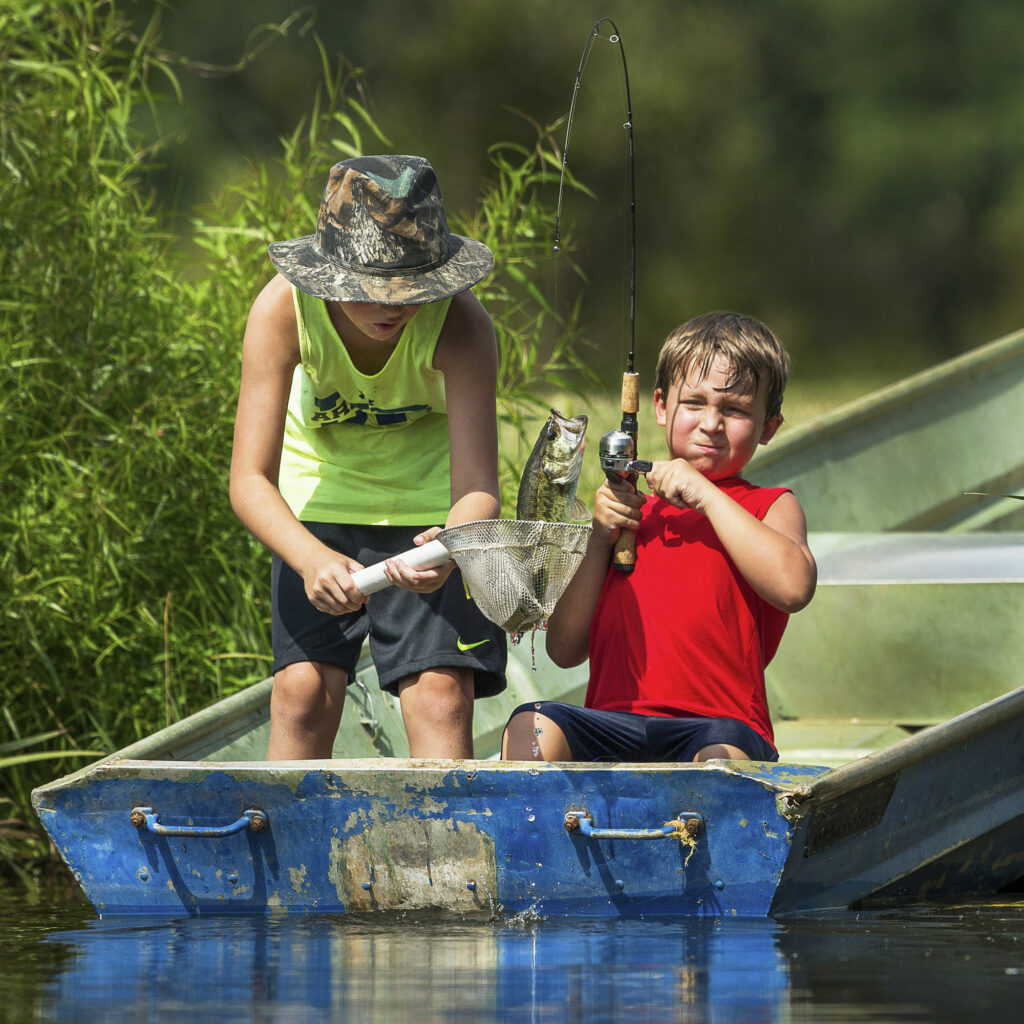
On Saturday, June 13, 2020, Alabamians and out-of-state visitors alike will have the opportunity to fish for free in most public waters including both freshwater and saltwater. Free Fishing Day is part of National Fishing and Boating Week, which runs June 6-14. The event allows residents and non-residents to enjoy the outstanding fishing Alabama has to offer without purchasing a fishing license.
“This is the perfect opportunity for non-anglers to test the fishing waters and to remind former anglers of all the fun they’ve been missing,” said Chris Blankenship, Commissioner of the Alabama Department of Conservation and Natural Resources (ADCNR). “It’s also a day for kids to learn how fun and exciting fishing is, while giving families a chance to do something together outdoors.”
Free Fishing Day takes place during Alabama’s red snapper season. While fishing license requirements are waived for Free Fishing Day, those fishing for red snapper will still need a $10 Gulf Reef Fish Endorsement and a free saltwater angler registration. For more information, visit www.outdooralabama.com/fishing/saltwater-recreational-size-creel-limits.
State Public Fishing Lakes still require a fishing permit on Free Fishing Day, and fishing in a private pond requires the pond owner’s permission. Some piers may also require fees and permits. Anglers looking for a new public fishing spot are encouraged to explore the fishing section of www.outdooralabama.com.
ADCNR strongly encourages everyone to observe Alabama’s current State Health Order and to practice CDC recommendations regarding hand washing and social distancing during the COVID-19 pandemic.
The Alabama Department of Conservation and Natural Resources (ADCNR) promotes wise stewardship, management and enjoyment of Alabama’s natural resources through four divisions: Marine Resources, State Parks, State Lands, and Wildlife and Freshwater Fisheries. To learn more about ADCNR, visit www.outdooralabama.com.
Alligator Hunt Registration Opens June 2
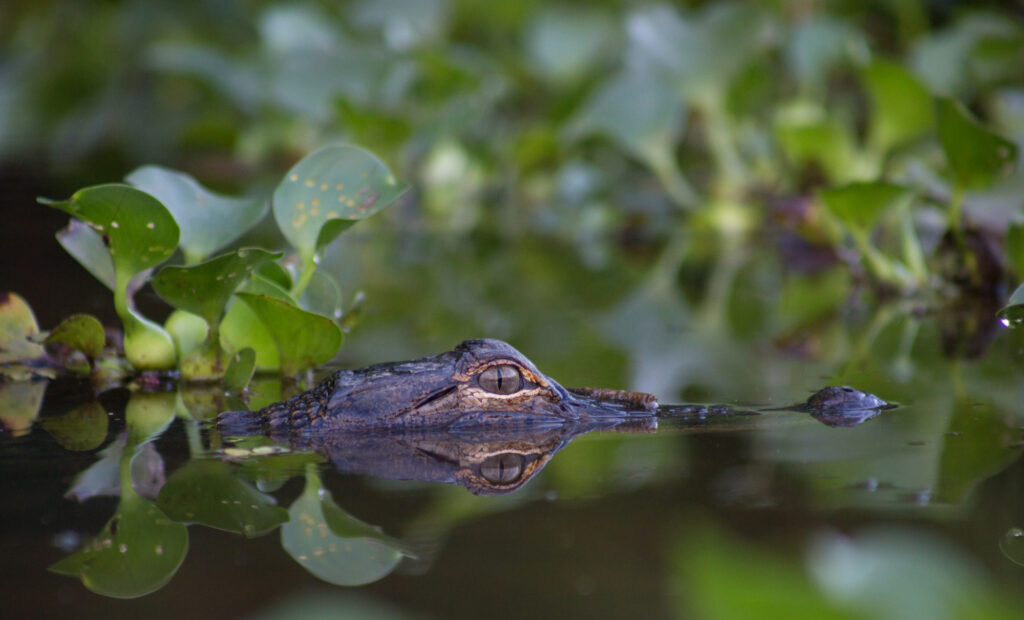
The Alabama Department of Conservation and Natural Resources (ADCNR) will open online registration for the state’s regulated alligator hunts on June 2, at 8 a.m. Registration must be completed by 8 a.m., July 8.
A total of 260 Alligator Possession Tags will be distributed among five hunting zones. The administrative fee to apply for an Alligator Possession Tag is $22 and individuals may register one time per zone. While the tag is free, the selected hunters and their assistants are required to have valid hunting licenses in their possession while hunting.
Only Alabama residents and Alabama lifetime license holders ages 16 years or older may apply for tags. Alabama lifetime license holders may apply for an Alligator Possession Tag even if they have moved out of the state.
To register for the 2020 alligator hunts, visit www.outdooralabama.com/alligators/alligator-hunting-season-alabama during the registration period listed above.
Hunters will be randomly selected by computer to receive one Alligator Possession Tag each (the tags are non-transferable). The random selection process will utilize a preference point system. The system increases the likelihood of repeat registrants being selected for a hunt as long as the applicant continues to apply. The more years an applicant participates in the registration, the higher the likelihood of being selected. If an applicant does not register for the hunt in a given year or is selected and accepts a tag for a hunt, the preference point status is forfeited.
Applicants can check their selection status on July 8, after 12 p.m., at https://publichunts.dcnr.alabama.gov/public. Those selected to receive a tag must confirm their acceptance online by 8 a.m., July 15. After that date, alternates will be notified to fill any vacancies. Applicants drawn for the hunt are required to complete an online Alligator Training Course prior to accepting their hunter/alternate status. The official course will be available on the applicant’s status page upon login.
If selected for an Alligator Possession Tag at two or more locations, hunters must choose which location they would like to hunt. The slot for locations not chosen will be filled from a list of randomly selected alternates.
Hunting zones, total tags issued per zone and hunt dates are as follows:
SOUTHWEST ALABAMA ZONE – 100 Tags
Locations: Private and public waters in Baldwin and Mobile counties north of interstate 10, and private and public waters in Washington, Clarke and Monroe counties east of U.S. Highway 43 and south of U.S. Highway 84. 2020 Dates: Sunset on August 13, until sunrise on August 16. Sunset on August 20, until sunrise on August 23.
COASTAL ZONE – 50 Tags
Locations: Private and public waters in Baldwin and Mobile counties south of Interstate 10. 2020 Dates: Sunset on August 13, until sunrise on August 16. Sunset on August 20, until sunrise on August 23.
SOUTHEAST ALABAMA ZONE – 40 Tags
Locations: Private and public waters in Barbour, Coffee, Covington, Dale, Geneva, Henry, Houston and Russell counties (excluding public Alabama state waters in Walter F. George Reservoir/Lake Eufaula and its navigable tributaries). 2020 Dates: Sunset on August 8, until sunrise on September 7.
WEST CENTRAL ALABAMA ZONE – 50 Tags
Locations: Private and public waters in Monroe (north of U.S. Highway 84), Wilcox and Dallas counties. 2020 Dates: Sunset on August 13, until sunrise on August 16. Sunset on August 20, until sunrise on August 23.
LAKE EUFAULA ZONE – 20 Tags
Locations: Public state waters only in the Walter F. George Reservoir/Lake Eufaula and its navigable tributaries, south of Alabama Highway 208 at Omaha Bridge (excludes Eufaula National Wildlife Refuge). 2020 Dates: Sunset August 14, until sunrise October 5.
Each person receiving an Alligator Possession Tag will be allowed to harvest one alligator during the season. An 8-foot minimum length requirement is in effect for alligators harvested in the Lake Eufaula Zone. There is no minimum length for hunts in the other zones. The use of bait is prohibited. All alligator harvests must be immediately tagged with the temporary Alligator Possession Tag and reported as directed for each Zone. The permanent Alligator Possession Tag will be distributed after the hunt by Wildlife and Freshwater Fisheries Division personnel.
Hunting hours are official sunset to official sunrise in the Southwest, Coastal, Southeast and West Central Zones. For the Lake Eufaula Zone, hunting is allowed both daytime and nighttime hours. All Alabama hunting and boating regulations must be followed.
The American alligator (Alligator mississippiensis) is the largest reptile in North America and can exceed 14 feet in length and 1,000 pounds. Known for its prized meat and leather, the species was threatened with extinction due to unregulated harvest during the 1920s, 30s and 40s. No regulations existed in those days to limit the number of alligators harvested. In 1938, it is believed that Alabama was the first state to protect alligators by outlawing these unlimited harvests. Other states soon followed and, in 1967, the U.S. Fish and Wildlife Service placed the American alligator on the endangered species list. By 1987, the species was removed from the endangered species list and the alligator population has continued to expand. Its history illustrates an excellent conservation success story.
The Alabama Department of Conservation and Natural Resources promotes wise stewardship, management and enjoyment of Alabama’s natural resources through four divisions: Marine Resources, State Lands, State Parks, and Wildlife and Freshwater Fisheries. To learn more about ADCNR, visit www.outdooralabama.com.
Alabama farmers now eligible for coronavirus food assistance program
By Katie Nichols
Alabama farmers and ranchers affected by coronavirus will have an opportunity to apply for monetary relief through the Farm Service Agency (FSA). The Coronavirus Food Assistance Program (CFAP) will provide up to $16 billion in direct payments to American agricultural producers who have suffered losses during the COVID-19 pandemic.
The Alabama Cooperative Extension System’s Farm and Agribusiness Management teamwill be working closely with FSA offices and USDA Service Centers to guide producers through the application process.Jessica Kelton, the Farm and Agribusiness Management team leader, said the monetary assistance is unique and much needed.
The CFAP program specifically targets producers of agricultural products who have suffered a five percent or greater price decline, as well as losses, because of market supply chain disruptions.
Eligible commodities are divided into five groups. Non-specialty crops; Wool; Livestock; Dairy; Specialty crops. A complete list of specialty crops is available in the Alabama Extension content piece, Applying for the Coronavirus Food Assistance Program through Farm Services Agency.
Alabama Extension economist, Max Runge, said unprecedented was a word used to describe many aspects of the coronavirus pandemic, but the payments to farmers as a result of this virus really are unprecedented.s
USDA began accepting applications Tues., May 26. Producers may submit applications through Aug. 28. Runge said FSA offices will have an increased volume of applications and phone calls, so patience on the part of the producer will be appreciated. USDA Service Centers will schedule appointments by phone only. USDA will accept applications by email, scan or fax. Extension professionals recommend contacting the local FSA office before sending applications.
Farmers can prepare for appointments by gathering records of recent farm sales and agricultural product inventories. Required application information includes: name and address, personal information, including Tax ID number, farm operating structure, adjusted gross income, direct deposit information. Necessary forms are available by visiting farmers.gov/cfap.
Ken Kelley, also an Alabama Extension economist, said the financial assistance for producers comes at a time when many livestock and dairy producers find themselves receiving prices well below the 10 year average, even as consumers see higher prices in the grocery stores.
While the situation is certainly improving, Kelley said it will be a while before processors catch back up to supply.
In order to ensure the availability of funding throughout the application period, producers will receive 80 percent of the maximum total payment for their operation upon approval of the application. Producers will receive remaining payments as funds are available. Find more information from Alabama Extension’s Farm and Agribusiness Management team in the content piece, Applying for the Coronavirus Food Assistance Program through Farm Services Agency.
Read more about the Coronavirus Food Assistance Program at www.farmers.gov/cfap. Additional and more detailed information from the USDA is available via their website, www.usda.gov.
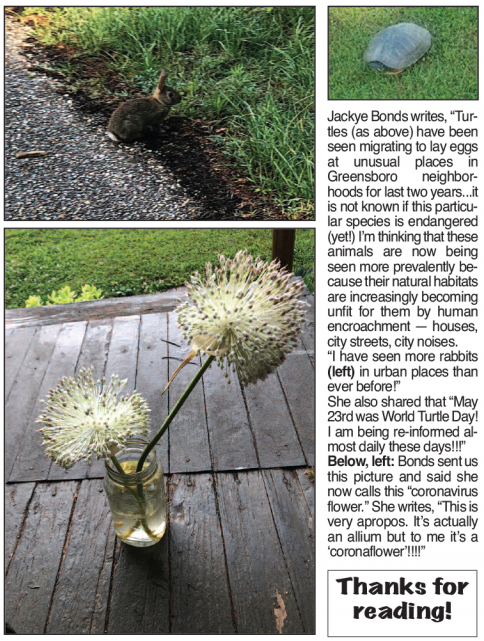
Conserving Water: Small Changes, Big Impact
By Justin Miller
Water plays an essential role in the environment. People use it in many aspects of their daily lives such as cooking, washing clothes, bathing and most importantly, drinking. While the Earth is covered by approximately 70 percent water, only one percent of that is easily accessible for human use.
“For the majority of the people in this country, some of the safest water in the world is just a turn of the tap away,” said Roosevelt Robinson, an Alabama Extension forestry and natural resources regional agent. “Other parts of the world are not so lucky.”
National Drinking Water Month
May is National Drinking Water Month. Highlighting drinking water during the month of May serves as a reminder to protect water resources while also educating the public on the balance of supply and demand.
“It takes much more than just turning on the tap to guarantee clean, drinkable water,” Robinson said. “Reckless usage, coupled with global warming and pollution from impaired water tables, will surely have adverse consequences on future generations.”
Water Usage by the Numbers
In Alabama alone, approximately 365 million gallons of water are used for domestic use every day. In fact, the average Alabama resident uses approximately 76 gallons per day in and around the home.
“The largest use of water in a home today comes from flushing the toilet,” he said. “Each flush can use between 2 to 4 gallons.”
Other aspects of daily life, such as bathing and doing laundry, also use large amounts. Taking a shower uses between 2 and 5 gallons of water per minute, while baths use around 8.5 gallons.
Water usage can depend greatly on the age of an appliance. For example, washing a load of laundry uses approximately 25 gallons per load in newer washers. However, older models can use as much as 40 gallons per load.
Conserving Water
Robinson said there are many simple things that can be done every day to help conserve this precious resource.
“If every Alabamian shaved one minute off of their shower, it would save 2.6 billion gallons of water each year,” Robinson said. “That is enough water to fill more than 3,900 Olympic-sized pools.”
By making a few changes to everyday routines, communities can greatly reduce the burden on their local water supply while also saving money. Robinson offers the following tips for conserving water in the home:
Always turn off the faucet while brushing teeth.
Find and fix household leaks, such as dripping faucets or worn toilet flappers.
Only run the dishwasher and washing machine with full loads.
Consider replacing old toilets with low flow or dual flush toilets.
Robinson said inside the home is not the only place people need to watch water usage. There are several ways to conserve water in yards and gardens.
“Nearly 50 percent of residential outdoor water use is wasted because of inefficient methods of watering,” he said. “By selecting drought tolerant plants for landscapes and only watering during proper times of the day, people can help conserve large amounts of water.”
More Information
Read more about water usage and conservation in WATER You Doing? Water Usage and Conservation. For more information, visit www.aces.edu or contact your county Extension office.
Wildlife Plot Management After the Hunt
By Katie Nichols
Deer season 2020 is in the books and turkey season just came to a gobbling close. An Alabama Cooperative Extension System forestry, wildlife and natural resource management regional agent said many hunters ignore their hunting properties through the summer months, but attention to the wildlife plot is still important.
Bence Carter said summer is an ideal time for hunters to enhance their property to benefit wildlife throughout the year. He recommends making plans for property maintenance during the winter months. However, it is not too late to develop a plan and begin work now.
Provide Nutrient Supplements
“Encouraging growth of native browse and planting warm-season food plots are a great way to provide needed nutrition to wildlife without the costs and risks associated with feeders,” Carter said. “The average adult whitetail can consume four to six pounds or more of dry weight per 100 pounds of body weight per day. This translates to more than one ton of food per year.”
With an average of one ton of food per year, continuous supplemental feeding may prove to be an expensive investment. Carter said hunters should keep in mind that feeders have the potential to increase exposure to predators and diseases.
Whitetail deer need a minimum average of 17 percent crude protein in their diet per year. Depending on age and physiological activity, the deer may need higher amounts of protein.
“While corn is a common choice for hunters, it only has six to 10 percent crude protein and is high in fat and carbohydrates,” Carter said. “Encouraging establishment of native browse, like grasses, forbs and legumes, or planting warm-season food plots can be an effective option to provide supplemental food sources during a crucial developmental time. A diverse selection of available browse throughout your property will maximize benefit to whitetail.”
Warm Season Food Plot Location
When selecting warm season food plot locations, identify areas that are not used for winter food plots. Also look for low bottomland locations which are likely to remain cool and moist throughout the summer.
Before planting, conduct a soil test to determine if any soil amendments, such as lime and fertilizer, are needed. Hunters should also check planting guides for the best crops for the site, planting depth and companion crops.
The Alabama Extension publication Plantings For Wildlife is a good resource for additional information.
General Management
The summer is a great time to enhance a property and complete general management tasks including:
controlling invasive plant species
maintaining or building new roads
maintaining or establishing drains, water bars and culverts
Identifying and managing invasive plant species is also a great way to encourage plant diversity, promote beneficial native vegetation and increase the value of timber. Identifying invasive plant species is important in determining the ideal management plan.
Carter said roads throughout the property can serve many benefits. These include improving access, adding fire lanes, linear food plots and increasing edge habitat.
“If you are looking to sell or lease the property in the future, roads allow potential customers to quickly and easily travel the property to evaluate timber, view wildlife and inspect habitat types and other improvements on the property,” he said.
Surveys
Carter said another enjoyable opportunity in late summer is conducting camera surveys. These surveys allow hunters to gather useful trend data on sex ratio and buck age structure. Surveys also allow hunters to record reproduction and survival rates on the property.
For more information on camera surveys, check out the Alabama Extension publication Managing White-tailed Deer: Camera Surveys.
Predator Control
If done properly, predator control and trapping during the summer can be an effective way to increase fawn and turkey poult survivability.
“Coyotes and raccoons do not have a closed season during the summer months,” Carter said. “This makes the summer an ideal time to get back into the woods to reduce their numbers.”
Check the Alabama Hunting and Trapping regulations annually to brush up on game regulations. Hunters can also talk with a wildlife biologist or an Alabama Extension forestry, wildlife and natural resources regional agent about effective trapping strategies.
More Information
Carter said it is not imperative that all of these strategies be implemented during the summer months.
“If you are only able to select a few of these management strategies to implement, add others in the future,” he said. “The important part is to begin looking at wildlife management practices on your property as a year-round activity, instead of just during the hunting seasons.”
More information on many wildlife topics is available on the Alabama Extension website www.aces.edu. Individuals can also call their county Extension office or visit the Extension directory to be connected with a forestry and wildlife specialist or find a nearby agent.
Alabama Extension Inspiring Gardeners to Grow More, Give More
By Justin Miller
Home gardeners can now use their passion for gardening to make a difference in their communities through the Alabama Extension Grow More, Give More project.
Designed for both novice and experienced gardeners, this project provides the information required to have a successful vegetable garden. This project goes one step further and encourages citizens to use their garden bounty in ways to meet community needs.
“We are excited to launch this project that not only teaches people the ins and outs of gardening, but also helps provide much needed food assistance to communities across Alabama,” said Bethany O’Rear, an Alabama Extension home grounds regional agent.
Grow More
Grow More, Give More is a collaborative effort between Alabama Extension horticulture agents and Alabama Master Gardener Extension volunteers. The Grow More aspect of this project is now underway.
Alabama Extension horticulture agents are distributing kit plans for growing vegetables at home. These plans cover some of the basic growing information related to commonly grown Alabama vegetables.
“These plans will have information specific to different garden types, such as how to grow tomatoes in a five-gallon bucket,” O’Rear said. “We will suggest supplies needed, where to place it, when to plant it and how to maintain it.”
Kits include plans for large container gardens, raised beds and in-ground row crops.
Informational Resources
Worried about getting started? Don’t fret. Extension agents will help growers every step of the way by providing informational resources through a variety of platforms. Master Gardener Extension volunteers are also dedicating their time to support the project.
“These resources are great tools that help guide home gardeners through the entire process,” she said. “In addition to the publications and informational articles on the Extension website, the Grow More, Give More project will have brief on-line tutorials, social media posts and one-on-one assistance through the Master Gardener Helpline.”
Give More
According to O’Rear, the team is still finalizing plans for the Give More aspect of the project. However, the goal is that people use their extra produce to make a difference in their communities.
“People who grow more than they can use are encouraged to share with neighbors or donate it to local food assistance efforts,” O’Rear said. “As people learn to Grow More, we hope they will Give More too.”
This summer, the project will provide a way for gardeners to record their donations and also tell the story of how they utilized the Give More aspect of the project.
More Information
For more information on this project, visit the Grow More, Give More page on the Alabama Extension website, www.aces.edu.
Asian giant hornets? Murder hornets? Not in Alabama
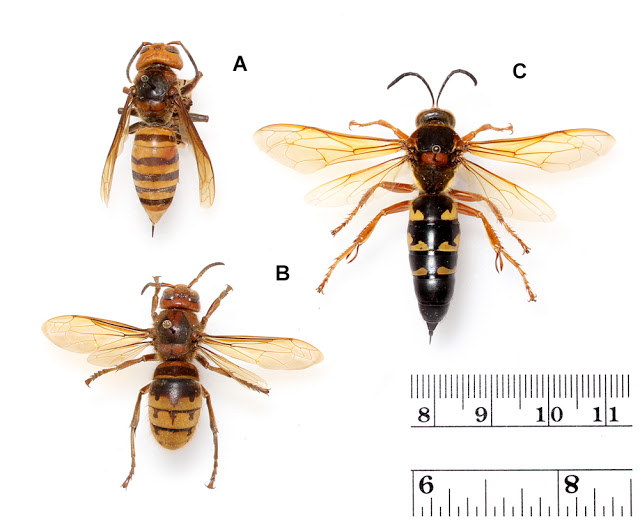
By Katie Nichols
Neighborhoods and social media are buzzing with hype as citizens are concerned about “murder hornets.” Alabama Cooperative Extension System professionals would like to put this rumor to rest. These stinging insects have not been found in Alabama. However, the detection of Asian giant hornets is unnerving for beekeepers and citizens in the Pacific Northwest.
Asian giant hornets, Vespa mandarinia, are the world’s largest hornet, measuring 1.5 – 2 inches in length.
Alabama Extension entomologist Katelyn Kesheimer said the giant hornets have a very unique coloration that makes them distinguishable from other hornets.
“Their large head is orange or yellow with prominent eyes, and they have a black and yellow-striped abdomen,” she said.
The pest was first detected in North America in December 2019 when a Washington resident found a large, dead hornet. The hornet was confirmed to be an Asian giant hornet.
Since the positive identification, four more reports have been confirmed in Washington.
Kesheimer said public education and pest eradication plans are already underway.
The United States Department of Agriculture, the Washington State Department of Agriculture and local universities have begun work to educate citizens, conduct surveys, and eradicate the pest.
“Their goal is to eradicate the pest before it becomes established,” Kesheimer said.
Asian giant hornets are native to Asia. The hornets are social insects and maintain underground colonies with one queen and multiple workers.
“These nests are difficult to locate,” Kesheimer said. “Nests are often formed in pre-existing holes in the ground, like a rodent’s nest.”
The hornets will also nest in hollowed tree trunks or in the roots of dead trees.
Much like the fire ant—which Alabamians are very familiar with—the queens are colony leaders. The queens are able to disperse and produce offspring. Therefore, a solitary queen begins a nest and then populates it with workers. Kesheimer said the key to controlling a colony is to kill the queen.
“As social insects, they can carry out coordinated attacks against nests of other bees and wasps,” Kesheimer said. “These group attacks usually occur late in the season as their nests become large and are in need of food. They will ‘slaughter and occupy’ the nests of yellow jackets and paper wasps, as well as honeybees.”
Asian giant hornets are predatory insects. Their diet includes a variety of arthropods. These include: scarab beetles, long-horned beetles, spiders and caterpillars.
European honeybees are the preferred food source for Asian giant hornets because the honeybee hive cannot defend themselves against the hornet. European honeybee hives also offer a bounty of food and are full of protein and fat.
While Asian giant hornets have not been identified in Alabama or the southeastern U.S., there are other bees and wasps in Alabama that could be easily mistaken for the Asian giant hornet.
European hornets and Cicada killer wasps resemble Asian giant hornets and could easily cause concern for Alabama homeowners or beekeepers.
Alabama Extension entomologist, Xing Ping Hu, said the Cicada killer and the European hornet are also confused with one another, though the two have different lifestyles.
“Cicada killer wasps are large solitary wasps that behave differently from social hornets,” Hu said. “The Cicada killer builds nests in the ground by pushing out soil, typically 10-20 inches deep and less than 1 inch wide.”
Hu said Cicada killer wasps can be found small soil mounds in well-drained, sandy soils or loose clay in bare and grass-covered areas. Female wasps hunt for cicadas, sting them to paralyze the prey, then drag the cicada back to the nest to feed the young.
Male cicada wasps are often seen in groups buzzing aggressively above ground. Although the male wasps may look intimidating, they pose no risk to humans. While females can sting, they will not attempt to sting humans unless handled roughly.
European hornets are found sporadically throughout the state, as Alabama is likely at the southern edge of their range.
While the European hornet may be mistaken for an Asian giant hornet simply because of their size, hornet behavior may be another reason homeowners could confuse the two.
Similar to Asian giant hornets, European hornets will become aggressive if their nest is threatened. However, the European hornet is not known to be a threat to honeybees.
Kesheimer said Asian giant hornets do post a threat to European honeybees in the U.S.
“While they do prey on other arthropod species, we are most concerned about honeybees because of their value as pollinators and honey-producers,” Kesheimer said. “Beekeepers across all states should be informed about this pest and the progress on eradication efforts.”
Kesheimer said Asian giant hornets will attack if their colonies or food sources are threatened.
“It is important to remember that these hornets are not typically aggressive toward humans,” Kesheimer said.
Many people have had experience with honeybee stings—the short, barbed stinger becomes lodged in the skin and only allows for one sting. The stinger on V. mandarinia is much larger and contains more venom than bee stingers. The Asian giant hornet stinger has a curved shape with less barbs to allow for easier entry. This means the hornets can sting more than once.
Kesheimer said the average beekeeping suit will not protect keepers from this pest.
“Anyone with an allergy should take extra precautions around any bees or wasps and seek medical attention when and if needed,” she said. “It is important to remain calm when it comes to any types of bees or wasps. Remember, Asian giant hornets only become aggressive when their nest or food source is threatened.”
For more detailed information on identification, biology, and control options, visit United States Department of Agriculture or the Washington State Department of Agriculture.
Read more about Asian giant hornets, also known as murder hornets, in a content piece found on www.aces.edu, titled Asian Giant Hornets Not in Alabama.
Put Asterisk by 2020 Alabama Turkey Season
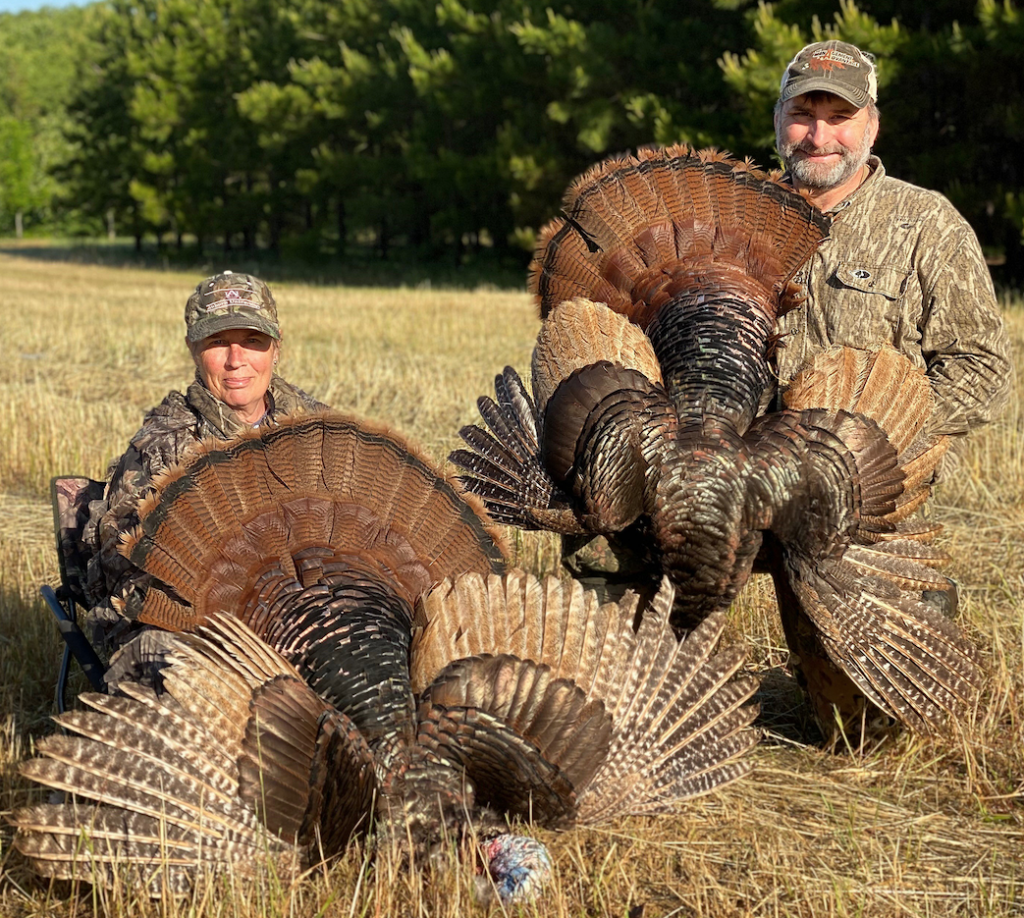
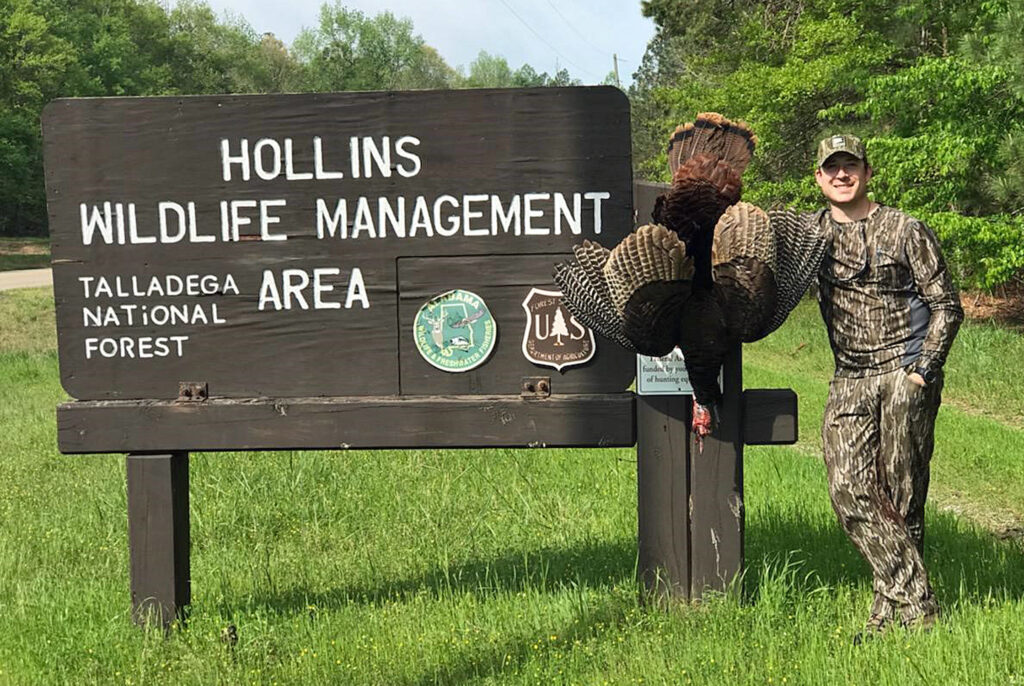
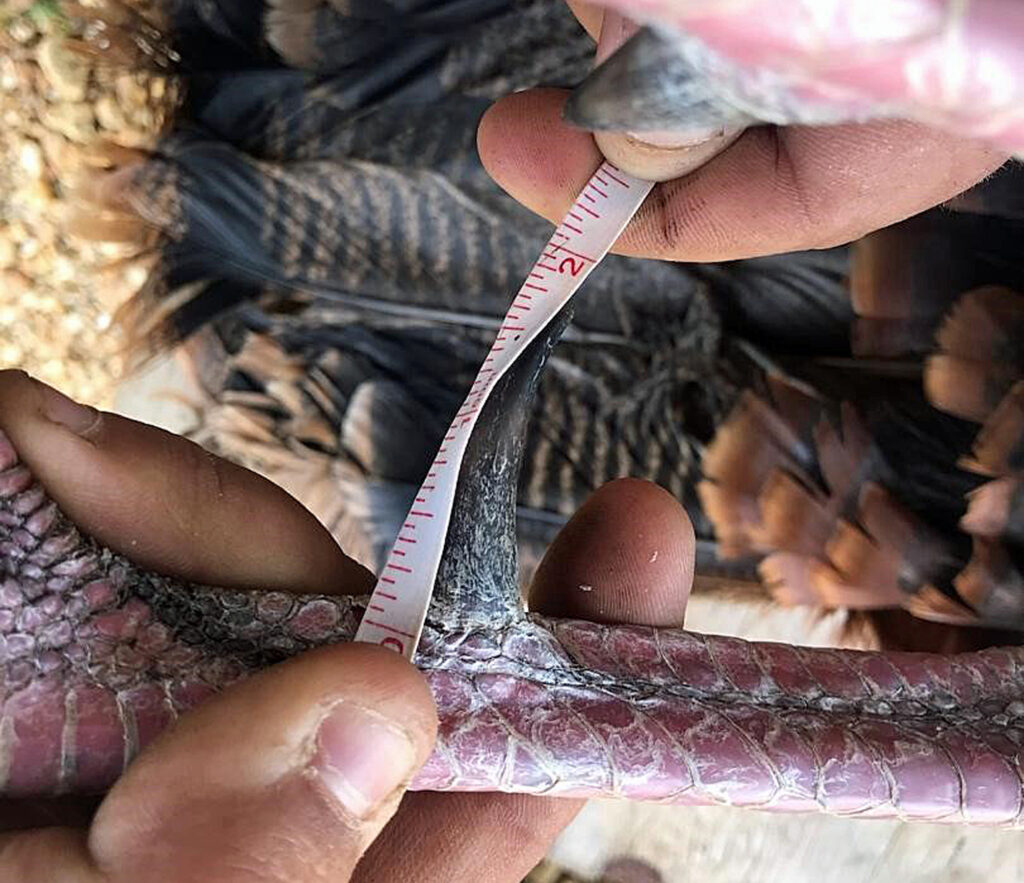
By DAVID RAINER
Alabama Department of Conservation and Natural Resources
The Alabama wild turkey season, which ended on May 3, will likely have to include an asterisk in the record books for a variety of reasons.
Obviously, the COVID-19 restrictions played a role as did a renewed push for successful hunters to report their turkey harvests.
Alabama Wildlife and Freshwater Fisheries (WFF) Director Chuck Sykes made a significant point at the Alabama Conservation Advisory Board meeting earlier this year that if compliance with Game Check’s requirement to report all turkey harvests didn’t increase, the 2021 season might be in jeopardy. Apparently, the message was delivered.
“I think it was a double factor,” Sykes said. “I think more people did report taking birds this year because of what happened at the Advisory Board. However, I am 100-percent confident more birds were killed this year. I can use myself as a prime example. I am extremely fortunate to be able to hunt in some really good places year after year, and I keep a very detailed record of each turkey season. This was a banner year. The travel restrictions associated with the coronavirus was a contributor.
“I had way more turkeys killed with me in Alabama than in years past just simply because I had more days afield in Alabama,” he said. “It wasn’t that I did better this year. I still had roughly the same daily average. I just got more days in so there was more hunter effort in Alabama because I couldn’t go out of town. All of my meetings out of Alabama were canceled, so I was in Alabama longer. I wasn’t just a weekend warrior like I’ve been for the past few years. This year, the weather was bad on several weekends, so I got to hunt more good days during the week. Therefore, more turkeys were harvested for me personally.”
With current regulations that state the season will start on the third Saturday in March, the opening day of the 2020 turkey season happened on March 21, the latest date possible. Add in relatively good weather, except for a couple of weekends, and Sykes said conditions certainly favored the turkey hunters.
“I think starting the season later put the turkeys farther into their breeding activity and made them easier to call,” he said. “And people had way more time on their hands. I know a boatload of people who hunted public land this year for the first time because they had time to do it, and they killed turkeys.”
That increase in hunting on public lands was affirmed by WFF Upland Game Bird Coordinator Steven Mitchell, who said Alabama’s WMAs (wildlife management areas) had more hunter activity than he’s ever seen.
“I think a lot more hunters were in the woods this year,” Mitchell said. “The WMAs were getting used a lot more than in previous years. We don’t know exactly how much more use right now. As a safety precaution associated with social distancing, we pulled the requirements for daily permits for the spring. But we’re still working the WMAs. By observation, there were trucks at every place to park.”
Mitchell said one lucky hunter was able to bag a trophy turkey on the Hollins WMA. The bird had 1¾-inch spurs.
“We’ve had a lot of use and a lot of harvest,” he said. “With more than week to go in the season, we had 4,000 more birds reported through Game Check than all of last season.”
Director Sykes said he normally hunts with one of his friends in Choctaw County about three days a year. This year, the hunting buddies spent 10 days in the woods.
“I was teleworking from the hunting camp,” he said. “We could go hunting for a couple of hours before he had to go to work and I got on the computer.
“I got quite a few emails and texts, that people were seeing (the increased harvest) too. People who might normally kill one or two birds, they killed their (five-bird) limit. Others who hardly ever killed a bird, they killed two or three.”
Mitchell also said more hunters participated this season in the Avid Turkey Hunter Survey, which will provide a variety of information for game managers.
“This is a precious resource and we need accurate information,” he said. “We need to know what kind of gobbling they’re hearing and what time. We can see peaks and valleys in gobbling and harvest activity.”
Despite the great season for hunters, the game bird biologists are concerned about turkey numbers trending down in the past 10 years.
Mitchell said Auburn University is wrapping up its five-year study on the turkey population. Dr. Barry Grand is finishing the report and it should be available soon.
“Auburn was looking at a lot of things on turkeys on our research areas,” Mitchell said. “This report will give us the vital statistics we need to develop a decision-making tool concerning seasons and bag limits.
“Some of the research around the Southeast is showing when gobblers are harvested. Usually in Alabama, it’s the first couple of weeks. A lot of gobblers are getting taken out of the population before they have a chance to breed.”
Steve Barnett, who retired as Upland Game Bird Coordinator last year, said Dr. Grand’s report will augment the work done by WFF biologists and public input through the Avid Turkey Hunter Survey.
“The Auburn study took place on the research sites across the state,” Barnett said. “We were updating the vital rates for Alabama in terms of survival, reproduction and harvest rates. We really haven’t had any data since Dr. (Dan) Speake was doing all his turkey work in the 1980s.
“By updating those vital rates, it allows us to update our strategic decision-making tool. Those are key elements that go into that prediction model.”
According to the WFF’s Full Fans & Sharp Spurs (FF&SS) publication for the 2019 season, the turkey population is not rebounding as biologists had hoped. Visit www.outdooralabama.com/turkey-hunting-alabama/turkey-research for the publications for the past six years.
Barnett still compiles much of the information for the FF&SS publication.
“The brood survey is still showing a decline,” Barnett said. “There’s been about a two percent decline in poults per hen and a three percent decline in brood size.”
Barnett said the 2019 numbers estimated poults per hen at 1.8.
“When it’s less than two poults per hen, that’s concerning to us,” he said. “2013 was the last time it showed two poults per hen. It’s not isolated to Alabama. The reproduction is in decline across the Southeast and continues to be.”
The 2019 information indicated a large number of jakes (1-year-old gobblers) were observed last year, the largest number since the survey started.
“That likely accounts for some of the increase in reported harvest, and some of the good turkey hunts can be attributed to more 2-year-olds in the population,” Barnett said.
Director Sykes said the results of the 2020 turkey season will likely be considered an anomaly.
“In my opinion, it was the factors of hunter effort and being able to hunt during the week when the weather was a lot more conducive,” Sykes said. “Two weekends in row we had tornadoes and violent storms. If you’re working 8 to 5 Monday through Friday and those were the only two days you had to hunt, you probably wouldn’t kill a turkey. But hunters were able to go out on Thursdays and Fridays and were able to kill turkeys.”
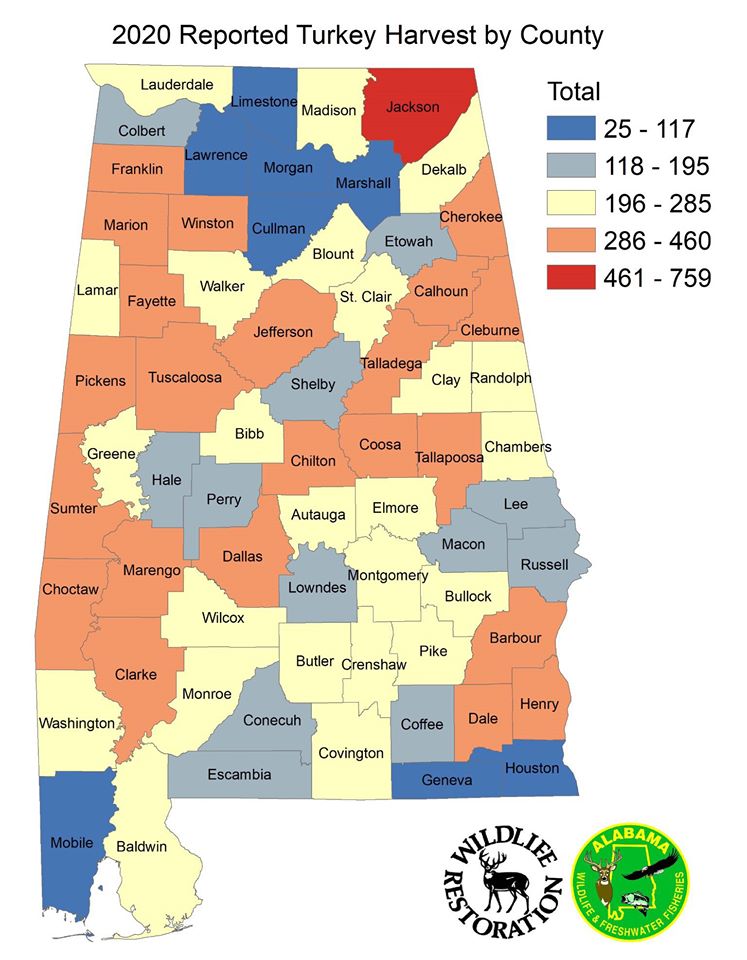
Now is the time to prepare for hurricanes
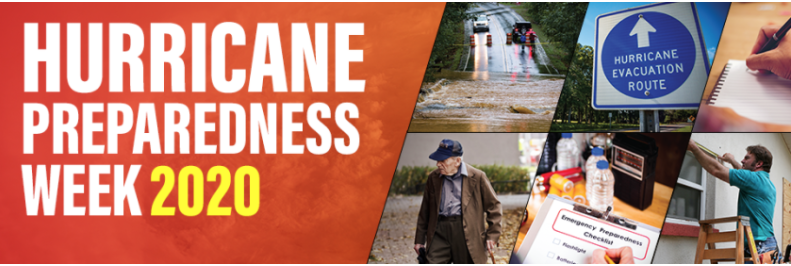
By Jim Stefkovich, Meteorologist, Alabama Emergency Management Agency
May 3-9 is National Hurricane Preparedness Week. Now is the time to prepare for the coming season. Although the official National Hurricane Center seasonal forecast doesn’t come out until later this month, all indications are for an active season. Just keep in mind the forecast doesn’t predict where the storms will form or where they go. As is said over and over, it only takes one to produce massive impacts.
There’s a myth that tropical activity doesn’t start until June 1st. Wrong! Tropical storms and hurricanes don’t care about arbitrary “official” season dates. In 2018, Tropical Storm Alberto formed on May 20th, moved northward through the Gulf of Mexico, and into Alabama on May 29th.
What is known is the Gulf of Mexico is the favored region for tropical storm and hurricane development during May – June and continuing into the fall.1
A lot of people don’t take Tropical Storms and some Hurricanes seriously. “It’s just a Tropical Storm” or “It’s only a Category 1”, are common statements. The category and the actual impacts are significantly different.
Tropical Storms and Category 1-5 Hurricanes are defined by wind speeds only. However, there are many other impacts such as storm surge near the coast with both flooding and tornadoes that can occur well inland affecting anyone in Alabama.
So, hopefully, you will go to the following website and learn more about developing a plan and being prepared for this coming season at https://www.weather.gov/wrn/hurricane-preparedness
Finally, there is a section on this website about developing an Evacuation Plan. With the pandemic situation, will your current evacuation plan work? Now is a great time to review your plan so that it will accommodate health orders or conditions caused by COVID-19.
Watch Your Step Prickly Thorns in Hale County Lawns

Tyrone D. Smith, Hale County Extension Coordinator
Alabama Cooperative Extension System
Control of lawn Douglas Fiddleneck also burweed or buckthorn is easiest by a preemergent herbicide application in September through November. It’s an annual and comes back from seed every fall. Another alternative is to wait for it to germinate and kill it with a post-emergent herbicide in December or January. The most important thing when using post-emergent is to kill it BEFORE it makes the spiky fruits. Most years it starts to flower and fruit anywhere from February to March, depending on location, and often sticks around until May.
If you sprayed an herbicide in your lawn today, you could kill it but the dead plants would still have those spiky fruits. Almost all of the common pre and post herbicides will get lawn burweed. It’s not hard to kill, but it grows low to the ground and can escape notice until you start stepping on the fruits. This plant has shallow roots and can be hand pulled. Wear gloves so the spiny hairs don’t prick the skin. So a sharp eye in winter is the most important tool to use!
Hale County Extension Office is still working for you! Please call 334-624-8710 or visit us online www.aces.edu
Virus Robbed Me of Bidding Farewell to Great Friend
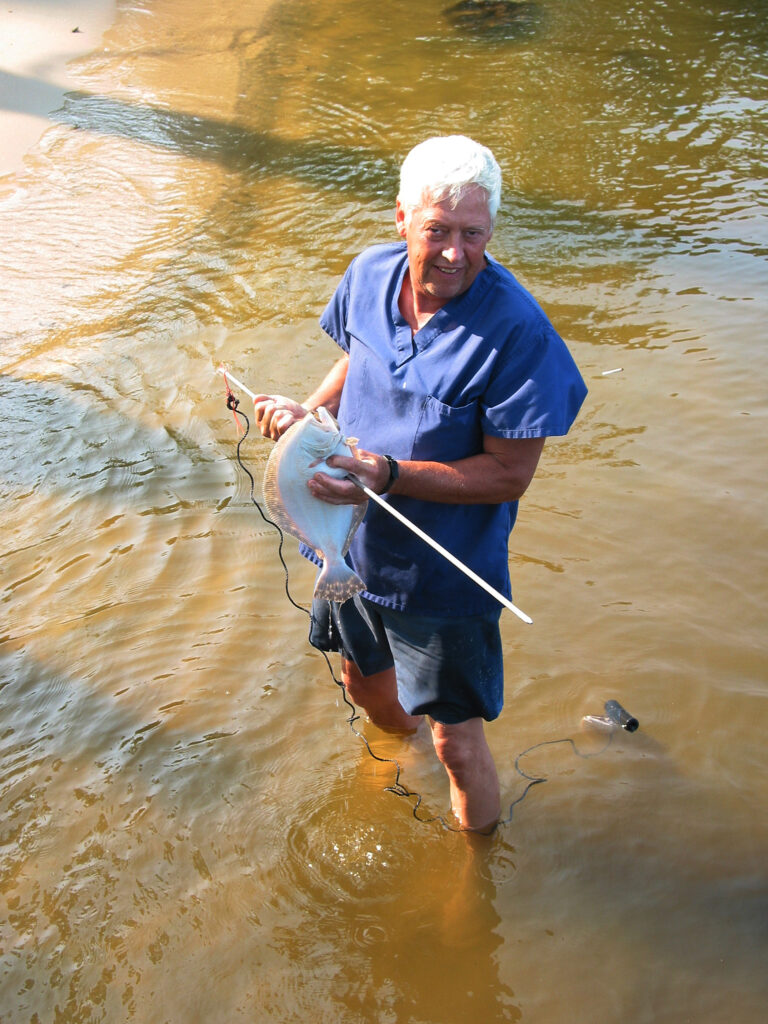
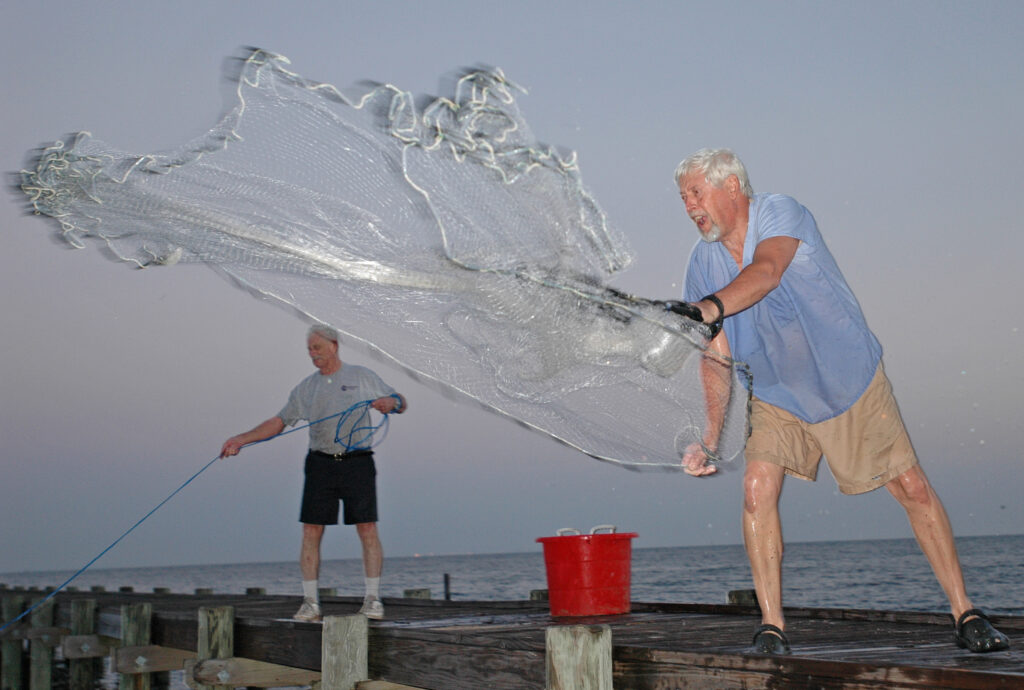
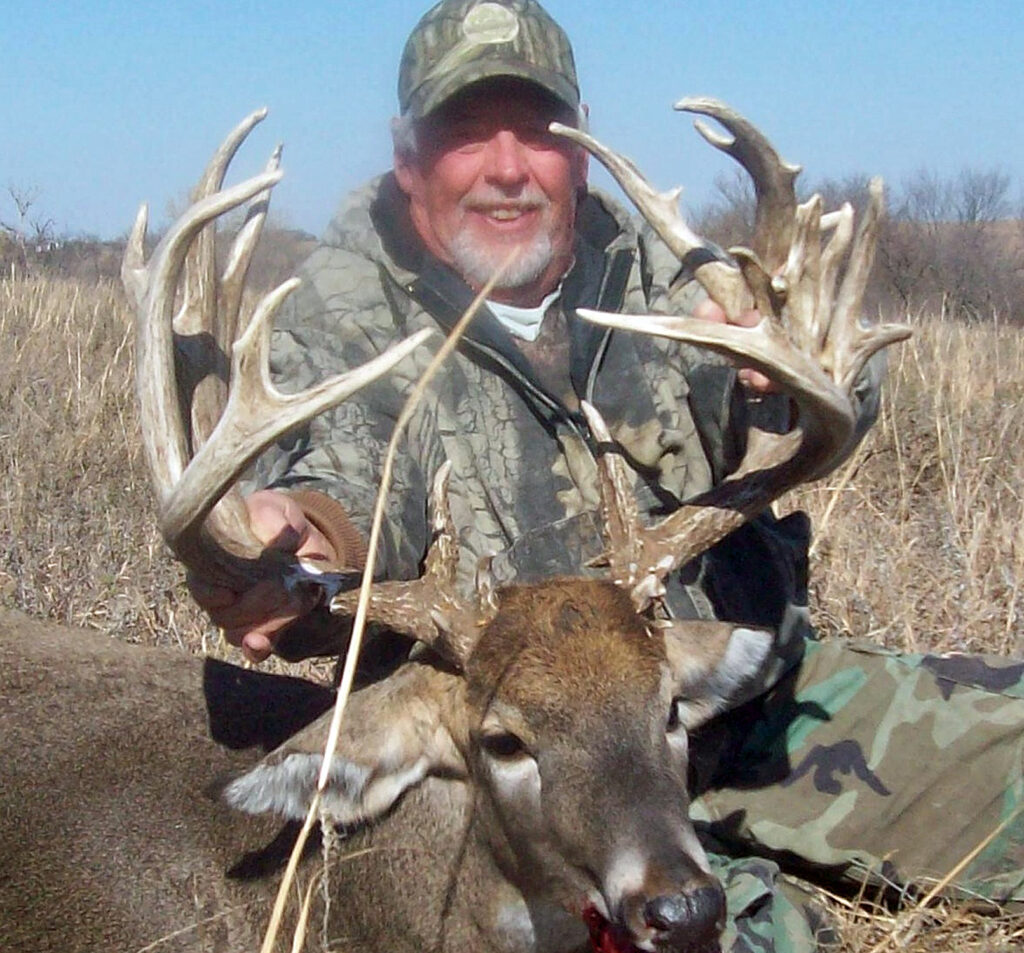
By David Rainer, Alabama Department of Conservation and Natural Resources
While I and my family have been blessed during the COVID-19 pandemic with basically no ill effects, the virus robbed me of the chance to say farewell to one of the people most influential in my career covering the outdoors in Alabama.
Robert Lee Rivenbark of Fairhope did not succumb to the coronavirus. He lost his battle with prostate cancer recently after a long struggle. He was 76.
Because of the virus restrictions, I was only able to visit over the telephone before he passed away.
Rivenbark fits in what I call my curmudgeon category. He could be short and to the point, and our last phone call started in typical fashion. When his wife, Charlotte, handed him the phone and told him it was me, no “How are you doing” or any such formalities ensued. The first sentence out of his mouth was, “Whadda you want?”
However, he always tried to help with what I wanted. When I first moved to lower Alabama to take the job as Outdoors Editor at the Mobile Press-Register in 1992, a friend of mine insisted I look up Lee when I got to town.
Boy, I’m glad I did. Lee was a man of the outdoors, from the intricate machinations of Mobile Bay to the haunts of the wary white-tailed deer.
In fact, we hit it off so well that before I got my family moved down, I rented a garage apartment on the Rivenbark compound on Mobile Bay at the south end of Fairhope, where the Rivenbark family had been since 1966.
It was a small apartment, but it had a great view of the Rivenbark pier and water beneath the pier light. Obviously, the pier light attracted bait fish and subsequently speckled trout and redfish. From my vantage point in the apartment, I could take a pair of binoculars and look at the pier. If I could see fish activity under the light, I would grab a rod and reel and head down to catch a few fish for the next night’s meal. If the water was calm, I’d roll over and go to sleep.
I don’t remember how many times Lee retold that story to illustrate how “sorry” I was, but it always ended in a big laugh.
Lee was the first to admit that he was not a hook-and-line angler. He much preferred a cast net and could throw a “silver dollar” every time. He tried to teach me but finally gave up when I got to the butterbean stage.
If mullet tried to swim past the Rivenbark pier when Lee was there with his cast net, the fish didn’t stand a chance.
Despite his reluctance, one day he agreed to go with me on a little fishing trip to the Grand Hotel jetties. I was dragging a plastic grub across the bottom, hoping to locate a few flounder. I caught a flatfish and cast right back into the same spot and hooked up again. I got Lee to cast in that spot and he hooked a fish. If our baits landed in an area about the size of a washtub, we ended up with a fish. We caught a dozen before the spot ran dry.
Lee, known as Uncle Lee to my daughters, had knowledge of Mobile Bay was extraordinary, and I was lucky enough to be on his jubilee hotline.
For those who aren’t familiar with the phenomenon, a jubilee happens when the bottom-dwelling fish and creatures in the bay end up on the shoreline.
Jubilees occur during the summer when patches of water with low dissolved oxygen form in the bay. With the right conditions, that oxygen-depleted water moves to shore, mainly Baldwin County’s Eastern Shore, pushing those fish and marine creatures ahead of it.
It usually happens in the wee hours of the morning, and a jubilee could include everything from flounder to shrimp to crabs to eels.
If I got a call at 4 a.m. and I heard “Rivenbark, Fairhope Pier,” I knew to jump up, grab my wading shoes, gig and light and meet him for the bonanza that is a jubilee.
Jubilees were always fickle experiences. Sometimes it would be only shrimp. At other times it was mostly flounder. At times it was everything, with blue crabs crawling out on piers and pilings to flounder stacked on top of each other trying to find oxygen.
When a thundershower moved through in the afternoon and the wind was blowing gently out of the east, Lee would tell me to expect a phone call.
But you never knew what you were going to get or whether it was going to materialize. One night we were all set for a big jubilee with everything falling into place. Just as the flounder got near gigging range, a huge wake from a ship heading down Mobile Ship Channel crashed ashore, and the jubilee vanished right before our eyes.
So many memories come to mind when I think about Lee, including the time we tried to go fishing in the Chandeleur Islands off the Louisiana coast. Tried is the key word here. We set out from Fly Creek Marina in Fairhope aboard Dr. Larry Ennis’ catamaran sailing vessel for an extended adventure. By the time we got south of Biloxi, Mississippi, we got bad news. Not one but two tropical systems were forming in the Gulf of Mexico. We turned the boat around but could only make it back to Pascagoula before we abandoned ship and called for someone to pick us up.
When it came to hunting, Lee had never really taken up the turkey hunting sickness because he was too busy taking advantage of the bounty of Mobile Bay during the spring.
But deer hunting was his main outdoor passion. He hunted deer from Colorado to Conecuh County and everywhere in between. Of course, most of his deer came from Alabama, and he was a meticulous record-keeper.
“He kept a record of all the crabs and mullet he caught off the pier and every deer he shot,” said younger brother John Rivenbark.
Lee was absolutely the luckiest deer hunter I have ever known. He could break all the rules and still be successful. He could be smoking a cigarette and the biggest buck in the woods would step out in front of him.
He had told me before the season started that all he wanted to do was kill his 400th deer. He only needed three to reach that milestone.
It was a struggle early in the season with the effect of chemotherapy on his body and the weather. Our mutual friend from Mississippi set up a hunt for Lee in Texas, but his health wouldn’t cooperate. I tried to set up a hunt for him at Bent Creek Lodge in Jachin, Alabama, but he wasn’t up to the trip.
With his brothers and friends like Ken Jansen, Judson Pizzotti and Gary Wolfe helping him along the way last season, Lee managed to accomplish his goal.
He bagged his 400th deer, a doe, with his twin brother, Arch, and family friend Carl Enfinger in tow.
Lee ended his deer-hunting career with 402 reduced to bag.
He asked me, after he knew this would likely be his last deer season, if I wanted one of his deer rifles or any of his mounts after he was gone.
I told him he should give those to family members, but I did have one request. He had a stainless steel rod, sharpened on one end with the small rope attached to the other. It was his custom flounder gig that allowed him to slide the gigged flounder down the rod and onto the string so he didn’t have to stop during a jubilee.
“Lee, all I want is your flounder gig if that’s alright,” I said.
“That’s all you want?” he said with curious look.
“Yep,” I said, “because every time I stick a flounder I’ll think of you.”
I hope to rekindle those memories of my great friend real soon
Auburn forestry faculty help major YouTube influencer plant 20 million trees via #teamtrees
By Teri Greene
Two Auburn University forestry professors lent a hand to a hugely popular YouTube scientist in an effort by internet content creators of all types to raise $20 million for the Arbor Day Foundation, which has agreed to plant one tree for every dollar raised at teamtrees.org.
Professor Becky Barlow and Research Fellow John Kush of the School of Forestry and Wildlife Sciences joined up with Destin Sandlin, whose channel “Smarter Every Day” has more than 8 million followers, to share their insight and raise awareness about the growth cycles and conservation of trees.
Sandlin’s video, How to Plant 20 Million Trees, which features Barlow and Kush, has received more than 1.3 million views. It’s part of the National Arbor Day Foundation’s lofty goal to raise $20 million in order to plant 20 million trees. The goal was met well before the deadline, and the project is retaining its momentum: By the end of February, the fundraiser had well surpassed its goal, with more than $21.7 million raised and donations continuing to pour in. To see a live count as the donations continue—or to make a donation in honor of National Arbor Day—go to teamtrees.org.
Kush said he had no idea how far a group of YouTube videos could go in terms of raising awareness and advancing education.
“I was amazed,” Kush said of the million-plus views Sandlin’s video received. “It’s great exposure for the longleaf pine, the School of Forestry and Wildlife Sciences and Auburn University. I had no idea how many people subscribe to some of these YouTube channels.”
The #TeamTrees campaign was started by internet content creators, sparked by a tweet from YouTube star Mr. Beast, who decided to commemorate reaching the 20 million subscriber mark by setting off a viral effort to plant 20 million trees. In May, his fellow YouTuber Mark Rober teamed up with Mr. Beast and his crew to kick off the project by planting trees in a field in Oregon. On the project’s launch day, Oct. 25, Rober posted a video of that tree-planting and, with Mr. Beast and others—including Sandlin—began to rally social media influencers to spread the word about the #TeamTrees project, which ran through Dec. 31.
Since the trees are scheduled to be planted in locations worldwide, this effort places an emphasis on planting trees that are native species, where local conditions and forest plans allow. The National Arbor Day Foundation’s motto sums it up: “To plant the right tees, in the right place, at the right time, for the right reasons.”
Which trees, where to plant and why
Sandlin made a pitch to Auburn’s School of Forestry and Wildlife Sciences, including the lines, “I’d love to include Auburn University in the video [even though I’m a Bama grad]. You’re the authorities on forestry, and I’d like to highlight that to an international audience.”
Sandlin, who’s examined nature worldwide in his video adventures, has a keen interest in trees, and he’s familiar with Auburn’s forestry work: Back in the 1960s, his grandfather worked with Auburn students to see whether a group of newly planted longleaf pines would grow on his property, just north of the species’ range. Only two of the many trees planted on his grandfather’s land survived. One lived until the mid-1970s, and the other lived until the late ’80s.
“My hope was that, if we are going to plant 20 million trees, we should gain some scientific knowledge about what species will perform best in certain soils and climates,” Sandlin said of his contribution to the #teamtrees project. “Environments and ecosystems change, and I see this as a gigantic opportunity to gain data for the snapshot of time that we live in. What happens will be left up to the Arbor Day Foundation, but I hope to work with Auburn to gather data in some way.
“Dr. Barlow and Dr. Kush share my passion for education, but also were willing to lay out the facts in a clear, intelligent and respectful way,” he said.
Barlow and Kush were enthusiastic to share their expertise with Sandlin and his viewers.
Barlow explained the importance of silvics—the study of the life history and character of forest trees. In the video, she explains the importance of the location in which trees occur, their growth levels, need for sunlight and tolerance of shade. She also emphasized that some species require higher levels of maintenance than others.
In the video, Kush’s statement that certain trees need fire to survive seemed to take Sandlin—and probably his viewers—aback. But Kush said getting the word out about the health of the longleaf pine was one reason he was excited to work with Sandlin. He said the ecology of the longleaf—particularly its need of fire—is often misunderstood.
Kush noted that the species evolved with frequent fire.
“We need to be proactive and increase our use of prescribed fire,” Kush said. “This will not only help in longleaf pine management but improve wildlife habitat for game species as well as numerous threatened and endangered species in the Southeast.”
Sandlin was grateful that Kush shared this fact with viewers.
“It can be quite a challenge to help people understand that, at times, fire can be good for the ecosystem,” Sandlin said. “I believe our message got through.”
Funds already in action
The planting of 21.5 million trees is already underway, with specific projects planned for the spring, summer and fall of 2020, according to a joint press release from the National Arbor Day Foundation and #TeamTrees.
The funds are helping replant trees lost in the unprecedented 2018 California wildfire season, in which 8,000 fires burned through more than 1.8 million acres of forestland. Replanting this area will prevent mudslides and degraded soil, water and air quality and other challenges. The project is part of a four-year reforestation effort that will help families recover from those wildfires.
This spring and running through summer, the #TeamTrees team will aid in the replanting effort in Kenya’s Kijabe Forest, an important wildlife corridor and water source for the country that has been damaged dramatically over the past 15 years as it has been cleared for charcoal and timber. The newly planted trees will help re-establish a sustainable water supply, restore habitat for wildlife by stabilizing landslide-prone slopes and secure local livelihoods.
In the summer and fall, the team will help reforest the Cauvery River Basin in southern India, which has shrunk by about 40 percent from its historical flows over 70 years, resulting in scarce drinking water and difficult farming conditions. A loss of tree cover has also led to poor soil health. Reforesting the basin and educating farmers will help stabilize the river and improve soil conditions over time.
A crowd-driven effort
In the end, the widespread social media push to raise awareness and educate had the greatest impact on the effort, with #TeamTrees identifying more than 800,000 unique donors. A handful of billionaires including Elon Musk and Tobias Lutke did contribute to the cause, but for the most part this was a grass-roots success.
“I predicted a few more wealthy individuals or organizations would realize the PR potential and jump on board,” Sandlin said. “The fact that the majority of funds for the Arbor Day Foundation were raised by individuals feels really good.”
Food Safety a Top Priority in Alabama Produce Industry
With Alabama’s growing season in full swing, produce growers are working to ensure continuing food safety during the COVID-19 pandemic. The CDC, USDA and FDA agree that there is no indication the virus can infect consumers through food or food packaging.
Good Agricultural Practices
Alabama Extension food safety regional extension agent Kristin Woods said the produce industry uses Good Agricultural Practices (GAP) and Good Manufacturing Practices (GMP) to help protect against foodborne illness.
Woods said that many growers go through voluntary audits to verify that fruits and vegetables are produced, packed, handled and stored as safely as possible to minimize risks of microbial food safety hazards.
“Food system workers—including harvesters, packers, processing line workers and others—are critical to a safe and consistent food supply in the U.S.,” Woods said. “In fact, a Department of Homeland Security issued guidance recognized agricultural production, food processing, distribution, retail and food service as well as allied industries workers as essential workers.”
Health of Agricultural Workers
Woods said worker health is crucial to a stable supply.
“Farms already have food safety protocols in place to preserve the safety of freshly harvested products, but now there are also enhanced procedures to protect employees from the virus,” she said. “These procedures protect workers during harvest and in packinghouses so that producers can keep food flowing from farm to table.”
Woods said consumers should know some key facts about the produce industry.
- Food system workers are highly trained. These workers undergo extensive training to prevent the hazards that cause foodborne illness. They have the knowledge to assess risks on the farm, during processing, at retail and in the kitchen.
- If a worker tests positive for COVID-19, they go home. Individuals who come in contact with an infected person should self-quarantine.
- Processing facilities have enhanced procedures to frequently clean and sanitize high-traffic surfaces. This virus, like others, can survive on surfaces for an extended time making cleaning and sanitizing vital.
- There is no food shortage in the U.S. Shoppers may see empty grocery store shelves in the short-term. However, many packinghouses are shifting gears from food service accounts to retail accounts. This switch takes time to see on the grocery store shelf.
Woods encourages shoppers to exercise patience instead of stockpiling.
“Shifting our food supply from foodservice to retail in a short amount of time is not an easy job,” she said.
Produce Safety
While Woods emphasizes the importance of purchasing and consuming Alabama-grown produce, she reminds consumers that because this virus does not appear to be foodborne, imported produce remains safe.
“That’s especially good news for people who like tropical fruits including pineapples, bananas and papayas,” Woods said.
Woods said using basic hygiene practices can curb the spread of the virus and other germs.
“Washing hands before and after a grocery trip, social distancing from other shoppers, covering coughs and sneezes or staying at home when feeling unwell help reduce the spread of the coronavirus,” she said.
Farmers market shoppers may notice new packaging or rules as they begin shopping for produce this year.
Vendors will expect shoppers to shop safely. Take advantage of any opportunity to wash or sanitize hands. Also try to avoid picking up produce to inspect it before purchasing.
“If it is possible to pay in advance, use a credit card or use Apple Pay—do it,” Woods said.
More Information
More information on food safety at the farmers market are in the Alabama Extension Food Safety at the Farmers Market Video Series.
Find more information on all aspects of food safety on the Alabama Extension website, www.aces.edu.
Upcoming Virtual Field Trips To Feature Beef Cattle, Honeybees
Alabama farmers will keep their Virtual Field Trips moo-ving and buzzing with upcoming tours of an Autauga County beef cattle farm and Auburn University’s Bee Lab. The Virtual Field Trips are offered through Facebook Live on the Alabama Farmers Federation Facebook page every Friday at 10 a.m. through May 22.
On April 17, viewers will learn all about beef cattle as they explore Hickory Hill farm in Billingsley with farmers Taber and Grace Ellis.
“This one should be very fun for students because they’ll get to see big livestock up-close and not just far off in a field,” said Mary Wilson, Federation director of news services. “They even plan to show how they use their horses to go out and check on the cattle, so viewers will be seeing a real life cowboy!”
Honeybees will be the focus of April 24’s Virtual Field Trip as Geoff Williams provides a tour of Auburn University’s Bee Lab.
“We’ve found a lot of people – students and adults alike – have questions about honeybees, ranging from whether or not honey helps combat seasonal allergies to how to help protect honeybee colonies,” Wilson said. “This field trip will allow researchers at Auburn to tell us more about what they’re doing to help keep honeybee populations healthy and thriving.”
Viewers are encouraged to ask questions through the comment section, and each video will include links to educational activities centered around the featured commodity.
Scheduled topics for May, subject to change, are:
May 1 – Catfish
May 8 – Greenhouse and nursery products
May 15 – Forestry
May 22 – Cotton and other row crops
To receive Facebook notifications about the Virtual Field Trips, respond as “Interested” in the event or follow the Alabama Farmers Federation page.
Previous Virtual Farm Tours and educational resources may be viewed online at www.alfafarmers.org/virtual-field-trip. Row crop farmer Jonathan Sanders of Coffee County kicked off the program April 3, focusing on peanut production. The April 10 Virtual Farm Tour featured sisters Cassie Young and Allie Logan of Barbour County who discussed raising fruits and vegetables at their Backyard Orchards.
The Federation is Alabama’s largest farm organization with more than 340,000 member families. Find additional educational materials, including Ag Mags and free printable coloring book pages, online at www.alfafarmers.org/schools and click on resources.
This Virtual Field Trips project was developed in conjunction with Girl Scouts of Southern Alabama (GSSA). For additional virtual programs from GSSA, visit GirlScoutsSA.org.
Vandalism Continues to Be Problem at WFF Shooting Ranges
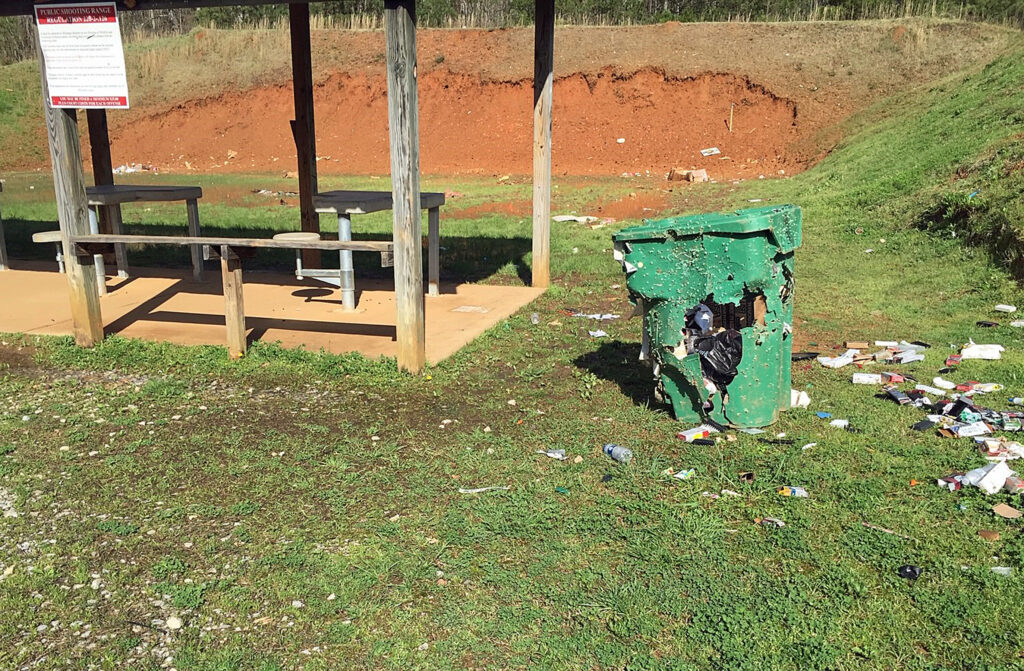
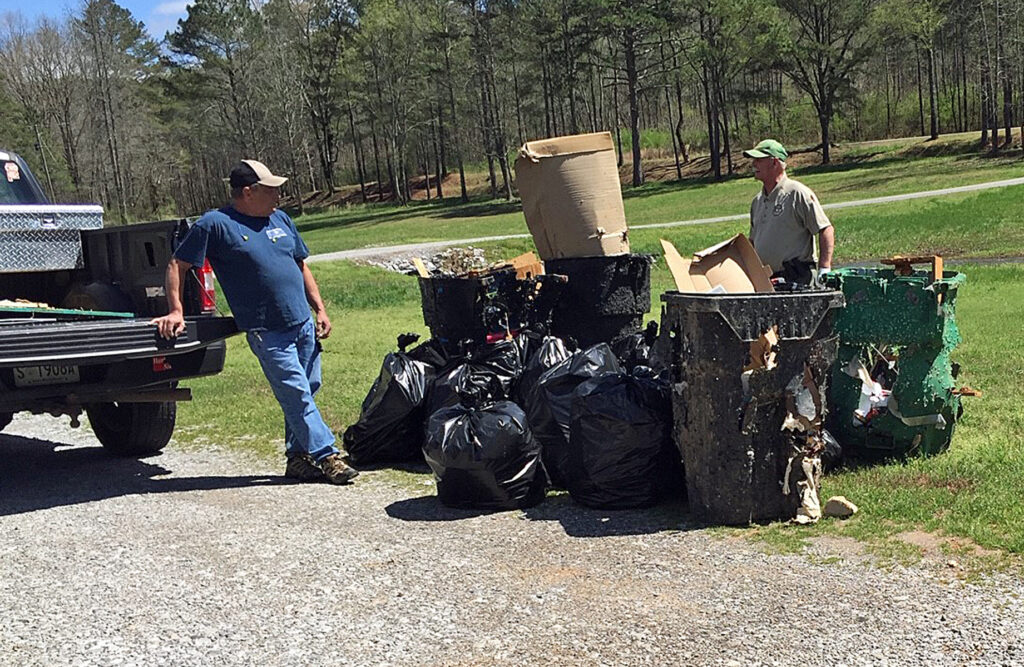
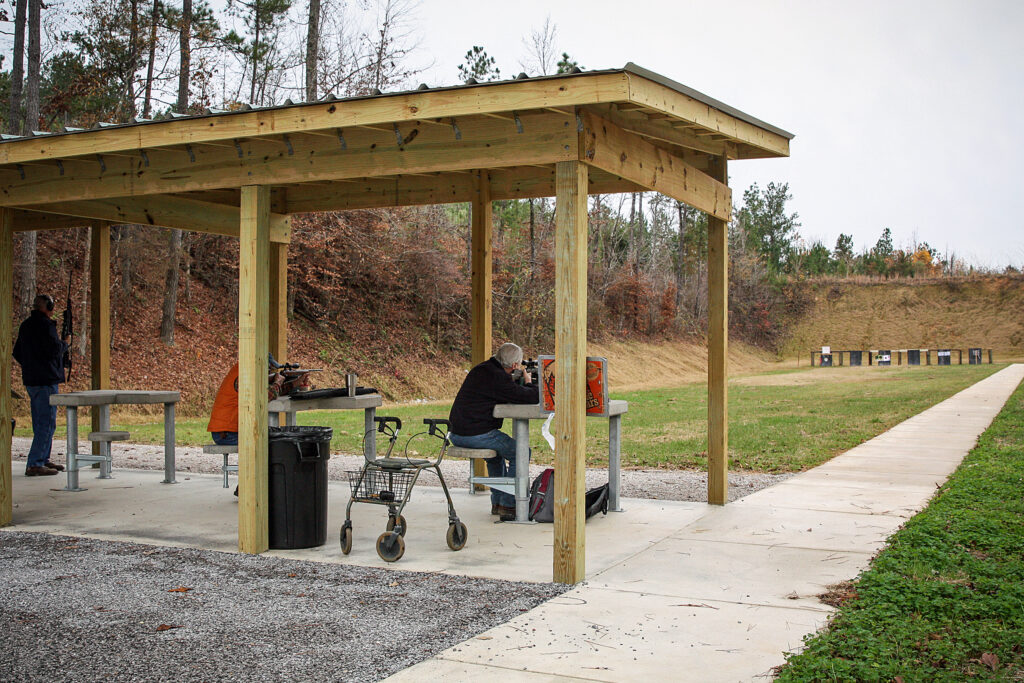
By DAVID RAINER
Alabama Department of Conservation and Natural Resources
It’s like when their favorite lamps get broken by reckless youngsters and moms say, “This is why we can’t have nice things.”
I don’t get riled easily, but one photo posted recently by the Alabama Wildlife and Freshwater Fisheries (WFF) Division really kicked my blood pressure up a notch.
Some yahoos at one of the WFF shooting ranges vandalized items at the range to the detriment of all who use and maintain the shooting facility.
Unfortunately, a few bad actors could jeopardize the use of some of these facilities if this malicious behavior continues. The facility where inconsiderate people destroyed state property is still open. For now.
WFF Director Chuck Sykes said the vandalism at Etowah Shooting Range that irked me so much is only one of many examples of how destructive some people can be.
“We installed new concrete shooting benches at several ranges over the past couple of years,” he said. “Within days of us installing them, several were damaged through senseless vandalism.”
Unfortunately, vandalism is not new, but this new destructive activity could have a greater impact. As far as the damage done at the Etowah range, Marisa Futral, WFF Hunter Education Coordinator, said the recent incident indicated a growing problem.
“People can be so inconsiderate,” she said. “People will bring computers, washing machines or whatever to shoot. If they don’t have anything, they’ll just shoot up the garbage cans. It’s not the first time it happened at Etowah, but this time was really bad. Then they just leave them for someone else to clean up.”
Futral said another example of people being inconsiderate is when they place their targets too close to the bench, causing their bullets to impact the floor of the range instead of going into the earthen berm. This creates big ruts in the floor of the range and makes maintenance a nightmare.
“At South Sandy at Oakmulgee Wildlife Management Area, we had just put 13 new shooting benches there,” she said. “They cost more than $900 each. We were trying to make the facilities as nice as we could. We weren’t open a week before someone either shot or took a sledgehammer and tore up one of the benches. Fortunately, we did have some thoughtful users who were in the concrete business. They volunteered to supply materials and labor to repair the benches. That was a positive, and we wish all users would have this attitude. That’s why we would love to staff all of our ranges – to stop all the vandalism.
“Unfortunately, it’s the few who ruin it for the many.”
Two facilities, the Cahaba Public Shooting Range in Shelby County and the Swan Creek Public Shooting Range in Limestone County, had to be closed temporarily because the users would not abide by specific social-distancing guidelines. Another facility, the Conecuh Public Shooting Range, was also shut down due to the temporary closure order issued for all U.S. Forest Service recreational access areas in national forests.
“As with most things, Alabama hunters have it really good,” said Director Sykes. “Our Governor has been working generously with us to make sure we keep the outdoors open. It is providing a healthy alternative for people who are social distancing. You can be smart about it and still go to the woods and hunt, still get on the water and fish, as long as people take this seriously and don’t think it’s a three-week vacation, because it’s not. We want you to get outdoors and have fun. What we do for a living is provide those opportunities. As long as people are smart about it, we will remain open. But we had to close two of our staffed shooting ranges because people would not obey the guidelines set forth by (State Health Officer) Dr. (Scott) Harris and the Governor.”
Sykes said the staff taped off every other shooting bench at the staffed ranges to ensure people were maintaining the proper 6-foot distancing, to no avail.
“We told people coming into the range that they had to follow the social-distancing protocol or they would force us to close it,” Sykes said. “Before lunch, people were stacking their equipment on the taped-off benches, walking all over people. We just finally had to close it.”
Futral said the program had no other option than to close the manned shooting ranges that she and her staff oversee.
“Those ranges were so packed,” Futral said. “Everybody was touching the same staple gun and same benches. People weren’t maintaining the 6-foot social-distancing recommendations. Our staff was getting exposed. We definitely didn’t feel like we were complying with Governor Ivey’s order not to congregate.”
The nine WFF shooting ranges that currently remain open are Barbour WMA Shooting Range, Coosa WMA Shooting Range, Etowah Shooting Range, Freedom Hills WMA Shooting Range, Marengo Public Shooting Range, Sam R. Murphy WMA Shooting Range, Skyline WMA Shooting Range, South Sandy-Oakmulgee WMA Shooting Range and Upper Delta WMA Shooting Range. Visit www.outdooralabama.com/activities/shooting-ranges for details about the ranges.
WFF Director Sykes said people in Alabama may not realize how good they have it right now in terms of enjoying the outdoors.
Governor Kay Ivey specifically granted Alabamians the option of enjoying outdoors recreation during the virus restrictions, with the proper social distancing of course, because she knows how cherished the outdoors is to people in our state.
“A lot of states are experiencing mandates to close public access during these restrictions,” Sykes said. “For one example, Illinois shut down all of its public hunting lands. If you’re an Alabama resident who drew a non-resident turkey tag in Illinois, you’re out of luck unless you have access to private property. I hunted in Nebraska last year, and I received a text from their game department that said basically, thanks for buying your turkey tags last year, but, sorry, you can’t come this year.
Sykes said a meme floating around social media nails the hoarding hysteria that hit the nation.
“It says the reason we have game and fish regulations is because of how some people acted in the grocery store,” he said. “We’re trying to provide an opportunity. People who abuse it, hurt it for everybody else. I’m not saying there are a lot of people who do this. For the most part, the people who use the shooting ranges and hunt and fish on the WMAs (wildlife management areas) are upstanding citizens. They buy their licenses. They abide by the rules and regulations. They abide by the bag limits and fish creel limits. And it’s a pleasure to have them around.
“My daddy always taught me there’s one in every crowd. And you know what that one is. Those people are the ones who could possibly ruin it for everybody.”
Sykes participated in a conference call recently with the National Forest Service to determine if those lands could remain open during the coronavirus outbreak.
“They don’t want to shut down the national forests,” he said. “We are struggling nationwide for relevancy. People are not growing up in the country. They don’t have a high value for outdoor recreation like we do because we grew up doing it.”
As tragic as this virus has been for many in the nation, Sykes sees an opportunity.
“Let’s make lemonade out of lemons,” he said. “This is a terrible situation for the country as a whole, but this is a great time for us to show people what we do, how we do it and why we do it. We’re providing recreational opportunities for people who would normally be going to soccer games, going to movies or concerts and stuff like that. We’re providing them with a safe, healthy alternative to go outside and enjoy nature. This may be the silver lining for this.
“We’re the only game open in town right now. If people use it wisely, it may help us create a new group of users.”
Drivers Should Watch For Farmers During Planting Season
Written by Marlee Moore
Alabamians are encouraged to stay home during the COVID-19 pandemic; however, farmers are still performing essential work planting crops to feed, fuel and clothe consumers.
That means drivers performing essential travel, such as to the grocery store, are sharing the road with more farm machinery.
“Springtime means farmers are moving equipment to and from the field as they work to grow crops we all depend on, which is especially critical during times like these,” said Alabama Farmers Federation President Jimmy Parnell. “We encourage drivers to be alert, slow down and be patient as they encounter tractors on the roadways.”
The U.S. Department of Transportation reports 15,000 accidents annually involving farm vehicles in the U.S. Alarmingly, 55% of highway deaths are on rural roads.
Parnell said farmers try to pull over to allow cars to pass. However, congestion is inevitable due to speed limitations of farm equipment.
“We ask drivers to understand farmers are on their way to work,” said Parnell. “A little patience can mean the difference between life and death. Saving a few minutes is not worth endangering the life of yourself, the farmer or other drivers by passing on a solid yellow line, swerving around a tractor or approaching slow-moving vehicles at high speed.”
Slow-moving vehicles should be identified by an orange triangle on the back of the machine, meaning it’s designed to travel at 25 mph or less. The Federation noted it only takes five seconds for a car moving 55 mph to close a gap the length of a football field with a tractor moving 15 mph.
Safety tips for drivers include:
Slow down when you see a piece of agricultural equipment. Most farm equipment is designed to travel at speeds of only 15 to 25 mph.
Watch for slow moving vehicle (SMV) signs. SMVs are required for vehicles traveling less than 25 mph.
Watch for electronic or hand turn signals. Just because a tractor veers right does not mean the operator is pulling over to allow someone to pass. The size of farm equipment often dictates the necessity of wide turns.
Pass farm equipment cautiously. Even when passing safely and legally, machinery may sway or become unstable. Do not expect operators to drive their equipment onto the shoulder of the road.
Driving with one set of tires on loose-surfaced shoulders substantially increases the risk of turning over.
Watch for flashing amber lights. This type of light often marks the far right and left of farm equipment. Also watch for reflective tape marking extremities and sides of equipment.
Remember agricultural vehicle operators have a right to drive their equipment on the road.
Reimagine Your Recycling During COVID-19
The coronavirus has stretched into many aspects of daily life. With a strict enforcement on social distancing in many areas, it has left many people wondering what this distancing means for their daily curbside recycling.
Karnita Garner, an Alabama Extension environmental specialist, said many areas have halted the pickup of recyclables.
“The Centers for Disease Control and Prevention reports that the coronavirus can live on plastic and other surfaces for three days,” Garner said. “Because of this, many municipal governments have stopped offering curbside services. They have also restricted the pickup of any loose recyclable materials not placed in plastic bins or bags.”
Can’t Recycle? Reuse Instead
With some recycling avenues momentarily shut down, many people are asking what they should do with the materials they normally recycle. There are many materials that people can reuse for other purposes.
In the Garden
Allyson Shabel, an Alabama Extension urban home grounds, gardens and home pests regional agent, said some items have great uses in the garden.
“Cardboard and paper products, such as newspapers, can be used to control weeds in flower beds and vegetable gardens,” Shabel said. “Put down a few layers of these products and cover them with mulch. The mulch will keep them from blowing away and will look nicer. This will help keep weeds at bay over the spring and summer.”
Plastic bottles with the caps on and packing peanuts are great to add the bottom of large or heavy flowerpots and containers. This makes them easier to move and also gardeners will use less soil. Shabel said only use this method with containers that are at least two feet deep, filling only one third of the depth with the filler material.
Shabel also said people can repurpose clamshell plastic containers, like the ones used for fresh fruits and vegetables, as seed starters and propagation containers for perennials and annuals.
“First, clean them well with soap and water, then fill them with 3 inches of potting mix,” Shabel said. “Put the containers in a sunny window or a shady location outdoors. The closed lid will help hold a little humidity in and keep the cutting hydrated.”
Around the Home
Garner said a lot of the items that are normally recycled could be upcycled and turned into useful or beautiful things.
“Now is a great time to do some arts and crafts with your kids. Some items, such as newspapers and magazines, are perfect for this,” Garner said. “Other items, like glass and plastic containers, can be upcycled and used as organizers for household items or children’s toys.”
Garner said there are many websites and social media pages that have great ideas for reusing recyclable materials.
Ideas for Storage
For the items that people do not reuse, there is still the problem of storing them until recycling pickup starts again. Garner offers the following storage and space-saving tips that can help with this problem.
Request additional recycling bins or a larger bin from the city municipality. Contact your local municipality to determine if they have incorporated recycling services into the trash collection service because of COVID-19.
Purchase stackable storage bins and collect recyclables in cardboard boxes or plastic storage bins. If cost is not a factor, purchase larger outdoor recycling bins to store in the garage, shed or backyard.
Reduce the number of items to recycle during COVID-19. Focus on certain items that have the greatest environmental impact
Breakdown cardboard boxes or smash or minimize the size of recyclables like aluminum cans to save space.
For more information on recycling and other topics related to COVID-19, visit the Alabama Extension coronavirus website, www.alabamaready.info.
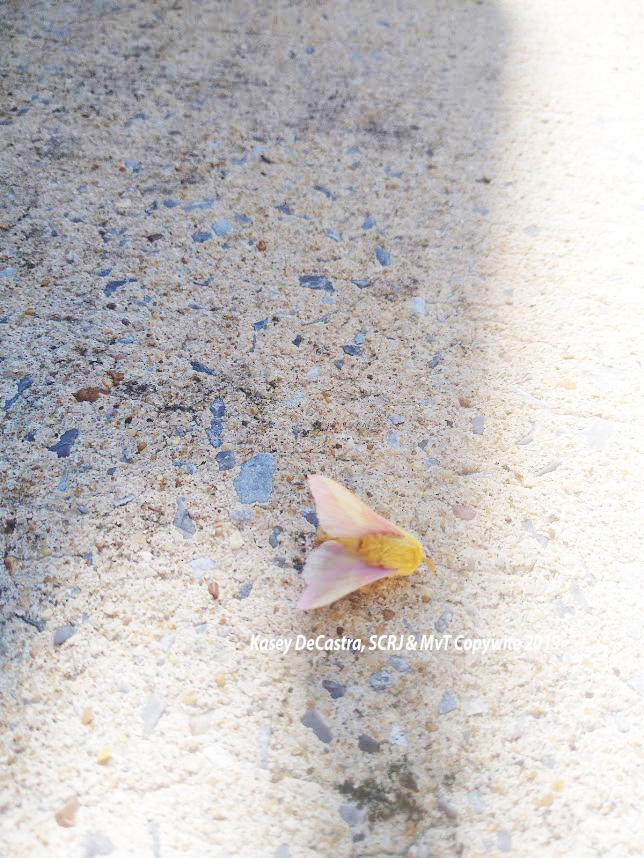
Governor Ivey Announces National Fish and Wildlife Foundation Projects in Alabama
Governor Kay Ivey announced today that the National Fish and Wildlife Foundation (NFWF) recently awarded nearly $24 million from its Gulf Environmental Benefit Fund (GEBF) to four new projects in the state of Alabama. The projects, developed in consultation with state and federal resource agencies, are designed to remedy harm and reduce the risk of future harm to natural resources that were affected by the 2010 Deepwater Horizon oil spill. The Alabama projects address high-priority conservation needs, including the acquisition and protection of important wetland habitats.
“The funding of these projects continues reinvestment in the Alabama Gulf Coast communities that were impacted by the Deepwater Horizon oil spill nearly 10 years ago,” Governor Ivey said. “I appreciate the work of the Alabama Department of Conservation and Natural Resources and our partnership with NFWF as we continue to recover and build a more resilient coast.”
NFWF created the GEBF in 2013 to receive and administer funds resulting from remedial orders in plea agreements between the U.S. Department of Justice and BP and Transocean. The plea agreements resolved certain criminal charges against both companies relating to the 2010 oil spill. Provisions within the agreements directed a total of $2.54 billion to NFWF to be used to support natural resource projects in each of the five Gulf States.
The number of awards from the GEBF in the state of Alabama now stands at 34, with a total value of nearly $215 million. All projects were selected for funding following extensive consultation with the Alabama Department of Conservation and Natural Resources (ADCNR).
Blackwater River South Tract Acquisition
This project, in partnership the Alabama Forever Wild Land Trust, will acquire and permanently protect 2,300 acres of coastal habitat at the confluence of the Blackwater and Perdido rivers. The subject tract includes four miles of frontage along both rivers, more than 1,200 acres of wetlands, and a 90+ acre lake. Wetlands and other diverse habitat types found on the property support a variety of bird species and other wetland-dependent species.
Protection of the subject property will maintain water quality in the Perdido estuary and the living coastal and marine resources it supports. Once acquired, the property will be conveyed to the Alabama Forever Wild Land Trust.
The project builds upon previous acquisition investments made within the area by the Alabama Forever Wild Land Trust, The Conservation Fund, The Nature Conservancy, ADCNR, and other partners in Florida which are working together to protect this important river corridor.
The acquisition was facilitated by The Conservation Fund.
Lower Halls Mill Creek Protection
This $2,687,000 project, administered by the Mobile County Commission, will acquire and permanently protect approximately 300 acres of wetland habitat in the Dog River Watershed. The target acquisition area in Lower Halls Mill Creek comprises one of the largest contiguous undeveloped areas of bottomland hardwood wetlands remaining in the watershed. Acquisition of this tract will preserve unique tidally influenced marshes in the Dog River Watershed that support many species of shellfish, finfish, birds, and other wildlife of the type directly impacted by the Deepwater Horizon oil spill. Protection of these natural wetland areas will ensure continued protection of downstream water quality and wetland habitats in the Dog River Watershed.
Lower Fish River Watershed Restoration
A $6,554,000 award under GEBF will focus on highly-eroded riparian areas and stream channels within the Lower Fish River Watershed, a priority coastal watershed draining into Weeks Bay. Engineering and design plans will be developed for the most severely-eroded stream channels. The project also includes the restoration of an unnamed tributary to Fish River near the community of Marlow. This project will reduce sediment and nutrient pollution into Weeks Bay, improving water quality and enhancing seagrass beds and oyster reef habitat.
Dauphin Island Causeway Shoreline and Habitat Restoration Project
A $9,392,000 award under GEBF will create and protect important coastal habitat, reducing vulnerability of the only access route between south Mobile County and Dauphin Island. This project will design and install breakwater and create intertidal marsh habitat to provide protection against future erosion and storm damage. Project activities will be co-funded through NFWF’s Emergency Coastal Resilience Fund.
Hurricanes Michael and Florence, Typhoon Yutu, and the coastal wildfires of 2018 caused more than $50 billion in damage and severely degraded a range of wildlife habitats. Congress provided funding under the Supplemental Appropriations Act of 2019 (P.L. 116-20), allowing grants to be awarded through a partnership between NFWF and NOAA. Senator Richard Shelby was instrumental in the passage of this critical funding legislation.
The Emergency Coastal Resilience Fund will provide an additional $4.9 million toward the Dauphin Island Causeway Shoreline and Habitat Restoration Project.
For more information on coastal restoration projects in Alabama from all Deepwater Horizon funding sources, please visit https://www.alabamacoastalrestoration.org/.
Farmers Eligible for Forgivable Small Business Loans
Alabama farms, nurseries and other agricultural businesses may be eligible for forgivable loans under the Coronavirus Aid, Relief and Economic Security (CARES) Act signed last week by President Donald J. Trump.
Mitt Walker of the Alabama Farmers Federation said the Paycheck Protection Program (PPP) is designed to help small businesses and their employees weather the economic downturn.
“The $2 trillion stimulus package includes $349 billion for the PPP,” said Walker, the Federation’s National Affairs director. “The program helps small businesses keep employees on the payroll by providing guaranteed loans, which may be forgiven if used for approved costs.”
Walker said the Federation and American Farm Bureau Federation (AFBF) worked with government agencies and Alabama’s Congressional delegation to ensure farms are eligible for the program.
“Farm businesses are a vital part of our economy,” Walker said. “They provide jobs both directly and indirectly. Every dollar earned on a family farm turns over about seven times in the community. The PPP can be an important tool to help these farm businesses and rural communities survive fallout from the COVID-19 pandemic.”
Eligible businesses include limited liability companies (LLC), S corporations, sole proprietorships, contractors and non-profits with 500 or fewer employees. Loans are capped at $10 million, but can include up to eight weeks of average monthly payroll costs from last year plus an additional 25% of non-payroll costs. Different calculations apply to seasonal and new businesses. The PPP will be available through June 30, 2020.
According to the Small Business Administration (SBA), PPP loans will be forgiven if all employees are kept or quickly rehired and compensation levels are maintained for eight weeks. To be forgiven, loan funds must be used for:
Payroll and benefits
Mortgage interest incurred before Feb. 15, 2020,
Rent, under lease agreements in force before Feb. 15, 2020, and
Utilities, for which service began before Feb. 15, 2020.
SBA anticipates a high subscription rate for the program. As a result, non-payroll costs are likely to be capped at not more than 25% of the total loan amount. Borrowers will still owe money if the loan is used for non-qualified expenses or if staff and payroll are not maintained.
Applications open April 3 for small businesses and sole proprietorships and April 10 for independent contractors and self-employed individuals. Visit SBA.gov for a list of SBA lenders.
Gov. Kay Ivey wrote a letter to small businesses Wednesday encouraging them to act quickly in applying for the PPP loans. She also provided additional resources regarding the program on her website.
“This coronavirus has disrupted life as we know it, including the critical economic role played by Alabama small businesses,” Ivey said. “Only a few short weeks ago, our economy was the strongest it had been in the past 100 years due to the hard work and entrepreneurship of Alabama small business owners. We need our businesses up and running and back at full employment as soon as possible. I urge business owners to act today and be prepared to apply for assistance designed specifically to get them in front of the line when relief checks are written.”
Alabama agriculture is responsible for 330,186 direct jobs; $9.44 billion in direct wages; and $8.88 billion in business taxes, according to Feeding the Economy, a research effort supported by AFBF and others. When indirect jobs are included, the state’s farm and food economy accounts for more than 638,000 jobs; $25.6 billion in wages; and $97.3 billion of economic output.
Wettest Winter On Record Affecting Spring Forages and Livestock
By Justin Miller
Coming out of the wettest winter on record, Alabama farmers face a different set of obstacles this spring. To overcome this, farmers will have to change many of their management strategies to ensure the health of the land and livestock.
Livestock
Kim Mullenix, an Alabama Extension animal science specialist, said cattle could need additional supplementation.
“As cattle make the transition from winter to spring, producers should body condition score their herds to determine if additional supplementation is needed,” Mullenix said. “Cattle have greater maintenance requirements when they are in muddy, wet conditions for an extended period of time because they expend extra energy walking through these conditions.”
According to Mullenix, if cattle are visibly losing body condition, they may need a supplementation with high energy feed (greater than 65 percent total digestible nutrients) to help them maintain or recover following wet periods.
Many producers are currently in a calving season. As best as possible, producers should provide a dry or drier spot on the farm for their cows to calve.
“Excess mud and wet conditions during calving can lead to issues with calf scours and potentially other health issues,” she said. “Monitor cows during calving, and check cattle regularly during the early days after calving.”
Feeding Hay in Pastures
The increased rainfall may have producers changing their feeding schedule. Beef cattle producers should prepare to feed hay longer into early spring than they normally would. Mullenix said feeding hay longer will allow pastures to dry out and rest.
“Extremely wet pastures are prone to pugging or damage from hoof action of grazing cattle,” Mullenix said. “Improved grazing management practices, such as rotational grazing or limit grazing, may allow producers to use cool-season forages for a short period of time, while allowing the pasture to rest and recover.”
Leanne Dillard, an Alabama Extension forage specialist, said when feeding hay in pastures, it is important to be mindful of protecting the land.
“To combat the increase in rainfall, it is important that farmers limit foot traffic in pastures to reduce sod disturbance,” Dillard said. “To do this, allocate a sacrifice area for feeding to reduce damage to the entire pasture.”
Forages
Heading into spring, which traditionally sees a lot of rainfall and after a wet winter, forages may suffer. Most forages can handle flooding for seven to 10 days. However, if subjected to continuous flooding, it will likely kill the plants. Dillard said while rain is good for forage growth, the cloudy days that come with it are not.
“Forage growth will be limited by a lack of solar energy available to plants,” Dillard said. “Forage yield may be reduced for now. However, once the sun returns, forages will grow quickly and may get ahead of you.”
The rain may have also delayed applications of fertilizer to forages. Once a field is dry enough to cross with equipment, Dillard recommends farmers apply supplemental nitrogen. Farmers should base this application on the recommendations to fulfill that crop’s needs. Contact an Alabama Extension animal sciences and forages regional agentfor help determining nitrogen fertilizer recommendations.
Dillard said farmers should not apply fertilizer or chicken litter if there is 1 inch of rainfall or more expected within the next week.
“If a farmer applies a fertilizer before large rainfall events (1 inch or more), it will likely leach out before the plants can use any of it,” Dillard said.
In pastures with areas of damaged perennial forages because of foot traffic or flooding, farmers should reseed those areas.
“If the area is a warm-season perennial (i.e., bermudagrass or bahiagrass), you can replant in April or May,” Dillard said. “If it is tall fescue, plan to reseed the area in the early fall.”
Before planting, make sure to smooth out any ruts created by equipment traffic.
Harvesting Hay
The level of moisture when baling is an important aspect to producing high quality hay. If excessive amounts of rainfall continue, there may not be an adequate amount of sun to properly cure the hay.
Dillard said if the curing window is small, farmers can use a conditioner to reduce the curing time. They can also utilize a hay preservative.
“Hay that will be baled at 18 to 30 percent moisture can be treated with a hay preservative. A preservative will reduce microbial growth and the likelihood of spontaneous combustion,” Dillard said. “However, even when using hay preservatives, care should be taken when baling hay with a moisture greater than 16 to 18 percent.”
For bales harvested at this moisture level, check their internal temperatures frequently. Also, store the hay outside to reduce fire risk. The risk of fire will diminish approximately one month after baling. Dillard said farmers can also wrap this hay to create baleage.
“The optimum moisture for baleage is 50 to 55 percent moisture,” Dillard said. “Wrap bales with five to six layers of pre-stretched baleage wrap.”
More Information
For more information on combating wet conditions related to livestock and forages, visit the Alabama Extension website, www.aces.edu, or contact your county Extension office.
Flounder Fingerlings Released Ahead of Schedule
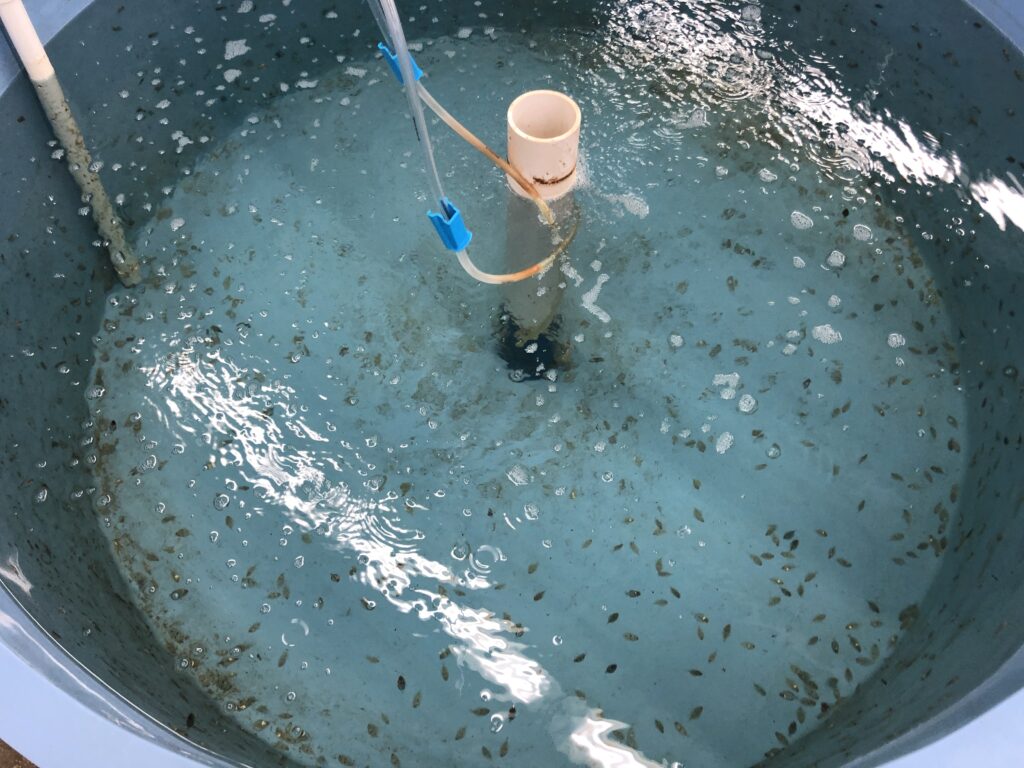
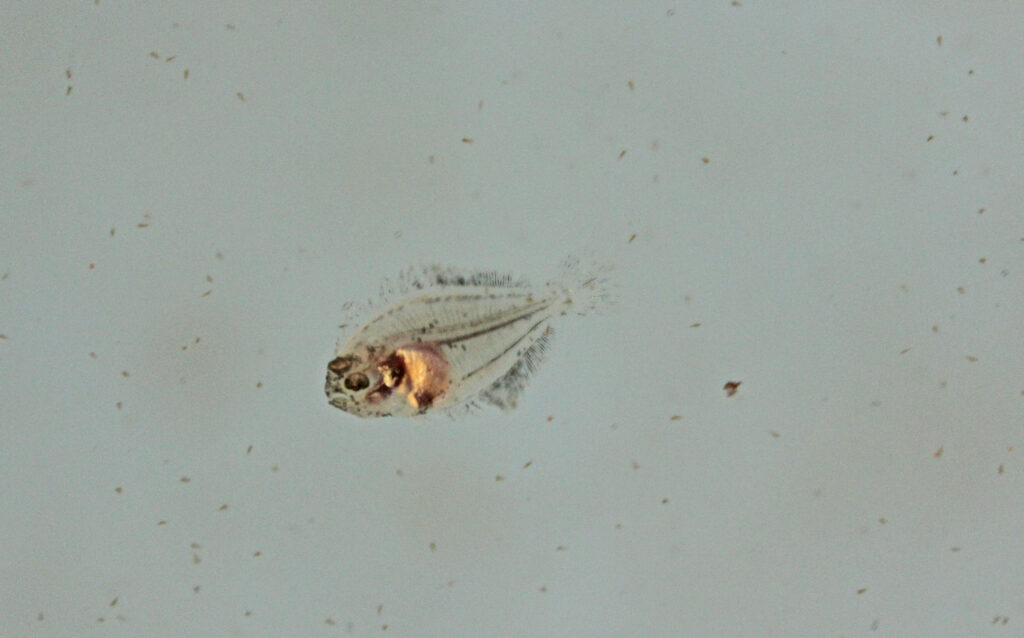
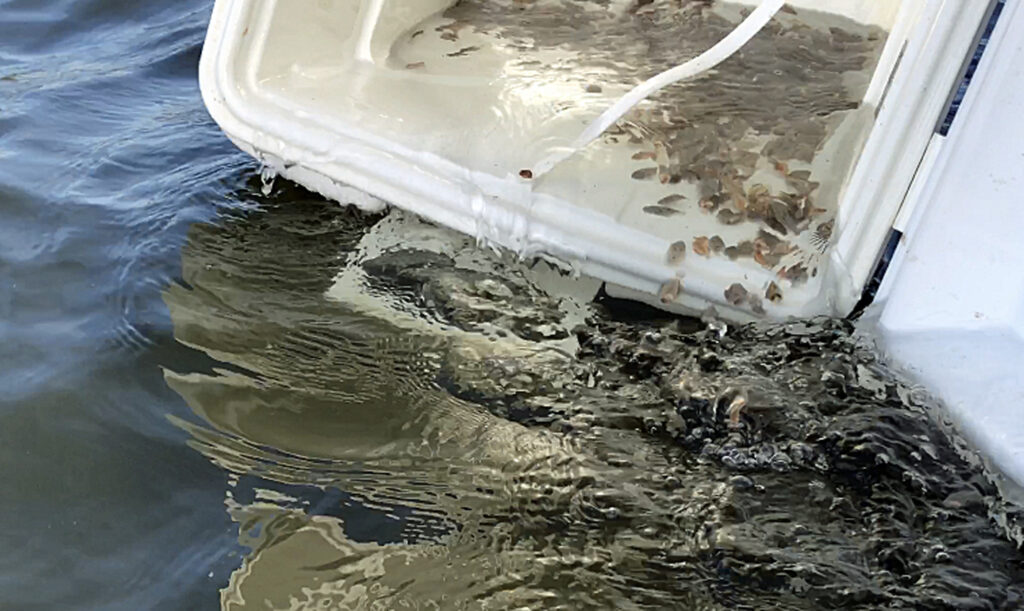
By DAVID RAINER
Alabama Department of Conservation and Natural Resources
With the exception of those essential workers like healthcare, first responders and transportation, to whom we owe a great debt of gratitude, the COVID-19 outbreak has most of the world at a standstill.
Schedules had to be adjusted when Alabama Governor Kay Ivey issued the directives to minimize the spread of the virus.
One of those schedules involved the release of the southern flounder fingerlings that had been spawned at the Alabama Marine Resources Division’s (MRD) Claude Peteet Mariculture Center in Gulf Shores.
The flounder spawn was a first for MRD’s saltwater hatchery, and Max Westendorf, hatchery manager, said the release was executed about a week earlier than originally planned, but this didn’t pose a risk to the fingerlings.
“It really wasn’t detrimental,” Westendorf said. “We just had to throw it into gear and get it done.”
Another change of plans involved where the flounder were released. Hatchery staff had to find the best suitable salinity to maximize the survival of the fingerlings. The staff boated to the west but came back with reports that the salinity was too low.
“Initially, we had planned to release them in the Bon Secour and Oyster Bay areas and around Dauphin Island,” Westendorf said. “But with all the floodwater that had been coming down from the northern part of the state, from basically the mouth of the Intracoastal Waterway at Bon Secour all the way to Fort Morgan, the salinity levels were below two parts per thousand. We were looking for salinity levels of 10-15 parts per thousand.
“We had to go east to the Wolf Bay and Josephine areas. We were able to find water that was from 9 to 11 parts per thousand. “
The salinity in the tanks at the hatchery was reduced to match the conditions in the wild, and the fingerlings were released the following day.
“We released an estimated 12,236 fingerlings,” Westendorf said.
The method the hatchery used to determine the number of fish released is common to aquaculture facilities. The fish are removed from the holding tanks and a total weight is obtained. A random 50 fish are weighed and the total weight of this sample is divided by the number of fish counted to determine an average weight per fish. The total weight of all fish is divided by the average weight to determine the total number of fish released.
Westendorf said the density of fish in the tanks correlated with the size of the fingerlings. The tanks with fewer fish had larger individuals. Some fish in high density tanks could have been moved to a tank of low density to improve overall growth, but the extra handling could have stressed the fish and led to increased mortality.
MRD Chief Marine Biologist Kevin Anson said releasing the fish in the Perdido Bay system was not ideal but the best option under the circumstances.
“Releasing the fish in Mobile Bay would have been more productive than the Perdido system because it is more productive and typically has more juvenile shrimp than the Perdido system,” Anson said. “Small shrimp are entering the estuaries this time of year and serve as their primary food source.”
Anson said he hopes funding for a tagging program is available in the future to determine how many of the hatchery-raised fish enter the adult population (recruitment).
“We have an estimate of how many wild flounder enter the population, but we don’t know if the hatchery-raised fish will have the same survival rate as the wild fish,” he said.
Anson agrees that the early release date likely was not detrimental to the fish. He said the feed and brine shrimp fed to the fish in the hatchery is not as nutritionally beneficial as food sources in the wild.
Westendorf said the MRD team learned significant lessons during the hatchery’s inaugural flounder spawn.
“We had a lot of trouble getting potential broodstock flounder to eat consistently after bringing them into the hatchery,” Westendorf said. “We finally figured out a way to get them to eat consistently a month or two before spawning was scheduled to occur. If the fish were eating all year long, we would have had brood fish in better condition for spawning.
“Most of the mortality occurred right after hatch, which I attributed to poor egg quality. The fingerlings we were able to release came from the brood fish that looked significantly healthier than other spawned fish. They had better gonad development and their eggs looked healthier when placed under a microscope. We now know what we have to do to ensure that the appetite of the adult fish is maintained throughout the year.”
Flounder don’t readily expel eggs in captivity, requiring the hatchery staff to strip-spawn the fish. Westendorf said he and his team learned that multiple strip-spawns from the same fish (male or female) could be counterproductive.
“You have to be extremely delicate with these fish,” he said. “Don’t try to get too many eggs out of them at one time. And we learned it’s best to strip-spawn them one time and return to the holding tank. The egg quality deteriorated each day I tried to collect more eggs out of each fish. We quickly realized the hatching rate depended on the quality of the eggs.
“We worked our tails off and after the first three or four days, we weren’t losing any fish. When they hatch out, they’re living off their yolk sacs. We don’t really have any influence on survival during that stage. The quality of the egg yolk is correlated with the mother’s diet and condition prior to spawning. Although southern flounder rarely move in the tank and get along with each other nicely, even in high densities, they are harder to prepare for spawning and tolerate handling less than other species I have cultured.”
Anson said significant support from Coastal Conservation Association (CCA) Alabama will allow the hatchery to expand capacity for the next flounder spawn and make it significantly easier to minimize the disturbance of the fish. The CCA Alabama funds will be used to refurbish tanks to spread out the broodstock so only a few fish will be handled at a time when spawning is scheduled.
“Hopefully, anglers fishing in tournaments that supported broodstock collection efforts last year will provide us with more flounder broodstock this year,” he said. “If you’ve got a handful of females in one tank and a handful of males in another tank, once you disturb them, they go off feed for a couple of weeks. With us having multiple tanks to choose fish from, we can go to one tank and pick out the fish in best condition to spawn without disturbing the rest of the facility’s population. We need to cherry-pick the very best fish to increase our chances of meeting our stocking goals. We encourage folks to participate in providing us fish for our broodstock program, especially fish that just meet the minimum size as those have a higher chance of being male. Getting those fish from the tournaments (ACFA and Saltwater Finnaddicts) is a big help.”
Westendorf said the hatchery is currently maintaining a skeleton staff to ensure all the broodstock remains healthy. A planned spawn of Florida pompano had to be postponed, but Westendorf hopes to spawn pompano sometime this summer and then speckled trout (spotted seatrout) at the end of the summer.
As far as the hatchery’s first effort to spawn flounder, Anson rates it as a “glowing success.”
“We released about 12,000 fish, which is one-fifth of our ultimate annual goal.” Anson said. “Since this was the first time flounder were spawned at Claude Peteet Mariculture Center, I think we did well in terms of numbers. Max learned a lot about the feeding habits, tolerance to handling and other requirements of the southern flounder to get them to spawn.
“What was learned this year puts Max and his staff in a good position to meet our goal of 60,000 1-inch flounder sooner than we originally thought.”
Marine Resources Director Scott Bannon was also very pleased with the initial spawn of flounder at Claude Peteet.
“They are a difficult species to acclimate and spawn, but our staff has worked very hard to make this happen,” Bannon said. “I am especially proud of how they utilized partnerships with the community. The amount of money and effort that was saved by partnering with fishing tournaments and private anglers to obtain fish for our program as well utilizing the donations of equipment from the CCA Alabama to receive matching federal dollars is huge.”
CCA Alabama Executive Director Blakeley Ellis added: “CCA Alabama is proud and excited to see this effort come to life after years of hard work and planning. Conservation projects like the hatchery will continue to be an area we plan to support, and we couldn’t do that without our members, volunteers and corporate sponsors who help to support us throughout the year.”
Westendorf agrees the flounder spawning and release were indeed successes.
“It was awesome,” Westendorf said. “My goal for the year was to raise one fish. We smashed that goal.”
Alabama Farmers To Host Virtual Field Trips Every Friday Through May 22
How do peanuts grow? When do Alabama farmers grow different fruits and vegetables? What’s the difference between a cow, a bull and a calf?
Alabama farmers will answer all those questions and much more during Virtual Field Trips offered through Facebook Live on the Alabama Farmers Federation Facebook page every Friday at 10 a.m. through May 22.
“Parents and their children are making huge adjustments as their homes become classrooms, and we want to help by offering entertaining and educational field trips from some of our farmers,” said Jeff Helms, Alabama Farmers Federation Communications Department Director. “While these videos will target third- through fifth-graders, people of all ages will learn more about how farmers grow food, fiber and timber.”
Viewers are encouraged to ask questions through the comment section, and each video will include links to educational activities centered around the featured commodity.
Currently scheduled topics, subject to change, are:
● April 3 – Peanuts and other row crops
● April 10 – Fruits and vegetables
● April 17 – Beef cattle
● April 24 – Honeybees
● May 1 – Catfish
● May 8 – Greenhouse and nursery products
● May 15 – Forestry
● May 22 – Cotton and other row crops
To receive Facebook notifications about the Virtual Field Trips, respond as “Interested” in the event or follow the Alabama Farmers Federation page.
The Federation is Alabama’s largest farm organization with more than 340,000 member families. Find additional educational materials, including Ag Mags and free printable coloring book pages, online at alfafarmers.org/schools and click on resources.
This Virtual Field Trips project was developed in conjunction with Girl Scouts of Southern Alabama (GSSA). For additional virtual programs from GSSA, visit GirlScoutsSA.org.
See more on AlfaFarmers.org
Time for a Garden Clean-Up
By Katie Nichols
Feeling down about the coronavirus quarantine? Shake away the blues with a spring garden clean-up.
While Alabama Extension does not encourage leaving home on a gardening supply trip, there are several gardening things that can be done without leaving the yard. Mallory Kelley, a home grounds, gardens and home pests regional agent, has some gardening ideas that will allow people to make great use of their time at home.
Clean Out Supplies
“Now is a great time to take inventory of your garden supplies and clean out old, unused items from the garage,” Kelley said. “Throw out unused gardening items and start with a clean slate.”
Throw out old seed packets.
Chemicals should be used according to the label. If discarding a chemical, call the Alabama Department of Agriculture and Industries to see when and where their next chemical collection time is scheduled.
Sharpen and clean all garden tools.
Oil and gas up motorized tools.
Use the fertilizer that has been sitting on the shelf, and give plants an extra boost.
If there are some extra bags of potting soil or seed starting mix lying around, get out and plant some of those seeds.
Kelley said when going though supplies, clean planting containers.
“Containers for planting need to be sterilized before replanting. It’s best to wash them with a 1:10 bleach to water solution,” Kelley said. “After cleaning, fill them with potting soil. Never use soil from the ground, as it has poor drainage and potential weed seed and diseases.”
Clean and Compost
This time of year is also a good time to rake the pine straw and leaves from under plants. Kelley said this eliminates fungal diseases that may have overwintered in the leaf matter during the winter. Once cleared, apply a fresh layer of pine straw approximately 3 inches deep.
Use this old mulch and leaf matter to start a new compost bin. Also, prune some plants, like the Limelight Hydrangeas that bloom in mid-summer, and throw those branches and other weeds pulled during clean up into the bin.
People can also lessen their trash load by throwing things like eggshells, coffee filters, coffee grinds and all vegetable and fruit matter into the compost bin.
“As long as you leave out dairy products, oils and bones—throw it all in the bin,” Kelley said. “Start turning thee compost daily, and add water to keep the pile moist. Soon you will have made garden gold.”
Get Rid of Pesky Weeds
Kelley said the first step to getting rid of weeds is identifying them.
“If it is a vegetable bed and you want to prep for spring planting, you will want to spray the whole area now with glyphosate,” Kelley said. “Give it at least two weeks for the weeds to completely die before you till the soil to make new rows.”
Right before planting, spray the garden soil with a pre emergent such as trifluralin. This particular one is safe to use in flower beds, as well as a vegetable garden. Kelley said this will give a huge jump start in the battle to combat the weeds this summer.
“Remember, this is a pre emergent and will not kill weeds you can see,” she said. “However, it will prevent the seeds of weeds you cannot see from germinating.”
Growers who intend to plant vegetables, such as corn, okra, mustard greens and squash, by seed should be careful not to spray the soil in that area with a pre emergent. An application of it will prevent those seeds from germinating as well as they would without the application.
Also, to suppress weed growth, Kelley said people should add mulch. Even the weeds that might still emerge will be much easier to remove.
Get Moving and Pruning
Kelley said the winter months are the best time to plant and move plants in the landscape. However, if people can continue to water thoroughly, it is not too late to dig up and transplant those plants that have either outgrown their space or have not performed well.
“Don’t be afraid to move plants around in the landscape until you find just the right environment for them to thrive,” she said. “The conditions on one side of your house are totally different than the conditions on the other. The brightest light will be on the southwest corner of your house with afternoon sun. The most shade will be on the northeast side of the house.”
Kelley said the best guideline for pruning is to follow the May rule.
“If a plant blooms before May 1, prune it as soon as its flowers are spent,” she said. “For plants that bloom after May 1, prune when the plant is dormant.”
If a shrub or tree flowers in summer or fall, this means it blooms on new wood. New wood is the growth that occurs throughout the spring months. Summer flowers produced after May 1 are on new wood growth. Pruning now would stimulate new growth and greater flower production this summer.
More Information
For more information on spring gardening, visit www.aces.edu or contact your county Extension office.
State Park Rangers on Duty in Times of Calm and Peril
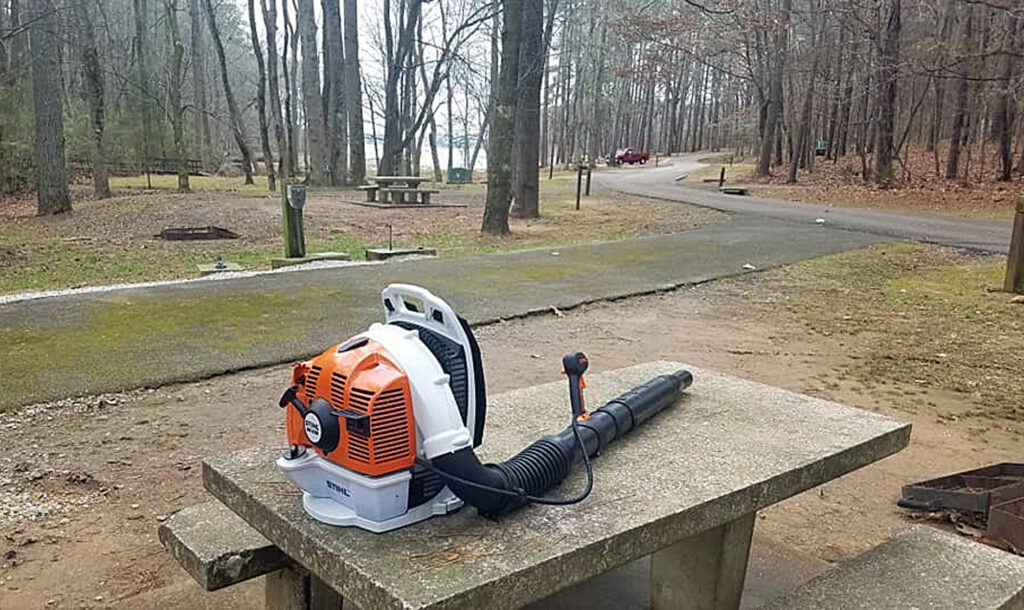
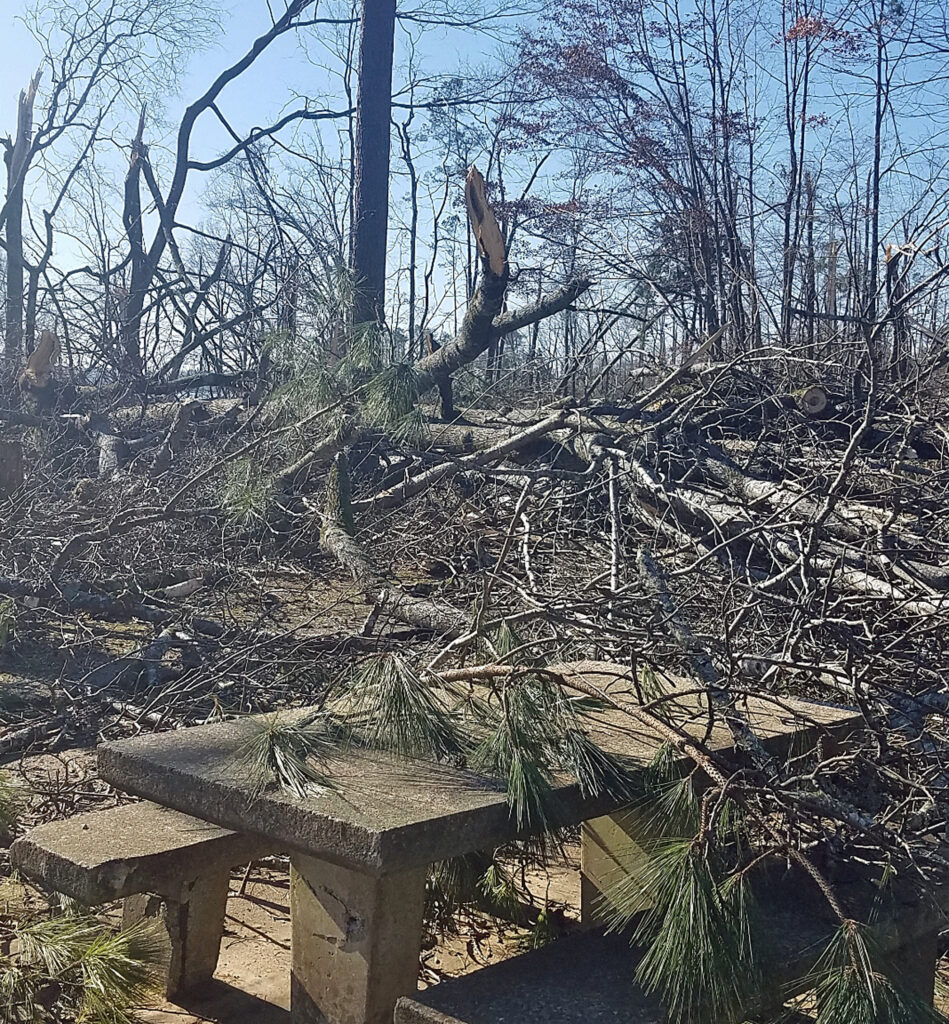

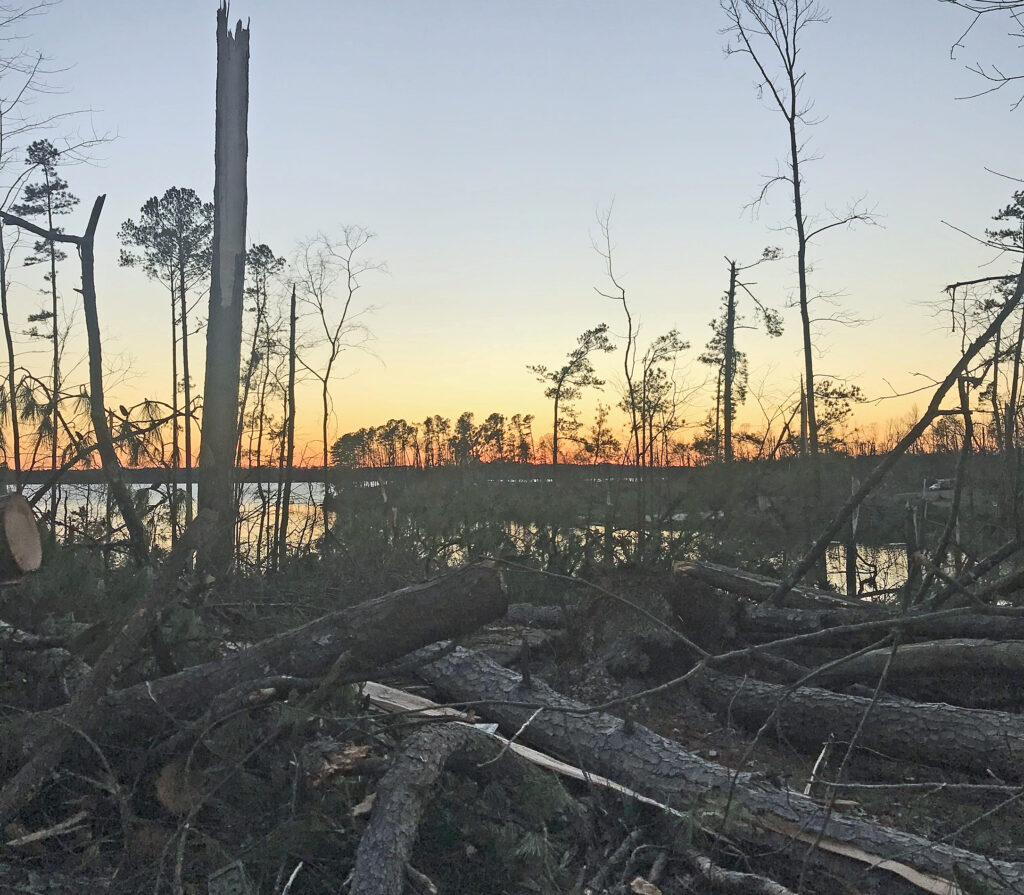
By David Rainer, Alabama Department of Conservation and Natural Resources
Thankfully, with a few exceptions, Alabama State Parks remain open during the COVID-19 restrictions.
And as diligent as always, our park rangers are on duty to deal with any situation that might arise with everything from a welcoming wave and helpful hand to rescuing park visitors in peril.
That peril was particularly apparent last December when a line of storms started moving through north Alabama.
Joe Wheeler State Park Ranger Ryan Robertson was on patrol on December 16, 2019, while Ranger David Barr had the day off, or so he thought.
“That afternoon, we had some pretty volatile weather,” Barr said. “Ryan was running duty, and I stopped him at the boat ramp and told him I would be home if it got bad.”
It got bad at the 2,550-acre park on the Tennessee River near Rogersville. When a tornado warning was issued a little after 5 p.m., Barr donned his uniform and headed into the park to help Robertson warn the patrons and park volunteers of the impending storm.
Fortunately, with the Christmas season in full swing, the park was not full of campers or visitors.
“Ryan already had people evacuated from the campground,” Barr said. “We only had seven campers and four of those were volunteers. If we have a lot of people, we put some in the bathhouses and some at the campground store. Ryan took some of them to the lodge. He stayed with them.
“I was at the campground store with two ladies and two kids and a Pyrenees dog. I usually get out and ramble during something like this, but something told me not to do that. I stayed at the store. My son was with me, and he was watching the storm on the weather radar.”
Barr’s son told him the storm was about to hit, and Barr sent the visitors into one bathroom while he and his son got in the other.
The power went out, and a few minutes later it became apparent that they were in the tornado’s path.
“The store has metal doors on each side,” Barr said. “Those doors started flapping. I didn’t stick my head out to see, but it sounded like those doors were opening all the way and closing. The wind was howling and whistling. That lasted for three or four minutes and then it was quiet.”
While all campers, volunteers and park personnel escaped injury during the storm, the campground did not fare as well.
“When I was sure it had blown over, I thought we had escaped the worst of it until I went outside and got in my truck,” Barr said. When the lights came on, I could see big pine trees down. I tried to go up the hill to my house, but the road was blocked by trees.”
Barr walked the rest of the way to his house, which was unscathed, although numerous trees were down in the yard. Back in the campground, Barr discovered that the A section did not have much damage.
“But the B section was total destruction,” he said. “The bathhouse was destroyed. The meeting pavilion was caved in by trees falling on it.”
By that time, Barr was joined by Robertson and Park District Supervisor Chad Davis as well as part-time employee Morris Barnes, who has since become a full-time ranger at Monte Sano State Park.
Barnes hopped onto a backhoe and all hands started clearing downed trees out of the roadways until they realized live power lines were down in the park and decided to wait until daylight to resume their work.
The next morning, Barr discovered he had a view of the Tennessee River that he never expected or wanted.
“I’ve been a ranger and campground supervisor here for over 30 years,” he said. “This is my home. To see my life’s work blown away was devastating.
“We got strike teams in from other parks, cut our way through the different sections to assess the damage. I can’t really describe it. A section survived. Three-quarters of B section was gone. C section was completely wiped out.”
Barr, who was recently promoted to assistant superintendent at Wheeler, said out of 116 camping sites only 60 remained usable. Two bathhouses were destroyed. One large pavilion and two smaller pavilions were destroyed. Beautiful, tall pine trees were strewn throughout the campground.
“From my house, you can see forever,” he said. “You can see the river from my backyard, which you used to could never see. I can see all the way across the river. I miss the trees.”
Barr is just thankful that the pre-Christmas period is a slow time at Wheeler.
“I know of one camper who left early because of the weather,” he said. “I’m glad he did because that site he was staying at was completely leveled. If there had been many people in the campground, there would have been multiple fatalities.”
Barnes, who lives only 2½ miles from Wheeler, not only had heavy equipment experience, he also served with the Rogersville Police Department at that time.
Barnes ended up in an even more harrowing situation a few days after helping with the aftermath of the tornado.
Heavy downpours had caused creeks in north Alabama to swell rapidly. Barnes, who is trained in swift-water and high-angle rescue, had finished his shift with the Rogersville PD at 5 p.m. when a call came in about a car swept into a creek. That incident resulted in a fatality.
Then a second call came in about another car in the same creek not far away from the first incident.
“That girl’s mother went looking for her and drove off in the same creek, not knowing she was there,” Barnes said. “The first car was completely submerged. The second one, the front was stuck in the ground and the rear end was hung in a tree. The woman had managed to crawl out through the back glass.”
After being unable to rescue the woman, area enforcement officers called for the swift-water rescue team of which Barnes was a member.
Barnes got the Florence Fire Department to aid in the rescue with a rubber boat and a heavy fire truck that could be used as an anchor point in the swift water.
Barnes and another first responder got into the rubber boat and it was slowly released into the creek by rope.
“Once we got the boat over to the car, I knew her,” Barnes said of the trapped woman. “Everybody told me she was going to fight me, but when we made eye contact, I called her out by name. She called out my name, and then I told what I wanted her to do and not fight me. I got over close enough to put a life jacket on her and latched onto her. I didn’t try to drag her into the boat, but we dragged her to the opposite bank and released her to those personnel.”
Unfortunately, Barnes discovered the daughter’s car about 40 yards down the creek completely submerged with no hope of rescue.
After the incident, the Rogersville City Council and Mayor presented Barnes with a life-saving award that he was hesitant to accept.
“I’m not a hero,” Barnes said. “I had a job to do. To me, the hero was the woman. She hung in there for almost three hours until we could get to her.”
Barnes said it was a perfect example for the mantra of “Turn around, don’t drown.”
“It rained so hard and fast that the county didn’t have enough time to get up the barricades,” he said. “Lauderdale County is 71 miles wide. It just happened so fast.”
Sometimes, the problems park rangers encounter are not weather related.
For example, Lake Lurleen State Park Ranger Mark Caton, who has been a first responder in one capacity or another for more than 20 years, was checking people coming into the park when one vehicle left the road and went through the grass.
“We deal with all kinds of people,” Caton said. “It’s like having a concert in your jurisdiction every day.”
The driver of the errant vehicle exited and then jumped into the lake.
“Obviously, that’s not normal behavior,” Caton said. “He yelled, ‘Don’t try to get me out.’ But I grabbed my rescue boat and headed out. I didn’t get too close and tried to get him to talking. Usually, if you can get people talking, the less they think about what they want to do.”
Caton found out the swimmer had been in and out of psychiatric care and had been self-medicating instead of taking his prescription medicines. Caton also found out he and his girlfriend had had a fight and she kicked him out.
“He felt like he didn’t have anywhere else to go and was just going to swim until he got tired and drowned,” Caton said. “I tried to build a rapport with him and tell him that drowning was not the way to go. Finally, he was getting thirsty and tired. I tossed him a cushion float and he took it. That was the first step to get him back to the side of the lake. Then I told him we had some Gatorade on the other side of the lake.
“Believe it or not, the Gatorade worked. For somebody who wasn’t thinking clearly, he zoned in on Gatorade. He was close to drowning a couple of times. He swam back in and got his Gatorade, like we promised, and then we got him to a hospital.”
USDA Forest Service Temporarily Suspends Public Access to Recreation Sites throughout Alabama’s National Forests
Public access to developed campgrounds, day use areas, and dispersed recreation area restrooms throughout Alabama’s Bankhead, Conecuh, Talladega and Tuskegee National Forest is temporarily suspended indefinitely for the health and safety of visitors and staff. Effective immediately, the following recreation sites are temporarily unavailable: Bankhead National Forest, Houston Day Use Area, Brushy Lake Campground, Sipsey Trailhead (restroom only), Natural Bridge Day Use Area, Pine Torch Horse Trailhead (restroom only), Flint Creek Multiple Use Trailhead, Brushy Lake Day Use, McDougal Hunt Camp (restroom only), Hurricane Creek Shooting Range, Owl Creek (restroom only), Conecuh National Forest, Open Pond Recreation Area, Campground &, Day Use Area, Blue Lake Recreation Area, Conecuh Shooting Range, Tuskegee National Forest, Uchee Shooting Range, Talladega National Forest, Oakmulgee Ranger District, Payne Lake Day Use Area (swimming area only), , Shoal Creek Ranger District, Coleman Lake Recreation Area, Warden Station Horse Camp, Pine Glen Campground, Henry Creek Shooting Range, Talladega Ranger District, Lake Chinnabee Day Use Area, Turnip Seed Campground, Shepherd Branch Shooting Range, Kentuck OHV Trailhead. As we work through an unpredictable and rapidly changing situation, health and safety is our number one priority. We are committed to continuing to support our communities and fulfill our mission as we all work together to minimize the impacts and spread of COVID-19.
These actions have been taken based on the Centers for Disease Control and Prevention (CDC) guidelines and to promote social distancing. Visitors are encouraged to contact the ranger district offices with additional questions, email [email protected] or visit the forest website at www.fs.usda.gov/alabama.
The National Forests in Alabama continue to monitor the COVID-19 situation and evaluate potential impacts and adjustments to reservations and our reservation policies through Recreation.gov. Reservation holders will be notified via email and/or cell phone text messages if there are any changes affecting their reservation. In the event of delayed openings of some, part, or all of the National Forests in Alabama recreation facilities to ensure safe social distancing, you will receive a full refund for your reservation. Please remember to review current recommendations from the CDC and focus on recreating safely while protecting yourself, Forest Service employees and our volunteers.
Public-Private Partnership Conserves Red Hills Salamander Habitat in South Alabama

The U.S. Fish and Wildlife Service (USFWS) recently awarded the Wildlife and Freshwater Fisheries Division (WFF) of the Alabama Department of Conservation and Natural Resources (ADCNR) nearly $9 million in land conservation grants authorized by Section 6 of the Endangered Species Act to apply toward the purchase of two land tracts totaling 4,911 acres of critical Red Hills salamander (RHS) habitat in Monroe County, Alabama. The Forever Wild Land Trust will provide the remainder of the funding for the acquisitions.
The land acquisitions – known as the Red Hills Brown-Schutt Trust tract and the Red Hills Flat Creek Phase III tract – are part of a long-term conservation goal of delisting the RHS, which has been federally listed as a threatened species since 1977.
The tracts are located near the community of Franklin in Monroe County, Alabama, and join the 6,120-acre Forever Wild Red Hills Complex in the effort to increase the amount of protected RHS habitat. In addition to habitat conservation, these tracts will eventually be accessible to the public for outdoor recreation including hunting, wildlife watching, and birding.
Partners in the acquisitions include the USFWS, ADCNR, the Forever Wild Land Trust, The Nature Conservancy in Alabama, Conservation Resources, and the Brown-Schutt Trust.
“This is a great acquisition, and not just for Alabama,” said Leopoldo Miranda, USFWS Southeast Regional Director. “The state’s commitment to conservation means that everyone – the residents of Alabama, as well as the visitors from elsewhere, people who hunt and fish or just like to get outside – have a chance to experience nature at its finest. And, last but not least, so do the animals that benefit from these purchases.”
Christopher M. Blankenship, ADCNR Commissioner, echoes Director Miranda’s statement.
“I am so excited for the partnerships that have led to these very important land acquisitions,” Commissioner Blankenship said. “These projects continue the work that we and our partners began several years ago to acquire enough land to conserve habitat for the long-term success of the Red Hills salamander. When state and federal governments, conservation groups, and industry work this well together, there is no limit to what can be accomplished.”
The Nature Conservancy in Alabama has worked with landowners, ADCNR, and other partners in the Red Hills region for more than 10 years to conserve RHS habitat.
“We have partnered for many years with the Alabama Department of Conservation and Natural Resources, Forever Wild, and the U.S. Fish and Wildlife Service to protect the endangered Red Hills salamander in Monroe County,” said Keith Tassin, Interim Director of The Nature Conservancy in Alabama. “We are very excited to see these efforts really moving the needle for the conservation of this species, and we look forward to our continued efforts to restore and protect this unique habitat.”
Conservation Resources, an investment organization that offers investment opportunities in land with significant conservation and natural resource value, helped facilitate the Flat Creek Phase III acquisition.
Managing Director of Conservation Resources Kent Gilges said his organization is proud to be involved in the effort to protect habitat for endangered species and help create new areas for hunting, fishing, and outdoor recreation.
“When private companies, public agencies, and conservation organizations work together, we can conserve enough area to assure the future of Alabama’s rich natural heritage,” Gilges said.
Projects like these acquisitions help create a better understanding of the natural world and have the potential to benefit not only the plants and animals they protect but also the communities located near public lands.
Al Stokes is a Regional Director for Senator Doug Jones’ office. He is based in Mobile, Alabama, but grew up in the community of Franklin near the Brown-Schutt and Flat Creek tracts.
“These acquisitions are very significant to the vitality and growth of conservation in the state, particularly in communities that many are unfamiliar with such as the Red Hills region of Alabama,” Stokes said. “Now, through these conservation efforts, the world can learn more about the Red Hills and the Franklin community.”
In addition to conserving RHS habitat, many other rare animals are potentially present or have the potential for reintroduction on the Brown-Schutt Trust and Flat Creek tracts. These species include the Bachman’s sparrow, worm-eating warbler, endangered red-cockaded woodpecker, gopher tortoise, southern hognose snake, coral snake, eastern fox squirrel, as well as many aquatic species that may be present in headwater streams located on or near the newly protected land.
About the Red Hills Salamander
One of the largest lungless salamanders in the world, the RHS can grow up to 10 inches long. Its translucent purple skin helps make the RHS a strikingly beautiful animal, but you’re unlikely to catch a glimpse of this creature. It spends most of its time hunkered down in a subterranean burrow, only venturing out at night to ambush small prey like crickets, spiders, and earthworms.
The known range of the RHS consists of a small strip of land in the Red Hills region of Alabama. It is found nowhere else in the world. This geographic isolation allowed the animal to evolve independently from other salamander species millions of years ago, making it the only member of its genus. Due in part to its very limited range, low reproductive rates and specific habitat requirements, the RHS is federally listed as a threatened species.
Since 2000, the RHS has been recognized as Alabama’s official state amphibian thanks to a group of Fairhope Elementary School third graders who campaigned for the designation.
The RHS inhabits the forested slopes and valleys below the steep bluff of the Red Hills, which stretch across Conecuh, Covington, Crenshaw, Butler, Monroe, and Wilcox counties. The region’s steep slopes are covered in mixed hardwood and provide the shade, cover, and moisture needed for the salamander to survive. Habitat fragmentation is considered one of the primary challenges to the survival of the RHS.
For more information about the RHS, visit www.outdooralabama.com/salamanders/red-hills-salamander.
Learn more about the Forever Wild Red Hills Complex at www.alabamaforeverwild.com/red-hills-complex.
The Alabama Department of Conservation and Natural Resources (ADCNR) promotes wise stewardship, management and enjoyment of Alabama’s natural resources through four divisions: Marine Resources, State Parks, State Lands, and Wildlife and Freshwater Fisheries. To learn more about ADCNR, visit www.outdooralabama.com.
Alabama’s Outdoors Provides Solutions for Social Distancing
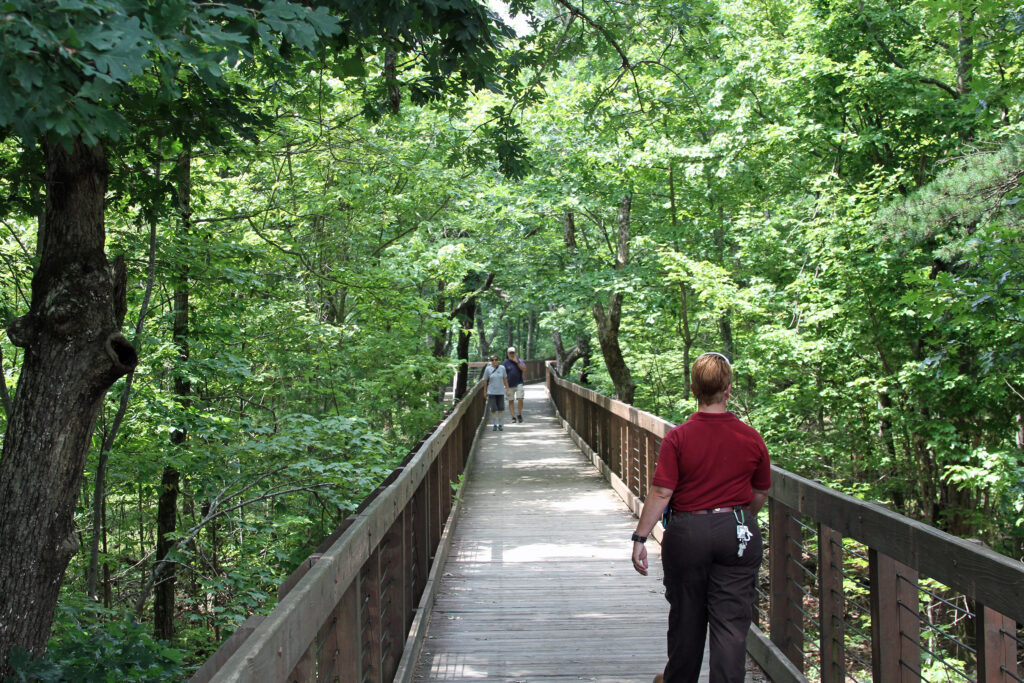
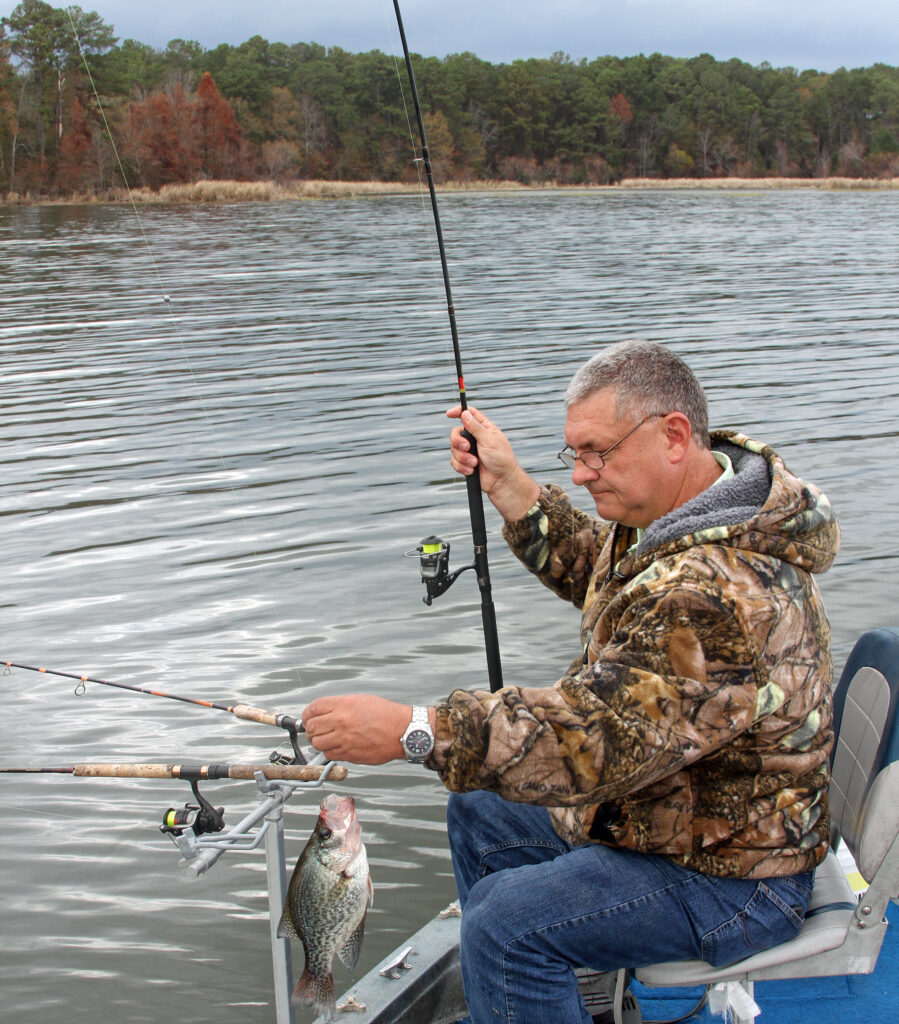

By DAVID RAINER
Alabama Department of Conservation and Natural Resources
While Governor Kay Ivey and Dr. Scott Harris, Chair of the Governor’s COVID-19 Task Force, work hard alongside other state, national, and private enterprise leaders to mitigate the effects of the novel coronavirus and bring its spread to a conclusion, it is important that people maintain the social distancing and other health recommendation standards.
“We take these precautions and recommendations very seriously at the Department of Conservation and Natural Resources,” said Conservation Commissioner Chris Blankenship. “We know many Alabamians want to get outdoors during the spring and enjoy some recreational opportunities that can refresh in these challenging times; just remember, we must do so safely.”
Not only does our state have some of the best fishing opportunities in the nation, both freshwater and saltwater, but the spring turkey season is also about to open in most of the state.
If hunting or fishing is not a preference, consider the beautiful natural hiking trails and camping facilities available at Alabama State Parks close to where you live, not to mention the natural beauty on the Forever Wild tracts available to the public. Visit www.alapark.com and www.alabamaforeverwild.com for the many options available.
“I know with the children out of school and many parents home as well, people will want to do things together as a family,” Blankenship continued. “Many will want to take the youngsters who are out of school to explore our state’s great natural wonders, but please do so responsibly.”
Alabama Wildlife and Freshwater Fisheries (WFF) Director Chuck Sykes said this is a perfect opportunity for those who love the outdoors to adhere to the “social distancing” guidelines.
“I fully expect Alabama hunters and fishermen to take advantage of the social distancing prescriptions by all the coronavirus experts, and I expect many of them will get outdoors, either on the water or in the woods,” Sykes said. “Turkey season in most of the state comes in Saturday (March 21). Fishing is phenomenal from what I understand.”
Sykes said WFF’s operations will be minimally impacted by the measures instituted to limit the spread of the COVID-19 virus.
“It’s going to be business as usual for us except in our offices,” he said. “I don’t want people to think that the game wardens are going to be sitting at home, not doing anything. Our staff basically has been practicing social distancing for years. They work by themselves for the large part. They work outside. The only thing the public will see different from Wildlife and Freshwater Fisheries is our district offices and the Montgomery offices will be closed to public walk-in traffic. But we will still have a skeleton staff to take phone calls and answer Game Check questions, which will be forwarded to officers and biologists in the field. Other than some headquarters and district office staff continuing their work from home, it’s going to be business as usual providing services to the public.”
Sykes took his own advice last weekend for the turkey season’s special youth weekend and headed to the woods. As with most hunting experiences, some folks had good luck while others did not.
“The results were site-specific, as they are most seasons,” he said. “Some youth did well; some didn’t. I went this weekend with a friend and his son, and we heard a couple of turkeys gobble once or twice apiece, and that was it. I talked to some people whose turkeys gobbled good, and they had a productive hunt and killed turkeys. That’s just the way it is. I was glad it wasn’t raining, and it wasn’t 25 degrees, like it had been for the past couple of years.”
This year’s regular turkey season is opening on the third Saturday of March in most areas. This opener is the latest possible opening date, and Sykes said that was done for a specific reason.
“The date was moved to give the birds more time for breeding activity before the season opens,” he said. “A lot of the latest research is showing that we may be harvesting too many gobblers too early in the breeding process.”
Studies have shown moving the season opener toward peak nest initiation dates allows more dominant gobblers to breed before being shot, which is even more important in already-declining populations. Peak nest initiation in Alabama averages around the second week in April.
“Postponing the opening date to the third Saturday at least gives the gobblers another few days in the woods without there being a lot of pressure,” Sykes said.
With the mild winter and early spring, the breeding cycle may be a bit earlier, especially the gobblers’ role of strutting and gobbling. But, the amount of daylight and receptive hens ultimately dictate when breeding takes place.
“I think they’re well on their way,” he said. “I think moving the season later was a positive move. I think it’s good that we haven’t had any cold weather in a few weeks to give the turkeys a chance to do their thing before we get after them real hard.
“As far as tactics for opening weekend, again, it depends on where you are. The turkey we were fooling with on youth weekend had a sack full of hens with him. He didn’t care what I did. I called up two hens that popped up out of the bottom. They gave a peek, turned around and went back. Another hen did that a few minutes later. They were staying with him. They were doing what turkeys do. We were just not in the right place to get in their way.
“Now if you can find a lonely 2-year-old, you can beat two rocks together, and he’ll come running.”
Sykes said turkey hunters who participate in the Avid Turkey Hunter Survey program or who read the annual Full Fans and Sharp Spurs report at www.outdooralabama.com/turkey-hunting-alabama/turkey-research will understand the Division’s assessment of the turkey population in the state.
“In that survey and publication, you’ll see two categories of recruitment,” he said. “One is looking at poults (young of the year) per hens and the other is hens with poults. Those are two different topics. Studies are showing that perhaps the reason we’re seeing the number of hens with no poults is not because of predation but due to the fact that those hens did not get bred because the dominant gobblers were taken out of the population too soon.
“If hunters are interested in participating in the Avid Turkey Hunter Survey and assisting our wildlife biologists in the collection of this data, they should click the link on the www.outdooralabama.com website for more information. We certainly appreciate all those who have contributed thus far and hope to see more sign up for this opportunity to assist in the management of this great bird.”
For those who have hunted turkeys for a long time in Alabama, the late start shouldn’t be a burden, according to Sykes.
“When I was a kid, the turkey season always started on March 20th,” he said. “It was moved to the 15th for not necessarily biological reasons, so this should not be that big of a shock to hunters who grew up in Alabama. It shouldn’t be that big a deal.”
Sykes said about the only thing this virus might affect for turkey hunting is hunters’ ability to gather at the country store to exchange lies.
“Everybody is so social-media-oriented now, I think we’ll still be able to keep up with what’s going on,” he said.
As with hunting success, Sykes said it depends on the source when it comes to the discussion of the status of turkey populations in the South.
“Some people I know think the turkey decline is 100% real, and I know others who swear numbers are at ‘historic highs’,” he said. “Personally, I think they’re down.”
Sykes said he hunted turkeys as much as possible last year and bagged two birds in Alabama.
“That was a gracious plenty,” he said. “Now I called up a bunch of birds for others, so that did not impede my ability to go hunting, have a good time and have fun, and enjoy being outdoors.”
Sykes said he wants people to do the same thing, but they need to understand that the WFF staff is going to be right there with them.
“Our staff didn’t get two weeks of vacation,” he said. “They’re still going to be working. We want people to have their licenses because they’re going to encounter our staff.
“Our WMAs (wildlife management areas) are open. Our public shooting ranges are open. Our public lakes are open. Get out there and have fun. Take advantage of this time to be outside, but please abide by the recommendations to slow the spread of the virus.”
Alabama State Parks Naturalists to Provide Virtual Programming
For all those nature lovers who are unable to visit one of the beautiful Alabama State Parks due to the COVID-19 precautionary measures, the State Park Naturalists will bring the parks to you via modern technology.
During the effort to prevent the spread of the virus, the Alabama State Parks Naturalists want to help alleviate stress and anxiety and add some fun to those that may not be able to visit one of our 21 Alabama State Parks.
State Parks Naturalists will host Virtual Naturalist programming via our Facebook pages at five parks – Oak Mountain, Lake Guntersville, Gulf, DeSoto and Cheaha.
These virtual programs will be an assortment of Live Facebook videos, short videos, photos, park stories, pictures, and maybe a challenge or two. Go to the Facebook pages for the five individual parks and look for the State Parks Naturalists’ content.
The State Parks Naturalists have also created a survey link to determine what type of content best suits the viewers. Go to https://alabamadnr.az1.qualtrics.com/jfe/form/SV_9BRdZYm3kzGvBzf to participate in the survey.
Of course, if you have one of Alabama’s wonderful State Parks nearby, we encourage visitors to take part in the many self-guided activities that provide social distancing, including camping, fishing, hiking, birding, biking and more.
Please visit www.alapark.com for more information on the opportunities to explore our natural wonders as well as the precautions taken by Alabama State Parks to minimize the exposure for park visitors.
The Alabama Department of Conservation and Natural Resources promotes wise stewardship, management and enjoyment of Alabama’s natural resources through four divisions: Marine Resources, State Lands, State Parks, and Wildlife and Freshwater Fisheries. To learn more about ADCNR, visit www.outdooralabama.com.
Hunters Encouraged to Participate in Avid Turkey Hunter Survey

Do you spend 10 or more days each spring turkey hunting in Alabama? If so, your observations in the field can provide valuable information toward the conservation and management of eastern wild turkey.
The Alabama Wildlife and Freshwater Fisheries Division (WFF) is asking turkey hunters who hunt for at least 10 days during turkey season to participate in the Avid Turkey Hunter Survey. Participants will receive a copy of the state’s annual turkey report, Full Fans & Sharp Spurs, and will be automatically entered to win a new shotgun donated by the Alabama Chapter of the National Wild Turkey Federation (NWTF). To be eligible for the NWTF shotgun drawing, survey participants must provide their season hunting information by May 10, 2020.
“This survey offers hunters a unique opportunity to contribute directly to the conservation and management of wild turkeys in Alabama,” said Steven Mitchell, leader of the WFF Alabama Turkey Project. “The more hunters who participate, the better. The more days spent hunting, the more useful the information will be.”
Participation in the Avid Turkey Hunter Survey provides WFF biologists with valuable information on statewide and regional trends in gobbling activity, hunter effort, harvest rates, age structure and sex ratios. This knowledge ultimately helps WFF make management decisions that link the interests of sportsmen with the wise use of the state’s turkey resource.
To participate in the Avid Turkey Hunter Survey, contact WFF at (334) 242-3469. WFF staff will provide hunters with information about how to complete the survey. Hunters may also contact Steven Mitchell by email at [email protected] for more information about the survey.
Hunters who participated in last year’s survey and do not receive instructions for the 2020 spring season should contact WFF via the phone number or email listed above. For information about Alabama’s spring turkey hunting season, visit www.outdooralabama.com/wild-turkey.
Hunters are also reminded that all turkey harvests must be reported through Alabama’s Game Check system. The data collected through Game Check is used by WFF biologists to better understand harvest trends and set seasons and bag limits.
Turkey harvests can be reported online at www.outdooralabama.com or through the Outdoor AL mobile app. The mobile app is available from the Apple and Android app stores or www.outdooralabama.com/contact-us/mobile-apps.
The Alabama Department of Conservation and Natural Resources (ADCNR) promotes wise stewardship, management and enjoyment of Alabama’s natural resources through four divisions: Marine Resources, State Parks, State Lands, and Wildlife and Freshwater Fisheries. To learn more about ADCNR, visit www.outdooralabama.com.
Conservation Department Updates Operations During COVID-19 Pandemic In response to the COVID-19 pandemic, the Alabama Department of Conservation and Natural Resources (ADCNR) is making the following temporary changes to its business operations for the safety of our employees and the general public. The changes are in effect until April 6, 2020.
Alabama State Parks and associated facilities remain open with the exception of cave tours at Rickwood and Cathedral Caverns state parks. Some dining operations will be modified to limit close contact of guests. Park visitors are encouraged to follow all current hand washing and social distancing guidelines. For updates, please follow Alabama State Parks on social media. A social media directory is available at www.alapark.com/social-media-directory.
State Public Fishing Lakes remain open.
ADCNR shooting and archery ranges remain open.
ADCNR Wildlife Management Areas and Special Opportunity Areas remain open.
ADCNR’s state and district offices are closed to the public with the exception of the Marine Resources Division offices in Gulf Shores and Dauphin Island. Those offices will be open for commercial license sales only on Monday through Friday, from 8 a.m. to 4 p.m.
ADCNR Law Enforcement Offices are closed to the public, but remain staffed to answer questions by phone. Contact information is available at www.outdooralabama.com. To report hunting or fishing violations, please call (800) 272-GAME.
Conservation Enforcement Officers will continue to patrol state land and waterways and render aid to the public.
Forever Wild tracts remain open for hiking, horseback riding, mountain biking, paddling, and hunting — as permitted.
5 Rivers Delta Resources Center facilities are closed, but the grounds remain open to the public during regular business hours for trail use and kayak launching.
Hunting and fishing licenses are still available online at www.outdooralabama.com, through the Outdoor AL mobile app, or at various license agents located throughout the state.
Due to the evolving nature of the pandemic, ADCNR recommends calling individual state parks and other facilities if you have questions about reservations or operational hours. Contact information can be found at www.outdooralabama.com.
ADCNR apologizes for any inconvenience during this time and we thank you for your cooperation.
The Alabama Department of Conservation and Natural Resources promotes wise stewardship, management and enjoyment of Alabama’s natural resources through four divisions: Marine Resources, State Lands, State Parks, and Wildlife and Freshwater Fisheries. To learn more about ADCNR, visit www.outdooralabama.com
Stay at Home Beekeeping Series
The Alabama Cooperative Extension proposes that members of beekeeping clubs attend ’remote’ meetings from the comfort of their own home using a computer or mobile device. Each free event will allow participants to learn about timely beekeeping information and to contribute to discussions.Sessions include: March 19: Minimizing Swarming with Phillip Carter; April 2: Ten Mistakes Beginners Make with Lonnie Funderburg; April 7: Coping with Pesticide Sprays with Jack Rowe. Register at http://www.aces.edu/go/1196 or watch live at: https://www.facebook.com/LawrenceCountyextension/
Eastern Indigo Snake and Wildlife Festival Canceled
To ensure the health and wellness of the public as Alabama fights aggressively to prevent the spread of coronavirus COVID-19, the Eastern Indigo Snake and Wildlife Festival at the Conecuh National Forest Open Pond Recreation Area scheduled for May 1, 2020 has been canceled.
The Alabama Division of Wildlife and Freshwater Fisheries (WFF), which partners with the U.S. Fish and Wildlife Service, U.S. Forestry Service and Auburn University to hold the event, said the festival will be rescheduled for the spring of 2021.
The Alabama Department of Conservation and Natural Resources promotes wise stewardship, management and enjoyment of Alabama’s natural resources through four divisions: Marine Resources, State Lands, State Parks, and Wildlife and Freshwater Fisheries. To learn more about ADCNR, visit www.outdooralabama.com.
WFF in Spotlight, Behind Scenes at Bassmaster Classic

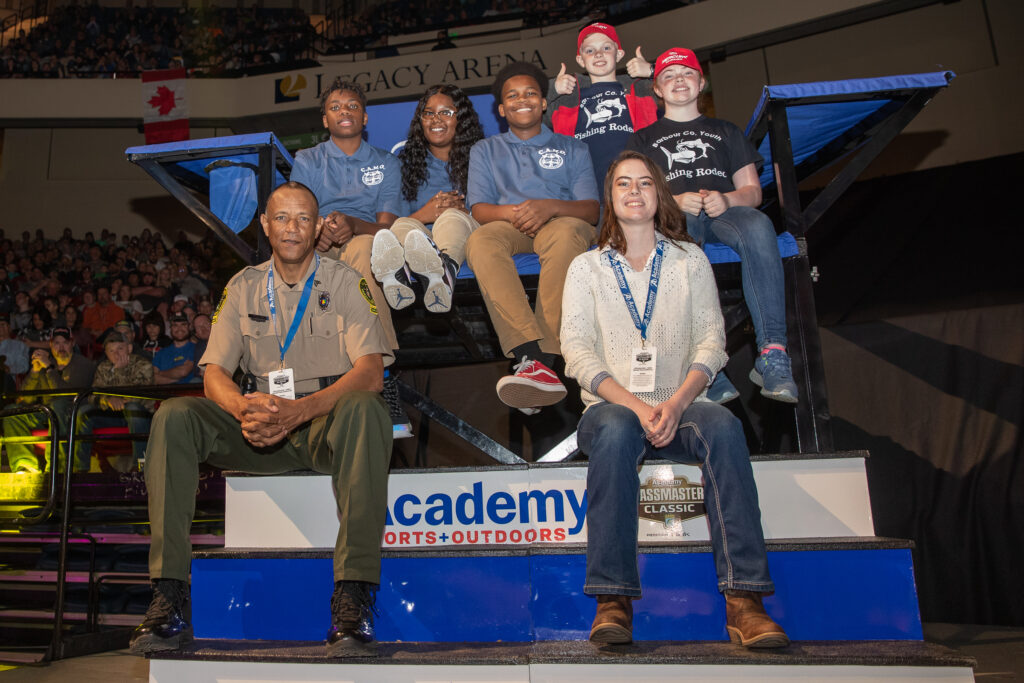
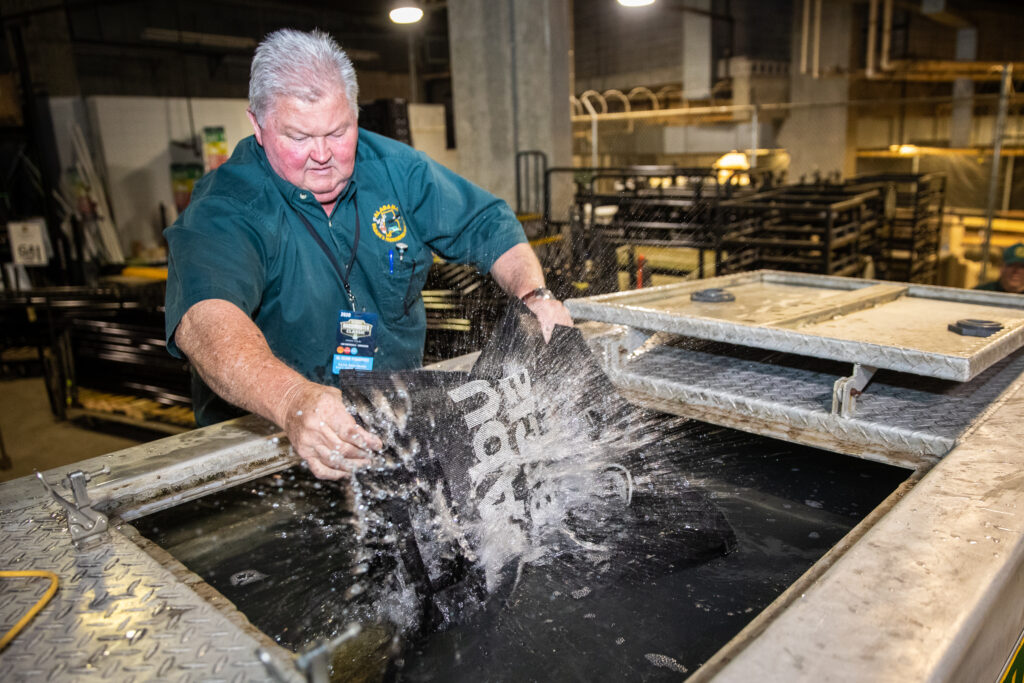
By David Rainer, Alabama Department of Conservation and Natural Resources
The Alabama Wildlife and Freshwater Fisheries (WFF) Division was both enjoying the spotlight and working behind the curtains during last week’s 50th Bassmaster Classic weigh-in at the Birmingham-Jefferson Civic Center (BJCC).
The Classic, with Academy Sports + Outdoors as its title sponsor, pitted the world’s best bass anglers on one of the nation’s top bass impoundments – Lake Guntersville in northeast Alabama.
After an opening round with an impressive 29-plus pounds of largemouth bass, Hank Cherry of North Carolina cruised to a wire-to-wire victory to win the top prize of $300,000.
During Saturday’s weigh-in ceremonies at BJCC’s Legacy Arena, one of WFF’s conservation enforcement officers, Sergeant Bill Freeman, was spotlighted in an oversized Academy chair as the honored first responder.
A veteran of the U.S. Army, Freeman transitioned recently from full-time patrol officer to head of WFF outreach. He was recognized by Academy for the following reasons:
“He consistently goes above and beyond his required duties and provided quality enforcement of game and fish regulations and is an asset to public safety to the residents of Bullock County, Alabama, and the surrounding areas. In 2019, Freeman received a promotion to sergeant for his exemplary service to the people of Alabama. In his new role as sergeant, Freeman’s duties were expanded to lead the effort to recruit youth, college and high school students into hunting and fishing. Sergeant Freeman’s methods and success in recruiting college and high school students across Alabama have garnered nationwide attention. His efforts have highlighted the Department as the leader in minority recruitment and retention by the Southeastern Association of Fish and Wildlife Agencies for the past two years.”
A feature of the award was a $500 shopping spree at the Academy store in Hoover, where Freeman and two colleagues loaded up on fishing equipment to be used in the WFF outreach programs.
Freeman was able to share the oversized chair and spotlight with several youth that participate in his outreach programs. One group of youngsters were from Bullock County and the KAMO (Kids and Mentors Outdoors) program. A few of the kids were from the Barbour County Youth Hunt and Blue Springs Fishing Derby, which are held in cooperation with the Barbour County Lions Club. Other events on Freeman’s schedule include a large hunter education class at Auburn University with the Wildlife Society, the Bullock County Fishing Derby and Outdoor Alabama Experience events at Oak Mountain State Park and Lake Lurleen State Park.
“The kids absolutely loved it,” Freeman said. “It’s been all over Facebook. That was a great experience. I really appreciated being recognized for our Department (Conservation and Natural Resources). Anything I can do for the kids is just a great experience. They really had a ball.
“It’s just nice to know people support what we do.”
While Freeman and his youth were in the spotlight, a crew from WFF’s hatchery operations was steadily working backstage to ensure the bass weighed in each day at the Classic received the best care possible in order to return the fish to Lake Guntersville, the Classic site, and Lay Lake, where the high school and college tournaments were held.
After Bassmaster Tournament Director Trip Weldon weighed the fish, he handed a basket through a trap door in the stage floor to a runner, who hurriedly transported the fish to large holding tanks on WFF vehicles.
WFF Hatchery Supervisor Brian Rinehard, who oversees all three hatcheries in the state (Eastaboga, Marion and Carbon Hill), teamed up with Gene Gilliland, B.A.S.S. Conservation Director, to determine how many tanker trucks would be needed during the Classic to transport the bass from the arena. The fish eventually ended up in either Lake Guntersville or Lay Lake after a visit to the Eastaboga hatchery in Calhoun County.
“Gene gave me an estimate of how big and how many fish they expected to be weighed in each day of the Classic,” Rinehard said. “We made sure we had trucks to easily handle that capacity.”
The trucks from the different hatcheries went to Eastaboga and were filled with spring water and a specific amount of salt to ease the stress on the fish. The tanks are equipped with oxygen diffusers to keep the water at the desired saturation level. The trucks then travel to BJCC, where they are staged to receive the weighed fish.
Classic anglers transported the fish from Lake Guntersville to Legacy Arena in the livewells of the tournament boats. The fish were placed in bags before being brought onstage to be weighed. After weighing, the fish were quickly placed in the WFF hatchery tanks until the weigh-in was completed.
“We keep up with how many pounds of bass are on the truck at one time,” Rinehard said Saturday. “When we reach a certain limit, we switch to another truck. We can safely handle fish on two pounds per gallon of water. For one of our 600-gallon tanks, we could hold as many as 1,200 pounds of fish. The first day’s total was 600 pounds of fish. We were prepared to handle a lot more fish if needed.”
Once each weigh-in was over, the hatchery truck headed to the Eastaboga Hatchery.
“When we get the fish to Eastaboga, we temper the fish. We transition them from the temperature of the tank to the spring water at the hatchery,” Rinehard said. “We had the temperature of the tanks cooled to match the temperature at Lake Guntersville. When we got back to the hatchery, we had to raise the temperature.
“We have 1,500-gallon raceways with spring water and oxygen to slowly raise the temperature. You don’t want to shock the fish with a temperature change. It causes too much stress, so we raise it slowly. Then we watch their swimming habits. When you confine bass, they start jumping, trying to get out, so we have covers on the holding tanks so they won’t be disturbed. We keep them as quiet as we can to calm them down.”
The bass, both from Lake Guntersville and Lay Lake, were held at Eastaboga until Monday morning, when the WFF hatchery trucks were filled with water and loaded with a certain amount of bass to be transported back to the lake of origin.
“The fish won’t all go to one boat ramp,” Rinehard said. “We will transport the fish to different state boat ramps around the lakes. We will spread the fish out as best we can.”
Rinehard said holding the Classic and other large tournaments in the early spring makes it a lot easier for fisheries managers to return healthy fish to the lakes compared to tournaments held during the heat of the summer.
“Heat puts a lot of stress on the fish,” he said. “You can handle a lot more fish and heavier fish when the water is cold, and Guntersville is world-renowned for its large fish, especially in the springtime.
“Livewells on bass boats are a lot better than they used to be. But handling the fish still causes stress. When we get them in our tanks, we limit the stress by giving them a lot more space, and we’re running oxygen.”
As it turns out, the effort to care for the fish was well worth it. Rinehard said 520 bass that weighed 1,662 pounds from the Classic were successfully returned to Lake Guntersville on Monday. Another 88 bass were returned to Lay Lake. Only five fish did not survive.
“We did everything we could to keep the mortality rate as low as possible,” he said.
Cover Crops Play Vital Role in Soil Conservation
By Katie Nichols
AUBURN UNIVERSITY, Ala.—Heavy bouts of rainfall and strong storms created the perfect scenario for Alabama producers to talk about the many benefits of planting cover crops during the winter season.
Audrey Gamble, an Alabama Cooperative Extension System soil scientist, said the weather throughout winter months in Alabama has allowed for thought-provoking conversations surrounding use of cover crops and off-season land management plans.
“I’ve started many meetings during the past few months by saying ‘It’s a great day to talk about cover crops,’” Gamble said.
While there are many producers who deem cover crops worth the work, there may be just as many who have not made the decision to incorporate a winter cover in their crop rotation.
The most recent Census of Agriculture shows an uptick in the use of cover crops in the state. In fact, numbers show a 15 percent increase in Alabama acres utilizing cover crops. Acreage in 2017 was up to 229,097 in comparison to the 199,215 acres reportedly planted in cover in the 2012 ag census.
Gamble said many producers are utilizing cover crops for a variety of reasons.
“There are so many producers who are seeing on-farm benefits after incorporating a winter cover,” she said. “However, there are still those who are trying to justify the time, money and effort that go along with adding an additional crop to the rotation.”
Gamble said she asks producers who are considering a cover incorporation what they would like to achieve by adding a rotation.
“Like with any business plan, it is important to identify needs—whether it is erosion control, weed suppression, soil moisture storage or increased organic matter. It is important to begin with a goal in mind,” Gamble said.
From there she begins work with farmers to develop a customized plan that is well-suited to their environment and their operation.
There are plenty of options for producers looking to incorporate a cover crop. Gamble said some of the most commonly recommended winter covers include:
- Small grains. These crops are commonly planted when producers need to add biomass to the soil, which is necessary for weed suppression and soil moisture storage. Cereal rye is a common recommendation because of its adaptability to a range of climates and soil types.
- Legumes. Legume crops provide supplemental nitrogen to cash crops. Crimson clover, hairy vetch and Austrian winter pea are commonly-planted legumes in Alabama.
- Brassicas. Brassica crops, such as Daikon radishes or turnips, can help scavenge for nutrients deep in the soil profile.
- Mixtures. Mixtures are ideal for producers who have multiple goals. For example, a mixture of rye, brassicas and legumes can be planted when producers are trying to achieve ground cover early, as well as later on. Legumes add an additional growth later in the season.
Gamble said mixtures, specifically, allow for fuller coverage throughout the growing season.
“Most producers prefer to stick with small grains, but there is a growing interest in cover crop mixtures, as well as the benefits provided by a mixture,” she said.
Gamble said the increase in adoption is encouraging and facilitating the use of cover crops in full-scale operations.
“Money and time are two things that are difficult for producers to allocate to cover crop adoption,” Gamble said. “It can be difficult to make time for planting cover crops in the middle of cash crop harvest. However, I see many producers choose to make this a priority once they see the benefits cover crops can have on their farm.”
Gamble said she also points out the different ways for sowing cover crop seed. Producers can drill it in with a no-till drill, spread seed via broadcast or through aerial application.
“Be sure that there is good soil moisture when you fly on a cover crop,” Gamble said. “Small grains and brassicas tend to get a better stand with aerial seeding than legumes.”
She also emphasized the important role government assistance can play during the cover crop selection process.
“Interest in cover crops is really growing,” Gamble said. “I like to share both grower assistance information, as well as additional learning materials.”
- Southern Cover Crops Council has developed a plethora of reading material and other information to help farmers make informed decisions.
- Alabama Healthy Soils is a resource that includes both regional and state-specific guidelines for incorporating cover crops on-farm.
- NRCS provides financial assistance to producers to incorporate cover crops through programs like EQIP and CSP. Contact your local NRCS office for additional information.
More Information
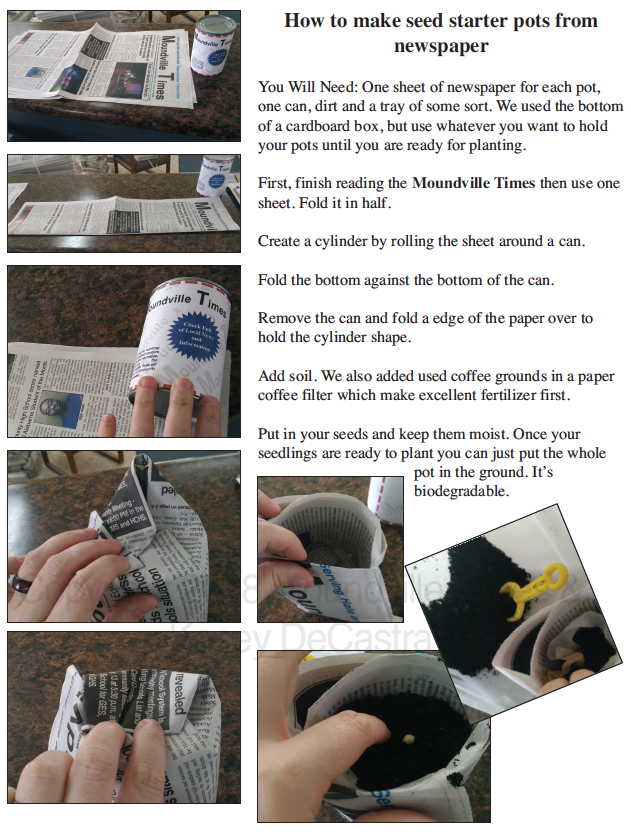
More information on cover crops and an implementation plan are available by visiting www.aces.edu. Gamble said she is also available for consultations to help producers manage their land and cover crop needs.
Soil Sampling: Important Part of Spring
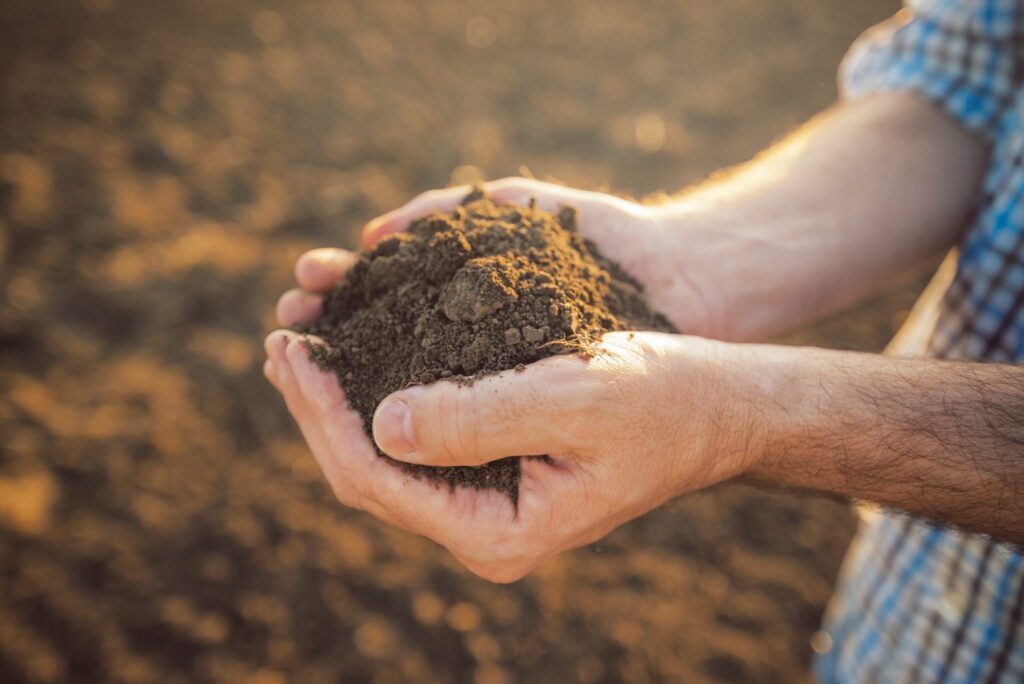
Show off a green thumb and ensure growing conditions are right by collecting soil for soil samples prior to planting. The Auburn University Soil Testing Laboratory offers this service to help growers make informed decisions about soil nutrients and soil composition on the farm or in the back yard. By supplying recommendations to help growers maintain plants and create a more sustainable growing environment, soil testing can help get spring gardens off on the right foot.
Importance of Soil Testing
“Soil is the basis for most of what we do as gardeners and without healthy soil, you cannot grow healthy plants,” said Taylor Reeder, an Alabama Extension home grounds, gardens and pests agent.
It is important to grow plants in the right environment. Adequate soil nutrients, in addition to the correct soil type, will help gardeners create and maintain a growing environment where plants can thrive.
Preparing Soil Samples
To begin the soil testing process, pick up a soil sample kit from the local Extension office. It will include a form explaining how to properly collect a soil sample.
“It is best to send soil samples that are dry,” Reeder said. “Laying the soil out on newspaper to dry before sending it off is suggested.”
Collect soil from the garden site or flower bed. According to Reeder, it is important to dig deep enough into the soil to collect an adequate sample. This could range from 2 to 8 inches deep, depending on the types of plants or seeds growers choose to plant in a given area. It is also important to include only soil in the sample. Make sure to remove as much plant and debris as possible.
Soil Test Results
Soil tests determine the pH and nutrient content of soil. This is beneficial as different plants often thrive in different pH ranges and require different nutrient concentrations. It is also advantageous to know soil nutrient levels, including calcium, magnesium, phosphorous and potassium. These levels will help growers make informed decisions regarding fertilizer types and frequency.
Growers can also do an analysis to test levels of micronutrients such as zinc in the soil. This analysis will include liming suggestions.
“Add lime to your soil in order to raise its pH if it is too acidic for what you are intending to grow,” said Reeder.
Sending the Soil Sample
Soil samples should be sent to the Auburn University Soil Testing Laboratory. The form available at local Extension offices with the sample box will include the sample mailing address. Each sample costs $7, with an added cost to perform a micronutrient analysis. Note: results are available by mail or electronically.
For more information, visit www.aces.edu. Read more about soil sampling at https://www.aces.edu/blog/topics/crop-production/routine-soil-analysis/
Greensboro Garden Club
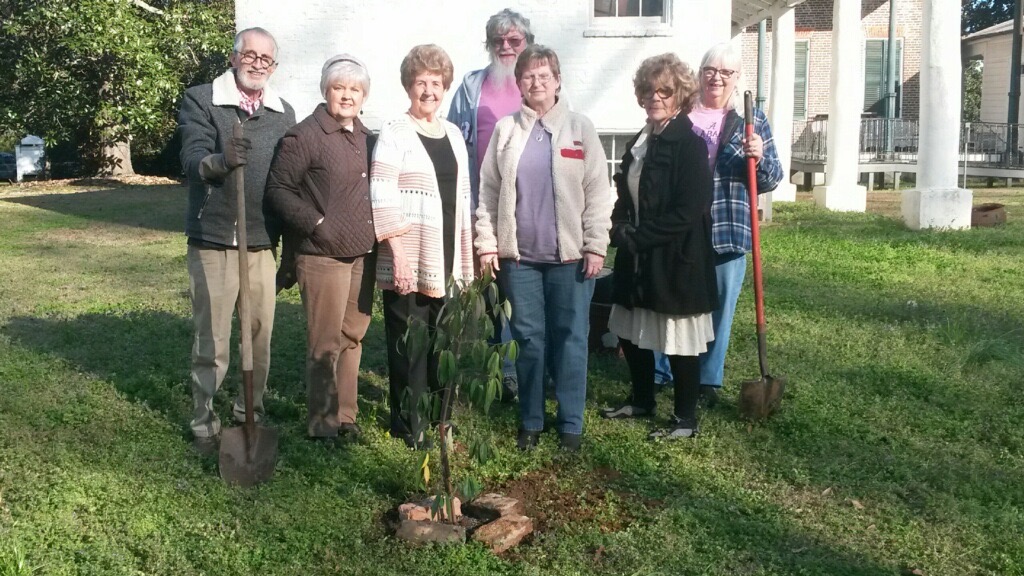
Greensboro Garden Club held the February meeting at the Hale County Library, Fri., Feb. 7. Club members had an arbor day program given by Theodora Barrett and then followed by planting a tree at the Historic Magnolia Grove. The tree is a Cornish Augusta Elsbry, an evergreen Empress of Chinese Dogwood. This variety although not native to Alabama does well in our climate and is more resistant to disease. The Chinese Dogwood has a vigorous habit and loads of flowers. Each branch holds up to 150 creamy white blooms that eventually turn into translucent strawberry like fruit. Empress of China will light up a partly shaded garden. Another item discussed at our meeting will bring Teresa Johnson from Tuscaloosa Garden Company, Duncanville to Greensboro to provide gardening tips and planting ideas during a spring garden tour of Greensboro Gardens in May. Details and reservation information will be available soon.
Respectfully submitted,
Karen Merrill
Picking the Best Blackberry Varieties

Interested in planting blackberries? Choosing the best blackberry varieties for the backyard garden will require a little homework. Because there are so many blackberry varieties, gardeners should spend a bit of time researching which cultivated variety, or cultivar, of blackberry is best for a specific location. Chip East, an Alabama Extension commercial horticulture regional agent, offers some tips on selecting cultivars and proper planting conditions.
Blackberry Cultivars
Blackberries cultivars come in three major types—erect, semi-erect or trailing. Semi-erect and trailing cultivars require a trellis. In contrast, erect blackberry types stand independently, but planting on a trellis in home gardens minimizes wind damage to the canes.
Next growers must choose between plants with thorns or those without.
“Thorny plants offer an aggressive growth habit and more disease resistance, and therefore can be very productive,” said East.
Popular thorny, erect blackberry cultivars include ‘Chickasaw,’ ‘Choctaw,’ ‘Kiowa’ and ‘Shawnee.’ Popular erect cultivars without thorns include ‘Apache,’ ‘Arapaho,’ ‘Natchez,’ ‘Navajo’ and ‘Ouachita.’
East said there can be significant differences in the fruit size and overall production between different cultivars. It may depend on the use of the berry as to what cultivar to choose.
Planting Conditions
Plant blackberries in late winter or spring of the year. While early spring planting is best, do not plant until the soil is dry enough to work. Prepare the planting area with the same care as for a vegetable seedbed.
Blackberries need planting areas with good drainage and full sunlight.
Blackberries grow and produce satisfactorily on a wide range of soil types, from sandy to heavy clay loams, provided that the drainage is good. Good soils for blackberry production are deep sandy loams that are moderately fertile, high in organic matter, easily worked and well drained.
Consider the possibility of winter injury when selecting planting locations. Blackberry plants often begin blooming before frost danger passes.
“Planting on slopes, or on the tops of slopes, allows cold air to drain away from the plants,” said East.
Blackberries planted on a southern slope are likely to bloom earlier than those on northern slopes. If possible, avoid planting blackberries in low-lying areas. Because air settles in low areas, blackberries planted there would be most affected by cold injury during bloom.
“While a grower might be able to do something if they confronted with this problem, freezing temperatures during bloom are always a concern,” said East.
More Information
For more information on blackberry cultivars, visit https://www.aces.edu/blog/topics/crop-production/blackberry-cultivars/
Early Bird: America’s beloved Purple Martins return to Alabama
In a sure sign that spring is not far behind, the first Purple Martins of the year have been spotted in Alabama.
The birds were seen on January 16 in the southern Alabama city of Enterprise by a Purple Martin enthusiast – one of many people throughout the eastern and central United States who track and report on the birds’ annual migration on behalf of the Purple Martin Conservation Association.
“The first Purple Martin arrivals of the season are always an exciting event,” said Joe Siegrist, President of the Purple Martin Conservation Association. “Tracking the migration is not only fun, it also provides us with valuable information that helps inform our research and strengthen our efforts to make sure we’re doing everything possible to sustain the population of these amazing birds.”
North America’s largest species of swallow, Purple Martins winter in the rainforests of Brazil before making up to a 7000-mile migration north into the eastern United States and Canada.
The annual migration is a testament to the martins’ resilience as well as the unwavering dedication of thousands of ‘martin landlords’ who maintain multi-compartment nest ‘condos’ that are essential for the birds’ survival. Once widespread in rural America, this species, that eats billions of flying insects annually, has been disappearing at an alarming rate, experiencing a loss of one-third of its population over the last 50 years.
“The decline seems to be the combination of a few factors: nesting habitat loss, competing invasive species, decreasing prey availability, and climate change,” said Siegrist. “Over the majority of the Purple Martins’ range, they are unable to nest naturally any longer. Human-provided nest boxes are the only thing keeping the species alive east of the Rocky Mountains.”
Siegrist says the very survival of the species is due in large part to scores of dedicated conservationists who invest their time, money and hearts into maintaining housing for the martins.
“The landlords provide critical shelter for the martins,” Siegrist said. “In return, they are rewarded with a family-like bond with the birds who return to the same colony year after year like clockwork.”
To follow along with the Purple Martins’ migration and learn more about how you can help conserve this treasured bird, visit www.purplemartin.org. In addition, people interested in learning more about how to attract and care for Purple Martins can receive a free booklet by contacting the Purple Martin Conservation Association by emailing [email protected] or calling 814-833-7656.
First Wild Eastern Indigo Snake Found in Alabama in 60 Years

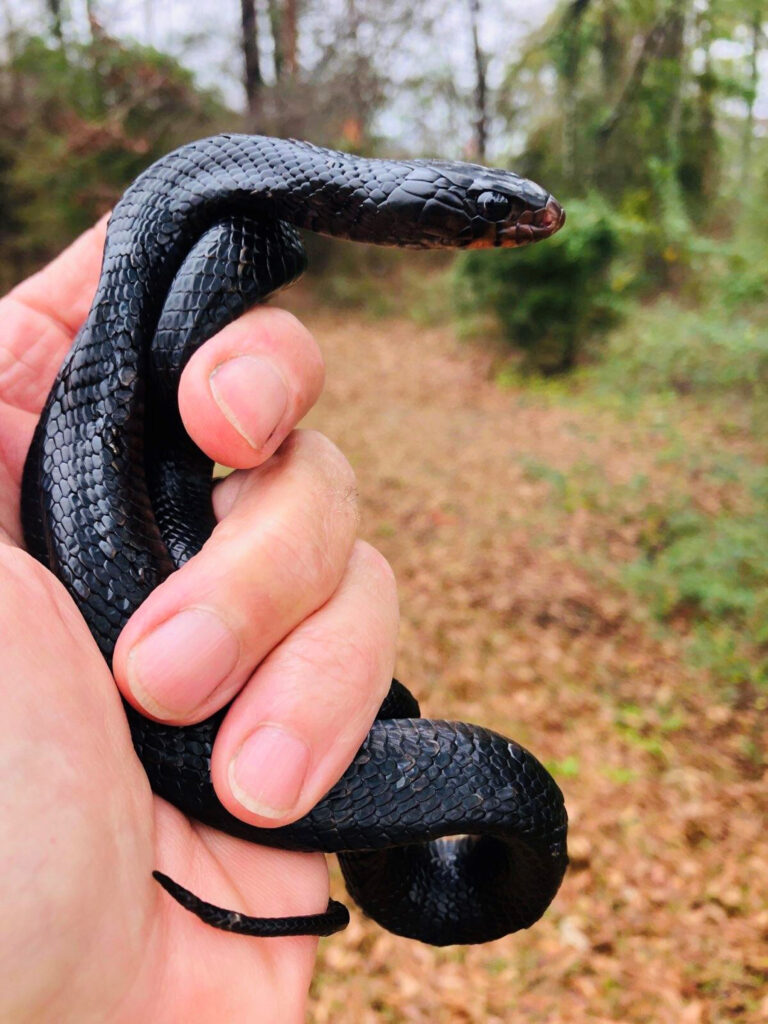
By David Rainer, Alabama Department of Conservation and Natural Resources
Traci Wood admitted holding the snake almost made her come unglued. No, she wasn’t afraid of the snake she was holding. It was the magnitude of the moment.
Wood, the Habitat and Species Conservation Coordinator with the Alabama Wildlife and Freshwater Fisheries (WFF) Division, had in her hands the first wild Eastern indigo snake documented in Alabama in more than 60 years.
“I’m not embarrassed to say that I was shaking when I held that animal,” Wood said. “This is a monumental benchmark in conservation for Alabama and the southeast region for this species.
“It’s a big deal, extremely big. It’s big for recovery efforts of a federally listed threatened species. It’s the first documentation of a wild snake in more than 60 years in Alabama. It’s proof that what we are doing through reintroduction is working and that captive snakes are acting like wild snakes after they are released.”
Chris Blankenship, Commissioner of the Alabama Department of Conservation and Natural Resources echoed the importance of the achievement.
“I am thrilled that we have documented wild reproduction of the Eastern indigo,” Commissioner Blankenship said. “It is great for the species, but I am also really happy for Traci and the staff who have worked for years to make this happen. They truly have a passion for their work, and I am so thankful for them.”
Technicians from the Auburn School of Forestry and Wildlife Sciences and the Auburn Museum of Natural History were out looking for documentation of indigo snakes as part of the long-term program to re-establish viable populations of Eastern indigos in their native habitat, mainly in longleaf pine forests in central and south Alabama.
“We try to document how long they are living, how far they are moving and how they’re doing healthwise,” Wood said. “The technicians were out and came across the snake as part of the monitoring effort. It was really no different than the monitoring we do for the released snakes. We’re out there assessing and trying to document their survival.
“There’s always the hope that we will find documentation of reproduction, and it finally happened.”
Wood said the technicians knew immediately what they had discovered when the snake was picked up.
“They knew because it was a hatchling-size snake,” she said. “It measured 2 feet in length, which is much smaller than the snakes we release from OCIC (Orianne Center for Indigo Conservation). It had no PIT (passive integrated transponder) tag or any indication we use in monitoring to indicate it was a released snake. Those released snakes are 5 feet in length or longer. They estimated the juvenile indigo at about 7 months old. It probably hatched in July or August.”
The Eastern indigo project started in 2006, and the program was able to start releasing captive-raised indigos in 2010 with 17 adult snakes released into the Conecuh National Forest. The goal is to release a total of 300 snakes to improve the chances of establishing a viable population. The project team has released 170 snakes to date. Wood said the decision-making and planning for indigo recovery through reintroductions started with late Auburn University professor Dr. Dan Speake in the 1970s and 1980s.
“It’s been a long process with a lot of sweat,” Wood said. “We have faced some criticism along the way. Then, when what you have hoped for happens, it’s extremely rewarding and overwhelming.”
During the early days of the indigo project, the released snakes were propagated from indigos that had been captured in the wild in Georgia. Partners in this project include Auburn Museum of Natural History, Auburn School of Forestry and Wildlife Sciences, U.S. Forest Service, U.S. Fish and Wildlife Service, Zoo Tampa, Zoo Atlanta, the Georgia Department of Natural Resources and the U.S. Army’s Fort Stewart, as well as the OCIC at the Central Florida Zoo, where the captive indigo breeding and health care are handled.
“We’re kind of at the halfway mark in the reintroduction,” Wood said. “It’s very exciting to see verification of reproduction at this stage of the project.
“It’s a huge testimony to the State Wildlife Grants program and working toward the recovery of a federally listed species. It is considered an experimental population. We were conducting research and making decisions that had never been done before with this species. It was a lot of groundbreaking work. Florida now has a reintroduction program, and a lot of their work is based on what we’ve done at Conecuh and lessons learned at Conecuh. Besides aquatic species, there isn’t another example of species recovery of a federally listed species through reintroductions.”
Wood said the lessons included that a learning curve is a given with a project of this magnitude and that 2-year-old snakes have a better chance of survival in the wild because they are less susceptible to predators.
“We also learned the target for the number of individuals to be released,” she said. “That is 30 individuals per year. We’ve learned that we had to establish a monitoring program that didn’t exist before. We learned it takes intense monitoring on the ground.”
One of the tools the monitoring team borrowed from the hunting community is the game camera. The game cameras have been stationed to monitor activity at gopher tortoise burrows, which are utilized by a number of animals, including indigos.
“We had to learn that a snake is not going to trigger motion sensitivity on the game cameras,” Wood said. “We set the cameras to capture a photo at intervals of 30 to 60 seconds to make sure we capture all the activity. That’s something we’ve recently started, and so far it’s proven to be very helpful. We’ve captured pictures of several indigos at burrows.
“The cameras are showing location, where they’re hanging out, how they’re using burrows and the fact adult snakes are surviving. We estimate that 60 to 80 percent of the snakes that we reintroduce will survive. That’s not bad at all after they’ve been in captivity for two years.”
Wood said it is not possible right now to estimate the total number of Eastern indigo snakes that are in the Conecuh habitat.
“These recaptures and verification of reproduction is data that will be useful in the future so that someday we may be able to predict how many individuals may be in the wild,” she said.
Wood said Eastern indigos were extirpated from the state and hadn’t been seen since the 1950s. Considered an apex predator, the snake plays an important role in the longleaf pine ecosystem. Eastern indigo snakes are the longest snakes native to the U.S. at more than 8 feet long. They prey on a variety of small mammals, amphibians, lizards and numerous species of venomous snakes, including the copperhead. Indigos are known to range far and wide during the warmer months and then seek refuge in the gopher tortoise burrows during the winter.
WFF’s State Wildlife Action Plan identifies 366 species that are in the category of greatest conservation need, according to Wood.
“Alabama is one of the most diverse states in the nation in terms of amphibians and reptiles,” she said. “Conecuh National Forest is the most biologically rich public land in the country.”
Wood is still having a little trouble grasping what happened recently at Conecuh National Forest.
“Physically holding a wild species that hasn’t been documented in Alabama in more than 60 years gives us high hopes for what we may see when we reach our goal of 300 snakes released,” she said.
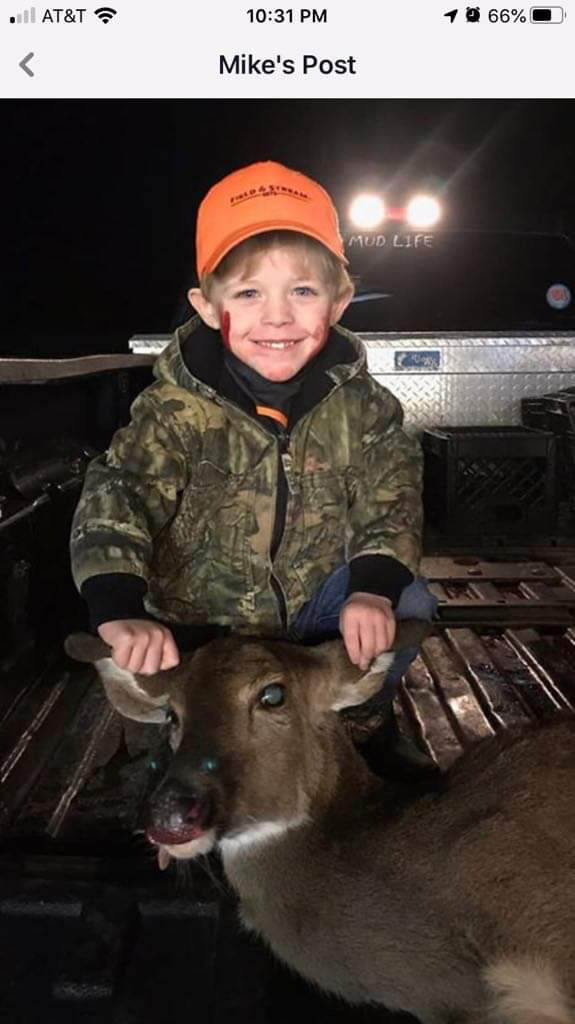
Game warden offers one-time immunity deal
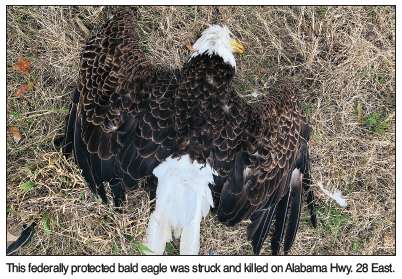
By Tommy McGraw
Publisher
A person or persons who took parts from a dead bald eagle in Livingston could face jail time and a $100,000 fine.
Game Warden Jeff Shaw reported that a foot and several tail feathers were taken from a carcass of an American bald eagle sometime after the bird was killed in the city limits of Livingston Thursday, Dec. 12.
The bird was accidentally struck by a vehicle on Alabama Highway 28, east of Livingston, near the Bluffport Road exit. Another driver reported the dead bird lying beside the highway to the Livingston Police Department. Livingston PD called Shaw, and Shaw said before he arrived to take possession of the federally protected bird carcass someone had taken a foot and several feathers from the bird.
The white-headed mature bald eagle is a federally protected bird, and those removing parts or killing a bird can face up to a $250,000 fine. Shaw said each part removed can fetch as low as $5,000 per offense. Shaw said the person who has the parts can pay up to $5,000 per feather and be jailed for a first-time offense.
Shaw estimated that the person or persons who removed the foot and eight or nine feathers face a “ticking time bomb.”
“There are only three feathers left, and a mature bald eagle can grow up to twelve long tail feathers. He may have lost some, but not eight or nine feathers. The foot was cut off with a sharp object, and he [eagle] did not lose it in the accident,” Shaw said.
Shaw said the bird was at least five years old because the eagle species “does not grow their white head feathers until they are that old.”
Shaw said the eagle was huge and had a wingspan that covered the back of his state-issued Alabama Conservation truck bed.
“This is a ticking time bomb waiting to go off,” Shaw said of the impending possibility that the person who has the parts in his possession will be turned in or that they may be stopped for some other offense and will be arrested for having the eagle body parts.
“I want to offer a one time deal so the person(s), if they are not aware of the severity of having the eagle foot and feathers in their possession, to turn them in anonymously and not be arrested.”
Conservation Officer Shaw said the Alabama Department of Conservation works with the U.S. Fish and Wildlife Service who in turn operates the National Eagle Repository as a clearinghouse for eagles and eagle parts to provide Native Americans with eagle feathers for religious use.
“If someone knows who has the feathers and foot, I urge you to call the Livingston Police at 205-652-9525 or Alabama Game Watch’s phone number at 1-800-272-4263. I also urge the person or persons who took the parts to turn them into the Record-Journal newspaper anonymously or the Livingston Police Department.
“The alternative is, if the person is caught, they will be arrested, and it will be very expensive to pay for all the fines.”
Shaw said the bird had no broken wings, leg, or any other indication it was even struck by a vehicle, “unless it was hit in the head,” Shaw added.
Shaw said the eagle was apparently feeding on a deer carcass on the side of the roadway and it is believed a driver accidentally struck and killed the eagle and left the scene not knowing what type of bird they struck. Whoever took the eagle parts came along after the initial accident and removed the foot and feathers, Shaw surmised.
Livingston Police Chief Roger Tolliver confirmed Shaw’s assesment of the events.
Tolliver said he was working in the area when the initial call came in. “The person who reported it to me met me at the scene, and we looked at the bird but didn’t move it. I only saw the one leg and thought the second one was under the bird and just not visible. The foot and feathers must have been taken sometime before the person reported the dead bird to LPD.
“The man said he saw the bird feeding on the deer on Tuesday and saw it almost get hit then by a pickup traveling in front of him. The man told me, ‘I said to myself, ‘somebody is going to hit that eagle sooner or later.’ And, sure enough they did,” said Chief Tolliver.
Bald eagles are no longer considered endangered, but they are protected under the Bald Eagle and Golden Eagle Protection Act.
“When I was growing up there were no bald eagles in Alabama,” said Shaw. “Today, however, they are seen almost in every county. I am hoping the person or persons who cut the leg off the bird and took the feathers are just not aware of the major consequences they could face. That is why I am offering them this one time deal.”
The bald eagle, the United States national bird, is the most recognizable raptor in the United States. Decades ago, the bald eagle was endangered due to DDT, a dangerous pesticide that contaminated fish, the bird’s main food source. The Endangered Species Act and the banning of DDT are the two main reasons this species has made a remarkable recovery and can now be spotted frequently in Alabama skies.
Fines and the law
Anyone who possesses an eagle feather or another part, and doesn’t meet the requirements, could face fines up to $100,000 and a year in prison. A second offense is upgraded from a misdemeanor to a felony and carries a maximum penalty of two years in prison and a $250,000 fine.
Possession of Eagle Feathers and Parts by Native Americans
According to the U.S Fish and Wildlife Service, eagles are directly protected under two federal laws, the Bald and Golden Eagle Protection Act and the Migratory Bird Treaty Act. These laws generally prohibit the possession, use, and sale of eagle feathers and parts as well as a number of other activities.
Such restrictions help ensure the future viability of eagles in the wild. The U.S. Fish and Wildlife Service, however, has long recognized the religious and cultural significance of eagles to Native Americans and works to accommodate these special needs. The Service operates the National Eagle Repository as a clearinghouse for eagles and eagle parts to provide Native Americans with eagle feathers for religious use. The Repository collects dead eagles salvaged by Federal and State agencies, zoos, and other organizations. Enrolled members of federally recognized tribes (as established under the Federally Recognized Tribal List Act of 1994, 25 U.S.C. Section 479a, 108 Stat. 4791) may obtain a permit from the Service authorizing them to receive and possess eagle feathers and parts from the Repository.
Permit applications must include certification of tribal enrollment from the Bureau of Indian Affairs. Because demand is high, waiting periods exist. Native Americans may also legally possess eagle feathers and parts acquired through certain other means. Such items include any owned before eagles were first protected by Federal law (1940 for bald eagles, and 1962 for golden eagles) and feathers and parts passed down within a family or received as gifts from other Native Americans. Native Americans may wear feathers legally in their possession or make them into religious or cultural items for their own or tribal use.
They may transfer feathers to tribal craftsmen to be fashioned into such objects; no money may be received for the feathers, but craftsmen may be compensated for their work. Native Americans may give feathers or other eagle items as gifts to other Native Americans and may hand them down within their families. They may not, however, give them to non-Native Americans. No person — including Native Americans — may kill or capture eagles without a permit from the Service. Nor may anyone buy, sell, barter, trade, import, or export eagle feathers or items made from them. These prohibitions cover all feathers and parts, including those that “pre-date” Federal protections and others that are legally possessed. (Native Americans, however, can obtain permits to travel overseas with eagle items for religious use.) Service law enforcement efforts focus on the illegal take and commercial exploitation of eagles by anyone attempting to profit at the expense of these birds. Service officers who encounter individuals with noncommercial quantities of eagle feathers that are being used as personal or religious items will generally take no action if the individuals possess a valid Service permit or reasonably demonstrate that they are enrolled members of a federally recognized tribe. The production of a certificate of enrollment card would be one way for individuals to easily document their tribal affiliation, but this is not a legal requirement. An individual’s possession of such a card would, of course, tend to facilitate the resolution of any questions about the legality of his or her ownership and personal use of eagle feathers.
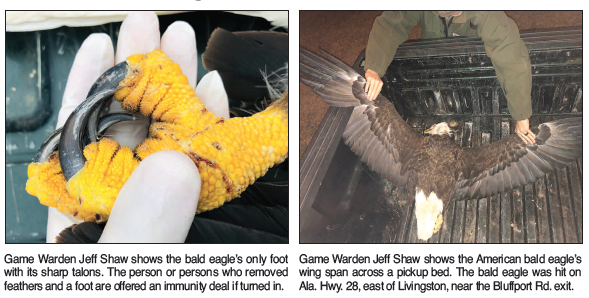
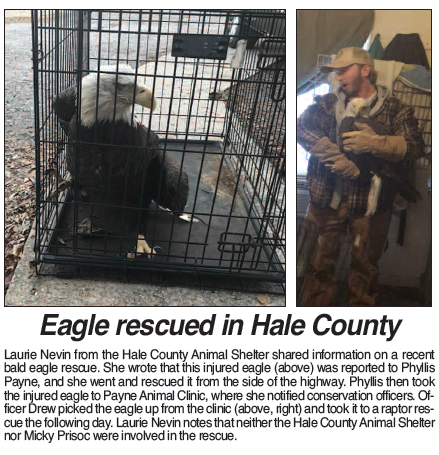
Why Join Hale County 4-H Club?
Alabama 4-H Foundation to Award $35,000 in Scholarships!
The Alabama 4-H Foundation is helping advance the education of 35 high school seniors. The foundation will be awarding $1,000 scholarships to 35 high school seniors of the 2020 graduating class. The scholarships can be used for any post-secondary education, whether that is attending community college, trade school or a university. Payment for tuition and fees will be made from the Alabama 4-H Foundation directly to the student’s post-secondary institution to be used in the 2020-21 academic year. Applications are now being accepted via 4HOnline at www.4honline.com. Completed applications are due online by March 1. Scholarship winners can expect notifications by April 15.
If you have questions regarding the scholarship application process, contact Nancy Alexander at [email protected]. If you have any questions or would like to join 4-H Club please contact your Hale county Extension Office 334-624-8710. We also need 4-H Adult Volunteers!! Please help us show our youth the 4-H Way!
